
DuckDB Documentation
DuckDB version 0.9.2
Generated on 2023‑11‑13 at 11:48 UTC
Contents
Contents i
Summary 1
Documentation 3
Connect 5
Data Import 7
Importing Data . . . . . . . . . . . . . . . . . . . . . . . . . . . . . . . . . . . . . . . . . . 7
CSV Files . . . . . . . . . . . . . . . . . . . . . . . . . . . . . . . . . . . . . . . . . . . . . . 8
CSV Import . . . . . . . . . . . . . . . . . . . . . . . . . . . . . . . . . . . . . . . . . 8
CSV Auto Detection . . . . . . . . . . . . . . . . . . . . . . . . . . . . . . . . . . . . . 14
CSV Import Tips . . . . . . . . . . . . . . . . . . . . . . . . . . . . . . . . . . . . . . . 18
JSON Files . . . . . . . . . . . . . . . . . . . . . . . . . . . . . . . . . . . . . . . . . . . . . 19
JSON Loading . . . . . . . . . . . . . . . . . . . . . . . . . . . . . . . . . . . . . . . . 19
Multiple Files . . . . . . . . . . . . . . . . . . . . . . . . . . . . . . . . . . . . . . . . . . . 26
Reading Multiple Files . . . . . . . . . . . . . . . . . . . . . . . . . . . . . . . . . . . 26
Combining Schemas . . . . . . . . . . . . . . . . . . . . . . . . . . . . . . . . . . . . 29
Parquet Files . . . . . . . . . . . . . . . . . . . . . . . . . . . . . . . . . . . . . . . . . . . 31
Reading and Writing Parquet Files . . . . . . . . . . . . . . . . . . . . . . . . . . . . . 31
Querying Parquet Metadata . . . . . . . . . . . . . . . . . . . . . . . . . . . . . . . . 35
Parquet Tips . . . . . . . . . . . . . . . . . . . . . . . . . . . . . . . . . . . . . . . . 37
Partitioning . . . . . . . . . . . . . . . . . . . . . . . . . . . . . . . . . . . . . . . . . . . . 38
Hive Partitioning . . . . . . . . . . . . . . . . . . . . . . . . . . . . . . . . . . . . . . 38
Partitioned Writes . . . . . . . . . . . . . . . . . . . . . . . . . . . . . . . . . . . . . 40
Appender . . . . . . . . . . . . . . . . . . . . . . . . . . . . . . . . . . . . . . . . . . . . . 41
Insert Statements . . . . . . . . . . . . . . . . . . . . . . . . . . . . . . . . . . . . . . . . . 42
Client APIs 45
Client APIs Overview . . . . . . . . . . . . . . . . . . . . . . . . . . . . . . . . . . . . . . . 45
i

DuckDB Documentation
C . . . . . . . . . . . . . . . . . . . . . . . . . . . . . . . . . . . . . . . . . . . . . . . . . . 45
C API ‑ Overview . . . . . . . . . . . . . . . . . . . . . . . . . . . . . . . . . . . . . . 45
C API ‑ Startup & Shutdown . . . . . . . . . . . . . . . . . . . . . . . . . . . . . . . . 46
C API ‑ Configuration . . . . . . . . . . . . . . . . . . . . . . . . . . . . . . . . . . . . 51
C API ‑ Query . . . . . . . . . . . . . . . . . . . . . . . . . . . . . . . . . . . . . . . . 54
C API ‑ Data Chunks . . . . . . . . . . . . . . . . . . . . . . . . . . . . . . . . . . . . . 64
C API ‑ Values . . . . . . . . . . . . . . . . . . . . . . . . . . . . . . . . . . . . . . . . 76
C API ‑ Types . . . . . . . . . . . . . . . . . . . . . . . . . . . . . . . . . . . . . . . . 79
C API ‑ Prepared Statements . . . . . . . . . . . . . . . . . . . . . . . . . . . . . . . . 109
C API ‑ Appender . . . . . . . . . . . . . . . . . . . . . . . . . . . . . . . . . . . . . . 125
C API ‑ Table Functions . . . . . . . . . . . . . . . . . . . . . . . . . . . . . . . . . . . 135
C API ‑ Replacement Scans . . . . . . . . . . . . . . . . . . . . . . . . . . . . . . . . . 152
C API ‑ Complete API . . . . . . . . . . . . . . . . . . . . . . . . . . . . . . . . . . . . 155
C++ API . . . . . . . . . . . . . . . . . . . . . . . . . . . . . . . . . . . . . . . . . . . . . . 273
CLI API . . . . . . . . . . . . . . . . . . . . . . . . . . . . . . . . . . . . . . . . . . . . . . . 279
Java JDBC API . . . . . . . . . . . . . . . . . . . . . . . . . . . . . . . . . . . . . . . . . . . 293
Julia Package . . . . . . . . . . . . . . . . . . . . . . . . . . . . . . . . . . . . . . . . . . . 297
Node.js . . . . . . . . . . . . . . . . . . . . . . . . . . . . . . . . . . . . . . . . . . . . . . 298
Node.js API . . . . . . . . . . . . . . . . . . . . . . . . . . . . . . . . . . . . . . . . . 298
NodeJS API . . . . . . . . . . . . . . . . . . . . . . . . . . . . . . . . . . . . . . . . . 301
Python . . . . . . . . . . . . . . . . . . . . . . . . . . . . . . . . . . . . . . . . . . . . . . 320
Python API . . . . . . . . . . . . . . . . . . . . . . . . . . . . . . . . . . . . . . . . . 320
Data Ingestion . . . . . . . . . . . . . . . . . . . . . . . . . . . . . . . . . . . . . . . 323
Result Conversion . . . . . . . . . . . . . . . . . . . . . . . . . . . . . . . . . . . . . 328
Python DB API . . . . . . . . . . . . . . . . . . . . . . . . . . . . . . . . . . . . . . . 330
Relational API . . . . . . . . . . . . . . . . . . . . . . . . . . . . . . . . . . . . . . . . 333
Python Function API . . . . . . . . . . . . . . . . . . . . . . . . . . . . . . . . . . . . 340
Types API . . . . . . . . . . . . . . . . . . . . . . . . . . . . . . . . . . . . . . . . . . 344
Expression API . . . . . . . . . . . . . . . . . . . . . . . . . . . . . . . . . . . . . . . 348
Spark API . . . . . . . . . . . . . . . . . . . . . . . . . . . . . . . . . . . . . . . . . . 352
Python Client API . . . . . . . . . . . . . . . . . . . . . . . . . . . . . . . . . . . . . . 353
Known Python Issues . . . . . . . . . . . . . . . . . . . . . . . . . . . . . . . . . . . . 353
R API . . . . . . . . . . . . . . . . . . . . . . . . . . . . . . . . . . . . . . . . . . . . . . . . 354
Rust API . . . . . . . . . . . . . . . . . . . . . . . . . . . . . . . . . . . . . . . . . . . . . . 358
Scala JDBC API . . . . . . . . . . . . . . . . . . . . . . . . . . . . . . . . . . . . . . . . . . 359
Swi API . . . . . . . . . . . . . . . . . . . . . . . . . . . . . . . . . . . . . . . . . . . . . . 361
Wasm . . . . . . . . . . . . . . . . . . . . . . . . . . . . . . . . . . . . . . . . . . . . . . . 361
DuckDB Wasm . . . . . . . . . . . . . . . . . . . . . . . . . . . . . . . . . . . . . . . 361
ii

DuckDB Documentation
Instantiation . . . . . . . . . . . . . . . . . . . . . . . . . . . . . . . . . . . . . . . . 362
Data Ingestion . . . . . . . . . . . . . . . . . . . . . . . . . . . . . . . . . . . . . . . 364
Query . . . . . . . . . . . . . . . . . . . . . . . . . . . . . . . . . . . . . . . . . . . . 367
Extensions . . . . . . . . . . . . . . . . . . . . . . . . . . . . . . . . . . . . . . . . . 369
ADBC API . . . . . . . . . . . . . . . . . . . . . . . . . . . . . . . . . . . . . . . . . . . . . 372
ODBC . . . . . . . . . . . . . . . . . . . . . . . . . . . . . . . . . . . . . . . . . . . . . . . 380
ODBC API ‑ Overview . . . . . . . . . . . . . . . . . . . . . . . . . . . . . . . . . . . . 380
ODBC API ‑ Linux . . . . . . . . . . . . . . . . . . . . . . . . . . . . . . . . . . . . . . 381
ODBC API ‑ Windows . . . . . . . . . . . . . . . . . . . . . . . . . . . . . . . . . . . . 384
ODBC API ‑ MacOS . . . . . . . . . . . . . . . . . . . . . . . . . . . . . . . . . . . . . 387
SQL 391
SQL Introduction . . . . . . . . . . . . . . . . . . . . . . . . . . . . . . . . . . . . . . . . . 391
Statements . . . . . . . . . . . . . . . . . . . . . . . . . . . . . . . . . . . . . . . . . . . . 401
Statements Overview . . . . . . . . . . . . . . . . . . . . . . . . . . . . . . . . . . . . 401
Alter Table . . . . . . . . . . . . . . . . . . . . . . . . . . . . . . . . . . . . . . . . . . 401
Alter View . . . . . . . . . . . . . . . . . . . . . . . . . . . . . . . . . . . . . . . . . . 404
Attach/Detach . . . . . . . . . . . . . . . . . . . . . . . . . . . . . . . . . . . . . . . . 405
Call . . . . . . . . . . . . . . . . . . . . . . . . . . . . . . . . . . . . . . . . . . . . . 408
Checkpoint . . . . . . . . . . . . . . . . . . . . . . . . . . . . . . . . . . . . . . . . . 408
Copy . . . . . . . . . . . . . . . . . . . . . . . . . . . . . . . . . . . . . . . . . . . . . 409
Create Macro . . . . . . . . . . . . . . . . . . . . . . . . . . . . . . . . . . . . . . . . 415
Create Schema . . . . . . . . . . . . . . . . . . . . . . . . . . . . . . . . . . . . . . . 417
Create Sequence . . . . . . . . . . . . . . . . . . . . . . . . . . . . . . . . . . . . . . 417
Create Table . . . . . . . . . . . . . . . . . . . . . . . . . . . . . . . . . . . . . . . . . 420
Create View . . . . . . . . . . . . . . . . . . . . . . . . . . . . . . . . . . . . . . . . . 424
Create Type . . . . . . . . . . . . . . . . . . . . . . . . . . . . . . . . . . . . . . . . . 425
Delete Statement . . . . . . . . . . . . . . . . . . . . . . . . . . . . . . . . . . . . . . 426
Drop Statement . . . . . . . . . . . . . . . . . . . . . . . . . . . . . . . . . . . . . . . 426
Export & Import Database . . . . . . . . . . . . . . . . . . . . . . . . . . . . . . . . . 427
Insert Statement . . . . . . . . . . . . . . . . . . . . . . . . . . . . . . . . . . . . . . 428
Pivot Statement . . . . . . . . . . . . . . . . . . . . . . . . . . . . . . . . . . . . . . . 431
Select Statement . . . . . . . . . . . . . . . . . . . . . . . . . . . . . . . . . . . . . . 440
Set/Reset . . . . . . . . . . . . . . . . . . . . . . . . . . . . . . . . . . . . . . . . . . 443
Unpivot Statement . . . . . . . . . . . . . . . . . . . . . . . . . . . . . . . . . . . . . 444
Update Statement . . . . . . . . . . . . . . . . . . . . . . . . . . . . . . . . . . . . . 452
Use . . . . . . . . . . . . . . . . . . . . . . . . . . . . . . . . . . . . . . . . . . . . . 454
Vacuum . . . . . . . . . . . . . . . . . . . . . . . . . . . . . . . . . . . . . . . . . . . 455
iii

DuckDB Documentation
Query Syntax . . . . . . . . . . . . . . . . . . . . . . . . . . . . . . . . . . . . . . . . . . . 455
SELECT Clause . . . . . . . . . . . . . . . . . . . . . . . . . . . . . . . . . . . . . . . 455
FROM & JOIN Clauses . . . . . . . . . . . . . . . . . . . . . . . . . . . . . . . . . . . . 458
WHERE Clause . . . . . . . . . . . . . . . . . . . . . . . . . . . . . . . . . . . . . . . 464
GROUP BY Clause . . . . . . . . . . . . . . . . . . . . . . . . . . . . . . . . . . . . . . 464
GROUPING SETS . . . . . . . . . . . . . . . . . . . . . . . . . . . . . . . . . . . . . . 466
HAVING Clause . . . . . . . . . . . . . . . . . . . . . . . . . . . . . . . . . . . . . . . 468
ORDER BY Clause . . . . . . . . . . . . . . . . . . . . . . . . . . . . . . . . . . . . . . 469
LIMIT Clause . . . . . . . . . . . . . . . . . . . . . . . . . . . . . . . . . . . . . . . . 471
SAMPLE Clause . . . . . . . . . . . . . . . . . . . . . . . . . . . . . . . . . . . . . . . 472
UNNEST . . . . . . . . . . . . . . . . . . . . . . . . . . . . . . . . . . . . . . . . . . . 473
WITH Clause . . . . . . . . . . . . . . . . . . . . . . . . . . . . . . . . . . . . . . . . 474
WINDOW Clause . . . . . . . . . . . . . . . . . . . . . . . . . . . . . . . . . . . . . . 481
QUALIFY Clause . . . . . . . . . . . . . . . . . . . . . . . . . . . . . . . . . . . . . . . 482
VALUES Clause . . . . . . . . . . . . . . . . . . . . . . . . . . . . . . . . . . . . . . . 484
FILTER Clause . . . . . . . . . . . . . . . . . . . . . . . . . . . . . . . . . . . . . . . . 484
Set Operations . . . . . . . . . . . . . . . . . . . . . . . . . . . . . . . . . . . . . . . 488
Data Types . . . . . . . . . . . . . . . . . . . . . . . . . . . . . . . . . . . . . . . . . . . . 490
Data Types . . . . . . . . . . . . . . . . . . . . . . . . . . . . . . . . . . . . . . . . . 490
Bitstring Type . . . . . . . . . . . . . . . . . . . . . . . . . . . . . . . . . . . . . . . . 493
Blob Type . . . . . . . . . . . . . . . . . . . . . . . . . . . . . . . . . . . . . . . . . . 493
Boolean Type . . . . . . . . . . . . . . . . . . . . . . . . . . . . . . . . . . . . . . . . 494
Date Types . . . . . . . . . . . . . . . . . . . . . . . . . . . . . . . . . . . . . . . . . 495
Enum Types . . . . . . . . . . . . . . . . . . . . . . . . . . . . . . . . . . . . . . . . . 497
Interval Type . . . . . . . . . . . . . . . . . . . . . . . . . . . . . . . . . . . . . . . . 500
List . . . . . . . . . . . . . . . . . . . . . . . . . . . . . . . . . . . . . . . . . . . . . 502
Map . . . . . . . . . . . . . . . . . . . . . . . . . . . . . . . . . . . . . . . . . . . . . 504
NULL Values . . . . . . . . . . . . . . . . . . . . . . . . . . . . . . . . . . . . . . . . . 506
Numeric Types . . . . . . . . . . . . . . . . . . . . . . . . . . . . . . . . . . . . . . . 507
Struct . . . . . . . . . . . . . . . . . . . . . . . . . . . . . . . . . . . . . . . . . . . . 510
Text Types . . . . . . . . . . . . . . . . . . . . . . . . . . . . . . . . . . . . . . . . . . 514
Time Types . . . . . . . . . . . . . . . . . . . . . . . . . . . . . . . . . . . . . . . . . 516
Timestamp Types . . . . . . . . . . . . . . . . . . . . . . . . . . . . . . . . . . . . . . 517
Time Zones . . . . . . . . . . . . . . . . . . . . . . . . . . . . . . . . . . . . . . . . . 520
Union . . . . . . . . . . . . . . . . . . . . . . . . . . . . . . . . . . . . . . . . . . . . 544
Expressions . . . . . . . . . . . . . . . . . . . . . . . . . . . . . . . . . . . . . . . . . . . . 547
Expressions . . . . . . . . . . . . . . . . . . . . . . . . . . . . . . . . . . . . . . . . . 547
Case Statement . . . . . . . . . . . . . . . . . . . . . . . . . . . . . . . . . . . . . . . 547
iv

DuckDB Documentation
Casting . . . . . . . . . . . . . . . . . . . . . . . . . . . . . . . . . . . . . . . . . . . 548
Collations . . . . . . . . . . . . . . . . . . . . . . . . . . . . . . . . . . . . . . . . . . 549
Comparisons . . . . . . . . . . . . . . . . . . . . . . . . . . . . . . . . . . . . . . . . 552
IN Operator . . . . . . . . . . . . . . . . . . . . . . . . . . . . . . . . . . . . . . . . . 553
Logical Operators . . . . . . . . . . . . . . . . . . . . . . . . . . . . . . . . . . . . . . 554
Star Expression . . . . . . . . . . . . . . . . . . . . . . . . . . . . . . . . . . . . . . . 554
Subqueries . . . . . . . . . . . . . . . . . . . . . . . . . . . . . . . . . . . . . . . . . 557
Functions . . . . . . . . . . . . . . . . . . . . . . . . . . . . . . . . . . . . . . . . . . . . . 561
Functions . . . . . . . . . . . . . . . . . . . . . . . . . . . . . . . . . . . . . . . . . . 561
Bitstring Functions . . . . . . . . . . . . . . . . . . . . . . . . . . . . . . . . . . . . . 561
Blob Functions . . . . . . . . . . . . . . . . . . . . . . . . . . . . . . . . . . . . . . . 564
Date Format . . . . . . . . . . . . . . . . . . . . . . . . . . . . . . . . . . . . . . . . . 564
Date Functions . . . . . . . . . . . . . . . . . . . . . . . . . . . . . . . . . . . . . . . 567
Date Parts . . . . . . . . . . . . . . . . . . . . . . . . . . . . . . . . . . . . . . . . . . 571
Enum Functions . . . . . . . . . . . . . . . . . . . . . . . . . . . . . . . . . . . . . . 575
Interval Functions . . . . . . . . . . . . . . . . . . . . . . . . . . . . . . . . . . . . . 576
Nested Functions . . . . . . . . . . . . . . . . . . . . . . . . . . . . . . . . . . . . . . 578
Numeric Functions . . . . . . . . . . . . . . . . . . . . . . . . . . . . . . . . . . . . . 596
Pattern Matching . . . . . . . . . . . . . . . . . . . . . . . . . . . . . . . . . . . . . . 600
Text Functions . . . . . . . . . . . . . . . . . . . . . . . . . . . . . . . . . . . . . . . 607
Time Functions . . . . . . . . . . . . . . . . . . . . . . . . . . . . . . . . . . . . . . . 620
Timestamp Functions . . . . . . . . . . . . . . . . . . . . . . . . . . . . . . . . . . . 622
Timestamp with Time Zone Functions . . . . . . . . . . . . . . . . . . . . . . . . . . . 629
Utility Functions . . . . . . . . . . . . . . . . . . . . . . . . . . . . . . . . . . . . . . 639
Aggregate Functions . . . . . . . . . . . . . . . . . . . . . . . . . . . . . . . . . . . . . . . 642
Configuration . . . . . . . . . . . . . . . . . . . . . . . . . . . . . . . . . . . . . . . . . . . 649
Constraints . . . . . . . . . . . . . . . . . . . . . . . . . . . . . . . . . . . . . . . . . . . . 656
Indexes . . . . . . . . . . . . . . . . . . . . . . . . . . . . . . . . . . . . . . . . . . . . . . 658
Information Schema . . . . . . . . . . . . . . . . . . . . . . . . . . . . . . . . . . . . . . . 661
DuckDB_% Metadata Functions . . . . . . . . . . . . . . . . . . . . . . . . . . . . . . . . . 665
Pragmas . . . . . . . . . . . . . . . . . . . . . . . . . . . . . . . . . . . . . . . . . . . . . . 680
Rules for Case Sensitivity . . . . . . . . . . . . . . . . . . . . . . . . . . . . . . . . . . . . . 686
Samples . . . . . . . . . . . . . . . . . . . . . . . . . . . . . . . . . . . . . . . . . . . . . . 687
Window Functions . . . . . . . . . . . . . . . . . . . . . . . . . . . . . . . . . . . . . . . . 690
Extensions 699
Extensions . . . . . . . . . . . . . . . . . . . . . . . . . . . . . . . . . . . . . . . . . . . . . 699
Oicial Extensions . . . . . . . . . . . . . . . . . . . . . . . . . . . . . . . . . . . . . . . . 701
v

DuckDB Documentation
Working with Extensions . . . . . . . . . . . . . . . . . . . . . . . . . . . . . . . . . . . . . 703
Arrow Extension . . . . . . . . . . . . . . . . . . . . . . . . . . . . . . . . . . . . . . . . . . 704
AutoComplete Extension . . . . . . . . . . . . . . . . . . . . . . . . . . . . . . . . . . . . . 704
AWS Extension . . . . . . . . . . . . . . . . . . . . . . . . . . . . . . . . . . . . . . . . . . 706
Azure Extension . . . . . . . . . . . . . . . . . . . . . . . . . . . . . . . . . . . . . . . . . . 708
Excel Extension . . . . . . . . . . . . . . . . . . . . . . . . . . . . . . . . . . . . . . . . . . 708
Full Text Search Extension . . . . . . . . . . . . . . . . . . . . . . . . . . . . . . . . . . . . 709
httpfs Extension . . . . . . . . . . . . . . . . . . . . . . . . . . . . . . . . . . . . . . . . . . 713
Iceberg Extension . . . . . . . . . . . . . . . . . . . . . . . . . . . . . . . . . . . . . . . . . 718
ICU Extension . . . . . . . . . . . . . . . . . . . . . . . . . . . . . . . . . . . . . . . . . . . 720
inet Extension . . . . . . . . . . . . . . . . . . . . . . . . . . . . . . . . . . . . . . . . . . . 720
jemalloc Extension . . . . . . . . . . . . . . . . . . . . . . . . . . . . . . . . . . . . . . . . 721
JSON Extension . . . . . . . . . . . . . . . . . . . . . . . . . . . . . . . . . . . . . . . . . . 721
MySQL Scanner Extension . . . . . . . . . . . . . . . . . . . . . . . . . . . . . . . . . . . . 738
PostgreSQL Scanner Extension . . . . . . . . . . . . . . . . . . . . . . . . . . . . . . . . . . 742
Spatial Extension . . . . . . . . . . . . . . . . . . . . . . . . . . . . . . . . . . . . . . . . . 743
SQLite Scanner Extension . . . . . . . . . . . . . . . . . . . . . . . . . . . . . . . . . . . . 757
Substrait Extension . . . . . . . . . . . . . . . . . . . . . . . . . . . . . . . . . . . . . . . . 761
TPC‑DS Extension . . . . . . . . . . . . . . . . . . . . . . . . . . . . . . . . . . . . . . . . . 764
TPC‑H Extension . . . . . . . . . . . . . . . . . . . . . . . . . . . . . . . . . . . . . . . . . 765
Guides 767
Data Import & Export 769
CSV Import . . . . . . . . . . . . . . . . . . . . . . . . . . . . . . . . . . . . . . . . . . . . 769
CSV Export . . . . . . . . . . . . . . . . . . . . . . . . . . . . . . . . . . . . . . . . . . . . 769
Parquet Import . . . . . . . . . . . . . . . . . . . . . . . . . . . . . . . . . . . . . . . . . . 770
Parquet Export . . . . . . . . . . . . . . . . . . . . . . . . . . . . . . . . . . . . . . . . . . 770
Parquet Import . . . . . . . . . . . . . . . . . . . . . . . . . . . . . . . . . . . . . . . . . . 770
HTTP Parquet Import . . . . . . . . . . . . . . . . . . . . . . . . . . . . . . . . . . . . . . . 771
S3, GCS, or R2 Parquet Import . . . . . . . . . . . . . . . . . . . . . . . . . . . . . . . . . . 771
S3 Parquet Export . . . . . . . . . . . . . . . . . . . . . . . . . . . . . . . . . . . . . . . . . 772
JSON Import . . . . . . . . . . . . . . . . . . . . . . . . . . . . . . . . . . . . . . . . . . . 773
JSON Export . . . . . . . . . . . . . . . . . . . . . . . . . . . . . . . . . . . . . . . . . . . 773
Excel Import . . . . . . . . . . . . . . . . . . . . . . . . . . . . . . . . . . . . . . . . . . . . 774
Excel Export . . . . . . . . . . . . . . . . . . . . . . . . . . . . . . . . . . . . . . . . . . . . 775
SQLite Import . . . . . . . . . . . . . . . . . . . . . . . . . . . . . . . . . . . . . . . . . . . 775
vi

DuckDB Documentation
PostgreSQL Import . . . . . . . . . . . . . . . . . . . . . . . . . . . . . . . . . . . . . . . . 776
Meta Queries 777
List Tables . . . . . . . . . . . . . . . . . . . . . . . . . . . . . . . . . . . . . . . . . . . . . 777
Describe . . . . . . . . . . . . . . . . . . . . . . . . . . . . . . . . . . . . . . . . . . . . . . 778
Summarize . . . . . . . . . . . . . . . . . . . . . . . . . . . . . . . . . . . . . . . . . . . . 779
Explain . . . . . . . . . . . . . . . . . . . . . . . . . . . . . . . . . . . . . . . . . . . . . . 780
Profile Queries . . . . . . . . . . . . . . . . . . . . . . . . . . . . . . . . . . . . . . . . . . 782
ODBC 785
ODBC 101: A Duck Themed Guide to ODBC . . . . . . . . . . . . . . . . . . . . . . . . . . . 785
Python 795
Install the Python Client . . . . . . . . . . . . . . . . . . . . . . . . . . . . . . . . . . . . . 795
Execute SQL . . . . . . . . . . . . . . . . . . . . . . . . . . . . . . . . . . . . . . . . . . . . 795
Jupyter Notebooks . . . . . . . . . . . . . . . . . . . . . . . . . . . . . . . . . . . . . . . . 796
SQL on Pandas . . . . . . . . . . . . . . . . . . . . . . . . . . . . . . . . . . . . . . . . . . 801
Import from Pandas . . . . . . . . . . . . . . . . . . . . . . . . . . . . . . . . . . . . . . . 802
Export to Pandas . . . . . . . . . . . . . . . . . . . . . . . . . . . . . . . . . . . . . . . . . 802
SQL on Apache Arrow . . . . . . . . . . . . . . . . . . . . . . . . . . . . . . . . . . . . . . . 802
Import from Apache Arrow . . . . . . . . . . . . . . . . . . . . . . . . . . . . . . . . . . . . 805
Export to Apache Arrow . . . . . . . . . . . . . . . . . . . . . . . . . . . . . . . . . . . . . 806
Relational API and Pandas . . . . . . . . . . . . . . . . . . . . . . . . . . . . . . . . . . . . 807
Multiple Python Threads . . . . . . . . . . . . . . . . . . . . . . . . . . . . . . . . . . . . . 808
DuckDB with Ibis . . . . . . . . . . . . . . . . . . . . . . . . . . . . . . . . . . . . . . . . . 811
DuckDB with Polars . . . . . . . . . . . . . . . . . . . . . . . . . . . . . . . . . . . . . . . . 826
DuckDB with Vaex . . . . . . . . . . . . . . . . . . . . . . . . . . . . . . . . . . . . . . . . . 827
DuckDB with DataFusion . . . . . . . . . . . . . . . . . . . . . . . . . . . . . . . . . . . . . 829
Filesystems . . . . . . . . . . . . . . . . . . . . . . . . . . . . . . . . . . . . . . . . . . . . 831
SQL Features 833
DuckDB ASOF Join . . . . . . . . . . . . . . . . . . . . . . . . . . . . . . . . . . . . . . . . 833
DuckDB Full Text Search . . . . . . . . . . . . . . . . . . . . . . . . . . . . . . . . . . . . . 835
SQL Editors 839
DBeaver SQL IDE . . . . . . . . . . . . . . . . . . . . . . . . . . . . . . . . . . . . . . . . . 839
Data Viewers 841
Tableau ‑ A Data Visualisation Tool . . . . . . . . . . . . . . . . . . . . . . . . . . . . . . . . 841
CLI Charting ‑ Using DuckDB with CLI Tools . . . . . . . . . . . . . . . . . . . . . . . . . . . 846
vii

DuckDB Documentation
Under the Hood 851
Internals 853
Overview of DuckDB Internals . . . . . . . . . . . . . . . . . . . . . . . . . . . . . . . . . . 853
Storage . . . . . . . . . . . . . . . . . . . . . . . . . . . . . . . . . . . . . . . . . . . . . . 855
Execution Format . . . . . . . . . . . . . . . . . . . . . . . . . . . . . . . . . . . . . . . . . 857
Developer Guides 861
Building DuckDB from Source . . . . . . . . . . . . . . . . . . . . . . . . . . . . . . . . . . 861
Profiling . . . . . . . . . . . . . . . . . . . . . . . . . . . . . . . . . . . . . . . . . . . . . . 866
Testing . . . . . . . . . . . . . . . . . . . . . . . . . . . . . . . . . . . . . . . . . . . . . . 870
SQLLogicTest . . . . . . . . . . . . . . . . . . . . . . . . . . . . . . . . . . . . . . . . 871
SQLLogicTest ‑ Debugging . . . . . . . . . . . . . . . . . . . . . . . . . . . . . . . . . 873
SQLLogicTest ‑ Result Verification . . . . . . . . . . . . . . . . . . . . . . . . . . . . . 875
SQLLogicTest ‑ Persistent Testing . . . . . . . . . . . . . . . . . . . . . . . . . . . . . 879
SQLLogicTest ‑ Loops . . . . . . . . . . . . . . . . . . . . . . . . . . . . . . . . . . . . 880
SQLLogicTest ‑ Multiple Connections . . . . . . . . . . . . . . . . . . . . . . . . . . . 882
Catch C/C++ Tests . . . . . . . . . . . . . . . . . . . . . . . . . . . . . . . . . . . . . . 883
Acknowledgments 885
viii
Summary
This document contains DuckDB's oicial documentation and guides in a single‑file easy‑to‑search
form. If you find any issues, please report them as a GitHub issue. Contributions are very welcome
in the form of pull requests. If you are considering submitting a contribution to the documentation,
please consult our contributor guide.
Code repositories:
• DuckDB source code: github.com/duckdb/duckdb
• DuckDB documentation source code: github.com/duckdb/duckdb‑web
1
DuckDB Documentation
Documentation
3
Connect
Connect or Create a Database
To use DuckDB, you must first create a connection to a database. The exact process varies by client.
Most clients take a parameter pointing to a database file to read and write from (the file extension
may be anything, e.g., .db, .duckdb, etc.). If the database file does not exist, it will be created. The
special value :memory: can be used to create an in‑memory database where no data is persisted to
disk (i.e., all data is lost when you exit the process).
See the API docs for client‑specific details.
5
Data Import
Importing Data
The first step to using a database system is to insert data into that system. DuckDB provides several
data ingestion methods that allow you to easily and eiciently fill up the database. In this section, we
provide an overview of these methods so you can select which one is correct for you.
Insert Statements
Insert statements are the standard way of loading data into a database system. They are suitable
for quick prototyping, but should be avoided for bulk loading as they have significant per‑row over‑
head.
INSERT INTO people VALUES (1, 'Mark');
See here for a more detailed description of insert statements.
CSV Loading
Data can be eiciently loaded from CSV files using the read_csv_auto function or the COPY state‑
ment.
SELECT * FROM read_csv_auto('test.csv');
You can also load data from compressed (e.g., compressed with gzip) CSV files, for example:
SELECT * FROM read_csv_auto('test.csv.gz');
See here for a detailed description of CSV loading.
Parquet Loading
Parquet files can be eiciently loaded and queried using the read_parquet function.
7

DuckDB Documentation
SELECT * FROM read_parquet('test.parquet');
See here for a detailed description of Parquet loading.
JSON Loading
JSON files can be eiciently loaded and queried using the read_json_auto function.
SELECT * FROM read_json_auto('test.json');
See here for a detailed description of JSON loading.
Appender (C++ and Java)
In C++ and Java, the appender can be used as an alternative for bulk data loading. This class can be
used to eiciently add rows to the database system without needing to use SQL.
C++:
Appender appender(con, "people");
appender.AppendRow(1, "Mark");
appender.Close();
Java:
con
.createAppender("main", "people");
appender.beginRow();
appender.append("Mark");
appender.endRow();
appender.close();
See here for a detailed description of the C++ appender.
CSV Files
CSV Import
Examples
-- read a CSV file from disk, auto-infer options
SELECT * FROM 'flights.csv';
-- read_csv with custom options
8

DuckDB Documentation
SELECT * FROM read_csv('flights.csv', delim='|', header=true,
columns={'FlightDate': 'DATE', 'UniqueCarrier': 'VARCHAR',
'OriginCityName': 'VARCHAR', 'DestCityName': 'VARCHAR'});
-- read a CSV from stdin, auto-infer options
cat data/csv/issue2471.csv | duckdb -c "SELECT * FROM read_csv_
auto('/dev/stdin')"
-- read a CSV file into a table
CREATE TABLE ontime(FlightDate DATE, UniqueCarrier VARCHAR, OriginCityName
VARCHAR, DestCityName VARCHAR);
COPY ontime FROM 'flights.csv' (AUTO_DETECT true);
-- alternatively, create a table without specifying the schema manually
CREATE TABLE ontime AS SELECT * FROM 'flights.csv';
-- we can use the FROM-first syntax to omit 'SELECT *'
CREATE TABLE ontime AS FROM 'flights.csv';
-- write the result of a query to a CSV file
COPY (SELECT * FROM ontime) TO 'flights.csv' WITH (HEADER 1, DELIMITER '|');
-- we can use the FROM-first syntax to omit 'SELECT *'
COPY (FROM ontime) TO 'flights.csv' WITH (HEADER 1, DELIMITER '|');
CSV Loading
CSV loading, i.e., importing CSV files to the database, is a very common, and yet surprisingly tricky,
task. While CSVs seem simple on the surface, there are a lot of inconsistencies found within CSV files
that can make loading them a challenge. CSV files come in many dierent varieties, are oen corrupt,
and do not have a schema. The CSV reader needs to cope with all of these dierent situations.
The DuckDB CSV reader can automatically infer which configuration flags to use by analyzing the CSV
file. This will work correctly in most situations, and should be the first option attempted. In rare sit‑
uations where the CSV reader cannot figure out the correct configuration it is possible to manually
configure the CSV reader to correctly parse the CSV file. See the auto detection page for more infor‑
mation.
Parameters
Below are parameters that can be passed to the CSV reader. These parameters are accepted by both
the COPY statement and the CSV reader functions (read_csv and read_csv_auto).
9

DuckDB Documentation
Name Description Type Default
all_varchar Option to skip type detection for CSV
parsing and assume all columns to be of
type VARCHAR.
BOOL false
auto_detect Enables auto detection of parameters. BOOL true
buffer_size The buer size used by the CSV reader,
specified in bytes. By default, it is set to
32MB or the size of the CSV file (if smaller).
The buer size must be at least as large as
the longest line in the CSV file. Note: this is
an advanced option that has a significant
impact on performance and memory
usage.
BIGINT min(32000000,
CSV file size)
columns A struct that specifies the column names
and column types contained within the
CSV file (e.g., {'col1': 'INTEGER',
'col2': 'VARCHAR'}). Using this
option implies that auto detection is not
used.
STRUCT (empty)
compression The compression type for the file. By
default this will be detected automatically
from the file extension (e.g., t.csv.gz
will use gzip, t.csv will use none).
Options are none, gzip, zstd.
VARCHAR auto
dateformat Specifies the date format to use when
parsing dates. See Date Format.
VARCHAR (empty)
decimal_
separator
The decimal separator of numbers. VARCHAR .
delim or sep Specifies the string that separates
columns within each row (line) of the file.
VARCHAR ,
escape Specifies the string that should appear
before a data character sequence that
matches the quote value.
VARCHAR "
10

DuckDB Documentation
Name Description Type Default
filename Whether or not an extra filename
column should be included in the result.
BOOL false
force_not_null Do not match the specified columns'
values against the NULL string. In the
default case where the NULL string is
empty, this means that empty values will
be read as zero‑length strings rather than
NULLs.
VARCHAR[] []
header Specifies that the file contains a header
line with the names of each column in the
file.
BOOL false
hive_
partitioning
Whether or not to interpret the path as a
hive partitioned path.
BOOL false
ignore_errors Option to ignore any parsing errors
encountered ‑ and instead ignore rows
with errors.
BOOL false
max_line_size The maximum line size in bytes. BIGINT 2097152
names The column names as a list, see example. VARCHAR[] (empty)
new_line Set the new line character(s) in the file.
Options are '\r','\n', or '\r\n'.
VARCHAR (empty)
normalize_
names
Boolean value that specifies whether or
not column names should be normalized,
removing any non‑alphanumeric
characters from them.
BOOL false
null_padding If this option is enabled, when a row lacks
columns, it will pad the remaining
columns on the right with null values.
BOOL false
nullstr Specifies the string that represents a NULL
value.
VARCHAR (empty)
parallel Whether or not the parallel CSV reader is
used.
BOOL true
11

DuckDB Documentation
Name Description Type Default
quote Specifies the quoting string to be used
when a data value is quoted.
VARCHAR "
sample_size The number of sample rows for auto
detection of parameters.
BIGINT 20480
skip The number of lines at the top of the file to
skip.
BIGINT 0
timestampformat Specifies the date format to use when
parsing timestamps. See Date Format
VARCHAR (empty)
types or dtypes The column types as either a list (by
position) or a struct (by name). Example
here.
VARCHAR[]
or
STRUCT
(empty)
union_by_name Whether the columns of multiple schemas
should be unified by name, rather than by
position.
BOOL false
read_csv_auto Function
The read_csv_auto is the simplest method of loading CSV files: it automatically attempts to fig‑
ure out the correct configuration of the CSV reader. It also automatically deduces types of columns.
If the CSV file has a header, it will use the names found in that header to name the columns. Other‑
wise, the columns will be named column0, column1, column2, .... An example with the
flights.csv file:
SELECT * FROM read_csv_auto('flights.csv');
FlightDate UniqueCarrier OriginCityName DestCityName
1988‑01‑01 AA New York, NY Los Angeles, CA
1988‑01‑02 AA New York, NY Los Angeles, CA
1988‑01‑03 AA New York, NY Los Angeles, CA
The path can either be a relative path (relative to the current working directory) or an absolute path.
We can use read_csv_auto to create a persistent table as well:
12

DuckDB Documentation
CREATE TABLE ontime AS SELECT * FROM read_csv_auto('flights.csv');
DESCRIBE ontime;
Field Type Null Key Default Extra
FlightDate DATE YES NULL NULL NULL
UniqueCarrier VARCHAR YES NULL NULL NULL
OriginCityName VARCHAR YES NULL NULL NULL
DestCityName VARCHAR YES NULL NULL NULL
SELECT * FROM read_csv_auto('flights.csv', SAMPLE_SIZE=20000);
If we set DELIM/SEP, QUOTE, ESCAPE, or HEADERexplicitly, we can bypass the automatic detection
of this particular parameter:
SELECT * FROM read_csv_auto('flights.csv', HEADER=true);
Multiple files can be read at once by providing a glob or a list of files. Refer to the multiple files section
for more information.
read_csv Function
The read_csv function accepts the same parameters that read_csv_auto does but does not as‑
sume AUTO_DETECT=true.
Writing Using the COPY Statement
The COPY statement can be used to load data from a CSV file into a table. This statement has the
same syntax as the one used in PostgreSQL. To load the data using the COPY statement, we must
first create a table with the correct schema (which matches the order of the columns in the CSV file
and uses types that fit the values in the CSV file). We then specify the CSV file to load from plus any
configuration options separately.
CREATE TABLE ontime(flightdate DATE, uniquecarrier VARCHAR, origincityname
VARCHAR, destcityname VARCHAR);
COPY ontime FROM 'flights.csv' (DELIMITER '|', HEADER);
SELECT * FROM ontime;
13

DuckDB Documentation
flightdate uniquecarrier origincityname destcityname
1988‑01‑01 AA New York, NY Los Angeles, CA
1988‑01‑02 AA New York, NY Los Angeles, CA
1988‑01‑03 AA New York, NY Los Angeles, CA
If we want to use the automatic format detection, we can set AUTO_DETECT to true and omit the
otherwise required configuration options.
CREATE TABLE ontime(flightdate DATE, uniquecarrier VARCHAR, origincityname
VARCHAR, destcityname VARCHAR);
COPY ontime FROM 'flights.csv' (AUTO_DETECT true);
SELECT * FROM ontime;
CSV Auto Detection
When using read_csv_auto, or reading a CSV file with the auto_detectflag set, the system tries
to automatically infer how to read the CSV file. This step is necessary because CSV files are not self‑
describing and come in many dierent dialects. The auto‑detection works roughly as follows:
• Detect the dialect of the CSV file (delimiter, quoting rule, escape)
• Detect the types of each of the columns
• Detect whether or not the file has a header row
By default the system will try to auto‑detect all options. However, options can be individually overrid‑
den by the user. This can be useful in case the system makes a mistake. For example, if the delimiter
is chosen incorrectly, we can override it by calling the read_csv_auto with an explicit delimiter
(e.g., read_csv_auto('file.csv', delim='|')).
The detection works by operating on a sample of the file. The size of the sample can be modified by
setting the sample_size parameter. The default sample size is 20480 rows. Setting the sample_
size parameter to -1 means the entire file is read for sampling. The way sampling is performed
depends on the type of file. If we are reading from a regular file on disk, we will jump into the file
and try to sample from dierent locations in the file. If we are reading from a file in which we cannot
jump ‑ such as a .gz compressed CSV file or stdin ‑ samples are taken only from the beginning of
the file.
14

DuckDB Documentation
Dialect Detection
Dialect detection works by attempting to parse the samples using the set of considered values. The
detected dialect is the dialect that has (1) a consistent number of columns for each row, and (2) the
highest number of columns for each row.
The following dialects are considered for automatic dialect detection.
Parameters Considered values
delim , | ; \t
quote " ' (empty)
escape " ' \ (empty)
Consider the example file flights.csv:
FlightDate|UniqueCarrier|OriginCityName|DestCityName
1988-01-01|AA|New York, NY|Los Angeles, CA
1988-01-02|AA|New York, NY|Los Angeles, CA
1988-01-03|AA|New York, NY|Los Angeles, CA
In this file, the dialect detection works as follows:
• If we split by a | every row is split into 4 columns
• If we split by a , rows 2‑4 are split into 3 columns, while the first row is split into 1 column
• If we split by ;, every row is split into 1 column
• If we split by \t, every row is split into 1 column
In this example ‑ the system selects the | as the delimiter. All rows are split into the same amount of
columns, and there is more than one column per row meaning the delimiter was actually found in the
CSV file.
Type Detection
Aer detecting the dialect, the system will attempt to figure out the types of each of the columns. Note
that this step is only performed if we are calling read_csv_auto. In case of the COPYstatement the
types of the table that we are copying into will be used instead.
The type detection works by attempting to convert the values in each column to the candidate types.
If the conversion is unsuccessful, the candidate type is removed from the set of candidate types for
15

DuckDB Documentation
that column. Aer all samples have been handled ‑ the remaining candidate type with the highest
priority is chosen. The set of considered candidate types in order of priority is given below:
Types
BOOLEAN
BIGINT
DOUBLE
TIME
DATE
TIMESTAMP
VARCHAR
Note everything can becast to VARCHAR. This type has the lowest priority ‑ i.e., columnsare converted
to VARCHAR if they cannot be cast to anything else. In flights.csvthe FlightDate column will
be cast to a DATE, while the other columns will be cast to VARCHAR.
The detected types can be individually overridden using the types option. This option takes either a
list of types (e.g., types=[INT, VARCHAR, DATE]) which overrides the types of the columns in‑
order of occurrencein the CSV file. Alternatively, typestakes a name -> typemap which overrides
options of individual columns (e.g., types={'quarter': INT}).
The type detection can be entirely disabled by using the all_varchar option. If this is set all
columns will remain as VARCHAR (as they originally occur in the CSV file).
Header Detection
Header detection works by checking if the candidate header row deviates from the other rows in the
file in terms of types. For example, in flights.csv, we can see that the header row consists of only
VARCHAR columns ‑ whereas the values contain a DATE value for the FlightDate column. As such
‑ the system defines the first row as the header row and extracts the column names from the header
row.
In files that do not have a header row, the column names are generated as column0, column1, etc.
Note that headers cannot be detected correctly if all columns are of type VARCHAR ‑ as in this case
the system cannot distinguish the header row from the other rows in the file. In this case the system
assumes the file has no header. This can be overridden using the header option.
16

DuckDB Documentation
Dates and Timestamps
DuckDB supports the ISO 8601 format format by default for timestamps, dates and times. Unfortu‑
nately, not all dates and times are formatted using this standard. For that reason, the CSV reader also
supports the dateformat and timestampformat options. Using this format the user can specify
a format string that specifies how the date or timestamp should be read.
As part of the auto‑detection, the system tries to figure out if dates and times are stored in a dier‑
ent representation. This is not always possible ‑ as there are ambiguities in the representation. For
example, the date 01-02-2000 can be parsed as either January 2nd or February 1st. Oen these
ambiguities can be resolved. For example, if we later encounter the date 21-02-2000then we know
that the format musthavebeenDD-MM-YYYY. MM-DD-YYYYis no longer possible as there is no 21nd
month.
If the ambiguities cannot be resolved by looking at the data the system has a list of preferences for
which date format to use. If the system choses incorrectly, the user can specify the dateformatand
timestampformat options manually.
The system considers the following formats for dates (dateformat). Higher entries are chosen over
lower entries in case of ambiguities (i.e., ISO 8601 is preferred over MM-DD-YYYY).
dateformat
ISO 8601
%y-%m-%d
%Y-%m-%d
%d-%m-%y
%d-%m-%Y
%m-%d-%y
%m-%d-%Y
The system considers the following formats for timestamps (timestampformat). Higher entries
are chosen over lower entries in case of ambiguities.
timestampformat
ISO 8601
17

DuckDB Documentation
timestampformat
%y-%m-%d %H:%M:%S
%Y-%m-%d %H:%M:%S
%d-%m-%y %H:%M:%S
%d-%m-%Y %H:%M:%S
%m-%d-%y %I:%M:%S %p
%m-%d-%Y %I:%M:%S %p
%Y-%m-%d %H:%M:%S.%f
CSV Import Tips
Below is a collection of tips to help when attempting to import complex CSV files. In the examples, we
use the flights.csv file.
Override the Header Flag if the Header Is Not Correctly Detected If a file contains only string
columns the header auto‑detection might fail. Provide the header option to override this behav‑
ior.
SELECT * FROM read_csv_auto('flights.csv', header=true);
Provide Names if the File Does Not Contain a Header If the file does not contain a header, names
will be auto‑generated by default. You can provide your own names with the names option.
SELECT * FROM read_csv_auto('flights.csv', names=['DateOfFlight',
'CarrierName']);
Override the Types of Specific Columns The types flag can be used to override types of only
certain columns by providing a struct of name -> type mappings.
SELECT * FROM read_csv_auto('flights.csv', types={'FlightDate': 'DATE'});
Use COPY When Loading Data into a Table The COPY statement copies data directly into a table.
The CSV reader uses the schema of the table instead of auto‑detecting types from the file. This speeds
up the auto‑detection, and prevents mistakes from being made during auto‑detection.
COPY tbl FROM 'test.csv' (AUTO_DETECT 1);
18

DuckDB Documentation
Use union_by_name When Loading Files with Dierent Schemas The union_by_name op‑
tion can be used to unify the schema of files that have dierent or missing columns. For files that do
not have certain columns, NULL values are filled in.
SELECT * FROM read_csv_auto('flights*.csv', union_by_name=true);
JSON Files
JSON Loading
Examples
-- read a JSON file from disk, auto-infer options
SELECT * FROM 'todos.json';
-- read_json with custom options
SELECT *
FROM read_json('todos.json',
format='array',
columns={userId: 'UBIGINT',
id: 'UBIGINT',
title: 'VARCHAR',
completed: 'BOOLEAN'});
-- read a JSON file from stdin, auto-infer options
cat data/json/todos.json | duckdb -c "SELECT * FROM read_json_
auto('/dev/stdin')"
-- read a JSON file into a table
CREATE TABLE todos(userId UBIGINT, id UBIGINT, title VARCHAR, completed
BOOLEAN);
COPY todos FROM 'todos.json';
-- alternatively, create a table without specifying the schema manually
CREATE TABLE todos AS SELECT * FROM 'todos.json';
-- write the result of a query to a JSON file
COPY (SELECT * FROM todos) TO 'todos.json';
JSON Loading
JSON is an open standard file format and data interchange format that uses human‑readable text to
store and transmit data objects consisting of attribute–value pairs and arrays (or other serializable
19

DuckDB Documentation
values). While it is not a very eicient format for tabular data, it is very commonly used, especially as
a data interchange format.
The DuckDB JSON reader can automatically infer which configuration flags to use by analyzing the
JSON file. This will work correctly in most situations, and should be the first option attempted. In
rare situations where the JSON reader cannot figure out the correct configuration, it is possible to
manually configure the JSON reader to correctly parse the JSON file.
Below are parameters that can be passed in to the JSON reader.
Parameters
Name Description Type Default
maximum_
object_size
The maximum size of a JSON object (in
bytes)
UINTEGER 16777216
format Can be one of ['auto',
'unstructured', 'newline_
delimited', 'array']
VARCHAR 'array'
ignore_errors Whether to ignore parse errors (only
possible when format is 'newline_
delimited')
BOOL false
compression The compression type for the file. By
default this will be detected automatically
from the file extension (e.g., t.json.gz
will use gzip, t.json will use none).
Options are 'none', 'gzip', 'zstd',
and 'auto'.
VARCHAR 'auto'
columns A struct that specifies the key names and
value types contained within the JSON file
(e.g., {key1: 'INTEGER', key2:
'VARCHAR'}). If auto_detect is
enabled these will be inferred
STRUCT (empty)
records Can be one of ['auto', 'true',
'false']
VARCHAR 'records'
20

DuckDB Documentation
Name Description Type Default
auto_detect Whether to auto‑detect detect the names
of the keys and data types of the values
automatically
BOOL false
sample_size Option to define number of sample
objects for automatic JSON type detection.
Set to ‑1 to scan the entire input file
UBIGINT 20480
maximum_depth Maximum nesting depth to which the
automatic schema detection detects types.
Set to ‑1 to fully detect nested JSON types
BIGINT -1
dateformat Specifies the date format to use when
parsing dates. See Date Format
VARCHAR 'iso'
timestampformat Specifies the date format to use when
parsing timestamps. See Date Format
VARCHAR 'iso'
filename Whether or not an extra filename
column should be included in the result.
BOOL false
hive_
partitioning
Whether or not to interpret the path as a
hive partitioned path.
BOOL false
union_by_name Whether the schema's of multiple JSON
files should be unified.
BOOL false
When using read_json_auto, every parameter that supports auto‑detection is enabled.
Examples of Format Settings
The JSON extension can attempt to determine the format of a JSON file when setting format to
auto.
Here are some example JSON files and the corresponding format settings that should be used.
In each of the below cases, the format setting was not needed, as DuckDB was able to infer it cor‑
rectly, but it is included for illustrative purposes. A query of this shape would work in each case:
SELECT * FROM filename.json;
21

DuckDB Documentation
Format: newline_delimited With format='newline_delimited' newline‑delimited JSON
can be parsed. Each line is a JSON.
{"key1":"value1", "key2": "value1"}
{"key1":"value2", "key2": "value2"}
{"key1":"value3", "key2": "value3"}
SELECT * FROM read_json_auto('records.json', format='newline_delimited');
key1 key2
value1 value1
value2 value2
value3 value3
Format: array If the JSON file contains a JSON array of objects (pretty‑printed or not), array_of_
objects may be used.
[
{"key1":"value1", "key2": "value1"},
{"key1":"value2", "key2": "value2"},
{"key1":"value3", "key2": "value3"}
]
SELECT * FROM read_json_auto('array.json', format='array');
key1 key2
value1 value1
value2 value2
value3 value3
Format: unstructured If the JSON file contains JSON that is not newline‑delimited or an array, un-
structured may be used.
{
"key1":"value1",
"key2": "value1"
}
22

DuckDB Documentation
{
"key1":"value2",
"key2": "value2"
}
{
"key1":"value3",
"key2": "value3"
}
SELECT * FROM read_json_auto('unstructured.json', format='unstructured');
key1 key2
value1 value1
value2 value2
value3 value3
Examples of Records Settings
The JSON extension can attempt to determine whether a JSON file contains records when setting
records=auto. Whenrecords=true, theJSONextension expectsJSON objects, and will unpack
the fields of JSON objects into individual columns.
Continuing with the same example file from before:
{"key1":"value1", "key2": "value1"}
{"key1":"value2", "key2": "value2"}
{"key1":"value3", "key2": "value3"}
SELECT * FROM read_json_auto('records.json', records=true);
key1 key2
value1 value1
value2 value2
value3 value3
When records=false, the JSON extension will not unpack the top‑level objects, and create
STRUCTs instead:
23

DuckDB Documentation
SELECT * FROM read_json_auto('records.json', records=false);
json
{'key1': value1, 'key2': value1}
{'key1': value2, 'key2': value2}
{'key1': value3, 'key2': value3}
This is especially useful if we have non‑object JSON, for example:
[1, 2, 3]
[4, 5, 6]
[7, 8, 9]
SELECT * FROM read_json_auto('arrays.json', records=false);
json
[1, 2, 3]
[4, 5, 6]
[7, 8, 9]
Writing
The contents of tables or the result of queries can be written directly to a JSON file using the COPY
statement. See the COPY documentation for more information.
read_json_auto Function
The read_json_auto is the simplest method of loading JSON files: it automatically attempts
to figure out the correct configuration of the JSON reader. It also automatically deduces types of
columns.
SELECT * FROM read_json_auto('todos.json') LIMIT 5;
24

DuckDB Documentation
userId id title completed
1 1 delectus aut autem false
1 2 quis ut nam facilis et oicia qui false
1 3 fugiat veniam minus false
1 4 et porro tempora true
1 5 laboriosam mollitia et enim quasi adipisci quia provident illum false
The path can either be a relative path (relative to the current working directory) or an absolute path.
We can use read_json_auto to create a persistent table as well:
CREATE TABLE todos AS SELECT * FROM read_json_auto('todos.json');
DESCRIBE todos;
column_name column_type null key default extra
userId UBIGINT YES
id UBIGINT YES
title VARCHAR YES
completed BOOLEAN YES
If we specify the columns, we can bypass the automatic detection. Note that not all columns need to
be specified:
SELECT *
FROM read_json_auto('todos.json',
columns={userId: 'UBIGINT',
completed: 'BOOLEAN'});
Multiple files can be read at once by providing a glob or a list of files. Refer to the multiple files section
for more information.
COPY Statement
The COPY statement can be used to load data from a JSON file into a table. For the COPY statement,
we must first create a table with the correct schema to load the data into. We then specify the JSON
file to load from plus any configuration options separately.
25

DuckDB Documentation
CREATE TABLE todos(userId UBIGINT, id UBIGINT, title VARCHAR, completed
BOOLEAN);
COPY todos FROM 'todos.json';
SELECT * FROM todos LIMIT 5;
userId id title completed
1 1 delectus aut autem false
1 2 quis ut nam facilis et oicia qui false
1 3 fugiat veniam minus false
1 4 et porro tempora true
1 5 laboriosam mollitia et enim quasi adipisci quia provident illum false
More on the COPY statement can be found here.
Multiple Files
Reading Multiple Files
DuckDB can read multiple files of dierent types (CSV, Parquet, JSON files) at the same time using
either the glob syntax, or by providing a list of files to read. See the combining schemas page for tips
on reading files with dierent schemas.
CSV
-- read all files with a name ending in ".csv" in the folder "dir"
SELECT * FROM 'dir/*.csv';
-- read all files with a name ending in ".csv", two directories deep
SELECT * FROM '*/*/*.csv';
-- read all files with a name ending in ".csv", at any depth in the folder
"dir"
SELECT * FROM 'dir/**/*.csv';
-- read the CSV files 'flights1.csv' and 'flights2.csv'
SELECT * FROM read_csv_auto(['flights1.csv', 'flights2.csv']);
-- read the CSV files 'flights1.csv' and 'flights2.csv', unifying schemas by
name and outputting a `filename` column
SELECT * FROM read_csv_auto(['flights1.csv', 'flights2.csv'], union_by_
name=true, filename=true);
26

DuckDB Documentation
Parquet
-- read all files that match the glob pattern
SELECT * FROM 'test/*.parquet';
-- read 3 parquet files and treat them as a single table
SELECT * FROM read_parquet(['file1.parquet', 'file2.parquet',
'file3.parquet']);
-- Read all parquet files from 2 specific folders
SELECT * FROM read_parquet(['folder1/*.parquet', 'folder2/*.parquet']);
-- read all parquet files that match the glob pattern at any depth
SELECT * FROM read_parquet('dir/**/*.parquet');
Multi‑File Reads and Globs
DuckDB can also read a series of Parquet files and treat them as if they were a single table. Note that
this only works if the Parquet files have the same schema. You can specify which Parquet files you
want to read using a list parameter, glob pattern matching syntax, or a combination of both.
List Parameter The read_parquet function can accept a list of filenames as the input parameter.
-- read 3 parquet files and treat them as a single table
SELECT * FROM read_parquet(['file1.parquet', 'file2.parquet',
'file3.parquet']);
Glob Syntax Any file name input to the read_parquet function can either be an exact filename, or
use a glob syntax to read multiple files that match a pattern.
Wildcard Description
* matches any number of any characters (including none)
** matches any number of subdirectories (including none)
? matches any single character
[abc] matches one character given in the bracket
[a-z] matches one character from the range given in the bracket
Note that the ? wildcard in globs is not supported for reads over S3 due to HTTP encoding issues.
Here is an example that reads all the files that end with .parquet located in the test folder:
27

DuckDB Documentation
-- read all files that match the glob pattern
SELECT * FROM read_parquet('test/*.parquet');
List of Globs The glob syntax and the list input parameter can be combined to scan files that meet
one of multiple patterns.
-- Read all parquet files from 2 specific folders
SELECT * FROM read_parquet(['folder1/*.parquet', 'folder2/*.parquet']);
DuckDB can read multiple CSV files at the same time using either the glob syntax, or by providing a
list of files to read.
Filename
The filename argument can be used to add an extra filename column to the result that indicates
which row came from which file. For example:
SELECT * FROM read_csv_auto(['flights1.csv', 'flights2.csv'], union_by_
name=true, filename=true);
FlightDate OriginCityName DestCityName UniqueCarrier filename
1988‑01‑01 New York, NY Los Angeles, CA NULL flights1.csv
1988‑01‑02 New York, NY Los Angeles, CA NULL flights1.csv
1988‑01‑03 New York, NY Los Angeles, CA AA flights2.csv
Glob Function to Find Filenames
The glob pattern matching syntax can also be used to search for filenames using the glob table func‑
tion. It accepts one parameter: the path to search (which may include glob patterns).
-- Search the current directory for all files
SELECT * FROM glob('*');
file
duckdb.exe
test.csv
28

DuckDB Documentation
file
test.json
test.parquet
test2.csv
test2.parquet
todos.json
Combining Schemas
Examples
-- read a set of CSV files combining columns by position
SELECT * FROM read_csv_auto('flights*.csv');
-- read a set of CSV files combining columns by name
SELECT * FROM read_csv_auto('flights*.csv', union_by_name=true);
Combining Schemas
When reading from multiple files, we have to combine schemas from those files. That is because
each file has its own schema that can dier from the other files. DuckDB oers two ways of unifying
schemas of multiple files: by column position and by column name.
By default, DuckDB reads the schema of the first file provided, and then unifies columnsin subsequent
files by column position. This works correctly as long as all files have the same schema. If the schema
of the files diers, you might want to use the union_by_name option to allow DuckDB to construct
the schema by reading all of the names instead.
Below is an example of how both methods work.
Union By Position
By default, DuckDB unifies the columns of these dierent files by position. This means that the first
column in each file is combined together, as well as the second column in each file, etc. For example,
consider the following two files.
flights1.csv:
29

DuckDB Documentation
FlightDate|UniqueCarrier|OriginCityName|DestCityName
1988-01-01|AA|New York, NY|Los Angeles, CA
1988-01-02|AA|New York, NY|Los Angeles, CA
flights2.csv:
FlightDate|UniqueCarrier|OriginCityName|DestCityName
1988-01-03|AA|New York, NY|Los Angeles, CA
Reading the two files at the same time will produce the following result set:
FlightDate UniqueCarrier OriginCityName DestCityName
1988‑01‑01 AA New York, NY Los Angeles, CA
1988‑01‑02 AA New York, NY Los Angeles, CA
1988‑01‑03 AA New York, NY Los Angeles, CA
This is equivalent to the SQL construct UNION ALL.
Union By Name
If you are processing multiple files that have dierent schemas, perhaps because columns have been
added or renamed, it might be desirable to unify the columns of dierent files by name instead. This
can be done by providing the union_by_nameoption. For example, consider the following two files,
where flights4.csv has an extra column (UniqueCarrier).
flights3.csv:
FlightDate|OriginCityName|DestCityName
1988-01-01|New York, NY|Los Angeles, CA
1988-01-02|New York, NY|Los Angeles, CA
flights4.csv:
FlightDate|UniqueCarrier|OriginCityName|DestCityName
1988-01-03|AA|New York, NY|Los Angeles, CA
Reading these when unifying column names by position results in an error ‑ as the two files have a dif‑
ferent number of columns. When specifying the union_by_name option, the columns are correctly
unified, and any missing values are set to NULL.
SELECT * FROM read_csv_auto(['flights3.csv', 'flights4.csv'], union_by_
name=true);
30

DuckDB Documentation
FlightDate OriginCityName DestCityName UniqueCarrier
1988‑01‑01 New York, NY Los Angeles, CA NULL
1988‑01‑02 New York, NY Los Angeles, CA NULL
1988‑01‑03 New York, NY Los Angeles, CA AA
This is equivalent to the SQL construct UNION ALL BY NAME.
Parquet Files
Reading and Writing Parquet Files
Examples
-- read a single parquet file
SELECT * FROM 'test.parquet';
-- figure out which columns/types are in a parquet file
DESCRIBE SELECT * FROM 'test.parquet';
-- create a table from a parquet file
CREATE TABLE test AS SELECT * FROM 'test.parquet';
-- if the file does not end in ".parquet", use the read_parquet function
SELECT * FROM read_parquet('test.parq');
-- use list parameter to read 3 parquet files and treat them as a single
table
SELECT * FROM read_parquet(['file1.parquet', 'file2.parquet',
'file3.parquet']);
-- read all files that match the glob pattern
SELECT * FROM 'test/*.parquet';
-- read all files that match the glob pattern, and include a "filename"
column that specifies which file each row came from
SELECT * FROM read_parquet('test/*.parquet', filename=true);
-- use a list of globs to read all parquet files from 2 specific folders
SELECT * FROM read_parquet(['folder1/*.parquet', 'folder2/*.parquet']);
-- query the metadata of a parquet file
SELECT * FROM parquet_metadata('test.parquet');
-- query the schema of a parquet file
SELECT * FROM parquet_schema('test.parquet');
-- write the results of a query to a parquet file
31

DuckDB Documentation
COPY (SELECT * FROM tbl) TO 'result-snappy.parquet' (FORMAT 'parquet');
-- write the results from a query to a parquet file with specific
compression and row_group_size
COPY (FROM generate_series(100000)) TO 'test.parquet' (FORMAT 'parquet',
COMPRESSION 'ZSTD', ROW_GROUP_SIZE 100000);
-- export the table contents of the entire database as parquet
EXPORT DATABASE 'target_directory' (FORMAT PARQUET);
Parquet Files
Parquet files are compressed columnar files that are eicient to load and process. DuckDB provides
support for bothreading and writing Parquetfiles in an eicient manner, as well as support for pushing
filters and projections into the Parquet file scans.
read_parquet Function
Function Description Example
read_parquet(
path(s), *)
Read Parquet file(s) SELECT * FROM read_
parquet('test.parquet');
parquet_scan(
path(s), *)
Alias for read_
parquet
SELECT * FROM parquet_
scan('test.parquet');
If your file ends in .parquet, the function syntax is optional. The system will automatically infer that
you are reading a Parquet file.
SELECT * FROM 'test.parquet';
Multiple files can be read at once by providing a glob or a list of files. Refer to the multiple files section
for more information.
Parameters There are a number of options exposed that can be passed to the read_parquet
function or the COPY statement.
32

DuckDB Documentation
Name Description Type Default
binary_as_
string
Parquet files generated by legacy writers
do not correctly set the UTF8 flag for
strings, causing string columns to be
loaded as BLOB instead. Set this to true to
load binary columns as strings.
BOOL false
filename Whether or not an extra filename
column should be included in the result.
BOOL false
file_row_
number
Whether or not to include the file_
row_number column.
BOOL false
hive_
partitioning
Whether or not to interpret the path as a
hive partitioned path.
BOOL false
union_by_name
Whether the columns of multiple schemas
should be unified by name, rather than by
position.
BOOL false
Partial Reading
DuckDB supports projection pushdown into the Parquet file itself. That is to say, when querying a
Parquet file, only the columns required for the query are read. This allows you to read only the part of
the Parquet file that you are interested in. This will be done automatically by DuckDB.
DuckDB also supports filter pushdown into the Parquet reader. When you apply a filter to a column
that is scanned from a Parquet file, the filter will be pushed down into the scan, and can even be used
to skip parts of the file using the built‑in zonemaps. Note that this will depend on whether or not your
Parquet file contains zonemaps.
Filter and projection pushdown provide significant performance benefits. See our blog post on this
for more information.
Inserts and Views
You can also insert the data into a table or create a table from the parquet file directly. This will load
the data from the parquet file and insert it into the database.
-- insert the data from the parquet file in the table
INSERT INTO people SELECT * FROM read_parquet('test.parquet');
33

DuckDB Documentation
-- create a table directly from a parquet file
CREATE TABLE people AS SELECT * FROM read_parquet('test.parquet');
If you wish to keep the data stored inside the parquet file, but want to query the parquet file directly,
you can create a view over the read_parquet function. You can then query the parquet file as if it
were a built‑in table.
-- create a view over the parquet file
CREATE VIEW people AS SELECT * FROM read_parquet('test.parquet');
-- query the parquet file
SELECT * FROM people;
Writing to Parquet Files
DuckDB also has support for writing to Parquet files using the COPY statement syntax. See the COPY
Statement page for details, including all possible parameters for the COPY statement.
-- write a query to a snappy compressed parquet file
COPY (SELECT * FROM tbl) TO 'result-snappy.parquet' (FORMAT 'parquet')
-- write "tbl" to a zstd compressed parquet file
COPY tbl TO 'result-zstd.parquet' (FORMAT 'PARQUET', CODEC 'ZSTD')
-- write a csv file to an uncompressed parquet file
COPY 'test.csv' TO 'result-uncompressed.parquet' (FORMAT 'PARQUET', CODEC
'UNCOMPRESSED')
-- write a query to a parquet file with ZSTD compression (same as CODEC) and
row_group_size
COPY (FROM generate_series(100000)) TO 'row-groups-zstd.parquet' (FORMAT
PARQUET, COMPRESSION ZSTD, ROW_GROUP_SIZE 100000);
DuckDB's EXPORT command can be used to export an entire database to a series of Parquet files. See
the Export statement documentation for more details.
-- export the table contents of the entire database as parquet
EXPORT DATABASE 'target_directory' (FORMAT PARQUET);
Installing and Loading the Parquet Extension
The support for Parquet files is enabled via extension. The parquetextension is bundled with almost
all clients. However, if your client does not bundle the parquet extension, the extension must be
installed and loaded separately.
-- run once
INSTALL parquet;
34

DuckDB Documentation
-- run before usage
LOAD parquet;
Querying Parquet Metadata
Parquet Metadata
The parquet_metadata function can be used to query the metadata contained within a Parquet
file, which reveals various internal details of the Parquet file such as the statistics of the dierent
columns. This can be useful for figuring out what kind of skipping is possible in Parquet files, or even
to obtain a quick overview of what the dierent columns contain.
SELECT * FROM parquet_metadata('test.parquet');
Below is a table of the columns returned by parquet_metadata.
Field Type
file_name VARCHAR
row_group_id BIGINT
row_group_num_rows BIGINT
row_group_num_columns BIGINT
row_group_bytes BIGINT
column_id BIGINT
file_offset BIGINT
num_values BIGINT
path_in_schema VARCHAR
type VARCHAR
stats_min VARCHAR
stats_max VARCHAR
stats_null_count
BIGINT
stats_distinct_count BIGINT
stats_min_value VARCHAR
stats_max_value VARCHAR
35

DuckDB Documentation
Field Type
compression VARCHAR
encodings VARCHAR
index_page_offset BIGINT
dictionary_page_offset BIGINT
data_page_offset BIGINT
total_compressed_size BIGINT
total_uncompressed_size BIGINT
Parquet Schema
The parquet_schema function can be used to query the internal schema contained within a Par‑
quet file. Note that this is the schema as it is contained within the metadata of the Parquet file. If
you want to figure out the column names and types contained within a Parquet file it is easier to use
DESCRIBE.
-- fetch the column names and column types
DESCRIBE SELECT * FROM 'test.parquet';
-- fetch the internal schema of a parquet file
SELECT * FROM parquet_schema('test.parquet');
Below is a table of the columns returned by parquet_schema.
Field Type
file_name VARCHAR
name VARCHAR
type VARCHAR
type_length VARCHAR
repetition_type VARCHAR
num_children BIGINT
converted_type VARCHAR
scale BIGINT
36

DuckDB Documentation
Field Type
precision BIGINT
field_id BIGINT
logical_type VARCHAR
Parquet Tips
Below is a collection of tips to help when dealing with Parquet files.
Tips for reading Parquet files
Use union_by_name when loading files with dierent schemas The union_by_name option
can be used to unify the schema of files that have dierent or missing columns. For files that do not
have certain columns, NULL values are filled in.
SELECT * FROM read_parquet('flights*.parquet', union_by_name=true);
Tips for writing Parquet files
Enabling per_thread_output If the final number of parquet files is not important, writing one
file per thread can significantly improve performance. Using a glob pattern upon read or a hive parti‑
tioning structure are good ways to transparently handle multiple files.
COPY (FROM generate_series(10000000)) TO 'test.parquet' (FORMAT PARQUET,
PER_THREAD_OUTPUT true);
Selecting a row_group_size The ROW_GROUP_SIZE parameter specifies the minimum num‑
ber of rows in a parquet row group, with a minimum value equal to DuckDB's vector size (currently
2048, but adjustable when compiling DuckDB), and a default of 122880. A parquet row group is a
partition of rows, consisting of a column chunk for each column in the dataset.
Compression algorithms are only applied per row group, so the larger the row group size, the more
opportunities to compress the data. DuckDB can read parquet row groups in parallel even within the
same file and uses predicate pushdown to only scan the row groups whose metadata rangesmatch the
WHEREclause of the query. However there is some overhead associated with reading the metadata in
each group. A good approach would be to ensure that within each file, the total number of row groups
37

DuckDB Documentation
is at least as large as the number of CPU threads used to query that file. More row groups beyond the
thread count would improve the speed of highly selective queries, but slow down queries that must
scan the whole file like aggregations.
-- write a query to a parquet file with a different row_group_size
COPY (FROM generate_series(100000)) TO 'row-groups.parquet' (FORMAT PARQUET,
ROW_GROUP_SIZE 100000);
Partitioning
Hive Partitioning
Examples
-- read data from a hive partitioned data set
SELECT * FROM read_parquet('orders/*/*/*.parquet', hive_partitioning=1);
-- parquet_scan is an alias of read_parquet, so they are equivalent
SELECT * FROM parquet_scan('orders/*/*/*.parquet', hive_partitioning=1);
-- write a table to a hive partitioned data set
COPY orders TO 'orders' (FORMAT PARQUET, PARTITION_BY (year, month));
Hive Partitioning
Hive partitioning is a partitioning strategy that is used to split a table into multiple files based on
partition keys. The files are organized into folders. Within each folder, the partition key has a value
that is determined by the name of the folder.
Below is an example of a hive partitioned file hierarchy. The files are partitioned on two keys (year
and month).
orders
├── year=2021
│ ├── month=1
│ │ ├── file1.parquet
│ │ └── file2.parquet
│ └── month=2
│ └── file3.parquet
└── year=2022
├── month=11
│ ├── file4.parquet
│ └── file5.parquet
38

DuckDB Documentation
└── month=12
└── file6.parquet
Files stored in this hierarchy can be read using the hive_partitioning flag.
SELECT * FROM read_parquet('orders/*/*/*.parquet', hive_partitioning=1);
When we specify the hive_partitioning flag, the values of the columns will be read from the
directories.
Filter Pushdown Filters on the partition keys are automatically pushed down into the files. This
way the system skips reading files that are not necessary to answer a query. For example, consider
the following query on the above dataset:
SELECT *
FROM read_parquet('orders/*/*/*.parquet', hive_partitioning=1)
WHERE year=2022 AND month=11;
When executing this query, only the following files will be read:
orders
└── year=2022
└── month=11
├── file4.parquet
└── file5.parquet
Autodetection By default the system tries to infer if the provided files are in a hive partitioned hi‑
erarchy. And if so, the hive_partitioning flag is enabled automatically. The autodetection will
look at the names of the folders and search for a 'key'='value' pattern. This behaviour can be overrid‑
den by setting the hive_partitioning flag manually.
Hive Types hive_types is a way to specify the logical types of the hive partitions in a struct:
FROM read_parquet('dir/**/*.parquet', hive_partitioning=1, hive_
types={'release': date, 'orders': bigint});
hive_types will be autodetected for the following types: DATE, TIMESTAMP and BIGINT. To
switch o the autodetection, the flag hive_types_autocast=0 can be set.
Writing Partitioned Files See the Partitioned Writes section.
39

DuckDB Documentation
Partitioned Writes
Examples
-- write a table to a hive partitioned data set of parquet files
COPY orders TO 'orders' (FORMAT PARQUET, PARTITION_BY (year, month));
-- write a table to a hive partitioned data set of CSV files, allowing
overwrites
COPY orders TO 'orders' (FORMAT CSV, PARTITION_BY (year, month), OVERWRITE_
OR_IGNORE 1);
Partitioned Writes
When the partition_by clause is specified for the COPY statement, the files are written in a hive
partitioned folder hierarchy. The target is the name of the root directory (in the example above: or-
ders). The files are written in‑order in the file hierarchy. Currently, one file is written per thread to
each directory.
orders
├── year=2021
│ ├── month=1
│ │ ├── data_1.parquet
│ │ └── data_2.parquet
│ └── month=2
│ └── data_1.parquet
└── year=2022
├── month=11
│ ├── data_1.parquet
│ └── data_2.parquet
└── month=12
└── data_1.parquet
The values of the partitions are automatically extracted from the data. Note that it can be very expen‑
sive to write many partitions as many files will be created. The ideal partition count depends on how
large your data set is.
Note. Writing data into many small partitions is expensive. It is generally recommended to
have at least 100MB of data per partition.
Overwriting By default the partitioned write will not allow overwriting existing directories. Use the
OVERWRITE_OR_IGNORE option to allow overwriting an existing directory.
40

DuckDB Documentation
Filename Pattern By default, files will be named data_0.parquet or data_0.csv. With
the flag FILENAME_PATTERN a pattern with {i} or {uuid} can be defined to create specific
filenames:
• {i} will be replaced by an index
• {uuid} will be replaced by a 128 bits long UUID
-- write a table to a hive partitioned data set of .parquet files, with an
index in the filename
COPY orders TO 'orders' (FORMAT PARQUET, PARTITION_BY (year, month),
OVERWRITE_OR_IGNORE, FILENAME_PATTERN "orders_{i}");
-- write a table to a hive partitioned data set of .parquet files, with
unique filenames
COPY orders TO 'orders' (FORMAT PARQUET, PARTITION_BY (year, month),
OVERWRITE_OR_IGNORE, FILENAME_PATTERN "file_{uuid}");
Appender
The C++ Appender can be used to load bulk data into a DuckDB database. The Appender is tied to a
connection, and will use the transaction context of that connection when appending. An Appender
always appends to a single table in the database file.
DuckDB db;
Connection con(db);
// create the table
con.Query("CREATE TABLE people(id INTEGER, name VARCHAR)");
// initialize the appender
Appender appender(con, "people");
The AppendRow function is the easiest way of appending data. It uses recursive templates to allow
you to put all the values of a single row within one function call, as follows:
appender.AppendRow(1, "Mark");
Rows can also be individually constructed using the BeginRow, EndRowand Appendmethods. This
is done internally by AppendRow, and hence has the same performance characteristics.
appender.BeginRow();
appender.Append<int32_t>(2);
appender.Append<string>("Hannes");
appender.EndRow();
Any values added to the appender are cached prior to being inserted into the database system for per‑
formance reasons. That means that, while appending, the rows might not be immediately visible in
41

DuckDB Documentation
the system. The cache is automatically flushed when the appender goesout of scope or when appen-
der.Close() is called. The cache can also be manually flushed using the appender.Flush()
method. Aer either Flush or Close is called, all the data has been written to the database sys‑
tem.
Date, Time and Timestamps
While numbers and strings are rather self‑explanatory, dates, times and timestamps require some
explanation. They can be directly appended using the methods provided by duckdb::Date,
duckdb::Time or duckdb::Timestamp. They can also be appended using the internal
duckdb::Value type, however, this adds some additional overheads and should be avoided if
possible.
Below is a short example:
con.Query("CREATE TABLE dates(d DATE, t TIME, ts TIMESTAMP)");
Appender appender(con, "dates");
// construct the values using the Date/Time/Timestamp types - this is the
most efficient
appender.AppendRow(Date::FromDate(1992, 1, 1), Time::FromTime(1, 1, 1, 0),
Timestamp::FromDatetime(Date::FromDate(1992, 1, 1), Time::FromTime(1, 1,
1, 0)));
// construct duckdb::Value objects
appender.AppendRow(Value::DATE(1992, 1, 1), Value::TIME(1, 1, 1, 0),
Value::TIMESTAMP(1992, 1, 1, 1, 1, 1, 0));
Insert Statements
Insert statements are the standard way of loading data into a relational database. When using insert
statements, the values are supplied row‑by‑row. While simple, there is significant overhead involved
in parsing and processing individual insert statements. This makes lots of individual row‑by‑row in‑
sertions very ineicient for bulk insertion.
Note. As a rule‑of‑thumb, avoid using lots of individual row‑by‑row insert statements when
inserting more than a few rows (i.e., avoid using insert statements as part of a loop). When bulk
inserting data, try to maximize the amount of data that is inserted per statement.
If you must use insert statements to load data in a loop, avoid executing the statements in auto‑
commit mode. Aer every commit, the database is required to sync the changes made to disk to
42

DuckDB Documentation
ensure no data is lost. In auto‑commit mode every single statement will be wrapped in a separate
transaction, meaning fsync will be called for every statement. This is typically unnecessary when
bulk loading and will significantly slow down your program.
Note. If you absolutely must use insert statements in a loop to load data, wrap them in calls to
BEGIN TRANSACTION and COMMIT.
Syntax
An example of using INSERT INTO to load data in a table is as follows:
CREATE TABLE people(id INTEGER, name VARCHAR);
INSERT INTO people VALUES (1, 'Mark'), (2, 'Hannes');
A more detailed description together with syntax diagram can be found here.
43
Client APIs
Client APIs Overview
There are various client APIs for DuckDB. DuckDB's ”native” API is C++, with ”oicial” wrappers avail‑
able for C, Python, R, Java, Node.js, WebAssembly/Wasm, ODBC API, Julia, and a Command Line In‑
terface (CLI).
There are also contributed third‑party DuckDB wrappers for:
• C#, by Giorgi
• Common Lisp, by ak‑coram
• Crystal, by amauryt
• Go, by marcboeker
• Ruby, by suketa
• Rust, by wangfenjin
• Zig, by karlseguin
C
C API ‑ Overview
DuckDB implements a custom C API modelled somewhat following the SQLite C API. The API is con‑
tained in the duckdb.h header. Continue to Startup & Shutdown to get started, or check out the Full
API overview.
We also provide a SQLite API wrapper which means that if your applications is programmed against
the SQLite C API, you can re‑link to DuckDB and it should continue working. See the sqlite_api_
wrapper folder in our source repository for more information.
45

DuckDB Documentation
Installation
The DuckDB C API can be installed as part of the libduckdb packages. Please see the installation
page for details.
C API ‑ Startup & Shutdown
To use DuckDB, you must first initialize a duckdb_database handle using duckdb_open().
duckdb_open() takes as parameter the database file to read and write from. The special value
NULL (nullptr) can be used to create an in‑memory database. Note that for an in‑memory
database no data is persisted to disk (i.e., all data is lost when you exit the process).
With the duckdb_database handle, you can create one or many duckdb_connection using
duckdb_connect(). While individual connections are thread‑safe, they will be locked during
querying. It is therefore recommended that each thread uses its own connection to allow for the best
parallel performance.
All duckdb_connections have to explicitly be disconnected with duckdb_disconnect() and
the duckdb_database has to be explicitly closed with duckdb_close() to avoid memory and
file handle leaking.
Example
duckdb_database db;
duckdb_connection con;
if (duckdb_open(NULL, &db) == DuckDBError) {
// handle error
}
if (duckdb_connect(db, &con) == DuckDBError) {
// handle error
}
// run queries...
// cleanup
duckdb_disconnect(&con);
duckdb_close(&db);
46

DuckDB Documentation
API Reference
duckdb_state duckdb_open(const char *path, duckdb_database *out_database);
duckdb_state duckdb_open_ext(const char *path, duckdb_database *out_
database, duckdb_config config, char **out_error);
void duckdb_close(duckdb_database *database);
duckdb_state duckdb_connect(duckdb_database database, duckdb_connection
*out_connection);
void duckdb_interrupt(duckdb_connection connection);
double duckdb_query_progress(duckdb_connection connection);
void duckdb_disconnect(duckdb_connection *connection);
const char *duckdb_library_version();
duckdb_open Creates a new database or opens an existing database file stored at the given path.
If no path is given a new in‑memory database is created instead. The instantiated database should be
closed with 'duckdb_close'
Syntax
duckdb_state duckdb_open(
const char *path,
duckdb_database *out_database
);
Parameters
• path
Path to the database file on disk, or nullptr or :memory: to open an in‑memory database.
• out_database
The result database object.
• returns
DuckDBSuccess on success or DuckDBError on failure.
duckdb_open_ext Extended version of duckdb_open. Creates a new database or opens an exist‑
ing database file stored at the given path.
47

DuckDB Documentation
Syntax
duckdb_state duckdb_open_ext(
const char *path,
duckdb_database *out_database,
duckdb_config config,
char **out_error
);
Parameters
• path
Path to the database file on disk, or nullptr or :memory: to open an in‑memory database.
• out_database
The result database object.
• config
(Optional) configuration used to start up the database system.
• out_error
If set and the function returns DuckDBError, this will contain the reason why the start‑up failed. Note
that the error must be freed using duckdb_free.
• returns
DuckDBSuccess on success or DuckDBError on failure.
duckdb_close Closes the specified database and de‑allocates all memory allocated for that
database. This should be called aer you are done with any database allocated through duckdb_
open. Note that failing to call duckdb_close (in case of e.g., a program crash) will not cause data
corruption. Still it is recommended to always correctly close a database object aer you are done
with it.
Syntax
void duckdb_close(
duckdb_database *database
);
48

DuckDB Documentation
Parameters
• database
The database object to shut down.
duckdb_connect Opens a connection to a database. Connections are required to query the
database, and store transactional state associated with the connection. The instantiated connection
should be closed using 'duckdb_disconnect'
Syntax
duckdb_state duckdb_connect(
duckdb_database database,
duckdb_connection *out_connection
);
Parameters
• database
The database file to connect to.
• out_connection
The result connection object.
• returns
DuckDBSuccess on success or DuckDBError on failure.
duckdb_interrupt Interrupt running query
Syntax
void duckdb_interrupt(
duckdb_connection connection
);
Parameters
• connection
The connection to interruot
49

DuckDB Documentation
duckdb_query_progress Get progress of the running query
Syntax
double duckdb_query_progress(
duckdb_connection connection
);
Parameters
• connection
The working connection
• returns
‑1 if no progress or a percentage of the progress
duckdb_disconnect Closes the specified connection and de‑allocates all memory allocated for
that connection.
Syntax
void duckdb_disconnect(
duckdb_connection *connection
);
Parameters
• connection
The connection to close.
duckdb_library_version Returns the version of the linked DuckDB, with a version postfix for
dev versions
Usually used for developing C extensions that must return this for a compatibility check.
Syntax
const char *duckdb_library_version(
);
50

DuckDB Documentation
C API ‑ Configuration
Configuration options can be provided to change dierent settings of the database system. Note that
many of these settings can be changed later on using PRAGMA statements as well. The configuration
object should be created, filled with values and passed to duckdb_open_ext.
Example
duckdb_database db;
duckdb_config config;
// create the configuration object
if (duckdb_create_config(&config) == DuckDBError) {
// handle error
}
// set some configuration options
duckdb_set_config(config, "access_mode", "READ_WRITE"); // or READ_ONLY
duckdb_set_config(config, "threads", "8");
duckdb_set_config(config, "max_memory", "8GB");
duckdb_set_config(config, "default_order", "DESC");
// open the database using the configuration
if (duckdb_open_ext(NULL, &db, config, NULL) == DuckDBError) {
// handle error
}
// cleanup the configuration object
duckdb_destroy_config(&config);
// run queries...
// cleanup
duckdb_close(&db);
API Reference
duckdb_state duckdb_create_config(duckdb_config *out_config);
size_t duckdb_config_count();
duckdb_state duckdb_get_config_flag(size_t index, const char **out_name,
const char **out_description);
duckdb_state duckdb_set_config(duckdb_config config, const char *name, const
char *option);
51

DuckDB Documentation
void duckdb_destroy_config(duckdb_config *config);
duckdb_create_config Initializes an empty configuration object that can be used to provide
start‑up options for the DuckDB instance through duckdb_open_ext.
This will always succeed unless there is a malloc failure.
Syntax
duckdb_state duckdb_create_config(
duckdb_config *out_config
);
Parameters
• out_config
The result configuration object.
• returns
DuckDBSuccess on success or DuckDBError on failure.
duckdb_config_count This returns the total amount of configuration options available for us‑
age with duckdb_get_config_flag.
This should not be called in a loop as it internally loops over all the options.
Syntax
size_t duckdb_config_count(
);
Parameters
• returns
The amount of config options available.
52

DuckDB Documentation
duckdb_get_config_flag Obtains a human‑readable name and description of a specific con‑
figuration option. This can be used to e.g. display configuration options. This will succeed unless
index is out of range (i.e., >= duckdb_config_count).
The result name or description MUST NOT be freed.
Syntax
duckdb_state duckdb_get_config_flag(
size_t index,
const char **out_name,
const char **out_description
);
Parameters
• index
The index of the configuration option (between 0 and duckdb_config_count)
• out_name
A name of the configuration flag.
• out_description
A description of the configuration flag.
• returns
DuckDBSuccess on success or DuckDBError on failure.
duckdb_set_config Sets the specified option for the specified configuration. The configuration
option is indicated by name. To obtain a list of config options, see duckdb_get_config_flag.
In the source code, configuration options are defined in config.cpp.
This can fail if either the name is invalid, or if the value provided for the option is invalid.
Syntax
duckdb_state duckdb_set_config(
duckdb_config config,
const char *name,
const char *option
);
53

DuckDB Documentation
Parameters
• duckdb_config
The configuration object to set the option on.
• name
The name of the configuration flag to set.
• option
The value to set the configuration flag to.
• returns
DuckDBSuccess on success or DuckDBError on failure.
duckdb_destroy_config Destroys the specified configuration option and de‑allocates all
memory allocated for the object.
Syntax
void duckdb_destroy_config(
duckdb_config *config
);
Parameters
• config
The configuration object to destroy.
C API ‑ Query
The duckdb_query method allows SQL queries to be run in DuckDB from C. This method takes two
parameters, a (null‑terminated) SQL query string and a duckdb_result result pointer. The result
pointer may be NULL if the application is not interested in the result set or if the query produces no
result. Aer the result is consumed, the duckdb_destroy_result method should be used to
clean up the result.
Elements can be extracted from the duckdb_result object using a variety of methods. The
duckdb_column_count and duckdb_row_count methods can be used to extract the number
of columns and the number of rows, respectively. duckdb_column_nameand duckdb_column_
type can be used to extract the names and types of individual columns.
54

DuckDB Documentation
Example
duckdb_state state;
duckdb_result result;
// create a table
state = duckdb_query(con, "CREATE TABLE integers(i INTEGER, j INTEGER);",
NULL);
if (state == DuckDBError) {
// handle error
}
// insert three rows into the table
state = duckdb_query(con, "INSERT INTO integers VALUES (3, 4), (5, 6), (7,
NULL);", NULL);
if (state == DuckDBError) {
// handle error
}
// query rows again
state = duckdb_query(con, "SELECT * FROM integers", &result);
if (state == DuckDBError) {
// handle error
}
// handle the result
// ...
// destroy the result after we are done with it
duckdb_destroy_result(&result);
Value Extraction
Values can be extracted using either the duckdb_column_data/duckdb_nullmask_data
functions, or using the duckdb_value convenience functions. The duckdb_column_
data/duckdb_nullmask_data functions directly hand you a pointer to the result arrays in
columnar format, and can therefore be very fast. The duckdb_value functions perform bounds‑
and type‑checking, and will automatically cast values to the desired type. This makes them more
convenient and easier to use, at the expense of being slower.
See the Types page for more information.
Note. For optimal performance, use duckdb_column_data and duckdb_nullmask_
data to extract data from the query result. The duckdb_value functions perform internal
55

DuckDB Documentation
type‑checking, bounds‑checking and casting which makes them slower.
duckdb_value Below is an examplethat prints the above result toCSVformat using the duckdb_
value_varchar function. Note that the function is generic: we do not need to know about the
types of the individual result columns.
// print the above result to CSV format using `duckdb_value_varchar`
idx_t row_count = duckdb_row_count(&result);
idx_t column_count = duckdb_column_count(&result);
for(idx_t row = 0; row < row_count; row++) {
for(idx_t col = 0; col < column_count; col++) {
if (col > 0) printf(",");
auto str_val = duckdb_value_varchar(&result, col, row);
printf("%s", str_val);
duckdb_free(str_val);
}
printf("\n");
}
duckdb_column_data Below is an example that prints the above result to CSV format using the
duckdb_column_datafunction. Note that the function is NOTgeneric: we do need to know exactly
what the types of the result columns are.
int32_t *i_data = (int32_t *) duckdb_column_data(&result, 0);
int32_t *j_data = (int32_t *) duckdb_column_data(&result, 1);
bool *i_mask = duckdb_nullmask_data(&result, 0);
bool *j_mask = duckdb_nullmask_data(&result, 1);
idx_t row_count = duckdb_row_count(&result);
for(idx_t row = 0; row < row_count; row++) {
if (i_mask[row]) {
printf("NULL");
} else {
printf("%d", i_data[row]);
}
printf(",");
if (j_mask[row]) {
printf("NULL");
} else {
printf("%d", j_data[row]);
}
printf("\n");
}
56

DuckDB Documentation
Note. When using duckdb_column_data, be careful that the type matches exactly what
you expect it to be. As the code directly accesses an internal array, there is no type‑checking.
Accessing a DUCKDB_TYPE_INTEGER column as if it was a DUCKDB_TYPE_BIGINT column
will provide unpredictable results!
API Reference
duckdb_state duckdb_query(duckdb_connection connection, const char *query,
duckdb_result *out_result);
void duckdb_destroy_result(duckdb_result *result);
const char *duckdb_column_name(duckdb_result *result, idx_t col);
duckdb_type duckdb_column_type(duckdb_result *result, idx_t col);
duckdb_logical_type duckdb_column_logical_type(duckdb_result *result, idx_t
col);
idx_t duckdb_column_count(duckdb_result *result);
idx_t duckdb_row_count(duckdb_result *result);
idx_t duckdb_rows_changed(duckdb_result *result);
void *duckdb_column_data(duckdb_result *result, idx_t col);
bool *duckdb_nullmask_data(duckdb_result *result, idx_t col);
const char *duckdb_result_error(duckdb_result *result);
duckdb_query Executes a SQL query within a connection and stores the full (materialized) result
in the out_result pointer. If the query fails to execute, DuckDBError is returned and the error message
can be retrieved by calling duckdb_result_error.
Note that aer running duckdb_query, duckdb_destroy_result must be called on the result
object even if the query fails, otherwise the error stored within the result will not be freed correctly.
Syntax
duckdb_state duckdb_query(
duckdb_connection connection,
const char *query,
duckdb_result *out_result
);
Parameters
• connection
The connection to perform the query in.
57

DuckDB Documentation
• query
The SQL query to run.
• out_result
The query result.
• returns
DuckDBSuccess on success or DuckDBError on failure.
duckdb_destroy_result Closes the result and de‑allocates all memory allocated for that con‑
nection.
Syntax
void duckdb_destroy_result(
duckdb_result *result
);
Parameters
• result
The result to destroy.
duckdb_column_name Returns the column name of the specified column. The result should not
need be freed; the column names will automatically be destroyed when the result is destroyed.
Returns NULL if the column is out of range.
Syntax
const char *duckdb_column_name(
duckdb_result *result,
idx_t col
);
58

DuckDB Documentation
Parameters
• result
The result object to fetch the column name from.
• col
The column index.
• returns
The column name of the specified column.
duckdb_column_type Returns the column type of the specified column.
Returns DUCKDB_TYPE_INVALID if the column is out of range.
Syntax
duckdb_type duckdb_column_type(
duckdb_result *result,
idx_t col
);
Parameters
• result
The result object to fetch the column type from.
• col
The column index.
• returns
The column type of the specified column.
duckdb_column_logical_type Returns the logical column type of the specified column.
The return type of this call should be destroyed with duckdb_destroy_logical_type.
Returns NULL if the column is out of range.
59

DuckDB Documentation
Syntax
duckdb_logical_type duckdb_column_logical_type(
duckdb_result *result,
idx_t col
);
Parameters
• result
The result object to fetch the column type from.
• col
The column index.
• returns
The logical column type of the specified column.
duckdb_column_count Returns the number of columns present in a the result object.
Syntax
idx_t duckdb_column_count(
duckdb_result *result
);
Parameters
• result
The result object.
• returns
The number of columns present in the result object.
duckdb_row_count Returns the number of rows present in a the result object.
60

DuckDB Documentation
Syntax
idx_t duckdb_row_count(
duckdb_result *result
);
Parameters
• result
The result object.
• returns
The number of rows present in the result object.
duckdb_rows_changed Returns the number of rows changed by the query stored in the result.
This is relevant only for INSERT/UPDATE/DELETE queries. For other queries the rows_changed will be
0.
Syntax
idx_t duckdb_rows_changed(
duckdb_result *result
);
Parameters
• result
The result object.
• returns
The number of rows changed.
duckdb_column_data DEPRECATED: Prefer using duckdb_result_get_chunk instead.
Returns the data of a specific column of a result in columnar format.
The function returns a dense array which contains the result data. The exact type stored in the array
depends on the corresponding duckdb_type(as provided by duckdb_column_type). Forthe exact
type by which the data should be accessed, see the comments in the types section or the DUCKDB_
TYPE enum.
61

DuckDB Documentation
For example, for a column of type DUCKDB_TYPE_INTEGER, rows can be accessed in the following
manner:
int32_t *data = (int32_t *) duckdb_column_data(&result, 0);
printf("Data for row %d: %d\n", row, data[row]);
Syntax
void *duckdb_column_data(
duckdb_result *result,
idx_t col
);
Parameters
• result
The result object to fetch the column data from.
• col
The column index.
• returns
The column data of the specified column.
duckdb_nullmask_data DEPRECATED: Prefer using duckdb_result_get_chunk in‑
stead.
Returns the nullmask of a specific column of a result in columnar format. The nullmask indicates for
every row whether or not the corresponding row is NULL. If a row is NULL, the values present in the
array provided by duckdb_column_data are undefined.
int32_t *data = (int32_t *) duckdb_column_data(&result, 0);
bool *nullmask = duckdb_nullmask_data(&result, 0);
if (nullmask[row]) {
printf("Data for row %d: NULL\n", row);
} else {
printf("Data for row %d: %d\n", row, data[row]);
}
62

DuckDB Documentation
Syntax
bool *duckdb_nullmask_data(
duckdb_result *result,
idx_t col
);
Parameters
• result
The result object to fetch the nullmask from.
• col
The column index.
• returns
The nullmask of the specified column.
duckdb_result_error Returns the error message contained within the result. The error is only
set if duckdb_query returns DuckDBError.
The result of this function must not be freed. It will be cleaned up when duckdb_destroy_result
is called.
Syntax
const char *duckdb_result_error(
duckdb_result *result
);
Parameters
• result
The result object to fetch the error from.
• returns
The error of the result.
63

DuckDB Documentation
C API ‑ Data Chunks
Data chunks represent a horizontal slice of a table. They hold a number of vectors, that can each hold
up to the VECTOR_SIZE rows. The vector size can be obtained through the duckdb_vector_
size function and is configurable, but is usually set to 2048.
Data chunks and vectors are what DuckDB uses natively to store and represent data. For this reason,
the data chunk interface is the most eicient way of interfacing with DuckDB. Be aware, however, that
correctly interfacing with DuckDB using the data chunk API does require knowledge of DuckDB's in‑
ternal vector format.
The primary manner of interfacing with data chunks is by obtaining the internal vectors of the
data chunk using the duckdb_data_chunk_get_vector method, and subsequently using
the duckdb_vector_get_data and duckdb_vector_get_validity methods to read
the internal data and the validity mask of the vector. For composite types (list and struct vectors),
duckdb_list_vector_get_child and duckdb_struct_vector_get_child should be
used to read child vectors.
API Reference
duckdb_data_chunk duckdb_create_data_chunk(duckdb_logical_type *types, idx_t
column_count);
void duckdb_destroy_data_chunk(duckdb_data_chunk *chunk);
void duckdb_data_chunk_reset(duckdb_data_chunk chunk);
idx_t duckdb_data_chunk_get_column_count(duckdb_data_chunk chunk);
duckdb_vector duckdb_data_chunk_get_vector(duckdb_data_chunk chunk, idx_t
col_idx);
idx_t duckdb_data_chunk_get_size(duckdb_data_chunk chunk);
void duckdb_data_chunk_set_size(duckdb_data_chunk chunk, idx_t size);
Vector Interface
duckdb_logical_type duckdb_vector_get_column_type(duckdb_vector vector);
void *duckdb_vector_get_data(duckdb_vector vector);
uint64_t *duckdb_vector_get_validity(duckdb_vector vector);
void duckdb_vector_ensure_validity_writable(duckdb_vector vector);
void duckdb_vector_assign_string_element(duckdb_vector vector, idx_t index,
const char *str);
void duckdb_vector_assign_string_element_len(duckdb_vector vector, idx_t
index, const char *str, idx_t str_len);
duckdb_vector duckdb_list_vector_get_child(duckdb_vector vector);
64

DuckDB Documentation
idx_t duckdb_list_vector_get_size(duckdb_vector vector);
duckdb_state duckdb_list_vector_set_size(duckdb_vector vector, idx_t size);
duckdb_state duckdb_list_vector_reserve(duckdb_vector vector, idx_t
required_capacity);
duckdb_vector duckdb_struct_vector_get_child(duckdb_vector vector, idx_t
index);
Validity Mask Functions
bool duckdb_validity_row_is_valid(uint64_t *validity, idx_t row);
void duckdb_validity_set_row_validity(uint64_t *validity, idx_t row, bool
valid);
void duckdb_validity_set_row_invalid(uint64_t *validity, idx_t row);
void duckdb_validity_set_row_valid(uint64_t *validity, idx_t row);
duckdb_create_data_chunk Creates an empty DataChunk with the specified set of types.
Syntax
duckdb_data_chunk duckdb_create_data_chunk(
duckdb_logical_type *types,
idx_t column_count
);
Parameters
• types
An array of types of the data chunk.
• column_count
The number of columns.
• returns
The data chunk.
duckdb_destroy_data_chunk Destroys the data chunk and de‑allocates all memory allo‑
cated for that chunk.
65

DuckDB Documentation
Syntax
void duckdb_destroy_data_chunk(
duckdb_data_chunk *chunk
);
Parameters
• chunk
The data chunk to destroy.
duckdb_data_chunk_reset Resets a data chunk, clearing the validity masks and setting the
cardinality of the data chunk to 0.
Syntax
void duckdb_data_chunk_reset(
duckdb_data_chunk chunk
);
Parameters
• chunk
The data chunk to reset.
duckdb_data_chunk_get_column_count Retrieves the number of columns in a data
chunk.
Syntax
idx_t duckdb_data_chunk_get_column_count(
duckdb_data_chunk chunk
);
Parameters
• chunk
The data chunk to get the data from
66

DuckDB Documentation
• returns
The number of columns in the data chunk
duckdb_data_chunk_get_vector Retrieves the vector at the specified column index in the
data chunk.
The pointer to the vector is valid for as long as the chunk is alive. It does NOT need to be destroyed.
Syntax
duckdb_vector duckdb_data_chunk_get_vector(
duckdb_data_chunk chunk,
idx_t col_idx
);
Parameters
• chunk
The data chunk to get the data from
• returns
The vector
duckdb_data_chunk_get_size Retrieves the current number of tuples in a data chunk.
Syntax
idx_t duckdb_data_chunk_get_size(
duckdb_data_chunk chunk
);
Parameters
• chunk
The data chunk to get the data from
• returns
The number of tuples in the data chunk
67

DuckDB Documentation
duckdb_data_chunk_set_size Sets the current number of tuples in a data chunk.
Syntax
void duckdb_data_chunk_set_size(
duckdb_data_chunk chunk,
idx_t size
);
Parameters
• chunk
The data chunk to set the size in
• size
The number of tuples in the data chunk
duckdb_vector_get_column_type Retrieves the column type of the specified vector.
The result must be destroyed with duckdb_destroy_logical_type.
Syntax
duckdb_logical_type duckdb_vector_get_column_type(
duckdb_vector vector
);
Parameters
• vector
The vector get the data from
• returns
The type of the vector
duckdb_vector_get_data Retrieves the data pointer of the vector.
The data pointer can be used to read or write values from the vector. How to read or write values
depends on the type of the vector.
68

DuckDB Documentation
Syntax
void *duckdb_vector_get_data(
duckdb_vector vector
);
Parameters
• vector
The vector to get the data from
• returns
The data pointer
duckdb_vector_get_validity Retrieves the validity mask pointer of the specified vector.
If all values are valid, this function MIGHT return NULL!
The validity mask is a bitset that signifies null‑ness within the data chunk. It is a series of uint64_t
values, where each uint64_t value contains validity for 64 tuples. The bit is set to 1 if the value is valid
(i.e., not NULL) or 0 if the value is invalid (i.e., NULL).
Validity of a specific value can be obtained like this:
idx_t entry_idx = row_idx / 64; idx_t idx_in_entry = row_idx % 64; bool is_valid = validity_mask[entry_
idx] & (1 « idx_in_entry);
Alternatively, the (slower) duckdb_validity_row_is_valid function can be used.
Syntax
uint64_t *duckdb_vector_get_validity(
duckdb_vector vector
);
Parameters
• vector
The vector to get the data from
• returns
The pointer to the validity mask, or NULL if no validity mask is present
69

DuckDB Documentation
duckdb_vector_ensure_validity_writable Ensures the validity mask is writable by al‑
locating it.
Aer this function is called, duckdb_vector_get_validity will ALWAYS return non‑NULL. This
allows null values to be written to the vector, regardless of whether a validity mask was present be‑
fore.
Syntax
void duckdb_vector_ensure_validity_writable(
duckdb_vector vector
);
Parameters
• vector
The vector to alter
duckdb_vector_assign_string_element Assigns a string element in the vector at the
specified location.
Syntax
void duckdb_vector_assign_string_element(
duckdb_vector vector,
idx_t index,
const char *str
);
Parameters
• vector
The vector to alter
• index
The row position in the vector to assign the string to
• str
The null‑terminated string
70

DuckDB Documentation
duckdb_vector_assign_string_element_len Assigns a string element in the vector at
the specified location.
Syntax
void duckdb_vector_assign_string_element_len(
duckdb_vector vector,
idx_t index,
const char *str,
idx_t str_len
);
Parameters
• vector
The vector to alter
• index
The row position in the vector to assign the string to
• str
The string
• str_len
The length of the string (in bytes)
duckdb_list_vector_get_child Retrieves the child vector of a list vector.
The resulting vector is valid as long as the parent vector is valid.
Syntax
duckdb_vector duckdb_list_vector_get_child(
duckdb_vector vector
);
71

DuckDB Documentation
Parameters
• vector
The vector
• returns
The child vector
duckdb_list_vector_get_size Returns the size of the child vector of the list
Syntax
idx_t duckdb_list_vector_get_size(
duckdb_vector vector
);
Parameters
• vector
The vector
• returns
The size of the child list
duckdb_list_vector_set_size Sets the total size of the underlying child‑vector of a list vec‑
tor.
Syntax
duckdb_state duckdb_list_vector_set_size(
duckdb_vector vector,
idx_t size
);
Parameters
• vector
The list vector.
72

DuckDB Documentation
• size
The size of the child list.
• returns
The duckdb state. Returns DuckDBError if the vector is nullptr.
duckdb_list_vector_reserve Sets the total capacity of the underlying child‑vector of a
list.
Syntax
duckdb_state duckdb_list_vector_reserve(
duckdb_vector vector,
idx_t required_capacity
);
Parameters
• vector
The list vector.
• required_capacity
the total capacity to reserve.
• return
The duckdb state. Returns DuckDBError if the vector is nullptr.
duckdb_struct_vector_get_child Retrieves the child vector of a struct vector.
The resulting vector is valid as long as the parent vector is valid.
Syntax
duckdb_vector duckdb_struct_vector_get_child(
duckdb_vector vector,
idx_t index
);
73

DuckDB Documentation
Parameters
• vector
The vector
• index
The child index
• returns
The child vector
duckdb_validity_row_is_valid Returns whether or not a row is valid (i.e., not NULL) in the
given validity mask.
Syntax
bool duckdb_validity_row_is_valid(
uint64_t *validity,
idx_t row
);
Parameters
• validity
The validity mask, as obtained through
duckdb_vector_get_validity
• row
The row index
• returns
true if the row is valid, false otherwise
duckdb_validity_set_row_validity In a validity mask, sets a specific row to either valid
or invalid.
Note that duckdb_vector_ensure_validity_writable should be called before calling
duckdb_vector_get_validity, to ensure that there is a validity mask to write to.
74

DuckDB Documentation
Syntax
void duckdb_validity_set_row_validity(
uint64_t *validity,
idx_t row,
bool valid
);
Parameters
• validity
The validity mask, as obtained through duckdb_vector_get_validity.
• row
The row index
• valid
Whether or not to set the row to valid, or invalid
duckdb_validity_set_row_invalid In a validity mask, sets a specific row to invalid.
Equivalent to duckdb_validity_set_row_validity with valid set to false.
Syntax
void duckdb_validity_set_row_invalid(
uint64_t *validity,
idx_t row
);
Parameters
• validity
The validity mask
• row
The row index
duckdb_validity_set_row_valid In a validity mask, sets a specific row to valid.
Equivalent to duckdb_validity_set_row_validity with valid set to true.
75

DuckDB Documentation
Syntax
void duckdb_validity_set_row_valid(
uint64_t *validity,
idx_t row
);
Parameters
• validity
The validity mask
• row
The row index
C API ‑ Values
The value class represents a single value of any type.
API Reference
void duckdb_destroy_value(duckdb_value *value);
duckdb_value duckdb_create_varchar(const char *text);
duckdb_value duckdb_create_varchar_length(const char *text, idx_t length);
duckdb_value duckdb_create_int64(int64_t val);
char *duckdb_get_varchar(duckdb_value value);
int64_t duckdb_get_int64(duckdb_value value);
duckdb_destroy_value Destroys the value and de‑allocates all memory allocated for that
type.
Syntax
void duckdb_destroy_value(
duckdb_value *value
);
76

DuckDB Documentation
Parameters
• value
The value to destroy.
duckdb_create_varchar Creates a value from a null‑terminated string
Syntax
duckdb_value duckdb_create_varchar(
const char *text
);
Parameters
• value
The null‑terminated string
• returns
The value. This must be destroyed with duckdb_destroy_value.
duckdb_create_varchar_length Creates a value from a string
Syntax
duckdb_value duckdb_create_varchar_length(
const char *text,
idx_t length
);
Parameters
• value
The text
• length
The length of the text
• returns
The value. This must be destroyed with duckdb_destroy_value.
77

DuckDB Documentation
duckdb_create_int64 Creates a value from an int64
Syntax
duckdb_value duckdb_create_int64(
int64_t val
);
Parameters
• value
The bigint value
• returns
The value. This must be destroyed with duckdb_destroy_value.
duckdb_get_varchar Obtains a string representation of the given value. The result must be
destroyed with duckdb_free.
Syntax
char *duckdb_get_varchar(
duckdb_value value
);
Parameters
• value
The value
• returns
The string value. This must be destroyed with duckdb_free.
duckdb_get_int64 Obtains an int64 of the given value.
78

DuckDB Documentation
Syntax
int64_t duckdb_get_int64(
duckdb_value value
);
Parameters
• value
The value
• returns
The int64 value, or 0 if no conversion is possible
C API ‑ Types
DuckDB is a strongly typed database system. As such, every column has a single type specified. This
type is constant over the entire column. That is to say, a column that is labeled as an INTEGERcolumn
will only contain INTEGER values.
DuckDB also supports columns of composite types. For example, it is possible to define an array of
integers (INT[]). It is also possible to define types as arbitrary structs (ROW(i INTEGER, j VAR-
CHAR)). For that reason, native DuckDB type objects are not mere enums, but a class that can poten‑
tially be nested.
Types in the C API are modeled using an enum (duckdb_type) and a complex class (duckdb_
logical_type). For most primitive types, e.g., integers or varchars, the enum is suicient. For
more complex types, such as lists, structs or decimals, the logical type must be used.
typedef enum DUCKDB_TYPE {
DUCKDB_TYPE_INVALID,
DUCKDB_TYPE_BOOLEAN,
DUCKDB_TYPE_TINYINT,
DUCKDB_TYPE_SMALLINT,
DUCKDB_TYPE_INTEGER,
DUCKDB_TYPE_BIGINT,
DUCKDB_TYPE_UTINYINT,
DUCKDB_TYPE_USMALLINT,
DUCKDB_TYPE_UINTEGER,
DUCKDB_TYPE_UBIGINT,
DUCKDB_TYPE_FLOAT,
DUCKDB_TYPE_DOUBLE,
79

DuckDB Documentation
DUCKDB_TYPE_TIMESTAMP,
DUCKDB_TYPE_DATE,
DUCKDB_TYPE_TIME,
DUCKDB_TYPE_INTERVAL,
DUCKDB_TYPE_HUGEINT,
DUCKDB_TYPE_VARCHAR,
DUCKDB_TYPE_BLOB,
DUCKDB_TYPE_DECIMAL,
DUCKDB_TYPE_TIMESTAMP_S,
DUCKDB_TYPE_TIMESTAMP_MS,
DUCKDB_TYPE_TIMESTAMP_NS,
DUCKDB_TYPE_ENUM,
DUCKDB_TYPE_LIST,
DUCKDB_TYPE_STRUCT,
DUCKDB_TYPE_MAP,
DUCKDB_TYPE_UUID,
DUCKDB_TYPE_UNION,
DUCKDB_TYPE_BIT,
} duckdb_type;
Functions
The enum type of a column in the result can be obtained using the duckdb_column_type func‑
tion. The logical type of a column can be obtained using the duckdb_column_logical_type
function.
duckdb_value The duckdb_value functions will auto‑cast values as required. For example, it
is no problem to use duckdb_value_double on a column of type duckdb_value_int32. The
value will be auto‑cast and returned as a double. Note that in certain cases the cast may fail. For
example, this can happen if we request a duckdb_value_int8 and the value does not fit within
an int8value. In this case, a default value will be returned (usually 0or nullptr). The same default
value will also be returned if the corresponding value is NULL.
The duckdb_value_is_null function can be used to check if a specific value is NULL or not.
The exception to the auto‑cast rule is the duckdb_value_varchar_internal function. This
function does not auto‑cast and only works for VARCHAR columns. The reason this function exists is
that the result does not need to be freed.
Note. Note that duckdb_value_varchar and duckdb_value_blob require the result
to be de‑allocated using duckdb_free.
80

DuckDB Documentation
duckdb_result_get_chunk The duckdb_result_get_chunk function can be used to
read data chunks from a DuckDB result set, and is the most eicient way of reading data from a
DuckDB result using the C API. It is also the only way of reading data of certain types from a DuckDB
result. For example, the duckdb_value functions do not support structural reading of composite
types (lists or structs) or more complex types like enums and decimals.
For more information about data chunks, see the documentation on data chunks.
API Reference
duckdb_data_chunk duckdb_result_get_chunk(duckdb_result result, idx_t chunk_
index);
bool duckdb_result_is_streaming(duckdb_result result);
idx_t duckdb_result_chunk_count(duckdb_result result);
bool duckdb_value_boolean(duckdb_result *result, idx_t col, idx_t row);
int8_t duckdb_value_int8(duckdb_result *result, idx_t col, idx_t row);
int16_t duckdb_value_int16(duckdb_result *result, idx_t col, idx_t row);
int32_t duckdb_value_int32(duckdb_result *result, idx_t col, idx_t row);
int64_t duckdb_value_int64(duckdb_result *result, idx_t col, idx_t row);
duckdb_hugeint duckdb_value_hugeint(duckdb_result *result, idx_t col, idx_t
row);
duckdb_decimal duckdb_value_decimal(duckdb_result *result, idx_t col, idx_t
row);
uint8_t duckdb_value_uint8(duckdb_result *result, idx_t col, idx_t row);
uint16_t duckdb_value_uint16(duckdb_result *result, idx_t col, idx_t row);
uint32_t duckdb_value_uint32(duckdb_result *result, idx_t col, idx_t row);
uint64_t duckdb_value_uint64(duckdb_result *result, idx_t col, idx_t row);
float duckdb_value_float(duckdb_result *result, idx_t col, idx_t row);
double duckdb_value_double(duckdb_result *result, idx_t col, idx_t row);
duckdb_date duckdb_value_date(duckdb_result *result, idx_t col, idx_t row);
duckdb_time duckdb_value_time(duckdb_result *result, idx_t col, idx_t row);
duckdb_timestamp duckdb_value_timestamp(duckdb_result *result, idx_t col,
idx_t row);
duckdb_interval duckdb_value_interval(duckdb_result *result, idx_t col, idx_
t row);
char *duckdb_value_varchar(duckdb_result *result, idx_t col, idx_t row);
char *duckdb_value_varchar_internal(duckdb_result *result, idx_t col, idx_t
row);
duckdb_string duckdb_value_string_internal(duckdb_result *result, idx_t col,
idx_t row);
duckdb_blob duckdb_value_blob(duckdb_result *result, idx_t col, idx_t row);
bool duckdb_value_is_null(duckdb_result *result, idx_t col, idx_t row);
81

DuckDB Documentation
Date/Time/Timestamp Helpers
duckdb_date_struct duckdb_from_date(duckdb_date date);
duckdb_date duckdb_to_date(duckdb_date_struct date);
duckdb_time_struct duckdb_from_time(duckdb_time time);
duckdb_time duckdb_to_time(duckdb_time_struct time);
duckdb_timestamp_struct duckdb_from_timestamp(duckdb_timestamp ts);
duckdb_timestamp duckdb_to_timestamp(duckdb_timestamp_struct ts);
Hugeint Helpers
double duckdb_hugeint_to_double(duckdb_hugeint val);
duckdb_hugeint duckdb_double_to_hugeint(double val);
duckdb_decimal duckdb_double_to_decimal(double val, uint8_t width, uint8_t
scale);
Decimal Helpers
double duckdb_decimal_to_double(duckdb_decimal val);
Logical Type Interface
duckdb_logical_type duckdb_create_logical_type(duckdb_type type);
duckdb_logical_type duckdb_create_list_type(duckdb_logical_type type);
duckdb_logical_type duckdb_create_map_type(duckdb_logical_type key_type,
duckdb_logical_type value_type);
duckdb_logical_type duckdb_create_union_type(duckdb_logical_type member_
types, const char **member_names, idx_t member_count);
duckdb_logical_type duckdb_create_struct_type(duckdb_logical_type *member_
types, const char **member_names, idx_t member_count);
duckdb_logical_type duckdb_create_decimal_type(uint8_t width, uint8_t
scale);
duckdb_type duckdb_get_type_id(duckdb_logical_type type);
uint8_t duckdb_decimal_width(duckdb_logical_type type);
uint8_t duckdb_decimal_scale(duckdb_logical_type type);
duckdb_type duckdb_decimal_internal_type(duckdb_logical_type type);
duckdb_type duckdb_enum_internal_type(duckdb_logical_type type);
uint32_t duckdb_enum_dictionary_size(duckdb_logical_type type);
char *duckdb_enum_dictionary_value(duckdb_logical_type type, idx_t index);
duckdb_logical_type duckdb_list_type_child_type(duckdb_logical_type type);
duckdb_logical_type duckdb_map_type_key_type(duckdb_logical_type type);
duckdb_logical_type duckdb_map_type_value_type(duckdb_logical_type type);
idx_t duckdb_struct_type_child_count(duckdb_logical_type type);
82

DuckDB Documentation
char *duckdb_struct_type_child_name(duckdb_logical_type type, idx_t index);
duckdb_logical_type duckdb_struct_type_child_type(duckdb_logical_type type,
idx_t index);
idx_t duckdb_union_type_member_count(duckdb_logical_type type);
char *duckdb_union_type_member_name(duckdb_logical_type type, idx_t index);
duckdb_logical_type duckdb_union_type_member_type(duckdb_logical_type type,
idx_t index);
void duckdb_destroy_logical_type(duckdb_logical_type *type);
duckdb_result_get_chunk Fetches a data chunk from the duckdb_result. This function
should be called repeatedly until the result is exhausted.
The result must be destroyed with duckdb_destroy_data_chunk.
This function supersedes all duckdb_value functions, as well as the duckdb_column_dataand
duckdb_nullmask_data functions. It results in significantly better performance, and should be
preferred in newer code‑bases.
If this function is used, none of the other result functions can be used and vice versa (i.e., this function
cannot be mixed with the legacy result functions).
Use duckdb_result_chunk_count to figure out how many chunks there are in the result.
Syntax
duckdb_data_chunk duckdb_result_get_chunk(
duckdb_result result,
idx_t chunk_index
);
Parameters
• result
The result object to fetch the data chunk from.
• chunk_index
The chunk index to fetch from.
• returns
The resulting data chunk. Returns NULL if the chunk index is out of bounds.
83

DuckDB Documentation
duckdb_result_is_streaming Checks if the type of the internal result is StreamQueryRe‑
sult.
Syntax
bool duckdb_result_is_streaming(
duckdb_result result
);
Parameters
• result
The result object to check.
• returns
Whether or not the result object is of the type StreamQueryResult
duckdb_result_chunk_count Returns the number of data chunks present in the result.
Syntax
idx_t duckdb_result_chunk_count(
duckdb_result result
);
Parameters
• result
The result object
• returns
Number of data chunks present in the result.
duckdb_value_boolean
84

DuckDB Documentation
Syntax
bool duckdb_value_boolean(
duckdb_result *result,
idx_t col,
idx_t row
);
Parameters
• returns
The boolean value at the specified location, or false if the value cannot be converted.
duckdb_value_int8
Syntax
int8_t duckdb_value_int8(
duckdb_result *result,
idx_t col,
idx_t row
);
Parameters
• returns
The int8_t value at the specified location, or 0 if the value cannot be converted.
duckdb_value_int16
Syntax
int16_t duckdb_value_int16(
duckdb_result *result,
idx_t col,
idx_t row
);
85

DuckDB Documentation
Parameters
• returns
The int16_t value at the specified location, or 0 if the value cannot be converted.
duckdb_value_int32
Syntax
int32_t duckdb_value_int32(
duckdb_result *result,
idx_t col,
idx_t row
);
Parameters
• returns
The int32_t value at the specified location, or 0 if the value cannot be converted.
duckdb_value_int64
Syntax
int64_t duckdb_value_int64(
duckdb_result *result,
idx_t col,
idx_t row
);
Parameters
• returns
The int64_t value at the specified location, or 0 if the value cannot be converted.
duckdb_value_hugeint
86

DuckDB Documentation
Syntax
duckdb_hugeint duckdb_value_hugeint(
duckdb_result *result,
idx_t col,
idx_t row
);
Parameters
• returns
The duckdb_hugeint value at the specified location, or 0 if the value cannot be converted.
duckdb_value_decimal
Syntax
duckdb_decimal duckdb_value_decimal(
duckdb_result *result,
idx_t col,
idx_t row
);
Parameters
• returns
The duckdb_decimal value at the specified location, or 0 if the value cannot be converted.
duckdb_value_uint8
Syntax
uint8_t duckdb_value_uint8(
duckdb_result *result,
idx_t col,
idx_t row
);
87

DuckDB Documentation
Parameters
• returns
The uint8_t value at the specified location, or 0 if the value cannot be converted.
duckdb_value_uint16
Syntax
uint16_t duckdb_value_uint16(
duckdb_result *result,
idx_t col,
idx_t row
);
Parameters
• returns
The uint16_t value at the specified location, or 0 if the value cannot be converted.
duckdb_value_uint32
Syntax
uint32_t duckdb_value_uint32(
duckdb_result *result,
idx_t col,
idx_t row
);
Parameters
• returns
The uint32_t value at the specified location, or 0 if the value cannot be converted.
duckdb_value_uint64
88

DuckDB Documentation
Syntax
uint64_t duckdb_value_uint64(
duckdb_result *result,
idx_t col,
idx_t row
);
Parameters
• returns
The uint64_t value at the specified location, or 0 if the value cannot be converted.
duckdb_value_float
Syntax
float duckdb_value_float(
duckdb_result *result,
idx_t col,
idx_t row
);
Parameters
• returns
The float value at the specified location, or 0 if the value cannot be converted.
duckdb_value_double
Syntax
double duckdb_value_double(
duckdb_result *result,
idx_t col,
idx_t row
);
89

DuckDB Documentation
Parameters
• returns
The double value at the specified location, or 0 if the value cannot be converted.
duckdb_value_date
Syntax
duckdb_date duckdb_value_date(
duckdb_result *result,
idx_t col,
idx_t row
);
Parameters
• returns
The duckdb_date value at the specified location, or 0 if the value cannot be converted.
duckdb_value_time
Syntax
duckdb_time duckdb_value_time(
duckdb_result *result,
idx_t col,
idx_t row
);
Parameters
• returns
The duckdb_time value at the specified location, or 0 if the value cannot be converted.
duckdb_value_timestamp
90

DuckDB Documentation
Syntax
duckdb_timestamp duckdb_value_timestamp(
duckdb_result *result,
idx_t col,
idx_t row
);
Parameters
• returns
The duckdb_timestamp value at the specified location, or 0 if the value cannot be converted.
duckdb_value_interval
Syntax
duckdb_interval duckdb_value_interval(
duckdb_result *result,
idx_t col,
idx_t row
);
Parameters
• returns
The duckdb_interval value at the specified location, or 0 if the value cannot be converted.
duckdb_value_varchar
Syntax
char *duckdb_value_varchar(
duckdb_result *result,
idx_t col,
idx_t row
);
91

DuckDB Documentation
Parameters
• DEPRECATED
use duckdb_value_string instead. This function does not work correctly if the string contains null
bytes.
• returns
The text value at the specified location as a null‑terminated string, or nullptr if the value cannot be
converted. The result must be freed with duckdb_free.
duckdb_value_varchar_internal
Syntax
char *duckdb_value_varchar_internal(
duckdb_result *result,
idx_t col,
idx_t row
);
Parameters
• DEPRECATED
use duckdb_value_string_internal instead. This function does not work correctly if the string contains
null bytes.
• returns
The char* value at the specified location. ONLY works on VARCHAR columns and does not auto‑cast.
If the column is NOT a VARCHAR column this function will return NULL.
The result must NOT be freed.
duckdb_value_string_internal
Syntax
duckdb_string duckdb_value_string_internal(
duckdb_result *result,
idx_t col,
92

DuckDB Documentation
idx_t row
);
Parameters
• DEPRECATED
use duckdb_value_string_internal instead. This function does not work correctly if the string contains
null bytes.
• returns
The char* value at the specified location. ONLY works on VARCHAR columns and does not auto‑cast.
If the column is NOT a VARCHAR column this function will return NULL.
The result must NOT be freed.
duckdb_value_blob
Syntax
duckdb_blob duckdb_value_blob(
duckdb_result *result,
idx_t col,
idx_t row
);
Parameters
• returns
The duckdb_blob value at the specified location. Returns a blob with blob.data set to nullptr if the
value cannot be converted. The resulting ”blob.data” must be freed with duckdb_free.
duckdb_value_is_null
Syntax
bool duckdb_value_is_null(
duckdb_result *result,
idx_t col,
idx_t row
);
93

DuckDB Documentation
Parameters
• returns
Returns true if the value at the specified index is NULL, and false otherwise.
duckdb_from_date Decompose a duckdb_date object into year, month and date (stored as
duckdb_date_struct).
Syntax
duckdb_date_struct duckdb_from_date(
duckdb_date date
);
Parameters
• date
The date object, as obtained from a DUCKDB_TYPE_DATE column.
• returns
The duckdb_date_struct with the decomposed elements.
duckdb_to_date Re‑compose a duckdb_date from year, month and date (duckdb_date_
struct).
Syntax
duckdb_date duckdb_to_date(
duckdb_date_struct date
);
Parameters
• date
The year, month and date stored in a duckdb_date_struct.
• returns
The duckdb_date element.
94

DuckDB Documentation
duckdb_from_time Decompose a duckdb_time object into hour, minute, second and
microsecond (stored as duckdb_time_struct).
Syntax
duckdb_time_struct duckdb_from_time(
duckdb_time time
);
Parameters
• time
The time object, as obtained from a DUCKDB_TYPE_TIME column.
• returns
The duckdb_time_struct with the decomposed elements.
duckdb_to_time Re‑compose a duckdb_time from hour, minute, second and microsecond
(duckdb_time_struct).
Syntax
duckdb_time duckdb_to_time(
duckdb_time_struct time
);
Parameters
• time
The hour, minute, second and microsecond in a duckdb_time_struct.
• returns
The duckdb_time element.
duckdb_from_timestamp Decompose a duckdb_timestamp object into a duckdb_
timestamp_struct.
95

DuckDB Documentation
Syntax
duckdb_timestamp_struct duckdb_from_timestamp(
duckdb_timestamp ts
);
Parameters
• ts
The ts object, as obtained from a DUCKDB_TYPE_TIMESTAMP column.
• returns
The duckdb_timestamp_struct with the decomposed elements.
duckdb_to_timestamp Re‑compose a duckdb_timestamp from a duckdb_timestamp_
struct.
Syntax
duckdb_timestamp duckdb_to_timestamp(
duckdb_timestamp_struct ts
);
Parameters
• ts
The de‑composed elements in a duckdb_timestamp_struct.
• returns
The duckdb_timestamp element.
duckdb_hugeint_to_double Converts a duckdb_hugeint object (as obtained from a
DUCKDB_TYPE_HUGEINT column) into a double.
Syntax
double duckdb_hugeint_to_double(
duckdb_hugeint val
);
96

DuckDB Documentation
Parameters
• val
The hugeint value.
• returns
The converted double element.
duckdb_double_to_hugeint Converts a double value to a duckdb_hugeint object.
If the conversion fails because the double value is too big the result will be 0.
Syntax
duckdb_hugeint duckdb_double_to_hugeint(
double val
);
Parameters
• val
The double value.
• returns
The converted duckdb_hugeint element.
duckdb_double_to_decimal Converts a double value to a duckdb_decimal object.
If the conversion fails because the double value is too big, or the width/scale are invalid the result will
be 0.
Syntax
duckdb_decimal duckdb_double_to_decimal(
double val,
uint8_t width,
uint8_t scale
);
97

DuckDB Documentation
Parameters
• val
The double value.
• returns
The converted duckdb_decimal element.
duckdb_decimal_to_double Converts a duckdb_decimal object (as obtained from a
DUCKDB_TYPE_DECIMAL column) into a double.
Syntax
double duckdb_decimal_to_double(
duckdb_decimal val
);
Parameters
• val
The decimal value.
• returns
The converted double element.
duckdb_create_logical_type Creates a duckdb_logical_type from a standard primi‑
tive type. The resulting type should be destroyed with duckdb_destroy_logical_type.
This should not be used with DUCKDB_TYPE_DECIMAL.
Syntax
duckdb_logical_type duckdb_create_logical_type(
duckdb_type type
);
98

DuckDB Documentation
Parameters
• type
The primitive type to create.
• returns
The logical type.
duckdb_create_list_type Creates a list type from its child type. The resulting type should
be destroyed with duckdb_destroy_logical_type.
Syntax
duckdb_logical_type duckdb_create_list_type(
duckdb_logical_type type
);
Parameters
• type
The child type of list type to create.
• returns
The logical type.
duckdb_create_map_type Creates a map type from its key type and value type. The resulting
type should be destroyed with duckdb_destroy_logical_type.
Syntax
duckdb_logical_type duckdb_create_map_type(
duckdb_logical_type key_type,
duckdb_logical_type value_type
);
99

DuckDB Documentation
Parameters
• type
The key type and value type of map type to create.
• returns
The logical type.
duckdb_create_union_type Creates a UNION type from the passed types array The resulting
type should be destroyed with duckdb_destroy_logical_type.
Syntax
duckdb_logical_type duckdb_create_union_type(
duckdb_logical_type member_types,
const char **member_names,
idx_t member_count
);
Parameters
• types
The array of types that the union should consist of.
• type_amount
The size of the types array.
• returns
The logical type.
duckdb_create_struct_type Creates a STRUCT type from the passed member name and
type arrays. The resulting type should be destroyed with duckdb_destroy_logical_type.
Syntax
duckdb_logical_type duckdb_create_struct_type(
duckdb_logical_type *member_types,
const char **member_names,
idx_t member_count
);
100

DuckDB Documentation
Parameters
• member_types
The array of types that the struct should consist of.
• member_names
The array of names that the struct should consist of.
• member_count
The number of members that were specified for both arrays.
• returns
The logical type.
duckdb_create_decimal_type Creates a
duckdb_logical_type
of type decimal with
the specified width and scale The resulting type should be destroyed with duckdb_destroy_
logical_type.
Syntax
duckdb_logical_type duckdb_create_decimal_type(
uint8_t width,
uint8_t scale
);
Parameters
• width
The width of the decimal type
• scale
The scale of the decimal type
• returns
The logical type.
duckdb_get_type_id Retrieves the type class of a duckdb_logical_type.
101

DuckDB Documentation
Syntax
duckdb_type duckdb_get_type_id(
duckdb_logical_type type
);
Parameters
• type
The logical type object
• returns
The type id
duckdb_decimal_width Retrieves the width of a decimal type.
Syntax
uint8_t duckdb_decimal_width(
duckdb_logical_type type
);
Parameters
• type
The logical type object
• returns
The width of the decimal type
duckdb_decimal_scale Retrieves the scale of a decimal type.
Syntax
uint8_t duckdb_decimal_scale(
duckdb_logical_type type
);
102

DuckDB Documentation
Parameters
• type
The logical type object
• returns
The scale of the decimal type
duckdb_decimal_internal_type Retrieves the internal storage type of a decimal type.
Syntax
duckdb_type duckdb_decimal_internal_type(
duckdb_logical_type type
);
Parameters
• type
The logical type object
• returns
The internal type of the decimal type
duckdb_enum_internal_type Retrieves the internal storage type of an enum type.
Syntax
duckdb_type duckdb_enum_internal_type(
duckdb_logical_type type
);
Parameters
• type
The logical type object
• returns
The internal type of the enum type
103

DuckDB Documentation
duckdb_enum_dictionary_size Retrieves the dictionary size of the enum type
Syntax
uint32_t duckdb_enum_dictionary_size(
duckdb_logical_type type
);
Parameters
• type
The logical type object
• returns
The dictionary size of the enum type
duckdb_enum_dictionary_value Retrieves the dictionary value at the specified position
from the enum.
The result must be freed with duckdb_free
Syntax
char *duckdb_enum_dictionary_value(
duckdb_logical_type type,
idx_t index
);
Parameters
• type
The logical type object
• index
The index in the dictionary
• returns
The string value of the enum type. Must be freed with duckdb_free.
104

DuckDB Documentation
duckdb_list_type_child_type Retrieves the child type of the given list type.
The result must be freed with duckdb_destroy_logical_type
Syntax
duckdb_logical_type duckdb_list_type_child_type(
duckdb_logical_type type
);
Parameters
• type
The logical type object
• returns
The child type of the list type. Must be destroyed with duckdb_destroy_logical_type.
duckdb_map_type_key_type Retrieves the key type of the given map type.
The result must be freed with duckdb_destroy_logical_type
Syntax
duckdb_logical_type duckdb_map_type_key_type(
duckdb_logical_type type
);
Parameters
• type
The logical type object
• returns
The key type of the map type. Must be destroyed with duckdb_destroy_logical_type.
duckdb_map_type_value_type Retrieves the value type of the given map type.
The result must be freed with duckdb_destroy_logical_type
105

DuckDB Documentation
Syntax
duckdb_logical_type duckdb_map_type_value_type(
duckdb_logical_type type
);
Parameters
• type
The logical type object
• returns
The value type of the map type. Must be destroyed with duckdb_destroy_logical_type.
duckdb_struct_type_child_count Returns the number of children of a struct type.
Syntax
idx_t duckdb_struct_type_child_count(
duckdb_logical_type type
);
Parameters
• type
The logical type object
• returns
The number of children of a struct type.
duckdb_struct_type_child_name Retrieves the name of the struct child.
The result must be freed with duckdb_free
Syntax
char *duckdb_struct_type_child_name(
duckdb_logical_type type,
idx_t index
);
106

DuckDB Documentation
Parameters
• type
The logical type object
• index
The child index
• returns
The name of the struct type. Must be freed with duckdb_free.
duckdb_struct_type_child_type Retrieves the child type of the given struct type at the
specified index.
The result must be freed with duckdb_destroy_logical_type
Syntax
duckdb_logical_type duckdb_struct_type_child_type(
duckdb_logical_type type,
idx_t index
);
Parameters
• type
The logical type object
• index
The child index
• returns
The child type of the struct type. Must be destroyed with duckdb_destroy_logical_type.
duckdb_union_type_member_count Returns the number of members that the union type
has.
107

DuckDB Documentation
Syntax
idx_t duckdb_union_type_member_count(
duckdb_logical_type type
);
Parameters
• type
The logical type (union) object
• returns
The number of members of a union type.
duckdb_union_type_member_name Retrieves the name of the union member.
The result must be freed with duckdb_free
Syntax
char *duckdb_union_type_member_name(
duckdb_logical_type type,
idx_t index
);
Parameters
• type
The logical type object
• index
The child index
• returns
The name of the union member. Must be freed with duckdb_free.
duckdb_union_type_member_type Retrievesthe child type of the given union member at the
specified index.
The result must be freed with duckdb_destroy_logical_type
108

DuckDB Documentation
Syntax
duckdb_logical_type duckdb_union_type_member_type(
duckdb_logical_type type,
idx_t index
);
Parameters
• type
The logical type object
• index
The child index
• returns
The child type of the union member. Must be destroyed with duckdb_destroy_logical_
type.
duckdb_destroy_logical_type Destroys the logical type and de‑allocates all memory allo‑
cated for that type.
Syntax
void duckdb_destroy_logical_type(
duckdb_logical_type *type
);
Parameters
• type
The logical type to destroy.
C API ‑ Prepared Statements
A prepared statement is a parameterized query. The query is prepared with question marks (?) or dol‑
lar symbols ($1) indicating the parameters of the query. Values can then be bound to these parame‑
ters, aer which the prepared statement can be executed using those parameters. A single query can
be prepared once and executed many times.
109

DuckDB Documentation
Prepared statements are useful to:
• Easily supply parameters to functions while avoiding string concatenation/SQL injection
attacks.
• Speeding up queries that will be executed many times with dierent parameters.
DuckDB supports prepared statements in the C API with the duckdb_prepare method. The
duckdb_bindfamily of functions is used to supply values for subsequent execution of the prepared
statement using duckdb_execute_prepared. Aer we are done with the prepared statement it
can be cleaned up using the duckdb_destroy_prepare method.
Example
duckdb_prepared_statement stmt;
duckdb_result result;
if (duckdb_prepare(con, "INSERT INTO integers VALUES ($1, $2)", &stmt) ==
DuckDBError) {
// handle error
}
duckdb_bind_int32(stmt, 1, 42); // the parameter index starts counting at 1!
duckdb_bind_int32(stmt, 2, 43);
// NULL as second parameter means no result set is requested
duckdb_execute_prepared(stmt, NULL);
duckdb_destroy_prepare(&stmt);
// we can also query result sets using prepared statements
if (duckdb_prepare(con, "SELECT * FROM integers WHERE i = ?", &stmt) ==
DuckDBError) {
// handle error
}
duckdb_bind_int32(stmt, 1, 42);
duckdb_execute_prepared(stmt, &result);
// do something with result
// clean up
duckdb_destroy_result(&result);
duckdb_destroy_prepare(&stmt);
Aer calling duckdb_prepare, the prepared statement parameters can be inspected using
duckdb_nparams and duckdb_param_type. In case the prepare fails, the error can be
110

DuckDB Documentation
obtained through duckdb_prepare_error.
It is not required that the duckdb_bind family of functions matches the prepared statement param‑
eter type exactly. The values will be auto‑cast to the required value as required. For example, calling
duckdb_bind_int8 on a parameter type of DUCKDB_TYPE_INTEGER will work as expected.
Note. Do not use prepared statements to insert large amounts of data into DuckDB. Instead it
is recommended to use the Appender.
API Reference
duckdb_state duckdb_prepare(duckdb_connection connection, const char *query,
duckdb_prepared_statement *out_prepared_statement);
void duckdb_destroy_prepare(duckdb_prepared_statement *prepared_statement);
const char *duckdb_prepare_error(duckdb_prepared_statement prepared_
statement);
idx_t duckdb_nparams(duckdb_prepared_statement prepared_statement);
const char *duckdb_parameter_name(duckdb_prepared_statement prepared_
statement, idx_t index);
duckdb_type duckdb_param_type(duckdb_prepared_statement prepared_statement,
idx_t param_idx);
duckdb_state duckdb_clear_bindings(duckdb_prepared_statement prepared_
statement);
duckdb_state duckdb_bind_value(duckdb_prepared_statement prepared_
statement, idx_t param_idx, duckdb_value val);
duckdb_state duckdb_bind_parameter_index(duckdb_prepared_statement
prepared_statement, idx_t *param_idx_out, const char *name);
duckdb_state duckdb_bind_boolean(duckdb_prepared_statement prepared_
statement, idx_t param_idx, bool val);
duckdb_state duckdb_bind_int8(duckdb_prepared_statement prepared_statement,
idx_t param_idx, int8_t val);
duckdb_state duckdb_bind_int16(duckdb_prepared_statement prepared_
statement, idx_t param_idx, int16_t val);
duckdb_state duckdb_bind_int32(duckdb_prepared_statement prepared_
statement, idx_t param_idx, int32_t val);
duckdb_state duckdb_bind_int64(duckdb_prepared_statement prepared_
statement, idx_t param_idx, int64_t val);
duckdb_state duckdb_bind_hugeint(duckdb_prepared_statement prepared_
statement, idx_t param_idx, duckdb_hugeint val);
duckdb_state duckdb_bind_decimal(duckdb_prepared_statement prepared_
statement, idx_t param_idx, duckdb_decimal val);
duckdb_state duckdb_bind_uint8(duckdb_prepared_statement prepared_
statement, idx_t param_idx, uint8_t val);
111

DuckDB Documentation
duckdb_state duckdb_bind_uint16(duckdb_prepared_statement prepared_
statement, idx_t param_idx, uint16_t val);
duckdb_state duckdb_bind_uint32(duckdb_prepared_statement prepared_
statement, idx_t param_idx, uint32_t val);
duckdb_state duckdb_bind_uint64(duckdb_prepared_statement prepared_
statement, idx_t param_idx, uint64_t val);
duckdb_state duckdb_bind_float(duckdb_prepared_statement prepared_
statement, idx_t param_idx, float val);
duckdb_state duckdb_bind_double(duckdb_prepared_statement prepared_
statement, idx_t param_idx, double val);
duckdb_state duckdb_bind_date(duckdb_prepared_statement prepared_statement,
idx_t param_idx, duckdb_date val);
duckdb_state duckdb_bind_time(duckdb_prepared_statement prepared_statement,
idx_t param_idx, duckdb_time val);
duckdb_state duckdb_bind_timestamp(duckdb_prepared_statement prepared_
statement, idx_t param_idx, duckdb_timestamp val);
duckdb_state duckdb_bind_interval(duckdb_prepared_statement prepared_
statement, idx_t param_idx, duckdb_interval val);
duckdb_state duckdb_bind_varchar(duckdb_prepared_statement prepared_
statement, idx_t param_idx, const char *val);
duckdb_state duckdb_bind_varchar_length(duckdb_prepared_statement prepared_
statement, idx_t param_idx, const char *val, idx_t length);
duckdb_state duckdb_bind_blob(duckdb_prepared_statement prepared_statement,
idx_t param_idx, const void *data, idx_t length);
duckdb_state duckdb_bind_null(duckdb_prepared_statement prepared_statement,
idx_t param_idx);
duckdb_state duckdb_execute_prepared(duckdb_prepared_statement prepared_
statement, duckdb_result *out_result);
duckdb_state duckdb_execute_prepared_arrow(duckdb_prepared_statement
prepared_statement, duckdb_arrow *out_result);
duckdb_state duckdb_arrow_scan(duckdb_connection connection, const char
*table_name, duckdb_arrow_stream arrow);
duckdb_state duckdb_arrow_array_scan(duckdb_connection connection, const
char *table_name, duckdb_arrow_schema arrow_schema, duckdb_arrow_array
arrow_array, duckdb_arrow_stream *out_stream);
duckdb_prepare Create a prepared statement object from a query.
Note that aer calling duckdb_prepare, the prepared statement should always be destroyed using
duckdb_destroy_prepare, even if the prepare fails.
If the prepare fails, duckdb_prepare_error can be called to obtain the reason why the prepare
failed.
112

DuckDB Documentation
Syntax
duckdb_state duckdb_prepare(
duckdb_connection connection,
const char *query,
duckdb_prepared_statement *out_prepared_statement
);
Parameters
• connection
The connection object
• query
The SQL query to prepare
• out_prepared_statement
The resulting prepared statement object
• returns
DuckDBSuccess on success or DuckDBError on failure.
duckdb_destroy_prepare Closes the prepared statement and de‑allocates all memory allo‑
cated for the statement.
Syntax
void duckdb_destroy_prepare(
duckdb_prepared_statement *prepared_statement
);
Parameters
• prepared_statement
The prepared statement to destroy.
113

DuckDB Documentation
duckdb_prepare_error Returns the error message associated with the given prepared state‑
ment. If the prepared statement has no error message, this returns nullptr instead.
The error message should not be freed. It will be de‑allocated when duckdb_destroy_prepare
is called.
Syntax
const char *duckdb_prepare_error(
duckdb_prepared_statement prepared_statement
);
Parameters
• prepared_statement
The prepared statement to obtain the error from.
• returns
The error message, or nullptr if there is none.
duckdb_nparams Returns the number of parameters that can be provided to the given prepared
statement.
Returns 0 if the query was not successfully prepared.
Syntax
idx_t duckdb_nparams(
duckdb_prepared_statement prepared_statement
);
Parameters
• prepared_statement
The prepared statement to obtain the number of parameters for.
duckdb_parameter_name Returns the name used to identify the parameter The returned string
should be freed using duckdb_free.
Returns NULL if the index is out of range for the provided prepared statement.
114

DuckDB Documentation
Syntax
const char *duckdb_parameter_name(
duckdb_prepared_statement prepared_statement,
idx_t index
);
Parameters
• prepared_statement
The prepared statement for which to get the parameter name from.
duckdb_param_type Returns the parameter type for the parameter at the given index.
Returns DUCKDB_TYPE_INVALID if the parameter index is out of range or the statement was not
successfully prepared.
Syntax
duckdb_type duckdb_param_type(
duckdb_prepared_statement prepared_statement,
idx_t param_idx
);
Parameters
• prepared_statement
The prepared statement.
• param_idx
The parameter index.
• returns
The parameter type
duckdb_clear_bindings Clear the params bind to the prepared statement.
115

DuckDB Documentation
Syntax
duckdb_state duckdb_clear_bindings(
duckdb_prepared_statement prepared_statement
);
duckdb_bind_value Binds a value to the prepared statement at the specified index.
Syntax
duckdb_state duckdb_bind_value(
duckdb_prepared_statement prepared_statement,
idx_t param_idx,
duckdb_value val
);
duckdb_bind_parameter_index Retrieve the index of the parameter for the prepared state‑
ment, identified by name
Syntax
duckdb_state duckdb_bind_parameter_index(
duckdb_prepared_statement prepared_statement,
idx_t *param_idx_out,
const char *name
);
duckdb_bind_boolean Binds a bool value to the prepared statement at the specified index.
Syntax
duckdb_state duckdb_bind_boolean(
duckdb_prepared_statement prepared_statement,
idx_t param_idx,
bool val
);
duckdb_bind_int8 Binds an int8_t value to the prepared statement at the specified index.
116

DuckDB Documentation
Syntax
duckdb_state duckdb_bind_int8(
duckdb_prepared_statement prepared_statement,
idx_t param_idx,
int8_t val
);
duckdb_bind_int16 Binds an int16_t value to the prepared statement at the specified index.
Syntax
duckdb_state duckdb_bind_int16(
duckdb_prepared_statement prepared_statement,
idx_t param_idx,
int16_t val
);
duckdb_bind_int32 Binds an int32_t value to the prepared statement at the specified index.
Syntax
duckdb_state duckdb_bind_int32(
duckdb_prepared_statement prepared_statement,
idx_t param_idx,
int32_t val
);
duckdb_bind_int64 Binds an int64_t value to the prepared statement at the specified index.
Syntax
duckdb_state duckdb_bind_int64(
duckdb_prepared_statement prepared_statement,
idx_t param_idx,
int64_t val
);
duckdb_bind_hugeint Binds a duckdb_hugeint value to the prepared statement at the speci‑
fied index.
117

DuckDB Documentation
Syntax
duckdb_state duckdb_bind_hugeint(
duckdb_prepared_statement prepared_statement,
idx_t param_idx,
duckdb_hugeint val
);
duckdb_bind_decimal Binds a duckdb_decimal value to the prepared statement at the speci‑
fied index.
Syntax
duckdb_state duckdb_bind_decimal(
duckdb_prepared_statement prepared_statement,
idx_t param_idx,
duckdb_decimal val
);
duckdb_bind_uint8 Binds an uint8_t value to the prepared statement at the specified index.
Syntax
duckdb_state duckdb_bind_uint8(
duckdb_prepared_statement prepared_statement,
idx_t param_idx,
uint8_t val
);
duckdb_bind_uint16 Binds an uint16_t value to the prepared statement at the specified in‑
dex.
Syntax
duckdb_state duckdb_bind_uint16(
duckdb_prepared_statement prepared_statement,
idx_t param_idx,
uint16_t val
);
118

DuckDB Documentation
duckdb_bind_uint32 Binds an uint32_t value to the prepared statement at the specified in‑
dex.
Syntax
duckdb_state duckdb_bind_uint32(
duckdb_prepared_statement prepared_statement,
idx_t param_idx,
uint32_t val
);
duckdb_bind_uint64 Binds an uint64_t value to the prepared statement at the specified in‑
dex.
Syntax
duckdb_state duckdb_bind_uint64(
duckdb_prepared_statement prepared_statement,
idx_t param_idx,
uint64_t val
);
duckdb_bind_float Binds a float value to the prepared statement at the specified index.
Syntax
duckdb_state duckdb_bind_float(
duckdb_prepared_statement prepared_statement,
idx_t param_idx,
float val
);
duckdb_bind_double Binds a double value to the prepared statement at the specified index.
Syntax
duckdb_state duckdb_bind_double(
duckdb_prepared_statement prepared_statement,
idx_t param_idx,
119

DuckDB Documentation
double val
);
duckdb_bind_date Binds a duckdb_date value to the prepared statement at the specified in‑
dex.
Syntax
duckdb_state duckdb_bind_date(
duckdb_prepared_statement prepared_statement,
idx_t param_idx,
duckdb_date val
);
duckdb_bind_time Binds a duckdb_time value to the prepared statement at the specified in‑
dex.
Syntax
duckdb_state duckdb_bind_time(
duckdb_prepared_statement prepared_statement,
idx_t param_idx,
duckdb_time val
);
duckdb_bind_timestamp Binds a duckdb_timestamp value to the prepared statement at the
specified index.
Syntax
duckdb_state duckdb_bind_timestamp(
duckdb_prepared_statement prepared_statement,
idx_t param_idx,
duckdb_timestamp val
);
duckdb_bind_interval Binds a duckdb_interval value to the prepared statement at the spec‑
ified index.
120

DuckDB Documentation
Syntax
duckdb_state duckdb_bind_interval(
duckdb_prepared_statement prepared_statement,
idx_t param_idx,
duckdb_interval val
);
duckdb_bind_varchar Binds a null‑terminated varchar value to the prepared statement at the
specified index.
Syntax
duckdb_state duckdb_bind_varchar(
duckdb_prepared_statement prepared_statement,
idx_t param_idx,
const char *val
);
duckdb_bind_varchar_length Binds a varchar value to the prepared statement at the spec‑
ified index.
Syntax
duckdb_state duckdb_bind_varchar_length(
duckdb_prepared_statement prepared_statement,
idx_t param_idx,
const char *val,
idx_t length
);
duckdb_bind_blob Binds a blob value to the prepared statement at the specified index.
Syntax
duckdb_state duckdb_bind_blob(
duckdb_prepared_statement prepared_statement,
idx_t param_idx,
const void *data,
idx_t length
);
121

DuckDB Documentation
duckdb_bind_null Binds a NULL value to the prepared statement at the specified index.
Syntax
duckdb_state duckdb_bind_null(
duckdb_prepared_statement prepared_statement,
idx_t param_idx
);
duckdb_execute_prepared Executes the prepared statement with the given bound parame‑
ters, and returns a materialized query result.
This method can be called multiple times for each prepared statement, and the parameters can be
modified between calls to this function.
Syntax
duckdb_state duckdb_execute_prepared(
duckdb_prepared_statement prepared_statement,
duckdb_result *out_result
);
Parameters
• prepared_statement
The prepared statement to execute.
• out_result
The query result.
• returns
DuckDBSuccess on success or DuckDBError on failure.
duckdb_execute_prepared_arrow Executes the prepared statement with the given bound
parameters, and returns an arrow query result.
122

DuckDB Documentation
Syntax
duckdb_state duckdb_execute_prepared_arrow(
duckdb_prepared_statement prepared_statement,
duckdb_arrow *out_result
);
Parameters
• prepared_statement
The prepared statement to execute.
• out_result
The query result.
• returns
DuckDBSuccess on success or DuckDBError on failure.
duckdb_arrow_scan Scans the Arrow stream and creates a view with the given name.
Syntax
duckdb_state duckdb_arrow_scan(
duckdb_connection connection,
const char *table_name,
duckdb_arrow_stream arrow
);
Parameters
• connection
The connection on which to execute the scan.
• table_name
Name of the temporary view to create.
• arrow
Arrow stream wrapper.
123

DuckDB Documentation
• returns
DuckDBSuccess on success or DuckDBError on failure.
duckdb_arrow_array_scan Scans the Arrow array and creates a view with the given name.
Syntax
duckdb_state duckdb_arrow_array_scan(
duckdb_connection connection,
const char *table_name,
duckdb_arrow_schema arrow_schema,
duckdb_arrow_array arrow_array,
duckdb_arrow_stream *out_stream
);
Parameters
• connection
The connection on which to execute the scan.
• table_name
Name of the temporary view to create.
• arrow_schema
Arrow schema wrapper.
• arrow_array
Arrow array wrapper.
• out_stream
Output array stream that wraps around the passed schema, for releasing/deleting once done.
• returns
DuckDBSuccess on success or DuckDBError on failure.
124

DuckDB Documentation
C API ‑ Appender
Appenders are the most eicient way of loading data into DuckDB from within the C interface, and are
recommended for fast data loading. The appender is much faster than using prepared statements or
individual INSERT INTO statements.
Appends are made in row‑wise format. For every column, a duckdb_append_[type] call should
be made, aer which the row should be finished by calling duckdb_appender_end_row. Aer all
rows have been appended, duckdb_appender_destroy should be used to finalize the appender
and clean up the resulting memory.
Note that duckdb_appender_destroy should always be called on the resulting appender, even
if the function returns DuckDBError.
Example
duckdb_query(con, "CREATE TABLE people(id INTEGER, name VARCHAR)", NULL);
duckdb_appender appender;
if (duckdb_appender_create(con, NULL, "people", &appender) == DuckDBError) {
// handle error
}
// append the first row (1, Mark)
duckdb_append_int32(appender, 1);
duckdb_append_varchar(appender, "Mark");
duckdb_appender_end_row(appender);
// append the second row (2, Hannes)
duckdb_append_int32(appender, 2);
duckdb_append_varchar(appender, "Hannes");
duckdb_appender_end_row(appender);
// finish appending and flush all the rows to the table
duckdb_appender_destroy(&appender);
API Reference
duckdb_state duckdb_appender_create(duckdb_connection connection, const char
*schema, const char *table, duckdb_appender *out_appender);
const char *duckdb_appender_error(duckdb_appender appender);
duckdb_state duckdb_appender_flush(duckdb_appender appender);
125

DuckDB Documentation
duckdb_state duckdb_appender_close(duckdb_appender appender);
duckdb_state duckdb_appender_destroy(duckdb_appender *appender);
duckdb_state duckdb_appender_begin_row(duckdb_appender appender);
duckdb_state duckdb_appender_end_row(duckdb_appender appender);
duckdb_state duckdb_append_bool(duckdb_appender appender, bool value);
duckdb_state duckdb_append_int8(duckdb_appender appender, int8_t value);
duckdb_state duckdb_append_int16(duckdb_appender appender, int16_t value);
duckdb_state duckdb_append_int32(duckdb_appender appender, int32_t value);
duckdb_state duckdb_append_int64(duckdb_appender appender, int64_t value);
duckdb_state duckdb_append_hugeint(duckdb_appender appender, duckdb_hugeint
value);
duckdb_state duckdb_append_uint8(duckdb_appender appender, uint8_t value);
duckdb_state duckdb_append_uint16(duckdb_appender appender, uint16_t value);
duckdb_state duckdb_append_uint32(duckdb_appender appender, uint32_t value);
duckdb_state duckdb_append_uint64(duckdb_appender appender, uint64_t value);
duckdb_state duckdb_append_float(duckdb_appender appender, float value);
duckdb_state duckdb_append_double(duckdb_appender appender, double value);
duckdb_state duckdb_append_date(duckdb_appender appender, duckdb_date
value);
duckdb_state duckdb_append_time(duckdb_appender appender, duckdb_time
value);
duckdb_state duckdb_append_timestamp(duckdb_appender appender, duckdb_
timestamp value);
duckdb_state duckdb_append_interval(duckdb_appender appender, duckdb_
interval value);
duckdb_state duckdb_append_varchar(duckdb_appender appender, const char
*val);
duckdb_state duckdb_append_varchar_length(duckdb_appender appender, const
char *val, idx_t length);
duckdb_state duckdb_append_blob(duckdb_appender appender, const void *data,
idx_t length);
duckdb_state duckdb_append_null(duckdb_appender appender);
duckdb_state duckdb_append_data_chunk(duckdb_appender appender, duckdb_data_
chunk chunk);
duckdb_appender_create Creates an appender object.
Syntax
duckdb_state duckdb_appender_create(
duckdb_connection connection,
const char *schema,
126

DuckDB Documentation
const char *table,
duckdb_appender *out_appender
);
Parameters
• connection
The connection context to create the appender in.
• schema
The schema of the table to append to, or nullptr for the default schema.
• table
The table name to append to.
• out_appender
The resulting appender object.
• returns
DuckDBSuccess on success or DuckDBError on failure.
duckdb_appender_error Returns the error message associatedwith the given appender. If the
appender has no error message, this returns nullptr instead.
The error message should not be freed. It will be de‑allocated when duckdb_appender_destroy
is called.
Syntax
const char *duckdb_appender_error(
duckdb_appender appender
);
Parameters
• appender
The appender to get the error from.
• returns
The error message, or nullptr if there is none.
127

DuckDB Documentation
duckdb_appender_flush Flush the appender to the table, forcing the cache of the appender
to be cleared and the data to be appended to the base table.
This should generally not be used unless you know what you are doing. Instead, call duckdb_
appender_destroy when you are done with the appender.
Syntax
duckdb_state duckdb_appender_flush(
duckdb_appender appender
);
Parameters
• appender
The appender to flush.
• returns
DuckDBSuccess on success or DuckDBError on failure.
duckdb_appender_close Close the appender, flushing all intermediate state in the appender
to the table and closing it for further appends.
This is generally not necessary. Call duckdb_appender_destroy instead.
Syntax
duckdb_state duckdb_appender_close(
duckdb_appender appender
);
Parameters
• appender
The appender to flush and close.
• returns
DuckDBSuccess on success or DuckDBError on failure.
128

DuckDB Documentation
duckdb_appender_destroy Close the appender and destroy it. Flushing all intermediate state
in the appender to the table, and de‑allocating all memory associated with the appender.
Syntax
duckdb_state duckdb_appender_destroy(
duckdb_appender *appender
);
Parameters
• appender
The appender to flush, close and destroy.
• returns
DuckDBSuccess on success or DuckDBError on failure.
duckdb_appender_begin_row A nop function, provided for backwards compatibility reasons.
Does nothing. Only duckdb_appender_end_row is required.
Syntax
duckdb_state duckdb_appender_begin_row(
duckdb_appender appender
);
duckdb_appender_end_row Finish the current row of appends. Aer end_row is called, the
next row can be appended.
Syntax
duckdb_state duckdb_appender_end_row(
duckdb_appender appender
);
129

DuckDB Documentation
Parameters
• appender
The appender.
• returns
DuckDBSuccess on success or DuckDBError on failure.
duckdb_append_bool Append a bool value to the appender.
Syntax
duckdb_state duckdb_append_bool(
duckdb_appender appender,
bool value
);
duckdb_append_int8 Append an int8_t value to the appender.
Syntax
duckdb_state duckdb_append_int8(
duckdb_appender appender,
int8_t value
);
duckdb_append_int16 Append an int16_t value to the appender.
Syntax
duckdb_state duckdb_append_int16(
duckdb_appender appender,
int16_t value
);
duckdb_append_int32 Append an int32_t value to the appender.
130

DuckDB Documentation
Syntax
duckdb_state duckdb_append_int32(
duckdb_appender appender,
int32_t value
);
duckdb_append_int64 Append an int64_t value to the appender.
Syntax
duckdb_state duckdb_append_int64(
duckdb_appender appender,
int64_t value
);
duckdb_append_hugeint Append a duckdb_hugeint value to the appender.
Syntax
duckdb_state duckdb_append_hugeint(
duckdb_appender appender,
duckdb_hugeint value
);
duckdb_append_uint8 Append a uint8_t value to the appender.
Syntax
duckdb_state duckdb_append_uint8(
duckdb_appender appender,
uint8_t value
);
duckdb_append_uint16 Append a uint16_t value to the appender.
131

DuckDB Documentation
Syntax
duckdb_state duckdb_append_uint16(
duckdb_appender appender,
uint16_t value
);
duckdb_append_uint32 Append a uint32_t value to the appender.
Syntax
duckdb_state duckdb_append_uint32(
duckdb_appender appender,
uint32_t value
);
duckdb_append_uint64 Append a uint64_t value to the appender.
Syntax
duckdb_state duckdb_append_uint64(
duckdb_appender appender,
uint64_t value
);
duckdb_append_float Append a float value to the appender.
Syntax
duckdb_state duckdb_append_float(
duckdb_appender appender,
float value
);
duckdb_append_double Append a double value to the appender.
132

DuckDB Documentation
Syntax
duckdb_state duckdb_append_double(
duckdb_appender appender,
double value
);
duckdb_append_date Append a duckdb_date value to the appender.
Syntax
duckdb_state duckdb_append_date(
duckdb_appender appender,
duckdb_date value
);
duckdb_append_time Append a duckdb_time value to the appender.
Syntax
duckdb_state duckdb_append_time(
duckdb_appender appender,
duckdb_time value
);
duckdb_append_timestamp Append a duckdb_timestamp value to the appender.
Syntax
duckdb_state duckdb_append_timestamp(
duckdb_appender appender,
duckdb_timestamp value
);
duckdb_append_interval Append a duckdb_interval value to the appender.
133

DuckDB Documentation
Syntax
duckdb_state duckdb_append_interval(
duckdb_appender appender,
duckdb_interval value
);
duckdb_append_varchar Append a varchar value to the appender.
Syntax
duckdb_state duckdb_append_varchar(
duckdb_appender appender,
const char *val
);
duckdb_append_varchar_length Append a varchar value to the appender.
Syntax
duckdb_state duckdb_append_varchar_length(
duckdb_appender appender,
const char *val,
idx_t length
);
duckdb_append_blob Append a blob value to the appender.
Syntax
duckdb_state duckdb_append_blob(
duckdb_appender appender,
const void *data,
idx_t length
);
duckdb_append_null Append a NULL value to the appender (of any type).
134

DuckDB Documentation
Syntax
duckdb_state duckdb_append_null(
duckdb_appender appender
);
duckdb_append_data_chunk Appends a pre‑filled data chunk to the specified appender.
The types of the data chunk must exactly match the types of the table, no casting is performed. If the
types do not match or the appender is in an invalid state, DuckDBError is returned. If the append is
successful, DuckDBSuccess is returned.
Syntax
duckdb_state duckdb_append_data_chunk(
duckdb_appender appender,
duckdb_data_chunk chunk
);
Parameters
• appender
The appender to append to.
• chunk
The data chunk to append.
• returns
The return state.
C API ‑ Table Functions
The table function API can be used to define a table function that can then be called from within
DuckDB in the FROM clause of a query.
API Reference
duckdb_table_function duckdb_create_table_function();
void duckdb_destroy_table_function(duckdb_table_function *table_function);
135

DuckDB Documentation
void duckdb_table_function_set_name(duckdb_table_function table_function,
const char *name);
void duckdb_table_function_add_parameter(duckdb_table_function table_
function, duckdb_logical_type type);
void duckdb_table_function_add_named_parameter(duckdb_table_function table_
function, const char *name, duckdb_logical_type type);
void duckdb_table_function_set_extra_info(duckdb_table_function table_
function, void *extra_info, duckdb_delete_callback_t destroy);
void duckdb_table_function_set_bind(duckdb_table_function table_function,
duckdb_table_function_bind_t bind);
void duckdb_table_function_set_init(duckdb_table_function table_function,
duckdb_table_function_init_t init);
void duckdb_table_function_set_local_init(duckdb_table_function table_
function, duckdb_table_function_init_t init);
void duckdb_table_function_set_function(duckdb_table_function table_
function, duckdb_table_function_t function);
void duckdb_table_function_supports_projection_pushdown(duckdb_table_
function table_function, bool pushdown);
duckdb_state duckdb_register_table_function(duckdb_connection con, duckdb_
table_function function);
Table Function Bind
void *duckdb_bind_get_extra_info(duckdb_bind_info info);
void duckdb_bind_add_result_column(duckdb_bind_info info, const char *name,
duckdb_logical_type type);
idx_t duckdb_bind_get_parameter_count(duckdb_bind_info info);
duckdb_value duckdb_bind_get_parameter(duckdb_bind_info info, idx_t index);
duckdb_value duckdb_bind_get_named_parameter(duckdb_bind_info info, const
char *name);
void duckdb_bind_set_bind_data(duckdb_bind_info info, void *bind_data,
duckdb_delete_callback_t destroy);
void duckdb_bind_set_cardinality(duckdb_bind_info info, idx_t cardinality,
bool is_exact);
void duckdb_bind_set_error(duckdb_bind_info info, const char *error);
Table Function Init
void *duckdb_init_get_extra_info(duckdb_init_info info);
void *duckdb_init_get_bind_data(duckdb_init_info info);
void duckdb_init_set_init_data(duckdb_init_info info, void *init_data,
duckdb_delete_callback_t destroy);
idx_t duckdb_init_get_column_count(duckdb_init_info info);
136

DuckDB Documentation
idx_t duckdb_init_get_column_index(duckdb_init_info info, idx_t column_
index);
void duckdb_init_set_max_threads(duckdb_init_info info, idx_t max_threads);
void duckdb_init_set_error(duckdb_init_info info, const char *error);
Table Function
void *duckdb_function_get_extra_info(duckdb_function_info info);
void *duckdb_function_get_bind_data(duckdb_function_info info);
void *duckdb_function_get_init_data(duckdb_function_info info);
void *duckdb_function_get_local_init_data(duckdb_function_info info);
void duckdb_function_set_error(duckdb_function_info info, const char
*error);
duckdb_create_table_function Creates a new empty table function.
The return value should be destroyed with duckdb_destroy_table_function.
Syntax
duckdb_table_function duckdb_create_table_function(
);
Parameters
• returns
The table function object.
duckdb_destroy_table_function Destroys the given table function object.
Syntax
void duckdb_destroy_table_function(
duckdb_table_function *table_function
);
Parameters
• table_function
The table function to destroy
137

DuckDB Documentation
duckdb_table_function_set_name Sets the name of the given table function.
Syntax
void duckdb_table_function_set_name(
duckdb_table_function table_function,
const char *name
);
Parameters
• table_function
The table function
• name
The name of the table function
duckdb_table_function_add_parameter Adds a parameter to the table function.
Syntax
void duckdb_table_function_add_parameter(
duckdb_table_function table_function,
duckdb_logical_type type
);
Parameters
• table_function
The table function
• type
The type of the parameter to add.
duckdb_table_function_add_named_parameter Adds a named parameter to the table
function.
138

DuckDB Documentation
Syntax
void duckdb_table_function_add_named_parameter(
duckdb_table_function table_function,
const char *name,
duckdb_logical_type type
);
Parameters
• table_function
The table function
• name
The name of the parameter
• type
The type of the parameter to add.
duckdb_table_function_set_extra_info Assigns extra information to the table function
that can be fetched during binding, etc.
Syntax
void duckdb_table_function_set_extra_info(
duckdb_table_function table_function,
void *extra_info,
duckdb_delete_callback_t destroy
);
Parameters
• table_function
The table function
• extra_info
The extra information
• destroy
The callback that will be called to destroy the bind data (if any)
139

DuckDB Documentation
duckdb_table_function_set_bind Sets the bind function of the table function
Syntax
void duckdb_table_function_set_bind(
duckdb_table_function table_function,
duckdb_table_function_bind_t bind
);
Parameters
• table_function
The table function
• bind
The bind function
duckdb_table_function_set_init Sets the init function of the table function
Syntax
void duckdb_table_function_set_init(
duckdb_table_function table_function,
duckdb_table_function_init_t init
);
Parameters
• table_function
The table function
• init
The init function
duckdb_table_function_set_local_init Sets the thread‑local init function of the table
function
140

DuckDB Documentation
Syntax
void duckdb_table_function_set_local_init(
duckdb_table_function table_function,
duckdb_table_function_init_t init
);
Parameters
• table_function
The table function
• init
The init function
duckdb_table_function_set_function Sets the main function of the table function
Syntax
void duckdb_table_function_set_function(
duckdb_table_function table_function,
duckdb_table_function_t function
);
Parameters
• table_function
The table function
• function
The function
duckdb_table_function_supports_projection_pushdown Sets whether or not the
given table function supports projection pushdown.
If this is set to true, the system will provide a list of all required columns in the init stage through
the duckdb_init_get_column_count and duckdb_init_get_column_index functions.
If this is set to false (the default), the system will expect all columns to be projected.
141

DuckDB Documentation
Syntax
void duckdb_table_function_supports_projection_pushdown(
duckdb_table_function table_function,
bool pushdown
);
Parameters
• table_function
The table function
• pushdown
True if the table function supports projection pushdown, false otherwise.
duckdb_register_table_function Register the table function object within the given con‑
nection.
The function requires at least a name, a bind function, an init function and a main function.
If the function is incomplete or a function with this name already exists DuckDBError is returned.
Syntax
duckdb_state duckdb_register_table_function(
duckdb_connection con,
duckdb_table_function function
);
Parameters
• con
The connection to register it in.
• function
The function pointer
• returns
Whether or not the registration was successful.
142

DuckDB Documentation
duckdb_bind_get_extra_info Retrieves the extra info of the function as set in duckdb_
table_function_set_extra_info
Syntax
void *duckdb_bind_get_extra_info(
duckdb_bind_info info
);
Parameters
• info
The info object
• returns
The extra info
duckdb_bind_add_result_column Adds a result column to the output of the table func‑
tion.
Syntax
void duckdb_bind_add_result_column(
duckdb_bind_info info,
const char *name,
duckdb_logical_type type
);
Parameters
• info
The info object
• name
The name of the column
• type
The logical type of the column
143

DuckDB Documentation
duckdb_bind_get_parameter_count Retrieves the number of regular (non‑named) param‑
eters to the function.
Syntax
idx_t duckdb_bind_get_parameter_count(
duckdb_bind_info info
);
Parameters
• info
The info object
• returns
The number of parameters
duckdb_bind_get_parameter Retrieves the parameter at the given index.
The result must be destroyed with duckdb_destroy_value.
Syntax
duckdb_value duckdb_bind_get_parameter(
duckdb_bind_info info,
idx_t index
);
Parameters
• info
The info object
• index
The index of the parameter to get
• returns
The value of the parameter. Must be destroyed with duckdb_destroy_value.
144

DuckDB Documentation
duckdb_bind_get_named_parameter Retrieves a named parameter with the given name.
The result must be destroyed with duckdb_destroy_value.
Syntax
duckdb_value duckdb_bind_get_named_parameter(
duckdb_bind_info info,
const char *name
);
Parameters
• info
The info object
• name
The name of the parameter
• returns
The value of the parameter. Must be destroyed with duckdb_destroy_value.
duckdb_bind_set_bind_data Setsthe user‑provided bind datain the bind object. This object
can be retrieved again during execution.
Syntax
void duckdb_bind_set_bind_data(
duckdb_bind_info info,
void *bind_data,
duckdb_delete_callback_t destroy
);
Parameters
• info
The info object
• extra_data
145

DuckDB Documentation
The bind data object.
• destroy
The callback that will be called to destroy the bind data (if any)
duckdb_bind_set_cardinality Sets the cardinality estimate for the table function, used for
optimization.
Syntax
void duckdb_bind_set_cardinality(
duckdb_bind_info info,
idx_t cardinality,
bool is_exact
);
Parameters
• info
The bind data object.
• is_exact
Whether or not the cardinality estimate is exact, or an approximation
duckdb_bind_set_error Report that an error has occurred while calling bind.
Syntax
void duckdb_bind_set_error(
duckdb_bind_info info,
const char *error
);
Parameters
• info
The info object
• error
The error message
146

DuckDB Documentation
duckdb_init_get_extra_info Retrieves the extra info of the function as set in duckdb_
table_function_set_extra_info
Syntax
void *duckdb_init_get_extra_info(
duckdb_init_info info
);
Parameters
• info
The info object
• returns
The extra info
duckdb_init_get_bind_data Gets the bind data set by duckdb_bind_set_bind_data
during the bind.
Note that the bind data should be considered as read‑only. For tracking state, use the init data in‑
stead.
Syntax
void *duckdb_init_get_bind_data(
duckdb_init_info info
);
Parameters
• info
The info object
• returns
The bind data object
duckdb_init_set_init_data Sets the user‑provided init data in the init object. This object
can be retrieved again during execution.
147

DuckDB Documentation
Syntax
void duckdb_init_set_init_data(
duckdb_init_info info,
void *init_data,
duckdb_delete_callback_t destroy
);
Parameters
• info
The info object
• extra_data
The init data object.
• destroy
The callback that will be called to destroy the init data (if any)
duckdb_init_get_column_count Returns the number of projected columns.
This function must be used if projection pushdown is enabled to figure out which columns to emit.
Syntax
idx_t duckdb_init_get_column_count(
duckdb_init_info info
);
Parameters
• info
The info object
• returns
The number of projected columns.
duckdb_init_get_column_index Returns the column index of the projected column at the
specified position.
This function must be used if projection pushdown is enabled to figure out which columns to emit.
148

DuckDB Documentation
Syntax
idx_t duckdb_init_get_column_index(
duckdb_init_info info,
idx_t column_index
);
Parameters
• info
The info object
• column_index
The index at which to getthe projectedcolumn index, from 0..duckdb_init_get_column_count(info)
• returns
The column index of the projected column.
duckdb_init_set_max_threads Sets how many threads can process this table function in
parallel (default: 1)
Syntax
void duckdb_init_set_max_threads(
duckdb_init_info info,
idx_t max_threads
);
Parameters
• info
The info object
• max_threads
The maximum amount of threads that can process this table function
duckdb_init_set_error Report that an error has occurred while calling init.
149

DuckDB Documentation
Syntax
void duckdb_init_set_error(
duckdb_init_info info,
const char *error
);
Parameters
• info
The info object
• error
The error message
duckdb_function_get_extra_info Retrieves the extra info of the function as set in
duckdb_table_function_set_extra_info
Syntax
void *duckdb_function_get_extra_info(
duckdb_function_info info
);
Parameters
• info
The info object
• returns
The extra info
duckdb_function_get_bind_data Gets the bind data set by duckdb_bind_set_bind_
data during the bind.
Note that the bind data should be considered as read‑only. For tracking state, use the init data in‑
stead.
150

DuckDB Documentation
Syntax
void *duckdb_function_get_bind_data(
duckdb_function_info info
);
Parameters
• info
The info object
• returns
The bind data object
duckdb_function_get_init_data Gets the init data set by duckdb_init_set_init_
data during the init.
Syntax
void *duckdb_function_get_init_data(
duckdb_function_info info
);
Parameters
• info
The info object
• returns
The init data object
duckdb_function_get_local_init_data Gets the thread‑local init data set by duckdb_
init_set_init_data during the local_init.
Syntax
void *duckdb_function_get_local_init_data(
duckdb_function_info info
);
151

DuckDB Documentation
Parameters
• info
The info object
• returns
The init data object
duckdb_function_set_error Report that an error has occurred while executing the
function.
Syntax
void duckdb_function_set_error(
duckdb_function_info info,
const char *error
);
Parameters
• info
The info object
• error
The error message
C API ‑ Replacement Scans
The replacement scan API can be used to register a callback that is called when a table is read that
does not exist in the catalog. For example, when a query such as SELECT * FROM my_table
is executed and my_table does not exist, the replacement scan callback will be called with my_
tableas parameter. The replacement scan can then insert a table function with a specific parameter
to replace the read of the table.
152

DuckDB Documentation
API Reference
void duckdb_add_replacement_scan(duckdb_database db, duckdb_replacement_
callback_t replacement, void *extra_data, duckdb_delete_callback_t
delete_callback);
void duckdb_replacement_scan_set_function_name(duckdb_replacement_scan_info
info, const char *function_name);
void duckdb_replacement_scan_add_parameter(duckdb_replacement_scan_info
info, duckdb_value parameter);
void duckdb_replacement_scan_set_error(duckdb_replacement_scan_info info,
const char *error);
duckdb_add_replacement_scan Add a replacement scan definition to the specified
database
Syntax
void duckdb_add_replacement_scan(
duckdb_database db,
duckdb_replacement_callback_t replacement,
void *extra_data,
duckdb_delete_callback_t delete_callback
);
Parameters
• db
The database object to add the replacement scan to
• replacement
The replacement scan callback
• extra_data
Extra data that is passed back into the specified callback
• delete_callback
The delete callback to call on the extra data, if any
153

DuckDB Documentation
duckdb_replacement_scan_set_function_name Sets the replacement function name to
use. If this function is called in the replacement callback, the replacement scan is performed. If it is
not called, the replacement callback is not performed.
Syntax
void duckdb_replacement_scan_set_function_name(
duckdb_replacement_scan_info info,
const char *function_name
);
Parameters
• info
The info object
• function_name
The function name to substitute.
duckdb_replacement_scan_add_parameter Adds a parameter to the replacement scan
function.
Syntax
void duckdb_replacement_scan_add_parameter(
duckdb_replacement_scan_info info,
duckdb_value parameter
);
Parameters
• info
The info object
• parameter
The parameter to add.
duckdb_replacement_scan_set_error Report that an error has occurred while executing
the replacement scan.
154

DuckDB Documentation
Syntax
void duckdb_replacement_scan_set_error(
duckdb_replacement_scan_info info,
const char *error
);
Parameters
• info
The info object
• error
The error message
C API ‑ Complete API
API Reference
Open/Connect
duckdb_state duckdb_open(const char *path, duckdb_database *out_database);
duckdb_state duckdb_open_ext(const char *path, duckdb_database *out_
database, duckdb_config config, char **out_error);
void duckdb_close(duckdb_database *database);
duckdb_state duckdb_connect(duckdb_database database, duckdb_connection
*out_connection);
void duckdb_interrupt(duckdb_connection connection);
double duckdb_query_progress(duckdb_connection connection);
void duckdb_disconnect(duckdb_connection *connection);
const char *duckdb_library_version();
Configuration
duckdb_state duckdb_create_config(duckdb_config *out_config);
size_t duckdb_config_count();
duckdb_state duckdb_get_config_flag(size_t index, const char **out_name,
const char **out_description);
duckdb_state duckdb_set_config(duckdb_config config, const char *name, const
char *option);
void duckdb_destroy_config(duckdb_config *config);
155

DuckDB Documentation
Query Execution
duckdb_state duckdb_query(duckdb_connection connection, const char *query,
duckdb_result *out_result);
void duckdb_destroy_result(duckdb_result *result);
const char *duckdb_column_name(duckdb_result *result, idx_t col);
duckdb_type duckdb_column_type(duckdb_result *result, idx_t col);
duckdb_logical_type duckdb_column_logical_type(duckdb_result *result, idx_t
col);
idx_t duckdb_column_count(duckdb_result *result);
idx_t duckdb_row_count(duckdb_result *result);
idx_t duckdb_rows_changed(duckdb_result *result);
void *duckdb_column_data(duckdb_result *result, idx_t col);
bool *duckdb_nullmask_data(duckdb_result *result, idx_t col);
const char *duckdb_result_error(duckdb_result *result);
Result Functions
duckdb_data_chunk duckdb_result_get_chunk(duckdb_result result, idx_t chunk_
index);
bool duckdb_result_is_streaming(duckdb_result result);
idx_t duckdb_result_chunk_count(duckdb_result result);
bool duckdb_value_boolean(duckdb_result *result, idx_t col, idx_t row);
int8_t duckdb_value_int8(duckdb_result *result, idx_t col, idx_t row);
int16_t duckdb_value_int16(duckdb_result *result, idx_t col, idx_t row);
int32_t duckdb_value_int32(duckdb_result *result, idx_t col, idx_t row);
int64_t duckdb_value_int64(duckdb_result *result, idx_t col, idx_t row);
duckdb_hugeint duckdb_value_hugeint(duckdb_result *result, idx_t col, idx_t
row);
duckdb_decimal duckdb_value_decimal(duckdb_result *result, idx_t col, idx_t
row);
uint8_t duckdb_value_uint8(duckdb_result *result, idx_t col, idx_t row);
uint16_t duckdb_value_uint16(duckdb_result *result, idx_t col, idx_t row);
uint32_t duckdb_value_uint32(duckdb_result *result, idx_t col, idx_t row);
uint64_t duckdb_value_uint64(duckdb_result *result, idx_t col, idx_t row);
float duckdb_value_float(duckdb_result *result, idx_t col, idx_t row);
double duckdb_value_double(duckdb_result *result, idx_t col, idx_t row);
duckdb_date duckdb_value_date(duckdb_result *result, idx_t col, idx_t row);
duckdb_time duckdb_value_time(duckdb_result *result, idx_t col, idx_t row);
duckdb_timestamp duckdb_value_timestamp(duckdb_result *result, idx_t col,
idx_t row);
duckdb_interval duckdb_value_interval(duckdb_result *result, idx_t col, idx_
t row);
156

DuckDB Documentation
char *duckdb_value_varchar(duckdb_result *result, idx_t col, idx_t row);
char *duckdb_value_varchar_internal(duckdb_result *result, idx_t col, idx_t
row);
duckdb_string duckdb_value_string_internal(duckdb_result *result, idx_t col,
idx_t row);
duckdb_blob duckdb_value_blob(duckdb_result *result, idx_t col, idx_t row);
bool duckdb_value_is_null(duckdb_result *result, idx_t col, idx_t row);
Helpers
void *duckdb_malloc(size_t size);
void duckdb_free(void *ptr);
idx_t duckdb_vector_size();
bool duckdb_string_is_inlined(duckdb_string_t string);
Date/Time/Timestamp Helpers
duckdb_date_struct duckdb_from_date(duckdb_date date);
duckdb_date duckdb_to_date(duckdb_date_struct date);
duckdb_time_struct duckdb_from_time(duckdb_time time);
duckdb_time duckdb_to_time(duckdb_time_struct time);
duckdb_timestamp_struct duckdb_from_timestamp(duckdb_timestamp ts);
duckdb_timestamp duckdb_to_timestamp(duckdb_timestamp_struct ts);
Hugeint Helpers
double duckdb_hugeint_to_double(duckdb_hugeint val);
duckdb_hugeint duckdb_double_to_hugeint(double val);
duckdb_decimal duckdb_double_to_decimal(double val, uint8_t width, uint8_t
scale);
Decimal Helpers
double duckdb_decimal_to_double(duckdb_decimal val);
Prepared Statements
duckdb_state duckdb_prepare(duckdb_connection connection, const char *query,
duckdb_prepared_statement *out_prepared_statement);
void duckdb_destroy_prepare(duckdb_prepared_statement *prepared_statement);
const char *duckdb_prepare_error(duckdb_prepared_statement prepared_
statement);
157

DuckDB Documentation
idx_t duckdb_nparams(duckdb_prepared_statement prepared_statement);
const char *duckdb_parameter_name(duckdb_prepared_statement prepared_
statement, idx_t index);
duckdb_type duckdb_param_type(duckdb_prepared_statement prepared_statement,
idx_t param_idx);
duckdb_state duckdb_clear_bindings(duckdb_prepared_statement prepared_
statement);
duckdb_state duckdb_bind_value(duckdb_prepared_statement prepared_
statement, idx_t param_idx, duckdb_value val);
duckdb_state duckdb_bind_parameter_index(duckdb_prepared_statement
prepared_statement, idx_t *param_idx_out, const char *name);
duckdb_state duckdb_bind_boolean(duckdb_prepared_statement prepared_
statement, idx_t param_idx, bool val);
duckdb_state duckdb_bind_int8(duckdb_prepared_statement prepared_statement,
idx_t param_idx, int8_t val);
duckdb_state duckdb_bind_int16(duckdb_prepared_statement prepared_
statement, idx_t param_idx, int16_t val);
duckdb_state duckdb_bind_int32(duckdb_prepared_statement prepared_
statement, idx_t param_idx, int32_t val);
duckdb_state duckdb_bind_int64(duckdb_prepared_statement prepared_
statement, idx_t param_idx, int64_t val);
duckdb_state duckdb_bind_hugeint(duckdb_prepared_statement prepared_
statement, idx_t param_idx, duckdb_hugeint val);
duckdb_state duckdb_bind_decimal(duckdb_prepared_statement prepared_
statement, idx_t param_idx, duckdb_decimal val);
duckdb_state duckdb_bind_uint8(duckdb_prepared_statement prepared_
statement, idx_t param_idx, uint8_t val);
duckdb_state duckdb_bind_uint16(duckdb_prepared_statement prepared_
statement, idx_t param_idx, uint16_t val);
duckdb_state duckdb_bind_uint32(duckdb_prepared_statement prepared_
statement, idx_t param_idx, uint32_t val);
duckdb_state duckdb_bind_uint64(duckdb_prepared_statement prepared_
statement, idx_t param_idx, uint64_t val);
duckdb_state duckdb_bind_float(duckdb_prepared_statement prepared_
statement, idx_t param_idx, float val);
duckdb_state duckdb_bind_double(duckdb_prepared_statement prepared_
statement, idx_t param_idx, double val);
duckdb_state duckdb_bind_date(duckdb_prepared_statement prepared_statement,
idx_t param_idx, duckdb_date val);
duckdb_state duckdb_bind_time(duckdb_prepared_statement prepared_statement,
idx_t param_idx, duckdb_time val);
duckdb_state duckdb_bind_timestamp(duckdb_prepared_statement prepared_
statement, idx_t param_idx, duckdb_timestamp val);
158

DuckDB Documentation
duckdb_state duckdb_bind_interval(duckdb_prepared_statement prepared_
statement, idx_t param_idx, duckdb_interval val);
duckdb_state duckdb_bind_varchar(duckdb_prepared_statement prepared_
statement, idx_t param_idx, const char *val);
duckdb_state duckdb_bind_varchar_length(duckdb_prepared_statement prepared_
statement, idx_t param_idx, const char *val, idx_t length);
duckdb_state duckdb_bind_blob(duckdb_prepared_statement prepared_statement,
idx_t param_idx, const void *data, idx_t length);
duckdb_state duckdb_bind_null(duckdb_prepared_statement prepared_statement,
idx_t param_idx);
duckdb_state duckdb_execute_prepared(duckdb_prepared_statement prepared_
statement, duckdb_result *out_result);
duckdb_state duckdb_execute_prepared_arrow(duckdb_prepared_statement
prepared_statement, duckdb_arrow *out_result);
duckdb_state duckdb_arrow_scan(duckdb_connection connection, const char
*table_name, duckdb_arrow_stream arrow);
duckdb_state duckdb_arrow_array_scan(duckdb_connection connection, const
char *table_name, duckdb_arrow_schema arrow_schema, duckdb_arrow_array
arrow_array, duckdb_arrow_stream *out_stream);
Extract Statements
idx_t duckdb_extract_statements(duckdb_connection connection, const char
*query, duckdb_extracted_statements *out_extracted_statements);
duckdb_state duckdb_prepare_extracted_statement(duckdb_connection
connection, duckdb_extracted_statements extracted_statements, idx_t
index, duckdb_prepared_statement *out_prepared_statement);
const char *duckdb_extract_statements_error(duckdb_extracted_statements
extracted_statements);
void duckdb_destroy_extracted(duckdb_extracted_statements *extracted_
statements);
Pending Result Interface
duckdb_state duckdb_pending_prepared(duckdb_prepared_statement prepared_
statement, duckdb_pending_result *out_result);
duckdb_state duckdb_pending_prepared_streaming(duckdb_prepared_statement
prepared_statement
, duckdb_pending_result *out_result);
void duckdb_destroy_pending(duckdb_pending_result *pending_result);
const char *duckdb_pending_error(duckdb_pending_result pending_result);
duckdb_pending_state duckdb_pending_execute_task(duckdb_pending_result
pending_result);
159

DuckDB Documentation
duckdb_state duckdb_execute_pending(duckdb_pending_result pending_result,
duckdb_result *out_result);
bool duckdb_pending_execution_is_finished(duckdb_pending_state pending_
state);
Value Interface
void duckdb_destroy_value(duckdb_value *value);
duckdb_value duckdb_create_varchar(const char *text);
duckdb_value duckdb_create_varchar_length(const char *text, idx_t length);
duckdb_value duckdb_create_int64(int64_t val);
char *duckdb_get_varchar(duckdb_value value);
int64_t duckdb_get_int64(duckdb_value value);
Logical Type Interface
duckdb_logical_type duckdb_create_logical_type(duckdb_type type);
duckdb_logical_type duckdb_create_list_type(duckdb_logical_type type);
duckdb_logical_type duckdb_create_map_type(duckdb_logical_type key_type,
duckdb_logical_type value_type);
duckdb_logical_type duckdb_create_union_type(duckdb_logical_type member_
types
, const char **member_names, idx_t member_count);
duckdb_logical_type duckdb_create_struct_type(duckdb_logical_type *member_
types, const char **member_names, idx_t member_count);
duckdb_logical_type duckdb_create_decimal_type(uint8_t width, uint8_t
scale);
duckdb_type duckdb_get_type_id(duckdb_logical_type type);
uint8_t duckdb_decimal_width(duckdb_logical_type type);
uint8_t duckdb_decimal_scale(duckdb_logical_type type);
duckdb_type duckdb_decimal_internal_type(duckdb_logical_type type);
duckdb_type duckdb_enum_internal_type(duckdb_logical_type type);
uint32_t duckdb_enum_dictionary_size(duckdb_logical_type type);
char *duckdb_enum_dictionary_value(duckdb_logical_type type, idx_t index);
duckdb_logical_type duckdb_list_type_child_type(duckdb_logical_type type);
duckdb_logical_type duckdb_map_type_key_type(duckdb_logical_type type);
duckdb_logical_type duckdb_map_type_value_type(duckdb_logical_type type);
idx_t duckdb_struct_type_child_count(duckdb_logical_type type);
char *duckdb_struct_type_child_name(duckdb_logical_type type, idx_t index);
duckdb_logical_type duckdb_struct_type_child_type(duckdb_logical_type type,
idx_t index);
idx_t duckdb_union_type_member_count(duckdb_logical_type type);
char *duckdb_union_type_member_name(duckdb_logical_type type, idx_t index);
160

DuckDB Documentation
duckdb_logical_type duckdb_union_type_member_type(duckdb_logical_type type,
idx_t index);
void duckdb_destroy_logical_type(duckdb_logical_type *type);
Data Chunk Interface
duckdb_data_chunk duckdb_create_data_chunk(duckdb_logical_type *types, idx_t
column_count);
void duckdb_destroy_data_chunk(duckdb_data_chunk *chunk);
void duckdb_data_chunk_reset(duckdb_data_chunk chunk);
idx_t duckdb_data_chunk_get_column_count(duckdb_data_chunk chunk);
duckdb_vector duckdb_data_chunk_get_vector(duckdb_data_chunk chunk, idx_t
col_idx);
idx_t duckdb_data_chunk_get_size(duckdb_data_chunk chunk);
void duckdb_data_chunk_set_size(duckdb_data_chunk chunk, idx_t size);
Vector Interface
duckdb_logical_type duckdb_vector_get_column_type(duckdb_vector vector);
void *duckdb_vector_get_data(duckdb_vector vector);
uint64_t *duckdb_vector_get_validity(duckdb_vector vector);
void duckdb_vector_ensure_validity_writable(duckdb_vector vector);
void duckdb_vector_assign_string_element(duckdb_vector vector, idx_t index,
const char *str);
void duckdb_vector_assign_string_element_len(duckdb_vector vector, idx_t
index, const char *str, idx_t str_len);
duckdb_vector duckdb_list_vector_get_child(duckdb_vector vector);
idx_t duckdb_list_vector_get_size(duckdb_vector vector);
duckdb_state duckdb_list_vector_set_size(duckdb_vector vector, idx_t size);
duckdb_state duckdb_list_vector_reserve(duckdb_vector vector, idx_t
required_capacity);
duckdb_vector duckdb_struct_vector_get_child(duckdb_vector vector, idx_t
index);
Validity Mask Functions
bool duckdb_validity_row_is_valid(uint64_t *validity, idx_t row);
void duckdb_validity_set_row_validity(uint64_t *validity, idx_t row, bool
valid);
void duckdb_validity_set_row_invalid(uint64_t *validity, idx_t row);
void duckdb_validity_set_row_valid(uint64_t *validity, idx_t row);
161

DuckDB Documentation
Table Functions
duckdb_table_function duckdb_create_table_function();
void duckdb_destroy_table_function(duckdb_table_function *table_function);
void duckdb_table_function_set_name(duckdb_table_function table_function,
const char *name);
void duckdb_table_function_add_parameter(duckdb_table_function table_
function, duckdb_logical_type type);
void duckdb_table_function_add_named_parameter(duckdb_table_function table_
function, const char *name, duckdb_logical_type type);
void duckdb_table_function_set_extra_info(duckdb_table_function table_
function, void *extra_info, duckdb_delete_callback_t destroy);
void duckdb_table_function_set_bind(duckdb_table_function table_function,
duckdb_table_function_bind_t bind);
void duckdb_table_function_set_init(duckdb_table_function table_function,
duckdb_table_function_init_t init);
void duckdb_table_function_set_local_init(duckdb_table_function table_
function, duckdb_table_function_init_t init);
void duckdb_table_function_set_function(duckdb_table_function table_
function, duckdb_table_function_t function);
void duckdb_table_function_supports_projection_pushdown(duckdb_table_
function table_function, bool pushdown);
duckdb_state duckdb_register_table_function(duckdb_connection con, duckdb_
table_function function);
Table Function Bind
void *duckdb_bind_get_extra_info(duckdb_bind_info info);
void duckdb_bind_add_result_column(duckdb_bind_info info, const char *name,
duckdb_logical_type type);
idx_t duckdb_bind_get_parameter_count(duckdb_bind_info info);
duckdb_value duckdb_bind_get_parameter(duckdb_bind_info info, idx_t index);
duckdb_value duckdb_bind_get_named_parameter(duckdb_bind_info info, const
char *name);
void duckdb_bind_set_bind_data(duckdb_bind_info info, void *bind_data,
duckdb_delete_callback_t destroy);
void duckdb_bind_set_cardinality(duckdb_bind_info info, idx_t cardinality,
bool is_exact);
void duckdb_bind_set_error(duckdb_bind_info info, const char *error);
Table Function Init
void *duckdb_init_get_extra_info(duckdb_init_info info);
void *duckdb_init_get_bind_data(duckdb_init_info info);
162

DuckDB Documentation
void duckdb_init_set_init_data(duckdb_init_info info, void *init_data,
duckdb_delete_callback_t destroy);
idx_t duckdb_init_get_column_count(duckdb_init_info info);
idx_t duckdb_init_get_column_index(duckdb_init_info info, idx_t column_
index);
void duckdb_init_set_max_threads(duckdb_init_info info, idx_t max_threads);
void duckdb_init_set_error(duckdb_init_info info, const char *error);
Table Function
void *duckdb_function_get_extra_info(duckdb_function_info info);
void *duckdb_function_get_bind_data(duckdb_function_info info);
void *duckdb_function_get_init_data(duckdb_function_info info);
void *duckdb_function_get_local_init_data(duckdb_function_info info);
void duckdb_function_set_error(duckdb_function_info info, const char
*error);
Replacement Scans
void duckdb_add_replacement_scan(duckdb_database db, duckdb_replacement_
callback_t replacement, void *extra_data, duckdb_delete_callback_t
delete_callback);
void duckdb_replacement_scan_set_function_name(duckdb_replacement_scan_info
info, const char *function_name);
void duckdb_replacement_scan_add_parameter(duckdb_replacement_scan_info
info, duckdb_value parameter);
void duckdb_replacement_scan_set_error(duckdb_replacement_scan_info info,
const char *error);
Appender
duckdb_state duckdb_appender_create(duckdb_connection connection, const char
*schema, const char *table, duckdb_appender *out_appender);
const char *duckdb_appender_error(duckdb_appender appender);
duckdb_state duckdb_appender_flush(duckdb_appender appender);
duckdb_state duckdb_appender_close(duckdb_appender appender);
duckdb_state duckdb_appender_destroy(duckdb_appender *appender);
duckdb_state duckdb_appender_begin_row(duckdb_appender appender);
duckdb_state duckdb_appender_end_row(duckdb_appender appender);
duckdb_state duckdb_append_bool(duckdb_appender appender, bool value);
duckdb_state duckdb_append_int8(duckdb_appender appender, int8_t value);
duckdb_state duckdb_append_int16(duckdb_appender appender, int16_t value);
duckdb_state duckdb_append_int32(duckdb_appender appender, int32_t value);
163

DuckDB Documentation
duckdb_state duckdb_append_int64(duckdb_appender appender, int64_t value);
duckdb_state duckdb_append_hugeint(duckdb_appender appender, duckdb_hugeint
value);
duckdb_state duckdb_append_uint8(duckdb_appender appender, uint8_t value);
duckdb_state duckdb_append_uint16(duckdb_appender appender, uint16_t value);
duckdb_state duckdb_append_uint32(duckdb_appender appender, uint32_t value);
duckdb_state duckdb_append_uint64(duckdb_appender appender, uint64_t value);
duckdb_state duckdb_append_float(duckdb_appender appender, float value);
duckdb_state duckdb_append_double(duckdb_appender appender, double value);
duckdb_state duckdb_append_date(duckdb_appender appender, duckdb_date
value);
duckdb_state duckdb_append_time(duckdb_appender appender, duckdb_time
value);
duckdb_state duckdb_append_timestamp(duckdb_appender appender, duckdb_
timestamp value);
duckdb_state duckdb_append_interval(duckdb_appender appender, duckdb_
interval value);
duckdb_state duckdb_append_varchar(duckdb_appender appender, const char
*val);
duckdb_state duckdb_append_varchar_length(duckdb_appender appender, const
char *val, idx_t length);
duckdb_state duckdb_append_blob(duckdb_appender appender, const void *data,
idx_t length);
duckdb_state duckdb_append_null(duckdb_appender appender);
duckdb_state duckdb_append_data_chunk(duckdb_appender appender, duckdb_data_
chunk chunk);
Arrow Interface
duckdb_state duckdb_query_arrow(duckdb_connection connection, const char
*query, duckdb_arrow *out_result);
duckdb_state duckdb_query_arrow_schema(duckdb_arrow result, duckdb_arrow_
schema *out_schema);
duckdb_state duckdb_prepared_arrow_schema(duckdb_prepared_statement
prepared, duckdb_arrow_schema *out_schema);
duckdb_state duckdb_query_arrow_array(duckdb_arrow result, duckdb_arrow_
array *out_array);
idx_t duckdb_arrow_column_count(duckdb_arrow result);
idx_t duckdb_arrow_row_count(duckdb_arrow result);
idx_t duckdb_arrow_rows_changed(duckdb_arrow result);
const char *duckdb_query_arrow_error(duckdb_arrow result);
void duckdb_destroy_arrow(duckdb_arrow *result);
164

DuckDB Documentation
Threading Information
void duckdb_execute_tasks(duckdb_database database, idx_t max_tasks);
duckdb_task_state duckdb_create_task_state(duckdb_database database);
void duckdb_execute_tasks_state(duckdb_task_state state);
idx_t duckdb_execute_n_tasks_state(duckdb_task_state state, idx_t max_
tasks);
void duckdb_finish_execution(duckdb_task_state state);
bool duckdb_task_state_is_finished(duckdb_task_state state);
void duckdb_destroy_task_state(duckdb_task_state state);
bool duckdb_execution_is_finished(duckdb_connection con);
Streaming Result Interface
duckdb_data_chunk duckdb_stream_fetch_chunk(duckdb_result result);
duckdb_open Creates a new database or opens an existing database file stored at the given path.
If no path is given a new in‑memory database is created instead. The instantiated database should be
closed with 'duckdb_close'
Syntax
duckdb_state duckdb_open(
const char *path,
duckdb_database *out_database
);
Parameters
• path
Path to the database file on disk, or nullptr or :memory: to open an in‑memory database.
• out_database
The result database object.
• returns
DuckDBSuccess on success or DuckDBError on failure.
duckdb_open_ext Extended version of duckdb_open. Creates a new database or opens an exist‑
ing database file stored at the given path.
165

DuckDB Documentation
Syntax
duckdb_state duckdb_open_ext(
const char *path,
duckdb_database *out_database,
duckdb_config config,
char **out_error
);
Parameters
• path
Path to the database file on disk, or nullptr or :memory: to open an in‑memory database.
• out_database
The result database object.
• config
(Optional) configuration used to start up the database system.
• out_error
If set and the function returns DuckDBError, this will contain the reason why the start‑up failed. Note
that the error must be freed using duckdb_free.
• returns
DuckDBSuccess on success or DuckDBError on failure.
duckdb_close Closes the specified database and de‑allocates all memory allocated for that
database. This should be called aer you are done with any database allocated through duckdb_
open. Note that failing to call duckdb_close (in case of e.g., a program crash) will not cause data
corruption. Still it is recommended to always correctly close a database object aer you are done
with it.
Syntax
void duckdb_close(
duckdb_database *database
);
166

DuckDB Documentation
Parameters
• database
The database object to shut down.
duckdb_connect Opens a connection to a database. Connections are required to query the
database, and store transactional state associated with the connection. The instantiated connection
should be closed using 'duckdb_disconnect'
Syntax
duckdb_state duckdb_connect(
duckdb_database database,
duckdb_connection *out_connection
);
Parameters
• database
The database file to connect to.
• out_connection
The result connection object.
• returns
DuckDBSuccess on success or DuckDBError on failure.
duckdb_interrupt Interrupt running query
Syntax
void duckdb_interrupt(
duckdb_connection connection
);
Parameters
• connection
The connection to interruot
167

DuckDB Documentation
duckdb_query_progress Get progress of the running query
Syntax
double duckdb_query_progress(
duckdb_connection connection
);
Parameters
• connection
The working connection
• returns
‑1 if no progress or a percentage of the progress
duckdb_disconnect Closes the specified connection and de‑allocates all memory allocated for
that connection.
Syntax
void duckdb_disconnect(
duckdb_connection *connection
);
Parameters
• connection
The connection to close.
duckdb_library_version Returns the version of the linked DuckDB, with a version postfix for
dev versions
Usually used for developing C extensions that must return this for a compatibility check.
Syntax
const char *duckdb_library_version(
);
168

DuckDB Documentation
duckdb_create_config Initializes an empty configuration object that can be used to provide
start‑up options for the DuckDB instance through duckdb_open_ext.
This will always succeed unless there is a malloc failure.
Syntax
duckdb_state duckdb_create_config(
duckdb_config *out_config
);
Parameters
• out_config
The result configuration object.
• returns
DuckDBSuccess on success or DuckDBError on failure.
duckdb_config_count This returns the total amount of configuration options available for us‑
age with duckdb_get_config_flag.
This should not be called in a loop as it internally loops over all the options.
Syntax
size_t duckdb_config_count(
);
Parameters
• returns
The amount of config options available.
duckdb_get_config_flag Obtains a human‑readable name and description of a specific con‑
figuration option. This can be used to e.g. display configuration options. This will succeed unless
index is out of range (i.e., >= duckdb_config_count).
The result name or description MUST NOT be freed.
169

DuckDB Documentation
Syntax
duckdb_state duckdb_get_config_flag(
size_t index,
const char **out_name,
const char **out_description
);
Parameters
• index
The index of the configuration option (between 0 and duckdb_config_count)
• out_name
A name of the configuration flag.
• out_description
A description of the configuration flag.
• returns
DuckDBSuccess on success or DuckDBError on failure.
duckdb_set_config Sets the specified option for the specified configuration. The configuration
option is indicated by name. To obtain a list of config options, see duckdb_get_config_flag.
In the source code, configuration options are defined in config.cpp.
This can fail if either the name is invalid, or if the value provided for the option is invalid.
Syntax
duckdb_state duckdb_set_config(
duckdb_config config,
const char *name,
const char *option
);
170

DuckDB Documentation
Parameters
• duckdb_config
The configuration object to set the option on.
• name
The name of the configuration flag to set.
• option
The value to set the configuration flag to.
• returns
DuckDBSuccess on success or DuckDBError on failure.
duckdb_destroy_config Destroys the specified configuration option and de‑allocates all
memory allocated for the object.
Syntax
void duckdb_destroy_config(
duckdb_config *config
);
Parameters
• config
The configuration object to destroy.
duckdb_query Executes a SQL query within a connection and stores the full (materialized) result
in the out_result pointer. If the query fails to execute, DuckDBError is returned and the error message
can be retrieved by calling duckdb_result_error.
Note that aer running duckdb_query, duckdb_destroy_result must be called on the result
object even if the query fails, otherwise the error stored within the result will not be freed correctly.
171

DuckDB Documentation
Syntax
duckdb_state duckdb_query(
duckdb_connection connection,
const char *query,
duckdb_result *out_result
);
Parameters
• connection
The connection to perform the query in.
• query
The SQL query to run.
• out_result
The query result.
• returns
DuckDBSuccess on success or DuckDBError on failure.
duckdb_destroy_result Closes the result and de‑allocates all memory allocated for that con‑
nection.
Syntax
void duckdb_destroy_result(
duckdb_result *result
);
Parameters
• result
The result to destroy.
duckdb_column_name Returns the column name of the specified column. The result should not
need be freed; the column names will automatically be destroyed when the result is destroyed.
Returns NULL if the column is out of range.
172

DuckDB Documentation
Syntax
const char *duckdb_column_name(
duckdb_result *result,
idx_t col
);
Parameters
• result
The result object to fetch the column name from.
• col
The column index.
• returns
The column name of the specified column.
duckdb_column_type Returns the column type of the specified column.
Returns DUCKDB_TYPE_INVALID if the column is out of range.
Syntax
duckdb_type duckdb_column_type(
duckdb_result *result,
idx_t col
);
Parameters
• result
The result object to fetch the column type from.
• col
The column index.
• returns
The column type of the specified column.
173

DuckDB Documentation
duckdb_column_logical_type Returns the logical column type of the specified column.
The return type of this call should be destroyed with duckdb_destroy_logical_type.
Returns NULL if the column is out of range.
Syntax
duckdb_logical_type duckdb_column_logical_type(
duckdb_result *result,
idx_t col
);
Parameters
• result
The result object to fetch the column type from.
• col
The column index.
• returns
The logical column type of the specified column.
duckdb_column_count Returns the number of columns present in a the result object.
Syntax
idx_t duckdb_column_count(
duckdb_result *result
);
Parameters
• result
The result object.
• returns
The number of columns present in the result object.
174

DuckDB Documentation
duckdb_row_count Returns the number of rows present in a the result object.
Syntax
idx_t duckdb_row_count(
duckdb_result *result
);
Parameters
• result
The result object.
• returns
The number of rows present in the result object.
duckdb_rows_changed Returns the number of rows changed by the query stored in the result.
This is relevant only for INSERT/UPDATE/DELETE queries. For other queries the rows_changed will be
0.
Syntax
idx_t duckdb_rows_changed(
duckdb_result *result
);
Parameters
• result
The result object.
• returns
The number of rows changed.
175

DuckDB Documentation
duckdb_column_data DEPRECATED: Prefer using duckdb_result_get_chunk instead.
Returns the data of a specific column of a result in columnar format.
The function returns a dense array which contains the result data. The exact type stored in the array
depends on the corresponding duckdb_type(as provided by duckdb_column_type). Forthe exact
type by which the data should be accessed, see the comments in the types section or the DUCKDB_
TYPE enum.
For example, for a column of type DUCKDB_TYPE_INTEGER, rows can be accessed in the following
manner:
int32_t *data = (int32_t *) duckdb_column_data(&result, 0);
printf("Data for row %d: %d\n", row, data[row]);
Syntax
void *duckdb_column_data(
duckdb_result *result,
idx_t col
);
Parameters
• result
The result object to fetch the column data from.
• col
The column index.
• returns
The column data of the specified column.
duckdb_nullmask_data DEPRECATED: Prefer using duckdb_result_get_chunk in‑
stead.
Returns the nullmask of a specific column of a result in columnar format. The nullmask indicates for
every row whether or not the corresponding row is NULL. If a row is NULL, the values present in the
array provided by duckdb_column_data are undefined.
176

DuckDB Documentation
int32_t *data = (int32_t *) duckdb_column_data(&result, 0);
bool *nullmask = duckdb_nullmask_data(&result, 0);
if (nullmask[row]) {
printf("Data for row %d: NULL\n", row);
} else {
printf("Data for row %d: %d\n", row, data[row]);
}
Syntax
bool *duckdb_nullmask_data(
duckdb_result *result,
idx_t col
);
Parameters
• result
The result object to fetch the nullmask from.
• col
The column index.
• returns
The nullmask of the specified column.
duckdb_result_error Returns the error message contained within the result. The error is only
set if duckdb_query returns DuckDBError.
The result of this function must not be freed. It will be cleaned up when duckdb_destroy_result
is called.
Syntax
const char *duckdb_result_error(
duckdb_result *result
);
177

DuckDB Documentation
Parameters
• result
The result object to fetch the error from.
• returns
The error of the result.
duckdb_result_get_chunk Fetches a data chunk from the duckdb_result. This function
should be called repeatedly until the result is exhausted.
The result must be destroyed with duckdb_destroy_data_chunk.
This function supersedes all duckdb_value functions, as well as the duckdb_column_dataand
duckdb_nullmask_data functions. It results in significantly better performance, and should be
preferred in newer code‑bases.
If this function is used, none of the other result functions can be used and vice versa (i.e., this function
cannot be mixed with the legacy result functions).
Use duckdb_result_chunk_count to figure out how many chunks there are in the result.
Syntax
duckdb_data_chunk duckdb_result_get_chunk(
duckdb_result result,
idx_t chunk_index
);
Parameters
• result
The result object to fetch the data chunk from.
• chunk_index
The chunk index to fetch from.
• returns
The resulting data chunk. Returns NULL if the chunk index is out of bounds.
178

DuckDB Documentation
duckdb_result_is_streaming Checks if the type of the internal result is StreamQueryRe‑
sult.
Syntax
bool duckdb_result_is_streaming(
duckdb_result result
);
Parameters
• result
The result object to check.
• returns
Whether or not the result object is of the type StreamQueryResult
duckdb_result_chunk_count Returns the number of data chunks present in the result.
Syntax
idx_t duckdb_result_chunk_count(
duckdb_result result
);
Parameters
• result
The result object
• returns
Number of data chunks present in the result.
duckdb_value_boolean
179

DuckDB Documentation
Syntax
bool duckdb_value_boolean(
duckdb_result *result,
idx_t col,
idx_t row
);
Parameters
• returns
The boolean value at the specified location, or false if the value cannot be converted.
duckdb_value_int8
Syntax
int8_t duckdb_value_int8(
duckdb_result *result,
idx_t col,
idx_t row
);
Parameters
• returns
The int8_t value at the specified location, or 0 if the value cannot be converted.
duckdb_value_int16
Syntax
int16_t duckdb_value_int16(
duckdb_result *result,
idx_t col,
idx_t row
);
180

DuckDB Documentation
Parameters
• returns
The int16_t value at the specified location, or 0 if the value cannot be converted.
duckdb_value_int32
Syntax
int32_t duckdb_value_int32(
duckdb_result *result,
idx_t col,
idx_t row
);
Parameters
• returns
The int32_t value at the specified location, or 0 if the value cannot be converted.
duckdb_value_int64
Syntax
int64_t duckdb_value_int64(
duckdb_result *result,
idx_t col,
idx_t row
);
Parameters
• returns
The int64_t value at the specified location, or 0 if the value cannot be converted.
duckdb_value_hugeint
181

DuckDB Documentation
Syntax
duckdb_hugeint duckdb_value_hugeint(
duckdb_result *result,
idx_t col,
idx_t row
);
Parameters
• returns
The duckdb_hugeint value at the specified location, or 0 if the value cannot be converted.
duckdb_value_decimal
Syntax
duckdb_decimal duckdb_value_decimal(
duckdb_result *result,
idx_t col,
idx_t row
);
Parameters
• returns
The duckdb_decimal value at the specified location, or 0 if the value cannot be converted.
duckdb_value_uint8
Syntax
uint8_t duckdb_value_uint8(
duckdb_result *result,
idx_t col,
idx_t row
);
182

DuckDB Documentation
Parameters
• returns
The uint8_t value at the specified location, or 0 if the value cannot be converted.
duckdb_value_uint16
Syntax
uint16_t duckdb_value_uint16(
duckdb_result *result,
idx_t col,
idx_t row
);
Parameters
• returns
The uint16_t value at the specified location, or 0 if the value cannot be converted.
duckdb_value_uint32
Syntax
uint32_t duckdb_value_uint32(
duckdb_result *result,
idx_t col,
idx_t row
);
Parameters
• returns
The uint32_t value at the specified location, or 0 if the value cannot be converted.
duckdb_value_uint64
183

DuckDB Documentation
Syntax
uint64_t duckdb_value_uint64(
duckdb_result *result,
idx_t col,
idx_t row
);
Parameters
• returns
The uint64_t value at the specified location, or 0 if the value cannot be converted.
duckdb_value_float
Syntax
float duckdb_value_float(
duckdb_result *result,
idx_t col,
idx_t row
);
Parameters
• returns
The float value at the specified location, or 0 if the value cannot be converted.
duckdb_value_double
Syntax
double duckdb_value_double(
duckdb_result *result,
idx_t col,
idx_t row
);
184

DuckDB Documentation
Parameters
• returns
The double value at the specified location, or 0 if the value cannot be converted.
duckdb_value_date
Syntax
duckdb_date duckdb_value_date(
duckdb_result *result,
idx_t col,
idx_t row
);
Parameters
• returns
The duckdb_date value at the specified location, or 0 if the value cannot be converted.
duckdb_value_time
Syntax
duckdb_time duckdb_value_time(
duckdb_result *result,
idx_t col,
idx_t row
);
Parameters
• returns
The duckdb_time value at the specified location, or 0 if the value cannot be converted.
duckdb_value_timestamp
185

DuckDB Documentation
Syntax
duckdb_timestamp duckdb_value_timestamp(
duckdb_result *result,
idx_t col,
idx_t row
);
Parameters
• returns
The duckdb_timestamp value at the specified location, or 0 if the value cannot be converted.
duckdb_value_interval
Syntax
duckdb_interval duckdb_value_interval(
duckdb_result *result,
idx_t col,
idx_t row
);
Parameters
• returns
The duckdb_interval value at the specified location, or 0 if the value cannot be converted.
duckdb_value_varchar
Syntax
char *duckdb_value_varchar(
duckdb_result *result,
idx_t col,
idx_t row
);
186

DuckDB Documentation
Parameters
• DEPRECATED
use duckdb_value_string instead. This function does not work correctly if the string contains null
bytes.
• returns
The text value at the specified location as a null‑terminated string, or nullptr if the value cannot be
converted. The result must be freed with duckdb_free.
duckdb_value_varchar_internal
Syntax
char *duckdb_value_varchar_internal(
duckdb_result *result,
idx_t col,
idx_t row
);
Parameters
• DEPRECATED
use duckdb_value_string_internal instead. This function does not work correctly if the string contains
null bytes.
• returns
The char* value at the specified location. ONLY works on VARCHAR columns and does not auto‑cast.
If the column is NOT a VARCHAR column this function will return NULL.
The result must NOT be freed.
duckdb_value_string_internal
Syntax
duckdb_string duckdb_value_string_internal(
duckdb_result *result,
idx_t col,
187

DuckDB Documentation
idx_t row
);
Parameters
• DEPRECATED
use duckdb_value_string_internal instead. This function does not work correctly if the string contains
null bytes.
• returns
The char* value at the specified location. ONLY works on VARCHAR columns and does not auto‑cast.
If the column is NOT a VARCHAR column this function will return NULL.
The result must NOT be freed.
duckdb_value_blob
Syntax
duckdb_blob duckdb_value_blob(
duckdb_result *result,
idx_t col,
idx_t row
);
Parameters
• returns
The duckdb_blob value at the specified location. Returns a blob with blob.data set to nullptr if the
value cannot be converted. The resulting ”blob.data” must be freed with duckdb_free.
duckdb_value_is_null
Syntax
bool duckdb_value_is_null(
duckdb_result *result,
idx_t col,
idx_t row
);
188

DuckDB Documentation
Parameters
• returns
Returns true if the value at the specified index is NULL, and false otherwise.
duckdb_malloc Allocate size bytes of memory using the duckdb internal malloc function. Any
memory allocated in this manner should be freed using duckdb_free.
Syntax
void *duckdb_malloc(
size_t size
);
Parameters
• size
The number of bytes to allocate.
• returns
A pointer to the allocated memory region.
duckdb_free Free a value returned from duckdb_malloc, duckdb_value_varchar or
duckdb_value_blob.
Syntax
void duckdb_free(
void *ptr
);
Parameters
• ptr
The memory region to de‑allocate.
duckdb_vector_size The internal vector size used by DuckDB. This is the amount of tuples that
will fit into a data chunk created by duckdb_create_data_chunk.
189

DuckDB Documentation
Syntax
idx_t duckdb_vector_size(
);
Parameters
• returns
The vector size.
duckdb_string_is_inlined Whether or not the duckdb_string_t value is inlined. This means
that the data of the string does not have a separate allocation.
Syntax
bool duckdb_string_is_inlined(
duckdb_string_t string
);
duckdb_from_date Decompose a duckdb_date object into year, month and date (stored as
duckdb_date_struct).
Syntax
duckdb_date_struct duckdb_from_date(
duckdb_date date
);
Parameters
• date
The date object, as obtained from a DUCKDB_TYPE_DATE column.
• returns
The duckdb_date_struct with the decomposed elements.
duckdb_to_date Re‑compose a duckdb_date from year, month and date (duckdb_date_
struct).
190

DuckDB Documentation
Syntax
duckdb_date duckdb_to_date(
duckdb_date_struct date
);
Parameters
• date
The year, month and date stored in a duckdb_date_struct.
• returns
The duckdb_date element.
duckdb_from_time Decompose a duckdb_time object into hour, minute, second and
microsecond (stored as duckdb_time_struct).
Syntax
duckdb_time_struct duckdb_from_time(
duckdb_time time
);
Parameters
• time
The time object, as obtained from a DUCKDB_TYPE_TIME column.
• returns
The duckdb_time_struct with the decomposed elements.
duckdb_to_time Re‑compose a duckdb_time from hour, minute, second and microsecond
(duckdb_time_struct).
Syntax
duckdb_time duckdb_to_time(
duckdb_time_struct time
);
191

DuckDB Documentation
Parameters
• time
The hour, minute, second and microsecond in a duckdb_time_struct.
• returns
The duckdb_time element.
duckdb_from_timestamp Decompose a duckdb_timestamp object into a duckdb_
timestamp_struct.
Syntax
duckdb_timestamp_struct duckdb_from_timestamp(
duckdb_timestamp ts
);
Parameters
• ts
The ts object, as obtained from a DUCKDB_TYPE_TIMESTAMP column.
• returns
The duckdb_timestamp_struct with the decomposed elements.
duckdb_to_timestamp Re‑compose a duckdb_timestamp from a duckdb_timestamp_
struct.
Syntax
duckdb_timestamp duckdb_to_timestamp(
duckdb_timestamp_struct ts
);
Parameters
• ts
The de‑composed elements in a duckdb_timestamp_struct.
192

DuckDB Documentation
• returns
The duckdb_timestamp element.
duckdb_hugeint_to_double Converts a duckdb_hugeint object (as obtained from a
DUCKDB_TYPE_HUGEINT column) into a double.
Syntax
double duckdb_hugeint_to_double(
duckdb_hugeint val
);
Parameters
• val
The hugeint value.
• returns
The converted double element.
duckdb_double_to_hugeint Converts a double value to a duckdb_hugeint object.
If the conversion fails because the double value is too big the result will be 0.
Syntax
duckdb_hugeint duckdb_double_to_hugeint(
double val
);
Parameters
• val
The double value.
• returns
The converted duckdb_hugeint element.
193

DuckDB Documentation
duckdb_double_to_decimal Converts a double value to a duckdb_decimal object.
If the conversion fails because the double value is too big, or the width/scale are invalid the result will
be 0.
Syntax
duckdb_decimal duckdb_double_to_decimal(
double val,
uint8_t width,
uint8_t scale
);
Parameters
• val
The double value.
• returns
The converted duckdb_decimal element.
duckdb_decimal_to_double Converts a duckdb_decimal object (as obtained from a
DUCKDB_TYPE_DECIMAL column) into a double.
Syntax
double duckdb_decimal_to_double(
duckdb_decimal val
);
Parameters
• val
The decimal value.
• returns
The converted double element.
194

DuckDB Documentation
duckdb_prepare Create a prepared statement object from a query.
Note that aer calling duckdb_prepare, the prepared statement should always be destroyed using
duckdb_destroy_prepare, even if the prepare fails.
If the prepare fails, duckdb_prepare_error can be called to obtain the reason why the prepare
failed.
Syntax
duckdb_state duckdb_prepare(
duckdb_connection connection,
const char *query,
duckdb_prepared_statement *out_prepared_statement
);
Parameters
• connection
The connection object
• query
The SQL query to prepare
• out_prepared_statement
The resulting prepared statement object
• returns
DuckDBSuccess on success or DuckDBError on failure.
duckdb_destroy_prepare Closes the prepared statement and de‑allocates all memory allo‑
cated for the statement.
Syntax
void duckdb_destroy_prepare(
duckdb_prepared_statement *prepared_statement
);
195

DuckDB Documentation
Parameters
• prepared_statement
The prepared statement to destroy.
duckdb_prepare_error Returns the error message associated with the given prepared state‑
ment. If the prepared statement has no error message, this returns nullptr instead.
The error message should not be freed. It will be de‑allocated when duckdb_destroy_prepare
is called.
Syntax
const char *duckdb_prepare_error(
duckdb_prepared_statement prepared_statement
);
Parameters
• prepared_statement
The prepared statement to obtain the error from.
• returns
The error message, or nullptr if there is none.
duckdb_nparams Returns the number of parameters that can be provided to the given prepared
statement.
Returns 0 if the query was not successfully prepared.
Syntax
idx_t duckdb_nparams(
duckdb_prepared_statement prepared_statement
);
Parameters
• prepared_statement
The prepared statement to obtain the number of parameters for.
196

DuckDB Documentation
duckdb_parameter_name Returns the name used to identify the parameter The returned string
should be freed using duckdb_free.
Returns NULL if the index is out of range for the provided prepared statement.
Syntax
const char *duckdb_parameter_name(
duckdb_prepared_statement prepared_statement,
idx_t index
);
Parameters
• prepared_statement
The prepared statement for which to get the parameter name from.
duckdb_param_type Returns the parameter type for the parameter at the given index.
Returns DUCKDB_TYPE_INVALID if the parameter index is out of range or the statement was not
successfully prepared.
Syntax
duckdb_type duckdb_param_type(
duckdb_prepared_statement prepared_statement,
idx_t param_idx
);
Parameters
• prepared_statement
The prepared statement.
• param_idx
The parameter index.
• returns
The parameter type
197

DuckDB Documentation
duckdb_clear_bindings Clear the params bind to the prepared statement.
Syntax
duckdb_state duckdb_clear_bindings(
duckdb_prepared_statement prepared_statement
);
duckdb_bind_value Binds a value to the prepared statement at the specified index.
Syntax
duckdb_state duckdb_bind_value(
duckdb_prepared_statement prepared_statement,
idx_t param_idx,
duckdb_value val
);
duckdb_bind_parameter_index Retrieve the index of the parameter for the prepared state‑
ment, identified by name
Syntax
duckdb_state duckdb_bind_parameter_index(
duckdb_prepared_statement prepared_statement,
idx_t *param_idx_out,
const char *name
);
duckdb_bind_boolean Binds a bool value to the prepared statement at the specified index.
Syntax
duckdb_state duckdb_bind_boolean(
duckdb_prepared_statement prepared_statement,
idx_t param_idx,
bool val
);
198

DuckDB Documentation
duckdb_bind_int8 Binds an int8_t value to the prepared statement at the specified index.
Syntax
duckdb_state duckdb_bind_int8(
duckdb_prepared_statement prepared_statement,
idx_t param_idx,
int8_t val
);
duckdb_bind_int16 Binds an int16_t value to the prepared statement at the specified index.
Syntax
duckdb_state duckdb_bind_int16(
duckdb_prepared_statement prepared_statement,
idx_t param_idx,
int16_t val
);
duckdb_bind_int32 Binds an int32_t value to the prepared statement at the specified index.
Syntax
duckdb_state duckdb_bind_int32(
duckdb_prepared_statement prepared_statement,
idx_t param_idx,
int32_t val
);
duckdb_bind_int64 Binds an int64_t value to the prepared statement at the specified index.
Syntax
duckdb_state duckdb_bind_int64(
duckdb_prepared_statement prepared_statement,
idx_t param_idx,
int64_t val
);
199

DuckDB Documentation
duckdb_bind_hugeint Binds a duckdb_hugeint value to the prepared statement at the speci‑
fied index.
Syntax
duckdb_state duckdb_bind_hugeint(
duckdb_prepared_statement prepared_statement,
idx_t param_idx,
duckdb_hugeint val
);
duckdb_bind_decimal Binds a duckdb_decimal value to the prepared statement at the speci‑
fied index.
Syntax
duckdb_state duckdb_bind_decimal(
duckdb_prepared_statement prepared_statement,
idx_t param_idx,
duckdb_decimal val
);
duckdb_bind_uint8 Binds an uint8_t value to the prepared statement at the specified index.
Syntax
duckdb_state duckdb_bind_uint8(
duckdb_prepared_statement prepared_statement,
idx_t param_idx,
uint8_t val
);
duckdb_bind_uint16 Binds an uint16_t value to the prepared statement at the specified in‑
dex.
Syntax
duckdb_state duckdb_bind_uint16(
duckdb_prepared_statement prepared_statement,
idx_t param_idx,
200

DuckDB Documentation
uint16_t val
);
duckdb_bind_uint32 Binds an uint32_t value to the prepared statement at the specified in‑
dex.
Syntax
duckdb_state duckdb_bind_uint32(
duckdb_prepared_statement prepared_statement,
idx_t param_idx,
uint32_t val
);
duckdb_bind_uint64 Binds an uint64_t value to the prepared statement at the specified in‑
dex.
Syntax
duckdb_state duckdb_bind_uint64(
duckdb_prepared_statement prepared_statement,
idx_t param_idx,
uint64_t val
);
duckdb_bind_float Binds a float value to the prepared statement at the specified index.
Syntax
duckdb_state duckdb_bind_float(
duckdb_prepared_statement prepared_statement,
idx_t param_idx,
float val
);
duckdb_bind_double Binds a double value to the prepared statement at the specified index.
201

DuckDB Documentation
Syntax
duckdb_state duckdb_bind_double(
duckdb_prepared_statement prepared_statement,
idx_t param_idx,
double val
);
duckdb_bind_date Binds a duckdb_date value to the prepared statement at the specified in‑
dex.
Syntax
duckdb_state duckdb_bind_date(
duckdb_prepared_statement prepared_statement,
idx_t param_idx,
duckdb_date val
);
duckdb_bind_time Binds a duckdb_time value to the prepared statement at the specified in‑
dex.
Syntax
duckdb_state duckdb_bind_time(
duckdb_prepared_statement prepared_statement,
idx_t param_idx,
duckdb_time val
);
duckdb_bind_timestamp Binds a duckdb_timestamp value to the prepared statement at the
specified index.
Syntax
duckdb_state duckdb_bind_timestamp(
duckdb_prepared_statement prepared_statement,
idx_t param_idx,
duckdb_timestamp val
);
202

DuckDB Documentation
duckdb_bind_interval Binds a duckdb_interval value to the prepared statement at the spec‑
ified index.
Syntax
duckdb_state duckdb_bind_interval(
duckdb_prepared_statement prepared_statement,
idx_t param_idx,
duckdb_interval val
);
duckdb_bind_varchar Binds a null‑terminated varchar value to the prepared statement at the
specified index.
Syntax
duckdb_state duckdb_bind_varchar(
duckdb_prepared_statement prepared_statement,
idx_t param_idx,
const char *val
);
duckdb_bind_varchar_length Binds a varchar value to the prepared statement at the spec‑
ified index.
Syntax
duckdb_state duckdb_bind_varchar_length(
duckdb_prepared_statement prepared_statement,
idx_t param_idx,
const char *val,
idx_t length
);
duckdb_bind_blob Binds a blob value to the prepared statement at the specified index.
Syntax
203

DuckDB Documentation
duckdb_state duckdb_bind_blob(
duckdb_prepared_statement prepared_statement,
idx_t param_idx,
const void *data,
idx_t length
);
duckdb_bind_null Binds a NULL value to the prepared statement at the specified index.
Syntax
duckdb_state duckdb_bind_null(
duckdb_prepared_statement prepared_statement,
idx_t param_idx
);
duckdb_execute_prepared Executes the prepared statement with the given bound parame‑
ters, and returns a materialized query result.
This method can be called multiple times for each prepared statement, and the parameters can be
modified between calls to this function.
Syntax
duckdb_state duckdb_execute_prepared(
duckdb_prepared_statement prepared_statement,
duckdb_result *out_result
);
Parameters
• prepared_statement
The prepared statement to execute.
• out_result
The query result.
• returns
DuckDBSuccess on success or DuckDBError on failure.
204

DuckDB Documentation
duckdb_execute_prepared_arrow Executes the prepared statement with the given bound
parameters, and returns an arrow query result.
Syntax
duckdb_state duckdb_execute_prepared_arrow(
duckdb_prepared_statement prepared_statement,
duckdb_arrow *out_result
);
Parameters
• prepared_statement
The prepared statement to execute.
• out_result
The query result.
• returns
DuckDBSuccess on success or DuckDBError on failure.
duckdb_arrow_scan Scans the Arrow stream and creates a view with the given name.
Syntax
duckdb_state duckdb_arrow_scan(
duckdb_connection connection,
const char *table_name,
duckdb_arrow_stream arrow
);
Parameters
• connection
The connection on which to execute the scan.
• table_name
Name of the temporary view to create.
205

DuckDB Documentation
• arrow
Arrow stream wrapper.
• returns
DuckDBSuccess on success or DuckDBError on failure.
duckdb_arrow_array_scan Scans the Arrow array and creates a view with the given name.
Syntax
duckdb_state duckdb_arrow_array_scan(
duckdb_connection connection,
const char *table_name,
duckdb_arrow_schema arrow_schema,
duckdb_arrow_array arrow_array,
duckdb_arrow_stream *out_stream
);
Parameters
• connection
The connection on which to execute the scan.
• table_name
Name of the temporary view to create.
• arrow_schema
Arrow schema wrapper.
• arrow_array
Arrow array wrapper.
• out_stream
Output array stream that wraps around the passed schema, for releasing/deleting once done.
• returns
DuckDBSuccess on success or DuckDBError on failure.
206

DuckDB Documentation
duckdb_extract_statements Extract all statements from a query. Note that aer calling
duckdb_extract_statements, the extracted statements should always be destroyed us‑
ing duckdb_destroy_extracted, even if no statements were extracted. If the extract fails,
duckdb_extract_statements_error can be called to obtain the reason why the extract
failed.
Syntax
idx_t duckdb_extract_statements(
duckdb_connection connection,
const char *query,
duckdb_extracted_statements *out_extracted_statements
);
Parameters
• connection
The connection object
• query
The SQL query to extract
• out_extracted_statements
The resulting extracted statements object
• returns
The number of extracted statements or 0 on failure.
duckdb_prepare_extracted_statement Prepare an extracted statement. Note that aer
calling duckdb_prepare_extracted_statement, the prepared statement should always
be destroyed using duckdb_destroy_prepare, even if the prepare fails. If the prepare fails,
duckdb_prepare_error can be called to obtain the reason why the prepare failed.
Syntax
duckdb_state duckdb_prepare_extracted_statement(
duckdb_connection connection,
duckdb_extracted_statements extracted_statements,
idx_t index,
207

DuckDB Documentation
duckdb_prepared_statement *out_prepared_statement
);
Parameters
• connection
The connection object
• extracted_statements
The extracted statements object
• index
The index of the extracted statement to prepare
• out_prepared_statement
The resulting prepared statement object
• returns
DuckDBSuccess on success or DuckDBError on failure.
duckdb_extract_statements_error Returns the error message contained within the
extracted statements. The result of this function must not be freed. It will be cleaned up when
duckdb_destroy_extracted is called.
Syntax
const char *duckdb_extract_statements_error(
duckdb_extracted_statements extracted_statements
);
Parameters
• result
The extracted statements to fetch the error from.
• returns
The error of the extracted statements.
208

DuckDB Documentation
duckdb_destroy_extracted De‑allocates all memory allocated for the extracted state‑
ments.
Syntax
void duckdb_destroy_extracted(
duckdb_extracted_statements *extracted_statements
);
Parameters
• extracted_statements
The extracted statements to destroy.
duckdb_pending_prepared Executes the prepared statement with the given bound parame‑
ters, and returns a pending result. The pending result represents an intermediate structure for a query
that is not yet fully executed. The pending result can be used to incrementally execute a query, return‑
ing control to the client between tasks.
Note that aer calling duckdb_pending_prepared, the pending result should always be
destroyed using duckdb_destroy_pending, even if this function returns DuckDBError.
Syntax
duckdb_state duckdb_pending_prepared(
duckdb_prepared_statement prepared_statement,
duckdb_pending_result *out_result
);
Parameters
• prepared_statement
The prepared statement to execute.
• out_result
The pending query result.
• returns
DuckDBSuccess on success or DuckDBError on failure.
209

DuckDB Documentation
duckdb_pending_prepared_streaming Executes the prepared statement with the given
bound parameters, and returns a pending result. This pending result will create a streaming duckdb_
result when executed. The pending result represents an intermediate structure for a query that is not
yet fully executed.
Note that aer calling duckdb_pending_prepared_streaming, the pending result should
always be destroyed using duckdb_destroy_pending, even if this function returns DuckDBEr‑
ror.
Syntax
duckdb_state duckdb_pending_prepared_streaming(
duckdb_prepared_statement prepared_statement,
duckdb_pending_result *out_result
);
Parameters
• prepared_statement
The prepared statement to execute.
• out_result
The pending query result.
• returns
DuckDBSuccess on success or DuckDBError on failure.
duckdb_destroy_pending Closes the pending result and de‑allocates all memory allocated
for the result.
Syntax
void duckdb_destroy_pending(
duckdb_pending_result *pending_result
);
Parameters
• pending_result
The pending result to destroy.
210

DuckDB Documentation
duckdb_pending_error Returns the error message contained within the pending result.
The result of this function must not be freed. It will be cleaned up when duckdb_destroy_
pending is called.
Syntax
const char *duckdb_pending_error(
duckdb_pending_result pending_result
);
Parameters
• result
The pending result to fetch the error from.
• returns
The error of the pending result.
duckdb_pending_execute_task Executes a single task within the query, returning whether
or not the query is ready.
If this returns DUCKDB_PENDING_RESULT_READY, the duckdb_execute_pending function can be
called to obtain the result. If this returns DUCKDB_PENDING_RESULT_NOT_READY, the duckdb_
pending_execute_task function should be called again. If this returns DUCKDB_PENDING_ERROR,
an error occurred during execution.
The error message can be obtained by calling duckdb_pending_error on the pending_result.
Syntax
duckdb_pending_state duckdb_pending_execute_task(
duckdb_pending_result pending_result
);
Parameters
• pending_result
The pending result to execute a task within..
• returns
211

DuckDB Documentation
The state of the pending result aer the execution.
duckdb_execute_pending Fully execute a pending query result, returning the final query re‑
sult.
If duckdb_pending_execute_task has been called until DUCKDB_PENDING_RESULT_READY was re‑
turned, this will return fast. Otherwise, all remaining tasks must be executed first.
Syntax
duckdb_state duckdb_execute_pending(
duckdb_pending_result pending_result,
duckdb_result *out_result
);
Parameters
• pending_result
The pending result to execute.
• out_result
The result object.
• returns
DuckDBSuccess on success or DuckDBError on failure.
duckdb_pending_execution_is_finished Returns whether a duckdb_pending_state is
finished executing. For example if pending_state is DUCKDB_PENDING_RESULT_READY, this
function will return true.
Syntax
bool duckdb_pending_execution_is_finished(
duckdb_pending_state pending_state
);
212

DuckDB Documentation
Parameters
• pending_state
The pending state on which to decide whether to finish execution.
• returns
Boolean indicating pending execution should be considered finished.
duckdb_destroy_value Destroys the value and de‑allocates all memory allocated for that
type.
Syntax
void duckdb_destroy_value(
duckdb_value *value
);
Parameters
• value
The value to destroy.
duckdb_create_varchar Creates a value from a null‑terminated string
Syntax
duckdb_value duckdb_create_varchar(
const char *text
);
Parameters
• value
The null‑terminated string
• returns
The value. This must be destroyed with duckdb_destroy_value.
213

DuckDB Documentation
duckdb_create_varchar_length Creates a value from a string
Syntax
duckdb_value duckdb_create_varchar_length(
const char *text,
idx_t length
);
Parameters
• value
The text
• length
The length of the text
• returns
The value. This must be destroyed with duckdb_destroy_value.
duckdb_create_int64 Creates a value from an int64
Syntax
duckdb_value duckdb_create_int64(
int64_t val
);
Parameters
• value
The bigint value
• returns
The value. This must be destroyed with duckdb_destroy_value.
duckdb_get_varchar Obtains a string representation of the given value. The result must be
destroyed with duckdb_free.
214

DuckDB Documentation
Syntax
char *duckdb_get_varchar(
duckdb_value value
);
Parameters
• value
The value
• returns
The string value. This must be destroyed with duckdb_free.
duckdb_get_int64 Obtains an int64 of the given value.
Syntax
int64_t duckdb_get_int64(
duckdb_value value
);
Parameters
• value
The value
• returns
The int64 value, or 0 if no conversion is possible
duckdb_create_logical_type Creates a duckdb_logical_type from a standard primi‑
tive type. The resulting type should be destroyed with duckdb_destroy_logical_type.
This should not be used with DUCKDB_TYPE_DECIMAL.
Syntax
duckdb_logical_type duckdb_create_logical_type(
duckdb_type type
);
215

DuckDB Documentation
Parameters
• type
The primitive type to create.
• returns
The logical type.
duckdb_create_list_type Creates a list type from its child type. The resulting type should
be destroyed with duckdb_destroy_logical_type.
Syntax
duckdb_logical_type duckdb_create_list_type(
duckdb_logical_type type
);
Parameters
• type
The child type of list type to create.
• returns
The logical type.
duckdb_create_map_type Creates a map type from its key type and value type. The resulting
type should be destroyed with duckdb_destroy_logical_type.
Syntax
duckdb_logical_type duckdb_create_map_type(
duckdb_logical_type key_type,
duckdb_logical_type value_type
);
216

DuckDB Documentation
Parameters
• type
The key type and value type of map type to create.
• returns
The logical type.
duckdb_create_union_type Creates a UNION type from the passed types array The resulting
type should be destroyed with duckdb_destroy_logical_type.
Syntax
duckdb_logical_type duckdb_create_union_type(
duckdb_logical_type member_types,
const char **member_names,
idx_t member_count
);
Parameters
• types
The array of types that the union should consist of.
• type_amount
The size of the types array.
• returns
The logical type.
duckdb_create_struct_type Creates a STRUCT type from the passed member name and
type arrays. The resulting type should be destroyed with duckdb_destroy_logical_type.
Syntax
duckdb_logical_type duckdb_create_struct_type(
duckdb_logical_type *member_types,
const char **member_names,
idx_t member_count
);
217

DuckDB Documentation
Parameters
• member_types
The array of types that the struct should consist of.
• member_names
The array of names that the struct should consist of.
• member_count
The number of members that were specified for both arrays.
• returns
The logical type.
duckdb_create_decimal_type Creates a
duckdb_logical_type
of type decimal with
the specified width and scale The resulting type should be destroyed with duckdb_destroy_
logical_type.
Syntax
duckdb_logical_type duckdb_create_decimal_type(
uint8_t width,
uint8_t scale
);
Parameters
• width
The width of the decimal type
• scale
The scale of the decimal type
• returns
The logical type.
duckdb_get_type_id Retrieves the type class of a duckdb_logical_type.
218

DuckDB Documentation
Syntax
duckdb_type duckdb_get_type_id(
duckdb_logical_type type
);
Parameters
• type
The logical type object
• returns
The type id
duckdb_decimal_width Retrieves the width of a decimal type.
Syntax
uint8_t duckdb_decimal_width(
duckdb_logical_type type
);
Parameters
• type
The logical type object
• returns
The width of the decimal type
duckdb_decimal_scale Retrieves the scale of a decimal type.
Syntax
uint8_t duckdb_decimal_scale(
duckdb_logical_type type
);
219

DuckDB Documentation
Parameters
• type
The logical type object
• returns
The scale of the decimal type
duckdb_decimal_internal_type Retrieves the internal storage type of a decimal type.
Syntax
duckdb_type duckdb_decimal_internal_type(
duckdb_logical_type type
);
Parameters
• type
The logical type object
• returns
The internal type of the decimal type
duckdb_enum_internal_type Retrieves the internal storage type of an enum type.
Syntax
duckdb_type duckdb_enum_internal_type(
duckdb_logical_type type
);
Parameters
• type
The logical type object
• returns
The internal type of the enum type
220

DuckDB Documentation
duckdb_enum_dictionary_size Retrieves the dictionary size of the enum type
Syntax
uint32_t duckdb_enum_dictionary_size(
duckdb_logical_type type
);
Parameters
• type
The logical type object
• returns
The dictionary size of the enum type
duckdb_enum_dictionary_value Retrieves the dictionary value at the specified position
from the enum.
The result must be freed with duckdb_free
Syntax
char *duckdb_enum_dictionary_value(
duckdb_logical_type type,
idx_t index
);
Parameters
• type
The logical type object
• index
The index in the dictionary
• returns
The string value of the enum type. Must be freed with duckdb_free.
221

DuckDB Documentation
duckdb_list_type_child_type Retrieves the child type of the given list type.
The result must be freed with duckdb_destroy_logical_type
Syntax
duckdb_logical_type duckdb_list_type_child_type(
duckdb_logical_type type
);
Parameters
• type
The logical type object
• returns
The child type of the list type. Must be destroyed with duckdb_destroy_logical_type.
duckdb_map_type_key_type Retrieves the key type of the given map type.
The result must be freed with duckdb_destroy_logical_type
Syntax
duckdb_logical_type duckdb_map_type_key_type(
duckdb_logical_type type
);
Parameters
• type
The logical type object
• returns
The key type of the map type. Must be destroyed with duckdb_destroy_logical_type.
duckdb_map_type_value_type Retrieves the value type of the given map type.
The result must be freed with duckdb_destroy_logical_type
222

DuckDB Documentation
Syntax
duckdb_logical_type duckdb_map_type_value_type(
duckdb_logical_type type
);
Parameters
• type
The logical type object
• returns
The value type of the map type. Must be destroyed with duckdb_destroy_logical_type.
duckdb_struct_type_child_count Returns the number of children of a struct type.
Syntax
idx_t duckdb_struct_type_child_count(
duckdb_logical_type type
);
Parameters
• type
The logical type object
• returns
The number of children of a struct type.
duckdb_struct_type_child_name Retrieves the name of the struct child.
The result must be freed with duckdb_free
Syntax
char *duckdb_struct_type_child_name(
duckdb_logical_type type,
idx_t index
);
223

DuckDB Documentation
Parameters
• type
The logical type object
• index
The child index
• returns
The name of the struct type. Must be freed with duckdb_free.
duckdb_struct_type_child_type Retrieves the child type of the given struct type at the
specified index.
The result must be freed with duckdb_destroy_logical_type
Syntax
duckdb_logical_type duckdb_struct_type_child_type(
duckdb_logical_type type,
idx_t index
);
Parameters
• type
The logical type object
• index
The child index
• returns
The child type of the struct type. Must be destroyed with duckdb_destroy_logical_type.
duckdb_union_type_member_count Returns the number of members that the union type
has.
224

DuckDB Documentation
Syntax
idx_t duckdb_union_type_member_count(
duckdb_logical_type type
);
Parameters
• type
The logical type (union) object
• returns
The number of members of a union type.
duckdb_union_type_member_name Retrieves the name of the union member.
The result must be freed with duckdb_free
Syntax
char *duckdb_union_type_member_name(
duckdb_logical_type type,
idx_t index
);
Parameters
• type
The logical type object
• index
The child index
• returns
The name of the union member. Must be freed with duckdb_free.
duckdb_union_type_member_type Retrievesthe child type of the given union member at the
specified index.
The result must be freed with duckdb_destroy_logical_type
225

DuckDB Documentation
Syntax
duckdb_logical_type duckdb_union_type_member_type(
duckdb_logical_type type,
idx_t index
);
Parameters
• type
The logical type object
• index
The child index
• returns
The child type of the union member. Must be destroyed with duckdb_destroy_logical_
type.
duckdb_destroy_logical_type Destroys the logical type and de‑allocates all memory allo‑
cated for that type.
Syntax
void duckdb_destroy_logical_type(
duckdb_logical_type *type
);
Parameters
• type
The logical type to destroy.
duckdb_create_data_chunk Creates an empty DataChunk with the specified set of types.
226

DuckDB Documentation
Syntax
duckdb_data_chunk duckdb_create_data_chunk(
duckdb_logical_type *types,
idx_t column_count
);
Parameters
• types
An array of types of the data chunk.
• column_count
The number of columns.
• returns
The data chunk.
duckdb_destroy_data_chunk Destroys the data chunk and de‑allocates all memory allo‑
cated for that chunk.
Syntax
void duckdb_destroy_data_chunk(
duckdb_data_chunk *chunk
);
Parameters
• chunk
The data chunk to destroy.
duckdb_data_chunk_reset Resets a data chunk, clearing the validity masks and setting the
cardinality of the data chunk to 0.
Syntax
void duckdb_data_chunk_reset(
duckdb_data_chunk chunk
);
227

DuckDB Documentation
Parameters
• chunk
The data chunk to reset.
duckdb_data_chunk_get_column_count Retrieves the number of columns in a data
chunk.
Syntax
idx_t duckdb_data_chunk_get_column_count(
duckdb_data_chunk chunk
);
Parameters
• chunk
The data chunk to get the data from
• returns
The number of columns in the data chunk
duckdb_data_chunk_get_vector Retrieves the vector at the specified column index in the
data chunk.
The pointer to the vector is valid for as long as the chunk is alive. It does NOT need to be destroyed.
Syntax
duckdb_vector duckdb_data_chunk_get_vector(
duckdb_data_chunk chunk,
idx_t col_idx
);
Parameters
• chunk
The data chunk to get the data from
228

DuckDB Documentation
• returns
The vector
duckdb_data_chunk_get_size Retrieves the current number of tuples in a data chunk.
Syntax
idx_t duckdb_data_chunk_get_size(
duckdb_data_chunk chunk
);
Parameters
• chunk
The data chunk to get the data from
• returns
The number of tuples in the data chunk
duckdb_data_chunk_set_size Sets the current number of tuples in a data chunk.
Syntax
void duckdb_data_chunk_set_size(
duckdb_data_chunk chunk,
idx_t size
);
Parameters
• chunk
The data chunk to set the size in
• size
The number of tuples in the data chunk
229

DuckDB Documentation
duckdb_vector_get_column_type Retrieves the column type of the specified vector.
The result must be destroyed with duckdb_destroy_logical_type.
Syntax
duckdb_logical_type duckdb_vector_get_column_type(
duckdb_vector vector
);
Parameters
• vector
The vector get the data from
• returns
The type of the vector
duckdb_vector_get_data Retrieves the data pointer of the vector.
The data pointer can be used to read or write values from the vector. How to read or write values
depends on the type of the vector.
Syntax
void *duckdb_vector_get_data(
duckdb_vector vector
);
Parameters
• vector
The vector to get the data from
• returns
The data pointer
230

DuckDB Documentation
duckdb_vector_get_validity Retrieves the validity mask pointer of the specified vector.
If all values are valid, this function MIGHT return NULL!
The validity mask is a bitset that signifies null‑ness within the data chunk. It is a series of uint64_t
values, where each uint64_t value contains validity for 64 tuples. The bit is set to 1 if the value is valid
(i.e., not NULL) or 0 if the value is invalid (i.e., NULL).
Validity of a specific value can be obtained like this:
idx_t entry_idx = row_idx / 64; idx_t idx_in_entry = row_idx % 64; bool is_valid = validity_mask[entry_
idx] & (1 « idx_in_entry);
Alternatively, the (slower) duckdb_validity_row_is_valid function can be used.
Syntax
uint64_t *duckdb_vector_get_validity(
duckdb_vector vector
);
Parameters
• vector
The vector to get the data from
• returns
The pointer to the validity mask, or NULL if no validity mask is present
duckdb_vector_ensure_validity_writable Ensures the validity mask is writable by al‑
locating it.
Aer this function is called, duckdb_vector_get_validity will ALWAYS return non‑NULL. This
allows null values to be written to the vector, regardless of whether a validity mask was present be‑
fore.
Syntax
void duckdb_vector_ensure_validity_writable(
duckdb_vector vector
);
231

DuckDB Documentation
Parameters
• vector
The vector to alter
duckdb_vector_assign_string_element Assigns a string element in the vector at the
specified location.
Syntax
void duckdb_vector_assign_string_element(
duckdb_vector vector,
idx_t index,
const char *str
);
Parameters
• vector
The vector to alter
• index
The row position in the vector to assign the string to
• str
The null‑terminated string
duckdb_vector_assign_string_element_len Assigns a string element in the vector at
the specified location.
Syntax
void duckdb_vector_assign_string_element_len(
duckdb_vector vector,
idx_t index,
const char *str,
idx_t str_len
);
232

DuckDB Documentation
Parameters
• vector
The vector to alter
• index
The row position in the vector to assign the string to
• str
The string
• str_len
The length of the string (in bytes)
duckdb_list_vector_get_child Retrieves the child vector of a list vector.
The resulting vector is valid as long as the parent vector is valid.
Syntax
duckdb_vector duckdb_list_vector_get_child(
duckdb_vector vector
);
Parameters
• vector
The vector
• returns
The child vector
duckdb_list_vector_get_size Returns the size of the child vector of the list
Syntax
idx_t duckdb_list_vector_get_size(
duckdb_vector vector
);
233

DuckDB Documentation
Parameters
• vector
The vector
• returns
The size of the child list
duckdb_list_vector_set_size Sets the total size of the underlying child‑vector of a list vec‑
tor.
Syntax
duckdb_state duckdb_list_vector_set_size(
duckdb_vector vector,
idx_t size
);
Parameters
• vector
The list vector.
• size
The size of the child list.
• returns
The duckdb state. Returns DuckDBError if the vector is nullptr.
duckdb_list_vector_reserve Sets the total capacity of the underlying child‑vector of a
list.
Syntax
duckdb_state duckdb_list_vector_reserve(
duckdb_vector vector,
idx_t required_capacity
);
234

DuckDB Documentation
Parameters
• vector
The list vector.
• required_capacity
the total capacity to reserve.
• return
The duckdb state. Returns DuckDBError if the vector is nullptr.
duckdb_struct_vector_get_child Retrieves the child vector of a struct vector.
The resulting vector is valid as long as the parent vector is valid.
Syntax
duckdb_vector duckdb_struct_vector_get_child(
duckdb_vector vector,
idx_t index
);
Parameters
• vector
The vector
• index
The child index
• returns
The child vector
duckdb_validity_row_is_valid Returns whether or not a row is valid (i.e., not NULL) in the
given validity mask.
235

DuckDB Documentation
Syntax
bool duckdb_validity_row_is_valid(
uint64_t *validity,
idx_t row
);
Parameters
• validity
The validity mask, as obtained through duckdb_vector_get_validity
• row
The row index
• returns
true if the row is valid, false otherwise
duckdb_validity_set_row_validity In a validity mask, sets a specific row to either valid
or invalid.
Note that duckdb_vector_ensure_validity_writable should be called before calling
duckdb_vector_get_validity, to ensure that there is a validity mask to write to.
Syntax
void duckdb_validity_set_row_validity(
uint64_t *validity,
idx_t row,
bool valid
);
Parameters
• validity
The validity mask, as obtained through duckdb_vector_get_validity.
• row
The row index
236

DuckDB Documentation
• valid
Whether or not to set the row to valid, or invalid
duckdb_validity_set_row_invalid In a validity mask, sets a specific row to invalid.
Equivalent to duckdb_validity_set_row_validity with valid set to false.
Syntax
void duckdb_validity_set_row_invalid(
uint64_t *validity,
idx_t row
);
Parameters
• validity
The validity mask
• row
The row index
duckdb_validity_set_row_valid In a validity mask, sets a specific row to valid.
Equivalent to duckdb_validity_set_row_validity with valid set to true.
Syntax
void duckdb_validity_set_row_valid(
uint64_t *validity,
idx_t row
);
Parameters
• validity
The validity mask
• row
The row index
237

DuckDB Documentation
duckdb_create_table_function Creates a new empty table function.
The return value should be destroyed with duckdb_destroy_table_function.
Syntax
duckdb_table_function duckdb_create_table_function(
);
Parameters
• returns
The table function object.
duckdb_destroy_table_function Destroys the given table function object.
Syntax
void duckdb_destroy_table_function(
duckdb_table_function *table_function
);
Parameters
• table_function
The table function to destroy
duckdb_table_function_set_name Sets the name of the given table function.
Syntax
void duckdb_table_function_set_name(
duckdb_table_function table_function,
const char *name
);
238

DuckDB Documentation
Parameters
• table_function
The table function
• name
The name of the table function
duckdb_table_function_add_parameter Adds a parameter to the table function.
Syntax
void duckdb_table_function_add_parameter(
duckdb_table_function table_function,
duckdb_logical_type type
);
Parameters
• table_function
The table function
• type
The type of the parameter to add.
duckdb_table_function_add_named_parameter Adds a named parameter to the table
function.
Syntax
void duckdb_table_function_add_named_parameter(
duckdb_table_function table_function,
const char *name,
duckdb_logical_type type
);
239

DuckDB Documentation
Parameters
• table_function
The table function
• name
The name of the parameter
• type
The type of the parameter to add.
duckdb_table_function_set_extra_info Assigns extra information to the table function
that can be fetched during binding, etc.
Syntax
void duckdb_table_function_set_extra_info(
duckdb_table_function table_function,
void *extra_info,
duckdb_delete_callback_t destroy
);
Parameters
• table_function
The table function
• extra_info
The extra information
• destroy
The callback that will be called to destroy the bind data (if any)
duckdb_table_function_set_bind Sets the bind function of the table function
240

DuckDB Documentation
Syntax
void duckdb_table_function_set_bind(
duckdb_table_function table_function,
duckdb_table_function_bind_t bind
);
Parameters
• table_function
The table function
• bind
The bind function
duckdb_table_function_set_init Sets the init function of the table function
Syntax
void duckdb_table_function_set_init(
duckdb_table_function table_function,
duckdb_table_function_init_t init
);
Parameters
• table_function
The table function
• init
The init function
duckdb_table_function_set_local_init Sets the thread‑local init function of the table
function
241

DuckDB Documentation
Syntax
void duckdb_table_function_set_local_init(
duckdb_table_function table_function,
duckdb_table_function_init_t init
);
Parameters
• table_function
The table function
• init
The init function
duckdb_table_function_set_function Sets the main function of the table function
Syntax
void duckdb_table_function_set_function(
duckdb_table_function table_function,
duckdb_table_function_t function
);
Parameters
• table_function
The table function
• function
The function
duckdb_table_function_supports_projection_pushdown Sets whether or not the
given table function supports projection pushdown.
If this is set to true, the system will provide a list of all required columns in the init stage through
the duckdb_init_get_column_count and duckdb_init_get_column_index functions.
If this is set to false (the default), the system will expect all columns to be projected.
242

DuckDB Documentation
Syntax
void duckdb_table_function_supports_projection_pushdown(
duckdb_table_function table_function,
bool pushdown
);
Parameters
• table_function
The table function
• pushdown
True if the table function supports projection pushdown, false otherwise.
duckdb_register_table_function Register the table function object within the given con‑
nection.
The function requires at least a name, a bind function, an init function and a main function.
If the function is incomplete or a function with this name already exists DuckDBError is returned.
Syntax
duckdb_state duckdb_register_table_function(
duckdb_connection con,
duckdb_table_function function
);
Parameters
• con
The connection to register it in.
• function
The function pointer
• returns
Whether or not the registration was successful.
243

DuckDB Documentation
duckdb_bind_get_extra_info Retrieves the extra info of the function as set in duckdb_
table_function_set_extra_info
Syntax
void *duckdb_bind_get_extra_info(
duckdb_bind_info info
);
Parameters
• info
The info object
• returns
The extra info
duckdb_bind_add_result_column Adds a result column to the output of the table func‑
tion.
Syntax
void duckdb_bind_add_result_column(
duckdb_bind_info info,
const char *name,
duckdb_logical_type type
);
Parameters
• info
The info object
• name
The name of the column
• type
The logical type of the column
244

DuckDB Documentation
duckdb_bind_get_parameter_count Retrieves the number of regular (non‑named) param‑
eters to the function.
Syntax
idx_t duckdb_bind_get_parameter_count(
duckdb_bind_info info
);
Parameters
• info
The info object
• returns
The number of parameters
duckdb_bind_get_parameter Retrieves the parameter at the given index.
The result must be destroyed with duckdb_destroy_value.
Syntax
duckdb_value duckdb_bind_get_parameter(
duckdb_bind_info info,
idx_t index
);
Parameters
• info
The info object
• index
The index of the parameter to get
• returns
The value of the parameter. Must be destroyed with duckdb_destroy_value.
245

DuckDB Documentation
duckdb_bind_get_named_parameter Retrieves a named parameter with the given name.
The result must be destroyed with duckdb_destroy_value.
Syntax
duckdb_value duckdb_bind_get_named_parameter(
duckdb_bind_info info,
const char *name
);
Parameters
• info
The info object
• name
The name of the parameter
• returns
The value of the parameter. Must be destroyed with duckdb_destroy_value.
duckdb_bind_set_bind_data Setsthe user‑provided bind datain the bind object. This object
can be retrieved again during execution.
Syntax
void duckdb_bind_set_bind_data(
duckdb_bind_info info,
void *bind_data,
duckdb_delete_callback_t destroy
);
Parameters
• info
The info object
• extra_data
246

DuckDB Documentation
The bind data object.
• destroy
The callback that will be called to destroy the bind data (if any)
duckdb_bind_set_cardinality Sets the cardinality estimate for the table function, used for
optimization.
Syntax
void duckdb_bind_set_cardinality(
duckdb_bind_info info,
idx_t cardinality,
bool is_exact
);
Parameters
• info
The bind data object.
• is_exact
Whether or not the cardinality estimate is exact, or an approximation
duckdb_bind_set_error Report that an error has occurred while calling bind.
Syntax
void duckdb_bind_set_error(
duckdb_bind_info info,
const char *error
);
Parameters
• info
The info object
• error
The error message
247

DuckDB Documentation
duckdb_init_get_extra_info Retrieves the extra info of the function as set in duckdb_
table_function_set_extra_info
Syntax
void *duckdb_init_get_extra_info(
duckdb_init_info info
);
Parameters
• info
The info object
• returns
The extra info
duckdb_init_get_bind_data Gets the bind data set by duckdb_bind_set_bind_data
during the bind.
Note that the bind data should be considered as read‑only. For tracking state, use the init data in‑
stead.
Syntax
void *duckdb_init_get_bind_data(
duckdb_init_info info
);
Parameters
• info
The info object
• returns
The bind data object
duckdb_init_set_init_data Sets the user‑provided init data in the init object. This object
can be retrieved again during execution.
248

DuckDB Documentation
Syntax
void duckdb_init_set_init_data(
duckdb_init_info info,
void *init_data,
duckdb_delete_callback_t destroy
);
Parameters
• info
The info object
• extra_data
The init data object.
• destroy
The callback that will be called to destroy the init data (if any)
duckdb_init_get_column_count Returns the number of projected columns.
This function must be used if projection pushdown is enabled to figure out which columns to emit.
Syntax
idx_t duckdb_init_get_column_count(
duckdb_init_info info
);
Parameters
• info
The info object
• returns
The number of projected columns.
duckdb_init_get_column_index Returns the column index of the projected column at the
specified position.
This function must be used if projection pushdown is enabled to figure out which columns to emit.
249

DuckDB Documentation
Syntax
idx_t duckdb_init_get_column_index(
duckdb_init_info info,
idx_t column_index
);
Parameters
• info
The info object
• column_index
The index at which to getthe projectedcolumn index, from 0..duckdb_init_get_column_count(info)
• returns
The column index of the projected column.
duckdb_init_set_max_threads Sets how many threads can process this table function in
parallel (default: 1)
Syntax
void duckdb_init_set_max_threads(
duckdb_init_info info,
idx_t max_threads
);
Parameters
• info
The info object
• max_threads
The maximum amount of threads that can process this table function
duckdb_init_set_error Report that an error has occurred while calling init.
250

DuckDB Documentation
Syntax
void duckdb_init_set_error(
duckdb_init_info info,
const char *error
);
Parameters
• info
The info object
• error
The error message
duckdb_function_get_extra_info Retrieves the extra info of the function as set in
duckdb_table_function_set_extra_info
Syntax
void *duckdb_function_get_extra_info(
duckdb_function_info info
);
Parameters
• info
The info object
• returns
The extra info
duckdb_function_get_bind_data Gets the bind data set by duckdb_bind_set_bind_
data during the bind.
Note that the bind data should be considered as read‑only. For tracking state, use the init data in‑
stead.
251

DuckDB Documentation
Syntax
void *duckdb_function_get_bind_data(
duckdb_function_info info
);
Parameters
• info
The info object
• returns
The bind data object
duckdb_function_get_init_data Gets the init data set by duckdb_init_set_init_
data during the init.
Syntax
void *duckdb_function_get_init_data(
duckdb_function_info info
);
Parameters
• info
The info object
• returns
The init data object
duckdb_function_get_local_init_data Gets the thread‑local init data set by duckdb_
init_set_init_data during the local_init.
Syntax
void *duckdb_function_get_local_init_data(
duckdb_function_info info
);
252

DuckDB Documentation
Parameters
• info
The info object
• returns
The init data object
duckdb_function_set_error Report that an error has occurred while executing the
function.
Syntax
void duckdb_function_set_error(
duckdb_function_info info,
const char *error
);
Parameters
• info
The info object
• error
The error message
duckdb_add_replacement_scan Add a replacement scan definition to the specified
database
Syntax
void duckdb_add_replacement_scan(
duckdb_database db,
duckdb_replacement_callback_t replacement,
void *extra_data,
duckdb_delete_callback_t delete_callback
);
253

DuckDB Documentation
Parameters
• db
The database object to add the replacement scan to
• replacement
The replacement scan callback
• extra_data
Extra data that is passed back into the specified callback
• delete_callback
The delete callback to call on the extra data, if any
duckdb_replacement_scan_set_function_name Sets the replacement function name to
use. If this function is called in the replacement callback, the replacement scan is performed. If it is
not called, the replacement callback is not performed.
Syntax
void duckdb_replacement_scan_set_function_name(
duckdb_replacement_scan_info info,
const char *function_name
);
Parameters
• info
The info object
• function_name
The function name to substitute.
duckdb_replacement_scan_add_parameter Adds a parameter to the replacement scan
function.
254

DuckDB Documentation
Syntax
void duckdb_replacement_scan_add_parameter(
duckdb_replacement_scan_info info,
duckdb_value parameter
);
Parameters
• info
The info object
• parameter
The parameter to add.
duckdb_replacement_scan_set_error Report that an error has occurred while executing
the replacement scan.
Syntax
void duckdb_replacement_scan_set_error(
duckdb_replacement_scan_info info,
const char *error
);
Parameters
• info
The info object
• error
The error message
duckdb_appender_create Creates an appender object.
255

DuckDB Documentation
Syntax
duckdb_state duckdb_appender_create(
duckdb_connection connection,
const char *schema,
const char *table,
duckdb_appender *out_appender
);
Parameters
• connection
The connection context to create the appender in.
• schema
The schema of the table to append to, or nullptr for the default schema.
• table
The table name to append to.
• out_appender
The resulting appender object.
• returns
DuckDBSuccess on success or DuckDBError on failure.
duckdb_appender_error Returns the error message associatedwith the given appender. If the
appender has no error message, this returns nullptr instead.
The error message should not be freed. It will be de‑allocated when duckdb_appender_destroy
is called.
Syntax
const char *duckdb_appender_error(
duckdb_appender appender
);
256

DuckDB Documentation
Parameters
• appender
The appender to get the error from.
• returns
The error message, or nullptr if there is none.
duckdb_appender_flush Flush the appender to the table, forcing the cache of the appender
to be cleared and the data to be appended to the base table.
This should generally not be used unless you know what you are doing. Instead, call duckdb_
appender_destroy when you are done with the appender.
Syntax
duckdb_state duckdb_appender_flush(
duckdb_appender appender
);
Parameters
• appender
The appender to flush.
• returns
DuckDBSuccess on success or DuckDBError on failure.
duckdb_appender_close Close the appender, flushing all intermediate state in the appender
to the table and closing it for further appends.
This is generally not necessary. Call duckdb_appender_destroy instead.
Syntax
duckdb_state duckdb_appender_close(
duckdb_appender appender
);
257

DuckDB Documentation
Parameters
• appender
The appender to flush and close.
• returns
DuckDBSuccess on success or DuckDBError on failure.
duckdb_appender_destroy Close the appender and destroy it. Flushing all intermediate state
in the appender to the table, and de‑allocating all memory associated with the appender.
Syntax
duckdb_state duckdb_appender_destroy(
duckdb_appender *appender
);
Parameters
• appender
The appender to flush, close and destroy.
• returns
DuckDBSuccess on success or DuckDBError on failure.
duckdb_appender_begin_row A nop function, provided for backwards compatibility reasons.
Does nothing. Only duckdb_appender_end_row is required.
Syntax
duckdb_state duckdb_appender_begin_row(
duckdb_appender appender
);
duckdb_appender_end_row Finish the current row of appends. Aer end_row is called, the
next row can be appended.
258

DuckDB Documentation
Syntax
duckdb_state duckdb_appender_end_row(
duckdb_appender appender
);
Parameters
• appender
The appender.
• returns
DuckDBSuccess on success or DuckDBError on failure.
duckdb_append_bool Append a bool value to the appender.
Syntax
duckdb_state duckdb_append_bool(
duckdb_appender appender,
bool value
);
duckdb_append_int8 Append an int8_t value to the appender.
Syntax
duckdb_state duckdb_append_int8(
duckdb_appender appender,
int8_t value
);
duckdb_append_int16 Append an int16_t value to the appender.
Syntax
duckdb_state duckdb_append_int16(
duckdb_appender appender,
int16_t value
);
259

DuckDB Documentation
duckdb_append_int32 Append an int32_t value to the appender.
Syntax
duckdb_state duckdb_append_int32(
duckdb_appender appender,
int32_t value
);
duckdb_append_int64 Append an int64_t value to the appender.
Syntax
duckdb_state duckdb_append_int64(
duckdb_appender appender,
int64_t value
);
duckdb_append_hugeint Append a duckdb_hugeint value to the appender.
Syntax
duckdb_state duckdb_append_hugeint(
duckdb_appender appender,
duckdb_hugeint value
);
duckdb_append_uint8 Append a uint8_t value to the appender.
Syntax
duckdb_state duckdb_append_uint8(
duckdb_appender appender,
uint8_t value
);
duckdb_append_uint16 Append a uint16_t value to the appender.
260

DuckDB Documentation
Syntax
duckdb_state duckdb_append_uint16(
duckdb_appender appender,
uint16_t value
);
duckdb_append_uint32 Append a uint32_t value to the appender.
Syntax
duckdb_state duckdb_append_uint32(
duckdb_appender appender,
uint32_t value
);
duckdb_append_uint64 Append a uint64_t value to the appender.
Syntax
duckdb_state duckdb_append_uint64(
duckdb_appender appender,
uint64_t value
);
duckdb_append_float Append a float value to the appender.
Syntax
duckdb_state duckdb_append_float(
duckdb_appender appender,
float value
);
duckdb_append_double Append a double value to the appender.
261

DuckDB Documentation
Syntax
duckdb_state duckdb_append_double(
duckdb_appender appender,
double value
);
duckdb_append_date Append a duckdb_date value to the appender.
Syntax
duckdb_state duckdb_append_date(
duckdb_appender appender,
duckdb_date value
);
duckdb_append_time Append a duckdb_time value to the appender.
Syntax
duckdb_state duckdb_append_time(
duckdb_appender appender,
duckdb_time value
);
duckdb_append_timestamp Append a duckdb_timestamp value to the appender.
Syntax
duckdb_state duckdb_append_timestamp(
duckdb_appender appender,
duckdb_timestamp value
);
duckdb_append_interval Append a duckdb_interval value to the appender.
262

DuckDB Documentation
Syntax
duckdb_state duckdb_append_interval(
duckdb_appender appender,
duckdb_interval value
);
duckdb_append_varchar Append a varchar value to the appender.
Syntax
duckdb_state duckdb_append_varchar(
duckdb_appender appender,
const char *val
);
duckdb_append_varchar_length Append a varchar value to the appender.
Syntax
duckdb_state duckdb_append_varchar_length(
duckdb_appender appender,
const char *val,
idx_t length
);
duckdb_append_blob Append a blob value to the appender.
Syntax
duckdb_state duckdb_append_blob(
duckdb_appender appender,
const void *data,
idx_t length
);
duckdb_append_null Append a NULL value to the appender (of any type).
263

DuckDB Documentation
Syntax
duckdb_state duckdb_append_null(
duckdb_appender appender
);
duckdb_append_data_chunk Appends a pre‑filled data chunk to the specified appender.
The types of the data chunk must exactly match the types of the table, no casting is performed. If the
types do not match or the appender is in an invalid state, DuckDBError is returned. If the append is
successful, DuckDBSuccess is returned.
Syntax
duckdb_state duckdb_append_data_chunk(
duckdb_appender appender,
duckdb_data_chunk chunk
);
Parameters
• appender
The appender to append to.
• chunk
The data chunk to append.
• returns
The return state.
duckdb_query_arrow Executes a SQL query within a connection and stores the full (material‑
ized) result in an arrow structure. If the query fails to execute, DuckDBError is returned and the error
message can be retrieved by calling duckdb_query_arrow_error.
Note that aer running duckdb_query_arrow, duckdb_destroy_arrowmust be called on the
result object even if the query fails, otherwise the error stored within the result will not be freed cor‑
rectly.
264

DuckDB Documentation
Syntax
duckdb_state duckdb_query_arrow(
duckdb_connection connection,
const char *query,
duckdb_arrow *out_result
);
Parameters
• connection
The connection to perform the query in.
• query
The SQL query to run.
• out_result
The query result.
• returns
DuckDBSuccess on success or DuckDBError on failure.
duckdb_query_arrow_schema Fetch the internal arrow schema from the arrow result.
Syntax
duckdb_state duckdb_query_arrow_schema(
duckdb_arrow result,
duckdb_arrow_schema *out_schema
);
Parameters
• result
The result to fetch the schema from.
• out_schema
The output schema.
265

DuckDB Documentation
• returns
DuckDBSuccess on success or DuckDBError on failure.
duckdb_prepared_arrow_schema Fetch the internal arrow schema from the prepared state‑
ment.
Syntax
duckdb_state duckdb_prepared_arrow_schema(
duckdb_prepared_statement prepared,
duckdb_arrow_schema *out_schema
);
Parameters
• result
The prepared statement to fetch the schema from.
• out_schema
The output schema.
• returns
DuckDBSuccess on success or DuckDBError on failure.
duckdb_query_arrow_array Fetch an internal arrow array from the arrow result.
This function can be called multiple time to get next chunks, which will free the previous out_array.
So consume the out_array before calling this function again.
Syntax
duckdb_state duckdb_query_arrow_array(
duckdb_arrow result,
duckdb_arrow_array *out_array
);
266

DuckDB Documentation
Parameters
• result
The result to fetch the array from.
• out_array
The output array.
• returns
DuckDBSuccess on success or DuckDBError on failure.
duckdb_arrow_column_count Returns the number of columns present in a the arrow result
object.
Syntax
idx_t duckdb_arrow_column_count(
duckdb_arrow result
);
Parameters
• result
The result object.
• returns
The number of columns present in the result object.
duckdb_arrow_row_count Returns the number of rows present in a the arrow result object.
Syntax
idx_t duckdb_arrow_row_count(
duckdb_arrow result
);
267

DuckDB Documentation
Parameters
• result
The result object.
• returns
The number of rows present in the result object.
duckdb_arrow_rows_changed Returns the number of rows changed by the query stored in the
arrow result. This is relevant only for INSERT/UPDATE/DELETE queries. For other queries the rows_
changed will be 0.
Syntax
idx_t duckdb_arrow_rows_changed(
duckdb_arrow result
);
Parameters
• result
The result object.
• returns
The number of rows changed.
duckdb_query_arrow_error Returnsthe error message contained within the result. The error
is only set if duckdb_query_arrow returns DuckDBError.
The error message should not be freed. It will be de‑allocated when duckdb_destroy_arrow is
called.
Syntax
const char *duckdb_query_arrow_error(
duckdb_arrow result
);
268

DuckDB Documentation
Parameters
• result
The result object to fetch the nullmask from.
• returns
The error of the result.
duckdb_destroy_arrow Closes the result and de‑allocates all memory allocated for the arrow
result.
Syntax
void duckdb_destroy_arrow(
duckdb_arrow *result
);
Parameters
• result
The result to destroy.
duckdb_execute_tasks Execute DuckDB tasks on this thread.
Will return aer max_tasks have been executed, or if there are no more tasks present.
Syntax
void duckdb_execute_tasks(
duckdb_database database,
idx_t max_tasks
);
Parameters
• database
The database object to execute tasks for
• max_tasks
The maximum amount of tasks to execute
269

DuckDB Documentation
duckdb_create_task_state Creates a task state that can be used with duckdb_execute_
tasks_state to execute tasks until duckdb_finish_execution is called on the state.
duckdb_destroy_state should be called on the result in order to free memory.
Syntax
duckdb_task_state duckdb_create_task_state(
duckdb_database database
);
Parameters
• database
The database object to create the task state for
• returns
The task state that can be used with duckdb_execute_tasks_state.
duckdb_execute_tasks_state Execute DuckDB tasks on this thread.
The thread will keep on executing tasks forever, until duckdb_finish_execution is called on the state.
Multiple threads can share the same duckdb_task_state.
Syntax
void duckdb_execute_tasks_state(
duckdb_task_state state
);
Parameters
• state
The task state of the executor
duckdb_execute_n_tasks_state Execute DuckDB tasks on this thread.
The thread will keep on executing tasks until either duckdb_finish_execution is called on the state,
max_tasks tasks have been executed or there are no more tasks to be executed.
Multiple threads can share the same duckdb_task_state.
270

DuckDB Documentation
Syntax
idx_t duckdb_execute_n_tasks_state(
duckdb_task_state state,
idx_t max_tasks
);
Parameters
• state
The task state of the executor
• max_tasks
The maximum amount of tasks to execute
• returns
The amount of tasks that have actually been executed
duckdb_finish_execution Finish execution on a specific task.
Syntax
void duckdb_finish_execution(
duckdb_task_state state
);
Parameters
• state
The task state to finish execution
duckdb_task_state_is_finished Check if the provided duckdb_task_state has finished ex‑
ecution
Syntax
bool duckdb_task_state_is_finished(
duckdb_task_state state
);
271

DuckDB Documentation
Parameters
• state
The task state to inspect
• returns
Whether or not duckdb_finish_execution has been called on the task state
duckdb_destroy_task_state Destroys the task state returned from duckdb_create_task_
state.
Note that this should not be called while there is an active duckdb_execute_tasks_state running on
the task state.
Syntax
void duckdb_destroy_task_state(
duckdb_task_state state
);
Parameters
• state
The task state to clean up
duckdb_execution_is_finished Returns true if execution of the current query is fin‑
ished.
Syntax
bool duckdb_execution_is_finished(
duckdb_connection con
);
Parameters
• con
The connection on which to check
272

DuckDB Documentation
duckdb_stream_fetch_chunk Fetches a datachunk from the (streaming) duckdb_result. This
function should be called repeatedly until the result is exhausted.
The result must be destroyed with duckdb_destroy_data_chunk.
This function can only be used on duckdb_results created with 'duckdb_pending_prepared_
streaming'
If this function is used, none of the other result functions can be used and vice versa (i.e., this function
cannot be mixed with the legacy result functions or the materialized result functions).
It is not known beforehand how many chunks will be returned by this result.
Syntax
duckdb_data_chunk duckdb_stream_fetch_chunk(
duckdb_result result
);
Parameters
• result
The result object to fetch the data chunk from.
• returns
The resulting data chunk. Returns NULL if the result has an error.
C++ API
Installation
The DuckDB C++ API can be installed as part of the libduckdb packages. Please see the installation
page for details.
Basic API Usage
DuckDB implements a custom C++ API. This is built around the abstractions of a database instance
(DuckDB class), multiple Connections to the database instance and QueryResult instances as
the result of queries. The header file for the C++ API is duckdb.hpp.
273

DuckDB Documentation
Note. The standard source distribution of libduckdb contains an ”amalgamation” of the
DuckDB sources, which combine all sources into two files duckdb.hpp and duckdb.cpp. The
duckdb.hpp header is much larger in this case. Regardless of whether you are using the amal‑
gamation or not, just include duckdb.hpp.
Startup & Shutdown To use DuckDB, you must first initialize a DuckDB instance using its con‑
structor. DuckDB() takes as parameter the database file to read and write from. The special value
nullptr can be used to create an in‑memory database. Note that for an in‑memory database no
data is persisted to disk (i.e., all data is lost when you exit the process). The second parameter to the
DuckDB constructor is an optional DBConfig object. In DBConfig, you can set various database
parameters, for example the read/write mode or memory limits. The DuckDB constructor may throw
exceptions, for example if the database file is not usable.
With the
DuckDB
instance, you can create one or many
Connection
instances using the
Connec-
tion() constructor. While connections should be thread‑safe, they will be locked during querying.
It is therefore recommended that each thread uses its own connection if you are in a multithreaded
environment.
DuckDB db(nullptr);
Connection con(db);
Querying Connections expose the Query() method to send a SQL query string to DuckDB from
C++. Query() fully materializes the query result as a MaterializedQueryResult in memory
before returning at which point the query result can be consumed. There is also a streaming API for
queries, see further below.
// create a table
con.Query("CREATE TABLE integers(i INTEGER, j INTEGER)");
// insert three rows into the table
con.Query("INSERT INTO integers VALUES (3, 4), (5, 6), (7, NULL)");
MaterializedQueryResult result = con.Query("SELECT * FROM integers");
if (!result->success) {
cerr << result->error;
}
The MaterializedQueryResult instance contains firstly two fields that indicate whether the
query was successful. Query will not throw exceptions under normal circumstances. Instead, in‑
valid queries or other issues will lead to the success boolean field in the query result instance to
274

DuckDB Documentation
be set to false. In this case an error message may be available in error as a string. If successful,
other fields are set: the type of statement that was justexecuted (e.g., StatementType::INSERT_
STATEMENT) is contained in statement_type. The high‑level (”Logical type”/”SQL type”) types
of the result set columns are in types. The names of the result columns are in the names string vec‑
tor. In case multiple result sets are returned, for example because the result set contained multiple
statements, the result set can be chained using the next field.
DuckDB also supports prepared statements in the C++ API with the Prepare()method. This returns
an instance of PreparedStatement. This instance can be used to execute the prepared statement
with parameters. Below is an example:
std::unique_ptr<PreparedStatement> prepare = con.Prepare("SELECT COUNT(*)
FROM a WHERE i=$1");
std::unique_ptr<QueryResult> result = prepare->Execute(12);
Note. Do not use prepared statements to insert large amounts of data into DuckDB. See the
data import documentation for better options.
UDF API The UDF API allows the definition of user‑definedfunctions. It is exposed in duckdb:Connection
through the methods: CreateScalarFunction(), CreateVectorizedFunction(), and
variants. These methods created UDFs into the temporary schema (TEMP_SCHEMA) of the owner
connection that is the only one allowed to use and change them.
CreateScalarFunction The user can code an ordinary scalar function and invoke the Cre-
ateScalarFunction() to register and aerward use the UDF in a SELECT statement, for
instance:
bool bigger_than_four(int value) {
return value > 4;
}
connection.CreateScalarFunction<bool, int>("bigger_than_four", &bigger_
than_four);
connection.Query("SELECT bigger_than_four(i) FROM (VALUES(3), (5))
tbl(i)")->Print();
The CreateScalarFunction() methods automatically creates vectorized scalar UDFs so they
are as eicient as built‑in functions, we have two variants of this method interface as follows:
1.
275

DuckDB Documentation
template<typename TR, typename... Args>
void CreateScalarFunction(string name, TR (*udf_func)(Args…))
• template parameters:
– TR is the return type of the UDF function;
– Args are the arguments up to 3 for the UDF function (this method only supports until
ternary functions);
• name: is the name to register the UDF function;
• udf_func: is a pointer to the UDF function.
This method automatically discovers from the template typenames the corresponding Logical‑
Types:
• bool → LogicalType::BOOLEAN
• int8_t
→
LogicalType::TINYINT
• int16_t
→
LogicalType::SMALLINT
• int32_t → LogicalType::INTEGER
• int64_t →LogicalType::BIGINT
• float → LogicalType::FLOAT
• double → LogicalType::DOUBLE
• string_t → LogicalType::VARCHAR
*In DuckDB some primitive types, e.g., int32_t, are mapped to the same LogicalType: INTEGER, TIME
and DATE, then for disambiguation the users can use the following overloaded method.
2.
template<typename TR, typename... Args>
void CreateScalarFunction(string name, vector<LogicalType> args, LogicalType
ret_type, TR (*udf_func)(Args…))
An example of use would be:
int32_t udf_date(int32_t a) {
return a;
}
con.Query("CREATE TABLE dates (d DATE)");
con.Query("INSERT INTO dates VALUES ('1992-01-01')");
con.CreateScalarFunction<int32_t, int32_t>("udf_date", {LogicalType::DATE},
LogicalType::DATE, &udf_date);
276

DuckDB Documentation
con.Query("SELECT udf_date(d) FROM dates")->Print();
• template parameters:
– TR is the return type of the UDF function;
– Args are the arguments up to 3 for the UDF function (this method only supports until
ternary functions);
• name: is the name to register the UDF function;
• args: are the LogicalType arguments that the function uses, which should match with the tem‑
plate Args types;
• ret_type: is the LogicalType of return of the function, which should match with the template
TR type;
• udf_func: is a pointer to the UDF function.
This function checks the template types against the LogicalTypes passed as arguments and they must
match as follow:
• LogicalTypeId::BOOLEAN → bool
• LogicalTypeId::TINYINT → int8_t
• LogicalTypeId::SMALLINT → int16_t
• LogicalTypeId::DATE, LogicalTypeId::TIME, LogicalTypeId::INTEGER → int32_t
• LogicalTypeId::BIGINT, LogicalTypeId::TIMESTAMP → int64_t
• LogicalTypeId::FLOAT, LogicalTypeId::DOUBLE, LogicalTypeId::DECIMAL → double
• LogicalTypeId::VARCHAR, LogicalTypeId::CHAR, LogicalTypeId::BLOB → string_t
• LogicalTypeId::VARBINARY → blob_t
CreateVectorizedFunction The CreateVectorizedFunction() methods register a vector‑
ized UDF such as:
/*
* This vectorized function copies the input values to the result vector
*/
template<typename TYPE>
static void udf_vectorized(DataChunk &args, ExpressionState &state, Vector
&result) {
// set the result vector type
result.vector_type = VectorType::FLAT_VECTOR;
// get a raw array from the result
auto result_data = FlatVector::GetData<TYPE>(result);
277

DuckDB Documentation
// get the solely input vector
auto &input = args.data[0];
// now get an orrified vector
VectorData vdata;
input.Orrify(args.size(), vdata);
// get a raw array from the orrified input
auto input_data = (TYPE *)vdata.data;
// handling the data
for (idx_t i = 0; i < args.size(); i++) {
auto idx = vdata.sel->get_index(i);
if ((*vdata.nullmask)[idx]) {
continue;
}
result_data[i] = input_data[idx];
}
}
con.Query("CREATE TABLE integers (i INTEGER)");
con.Query("INSERT INTO integers VALUES (1), (2), (3), (999)");
con.CreateVectorizedFunction<int, int>("udf_vectorized_int", &&udf_
vectorized<int>);
con.Query("SELECT udf_vectorized_int(i) FROM integers")->Print();
The Vectorized UDF is a pointer of the type scalar_function_t:
typedef std::function<void(DataChunk &args, ExpressionState &expr, Vector
&result)> scalar_function_t;
• args is a DataChunk that holds a set of input vectors for the UDF that all have the same length;
• expr is an ExpressionState that provides information to the query's expression state;
• result: is a Vector to store the result values.
There are dierent vector types to handle in a Vectorized UDF:
• ConstantVector;
• DictionaryVector;
• FlatVector;
• ListVector;
• StringVector;
• StructVector;
278

DuckDB Documentation
• SequenceVector.
The general API of the CreateVectorizedFunction() method is as follows:
1.
template<typename TR, typename... Args>
void CreateVectorizedFunction(string name, scalar_function_t udf_func,
LogicalType varargs = LogicalType::INVALID)
• template parameters:
– TR is the return type of the UDF function;
– Args are the arguments up to 3 for the UDF function.
• name is the name to register the UDF function;
• udf_func is a vectorized UDF function;
• varargs The type of varargs to support, or LogicalTypeId::INVALID (default value) if the function
does not accept variable length arguments.
This method automatically discovers from the template typenames the corresponding Logical‑
Types:
• bool → LogicalType::BOOLEAN;
• int8_t → LogicalType::TINYINT;
• int16_t → LogicalType::SMALLINT
• int32_t → LogicalType::INTEGER
• int64_t → LogicalType::BIGINT
• float → LogicalType::FLOAT
• double → LogicalType::DOUBLE
• string_t → LogicalType::VARCHAR
2.
template<typename TR, typename... Args>
void CreateVectorizedFunction(string name, vector<LogicalType> args,
LogicalType ret_type, scalar_function_t udf_func, LogicalType varargs =
LogicalType::INVALID)
CLI API
Installation
The DuckDB CLI (Command Line Interface) is a single, dependency‑free executable. It is precompiled
for Windows, Mac, and Linux for both the stable version and for nightly builds produced by GitHub
279

DuckDB Documentation
Actions. Please see the installation page under the CLI tab for download links.
The DuckDB CLI is based on the SQLite command line shell, so CLI‑client‑specific functionality is sim‑
ilar to what is described in the SQLite documentation (although DuckDB's SQL syntax follows Post‑
greSQL conventions).
Getting Started
Once the CLI executable has been downloaded, unzip it and save it to any directory. Navigate to that
directory in a terminal and enter the command duckdb to run the executable. If in a PowerShell or
POSIX shell environment, use the command ./duckdb instead.
The executable can be configured in many ways when started. Some common configurations
include:
• -csv
, to set the output mode to CSV
• -json
to set the output mode to JSON
• -readonly to open the database in read‑only mode
Note. DuckDB has two options for concurrent access: Either one process runs which can both
read and write to the database, or multiple processes can read from the database but no pro‑
cesses can write (-readonly). See concurrency in DuckDB for more details.
To see additional command line options to use when starting the CLI, use the command duckdb -
help.
Note. DuckDB has a tldr page. If you have tldr installed, you can display it by running tldr
duckdb.
Frequently‑used configurations can be stored in the file ~/.duckdbrc. See the Configuring the CLI
below for further information on these options.
By default, the CLI will open a temporary in‑memory database. To open or create a persistent
database, simply include a path as a command line argument like duckdb path/to/my_
database.duckdb. This path can point to an existing database or to a file that does not yet exist
and DuckDB will open or create a database at that location as needed. The file may have any arbitrary
extension, but .db or .duckdb are two common choices. You will see a prompt like the below, with
a D on the final line.
v0.9.1 401c8061c6
Enter ".help" for usage hints.
Connected to a transient in-memory database.
280

DuckDB Documentation
Use ".open FILENAME" to reopen on a persistent database.
D
Once the CLI has been opened, enter a SQL statement followed by a semicolon, then hit enter and it
will be executed. Results will be displayed in a table in the terminal. If a semicolon is omitted, hitting
enter will allow for multi‑line SQL statements to be entered.
SELECT 'quack' AS my_column;
my_column
quack
SELECT
'nicely formatted quack' AS my_column,
'excited quacking' AS another_column;
my_column another_column
nicely formatted quack excited quacking
The CLI supports all of DuckDB's rich SQL syntax including SELECT, CREATE, and ALTERstatements,
etc.
To exit the CLI, press Ctrl‑Dif your platformsupports it. Otherwise press Ctrl‑C. If using a persistent
database, it will automatically checkpoint (save the latest edits to disk) and close. This will remove
the .WAL file (the Write‑Ahead‑Log) and consolidate all of your data into the single file database.
Special Commands (Dot Commands)
In addition to SQL syntax, special dot commands may be entered that are specific to the CLI client. To
use one of these commands, begin the line with a period (.) immediately followed by the name of the
command you wish to execute. Additional arguments to the command are entered, space separated,
aer the command. If an argument must contain a space, either single or double quotes may be used
to wrap that parameter. Dot commands must be entered on a single line, and no whitespace may
occur before the period. No semicolon is required at the end of the line. To see available commands,
use the .help command:
.help
.bail on|off Stop after hitting an error. Default OFF
281

DuckDB Documentation
.binary on|off Turn binary output on or off. Default OFF
.cd DIRECTORY Change the working directory to DIRECTORY
.changes on|off Show number of rows changed by SQL
.check GLOB Fail if output since .testcase does not match
.clone NEWDB Clone data into NEWDB from the existing database
.columns Column-wise rendering of query results
.constant ?COLOR? Sets the syntax highlighting color used for
constant values
.constantcode ?CODE? Sets the syntax highlighting terminal code used for
constant values
.databases List names and files of attached databases
.dump ?TABLE? Render database content as SQL
.echo on|off Turn command echo on or off
.excel Display the output of next command in spreadsheet
.exit ?CODE? Exit this program with return-code CODE
.explain ?on|off|auto? Change the EXPLAIN formatting mode. Default: auto
.fullschema ?--indent? Show schema and the content of sqlite_stat tables
.headers on|off Turn display of headers on or off
.help ?-all? ?PATTERN? Show help text for PATTERN
.highlight [on|off] Toggle syntax highlighting in the shell on/off
.import FILE TABLE Import data from FILE into TABLE
.indexes ?TABLE? Show names of indexes
.keyword ?COLOR? Sets the syntax highlighting color used for keywords
.keywordcode ?CODE? Sets the syntax highlighting terminal code used for
keywords
.lint OPTIONS Report potential schema issues.
.log FILE|off Turn logging on or off. FILE can be stderr/stdout
.maxrows COUNT Sets the maximum number of rows for display. Only
for duckbox mode.
.maxwidth COUNT Sets the maximum width in characters. 0 defaults to
terminal width. Only for duckbox mode.
.mode MODE ?TABLE? Set output mode
.nullvalue STRING Use STRING in place of NULL values
.once ?OPTIONS? ?FILE? Output for the next SQL command only to FILE
.open ?OPTIONS? ?FILE? Close existing database and reopen FILE
.output ?FILE? Send output to FILE or stdout if FILE is omitted
.parameter CMD ... Manage SQL parameter bindings
.print STRING... Print literal STRING
.prompt MAIN CONTINUE Replace the standard prompts
.quit Exit this program
.read FILE Read input from FILE
.rows Row-wise rendering of query results (default)
.schema ?PATTERN? Show the CREATE statements matching PATTERN
282

DuckDB Documentation
.separator COL ?ROW? Change the column and row separators
.sha3sum ... Compute a SHA3 hash of database content
.shell CMD ARGS... Run CMD ARGS... in a system shell
.show Show the current values for various settings
.system CMD ARGS... Run CMD ARGS... in a system shell
.tables ?TABLE? List names of tables matching LIKE pattern TABLE
.testcase NAME Begin redirecting output to 'testcase-out.txt'
.timer on|off Turn SQL timer on or off
.width NUM1 NUM2 ... Set minimum column widths for columnar output
Note that the above list of methods is extensive, and DuckDB supports only a subset of the commands
that are displayed. Please file a GitHub issue if a command that is central to your workflow is not yet
supported.
As an example of passing an argument to a dot command, the .help text may be filtered by passing
in a text string as the second argument.
.help sh
.sha3sum ... Compute a SHA3 hash of database content
.shell CMD ARGS... Run CMD ARGS... in a system shell
.show Show the current values for various settings
Syntax Highlighting
Bydefaultthe shell includes support for syntax highlighting. Syntax highlighting can be disabled using
the .highlight off command.
The colors of the syntax highlighting can also be configured using the following commands.
.constant
Error: Expected usage: .constant
[red|green|yellow|blue|magenta|cyan|white|brightblack|brightred|brightgreen|brightyellow|brightblue|brightmagenta|brightcyan|brightwhite]
.keyword
Error: Expected usage: .keyword
[red|green|yellow|blue|magenta|cyan|white|brightblack|brightred|brightgreen|brightyellow|brightblue|brightmagenta|brightcyan|brightwhite]
.keywordcode
Error: Expected usage: .keywordcode [terminal_code]
.constantcode
Error: Expected usage: .constantcode [terminal_code]
283

DuckDB Documentation
Auto‑Complete
The shell oers context‑aware auto‑complete of SQL queries. Auto‑complete is triggered by pressing
the tab character. The shell auto‑completes four dierent groups: (1) keywords, (2) table names +
tablefunctions, (3) column names + scalar functions, and (4) file names. The shell looks at the position
in the SQL statement to determine which of these auto‑completions to trigger. For example:
S -> SELECT
SELECT s -> student_id
SELECT student_id F -> FROM
SELECT student_id FROM g -> grades
SELECT student_id FROM 'd -> data/
SELECT student_id FROM 'data/ -> data/grades.csv
Output Formats
The .mode command may be used to change the appearance of the tables returned in the terminal
output. In addition to customizing the appearance, these modes have additional benefits. This can be
useful for presenting DuckDB output elsewhere by redirecting the terminal output to a file, for exam‑
ple (see ”Writing Results to a File” section below). Using the insert mode will build a series of SQL
statements that can be used to insert the data at a later point. The
markdown
mode is particularly
useful for building documentation!
mode description
ascii Columns/rows delimited by 0x1F and 0x1E
box Tables using unicode box‑drawing characters
csv Comma‑separated values
column Output in columns. (See .width)
duckbox Tables with extensive features
html HTML <table> code
insert SQL insert statements for TABLE
284

DuckDB Documentation
mode description
json Results in a JSON array
jsonlines Results in a NDJSON
latex LaTeX tabular environment code
line One value per line
list Values delimited by ”|”
markdown Markdown table format
quote Escape answers as for SQL
table ASCII‑art table
tabs Tab‑separated values
tcl TCL list elements
trash No output
.mode markdown
SELECT 'quacking intensifies' AS incoming_ducks;
| incoming_ducks |
|----------------------|
| quacking intensifies |
The output appearance can also be adjusted with the .separator command. If using an export
mode that relies on a separator (csv or tabsfor example), the separator will be reset when the mode
is changed. For example, .mode csv will set the separator to a comma (,). Using .separator
"|" will then convert the output to be pipe separated.
.mode csv
SELECT 1 AS col_1, 2 AS col_2
UNION ALL
SELECT 10 AS col1, 20 AS col_2;
col_1,col_2
1,2
10,20
.separator "|"
SELECT 1 AS col_1, 2 AS col_2
UNION ALL
SELECT 10 AS col1, 20 AS col_2;
285

DuckDB Documentation
col_1|col_2
1|2
10|20
Prepared Statements
The DuckDB CLI supports executing prepared statements in addition to normal SELECT statements.
To create a prepared statement, use the PREPARE statement
PREPARE S1 AS SELECT * FROM my_table WHERE my_column < $1 OR my_column > $2;
To run the prepared statement with parameters, use the EXECUTE statement
EXECUTE S1(42, 101);
Querying the Database Schema
All DuckDB clients support querying the database schema with SQL, but the CLI has additional dot
commands that can make it easier to understand the contents of a database. The .tables com‑
mand will return a list of tables in the database. It has an optional argument that will filter the results
according to a LIKE pattern.
CREATE TABLE swimmers AS SELECT 'duck' AS animal;
CREATE TABLE fliers AS SELECT 'duck' AS animal;
CREATE TABLE walkers AS SELECT 'duck' AS animal;
.tables
fliers swimmers walkers
For example, to filter to only tables that contain an ”l”, use the LIKE pattern %l%.
.tables %l%
fliers walkers
The .schema command will show all of the SQL statements used to define the schema of the
database.
.schema
CREATE TABLE fliers(animal VARCHAR);
CREATE TABLE swimmers(animal VARCHAR);
CREATE TABLE walkers(animal VARCHAR);
286

DuckDB Documentation
Opening Database Files
In addition to connecting to a database when opening the CLI, a new database connection can be
made by using the .open command. If no additional parameters are supplied, a new in‑memory
database connection is created. This database will not be persisted when the CLI connection is
closed.
.open
The .open command optionally accepts several options, but the final parameter can be used to indi‑
cate a path to a persistent database (or where one should be created). The special string :memory:
can also be used to open a temporary in‑memory database.
.open persistent.duckdb
One important option accepted by .open is the --readonly flag. This disallows any editing of the
database. To open in read only mode, the database must already exist. This also means that a new
in‑memory database can't be opened in read only mode since in‑memory databases are created upon
connection.
.open --readonly preexisting.duckdb
Writing Results to a File
By default, the DuckDB CLI sends results to the terminal's standard output. However, this can be
modified using either the .output or .once commands. Pass in the desired output file location as
a parameter. The .once command will only output the next set of results and then revert to standard
out, but .output will redirect all subsequent output to that file location. Note that each result will
overwrite the entire file at that destination. To revert back to standard output, enter .output with
no file parameter.
In this example, the output format is changed to markdown, the destination is identified as a mark‑
down file, and then DuckDB will write the output of the SQL statement to that file. Output is then
reverted to standard output using .output with no parameter.
.mode markdown
.output my_results.md
SELECT 'taking flight' AS output_column;
.output
SELECT 'back to the terminal' AS displayed_column;
The file my_results.md will then contain:
287

DuckDB Documentation
| output_column |
|---------------|
| taking flight |
The terminal will then display:
| displayed_column |
|----------------------|
| back to the terminal |
A common output format is CSV, or comma separated values. DuckDB supports SQL syntax to export
data as CSV or Parquet, but the CLI‑specific commands may be used to write a CSV instead if desired.
.mode csv
.once my_output_file.csv
SELECT 1 AS col_1, 2 AS col_2
UNION ALL
SELECT 10 AS col1, 20 AS col_2;
The file my_output_file.csv will then contain:
col_1,col_2
1,2
10,20
By passing special options (flags) to the .once command, query results can also be sent to a tem‑
porary file and automatically opened in the user's default program. Use either the -e flag for a text
file (opened in the default text editor), or the -x flag for a CSV file (opened in the default spreadsheet
editor). This is useful for more detailed inspection of query results, especially if there is a relatively
large result set. The .excel command is equivalent to .once -x.
.once -e
SELECT 'quack' AS hello;
The results then open in the default text file editor of the system, for example:
Import Data from CSV
DuckDB supports SQL syntax to directly query or import CSV files, but the CLI‑specific commands may
be used to import a CSV instead if desired. The .import command takes two arguments and also
supports several options. The first argument is the path to the CSV file, and the second is the name
of the DuckDB table to create. Since DuckDB requires stricter typing than SQLite (upon which the
DuckDB CLI is based), the destination table must be created before using the .import command. To
288

DuckDB Documentation
automatically detect the schema and create a table from a CSV, see the read_csv_auto examples
in the import docs.
In this example, a CSV file is generated by changing to CSV mode and setting an output file location:
.mode csv
.output import_example.csv
SELECT 1 AS col_1, 2 AS col_2 UNION ALL SELECT 10 AS col1, 20 AS col_2;
Now that the CSV has been written, a table can be created with the desired schema and the CSV can
be imported. The output is reset to the terminal to avoid continuing to edit the output file specified
above. The --skip N option is used to ignore the first row of data since it is a header row and the
table has already been created with the correct column names.
.mode csv
.output
CREATE TABLE test_table (col_1 INT, col_2 INT);
.import import_example.csv test_table --skip 1
Note that the .import command utilizes the current .mode and .separator settings when iden‑
tifying the structure of the data to import. The --csvoption can be used to override that behavior.
.import import_example.csv test_table --skip 1 --csv
Reading SQL from a File
The DuckDB CLI can read both SQL commands and dot commands from an external file instead of the
terminal using the .read command. This allows for a number of commands to be run in sequence
and allows command sequences to be saved and reused.
The .read command requires only one argument: the path to the file containing the SQL and/or
commands to execute. Aer running the commands in the file, control will revert back to the terminal.
Output from the execution of that file is governed by the same .output and .once commands that
have been discussed previously. This allows the output to be displayed back to the terminal, as in the
first example below, or out to another file, as in the second example.
In this example, the file select_example.sql is located in the same directory as duckdb.exe and
contains the following SQL statement:
SELECT
*
FROM generate_series(5);
To execute it from the CLI, the .read command is used.
289

DuckDB Documentation
.read select_example.sql
The output below is returned to the terminal by default. The formatting of the table be adjusted using
the .output or .once commands.
| generate_series |
|-----------------|
| 0 |
| 1 |
| 2 |
| 3 |
| 4 |
| 5 |
Multiple commands, including both SQL and dot commands, can also be run in a single .read com‑
mand. In this example, the file write_markdown_to_file.sql is located in the same directory
as duckdb.exe and contains the following commands:
.mode markdown
.output series.md
SELECT
*
FROM generate_series(5);
To execute it from the CLI, the .read command is used as before.
.read write_markdown_to_file.sql
In this case, no output is returned to the terminal. Instead, the file series.mdis created (or replaced
if it already existed) with the markdown‑formatted results shown here:
| generate_series |
|-----------------|
| 0 |
| 1 |
| 2 |
| 3 |
| 4 |
| 5 |
Configuring the CLI
The various dot commands above can be used to configure the CLI. On start‑up, the CLI reads and
executes all commands in the file ~/.duckdbrc. This allows you to store the configuration state
290

DuckDB Documentation
of the CLI. This file is passed to a .read command at startup, so any series of dot commands and
SQL commands may be included. You may also point to a dierent initialization file using the -init
switch.
As an example, a file in the same directory as the DuckDB CLI named select_example will change
the DuckDB prompt to be a duck head and run a SQL statement. Note that the duck head is built
with unicode characters and does not always work in all terminal environments (like Windows, unless
running with WSL and using the Windows Terminal).
-- Duck head prompt
.prompt ' '
-- Example SQL statement
SELECT 'Begin quacking!' AS "Ready, Set, ...";
To invoke that file on initialization, use this command:
$ ./duckdb -init select_example
This outputs:
-- Loading resources from /home/<user>/.duckdbrc
┌─────────────────┐
│ Ready, Set, ... │
│ varchar │
├─────────────────┤
│ Begin quacking! │
└─────────────────┘
v<version> <git hash>
Enter ".help" for usage hints.
Connected to a transient in-memory database.
Use ".open FILENAME" to reopen on a persistent database.
Non‑interactive Usage
To read/process a file and exit immediately, pipe the file contents in to duckdb:
$ ./duckdb < select_example.sql
| generate_series |
|-----------------|
| 0 |
| 1 |
| 2 |
291

DuckDB Documentation
| 3 |
| 4 |
| 5 |
To execute a command with SQL text passed in directly from the command line, call duckdbwith two
arguments: the database location (or :memory:), and a string with the SQL statement to execute.
./duckdb :memory: "SELECT 42 AS the_answer"
┌────────────┐
│ the_answer │
│ int32 │
├────────────┤
│ 42 │
└────────────┘
Loading Extensions
The CLI does not use the SQLite shell's .load command. Instead, directly execute DuckDB's SQL
install and load commands as you would other SQL statements. See the Extension docs for de‑
tails.
INSTALL fts;
LOAD fts;
Reading from stdin and Writing to stdout
When in a Unix environment, it can be useful to pipe data between multiple commands. DuckDB is
able to read data from stdin as well as write to stdout using the file location of stdin (/dev/stdin)
and stdout (/dev/stdout) within SQL commands, as pipes act very similarly to file handles.
This command will create an example CSV:
COPY (SELECT 42 AS woot UNION ALL SELECT 43 AS woot) TO 'test.csv' (HEADER);
First, read a file and pipe it to the duckdb CLI executable. As arguments to the DuckDB CLI, pass in
the location of the database to open, in this case, an in memory database, and a SQL command that
utilizes /dev/stdin as a file location.
cat test.csv | ./duckdb :memory: "SELECT * FROM read_csv_auto('/dev/stdin')"
┌───────┐
│ woot │
│ int32 │
292

DuckDB Documentation
├───────┤
│ 42 │
│ 43 │
└───────┘
To write back to stdout, the copy command can be used with the /dev/stdout file location.
cat test.csv | ./duckdb :memory: "COPY (SELECT * FROM read_csv_
auto('/dev/stdin')) TO '/dev/stdout' WITH (FORMAT 'csv', HEADER)"
woot
42
43
Java JDBC API
Installation
The DuckDB Java JDBC API can be installed from Maven Central. Please see the installation page for
details.
Basic API Usage
DuckDB's JDBC API implements the main parts of the standard Java Database Connectivity (JDBC)
API, version 4.1. Describing JDBC is beyond the scope of this page, see the oicial documentation for
details. Below we focus on the DuckDB‑specific parts.
Refer to the externally hosted API Reference for more information about our extensions to the JDBC
specification, or the below Arrow Methods
Startup & Shutdown In JDBC, database connections are created through the standard
java.sql.DriverManager class. The driver should auto‑register in the DriverManager, if
that does not work for some reason, you can enforce registration like so:
Class.forName("org.duckdb.DuckDBDriver");
To create a DuckDB connection, call DriverManager with the jdbc:duckdb: JDBC URL prefix,
like so:
Connection conn = DriverManager.getConnection("jdbc:duckdb:");
293

DuckDB Documentation
When using the jdbc:duckdb: URL alone, an in‑memory database is created. Note that for
an in‑memory database no data is persisted to disk (i.e., all data is lost when you exit the Java
program). If you would like to access or create a persistent database, append its file name aer
the path. For example, if your database is stored in /tmp/my_database, use the JDBC URL
jdbc:duckdb:/tmp/my_database to create a connection to it.
It is possible to open a DuckDB database file in read‑only mode. This is for example useful if multiple
Java processes want to read the same database file at the same time. To open an existing database
file in read‑only mode, set the connection property duckdb.read_only like so:
Properties ro_prop = new Properties();
ro_prop.setProperty("duckdb.read_only", "true");
Connection conn_ro = DriverManager.getConnection("jdbc:duckdb:/tmp/my_
database", ro_prop);
Additional connections can be created using the DriverManager. A more eicient mechanism is
to call the DuckDBConnecttion#duplicate() method like so:
Connection conn2 = ((DuckDBConnection) conn).duplicate();
Multiple connections are allowed, but mixing read‑write and read‑only connections is unsupported.
Querying DuckDB supports the standard JDBC methods to send queries and retrieve result sets.
First a Statement object has to be created from the Connection, this object can then be used to
send queries using execute and executeQuery. execute() is meant for queries where no re‑
sults are expected like CREATE TABLEor UPDATE etc. and executeQuery() is meant to be used
for queries that produce results (e.g., SELECT). Below two examples. See also the JDBC Statement
and ResultSet documentations.
// create a table
Statement stmt = conn.createStatement();
stmt.execute("CREATE TABLE items (item VARCHAR, value DECIMAL(10, 2), count
INTEGER)");
// insert two items into the table
stmt.execute("INSERT INTO items VALUES ('jeans', 20.0, 1), ('hammer', 42.2,
2)");
try (ResultSet rs = stmt.executeQuery("SELECT * FROM items")) {
while (rs.next()) {
System.out.println(rs.getString(1));
System.out.println(rs.getInt(3));
}
}
294

DuckDB Documentation
// jeans
// 1
// hammer
// 2
DuckDB also supports prepared statements as per the JDBC API:
try (PreparedStatement p_stmt = conn.prepareStatement("INSERT INTO items
VALUES (?, ?, ?);")) {
p_stmt.setString(1, "chainsaw");
p_stmt.setDouble(2, 500.0);
p_stmt.setInt(3, 42);
p_stmt.execute();
// more calls to execute() possible
}
Note. Do not use prepared statements to insert large amounts of data into DuckDB. See the
data import documentation for better options.
Arrow Methods Refer to the API Reference for type signatures
Arrow Export The following demonstrates exporting an arrow stream and consuming it using the
java arrow bindings
import org.apache.arrow.memory.RootAllocator;
import org.apache.arrow.vector.ipc.ArrowReader;
import org.duckdb.DuckDBResultSet;
try (var conn = DriverManager.getConnection("jdbc:duckdb:");
var p_stmt = conn.prepareStatement("SELECT * FROM generate_
series(2000)");
var resultset = (DuckDBResultSet) p_stmt.executeQuery();
var allocator = new RootAllocator()) {
try (var reader = (ArrowReader) resultset.arrowExportStream(allocator,
256)) {
while (reader.loadNextBatch()) {
System.out.println(reader.getVectorSchemaRoot().getVector("generate_
series"));
}
}
}
295

DuckDB Documentation
Arrow Import The following demonstrates consuming an arrow stream from the java arrow bind‑
ings
import org.apache.arrow.memory.RootAllocator;
import org.apache.arrow.vector.ipc.ArrowReader;
import org.duckdb.DuckDBConnection;
// arrow stuff
try (var allocator = new RootAllocator();
ArrowStreamReader reader = null; /* should not be null of course */
var arrow_array_stream = ArrowArrayStream.allocateNew(allocator)) {
Data.exportArrayStream(allocator, reader, arrow_array_stream);
// duckdb stuff
try (var conn = (DuckDBConnection)
DriverManager.getConnection("jdbc:duckdb:")) {
conn.registerArrowStream("adsf", arrow_array_stream);
// run a query
try (var stmt = conn.createStatement();
var rs = (DuckDBResultSet) stmt.executeQuery("SELECT count(*) FROM
adsf")) {
while (rs.next()) {
System.out.println(rs.getInt(1));
}
}
}
}
Streaming results Result streaming is opt‑in in the JDBC driver ‑ by setting the jdbc_stream_
results config to true before running a query. The easiest way do that is to pass it in the Prop-
erties object.
Properties props = new Properties();
props.setProperty(DuckDBDriver.JDBC_STREAM_RESULTS, String.valueOf(true));
Connection conn = DriverManager.getConnection("jdbc:duckdb:", props);
296

DuckDB Documentation
Julia Package
The DuckDB Julia package provides a high‑performance front‑end for DuckDB. Much like SQLite,
DuckDB runs in‑process within the Julia client, and provides a DBInterface front‑end.
The package also supports multi‑threaded execution. It uses Julia threads/tasks for this purpose. If
you wish to run queries in parallel, you must launch Julia with multi‑threadingsupport (by e.g., setting
the JULIA_NUM_THREADS environment variable).
Installation
Install DuckDB as follows:
using Pkg
Pkg.add("DuckDB")
Alternatively:
pkg> add DuckDB
Basics
using DuckDB
# create a new in-memory database
con = DBInterface.connect(DuckDB.DB, ":memory:")
# create a table
DBInterface.execute(con, "CREATE TABLE integers(i INTEGER)")
# insert data using a prepared statement
stmt = DBInterface.prepare(con, "INSERT INTO integers VALUES(?)")
DBInterface.execute(stmt, [42])
# query the database
results = DBInterface.execute(con, "SELECT 42 a")
print(results)
Scanning DataFrames
The DuckDB Julia package also provides support for querying Julia DataFrames. Note that the
DataFrames are directly read by DuckDB ‑ they are not inserted or copied into the database itself.
297

DuckDB Documentation
If you wish to load data from a DataFrame into a DuckDB table you can run a CREATE TABLE AS or
INSERT INTO query.
using DuckDB
using DataFrames
# create a new in-memory dabase
con = DBInterface.connect(DuckDB.DB)
# create a DataFrame
df = DataFrame(a = [1, 2, 3], b = [42, 84, 42])
# register it as a view in the database
DuckDB.register_data_frame(con, df, "my_df")
# run a SQL query over the DataFrame
results = DBInterface.execute(con, "SELECT * FROM my_df")
print(results)
Original Julia Connector
Credits to kimmolinna for the original DuckDB Julia connector.
Node.js
Node.js API
This package provides a Node.js API for DuckDB. The API for this client is somewhat compliant to the
SQLite node.js client for easier transition.
Load the package and create a database object:
const duckdb = require('duckdb');
const db = new duckdb.Database(':memory:'); // or a file name for a
persistent DB
All options as described on Database configuration can be (optionally) supplied to the Database
constructor as second argument. The third argument can be optionally supplied to get feedback on
the given options.
const db = new duckdb.Database(':memory:', {
"access_mode": "READ_WRITE",
298

DuckDB Documentation
"max_memory": "512MB",
"threads": "4"
}, (err) => {
if (err) {
console.error(err);
}
});
Then you can run a query:
db.all('SELECT 42 AS fortytwo', function(err, res) {
if (err) {
throw err;
}
console.log(res[0].fortytwo)
});
Other availablemethods are each, where the callback is invoked for each row, runto executea single
statement without results and exec, which can execute several SQL commands at once but also does
not return results. All those commands can work with prepared statements, taking the values for the
parameters as additional arguments. For example like so:
db.all('SELECT ?::INTEGER AS fortytwo, ?::STRING AS hello', 42, 'Hello,
World', function(err, res) {
if (err) {
throw err;
}
console.log(res[0].fortytwo)
console.log(res[0].hello)
});
However, these are all shorthands for something much more elegant. A database can have multiple
Connections, those are created using db.connect().
const con = db.connect();
You can create multiple connections, each with their own transaction context.
Connection objects also contain shorthands to directly call run(), all() and each() with pa‑
rameters and callbacks, respectively, for example:
con.all('SELECT 42 AS fortytwo', function(err, res) {
if (err) {
throw err;
}
299

DuckDB Documentation
console.log(res[0].fortytwo)
});
From connections, you can create prepared statements (and only that) using con.prepare():
const stmt = con.prepare('select ?::INTEGER as fortytwo');
To execute this statement, you can call for example all() on the stmt object:
stmt.all(42, function(err, res) {
if (err) {
throw err;
}
console.log(res[0].fortytwo)
});
You can also execute the prepared statement multiple times. This is for example useful to fill a table
with data:
con.run('CREATE TABLE a (i INTEGER)');
const stmt = con.prepare('INSERT INTO a VALUES (?)');
for (let i = 0; i < 10; i++) {
stmt.run(i);
}
stmt.finalize();
con.all('SELECT * FROM a', function(err, res) {
if (err) {
throw err;
}
console.log(res)
});
prepare() can also take a callback which gets the prepared statement as an argument:
const stmt = con.prepare('select ?::INTEGER as fortytwo', function(err,
stmt) {
stmt.all(42, function(err, res) {
if (err) {
throw err;
}
console.log(res[0].fortytwo)
});
});
Apache Arrow can be used to insert data into DuckDB without making a copy:
300

DuckDB Documentation
const arrow = require('apache-arrow');
const db = new duckdb.Database(':memory:');
const jsonData = [
{"userId":1,"id":1,"title":"delectus aut autem","completed":false},
{"userId":1,"id":2,"title":"quis ut nam facilis et officia
qui","completed":false}
];
// note; doesn't work on Windows yet
db.exec(` INSTALL arrow; LOAD arrow;`, (err) => {
if (err) {
throw err;
}
const arrowTable = arrow.tableFromJSON(jsonData);
db.register_buffer("jsonDataTable", [arrow.tableToIPC(arrowTable)],
true, (err, res) => {
if (err) {
throw err;
}
// `SELECT * FROM jsonDataTable` would return the entries in
`jsonData`
});
});
NodeJS API
Modules
Typedefs
duckdb
Summary: DuckDB is an embeddable SQL OLAP Database Management System
• duckdb
– ~Connection
*
.run(sql, ...params, callback) ⇒ void
*
.all(sql, ...params, callback) ⇒ void
301

DuckDB Documentation
*
.arrowIPCAll(sql, ...params, callback) ⇒ void
*
.arrowIPCStream(sql, ...params, callback) ⇒
*
.each(sql, ...params, callback) ⇒ void
*
.stream(sql, ...params)
*
.register_udf(name, return_type, fun) ⇒ void
*
.prepare(sql, ...params, callback) ⇒ Statement
*
.exec(sql, ...params, callback) ⇒ void
*
.register_udf_bulk(name, return_type, callback) ⇒ void
*
.unregister_udf(name, return_type, callback) ⇒ void
*
.register_buer(name, array, force, callback) ⇒ void
*
.unregister_buer(name, callback) ⇒ void
*
.close(callback) ⇒ void
– ~Statement
*
.sql ⇒
*
.get()
*
.run(sql, ...params, callback) ⇒ void
*
.all(sql, ...params, callback) ⇒ void
*
.arrowIPCAll(sql, ...params, callback) ⇒ void
*
.each(sql, ...params, callback) ⇒ void
*
.finalize(sql, ...params, callback) ⇒ void
*
.stream(sql, ...params)
*
.columns() ⇒ Array.<ColumnInfo>
– ~QueryResult
*
.nextChunk() ⇒
*
.nextIpcBuer() ⇒
*
.asyncIterator()
– ~Database
*
.close(callback) ⇒ void
*
.close_internal(callback) ⇒ void
*
.wait(callback) ⇒ void
*
.serialize(callback) ⇒ void
*
.parallelize(callback) ⇒ void
*
.connect(path) ⇒ Connection
*
.interrupt(callback) ⇒ void
*
.prepare(sql) ⇒ Statement
*
.run(sql, ...params, callback) ⇒ void
*
.scanArrowIpc(sql, ...params, callback) ⇒ void
302

DuckDB Documentation
*
.each(sql, ...params, callback) ⇒ void
*
.all(sql, ...params, callback) ⇒ void
*
.arrowIPCAll(sql, ...params, callback) ⇒ void
*
.arrowIPCStream(sql, ...params, callback) ⇒ void
*
.exec(sql, ...params, callback) ⇒ void
*
.register_udf(name, return_type, fun) ⇒ this
*
.register_buer(name) ⇒ this
*
.unregister_buer(name) ⇒ this
*
.unregister_udf(name) ⇒ this
*
.registerReplacementScan(fun) ⇒ this
*
.tokenize(text) ⇒ ScriptTokens
*
.get()
– ~TokenType
– ~ERROR : number
– ~OPEN_READONLY : number
– ~OPEN_READWRITE : number
– ~OPEN_CREATE : number
– ~OPEN_FULLMUTEX : number
– ~OPEN_SHAREDCACHE : number
– ~OPEN_PRIVATECACHE : number
duckdb~Connection Kind: inner class of duckdb
• ~Connection
– .run(sql, ...params, callback) ⇒ void
– .all(sql, ...params, callback) ⇒ void
– .arrowIPCAll(sql, ...params, callback) ⇒ void
– .arrowIPCStream(sql, ...params, callback) ⇒
– .each(sql, ...params, callback) ⇒ void
– .stream(sql, ...params)
– .register_udf(name, return_type, fun) ⇒ void
– .prepare(sql, ...params, callback) ⇒ Statement
– .exec(sql, ...params, callback) ⇒ void
– .register_udf_bulk(name, return_type, callback) ⇒ void
– .unregister_udf(name, return_type, callback) ⇒ void
– .register_buer(name, array, force, callback) ⇒ void
– .unregister_buer(name, callback) ⇒ void
– .close(callback) ⇒ void
303

DuckDB Documentation
connection.run(sql, ...params, callback) ⇒ void Run a SQL statement and trigger a callback when
done
Kind: instance method of Connection
Param Type
sql
...params *
callback
connection.all(sql, ...params, callback) ⇒ void Run a SQL query and triggers the callback once for
all result rows
Kind: instance method of Connection
Param Type
sql
...params *
callback
connection.arrowIPCAll(sql, ...params, callback) ⇒ void Run a SQL query and serialize the result
into the Apache Arrow IPC format (requires arrow extension to be loaded)
Kind: instance method of Connection
Param Type
sql
...params *
callback
connection.arrowIPCStream(sql, ...params, callback) ⇒ Run a SQL query, returns a IpcResult‑
StreamIterator that allows streaming the result into the Apache Arrow IPC format (requires arrow ex‑
tension to be loaded)
304

DuckDB Documentation
Kind: instance method of Connection
Returns: Promise
Param Type
sql
...params *
callback
connection.each(sql, ...params, callback) ⇒ void Runs a SQL query and triggers the callback for
each result row
Kind: instance method of Connection
Param Type
sql
...params *
callback
connection.stream(sql, ...params) Kind: instance method of Connection
Param Type
sql
...params *
connection.register_udf(name, return_type, fun) ⇒ void Register a User Defined Function
Kind: instance method of Connection
Note: this follows the wasm udfs somewhat but is simpler because we can pass data much more
cleanly
305

DuckDB Documentation
Param
name
return_type
fun
connection.prepare(sql, ...params, callback) ⇒ Statement Prepare a SQL query for execution
Kind: instance method of Connection
Param Type
sql
...params *
callback
connection.exec(sql, ...params, callback) ⇒ void Execute a SQL query
Kind: instance method of Connection
Param Type
sql
...params *
callback
connection.register_udf_bulk(name, return_type, callback) ⇒ void Register a User Defined
Function
Kind: instance method of Connection
Param
name
return_type
306

DuckDB Documentation
Param
callback
connection.unregister_udf(name, return_type, callback) ⇒ void Unregister a User Defined Func‑
tion
Kind: instance method of Connection
Param
name
return_type
callback
connection.register_buer(name, array, force, callback) ⇒ void Register a Buer to be scanned
using the Apache Arrow IPC scanner (requires arrow extension to be loaded)
Kind: instance method of Connection
Param
name
array
force
callback
connection.unregister_buer(name, callback) ⇒ void Unregister the Buer
Kind: instance method of Connection
Param
name
callback
307

DuckDB Documentation
connection.close(callback) ⇒ void Closes connection
Kind: instance method of Connection
Param
callback
duckdb~Statement Kind: inner class of duckdb
• ~Statement
– .sql ⇒
– .get()
– .run(sql, ...params, callback) ⇒ void
– .all(sql, ...params, callback) ⇒ void
– .arrowIPCAll(sql, ...params, callback) ⇒ void
– .each(sql, ...params, callback) ⇒ void
– .finalize(sql, ...params, callback) ⇒ void
– .stream(sql, ...params)
– .columns() ⇒ Array.<ColumnInfo>
statement.sql ⇒ Kind: instance property of Statement
Returns: sql contained in statement
Field:
statement.get() Not implemented
Kind: instance method of Statement
statement.run(sql, ...params, callback) ⇒ void Kind: instance method of Statement
Param Type
sql
...params *
308

DuckDB Documentation
Param Type
callback
statement.all(sql, ...params, callback) ⇒ void Kind: instance method of Statement
Param Type
sql
...params *
callback
statement.arrowIPCAll(sql, ...params, callback) ⇒ void Kind: instance method of Statement
Param Type
sql
...params *
callback
statement.each(sql, ...params, callback) ⇒ void Kind: instance method of Statement
Param Type
sql
...params *
callback
statement.finalize(sql, ...params, callback) ⇒ void Kind: instance method of Statement
309

DuckDB Documentation
Param Type
sql
...params *
callback
statement.stream(sql, ...params) Kind: instance method of Statement
Param Type
sql
...params *
statement.columns() ⇒ Array.<ColumnInfo> Kind: instance method of Statement
Returns: Array.<ColumnInfo> ‑ ‑ Array of column names and types
duckdb~QueryResult Kind: inner class of duckdb
• ~QueryResult
– .nextChunk() ⇒
– .nextIpcBuer() ⇒
– .asyncIterator()
queryResult.nextChunk() ⇒ Kind: instance method of QueryResult
Returns: data chunk
queryResult.nextIpcBuer() ⇒ Function to fetch the next result blob of an Arrow IPC Stream in a
zero‑copy way. (requires arrow extension to be loaded)
Kind: instance method of QueryResult
Returns: data chunk
310

DuckDB Documentation
queryResult.asyncIterator() Kind: instance method of QueryResult
duckdb~Database Main database interface
Kind: inner property of duckdb
Param Description
path path to database file or :memory: for in‑memory database
access_mode access mode
config the configuration object
callback callback function
• ~Database
– .close(callback) ⇒ void
– .close_internal(callback) ⇒ void
– .wait(callback) ⇒ void
– .serialize(callback) ⇒ void
– .parallelize(callback) ⇒ void
– .connect(path) ⇒ Connection
– .interrupt(callback) ⇒ void
– .prepare(sql) ⇒ Statement
– .run(sql, ...params, callback) ⇒ void
– .scanArrowIpc(sql, ...params, callback) ⇒ void
– .each(sql, ...params, callback) ⇒ void
– .all(sql, ...params, callback) ⇒ void
– .arrowIPCAll(sql, ...params, callback) ⇒ void
– .arrowIPCStream(sql, ...params, callback) ⇒ void
– .exec(sql, ...params, callback) ⇒ void
– .register_udf(name, return_type, fun) ⇒ this
– .register_buer(name) ⇒ this
– .unregister_buer(name) ⇒ this
– .unregister_udf(name) ⇒ this
– .registerReplacementScan(fun) ⇒ this
– .tokenize(text) ⇒ ScriptTokens
– .get()
311

DuckDB Documentation
database.close(callback) ⇒ void Closes database instance
Kind: instance method of Database
Param
callback
database.close_internal(callback) ⇒ void Internal method. Do not use, call Connection#close in‑
stead
Kind: instance method of Database
Param
callback
database.wait(callback) ⇒ void Triggers callback when all scheduled database tasks have com‑
pleted.
Kind: instance method of Database
Param
callback
database.serialize(callback) ⇒ void Currently a no‑op. Provided for SQLite compatibility
Kind: instance method of Database
Param
callback
database.parallelize(callback) ⇒ void Currently a no‑op. Provided for SQLite compatibility
Kind: instance method of Database
312

DuckDB Documentation
Param
callback
database.connect(path) ⇒ Connection Create a new database connection
Kind: instance method of Database
Param Description
path the database to connect to, either a file path, or :memory:
database.interrupt(callback) ⇒ void Supposedly interrupt queries, but currently does not do any‑
thing.
Kind: instance method of Database
Param
callback
database.prepare(sql) ⇒ Statement Prepare a SQL query for execution
Kind: instance method of Database
Param
sql
database.run(sql, ...params, callback) ⇒ void Convenience method for Connection#run using a
built‑in default connection
Kind: instance method of Database
Param Type
sql
313

DuckDB Documentation
Param Type
...params *
callback
database.scanArrowIpc(sql, ...params, callback) ⇒ void Convenience method for Connec‑
tion#scanArrowIpc using a built‑in default connection
Kind: instance method of Database
Param Type
sql
...params *
callback
database.each(sql, ...params, callback) ⇒ void Kind: instance method of Database
Param Type
sql
...params *
callback
database.all(sql, ...params, callback) ⇒ void Convenience method for Connection#apply using a
built‑in default connection
Kind: instance method of Database
Param Type
sql
...params *
callback
314

DuckDB Documentation
database.arrowIPCAll(sql, ...params, callback) ⇒ void Convenience method for Connec‑
tion#arrowIPCAll using a built‑in default connection
Kind: instance method of Database
Param Type
sql
...params *
callback
database.arrowIPCStream(sql, ...params, callback) ⇒ void Convenience method for Connec‑
tion#arrowIPCStream using a built‑in default connection
Kind: instance method of Database
Param Type
sql
...params *
callback
database.exec(sql, ...params, callback) ⇒ void Kind: instance method of Database
Param Type
sql
...params *
callback
database.register_udf(name, return_type, fun) ⇒ this Register a User Defined Function
Convenience method for Connection#register_udf
Kind: instance method of Database
315

DuckDB Documentation
Param
name
return_type
fun
database.register_buer(name) ⇒ this Register a buer containing serialized data to be scanned
from DuckDB.
Convenience method for Connection#unregister_buer
Kind: instance method of Database
Param
name
database.unregister_buer(name) ⇒ this Unregister a Buer
Convenience method for Connection#unregister_buer
Kind: instance method of Database
Param
name
database.unregister_udf(name) ⇒ this Unregister a UDF
Convenience method for Connection#unregister_udf
Kind: instance method of Database
Param
name
316

DuckDB Documentation
database.registerReplacementScan(fun) ⇒ this Register a table replace scan function
Kind: instance method of Database
Param Description
fun Replacement scan function
database.tokenize(text) ⇒ ScriptTokens Return positions and types of tokens in given text
Kind: instance method of Database
Param
text
database.get() Not implemented
Kind: instance method of Database
duckdb~TokenType Types of tokens return by tokenize.
Kind: inner property of duckdb
duckdb~ERROR : number Check that errno attribute equals this to check for a duckdb error
Kind: inner constant of duckdb
duckdb~OPEN_READONLY : number Open database in readonly mode
Kind: inner constant of duckdb
duckdb~OPEN_READWRITE : number Currently ignored
Kind: inner constant of duckdb
317

DuckDB Documentation
duckdb~OPEN_CREATE : number Currently ignored
Kind: inner constant of duckdb
duckdb~OPEN_FULLMUTEX : number Currently ignored
Kind: inner constant of duckdb
duckdb~OPEN_SHAREDCACHE : number Currently ignored
Kind: inner constant of duckdb
duckdb~OPEN_PRIVATECACHE : number Currently ignored
Kind: inner constant of duckdb
ColumnInfo : object
Kind: global typedef
Properties
Name Type Description
name string Column name
type TypeInfo Column type
TypeInfo : object
Kind: global typedef
Properties
Name Type Description
id string Type ID
318

DuckDB Documentation
Name Type Description
[alias] string SQL type alias
sql_type string SQL type name
DuckDbError : object
Kind: global typedef
Properties
Name Type Description
errno number ‑1 for DuckDB errors
message string Error message
code string 'DUCKDB_NODEJS_ERROR' for
DuckDB errors
errorType string DuckDB error type code (eg,
HTTP, IO, Catalog)
HTTPError : object
Kind: global typedef
Extends: DuckDbError
Properties
Name Type Description
statusCode number HTTP response status code
reason string HTTP response reason
response string HTTP response body
headers object HTTP headers
319

DuckDB Documentation
Python
Python API
Installation
The DuckDB Python API can be installed using pip: pip install duckdb. Please see the installa‑
tion page for details. It is also possible to install DuckDB using conda: conda install python-
duckdb -c conda-forge.
You must be using Python 3.7 or newer.
Basic API Usage
The most straight‑forward manner of running SQL queries using DuckDB is using the duckdb.sql
command.
import duckdb
duckdb.sql('SELECT 42').show()
This will run queries using an in‑memory database that is stored globally inside the Python module.
The result of the query is returned as a Relation. A relation is a symbolic representation of the query.
The query is not executed until the result is fetched or requested to be printed to the screen.
Relations can be referenced in subsequent queries by storing them inside variables, and using them
as tables. This way queries can be constructed incrementally.
import duckdb
r1 = duckdb.sql('SELECT 42 AS i')
duckdb.sql('SELECT i * 2 AS k FROM r1').show()
Data Input
DuckDB can ingest data from a wide variety of formats – both on‑disk and in‑memory. See the data
ingestion page for more information.
import duckdb
duckdb.read_csv('example.csv') # read a CSV file into a
Relation
duckdb.read_parquet('example.parquet') # read a Parquet file into a
Relation
320

DuckDB Documentation
duckdb.read_json('example.json') # read a JSON file into a
Relation
duckdb.sql('SELECT * FROM "example.csv"') # directly query a CSV file
duckdb.sql('SELECT * FROM "example.parquet"') # directly query a Parquet
file
duckdb.sql('SELECT * FROM "example.json"') # directly query a JSON file
DataFrames DuckDB can also directly query Pandas DataFrames, Polars DataFrames and Arrow ta‑
bles.
import duckdb
# directly query a Pandas DataFrame
import pandas as pd
pandas_df = pd.DataFrame({'a': [42]})
duckdb.sql('SELECT * FROM pandas_df')
# directly query a Polars DataFrame
import polars as pl
polars_df = pl.DataFrame({'a': [42]})
duckdb.sql('SELECT * FROM polars_df')
# directly query a pyarrow table
import pyarrow as pa
arrow_table = pa.Table.from_pydict({'a':[42]})
duckdb.sql('SELECT * FROM arrow_table')
Result Conversion
DuckDB supports converting query results eiciently to a variety of formats. See the result conversion
page for more information.
import duckdb
duckdb.sql('SELECT 42').fetchall() # Python objects
duckdb.sql('SELECT 42').df() # Pandas DataFrame
duckdb.sql('SELECT 42').pl() # Polars DataFrame
duckdb.sql('SELECT 42').arrow() # Arrow Table
duckdb.sql('SELECT 42').fetchnumpy() # NumPy Arrays
321

DuckDB Documentation
Writing Data to Disk
DuckDB supports writing Relation objects directly to disk in a variety of formats. The COPY statement
can be used to write data to disk using SQL as an alternative.
import duckdb
duckdb.sql('SELECT 42').write_parquet('out.parquet') # Write to a Parquet
file
duckdb.sql('SELECT 42').write_csv('out.csv') # Write to a CSV file
duckdb.sql("COPY (SELECT 42) TO 'out.parquet'") # Copy to a parquet file
Using an In‑memory Database
When using DuckDB through duckdb.sql(), it operates on an in‑memory database, i.e., no ta‑
bles are persisted on disk. The duckdb.connect() method returns a connection to an in‑memory
database:
import duckdb
con = duckdb.connect()
con.sql('SELECT 42 AS x').show()
Persistent Storage
The duckdb.connect( dbname) creates a connection to a persistent database. Any data written
to that connection will be persisted, and can be reloaded by re‑connecting to the same file, both from
Python and from other DuckDB clients.
import duckdb
# create a connection to a file called 'file.db'
con = duckdb.connect('file.db')
# create a table and load data into it
con.sql('CREATE TABLE test(i INTEGER)')
con.sql('INSERT INTO test VALUES (42)')
# query the table
con.table('test').show()
# explicitly close the connection
con.close()
# Note: connections also closed implicitly when they go out of scope
You can also use a context manager to ensure that the connection is closed:
322

DuckDB Documentation
import duckdb
with duckdb.connect('file.db') as con:
con.sql('CREATE TABLE test(i INTEGER)')
con.sql('INSERT INTO test VALUES (42)')
con.table('test').show()
# the context manager closes the connection automatically
Connection Object and Module
The connection object and the duckdbmodule can be used interchangeably – they support the same
methods. The only dierence is that when using the duckdb module a global in‑memory database
is used.
Note that if you are developing a package designed for others to use, and use DuckDB in the package,
it is recommend that you create connection objects instead of using the methods on the duckdb
module. That is because the duckdb module uses a shared global database – which can cause hard
to debug issues if used from within multiple dierent packages.
Loading and Installing Extensions
DuckDB's Python API provides functions for installing and loading extensions, which perform the
equivalent operations to running the INSTALL and LOAD SQL commands, respectively. An exam‑
ple that installs and loads the spatial extension looks like follows:
import duckdb
con = duckdb.connect()
con.install_extension("spatial")
con.load_extension("spatial")
Data Ingestion
CSV Files
CSV files can be read using the read_csv function, called either from within Python or directly from
within SQL. By default, the read_csv function attempts to auto‑detect the CSV settings by sampling
from the provided file.
323

DuckDB Documentation
import duckdb
# read from a file using fully auto-detected settings
duckdb.read_csv('example.csv')
# read multiple CSV files from a folder
duckdb.read_csv('folder/*.csv')
# specify options on how the CSV is formatted internally
duckdb.read_csv('example.csv', header=False, sep=',')
# override types of the first two columns
duckdb.read_csv('example.csv', dtype=['int', 'varchar'])
# use the (experimental) parallel CSV reader
duckdb.read_csv('example.csv', parallel=True)
# directly read a CSV file from within SQL
duckdb.sql("SELECT * FROM 'example.csv'")
# call read_csv from within SQL
duckdb.sql("SELECT * FROM read_csv_auto('example.csv')")
See the CSV Import page for more information.
Parquet Files
Parquet files can be read using the read_parquet function, called either from within Python or
directly from within SQL.
import duckdb
# read from a single Parquet file
duckdb.read_parquet('example.parquet')
# read multiple Parquet files from a folder
duckdb.read_parquet('folder/*.parquet')
# directly read a Parquet file from within SQL
duckdb.sql("SELECT * FROM 'example.parquet'")
# call read_parquet from within SQL
duckdb.sql("SELECT * FROM read_parquet('example.parquet')")
See the Parquet Loading page for more information.
JSON Files
JSON files can be read using the read_json function, called either from within Python or directly
from within SQL. By default, the read_json function will automatically detect if a file contains
newline‑delimited JSON or regular JSON, and will detect the schema of the objects stored within the
JSON file.
324

DuckDB Documentation
import duckdb
# read from a single JSON file
duckdb.read_json('example.json')
# read multiple JSON files from a folder
duckdb.read_json('folder/*.json')
# directly read a JSON file from within SQL
duckdb.sql("SELECT * FROM 'example.json'")
# call read_json from within SQL
duckdb.sql("SELECT * FROM read_json_auto('example.json')")
DataFrames & Arrow Tables
DuckDB is automatically able to query a Pandas DataFrame, Polars DataFrame, or Arrow object that is
stored in a Python variable by name. DuckDB supports querying multiple types of Apache Arrow ob‑
jects including tables, datasets, RecordBatchReaders, and scanners. See the Python guides for more
examples.
import duckdb
import pandas as pd
test_df = pd.DataFrame.from_dict({"i":[1, 2, 3, 4], "j":["one", "two",
"three", "four"]})
duckdb.sql('SELECT * FROM test_df').fetchall()
# [(1, 'one'), (2, 'two'), (3, 'three'), (4, 'four')]
DuckDB also supports ”registering” a DataFrame or Arrow object as a virtual table, comparable to a
SQL VIEW. This is useful when querying a DataFrame/Arrow object that is stored in another way (as a
class variable, or a value in a dictionary). Below is a Pandas example:
If your Pandas DataFrame is stored in another location, here is an example of manually registering
it:
import duckdb
import pandas as pd
my_dictionary = {}
my_dictionary['test_df'] = pd.DataFrame.from_dict({"i":[1, 2, 3, 4],
"j":["one", "two", "three", "four"]})
duckdb.register('test_df_view', my_dictionary['test_df'])
duckdb.sql('SELECT * FROM test_df_view').fetchall()
# [(1, 'one'), (2, 'two'), (3, 'three'), (4, 'four')]
You can also create a persistent table in DuckDB from the contents of the DataFrame (or the view):
# create a new table from the contents of a DataFrame
con.execute('CREATE TABLE test_df_table AS SELECT * FROM test_df')
325

DuckDB Documentation
# insert into an existing table from the contents of a DataFrame
con.execute('INSERT INTO test_df_table SELECT * FROM test_df')
Pandas DataFrames – object Columns pandas.DataFrame columns of an object dtype re‑
quire some special care, since this stores values of arbitrary type. To convertthese columnstoDuckDB,
we first go through an analyze phase before converting the values. In this analyze phase a sample of
all the rows of the column are analyzed to determine the target type. This sample size is by default
set to 1000. If the type picked during the analyze step is incorrect, this will result in a ”Failed to cast
value:” error, in which case you will need to increase the sample size. The sample size can be changed
by setting the pandas_analyze_sample config option.
# example setting the sample size to 100000
duckdb.default_connection.execute("SET GLOBAL pandas_analyze_sample=100000")
Object Conversion
This is a mapping of Python object types to DuckDB Logical Types:
• None ‑> NULL
• bool ‑> BOOLEAN
• datetime.timedelta ‑> INTERVAL
• str ‑> VARCHAR
• bytearray ‑> BLOB
• memoryview ‑> BLOB
• decimal.Decimal ‑> DECIMAL / DOUBLE
• uuid.UUID ‑> UUID
The rest of the conversion rules are as follows.
int Since integers can be of arbitrary size in Python, there is not a one‑to‑one conversion possible
for ints. Intead we perform these casts in order until one succeeds:
• BIGINT
• INTEGER
• UBIGINT
• UINTEGER
• DOUBLE
When using the DuckDB Value class, it's possible to set a target type, which will influence the conver‑
sion.
326

DuckDB Documentation
float These casts are tried in order until one succeeds:
• DOUBLE
• FLOAT
datetime.datetime For datetimewe will check pandas.isnullif it's available and return
NULL if it returns true.
We check against datetime.datetime.min and datetime.datetime.max to convert to -
inf and +inf respectively.
If the datetime has tzinfo, we will use TIMESTAMPTZ, otherwise it becomes TIMESTAMP.
datetime.time If the time has tzinfo, we will use TIMETZ, otherwise it becomes TIME.
datetime.date date converts to the DATE type.
We check against datetime.date.minand datetime.date.maxto convert to -infand +inf
respectively.
bytes bytesconverts to BLOBby default, when it's used to construct a Value object of type BIT-
STRING, it maps to BITSTRING instead.
list list becomes a LIST type of the ”most permissive” type of its children, for example:
my_list_value = [
12345,
'test'
]
Will become VARCHAR[] because 12345 can convert to VARCHAR but test can not convert to IN-
TEGER.
[12345, test]
dict The dict object can convert to either STRUCT(...) or MAP(..., ...) depending on
its structure. If the dict has a structure similar to:
my_map_dict = {
'key': [
1, 2, 3
327

DuckDB Documentation
],
'value': [
'one', 'two', 'three'
]
}
Then we'll convert it to a MAP of key‑value pairs of the two lists zipped together.
The example above becomes a MAP(INTEGER, VARCHAR):
{1=one, 2=two, 3=three}
Note. The name of the fields matters and the two lists need to have the same size.
Otherwise we'll try to convert it to a STRUCT.
my_struct_dict = {
1: 'one',
'2': 2,
'three': [1,2,3],
False: True
}
Becomes:
{'1': one, '2': 2, 'three': [1, 2, 3], 'False': true}
Note. Every key of the dictionary is converted to string.
tuple tuple converts to LIST by default, when it's used to construct a Value object of type
STRUCT it will convert to STRUCT instead.
numpy.ndarray and numpy.datetime64 ndarray and datetime64 are converted by call‑
ing tolist() and converting the result of that.
Result Conversion
DuckDB's Python client provides multiple additional methods that can be used to eiciently retrieve
data.
NumPy
• fetchnumpy() fetches the data as a dictionary of NumPy arrays
328

DuckDB Documentation
Pandas
• df() fetches the data as a Pandas DataFrame
• fetchdf() is an alias of df()
• fetch_df() is an alias of df()
• fetch_df_chunk(vector_multiple) fetches a portion of the results into a DataFrame.
The number of rows returned in each chunk is the vector size (2048 by default) * vector_multiple
(1 by default).
Apache Arrow
• arrow() fetches the data as an Arrow table
• fetch_arrow_table() is an alias of arrow()
• fetch_record_batch(chunk_size)returns an Arrow record batch reader with chunk_
size rows per batch
Polars
• pl() fetches the data as a Polars DataFrame
Below are some examples using this functionality. See the Python guides for more examples.
# fetch as Pandas DataFrame
df = con.execute("SELECT * FROM items").fetchdf()
print(df)
# item value count
# 0 jeans 20.0 1
# 1 hammer 42.2 2
# 2 laptop 2000.0 1
# 3 chainsaw 500.0 10
# 4 iphone 300.0 2
# fetch as dictionary of numpy arrays
arr = con.execute("SELECT * FROM items").fetchnumpy()
print(arr)
# {'item': masked_array(data=['jeans', 'hammer', 'laptop', 'chainsaw',
'iphone'],
# mask=[False, False, False, False, False],
# fill_value='?',
# dtype=object), 'value': masked_array(data=[20.0, 42.2, 2000.0,
500.0, 300.0],
329

DuckDB Documentation
# mask=[False, False, False, False, False],
# fill_value=1e+20), 'count': masked_array(data=[1, 2, 1, 10, 2],
# mask=[False, False, False, False, False],
# fill_value=999999,
# dtype=int32)}
# fetch as an Arrow table. Converting to Pandas afterwards just for pretty
printing
tbl = con.execute("SELECT * FROM items").fetch_arrow_table()
print(tbl.to_pandas())
# item value count
# 0 jeans 20.00 1
# 1 hammer 42.20 2
# 2 laptop 2000.00 1
# 3 chainsaw 500.00 10
# 4 iphone 300.00 2
Python DB API
The standard DuckDB Python API provides a SQL interface compliant with the DB‑API 2.0 specification
described by PEP 249 similar to the SQLite Python API.
Connection
To use the module, you must first create a DuckDBPyConnection object that represents the
database. The connection object takes as a parameter the database file to read and write from. If the
database file does not exist, it will be created (the file extension may be .db, .duckdb, or anything
else). The special value :memory: (the default) can be used to create an in‑memory database.
Note that for an in‑memory database no data is persisted to disk (i.e., all data is lost when you exit
the Python process). If you would like to connect to an existing database in read‑only mode, you can
set the read_only flag to True. Read‑only mode is required if multiple Python processes want to
access the same database file at the same time.
By default we create an in‑memory‑database that lives inside the duckdb module. Every method of
DuckDBPyConnection is also available on the duckdb module, this connection is what's used by
these methods. You can also get a reference to this connection by providing the special value :de-
fault: to connect.
import duckdb
duckdb.execute('CREATE TABLE tbl AS SELECT 42 a')
330

DuckDB Documentation
con = duckdb.connect(':default:')
con.sql('SELECT * FROM tbl')
# ┌───────┐
# │ a │
# │ int32 │
# ├───────┤
# │ 42 │
# └───────┘
import duckdb
# to start an in-memory database
con = duckdb.connect(database=':memory:')
# to use a database file (not shared between processes)
con = duckdb.connect(database='my-db.duckdb', read_only=False)
# to use a database file (shared between processes)
con = duckdb.connect(database='my-db.duckdb', read_only=True)
# to explicitly get the default connection
con = duckdb.connect(database=':default:')
If you want to create a second connection to an existingdatabase, you can use the cursor()method.
This might be useful for example to allow parallel threads running queries independently. A single
connection is thread‑safe but is locked for the duration of the queries, eectively serializing database
access in this case.
Connections are closed implicitly when they go out of scope or if they are explicitly closed using
close(). Once the last connection to a database instance is closed, the database instance is closed
as well.
Querying
SQL queries can be sent to DuckDB using the execute() method of connections. Once a query
has been executed, results can be retrieved using the fetchone and fetchall methods on the
connection. fetchallwill retrieve all resultsand complete the transaction. fetchonewill retrieve
a single row of results each time that it is invoked until no more results are available. The transaction
will only close once fetchone is called and there are no more results remaining (the return value
will be None). As an example, in the case of a query only returning a single row, fetchone should be
called once to retrieve the results and a second time to close the transaction. Below are some short
examples:
# create a table
con.execute("CREATE TABLE items(item VARCHAR, value DECIMAL(10, 2), count
INTEGER)")
331

DuckDB Documentation
# insert two items into the table
con.execute("INSERT INTO items VALUES ('jeans', 20.0, 1), ('hammer', 42.2,
2)")
# retrieve the items again
con.execute("SELECT * FROM items")
print(con.fetchall())
# [('jeans', Decimal('20.00'), 1), ('hammer', Decimal('42.20'), 2)]
# retrieve the items one at a time
con.execute("SELECT * FROM items")
print(con.fetchone())
# ('jeans', Decimal('20.00'), 1)
print(con.fetchone())
# ('hammer', Decimal('42.20'), 2)
print(con.fetchone()) # This closes the transaction. Any subsequent calls to
.fetchone will return None
# None
The description property of the connection object contains the column names as per the stan‑
dard.
DuckDB also supports prepared statements in the API with the execute and executemany meth‑
ods. The values may be passed as an additional parameter aer a query that contains ? or $1 (dollar
symbol and a number) placeholders. Using the ? notation adds the values in the same sequence as
passed within the Python parameter. Using the $ notation allows for values to be reused within the
SQL statement based on the number and index of the value found within the Python parameter.
Here are some examples:
# insert a row using prepared statements
con.execute("INSERT INTO items VALUES (?, ?, ?)", ['laptop', 2000, 1])
# insert several rows using prepared statements
con.executemany("INSERT INTO items VALUES (?, ?, ?)", [['chainsaw', 500,
10], ['iphone', 300, 2]] )
# query the database using a prepared statement
con.execute("SELECT item FROM items WHERE value > ?", [400])
print(con.fetchall())
# [('laptop',), ('chainsaw',)]
# query using $ notation for prepared statement and reused values
con.execute("SELECT $1, $1, $2", ["duck", "goose"])
332

DuckDB Documentation
print(con.fetchall())
# [('duck', 'duck', 'goose')]
Named Parameters
Besides the standard unnamed parameters, like $1, $2 etc, it's also possible to supply named param‑
eters, like $my_parameter.
When using named parameters, you have to provide a dictionary mapping of str to value in the pa-
rameters argument
An example use:
import duckdb
duckdb.execute("""
SELECT
$my_param,
$other_param,
$also_param
""",
{
'my_param': 5,
'other_param': 'DuckDB',
'also_param': [42]
}
).fetchall()
# [(5, 'DuckDB', [42])]
Note. Do not use executemany to insert large amounts of data into DuckDB. See the data
ingestion page for better options.
Relational API
The Relational API is an alternative API that can be used to incrementally construct queries. The API
is centered around DuckDBPyRelation nodes. The relations can be seen as symbolic representa‑
tions of SQL queries. They do not hold any data ‑ and nothing is executed ‑ until a method that triggers
execution is called.
333

DuckDB Documentation
Constructing Relations
Relations can be created from SQL queries using the duckdb.sql method. Alternatively, they can
be created from the various data ingestion methods (read_parquet, read_csv, read_json).
For example, here we create a relation from a SQL query:
import duckdb
rel = duckdb.sql('SELECT * FROM range(10000000000) tbl(id)');
rel.show()
┌────────────────────────┐
│ id │
│ int64 │
├────────────────────────┤
│ 0 │
│ 1 │
│ 2 │
│ 3 │
│ 4 │
│ 5 │
│ 6 │
│ 7 │
│ 8 │
│ 9 │
│ · │
│ · │
│ · │
│ 9990 │
│ 9991 │
│ 9992 │
│ 9993 │
│ 9994 │
│ 9995 │
│ 9996 │
│ 9997 │
│ 9998 │
│ 9999 │
├────────────────────────┤
│ ? rows │
│ (>9999 rows, 20 shown) │
└────────────────────────┘
Note how we are constructing a relation that computes an immense amount of data (10B rows, or
334

DuckDB Documentation
74GB of data). The relation is constructed instantly ‑ and we can even print the relation instantly.
When printing a relation using show or displaying it in the terminal, the first 10K rows are fetched. If
there are more than 10K rows, the output window will show >9999 rows(as the amount of rows in
the relation is unknown).
Data Ingestion
Outsideof SQL queries, the following methods are provided to construct relation objectsfrom external
data.
• from_arrow
• from_df
• read_csv
• read_json
• read_parquet
SQL Queries
Relation objects can be queried through SQL through so‑called replacement scans. If you have a
relation object stored in a variable, you can refer to that variable as if it was a SQL table (in the FROM
clause). This allows you to incrementally build queries using relation objects.
import duckdb
rel = duckdb.sql('SELECT * FROM range(1000000) tbl(id)');
duckdb.sql('SELECT SUM(id) FROM rel').show()
┌──────────────┐
│ sum(id) │
│ int128 │
├──────────────┤
│ 499999500000 │
└──────────────┘
Operations
There are a number of operations that can be performed on relations. These are all short‑hand for
running the SQL queries ‑ and will return relations again themselves.
335

DuckDB Documentation
aggregate(expr, groups = {}) Apply an (optionally grouped) aggregate over the relation.
The system will automatically group by any columns that are not aggregates.
import duckdb
rel = duckdb.sql('SELECT * FROM range(1000000) tbl(id)');
rel.aggregate('id % 2 AS g, sum(id), min(id), max(id)')
┌───────┬──────────────┬─────────┬─────────┐
│ g │ sum(id) │ min(id) │ max(id) │
│ int64 │ int128 │ int64 │ int64 │
├───────┼──────────────┼─────────┼─────────┤
│ 0 │ 249999500000 │ 0 │ 999998 │
│ 1 │ 250000000000 │ 1 │ 999999 │
└───────┴──────────────┴─────────┴─────────┘
except_(rel) Select all rows in the first relation, that do not occur in the second relation. The
relations must have the same number of columns.
import duckdb
r1 = duckdb.sql('SELECT * FROM range(10) tbl(id)');
r2 = duckdb.sql('SELECT * FROM range(5) tbl(id)');
r1.except_(r2).show()
┌───────┐
│ id │
│ int64 │
├───────┤
│ 5 │
│
6 │
│ 7 │
│ 8 │
│ 9 │
└───────┘
filter(condition) Apply the given condition to the relation, filtering any rows that do not
satisfy the condition.
import duckdb
rel = duckdb.sql('SELECT * FROM range(1000000) tbl(id)');
rel.filter('id > 5').limit(3).show()
┌───────┐
│ id │
336

DuckDB Documentation
│ int64 │
├───────┤
│ 6 │
│ 7 │
│ 8 │
└───────┘
intersect(rel) Select the intersection of two relations ‑ returning all rows that occur in both
relations. The relations must have the same number of columns.
import duckdb
r1 = duckdb.sql('SELECT * FROM range(10) tbl(id)');
r2 = duckdb.sql('SELECT * FROM range(5) tbl(id)');
r1.intersect(r2).show()
┌───────┐
│ id │
│ int64 │
├───────┤
│ 0 │
│ 1 │
│ 2 │
│ 3 │
│ 4 │
└───────┘
join(rel, condition, type = 'inner') Combine two relations, joining them based on
the provided condition.
import duckdb
r1 = duckdb.sql('SELECT * FROM range(5) tbl(id)').set_alias('r1');
r2 = duckdb.sql('SELECT * FROM range(10, 15) tbl(id)').set_alias('r2');
r1.join(r2, 'r1.id + 10 = r2.id').show()
┌───────┬───────┐
│ id │ id │
│ int64 │ int64 │
├───────┼───────┤
│ 0 │ 10 │
│ 1 │ 11 │
│ 2 │ 12 │
│ 3 │ 13 │
337

DuckDB Documentation
│ 4 │ 14 │
└───────┴───────┘
limit(n, offset = 0) Select the first n rows, optionally oset by oset.
import duckdb
rel = duckdb.sql('SELECT * FROM range(1000000) tbl(id)');
rel.limit(3).show()
┌───────┐
│ id │
│ int64 │
├───────┤
│ 0 │
│ 1 │
│ 2 │
└───────┘
order(expr) Sort the relation by the given set of expressions.
import duckdb
rel = duckdb.sql('SELECT * FROM range(1000000) tbl(id)');
rel.order('id DESC').limit(3).show()
┌────────┐
│ id │
│ int64 │
├────────┤
│ 999999 │
│ 999998 │
│ 999997 │
└────────┘
project(expr) Apply the given expression to each row in the relation.
import duckdb
rel = duckdb.sql('SELECT * FROM range(1000000) tbl(id)');
rel.project('id + 10 AS id_plus_ten').limit(3).show()
┌─────────────┐
│ id_plus_ten │
│ int64 │
├─────────────┤
338

DuckDB Documentation
│ 10 │
│ 11 │
│ 12 │
└─────────────┘
union(rel) Combine two relations, returning all rows in r1 followed by all rows in r2. The rela‑
tions must have the same number of columns.
import duckdb
r1 = duckdb.sql('SELECT * FROM range(5) tbl(id)');
r2 = duckdb.sql('SELECT * FROM range(10, 15) tbl(id)');
r1.union(r2).show()
┌───────┐
│ id │
│ int64 │
├───────┤
│ 0 │
│ 1 │
│ 2 │
│ 3 │
│ 4 │
│ 10 │
│ 11 │
│ 12 │
│ 13 │
│ 14 │
└───────┘
Result Output
The result of relations can be converted to various types of Python structures, see the result conver‑
sion page for more information.
The result of relations can also be directly written to files using the below methods.
• write_csv
• write_parquet
339

DuckDB Documentation
Python Function API
You can create a DuckDB user‑defined function (UDF) out of a Python function so it can be used in
SQL queries. Similarly to regular functions, they need to have a name, a return type and parameter
types.
Here is an example using a Python function that calls a third‑party library.
import duckdb
from duckdb.typing import *
from faker import Faker
def random_name():
fake = Faker()
return fake.name()
duckdb.create_function('random_name', random_name, [], VARCHAR)
res = duckdb.sql('select random_name()').fetchall()
print(res)
# [('Gerald Ashley',)]
Creating Functions
To register a Python UDF, simply use the create_function method from a DuckDB connection.
Here is the syntax:
import duckdb
con = duckdb.connect()
con.create_function(name, function, argument_type_list, return_type, type,
null_handling)
The create_function method requires the following parameters:
1. name: A string representing the unique name of the UDF within the connection catalog.
2. function: The Python function you wish to register as a UDF.
3. return_type: Scalar functions return one element per row. This parameter specifies the return
type of the function.
4. parameters: Scalar functions can operate on one or more columns. This parameter takes a list
of column types used as input.
5. type (Optional): DuckDB supports both built‑in Python types and PyArrow Tables. By default,
built‑in types are assumed, but you can specify type='arrow' to use PyArrow Tables.
6. null_handling (Optional): By default, null values are automatically handled as Null‑In Null‑Out.
Users can specify a desired behavior for null values by setting null_handling='special'.
340

DuckDB Documentation
7. exception_handling (Optional): By default, when an exception is thrown from the Python func‑
tion, it will be re‑thrown in Python. Users can disable this behavior, and instead return null,
by set this parameter to 'return_null'
8. side_eects (Optional): By default, functions are expected to produce the same result for the
same input. If the result of a function is impacted by any type of randomness, side_effects
must be set to True.
To unregister a UDF, you can call the remove_function method with the UDF name:
con.remove_function(name)
Type Annotation
When the function has type annotation it's oen possible to leave out all of the optional parameters.
Using DuckDBPyType we can implicitly convert many known types to DuckDBs type system.
For example:
import duckdb
def my_function(x: int) -> str:
return x
duckdb.create_function('my_func', my_function)
duckdb.sql('select my_func(42)')
# ┌─────────────┐
# │ my_func(42) │
# │ varchar │
# ├─────────────┤
# │ 42 │
# └─────────────┘
If only the parameter list types can be inferred, you'll need to pass in None as argument_type_
list.
Null Handling
By default when functions receive a NULL value, this instantly returns NULL, as part of the default null
handling.
When this is not desired, you need to explicitly set this parameter to 'special'.
import duckdb
from duckdb.typing import *
341

DuckDB Documentation
def dont_intercept_null(x):
return 5
duckdb.create_function('dont_intercept', dont_intercept_null, [BIGINT],
BIGINT)
res = duckdb.sql("""
select dont_intercept(NULL)
""").fetchall()
print(res)
# [(None,)]
duckdb.remove_function('dont_intercept')
duckdb.create_function('dont_intercept', dont_intercept_null, [BIGINT],
BIGINT, null_handling='special')
res = duckdb.sql("""
select dont_intercept(NULL)
""").fetchall()
print(res)
# [(5,)]
Exception Handling
By default, when an exception is thrown from the Python function, we'll forward (re‑throw) the excep‑
tion. If you want to disable this behavior, and instead return null, you'll need to set this parameter to
'return_null'
import duckdb
from duckdb.typing import *
def will_throw():
raise ValueError("ERROR")
duckdb.create_function(
'throws', will_throw, [], BIGINT)
try:
res = duckdb.sql("""
select throws()
""").fetchall()
except duckdb.InvalidInputException as e:
print(e)
342

DuckDB Documentation
duckdb.create_function('doesnt_throw', will_throw, [], BIGINT, exception_
handling='return_null')
res = duckdb.sql("""
select doesnt_throw()
""").fetchall()
print(res)
# [(None,)]
Side Eects
By default DuckDB will assume the created function is a pure function, meaning it will produce the
same output when given the same input. If your function does not follow that rule, for example when
your function makes use of randomness, then you will need to mark this function as having side_
effects.
For example, this function will produce a new count for every invocation
def count() -> int:
old = count.counter;
count.counter += 1
return old
count.counter = 0
If we create this function without marking it as having side eects, the result will be the following:
con = duckdb.connect()
con.create_function('my_counter', count, side_effects=False)
res = con.sql('select my_counter() from range(10)').fetchall()
# [(0,), (0,), (0,), (0,), (0,), (0,), (0,), (0,), (0,), (0,)]
Which is obviously not the desired result, when we add side_effects=True, the result is as we
would expect:
con.create_function('my_counter', count, side_effects=True)
res = con.sql('select my_counter() from range(10)').fetchall()
# [(0,), (1,), (2,), (3,), (4,), (5,), (6,), (7,), (8,), (9,)]
Python Function Types
Currently two function types are supported, native (default) and arrow.
343

DuckDB Documentation
Arrow If the function is expected to receive arrow arrays, set the type parameter to 'arrow'.
This will let the system know to provide arrow arrays of up to STANDARD_VECTOR_SIZE tuples to
the function, and also expect an array of the same amount of tuples to be returned from the func‑
tion.
Native When the function type is set to native the function will be provided with a single tuple at
a time, and expect only a single value to be returned.
This can be useful to interact with Python libraries that don't operate on Arrow, such as faker:
import duckdb
from duckdb.typing import *
from faker import Faker
def random_date():
fake = Faker()
return fake.date_between()
duckdb.create_function('random_date', random_date, [], DATE, type='native')
res = duckdb.sql('select random_date()').fetchall()
print(res)
# [(datetime.date(2019, 5, 15),)]
Types API
The DuckDBPyType class represents a type instance of our data types.
Converting from Other Types
To make the API as easy to use as possible, we have added implicit conversions from existing type
objects to a DuckDBPyType instance. This means that wherever a DuckDBPyType object is expected,
it is also possible to provide any of the options listed below.
Python Builtins The table below shows the mapping of Python Builtin type to DuckDB type.
Type DuckDB Type
str VARCHAR
344

DuckDB Documentation
Type DuckDB Type
int BIGINT
bytearray BLOB
bytes BLOB
float DOUBLE
bool BOOLEAN
Numpy DTypes The table below shows the mapping of Numpy DType to DuckDB type.
Type DuckDB Type
bool BOOLEAN
int8 TINYINT
int16 SMALLINT
int32 INTEGER
int64 BIGINT
uint8 UTINYINT
uint16 USMALLINT
uint32 UINTEGER
uint64 UBIGINT
float32 FLOAT
float64 DOUBLE
Nested Types
list[child_type] list type objects map to a LIST type of the child type.
Which can also be arbitrarily nested.
import duckdb
from typing import Union
345

DuckDB Documentation
duckdb.typing.DuckDBPyType(list[dict[Union[str, int], str])
# MAP(UNION(u1 VARCHAR, u2 BIGINT), VARCHAR)[]
dict[key_type, value_type] dict type objects map to a MAP type of the key type and the
value type.
import duckdb
duckdb.typing.DuckDBPyType(dict[str, int])
# MAP(VARCHAR, BIGINT)
{'a': field_one, 'b': field_two, .., 'n': field_n} dict objects map to a
STRUCT composed of the keys and values of the dict.
import duckdb
duckdb.typing.DuckDBPyType({'a': str, 'b': int})
# STRUCT(a VARCHAR, b BIGINT)
Union[<type_one>, ... <type_n>] typing.Union objects map to a UNION type of the pro‑
vided types.
import duckdb
from typing import Union
duckdb.typing.DuckDBPyType(Union[int, str, bool, bytearray])
# UNION(u1 BIGINT, u2 VARCHAR, u3 BOOLEAN, u4 BLOB)
Creation Functions Forthe builtin types, you can use the constants defined in duckdb.typing
DuckDB Type
SQLNULL
BOOLEAN
TINYINT
UTINYINT
SMALLINT
USMALLINT
346

DuckDB Documentation
DuckDB Type
INTEGER
UINTEGER
BIGINT
UBIGINT
HUGEINT
UUID
FLOAT
DOUBLE
DATE
TIMESTAMP
TIMESTAMP_MS
TIMESTAMP_NS
TIMESTAMP_S
TIME
TIME_TZ
TIMESTAMP_TZ
VARCHAR
BLOB
BIT
INTERVAL
For the complex types there are methods available on the DuckDBPyConnection object or the
duckdb module.
Anywhere a DuckDBPyType is accepted, we will also accept one of the type objects that can implic‑
itly convert to a DuckDBPyType.
list_type | array_type Parameters:
• child_type: DuckDBPyType
347

DuckDB Documentation
struct_type | row_type Parameters:
• fields: Union[list[DuckDBPyType], dict[str, DuckDBPyType]]
map_type Parameters:
• key_type: DuckDBPyType
• value_type: DuckDBPyType
decimal_type Parameters:
• width: int
• scale: int
union_type Parameters:
• members: Union[list[DuckDBPyType], dict[str, DuckDBPyType]]
string_type Parameters:
• collation: Optional[str]
Expression API
The Expression class represents an instance of an expression.
Why would I use the API?
Using this API makes it possible to dynamically build up expressions, which are typically created by
the parser from the query string.
This allows you to skip that and have more fine‑grained control over the used expressions.
Below is a list of currently supported expressions that can be created through the API.
Column Expression
This expression references a column by name.
348

DuckDB Documentation
import duckdb
import pandas as pd
df = pd.DataFrame({'a': [1,2,3,4]})
col = duckdb.ColumnExpression('a')
res = duckdb.df(df).select(col).fetchall()
print(res)
# [(1,), (2,), (3,), (4,)]
Star Expression
This expression selects all columns of the input source.
Optionally it's possible to provide an exclude list to filter out columns of the table.
This exclude list can contain either strings or Expressions.
import duckdb
import pandas as pd
df = pd.DataFrame({
'a': [1,2,3,4],
'b': [True, None, False,True],
'c': [42, 21, 13, 14]
})
star = duckdb.StarExpression(exclude=['b'])
res = duckdb.df(df).select(star).fetchall()
print(res)
# [(1, 42), (2, 21), (3, 13), (4, 14)]
Constant Expression
This expression contains a single value.
import duckdb
import pandas as pd
df = pd.DataFrame({
'a': [1,2,3,4],
'b': [True, None, False,True],
'c': [42, 21, 13, 14]
349

DuckDB Documentation
})
const = duckdb.ConstantExpression('hello')
res = duckdb.df(df).select(const).fetchall()
print(res)
# [('hello',), ('hello',), ('hello',), ('hello',)]
Case Expression
This expression contains a CASE WHEN (...) THEN (...) ELSE (...) END expression.
By default ELSE is NULL, it can be set using .else(value=...)
Additional WHEN (...) THEN (...) blocks can be added with .when(condition=...,
value=...)
import duckdb
import pandas as pd
from duckdb import (
ConstantExpression,
ColumnExpression,
CaseExpression
)
df = pd.DataFrame({
'a': [1,2,3,4],
'b': [True, None, False,True],
'c': [42, 21, 13, 14]
})
hello = ConstantExpression('hello')
world = ConstantExpression('world')
case = CaseExpression(condition=ColumnExpression('b') == False,
value=world).otherwise(hello)
res = duckdb.df(df).select(
case
).fetchall()
print(res)
# [('hello',), ('hello',), ('world',), ('hello',)]
350

DuckDB Documentation
Function Expression
This expression contains a function call.
It can be constructed by providing the function name and an arbitrary amount of Expressions as argu‑
ments.
import duckdb
import pandas as pd
from duckdb import (
ConstantExpression,
ColumnExpression,
FunctionExpression
)
df = pd.DataFrame({
'a': [
'test',
'pest',
'text',
'rest',
]
})
ends_with = FunctionExpression('ends_with', ColumnExpression('a'),
ConstantExpression('est'))
res = duckdb.df(df).select(
ends_with
).fetchall()
print(res)
# [(True,), (True,), (False,), (True,)]
Common Operations
The Expression class also contains many operations that can be applied to any Expression type.
.cast(type: DuckDBPyType)
Applies a cast to the provided type on the expression.
.alias(name: str)
Apply an alias to the expression.
.isin(*exprs: Expression)
Create a IN expression against the provided expressions as the list.
351

DuckDB Documentation
.isnotin(*exprs: Expression)
Create a NOT IN expression against the provided expressions as the list.
Order Operations When expressions are provided to DuckDBPyRelation.order()these take
eect:
.asc()
Indicates that this expression should be sorted in ascending order.
.desc()
Indicates that this expression should be sorted in descending order.
.nulls_first()
Indicates that the nulls in this expression should preceed the non‑null values.
.nulls_last()
Indicates that the nulls in this expression should come aer the non‑null values.
Spark API
The DuckDB Spark API implements the PySpark API, allowing you to use the familiar Spark API to
interact with DuckDB. All statements are translated to DuckDB's internal plans using our relational
API and executed using DuckDB's query engine.
Note. The DuckDB Spark API is currently experimental and features are still missing. We are
very interested in feedback. Please report any functionality that you are missing, either through
Discord or on GitHub.
Example
from duckdb.experimental.spark.sql import SparkSession as session
from duckdb.experimental.spark.sql.functions import lit, col
import pandas as pd
spark = session.builder.getOrCreate()
pandas_df = pd.DataFrame({
'age': [34, 45, 23, 56],
'name': ['Joan', 'Peter', 'John', 'Bob']
})
352

DuckDB Documentation
df = spark.createDataFrame(pandas_df)
df = df.withColumn(
'location', lit('Seattle')
)
res = df.select(
col('age'),
col('location')
).collect()
print(res)
[
Row(age=34, location='Seattle'),
Row(age=45, location='Seattle'),
Row(age=23, location='Seattle'),
Row(age=56, location='Seattle')
]
Python Client API
Known Python Issues
Unfortunately there are some issues that are either beyond our control or are very elusive / hard to
track down.
Below is a list of these issues that you might have to be aware of, depending on your workflow.
Numpy Import Multithreading
When making use of multi threading and fetching results either directly as Numpy arrays or indirectly
through a Pandas DataFrame, it might be necessary to ensure that numpy.core.multiarray is
imported.
If this module has not been imported from the main thread, and a dierent thread during execution
attempts to import it this causes either a deadlock or a crash.
To avoid this, it's recommended to import numpy.core.multiarray before starting up
threads.
Running EXPLAIN renders newlines in Jupyter and IPython
When DuckDB is run in Jupyter notebooks or in the IPython shell, the output of the EXPLAIN state‑
ment contains hard line breaks (\n):
353

DuckDB Documentation
In [1]: import duckdb
...: duckdb.sql("EXPLAIN SELECT 42 AS x")
Out[1]:
┌───────────────┬───────────────────────────────────────────────────────────────────────────────────────────────────────────────────┐
│ explain_key │ explain_
value │
│ varchar │ varchar
│
├───────────────┼───────────────────────────────────────────────────────────────────────────────────────────────────────────────────┤
│ physical_plan │ ┌───────────────────────────┐\n│ PROJECTION
│\n│ ─ ─ ─ ─ ─ ─ ─ ─ ─ ─ ─ │\n│ x … │
└───────────────┴───────────────────────────────────────────────────────────────────────────────────────────────────────────────────┘
To work around this, print the output of the explain() function:
In [2]: print(duckdb.sql("SELECT 42 AS x").explain())
┌───────────────────────────┐
│ PROJECTION │
│ ─ ─ ─ ─ ─ ─ ─ ─ ─ ─ ─ │
│ x │
└─────────────┬─────────────┘
┌─────────────┴─────────────┐
│ DUMMY_SCAN │
└───────────────────────────┘
Please also check out the Jupyter guide for tips on using Jupyter with JupySQL.
R API
Installation
The DuckDB R API can be installed using install.packages("duckdb"). Please see the instal‑
lation page for details.
Basic API Usage
The standard DuckDB R API implements the DBI interface for R. If you are not familiar with DBI yet, see
here for an introduction.
354

DuckDB Documentation
Startup & Shutdown To use DuckDB, you must first create a connection object that represents the
database. The connection object takes as parameter the database file to read and write from. If the
database file does not exist, it will be created (the file extension may be .db, .duckdb, or anything
else). The special value :memory: (the default) can be used to create an in‑memory database. Note
that for an in‑memory database no data is persisted to disk (i.e., all data is lost when you exit the R
process). If you would like to connect to an existing database in read‑only mode, set the read_only
flag to TRUE. Read‑only mode is required if multiple R processes want to access the same database
file at the same time.
library("duckdb")
# to start an in-memory database
con <- dbConnect(duckdb())
# or
con <- dbConnect(duckdb(), dbdir = ":memory:")
# to use a database file (not shared between processes)
con <- dbConnect(duckdb(), dbdir = "my-db.duckdb", read_only = FALSE)
# to use a database file (shared between processes)
con <- dbConnect(duckdb(), dbdir = "my-db.duckdb", read_only = TRUE)
Connections are closed implicitly when they go out of scope or if they are explicitly closed using db-
Disconnect(). To shut down the database instance associated with the connection, use dbDis-
connect(con, shutdown=TRUE)
Querying DuckDB supports the standard DBI methods to send queries and retrieve result sets.
dbExecute() is meant for queries where no results are expected like CREATE TABLE or UPDATE
etc. and dbGetQuery() is meant to be used for queries that produce results (e.g., SELECT). Below
an example.
# create a table
dbExecute(con, "CREATE TABLE items(item VARCHAR, value DECIMAL(10, 2), count
INTEGER)")
# insert two items into the table
dbExecute(con, "INSERT INTO items VALUES ('jeans', 20.0, 1), ('hammer',
42.2, 2)"
)
# retrieve the items again
res <- dbGetQuery(con, "SELECT * FROM items")
print(res)
# item value count
# 1 jeans 20.0 1
# 2 hammer 42.2 2
355

DuckDB Documentation
DuckDB also supports prepared statements in the R API with the dbExecute and dbGetQuery
methods. Here is an example:
# prepared statement parameters are given as a list
dbExecute(con, "INSERT INTO items VALUES (?, ?, ?)", list('laptop', 2000, 1))
# if you want to reuse a prepared statement multiple times, use
dbSendStatement() and dbBind()
stmt <- dbSendStatement(con, "INSERT INTO items VALUES (?, ?, ?)")
dbBind(stmt, list('iphone', 300, 2))
dbBind(stmt, list('android', 3.5, 1))
dbClearResult(stmt)
# query the database using a prepared statement
res <- dbGetQuery(con, "SELECT item FROM items WHERE value > ?", list(400))
print(res)
# item
# 1 laptop
Note. Do not use prepared statements to insert large amounts of data into DuckDB. See below
for better options.
Eicient Transfer
To write a R data frame into DuckDB, use the standard DBI function dbWriteTable(). This creates
a table in DuckDB and populates it with the data frame contents. For example:
dbWriteTable(con, "iris_table", iris)
res <- dbGetQuery(con, "SELECT * FROM iris_table LIMIT 1")
print(res)
# Sepal.Length Sepal.Width Petal.Length Petal.Width Species
# 1 5.1 3.5 1.4 0.2 setosa
It is also possible to ”register” a R data frame as a virtual table, comparable to a SQL VIEW. This does
not actually transfer data into DuckDB yet. Below is an example:
duckdb_register(con, "iris_view", iris)
res <- dbGetQuery(con, "SELECT * FROM iris_view LIMIT 1")
print(res)
# Sepal.Length Sepal.Width Petal.Length Petal.Width Species
# 1 5.1 3.5 1.4 0.2 setosa
356

DuckDB Documentation
Note. DuckDB keeps a reference to the R data frame aer registration. This prevents the data
frame from being garbage‑collected. The reference is cleared when the connection is closed, but
can also be cleared manually using the duckdb_unregister() method.
Also refer to the data import documentation for more options of eiciently importing data.
dbplyr
DuckDB also plays well with the dbplyr / dplyr packages for programmatic query construction from R.
Here is an example:
library("duckdb")
library("dplyr")
con <- dbConnect(duckdb())
duckdb_register(con, "flights", nycflights13::flights)
tbl(con, "flights") |>
group_by(dest) |>
summarise(delay = mean(dep_time, na.rm = TRUE)) |>
collect()
When using dbplyr, CSV and Parquet files can be read using the dplyr::tbl function.
# Establish a csv for the sake of this example
write.csv(mtcars, "mtcars.csv")
# Summarize the dataset in DuckDB to avoid reading the entire csv into R's
memory
tbl(con, "mtcars.csv") |>
group_by(cyl) |>
summarise(across(disp:wt, .fns = mean)) |>
collect()
# Establish a set of parquet files
dbExecute(con, "COPY flights TO 'dataset' (FORMAT PARQUET, PARTITION_BY
(year, month))")
# Summarize the dataset in DuckDB to avoid reading 12 parquet files into R's
memory
tbl(con, "read_parquet('dataset/**/*.parquet', hive_partitioning=1)") |>
filter(month == "3") |>
summarise(delay = mean(dep_time, na.rm = TRUE)) |>
collect()
357

DuckDB Documentation
GitHub Repository
GitHub
Rust API
Installation
The DuckDB Rust API can be installed from crates.io. Please see the docs.rs for details.
Basic API Usage
duckdb‑rs is an ergonomic wrapper based on the DuckDB C API, please refer to the README for de‑
tails.
Startup & Shutdown To use duckdb, you must first initialize a Connection handle using
Connection::open(). Connection::open() takes as parameter the database file to read
and write from. If the database file does not exist, it will be created (the file extension may be .db,
.duckdb, or anything else). You can also use Connection::open_in_memory() to create an
in‑memory database. Note that for an in‑memory database no data is persisted to disk (i.e., all data
is lost when you exit the process).
use duckdb::{params, Connection, Result};
let conn = Connection::open_in_memory()?;
You can conn.close()the Connectionmanually, or just leave it out of scope, we had implement
the Drop trait which will automatically close the underlining db connection for you.
Querying SQL queries can be sent to DuckDB using the execute() method of connections, or we
can also prepare the statement and then query on that.
conn
.execute(
"INSERT INTO person (name, data) VALUES (?, ?)",
params![me.name, me.data],
)?;
let mut stmt = conn.prepare("SELECT id, name, data FROM person")?;
let person_iter = stmt.query_map([], |row| {
Ok(Person {
358

DuckDB Documentation
id: row.get(0)?,
name: row.get(1)?,
data: row.get(2)?,
})
})?;
for person in person_iter {
println!("Found person {:?}", person.unwrap());
}
Scala JDBC API
Installation
The DuckDB Java JDBC API can be used in Scala and can be installed from Maven Central. Please see
the installation page for details.
Basic API Usage
Scala uses DuckDB's JDBC API implements the main parts of the standard Java Database Connectivity
(JDBC) API, version 4.0. Describing JDBC is beyond the scope of this page, see the oicial documenta‑
tion for details. Below we focus on the DuckDB‑specific parts.
Startup & Shutdown In Scala, database connections are created through the standard
java.sql.DriverManager class. The driver should auto‑register in the DriverManager, if
that does not work for some reason, you can enforce registration like so:
Class.forName("org.duckdb.DuckDBDriver");
To create a DuckDB connection, call DriverManager with the jdbc:duckdb: JDBC URL prefix,
like so:
val conn = DriverManager.getConnection("jdbc:duckdb:");
When using the jdbc:duckdb: URL alone, an in‑memory database is created. Note that for
an in‑memory database no data is persisted to disk (i.e., all data is lost when you exit the Java
program). If you would like to access or create a persistent database, append its file name aer
the path. For example, if your database is stored in /tmp/my_database, use the JDBC URL
jdbc:duckdb:/tmp/my_database to create a connection to it.
359

DuckDB Documentation
It is possible to open a DuckDB database file in read‑only mode. This is for example useful if multiple
Java processes want to read the same database file at the same time. To open an existing database
file in read‑only mode, set the connection property duckdb.read_only like so:
val ro_prop = new Properties();
ro_prop.setProperty("duckdb.read_only", "true");
val conn_ro = DriverManager.getConnection("jdbc:duckdb:/tmp/my_database",
ro_prop);
The JDBC DriverManager API is a relatively poor fit for embedded database management systems
such as DuckDB. If you would like to create multiple connections to the same database, it would
be somewhat logical to just create additional connections with the same URL. This is however only
supported for read‑only connections. If you would like to create multiple read‑write connections to
the same database file or the same in‑memory database instance, you can use the custom dupli-
cate() method like so:
val conn2 = ((DuckDBConnection) conn).duplicate();
Querying DuckDB supports the standard JDBC methods to send queries and retrieve result sets.
First a Statement object has to be created from the Connection, this object can then be used to
send queries using execute and executeQuery. execute() is meant for queries where no re‑
sults are expected like CREATE TABLEor UPDATE etc. and executeQuery() is meant to be used
for queries that produce results (e.g., SELECT). Below two examples. See also the JDBC Statement
and ResultSet documentations.
// create a table
val stmt = conn.createStatement();
stmt.execute("CREATE TABLE items (item VARCHAR, value DECIMAL(10, 2), count
INTEGER)");
// insert two items into the table
stmt.execute("INSERT INTO items VALUES ('jeans', 20.0, 1), ('hammer', 42.2,
2)");
val rs = stmt.executeQuery("SELECT * FROM items");
while (rs.next()) {
System.out.println(rs.getString(1));
System.out.println(rs.getInt(3));
}
rs.close()
// jeans
// 1
// hammer
// 2
360

DuckDB Documentation
DuckDB also supports prepared statements as per the JDBC API:
val p_stmt = conn.prepareStatement("INSERT INTO test VALUES (?, ?, ?);");
p_stmt.setString(1, "chainsaw");
p_stmt.setDouble(2, 500.0);
p_stmt.setInt(3, 42);
p_stmt.execute();
// more calls to execute() possible
p_stmt.close();
Note. Do not use prepared statements to insert large amounts of data into DuckDB. See the
data import documentation for better options.
Swi API
TL;DR: See the announcement post for more information!
GitHub Repository
GitHub
Wasm
DuckDB Wasm
DuckDB has been compiled to WebAssembly, so it can run inside any browser on any device.
{% include iframe.html src=”https://shell.duckdb.org” %}
DuckDB‑Wasm oers a layered API, it can be embedded as a JavaScript + WebAssembly library, as a
Web shell, or built from source according to your needs.
Getting Started with DuckDB‑Wasm
A great starting point is to read the DuckDB‑Wasm launch blog post!
Another great resource is the GitHub repository.
For details, see the full DuckDB‑Wasm API Documentation.
361

DuckDB Documentation
Instantiation
DuckDB‑Wasm has multiple ways to be instantiated depending on the use case.
Instantiation
cdn(jsdelivr)
import * as duckdb from '@duckdb/duckdb-wasm';
const JSDELIVR_BUNDLES = duckdb.getJsDelivrBundles();
// Select a bundle based on browser checks
const bundle = await duckdb.selectBundle(JSDELIVR_BUNDLES);
const worker_url = URL.createObjectURL(
new Blob([`importScripts("${bundle.mainWorker!}");`], {type:
'text/javascript'})
);
// Instantiate the asynchronus version of DuckDB-Wasm
const worker = new Worker(worker_url);
const logger = new duckdb.ConsoleLogger();
const db = new duckdb.AsyncDuckDB(logger, worker);
await db.instantiate(bundle.mainModule, bundle.pthreadWorker);
URL.revokeObjectURL(worker_url);
webpack
import * as duckdb from '@duckdb/duckdb-wasm';
import duckdb_wasm from '@duckdb/duckdb-wasm/dist/duckdb-mvp.wasm';
import duckdb_wasm_next from '@duckdb/duckdb-wasm/dist/duckdb-eh.wasm';
const MANUAL_BUNDLES: duckdb.DuckDBBundles = {
mvp: {
mainModule: duckdb_wasm,
mainWorker: new
URL('@duckdb/duckdb-wasm/dist/duckdb-browser-mvp.worker.js',
import.meta.url).toString(),
},
eh: {
mainModule: duckdb_wasm_next,
362

DuckDB Documentation
mainWorker: new
URL('@duckdb/duckdb-wasm/dist/duckdb-browser-eh.worker.js',
import.meta.url).toString(),
},
};
// Select a bundle based on browser checks
const bundle = await duckdb.selectBundle(MANUAL_BUNDLES);
// Instantiate the asynchronus version of DuckDB-Wasm
const worker = new Worker(bundle.mainWorker!);
const logger = new duckdb.ConsoleLogger();
const db = new duckdb.AsyncDuckDB(logger, worker);
await db.instantiate(bundle.mainModule, bundle.pthreadWorker);
vite
import * as duckdb from '@duckdb/duckdb-wasm';
import duckdb_wasm from '@duckdb/duckdb-wasm/dist/duckdb-mvp.wasm?url';
import mvp_worker from
'@duckdb/duckdb-wasm/dist/duckdb-browser-mvp.worker.js?url';
import duckdb_wasm_eh from '@duckdb/duckdb-wasm/dist/duckdb-eh.wasm?url';
import eh_worker from
'@duckdb/duckdb-wasm/dist/duckdb-browser-eh.worker.js?url';
const MANUAL_BUNDLES: duckdb.DuckDBBundles = {
mvp: {
mainModule: duckdb_wasm,
mainWorker: mvp_worker,
},
eh: {
mainModule: duckdb_wasm_eh,
mainWorker: eh_worker,
},
};
// Select a bundle based on browser checks
const bundle = await duckdb.selectBundle(MANUAL_BUNDLES);
// Instantiate the asynchronus version of DuckDB-wasm
const worker = new Worker(bundle.mainWorker!);
const logger = new duckdb.ConsoleLogger();
const db = new duckdb.AsyncDuckDB(logger, worker);
await db.instantiate(bundle.mainModule, bundle.pthreadWorker);
static served (manually download the files from https://cdn.jsdelivr.net/npm/@duckdb/duckdb‑
wasm/dist/)
363

DuckDB Documentation
import * as duckdb from '@duckdb/duckdb-wasm';
const MANUAL_BUNDLES: duckdb.DuckDBBundles = {
mvp: {
mainModule: 'change/me/../duckdb-mvp.wasm',
mainWorker: 'change/me/../duckdb-browser-mvp.worker.js',
},
eh: {
mainModule: 'change/m/../duckdb-eh.wasm',
mainWorker: 'change/m/../duckdb-browser-eh.worker.js',
},
};
// Select a bundle based on browser checks
const bundle = await duckdb.selectBundle(JSDELIVR_BUNDLES);
// Instantiate the asynchronous version of DuckDB-Wasm
const worker = new Worker(bundle.mainWorker!);
const logger = new duckdb.ConsoleLogger();
const db = new duckdb.AsyncDuckDB(logger, worker);
await db.instantiate(bundle.mainModule, bundle.pthreadWorker);
Data Ingestion
DuckDB‑Wasm has multiple ways to import data, depending on the format of the data.
There are two steps to import data into DuckDB.
First, the data file is imported into a local file system using register functions (registerEmptyFileBuer,
registerFileBuer, registerFileHandle, registerFileText, registerFileURL).
Then, the data file is imported into DuckDB using insert functions (insertArrowFromIPCStream, in‑
sertArrowTable, insertCSVFromPath, insertJSONFromPath) or directly using FROM SQL query (using
extensions like parquet or wasm flavoured httpfs).
Insert statements can also be used to import data.
Data Import
Open & Close connection
// Create a new connection
const c = await db.connect();
// ... import data
364

DuckDB Documentation
// Close the connection to release memory
await c.close();
Apache Arrow
// Data can be inserted from an existing arrow.Table
// More Example https://arrow.apache.org/docs/js/
import { tableFromArrays } from 'apache-arrow';
const arrowTable = tableFromArrays({
id: [1, 2, 3],
name: ['John', 'Jane', 'Jack'],
age: [20, 21, 22],
});
await c.insertArrowTable(arrowTable, { name: 'arrow_table' });
// ..., from a raw Arrow IPC stream
const streamResponse = await fetch(` someapi`);
const streamReader = streamResponse.body.getReader();
const streamInserts = [];
while (true) {
const { value, done } = await streamReader.read();
if (done) break;
streamInserts.push(c.insertArrowFromIPCStream(value, { name: 'streamed'
}));
}
await Promise.all(streamInserts);
CSV
// ..., from CSV files
// (interchangeable: registerFile{Text,Buffer,URL,Handle})
const csvContent = '1|foo\n2|bar\n';
await db.registerFileText(` data.csv`, csvContent);
// ... with typed insert options
await db.insertCSVFromPath('data.csv', {
schema: 'main',
name: 'foo',
detect: false,
header: false,
delimiter: '|',
columns: {
365

DuckDB Documentation
col1: new arrow.Int32(),
col2: new arrow.Utf8(),
},
});
JSON
// ..., from JSON documents in row-major format
const jsonRowContent = [
{ "col1": 1, "col2": "foo" },
{ "col1": 2, "col2": "bar" },
];
await db.registerFileText(
'rows.json',
JSON.stringify(jsonRowContent),
);
await c.insertJSONFromPath('rows.json', { name: 'rows' });
// ... or column-major format
const jsonColContent = {
"col1": [1, 2],
"col2": ["foo", "bar"]
};
await db.registerFileText(
'columns.json',
JSON.stringify(jsonColContent),
);
await c.insertJSONFromPath('columns.json', { name: 'columns' });
// From API
const streamResponse = await fetch(` someapi/content.json`);
await db.registerFileBuffer('file.json', new Uint8Array(await
streamResponse.arrayBuffer()))
await c.insertJSONFromPath('file.json', { name: 'JSONContent' });
Parquet
// from Parquet files
// ...Local
const pickedFile: File = letUserPickFile();
await db.registerFileHandle('local.parquet', pickedFile,
DuckDBDataProtocol.BROWSER_FILEREADER, true);
// ...Remote
366

DuckDB Documentation
await db.registerFileURL('remote.parquet', 'https://origin/remote.parquet',
DuckDBDataProtocol.HTTP, false);
// ... Using Fetch
const res = await fetch('https://origin/remote.parquet');
await db.registerFileBuffer('buffer.parquet', new Uint8Array(await
res.arrayBuffer()));
// ..., by specifying URLs in the SQL text
await c.query(`
CREATE TABLE direct AS
SELECT * FROM "https://origin/remote.parquet"
`);
// ..., or by executing raw insert statements
await c.query(` INSERT INTO existing_table
VALUES (1, "foo"), (2, "bar")`);
httpfs (wasm flavoured)
// ..., by specifying URLs in the SQL text
await c.query(`
CREATE TABLE direct AS
SELECT * FROM "https://origin/remote.parquet"
`);
Insert statement
// ..., or by executing raw insert statements
await c.query(` INSERT INTO existing_table
VALUES (1, "foo"), (2, "bar")`);
Query
DuckDB‑Wasm provides functions for querying data. Queries are run sequentially.
First, a connection need to be created by calling connect. Then, queries can be run by calling query
or send.
Query Execution
// Create a new connection
const conn = await db.connect();
367

DuckDB Documentation
// Either materialize the query result
await conn.query<{ v: arrow.Int }>(`
SELECT * FROM generate_series(1, 100) t(v)
`);
// ..., or fetch the result chunks lazily
for await (const batch of await conn.send<{ v: arrow.Int }>(`
SELECT * FROM generate_series(1, 100) t(v)
`)) {
// ...
}
// Close the connection to release memory
await conn.close();
Prepared Statements
// Create a new connection
const conn = await db.connect();
// Prepare query
const stmt = await conn.prepare(` SELECT v + ? FROM generate_series(0,
10000) AS t(v);`);
// ... and run the query with materialized results
await stmt.query(234);
// ... or result chunks
for await (const batch of await stmt.send(234)) {
// ...
}
// Close the statement to release memory
await stmt.close();
// Closing the connection will release statements as well
await conn.close();
Arrow Table to JSON
// Create a new connection
const conn = await db.connect();
// Query
const arrowResult = await conn.query<{ v: arrow.Int }>(`
SELECT * FROM generate_series(1, 100) t(v)
368

DuckDB Documentation
`);
// Convert arrow table to json
const result = arrowResult.toArray().map((row) => row.toJSON());
// Close the connection to release memory
await conn.close();
Export Parquet
// Create a new connection
const conn = await db.connect();
// Export Parquet
conn.send(` COPY (SELECT * FROM tbl) TO 'result-snappy.parquet' (FORMAT
'parquet');`);
const parquet_buffer = await this._
db.copyFileToBuffer('result-snappy.parquet');
// Generate a download link
const link = URL.createObjectURL(new Blob([parquet_buffer]));
// Close the connection to release memory
await conn.close();
Extensions
DuckDB‑Wasm's (dynamic) extension loading is modeled aer the regular DuckDB's extension load‑
ing, with a few relevant dierences due to the dierence in platform.
Format
Extensions in DuckDB are binaries to be dynamically loaded via dlopen. A cryptographical signa‑
ture is appended to the binary. An extension in DuckDB‑Wasm is a regular Wasm file to be dynam‑
ically loaded via Emscripten's dlopen. A cryptographical signature is appended to the Wasm file as
a WebAssembly custom section called duckdb_signature. This ensures the file remains a valid
WebAssembly file.
369

DuckDB Documentation
Note. Currently we require this custom section to be the last one, but this can be potentially
relaxed in the future.
INSTALL and LOAD
The INSTALLsemantic in native embeddings of DuckDB is to fetch, decompress from gzipand store
data in local disk. The LOAD semantic in native embeddings of DuckDB is to (optionally) perform
signature checks and dynamic load the binary with the main DuckDB binary.
In DuckDB‑Wasm, INSTALL is a no‑op given there is no durable cross‑session storage. The LOAD
operation will fetch (and decompress on the fly), perform signature checks and dynamically load via
the Emscripten implementation of dlopen.
Autoloading
Autoloading, i.e., the possibility for DuckDB to add extension functionality on‑the‑fly, is enabled by
default in DuckDB‑Wasm.
List of Oicially Available Extensions
Extension name Description Aliases
autocomplete Adds support for autocomplete in the shell
excel Adds support for Excel‑like format strings
s Adds support for Full‑Text Search Indexes
icu Adds support for time zones and collations
using the ICU library
inet Adds support for IP‑related data types and
functions
json Adds support for JSON operations
parquet Adds support for reading and writing parquet
files
sqlite_scanner GitHub Adds support for reading SQLite database files sqlite, sqlite3
sqlsmith
370

DuckDB Documentation
Extension name Description Aliases
substrait GitHub Adds support for the Substrait integration
tpcds Adds TPC‑DS data generation and query
support
tpch Adds TPC‑H data generation and query support
WebAssembly is basically an additional platform, and there might be platform‑specific limitations
that make some extensions not able to match their native capabilitiesor to perform them in a dierent
way. We will document here relevant dierences for DuckDB‑hosted extensions.
HTTPFS The HTTPFS extension is, at the moment, not available in DuckDB‑Wasm. Https protocol
capabilities needs to go through an additional layer, the browser, which adds both dierences and
some restrictions to what is doable from native.
Instead, DuckDB‑Wasm has a separate implementation that for most purposes is interchangable, but
does not support all use cases (as it must follow security rules imposed by the browser, such as CORS).
Due to this CORS restriction, any requests for data made using the HTTPFS extension must be to web‑
sites that allow (using CORS headers) the website hosting the DuckDB‑Wasm instance to access that
data. The MDN website is a great resource for more information regarding CORS.
Extension Signing
As with regular DuckDB extensions, DuckDB‑Wasm extension are by default checked on LOADto verify
the signature confirm the extension has not been tampered with. Extension signature verification
can be disabled via a configuration option. Signing is a property of the binary itself, so copying a
DuckDB extension (say to serve it from a dierent location) will still keep a valid signature (e.g., for
local development).
Fetching DuckDB‑Wasm Extensions
Oicial DuckDB extensions are served at extensions.duckdb.org, and this is also the de‑
fault value for the default_extension_repository option. When installing extensions, a
relevant URL will be built that will look like extensions.duckdb.org/$duckdb_version_
hash/$duckdb_platform/$name.duckdb_extension.gz.
371

DuckDB Documentation
DuckDB‑Wasm extension are fetchedonly on load, and the URL will look like: extensions.duckdb.org/duckdb-
wasm/$duckdb_version_hash/$duckdb_platform/$name.duckdb_extension.wasm.
Note that an additional duckdb-wasm is added to the folder structure, and the file is served as a
.wasm file.
DuckDB‑Wasm extensions are served pre‑compressed using Brotli compression. While fetched from
a browser, extensions will be transparently uncompressed. If you want to fetch the duckdb-wasmex‑
tensionmanually, you can use curl --compress extensions.duckdb.org/<...>/icu.duckdb_
extension.wasm.
Serving Extensions from a Third‑Party Repository
As with regular DuckDB, if you use SET custom_extension_repository = some.url.com,
subsequent loads will be attempted at some.url.com/duckdb-wasm/$duckdb_version_
hash/$duckdb_platform/$name.duckdb_extension.wasm.
Note that GET requests on the extensions needs to be CORS enabled for a browser to allow the con‑
nection.
Tooling
Both DuckDB‑Wasm and its extensions have been compiled using latest packaged Emscripten
toolchain.
{% include iframe.html src=”https://shell.duckdb.org” %}
ADBC API
Arrow Database Connectivity (ADBC), similarly to ODBC and JDBC, is a C‑style API that enables code
portability between dierent database systems. This allows developers to eortlessly build appli‑
cations that communicate with database systems without using code specific to that system. The
main dierence between ADBC and ODBC/JDBC is that ADBC uses Arrow to transfer data between
the database system and the application. DuckDB has an ADBC driver, which takes advantage of the
zero‑copy integration between DuckDB and Arrow to eiciently transfer data.
DuckDB's ADBC driver currently supports version 0.5.1 of ADBC.
Please refer to the ADBC documentation page for a more extensive discussion on ADBC and a detailed
API explanation.
372

DuckDB Documentation
Note. ADBC is not yet supported on Windows, but it is supported on macOS and Linux.
Implemented Functionality
The DuckDB‑ADBC driver implements the full ADBC specification, with the exception of the Con-
nectionReadPartitionand StatementExecutePartitionsfunctions. Both of these func‑
tions exist to support systems that internally partition the query results, which does not apply to
DuckDB. In this section, we will describe the main functions that exist in ADBC, along with the ar‑
guments they take and provide examples for each function.
Database Set of functions that operate on a database.
Function Name Description Arguments Example
DatabaseNew Allocate a
new (but
uninitial‑
ized)
database.
(AdbcDatabase
*database,
AdbcError *error)
AdbcDatabaseNew(&adbc_
database, &adbc_
error)
DatabaseSetOption Set a char*
option.
(AdbcDatabase
*database, const
char *key, const
char *value,
AdbcError *error)
AdbcDatabaseSetOption(&adbc_
database, "path",
"test.db", &adbc_
error)
DatabaseInit
Finish
setting
options and
initialize the
database.
(AdbcDatabase
*database,
AdbcError *error)
AdbcDatabaseInit(&adbc_
database, &adbc_
error)
DatabaseRelease Destroy the
database.
(AdbcDatabase
*database,
AdbcError *error)
AdbcDatabaseRelease(&adbc_
database, &adbc_
error)
Connection A set of functions that create and destroy a connection to interact with a database.
373

DuckDB Documentation
Function Name Description Arguments Example
ConnectionNew Allocate a
new (but
uninitial‑
ized)
connection.
(AdbcConnection*,
AdbcError*)
AdbcConnectionNew(&adbc_
connection, &adbc_
error)
ConnectionSetOptionOptions
may be set
before Con‑
nectionInit.
(AdbcConnection*,
const char*,
const char*,
AdbcError*)
AdbcConnectionSetOption(&adbc_
connection, ADBC_
CONNECTION_OPTION_
AUTOCOMMIT, ADBC_
OPTION_VALUE_
DISABLED, &adbc_
error)
ConnectionInit Finish
setting
options and
initialize the
connection.
(AdbcConnection*,
AdbcDatabase*,
AdbcError*)
AdbcConnectionInit(&adbc_
connection, &adbc_
database, &adbc_
error)
ConnectionRelease Destroy this
connection.
(AdbcConnection*,
AdbcError*)
AdbcConnectionRelease(&adbc_
connection, &adbc_
error)
A set of functions that retrieve metadata about the database. In general, these functions will return
Arrow objects, specifically an ArrowArrayStream.
Function Name
Description Arguments
Example
ConnectionGetObjectsGet a
hierarchical
view of all
catalogs,
database
schemas,
tables, and
columns.
(AdbcConnection*,
int, const char*,
const char*,
const char*,
const char**,
const char*, Ar-
rowArrayStream*,
AdbcError*)
AdbcDatabaseInit(&adbc_
database, &adbc_
error)
374

DuckDB Documentation
Function Name Description Arguments Example
ConnectionGetTableSchemaGet the
Arrow
schema of a
table.
(AdbcConnection*,
const char*,
const char*,
const char*,
ArrowSchema*,
AdbcError*)
AdbcDatabaseRelease(&adbc_
database, &adbc_
error)
ConnectionGetTableTypesGet a list of
table types
in the
database.
(AdbcConnection*,
ArrowAr-
rayStream*,
AdbcError*)
AdbcDatabaseNew(&adbc_
database, &adbc_
error)
A set of functions with transaction semantics for the connection. By default, all connections start with
auto‑commit mode on, but this can be turned o via the ConnectionSetOption function.
Function Name Description Arguments Example
ConnectionCommit Commit any
pending
transac‑
tions.
(AdbcConnection*,
AdbcError*)
AdbcConnectionCommit(&adbc_
connection, &adbc_
error)
ConnectionRollback Rollback
any
pending
transac‑
tions.
(AdbcConnection*,
AdbcError*)
AdbcConnectionRollback(&adbc_
connection, &adbc_
error)
Statement Statements hold state related to query execution. They represent both one‑o queries
and prepared statements. They can be reused; however, doing so will invalidate prior result sets from
that statement.
The functions used to create, destroy, and set options for a statement:
375

DuckDB Documentation
Function Name Description Arguments Example
StatementNew Create a
new
statement
for a given
connection.
(AdbcConnection*,
AdbcStatement*,
AdbcError*)
AdbcStatementNew(&adbc_
connection, &adbc_
statement, &adbc_
error)
StatementRelease Destroy a
statement.
(AdbcStatement*,
AdbcError*)
AdbcStatementRelease(&adbc_
statement, &adbc_
error)
StatementSetOption Set a string
option on a
statement.
(AdbcStatement*,
const char*,
const char*,
AdbcError*)
StatementSetOption(&adbc_
statement, ADBC_
INGEST_OPTION_TARGET_
TABLE, "TABLE_NAME",
&adbc_error)
Functions related to query execution:
Function Name Description Arguments Example
StatementSetSqlQuerySet the SQL
query to
execute.
The query
can then be
executed
with State‑
mentExe‑
cuteQuery.
(AdbcStatement*,
const char*,
AdbcError*)
AdbcStatementSetSqlQuery(&adbc_
statement, "SELECT *
FROM TABLE", &adbc_
error)
376

DuckDB Documentation
Function Name Description Arguments Example
StatementSetSubstraitPlanSet a
substrait
plan to
execute.
The query
can then be
executed
with State‑
mentExe‑
cuteQuery.
(AdbcStatement*,
const uint8_t*,
size_t,
AdbcError*)
AdbcStatementSetSubstraitPlan(&adbc_
statement, substrait_
plan, length, &adbc_
error)
StatementExecuteQueryExecute a
statement
and get the
results.
(AdbcStatement*,
ArrowAr-
rayStream*,
int64_t*,
AdbcError*)
AdbcStatementExecuteQuery(&adbc_
statement, &arrow_
stream, &rows_
affected, &adbc_
error)
StatementPrepare Turn this
statement
into a
prepared
statement
to be
executed
multiple
times.
(AdbcStatement*,
AdbcError*)
AdbcStatementPrepare(&adbc_
statement, &adbc_
error)
Functions related to binding, used for bulk insertion or in prepared statements.
377

DuckDB Documentation
Function Name Description Arguments Example
StatementBindStreamBind Arrow
Stream.
This can be
used for
bulk inserts
or prepared
statements.
(AdbcStatement*,
ArrowAr-
rayStream*,
AdbcError*)
StatementBindStream(&adbc_
statement, &input_
data, &adbc_error)
Examples
Regardless of the programming language being used, there are two database options which will be
required to utilize ADBC with DuckDB. The first one is the driver, which takes a path to the DuckDB
library. The second option is the entrypoint, which is an exported function from the DuckDB‑ADBC
driver that initializes all the ADBC functions. Once we have configured these two options, we can
optionally set the path option, providing a path on disk to store our DuckDB database. If not set,
an in‑memory database is created. Aer configuring all the necessary options, we can proceed to
initialize our database. Below is how you can do so with various dierent language environments.
C++ We begin our C++ example by declaring the essential variables for querying data through ADBC.
These variables include Error, Database, Connection, Statement handling, and an Arrow Stream to
transfer data between DuckDB and the application.
AdbcError adbc_error;
AdbcDatabase adbc_database;
AdbcConnection adbc_connection;
AdbcStatement adbc_statement;
ArrowArrayStream arrow_stream;
We can then initialize our database variable. Before initializing the database, we need to set the
driver and entrypoint options as mentioned above. Then we set the path option and initialize
the database. With the example below, the string "path/to/libduckdb.dylib" should be the
path to the dynamic library for DuckDB. This will be .dylib on macOS, and .so on Linux.
AdbcDatabaseNew(&adbc_database, &adbc_error);
AdbcDatabaseSetOption(&adbc_database, "driver", "path/to/libduckdb.dylib",
&adbc_error);
378

DuckDB Documentation
AdbcDatabaseSetOption(&adbc_database, "entrypoint", "duckdb_adbc_init",
&adbc_error);
// By default, we start an in-memory database, but you can optionally define
a path to store it on disk.
AdbcDatabaseSetOption(&adbc_database, "path", "test.db", &adbc_error);
AdbcDatabaseInit(&adbc_database, &adbc_error);
Aer initializing the database, we must create and initialize a connection to it.
AdbcConnectionNew(&adbc_connection, &adbc_error);
AdbcConnectionInit(&adbc_connection, &adbc_database, &adbc_error);
We can now initialize our statement and run queries through our connection. Aer the AdbcState-
mentExecuteQuery the arrow_stream is populated with the result.
AdbcStatementNew(&adbc_connection, &adbc_statement, &adbc_error);
AdbcStatementSetSqlQuery(&adbc_statement, "SELECT 42", &adbc_error);
int64_t rows_affected;
AdbcStatementExecuteQuery(&adbc_statement, &arrow_stream, &rows_affected,
&adbc_error);
arrow_stream.release(arrow_stream)
Besides running queries, we can also ingest data via arrow_streams. For this we need to set an
option with the table name we want to insert to, bind the stream and then execute the query.
StatementSetOption(&adbc_statement, ADBC_INGEST_OPTION_TARGET_TABLE,
"AnswerToEverything", &adbc_error);
StatementBindStream(&adbc_statement, &arrow_stream, &adbc_error);
StatementExecuteQuery(&adbc_statement, nullptr, nullptr, &adbc_error);
Python The first thing to do is to use pip and install the ADBC Driver manager. You will also need
to install the pyarrow to directly access Apache Arrow formatted result sets (such as using fetch_
arrow_table).
pip install adbc_driver_manager pyarrow
The full documentation for the adbc_driver_manager package can be found here.
As with C++, we need to provide initialization options consisting of the location of the libduckdb
shared object and entrypoint function. Notice that the path argument for DuckDB is passed in
through the db_kwargs dictionary.
import adbc_driver_duckdb.dbapi
with adbc_driver_duckdb.dbapi.connect("test.db"
379

DuckDB Documentation
) as conn, conn.cursor() as cur:
cur.execute("SELECT 42")
# fetch a pyarrow table
tbl = cur.fetch_arrow_table()
print(tbl)
Alongside fetch_arrow_table, other methods from DBApi are also implemented on the cursor,
such as fetchone and fetchall. Data can also be ingested via arrow_streams. We just need
to set options on the statement to bind the stream of data and execute the query.
import adbc_driver_duckdb.dbapi
import pyarrow
data = pyarrow.record_batch(
[[1, 2, 3, 4], ["a", "b", "c", "d"]],
names=["ints", "strs"],
)
with adbc_driver_duckdb.dbapi.connect("test.db"
) as conn, conn.cursor() as cur:
cur.adbc_ingest("AnswerToEverything", data)
ODBC
ODBC API ‑ Overview
The ODBC (Open Database Connectivity) is a C‑style API that provides access to dierent flavors of
Database Management Systems (DBMSs). The ODBC API consists of the Driver Manager (DM) and the
ODBC drivers.
The DM is part of the system library, e.g., unixODBC, which manages the communications between
the user applications and the ODBC drivers. Typically, applications are linked against the DM, which
uses Data Source Name (DSN) to look up the correct ODBC driver.
The ODBC driver is a DBMS implementation of the ODBC API, which handles all the internals of that
DBMS.
The DM maps user application calls of ODBC functions to the correct ODBC driver that performs the
specified function and returns the proper values.
380

DuckDB Documentation
DuckDB ODBC Driver
DuckDB supports the ODBC version 3.0 according to the Core Interface Conformance.
We release the ODBC driver as assets for Linux and Windows. Users can download them from the
Latest Release of DuckDB.
Operating System
ODBC API ‑ Linux
A driver manager is required to manage communication between applications and the ODBC driver.
We tested and support unixODBCthat is a complete ODBC driver manager for Linux. Users can install
it from the command line:
Debian SO Flavors
sudo apt get install unixodbc
Fedora SO Flavors
sudo yum install unixodbc
# or
sudo dnf install unixodbc
Step 1: Download ODBC Driver
DuckDB releases the ODBC driver as asset. For linux, download it from ODBC Linux Asset that contains
the following artifacts:
libduckdb_odbc.so: the DuckDB driver compiled to Ubuntu 16.04.
unixodbc_setup.sh: a setup script to aid the configuration on Linux.
Step 2: Extracting ODBC Artifacts
Run unzip to extract the files to a permanent directory:
mkdir duckdb_odbc
unzip duckdb_odbc-linux-amd64.zip -d duckdb_odbc
381

DuckDB Documentation
Step 3: Configuring with unixODBC
The unixodbc_setup.sh script aids the configuration of the DuckDB ODBC Driver. It is based
on the unixODBC package that provides some commands to handle the ODBC setup and test like
odbcinst and isql.
In a terminal window, change to the duckdb_odbc permanent directory, and run the following com‑
mands with level options -u or -s either to configure DuckDB ODBC.
User‑Level ODBC Setup (‑u) The -u option based on the user home directory to setup the ODBC
init files.
unixodbc_setup.sh -u
P.S.: The default configuration consists of a database :memory:.
System‑Level ODBC setup (‑s) The ‑s changes the system level files that will be visible for all users,
because of that it requires root privileges.
sudo unixodbc_setup.sh -s
P.S.: The default configuration consists of a database :memory:.
Show Usage (‑‑help) The option --help shows the usage of unixodbc_setup.sh that pro‑
vides alternative options for a customer configuration, like
-db
and
-D
.
unixodbc_setup.sh --help
Usage: ./unixodbc_setup.sh <level> [options]
Example: ./unixodbc_setup.sh -u -db ~/database_path -D ~/driver_
path/libduckdb_odbc.so
Level:
-s: System-level, using 'sudo' to configure DuckDB ODBC at the system-level,
changing the files: /etc/odbc[inst].ini
-u: User-level, configuring the DuckDB ODBC at the user-level, changing the
files: ~/.odbc[inst].ini.
Options:
382

DuckDB Documentation
-db database_path>: the DuckDB database file path, the default is ':memory:'
if not provided.
-D driver_path: the driver file path (i.e., the path for libduckdb_odbc.so),
the default is using the base script directory
Step 4 (Optional): Configure the ODBC Driver
The ODBC setup on Linux is based on files, the well‑known .odbc.ini and .odbcinst.ini.
These files can be placed at the system /etcdirectory or at the user home directory /home/<user>
(shortcut as ~/). The DM prioritizes the user configuration files and then the system files.
The .odbc.ini File The .odbc.ini contains the DSNs for the drivers, which can have specific
knobs.
An example of .odbc.ini with DuckDB would be:
[DuckDB]
Driver = DuckDB Driver
Database=:memory:
[DuckDB]: between the brackets is a DSN for the DuckDB.
Driver: it describes the driver's name, and other configurations will be placed at the .odbcinst.ini.
Database: it describes the database name used by DuckDB, and it can also be a file path to a .db in
the system.
The .odbcinst.ini File The .odbcinst.ini contains general configurations for the ODBC
installed drivers in the system. A driver section starts with the driver name between brackets, and
then it follows specific configuration knobs belonging to that driver.
An example of .odbcinst.ini with the DuckDB driver would be:
[ODBC]
Trace = yes
TraceFile = /tmp/odbctrace
[DuckDB Driver]
Driver = /home/<user>/duckdb_odbc/libduckdb_odbc.so
[ODBC]: it is the DM configuration section.
Trace: it enables the ODBC trace file using the option yes.
383

DuckDB Documentation
TraceFile: the absolute system file path for the ODBC trace file.
[DuckDB Driver]: the section of the DuckDB installed driver.
Driver: the absolute system file path of the DuckDB driver.
ODBC API ‑ Windows
The Microso Windows requires an ODBC Driver Manager to manage communication between appli‑
cations and the ODBC drivers. The DM on Windows is provided in a DLL file odbccp32.dll, and
other files and tools. For detailed information checkout out the Common ODBC Component Files.
Step 1: Download ODBC Driver
DuckDB releases the ODBC driver as asset. For Windows, download it from Windows Asset that con‑
tains the following artifacts:
duckdb_odbc.dll: the DuckDB driver compiled for Windows.
duckdb_odbc_setup.dll: a setup DLL used by the Windows ODBC Data Source Administrator tool.
odbc_install.exe: an installation script to aid the configuration on Windows.
Step 2: Extracting ODBC artifacts
Unzip the file to a permanent directory (e.g., duckdb_odbc).
An example with PowerShell and unzip command would be:
mkdir duckdb_odbc
unzip duckdb_odbc-linux-amd64.zip -d duckdb_odbc
Step 3: ODBC Windows Installer
The odbc_install.exeaids the configuration of the DuckDB ODBC Driver on Windows. It depends
on the Odbccp32.dll that provides functions to configure the ODBC registry entries.
Inside the permanent directory (e.g., duckdb_odbc), double‑click on the odbc_install.exe.
Windows administrator privileges is required, in case of a non‑administrator a User Account Control
shall display:
384
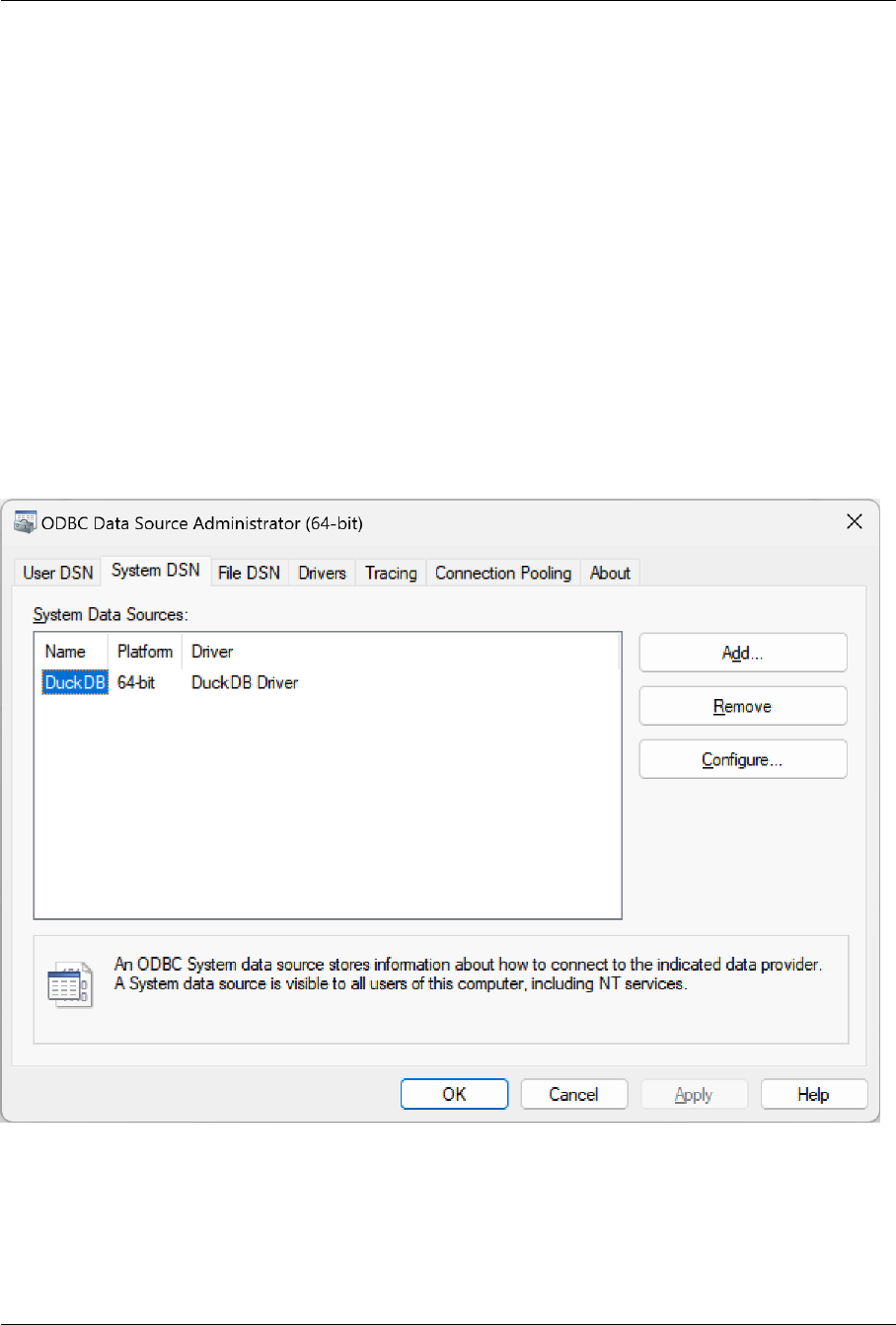
DuckDB Documentation
Step 4: Configure the ODBC Driver
The odbc_install.exe adds a default DSN configuration into the ODBC registries with a default
database :memory:.
DSN Windows Setup Aer the installation, it is possible to change the default DSN configuration or
add a new one using the Windows ODBC Data Source Administrator tool odbcad32.exe.
It also can be launched thought the Windows start:
Default DuckDB DSN The newly installed DSN is visible on the System DSN in the Windows ODBC
Data Source Administrator tool:
Changing DuckDB DSN When selecting the default DSN (i.e., DuckDB) or adding a new configura‑
tion, the following setup window will display:
385
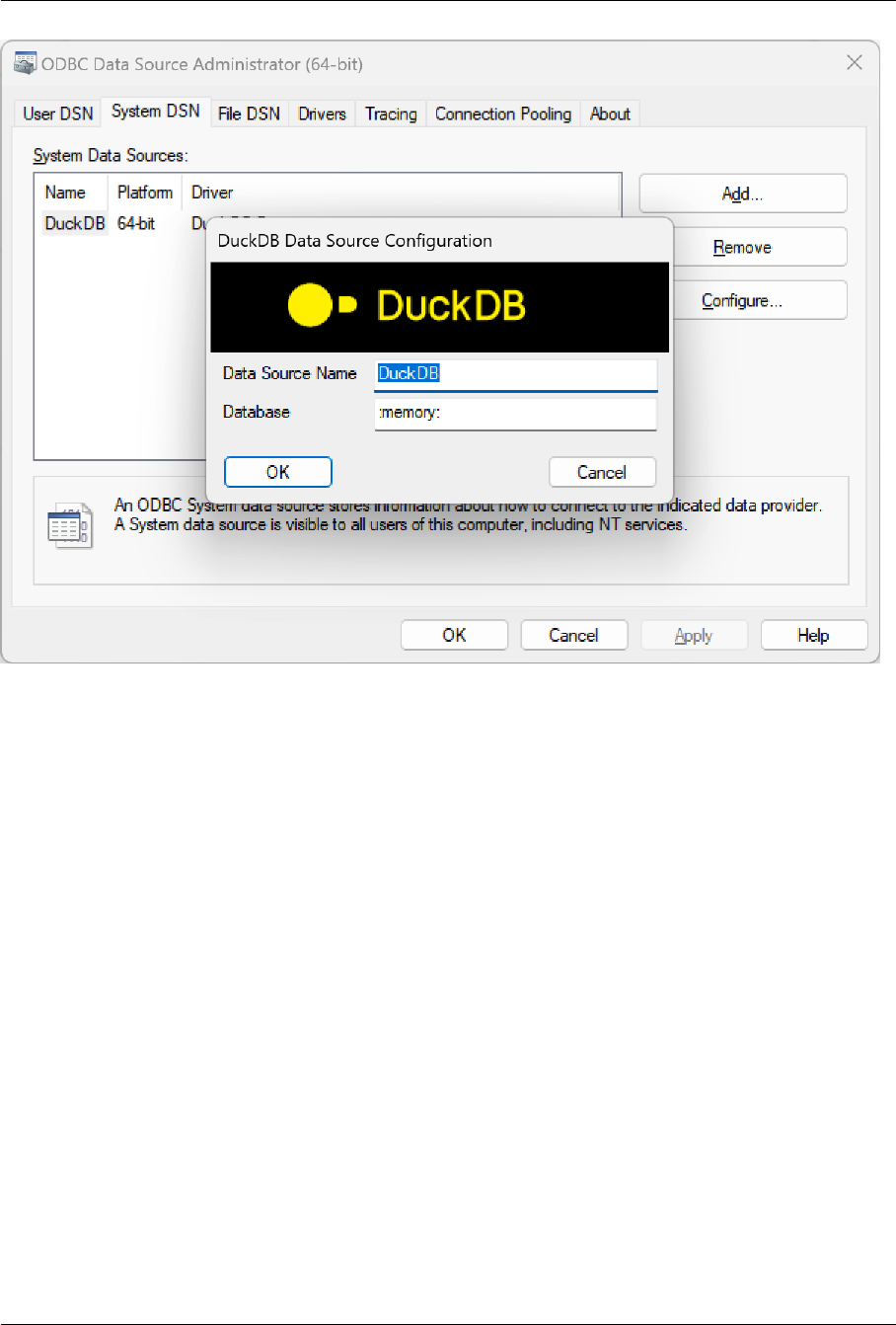
DuckDB Documentation
This window allows you to set the DSN and the database file path associated with that DSN.
More Detailed Windows Setup
The ODBC setup on Windows is based on registry keys (see Registry Entries for ODBC Components).
The ODBC entries can be placed at the current user registry key (HKCU) or the system registry key
(HKLM).
We have tested and used the system entries based on HKLM->SOFTWARE->ODBC. The odbc_
install.exe changes this entry that has two subkeys: ODBC.INI and ODBCINST.INI.
The ODBC.INI is where users usually insert DSN registry entries for the drivers.
For example, the DSN registry for DuckDB would look like this:
386
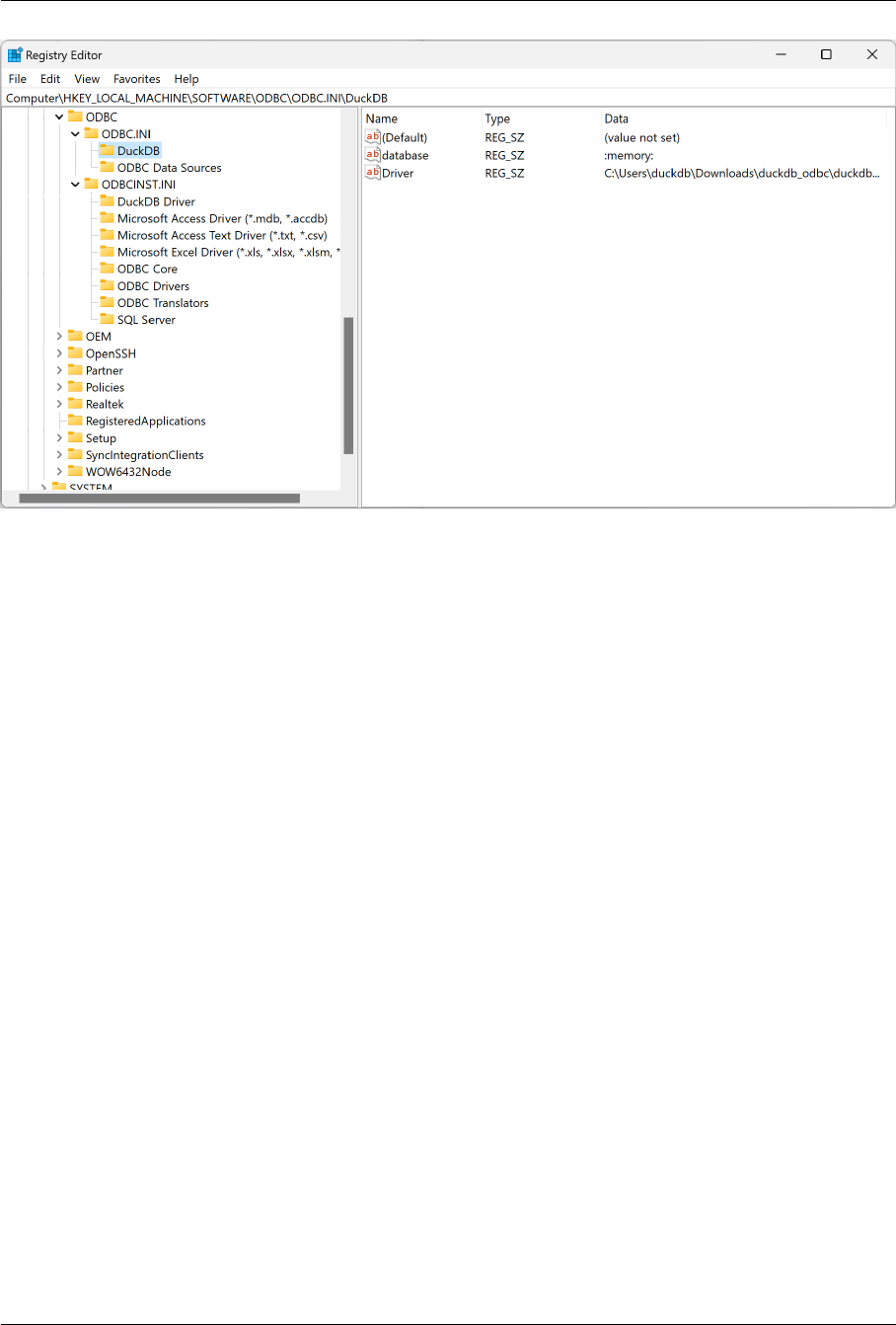
DuckDB Documentation
The ODBCINST.INIcontains one entry for each ODBC driver and other keys predefined for Windows
ODBC configuration.
ODBC API ‑ MacOS
A driver manager is required to manage communication between applications and the ODBC driver.
We tested and support unixODBC that is a complete ODBC driver manager for MacOS (and Linux).
Users can install it from the command line:
Brew
brew install unixodbc
Step 1: Download ODBC Driver
DuckDB releases the ODBC driver as asset. For MacOS, download it from ODBC Linux Asset that con‑
tains the following artifacts:
libduckdb_odbc.dylib: the DuckDB driver compiled to MacOS (with Intel and Apple M1 support).
Step 2: Extracting ODBC Artifacts
Run unzip to extract the files to a permanent directory:
387

DuckDB Documentation
mkdir duckdb_odbc
unzip duckdb_odbc-osx-universal.zip -d duckdb_odbc
Step 3: Configure the ODBC Driver
The odbc.ini or .odbc.ini File The .odbc.ini contains the DSNs for the drivers, which can
have specific knobs.
An example of .odbc.ini with DuckDB would be:
[DuckDB]
Driver = DuckDB Driver
Database=:memory:
[DuckDB]: between the brackets is a DSN for the DuckDB.
Driver: it describes the driver's name, and other configurations will be placed at the .odbcinst.ini.
Database: it describes the database name used by DuckDB, and it can also be a file path to a .db in
the system.
The .odbcinst.ini File The .odbcinst.ini contains general configurations for the ODBC
installed drivers in the system. A driver section starts with the driver name between brackets, and
then it follows specific configuration knobs belonging to that driver.
An example of .odbcinst.ini with the DuckDB driver would be:
[ODBC]
Trace = yes
TraceFile = /tmp/odbctrace
[DuckDB Driver]
Driver = /User/<user>/duckdb_odbc/libduckdb_odbc.dylib
[ODBC]: it is the DM configuration section.
Trace: it enables the ODBC trace file using the option yes.
TraceFile: the absolute system file path for the ODBC trace file.
[DuckDB Driver]: the section of the DuckDB installed driver.
Driver: the absolute system file path of the DuckDB driver.
388

DuckDB Documentation
Step 4 (Optional): Test the ODBC Driver
Aer the configuration, for validate the installation, it is possible to use an odbc client. unixODBC use
a command line tool called isql.
Use the DSN defined in odbc.ini as a parameter of isql.
isql DuckDB
+---------------------------------------+
| Connected! |
| |
| sql-statement |
| help [tablename] |
| echo [string] |
| quit |
| |
+---------------------------------------+
SQL> SELECT 42;
+------------+
| 42 |
+------------+
| 42 |
+------------+
SQLRowCount returns -1
1 rows fetched
389

SQL
SQL Introduction
Here we provide an overview of how to perform simple operations in SQL. This tutorialis only intended
to give you an introduction and is in no way a complete tutorial on SQL. This tutorial is adapted from
the PostgreSQL tutorial.
In the examples that follow, we assume that you have installed the DuckDB Command Line Interface
(CLI) shell. See the installation page for information on how to install the CLI. Launching the shell
should give you the following prompt:
v0.9.1 401c8061c6
Enter ".help" for usage hints.
Connected to a transient in-memory database.
Use ".open FILENAME" to reopen on a persistent database.
D
Note. By launching the database like this, an in‑memory database is launched. That means
that no data is persisted on disk. To persist data on disk you should also pass a database path to
the shell. The database will then be stored at that path and can be reloaded from disk later.
Concepts
DuckDB is a relational database management system(RDBMS). That means it is a systemfor managing
data stored in relations. A relation is essentially a mathematical term for a table.
Each tableis a named collectionof rows. Each rowof a given table has the same set of named columns,
and each column is of a specific data type. Tables themselves are stored inside schemas, and a collec‑
tion of schemas constitutes the entire database that you can access.
Creating a New Table
You can create a new table by specifying the table name, along with all column names and their
types:
391

DuckDB Documentation
CREATE TABLE weather (
city VARCHAR,
temp_lo INTEGER, -- minimum temperature on a day
temp_hi INTEGER, -- maximum temperature on a day
prcp REAL,
date DATE
);
You can enter this into the shell with the line breaks. The command is not terminated until the semi‑
colon.
White space (i.e., spaces, tabs, and newlines) can be used freely in SQL commands. That means you
can type the command aligned dierently than above, or even all on one line. Two dash characters
(--) introduce comments. Whatever follows them is ignored up to the end of the line. SQL is case
insensitive about key words and identifiers.
In the SQL command, we first specify the type of command that we want to perform: CREATE TABLE.
Aer that follows the parameters for the command. First, the table name, weather, is given. Then
the column names and column types follow.
city VARCHAR specifies that the table has a column called city that is of type VARCHAR. VAR-
CHAR specifies a data type that can store text of arbitrary length. The temperature fields are stored in
an
INTEGER
type, a type that stores integer numbers (i.e., whole numbers without a decimal point).
REAL columns store single precision floating‑point numbers (i.e., numbers with a decimal point).
DATE stores a date (i.e., year, month, day combination). DATE only stores the specific day, not a
time associated with that day.
DuckDB supports the standard SQL types INTEGER, SMALLINT, REAL, DOUBLE, DECIMAL,
CHAR(n), VARCHAR(n), DATE, TIME and TIMESTAMP.
The second example will store cities and their associated geographical location:
CREATE TABLE cities (
name VARCHAR,
lat DECIMAL,
lon DECIMAL
);
Finally, it should be mentioned that if you don't need a table any longer or want to recreate it dier‑
ently you can remove it using the following command:
DROP TABLE [tablename];
392

DuckDB Documentation
Populating a Table with Rows
The insert statement is used to populate a table with rows:
INSERT INTO weather VALUES ('San Francisco', 46, 50, 0.25, '1994-11-27');
Constants that are not numeric values (e.g., text and dates) must be surrounded by single quotes (''),
as in the example. Input dates for the date type must be formatted as 'YYYY-MM-DD'.
We can insert into the cities table in the same manner.
INSERT INTO cities
VALUES ('San Francisco', -194.0, 53.0);
The syntax used so far requires you to remember the order of the columns. An alternative syntax
allows you to list the columns explicitly:
INSERT INTO weather (city, temp_lo, temp_hi, prcp, date)
VALUES ('San Francisco', 43, 57, 0.0, '1994-11-29');
You can list the columns in a dierent order if you wish or even omit some columns, e.g., if the prcp
is unknown:
INSERT INTO weather (date, city, temp_hi, temp_lo)
VALUES ('1994-11-29', 'Hayward', 54, 37);
Many developers consider explicitly listing the columns better style than relying on the order implic‑
itly.
Please enter all the commands shown above so you have some data to work with in the following
sections.
You could also have used COPY to load large amounts of data from CSV files. This is usually faster
because the COPY command is optimized for this application while allowing less flexibility than IN-
SERT. An example with weather.csv would be:
COPY weather
FROM 'weather.csv';
Where the file name for the source file must be available on the machine running the process. There
are many other ways of loading data into DuckDB, see the corresponding documentation section for
more information.
Querying a Table
To retrieve data from a table, the table is queried. A SQL SELECT statement is used to do this. The
statement is divided into a select list (the part that lists the columns to be returned), a table list (the
393

DuckDB Documentation
part that lists the tables from which to retrieve the data), and an optional qualification (the part that
specifies any restrictions). For example, to retrieve all the rows of table weather, type:
SELECT *
FROM weather;
Here * is a shorthand for ”all columns”. So the same result would be had with:
SELECT city, temp_lo, temp_hi, prcp, date
FROM weather;
The output should be:
┌───────────────┬─────────┬─────────┬───────┬────────────┐
│ city │ temp_lo │ temp_hi │ prcp │ date │
│ varchar │ int32 │ int32 │ float │ date │
├───────────────┼─────────┼─────────┼───────┼────────────┤
│ San Francisco │ 46 │ 50 │ 0.25 │ 1994-11-27 │
│ San Francisco │ 43 │ 57 │ 0.0 │ 1994-11-29 │
│ Hayward │ 37 │ 54 │ │ 1994-11-29 │
└───────────────┴─────────┴─────────┴───────┴────────────┘
You can write expressions, not just simple column references, in the select list. For example, you can
do:
SELECT city, (temp_hi+temp_lo)/2 AS temp_avg, date
FROM weather;
This should give:
┌───────────────┬──────────┬────────────┐
│ city │ temp_avg │ date │
│ varchar │ double │ date │
├───────────────┼──────────┼────────────┤
│ San Francisco │ 48.0 │ 1994-11-27 │
│ San Francisco │ 50.0 │ 1994-11-29 │
│ Hayward │ 45.5 │ 1994-11-29 │
└───────────────┴──────────┴────────────┘
Notice how the AS clause is used to relabel the output column. (The AS clause is optional.)
A query can be ”qualified” by adding a WHERE clause that specifies which rows are wanted. The
WHERE clause contains a Boolean (truth value) expression, and only rows for which the Boolean ex‑
pression is true are returned. The usual Boolean operators (AND, OR, and NOT) are allowed in the
qualification. For example, the following retrieves the weather of San Francisco on rainy days:
394

DuckDB Documentation
SELECT *
FROM weather
WHERE city = 'San Francisco' AND prcp > 0.0;
Result:
┌───────────────┬─────────┬─────────┬───────┬────────────┐
│ city │ temp_lo │ temp_hi │ prcp │ date │
│ varchar │ int32 │ int32 │ float │ date │
├───────────────┼─────────┼─────────┼───────┼────────────┤
│ San Francisco │
46 │
50 │ 0.25 │ 1994-11-27 │
└───────────────┴─────────┴─────────┴───────┴────────────┘
You can request that the results of a query be returned in sorted order:
SELECT *
FROM weather
ORDER BY city;
┌───────────────┬─────────┬─────────┬───────┬────────────┐
│ city │ temp_lo │ temp_hi │ prcp │ date │
│ varchar │ int32 │ int32 │ float │ date │
├───────────────┼─────────┼─────────┼───────┼────────────┤
│ Hayward │ 37 │ 54 │ │ 1994-11-29 │
│ San Francisco │ 46 │ 50 │ 0.25 │ 1994-11-27 │
│ San Francisco │ 43 │ 57 │ 0.0 │ 1994-11-29 │
└───────────────┴─────────┴─────────┴───────┴────────────┘
In this example, the sort order isn't fully specified, and so you might get the San Francisco rows in
either order. But you'd always get the results shown above if you do:
SELECT *
FROM weather
ORDER BY city, temp_lo;
You can request that duplicate rows be removed from the result of a query:
SELECT DISTINCT city
FROM weather;
┌───────────────┐
│ city │
│ varchar │
├───────────────┤
│ Hayward │
│ San Francisco │
└───────────────┘
395

DuckDB Documentation
Here again, the result row ordering might vary. You can ensure consistent results by using DISTINCT
and ORDER BY together:
SELECT DISTINCT city
FROM weather
ORDER BY city;
Joins between Tables
Thus far, our queries have only accessed one table at a time. Queries can access multiple tables at
once, or access the same table in such a way that multiple rows of the table are being processed at
the same time. A query that accesses multiple rows of the same or dierent tables at one time is called
a join query. As an example, say you wish to list all the weather records together with the location of
the associated city. To do that, we need to compare the city column of each row of the weathertable
with the name column of all rows in the citiestable, and select the pairs of rows where these values
match.
This would be accomplished by the following query:
SELECT *
FROM weather, cities
WHERE city = name;
┌───────────────┬─────────┬─────────┬───────┬────────────┬───────────────┬───────────────┬───────────────┐
│ city │ temp_lo │ temp_hi │ prcp │ date │ name │
lat │ lon │
│ varchar │ int32 │ int32 │ float │ date │ varchar │
decimal(18,3) │ decimal(18,3) │
├───────────────┼─────────┼─────────┼───────┼────────────┼───────────────┼───────────────┼───────────────┤
│ San Francisco │ 46 │ 50 │ 0.25 │ 1994-11-27 │ San Francisco │
-194.000 │ 53.000 │
│ San Francisco │ 43 │ 57 │ 0.0 │ 1994-11-29 │ San Francisco │
-194.000 │ 53.000 │
└───────────────┴─────────┴─────────┴───────┴────────────┴───────────────┴───────────────┴───────────────┘
Observe two things about the result set:
• There is no result row for the city of Hayward. This is because there is no matching entry in the
cities table for Hayward, so the join ignores the unmatched rows in the weather table. We
will see shortly how this can be fixed.
• There are two columns containing the city name. This is correct because the lists of columns
from the weather and cities tables are concatenated. In practice this is undesirable,
though, so you will probably want to list the output columns explicitly rather than using *:
396

DuckDB Documentation
SELECT city, temp_lo, temp_hi, prcp, date, lon, lat
FROM weather, cities
WHERE city = name;
┌───────────────┬─────────┬─────────┬───────┬────────────┬───────────────┬───────────────┐
│ city │ temp_lo │ temp_hi │ prcp │ date │ lon │
lat │
│ varchar │ int32 │ int32 │ float │ date │ decimal(18,3) │
decimal(18,3) │
├───────────────┼─────────┼─────────┼───────┼────────────┼───────────────┼───────────────┤
│ San Francisco │ 46 │ 50 │ 0.25 │ 1994-11-27 │ 53.000 │
-194.000 │
│ San Francisco │ 43 │ 57 │ 0.0 │ 1994-11-29 │ 53.000 │
-194.000 │
└───────────────┴─────────┴─────────┴───────┴────────────┴───────────────┴───────────────┘
Since the columns all had dierent names, the parser automatically found which table they belong
to. If there were duplicate column names in the two tables you'd need to qualify the column names
to show which one you meant, as in:
SELECT weather.city, weather.temp_lo, weather.temp_hi,
weather.prcp, weather.date, cities.lon, cities.lat
FROM weather, cities
WHERE cities.name = weather.city;
It is widely considered good style to qualify all column names in a join query, so that the query won't
fail if a duplicate column name is later added to one of the tables.
Join queries of the kind seen thus far can also be written in this alternative form:
SELECT *
FROM weather
INNER JOIN cities ON weather.city = cities.name;
This syntax is not as commonly used as the one above, but we show it here to help you understand
the following topics.
Now we will figure out how we can get the Hayward records back in. What we want the query to do is
to scan the weather table and for each row to find the matching cities row(s). If no matching row is
found we want some ”empty values” to be substituted for the cities table's columns. This kind of
query is called an outer join. (The joins we have seen so far are inner joins.) The command looks like
this:
SELECT *
FROM weather
LEFT OUTER JOIN cities ON weather.city = cities.name;
397

DuckDB Documentation
┌───────────────┬─────────┬─────────┬───────┬────────────┬───────────────┬───────────────┬───────────────┐
│ city │ temp_lo │ temp_hi │ prcp │ date │ name │
lat │ lon │
│ varchar │ int32 │ int32 │ float │ date │ varchar │
decimal(18,3) │ decimal(18,3) │
├───────────────┼─────────┼─────────┼───────┼────────────┼───────────────┼───────────────┼───────────────┤
│ San Francisco │ 46 │ 50 │ 0.25 │ 1994-11-27 │ San Francisco │
-194.000 │ 53.000 │
│ San Francisco │ 43 │ 57 │ 0.0 │ 1994-11-29 │ San Francisco │
-194.000 │ 53.000 │
│ Hayward │ 37 │ 54 │ │ 1994-11-29 │ │
│ │
└───────────────┴─────────┴─────────┴───────┴────────────┴───────────────┴───────────────┴───────────────┘
This query is called a le outer join because the table mentioned on the le of the join operator will
have each of its rows in the output at least once, whereas the table on the right will only have those
rows output that match some row of the le table. When outputting a le‑table row for which there
is no right‑table match, empty (null) values are substituted for the right‑table columns.
Aggregate Functions
Like most other relational database products, DuckDB supports aggregate functions. An aggregate
function computes a single result from multiple input rows. For example, there are aggregates to
compute the count, sum, avg (average), max (maximum) and min (minimum) over a set of rows.
As an example, we can find the highest low‑temperature reading anywhere with:
SELECT max(temp_lo)
FROM weather;
┌──────────────┐
│ max(temp_lo) │
│ int32 │
├──────────────┤
│ 46 │
└──────────────┘
If we wanted to know what city (or cities) that reading occurred in, we might try:
SELECT city
FROM weather
WHERE temp_lo = max(temp_lo); -- WRONG
398

DuckDB Documentation
but this will not work since the aggregate max cannot be used in the WHERE clause. (This restriction
exists because the WHEREclause determines which rows will be included in the aggregate calculation;
so obviously it has to be evaluated before aggregate functions are computed.) However, as is oen
the case the query can be restated to accomplish the desired result, here by using a subquery:
SELECT city
FROM weather
WHERE temp_lo = (SELECT max(temp_lo) FROM weather);
┌───────────────┐
│ city │
│ varchar │
├───────────────┤
│ San Francisco │
└───────────────┘
This is OK because the subquery is an independent computation that computes its own aggregate
separately from what is happening in the outer query.
Aggregates are also very useful in combination with GROUP BY clauses. For example, we can get the
maximum low temperature observed in each city with:
SELECT city, max(temp_lo)
FROM weather
GROUP BY city;
┌───────────────┬──────────────┐
│ city │ max(temp_lo) │
│ varchar │ int32 │
├───────────────┼──────────────┤
│ San Francisco │ 46 │
│ Hayward │ 37 │
└───────────────┴──────────────┘
Which gives us one output row per city. Each aggregate result is computed over the table rows match‑
ing that city. We can filter these grouped rows using HAVING:
SELECT city, max(temp_lo)
FROM weather
GROUP BY city
HAVING max(temp_lo) < 40;
┌─────────┬──────────────┐
│ city │ max(temp_lo) │
│ varchar │ int32 │
399

DuckDB Documentation
├─────────┼──────────────┤
│ Hayward │ 37 │
└─────────┴──────────────┘
which gives us the same results for only the cities that have all temp_lo values below 40. Finally, if
we only care about cities whose names begin with ”S”, we can use the LIKE operator:
SELECT city, max(temp_lo)
FROM weather
WHERE city LIKE 'S%' -- (1)
GROUP BY city
HAVING max(temp_lo) < 40;
More information about the LIKE operator can be found here.
It is important to understand the interaction between aggregates and SQL's WHERE and HAVING
clauses. The fundamental dierence between WHERE and HAVING is this: WHERE selects input rows
before groups and aggregates are computed (thus, it controls which rows go into the aggregate com‑
putation), whereas HAVING selects group rows aer groups and aggregates are computed. Thus, the
WHERE clause must not contain aggregate functions; it makes no sense to try to use an aggregate to
determine which rows will be inputs to the aggregates. On the other hand, the HAVINGclause always
contains aggregate functions.
In the previous example, we can apply the city name restriction in WHERE, since it needs no aggregate.
This is more eicient than adding the restriction to HAVING, because we avoid doing the grouping and
aggregate calculations for all rows that fail the WHERE check.
Updates
You can update existing rows using the UPDATE command. Suppose you discover the temperature
readings are all o by 2 degrees aer November 28. You can correct the data as follows:
UPDATE weather
SET temp_hi = temp_hi - 2, temp_lo = temp_lo - 2
WHERE date > '1994-11-28';
Look at the new state of the data:
SELECT *
FROM weather;
┌───────────────┬─────────┬─────────┬───────┬────────────┐
│ city │ temp_lo │ temp_hi │ prcp │ date │
│ varchar │ int32 │ int32 │ float │ date │
400

DuckDB Documentation
├───────────────┼─────────┼─────────┼───────┼────────────┤
│ San Francisco │ 46 │ 50 │ 0.25 │ 1994-11-27 │
│ San Francisco │ 41 │ 55 │ 0.0 │ 1994-11-29 │
│ Hayward │ 35 │ 52 │ │ 1994-11-29 │
└───────────────┴─────────┴─────────┴───────┴────────────┘
Deletions
Rows can be removed from a table using the DELETE command. Suppose you are no longer inter‑
ested in the weather of Hayward. Then you can do the following to delete those rows from the table:
DELETE FROM weather
WHERE city = 'Hayward';
All weather records belonging to Hayward are removed.
SELECT *
FROM weather;
┌───────────────┬─────────┬─────────┬───────┬────────────┐
│ city │ temp_lo │ temp_hi │ prcp │ date │
│ varchar │ int32 │ int32 │ float │ date │
├───────────────┼─────────┼─────────┼───────┼────────────┤
│ San Francisco │ 46 │ 50 │ 0.25 │ 1994-11-27 │
│ San Francisco │ 41 │ 55 │ 0.0 │ 1994-11-29 │
└───────────────┴─────────┴─────────┴───────┴────────────┘
One should be wary of statements of the form
DELETE FROM tablename;
Without a qualification, DELETE will remove all rows from the given table, leaving it empty. The sys‑
tem will not request confirmation before doing this!
Statements
Statements Overview
Alter Table
The ALTER TABLE statement changes the schema of an existing table in the catalog.
401

DuckDB Documentation
Examples
-- add a new column with name "k" to the table "integers", it will be filled
with the default value NULL
ALTER TABLE integers ADD COLUMN k INTEGER;
-- add a new column with name "l" to the table integers, it will be filled
with the default value 10
ALTER TABLE integers ADD COLUMN l INTEGER DEFAULT 10;
-- drop the column "k" from the table integers
ALTER TABLE integers DROP k;
-- change the type of the column "i" to the type "VARCHAR" using a standard
cast
ALTER TABLE integers ALTER i TYPE VARCHAR;
-- change the type of the column "i" to the type "VARCHAR", using the
specified expression to convert the data for each row
ALTER TABLE integers ALTER i SET DATA TYPE VARCHAR USING CONCAT(i, '_', j);
-- set the default value of a column
ALTER TABLE integers ALTER COLUMN i SET DEFAULT 10;
-- drop the default value of a column
ALTER TABLE integers ALTER COLUMN i DROP DEFAULT;
-- make a column not nullable
ALTER TABLE t ALTER COLUMN x SET NOT NULL;
-- drop the not null constraint
ALTER TABLE t ALTER COLUMN x DROP NOT NULL;
-- rename a table
ALTER TABLE integers RENAME TO integers_old;
-- rename a column of a table
ALTER TABLE integers RENAME i TO j;
Syntax
ALTER TABLEchanges the schema of an existingtable. All the changes made by ALTER TABLEfully
respect the transactional semantics, i.e., they will not be visible to other transactions until committed,
and can be fully reverted through a rollback.
402

DuckDB Documentation
RENAME TABLE
-- rename a table
ALTER TABLE integers RENAME TO integers_old;
The RENAME TO clause renames an entire table, changing its name in the schema. Note that any
views that rely on the table are not automatically updated.
RENAME COLUMN
-- rename a column of a table
ALTER TABLE integers RENAME i TO j;
ALTER TABLE integers RENAME COLUMN j TO k;
The RENAME COLUMN clause renames a single column within a table. Any constraints that rely on
this name (e.g., CHECK constraints) are automatically updated. However, note that any views that
rely on this column name are not automatically updated.
ADD COLUMN
-- add a new column with name "k" to the table "integers", it will be filled
with the default value NULL
ALTER TABLE integers ADD COLUMN k INTEGER;
-- add a new column with name "l" to the table integers, it will be filled
with the default value 10
ALTER TABLE integers ADD COLUMN l INTEGER DEFAULT 10;
The ADD COLUMN clause can be used to add a new column of a specified type to a table. The new
column will be filled with the specified default value, or NULL if none is specified.
DROP COLUMN
-- drop the column "k" from the table integers
ALTER TABLE integers DROP k;
The DROP COLUMN clause can be used to remove a column from a table. Note that columns can
only be removed if they do not have any indexes that rely on them. This includes any indexes created
as part of a PRIMARY KEY or UNIQUE constraint. Columns that are part of multi‑column check
constraints cannot be dropped either.
403

DuckDB Documentation
ALTER TYPE
-- change the type of the column "i" to the type "VARCHAR" using a standard
cast
ALTER TABLE integers ALTER i TYPE VARCHAR;
-- change the type of the column "i" to the type "VARCHAR", using the
specified expression to convert the data for each row
ALTER TABLE integers ALTER i SET DATA TYPE VARCHAR USING CONCAT(i, '_', j);
The SET DATA TYPEclause changes the type of a column in a table. Any data present in the column
is converted according to the provided expression in the USING clause, or, if the USING clause is
absent, cast to the new data type. Note that columns can only have their type changed if they do not
have any indexes that rely on them and are not part of any CHECK constraints.
SET/DROP DEFAULT
-- set the default value of a column
ALTER TABLE integers ALTER COLUMN i SET DEFAULT 10;
-- drop the default value of a column
ALTER TABLE integers ALTER COLUMN i DROP DEFAULT;
The SET/DROP DEFAULT clause modifies the DEFAULT value of an existing column. Note that this
does not modify any existing data in the column. Dropping the default is equivalent to setting the
default value to NULL.
Note. At the moment DuckDB will not allow you to alter a table if there are any dependencies.
That means that if you have an index on a column you will first need to drop the index, alter the
table, and then recreate the index. Otherwise you will get a ”Dependency Error.”
ADD/DROP CONSTRAINT
Note. The ADD CONSTRAINT and DROP CONSTRAINT clauses are not yet supported in
DuckDB.
Alter View
The ALTER VIEW statement changes the schema of an existing view in the catalog.
404

DuckDB Documentation
Examples
-- rename a view
ALTER VIEW v1 RENAME TO v2;
ALTER VIEW changes the schema of an existing table. All the changes made by ALTER VIEW fully
respect the transactional semantics, i.e., they will not be visible to other transactions until committed,
and can be fully reverted through a rollback. Note that other views that rely on the table are not
automatically updated.
Attach/Detach
The ATTACH statement adds a new database file to the catalog that can be read from and written
to.
Examples
-- attach the database "file.db" with the alias inferred from the name
("file")
ATTACH 'file.db';
-- attach the database "file.db" with an explicit alias ("file_db")
ATTACH 'file.db' AS file_db;
-- attach the database "file.db" in read only mode
ATTACH 'file.db' (READ_ONLY);
-- attach a SQLite database for reading and writing (see sqlite extension
for more information)
ATTACH 'sqlite_file.db' AS sqlite (TYPE SQLITE);
-- create a table in the attached database with alias "file"
CREATE TABLE file.new_table(i INTEGER);
-- detach the database with alias "file"
DETACH file;
-- show a list of all attached databases
SHOW databases;
-- change the default database that is used to the database "file"
USE file;
Syntax
ATTACHallows DuckDB to operate on multiple database files, and allows for transfer of data between
dierent database files.
405

DuckDB Documentation
Detach
The DETACH statement allows previously attached database files to be closed and detached, releas‑
ing any locks held on the database file.
Name Qualification
The fully qualified name of catalog objects contains the catalog, the schema and the name of the
object. For example:
-- attach the database "new_db"
ATTACH 'new_db.db';
-- create the schema "my_schema" in the database "new_db"
CREATE SCHEMA new_db.my_schema;
-- create the table "my_table" in the schema "my_schema"
CREATE TABLE new_db.my_schema.my_table(col INTEGER);
-- refer to the column "col" inside the table "my_table"
SELECT new_db.my_schema.my_table.col FROM new_db.my_schema.my_table;
Note that oen the fully qualified name is not required. When a name is not fully qualified, the system
looks for which entries to reference using the catalog search path. The default catalog search path
includes the system catalog, the temporary catalog and the initially attached database together with
the main schema.
Default Database and Schema When a table is created without any qualifications, the table is cre‑
ated in the default schema of the default database. The default database is the database that is
launched when the system is created ‑ and the default schema is main.
-- create the table "my_table" in the default database
CREATE TABLE my_table(col INTEGER);
Changing the Default Database and Schema The default database and schema can be changed
using the USE command.
-- set the default database schema to `new_db.main`
USE new_db;
-- set the default database schema to `new_db.my_schema`
USE new_db.my_schema;
406

DuckDB Documentation
Resolving Conflicts When providing only a single qualification, the system can interpret this as ei‑
ther a catalog or a schema, as long as there are no conflicts. For example:
ATTACH 'new_db.db';
CREATE SCHEMA my_schema;
-- creates the table "new_db.main.tbl"
CREATE TABLE new_db.tbl(i INTEGER);
-- creates the table "default_db.my_schema.tbl"
CREATE TABLE my_schema.tbl(i INTEGER);
If we create a conflict (i.e., we have both a schema and a catalog with the same name) the system
requests that a fully qualified path is used instead:
CREATE SCHEMA new_db;
CREATE TABLE new_db.tbl(i INTEGER);
-- Error: Binder Error: Ambiguous reference to catalog or schema "new_db" -
use a fully qualified path like "memory.new_db"
Changing the Catalog Search Path The catalog search path can be adjusted by setting the
search_path configuration option, which uses a comma‑separated list of values that will be on
the search path. The following example demonstrates searching in two databases:
ATTACH ':memory:' AS db1;
ATTACH ':memory:' AS db2;
CREATE table db1.tbl1 (i INTEGER);
CREATE table db2.tbl2 (j INTEGER);
-- reference the tables using their fully qualified name
SELECT * FROM db1.tbl1;
SELECT * FROM db2.tbl2;
-- or set the search path and reference the tables using their name
SET search_path='db1,db2';
SELECT * FROM tbl1;
SELECT * FROM tbl2;
Transactional Semantics
When running queries on multiple databases, the system opens separate transactions per database.
The transactions are started lazily by default ‑ when a given database is referenced for the first time
in a query, a transaction for that database will be started. SET immediate_transaction_
mode=true can be toggled to change this behavior to eagerly start transactions in all attached
databases instead.
407

DuckDB Documentation
While multiple transactions can be active at a time ‑ the system only supports writing to a single at‑
tached database in a single transaction. If you try to write to multiple attached databases in a single
transaction the following error will be thrown:
Attempting to write to database "db2" in a transaction that has already
modified database "db1" - a single transaction can only write to a
single attached database.
The reason for this restriction is that the system does not maintain atomicity for transactions across
attached databases. Transactions are only atomic within each database file. By restricting the global
transaction to write to only a single database file the atomicity guarantees are maintained.
Call
The CALL statement invokes the given table function and returns the results.
Examples
-- Invoke the 'duckdb_functions' table function.
CALL duckdb_functions();
-- Invoke the 'pragma_table_info' table function.
CALL pragma_table_info('pg_am');
Syntax
Checkpoint
The CHECKPOINT statement synchronizes data in the write‑ahead log (WAL) to the database data file.
For in‑memory databases this statement will succeed with no eect.
Examples
-- Synchronize data in the default database
CHECKPOINT;
-- Synchronize data in the specified database
CHECKPOINT file_db;
-- Abort any in-progress transactions to synchronize the data
FORCE CHECKPOINT;
408

DuckDB Documentation
Syntax
Checkpoint operations happen automatically based on the WAL size (see Configuration). This state‑
ment is for manual checkpoint actions.
Behavior
The default CHECKPOINT command will fail if there are any running transactions. Including FORCE
will abort any transactions and execute the checkpoint operation.
Also see the related pragma for further behavior modification.
Copy
Examples
-- read a CSV file into the lineitem table - using auto-detected options
COPY lineitem FROM 'lineitem.csv' (AUTO_DETECT true);
-- read a parquet file into the lineitem table
COPY lineitem FROM 'lineitem.pq' (FORMAT PARQUET);
-- read a json file into the lineitem table - using auto-detected options
COPY lineitem FROM 'lineitem.json' (FORMAT JSON, AUTO_DETECT true);
-- write a table to a CSV file
COPY lineitem TO 'lineitem.csv' (FORMAT CSV, DELIMITER '|', HEADER);
-- write the result of a query to a Parquet file
COPY (SELECT l_orderkey, l_partkey FROM lineitem) TO 'lineitem.parquet'
(COMPRESSION ZSTD);
COPY Statements
COPY moves data between DuckDB and external files. COPY ... FROM imports data into DuckDB
from an external file. COPY ... TOwrites data from DuckDB to an external file. The COPYcommand
can be used for CSV, PARQUET and JSON files.
COPY FROM COPY ... FROM imports data from an external file into an existing table. The data
is appended to whatever data is in the table already. The amount of columns inside the file must
match the amount of columns in the table table_name, and the contents of the columns must be
convertible to the column types of the table. In case this is not possible, an error will be thrown.
409

DuckDB Documentation
If a list of columns is specified, COPY will only copy the data in the specified columns from the file. If
there are any columns in the table that are not in the column list, COPY ... FROM will insert the
default values for those columns
-- Copy the contents of a comma-separated file 'test.csv' without a header
into the table 'test'
COPY test FROM 'test.csv';
-- Copy the contents of a comma-separated file with a header into the
'category' table
COPY category FROM 'categories.csv' (HEADER);
-- Copy the contents of 'lineitem.tbl' into the 'lineitem' table, where the
contents are delimited by a pipe character ('|')
COPY lineitem FROM 'lineitem.tbl' (DELIMITER '|');
-- Copy the contents of 'lineitem.tbl' into the 'lineitem' table, where the
delimiter, quote character, and presence of a header are automatically
detected
COPY lineitem FROM 'lineitem.tbl' (AUTO_DETECT true);
-- Read the contents of a comma-separated file 'names.csv' into the 'name'
column of the 'category' table. Any other columns of this table are
filled with their default value.
COPY category(name) FROM 'names.csv';
-- Read the contents of a parquet file 'lineitem.parquet' into the lineitem
table
COPY lineitem FROM 'lineitem.parquet' (FORMAT PARQUET);
-- Read the contents of a newline-delimited json file 'lineitem.ndjson' into
the lineitem table
COPY lineitem FROM 'lineitem.ndjson' (FORMAT JSON);
-- Read the contents of a json file 'lineitem.json' into the lineitem table
COPY lineitem FROM 'lineitem.json' (FORMAT JSON, ARRAY true);
Syntax
COPY TO COPY ... TO exports data from DuckDB to an external CSV or Parquet file. It has mostly
the same set of options as COPY ... FROM, however, in the case of COPY ... TO the options
specify how the file should be written to disk. Any file created by COPY ... TO can be copied back
into the database by using COPY ... FROM with a similar set of options.
The COPY ... TO function can be called specifying either a table name, or a query. When a table
name is specified, the contents of the entire table will be written into the resulting file. When a query
is specified, the query is executed and the result of the query is written to the resulting file.
410

DuckDB Documentation
-- Copy the contents of the 'lineitem' table to the file 'lineitem.tbl',
where the columns are delimited by a pipe character ('|'), including a
header line.
COPY lineitem TO 'lineitem.tbl' (DELIMITER '|', HEADER);
-- Copy the l_orderkey column of the 'lineitem' table to the file
'orderkey.tbl'
COPY lineitem(l_orderkey) TO 'orderkey.tbl' (DELIMITER '|');
-- Copy the result of a query to the file 'query.csv', including a header
with column names
COPY (SELECT 42 AS a, 'hello' AS b) TO 'query.csv' WITH (HEADER 1, DELIMITER
',');
-- Copy the result of a query to the Parquet file 'query.parquet'
COPY (SELECT 42 AS a, 'hello' AS b) TO 'query.parquet' (FORMAT PARQUET);
-- Copy the result of a query to the newline-delimited JSON file
'query.ndjson'
COPY (SELECT 42 AS a, 'hello' AS b) TO 'query.ndjson' (FORMAT JSON);
-- Copy the result of a query to the JSON file 'query.json'
COPY (SELECT 42 AS a, 'hello' AS b) TO 'query.json' (FORMAT JSON, ARRAY
true);
Syntax
COPY Options Zero or more copy options may be provided as a part of the copy operation. The
WITH specifier is optional, but if any options are specified, the parentheses are required. Parameter
values can be passed in with or without wrapping in single quotes.
Any option that is a Boolean can be enabled or disabled in multiple ways. You can write true, ON, or
1
to enable the option, and
false
,
OFF
, or
0
to disable it. The Boolean value can also be omitted
(e.g., by only passing (HEADER)), in which case true is assumed.
The below options are applicable to all formats written with COPY.
Name Description Type Default
allow_
overwrite
Whether or not to allow overwriting a
directory if one already exists. Only has an
eect when used with partition_by.
BOOL false
411

DuckDB Documentation
Name Description Type Default
format Specifies the copy function to use. The
default is selected from the file extension
(e.g., .parquet results in a Parquet file
being written/read). If the file extension is
unknown CSV is selected. Available
options are CSV, PARQUET and JSON.
VARCHAR auto
partition_by The columns to partition by using a hive
partitioning scheme, see the partitioned
writes section.
VARCHAR[] (empty)
per_thread_
output
Generate one file per thread, rather than
one file in total. This allows for faster
parallel writing.
BOOL false
use_tmp_file Whether or not to write to a temporary file
first if the original file exists
(target.csv.tmp). This prevents
overwriting an existing file with a broken
file in case the writing is cancelled.
BOOL auto
CSV Options The below options are applicable when writing CSV files.
Name Description Type Default
compression The compression type for the file. By
default this will be detected automatically
from the file extension (e.g.,
file.csv.gz will use gzip, file.csv
will use none). Options are none, gzip,
zstd.
VARCHAR auto
force_quote The list of columns to always add quotes
to, even if not required.
VARCHAR[] []
dateformat Specifies the date format to use when
writing dates. See Date Format
VARCHAR (empty)
412

DuckDB Documentation
Name Description Type Default
delim or sep The character that is written to separate
columns within each row.
VARCHAR ,
escape The character that should appear before a
character that matches the quote value.
VARCHAR "
header Whether or not to write a header for the
CSV file.
BOOL true
nullstr The string that is written to represent a
NULL value.
VARCHAR (empty)
quote The quoting character to be used when a
data value is quoted.
VARCHAR "
timestampformat Specifies the date format to use when
writing timestamps. See Date Format
VARCHAR (empty)
Parquet Options The below options are applicable when writing Parquet files.
Name Description Type Default
compression The compression format to use
(uncompressed, snappy, gzip or
zstd).
VARCHAR snappy
row_group_size The target size, i.e., number of rows, of
each row‑group.
BIGINT 122880
row_group_
size_bytes
The target size of each row‑group. You can
pass either a human‑readable string, e.g.,
'2MB', or an integer, i.e., the number of
bytes. This option is only used when you
have issued SET preserve_
insertion_order=false;,
otherwise it is ignored.
BIGINT row_
group_
size *
1024
field_ids The field_id for each column. Pass
auto to attempt to infer automatically.
STRUCT (empty)
413

DuckDB Documentation
Some examples of FIELD_IDS are:
-- Assign field_ids automatically
COPY (SELECT 128 AS i)
TO 'my.parquet' (FIELD_IDS 'auto');
-- Sets the field_id of column 'i' to 42
COPY (SELECT 128 AS i)
TO 'my.parquet' (FIELD_IDS {i: 42});
-- Sets the field_id of column 'i' to 42, and column 'j' to 43
COPY (SELECT 128 AS i, 256 AS j)
TO 'my.parquet' (FIELD_IDS {i: 42, j: 43});
-- Sets the field_id of column 'my_struct' to 43,
-- and column 'i' (nested inside 'my_struct') to 43
COPY (SELECT {i: 128} AS my_struct)
TO 'my.parquet' (FIELD_IDS {my_struct: {__duckdb_field_id: 42, i: 43}});
-- Sets the field_id of column 'my_list' to 42,
-- and column 'element' (default name of list child) to 43
COPY (SELECT [128, 256] AS my_list)
TO 'my.parquet' (FIELD_IDS {my_list: {__duckdb_field_id: 42, element: 43}});
-- Sets the field_id of colum 'my_map' to 42,
-- and columns 'key' and 'value' (default names of map children) to 43 and 44
COPY (SELECT map {'key1' : 128, 'key2': 256} my_map)
TO 'my.parquet' (FIELD_IDS {my_map: {__duckdb_field_id: 42, key: 43, value:
44}});
JSON Options The below options are applicable when writing JSON files.
Name Description Type Default
compression The compression type for the file. By
default this will be detected automatically
from the file extension (e.g.,
file.csv.gz will use gzip, file.csv
will use none). Options are none, gzip,
zstd.
VARCHAR auto
dateformat Specifies the date format to use when
writing dates. See Date Format
VARCHAR (empty)
timestampformat Specifies the date format to use when
writing timestamps. See Date Format
VARCHAR (empty)
414

DuckDB Documentation
Name Description Type Default
array Whether to write a JSON array. If true, a
JSON array of records is written, if false,
newline‑delimited JSON is written
BOOL false
Create Macro
The CREATE MACRO statement can create a scalar or table macro (function) in the catalog. A macro
may only be a single SELECT statement (similar to a VIEW), but it has the benefit of accepting pa‑
rameters. For a scalar macro, CREATE MACRO is followed by the name of the macro, and optionally
parameters within a set of parentheses. The keyword AS is next, followed by the text of the macro.
By design, a scalar macro may only return a single value. For a table macro, the syntax is similar to a
scalar macro except AS is replaced with AS TABLE. A table macro may return a table of arbitrary size
and shape.
If a MACRO is temporary, it is only usable within the same database connection and is deleted when
the connection is closed.
Examples
-- create a macro that adds two expressions (a and b)
CREATE MACRO add(a, b) AS a + b;
-- create a macro for a case expression
CREATE MACRO ifelse(a, b, c) AS CASE WHEN a THEN b ELSE c END;
-- create a macro that does a subquery
CREATE MACRO one() AS (SELECT 1);
-- create a macro with a common table expression
-- (parameter names get priority over column names: disambiguate using the
table name)
CREATE MACRO plus_one(a) AS (WITH cte AS (SELECT 1 AS a) SELECT cte.a + a
FROM cte);
-- macro's are schema-dependent, and have an alias: FUNCTION
CREATE FUNCTION main.myavg(x) AS SUM(x) / COUNT(x);
-- create a macro with default constant parameters
CREATE MACRO add_default(a, b := 5) AS a + b;
-- create a macro arr_append (with a functionality equivalent to array_
append)
CREATE MACRO arr_append(l, e) AS list_concat(l, list_value(e));
415

DuckDB Documentation
-- TABLE MACROS
-- create a table macro without parameters
CREATE MACRO static_table() AS TABLE SELECT 'Hello' AS column1, 'World' AS
column2;
-- create a table macro with parameters (that can be of any type)
CREATE MACRO dynamic_table(col1_value, col2_value) AS TABLE SELECT col1_
value AS column1, col2_value AS column2;
-- create a table macro that returns multiple rows.
-- It will be replaced if it already exists, and it is temporary (will be
automatically deleted when the connection ends)
CREATE OR REPLACE TEMP MACRO dynamic_table(col1_value, col2_value) AS TABLE
SELECT col1_value AS column1, col2_value AS column2
UNION ALL
SELECT 'Hello' AS col1_value, 456 AS col2_value;
Syntax
Macros allow you to create shortcuts for combinations of expressions.
-- failure! cannot find column "b"
CREATE MACRO add(a) AS a + b;
-- this works
CREATE MACRO add(a, b) AS a + b;
-- error! cannot bind +(VARCHAR, INTEGER)
SELECT add('hello', 3);
-- success!
SELECT add(1, 2);
-- 3
Macro's can have default parameters. Unlike some languages, default parameters must be named
when the macro is invoked.
-- b is a default parameter
CREATE MACRO add_default(a, b := 5) AS a + b;
-- the following will result in 42
SELECT add_default(37);
-- error! add_default only has one positional parameter
SELECT add_default(40, 2);
-- success! default parameters are used by assigning them like so
SELECT add_default(40, b:=2);
-- error! default parameters must come after positional parameters
SELECT add_default(b=2, 40);
416

DuckDB Documentation
-- the order of default parameters does not matter
CREATE MACRO triple_add(a, b := 5, c := 10) AS a + b + c;
-- success!
SELECT triple_add(40, c := 1, b := 1);
-- 42
When macro's are used, they are expanded (i.e., replaced with the original expression), and the pa‑
rameters within the expanded expression are replaced with the supplied arguments. Step by step:
-- the 'add' macro we defined above is used in a query
SELECT add(40, 2);
-- internally, add is replaced with its definition of a + b
SELECT a + b;
-- then, the parameters are replaced by the supplied arguments
SELECT 40 + 2;
-- 42
Create Schema
The CREATE SCHEMA statement creates a schema in the catalog. The default schema is main.
Examples
-- create a schema
CREATE SCHEMA s1;
-- create a schema if it does not exist yet
CREATE SCHEMA IF NOT EXISTS s2;
-- create table in the schemas
CREATE TABLE s1.t(id INTEGER PRIMARY KEY, other_id INTEGER);
CREATE TABLE s2.t(id INTEGER PRIMARY KEY, j VARCHAR);
-- compute a join between tables from two schemas
SELECT * FROM s1.t s1t, s2.t s2t WHERE s1t.other_id = s2t.id;
Syntax
Create Sequence
The CREATE SEQUENCE statement creates a new sequence number generator.
417

DuckDB Documentation
Examples
-- generate an ascending sequence starting from 1
CREATE SEQUENCE serial;
-- generate sequence from a given start number
CREATE SEQUENCE serial START 101;
-- generate odd numbers using INCREMENT BY
CREATE SEQUENCE serial START WITH 1 INCREMENT BY 2;
-- generate a descending sequqnce starting from 99
CREATE SEQUENCE serial START WITH 99 INCREMENT BY -1 MAXVALUE 99;
-- by default, cycles are not allowed and will result in a Serialization
Error, e.g.:
-- reached maximum value of sequence "serial" (10)
CREATE SEQUENCE serial START WITH 1 MAXVALUE 10;
-- CYCLE allows cycling through the same sequence repeatedly
CREATE SEQUENCE serial START WITH 1 MAXVALUE 10 CYCLE;
Sequences can be created and dropped similarly to other catalogue items:
-- overwrite an existing sequence
CREATE OR REPLACE SEQUENCE serial;
-- only create sequence if no such sequence exists yet
CREATE SEQUENCE IF NOT EXISTS serial;
-- remove sequence
DROP SEQUENCE serial;
-- remove sequence if exists
DROP SEQUENCE IF EXISTS serial;
Selecting the Next Value Select the next number from a sequence:
SELECT nextval('serial') AS nextval;
┌─────────┐
│ nextval │
│ int64 │
├─────────┤
│ 1 │
└─────────┘
Using this sequence in an INSERT command:
INSERT INTO distributors VALUES (nextval('serial'), 'nothing');
418

DuckDB Documentation
Selecting the Current Value You may also view the current number from the sequence. Note that
the nextval function must have already been called before calling currval, otherwise a Serializa‑
tion Error (”sequence is not yet defined in this session”) will be thrown.
SELECT currval('serial') AS currval;
┌─────────┐
│ currval │
│ int64 │
├─────────┤
│ 1 │
└─────────┘
Syntax CREATE SEQUENCE creates a new sequence number generator.
If a schema name is given then the sequence is created in the specified schema. Otherwise it is created
in the current schema. Temporary sequences exist in a special schema, so a schema name may not
be given when creating a temporary sequence. The sequence name must be distinct from the name
of any other sequence in the same schema.
Aer a sequence is created, you use the function nextval to operate on the sequence.
Parameters
Name Description
TEMPORARY or TEMP If specified, the sequence object is created only for this session,
and is automatically dropped on session exit. Existing
permanent sequences with the same name are not visible (in this
session) while the temporary sequence exists, unless they are
referenced with schema‑qualified names.
name The name (optionally schema‑qualified) of the sequence to be
created.
increment The optional clause INCREMENT BY increment specifies
which value is added to the current sequence value to create a
new value. A positive value will make an ascending sequence, a
negative one a descending sequence. The default value is 1.
419

DuckDB Documentation
Name Description
minvalue The optional clause MINVALUE minvalue determines the
minimum value a sequence can generate. If this clause is not
supplied or NO MINVALUE is specified, then defaults will be
used. The defaults are 1 and ‑(2^63 ‑ 1) for ascending and
descending sequences, respectively.
maxvalue The optional clause MAXVALUE maxvalue determines the
maximum value for the sequence. If this clause is not supplied or
NO MAXVALUEis specified, then default values will be used. The
defaults are 2^63 ‑ 1 and ‑1 for ascending and descending
sequences, respectively.
start The optional clause START WITH start allows the sequence
to begin anywhere. The default starting value is minvalue for
ascending sequences and maxvalue for descending ones.
CYCLE or NO CYCLE The CYCLE option allows the sequence to wrap around when the
maxvalue or minvalue has been reached by an ascending or
descending sequence respectively. If the limit is reached, the
next number generated will be the minvalue or maxvalue,
respectively.
If NO CYCLE is specified, any calls to nextval aer the sequence has reached its maximum value will
return an error. If neither CYCLE or NO CYCLE are specified, NO CYCLE is the default.
Note. Sequences are based on BIGINT arithmetic, so the range cannot exceed the range of an
eight‑byte integer (‑9223372036854775808 to 9223372036854775807).
Create Table
The CREATE TABLE statement creates a table in the catalog.
Examples
-- create a table with two integer columns (i and j)
CREATE TABLE t1(i INTEGER, j INTEGER);
-- create a table with a primary key
CREATE TABLE t1(id INTEGER PRIMARY KEY, j VARCHAR);
420

DuckDB Documentation
-- create a table with a composite primary key
CREATE TABLE t1(id INTEGER, j VARCHAR, PRIMARY KEY(id, j));
-- create a table with various different types and constraints
CREATE TABLE t1(i INTEGER NOT NULL, decimalnr DOUBLE CHECK(decimalnr<10),
date DATE UNIQUE, time TIMESTAMP);
-- create a table from the result of a query
CREATE TABLE t1 AS SELECT 42 AS i, 84 AS j;
-- create a table from a CSV file using AUTO-DETECT (i.e., automatically
detecting column names and types)
CREATE TABLE t1 AS SELECT * FROM read_csv_auto ('path/file.csv');
-- we can use the FROM-first syntax to omit 'SELECT *'
CREATE TABLE t1 AS FROM read_csv_auto ('path/file.csv');
Temporary Tables
Temporary tables can be created using a CREATE TEMP TABLE statement (see diagram below).
Temporary tables are session scoped (similar to PostgreSQL for example), meaning that only the spe‑
cific connection that created them can access them, and once the connection to DuckDB is closed
they will be automatically dropped. Temporary tables reside in memory rather than on disk (even
when connecting to a persistent DuckDB), but if the temp_directory configuration is set when
connecting or with a SET command, data will be spilled to disk if memory becomes constrained.
-- create a temporary table from a CSV file using AUTO-DETECT (i.e.,
automatically detecting column names and types)
CREATE TEMP TABLE t1 AS SELECT * FROM read_csv_auto ('path/file.csv');
-- allow temporary tables to off-load excess memory to disk
SET temp_directory='/path/to/directory/';
Create or Replace
The CREATE OR REPLACE syntax allows a new table to be created or for an existing table to be
overwritten by the new table. This is shorthand for dropping the existing table and then creating the
new one.
-- create a table with two integer columns (i and j) even if t1 already
exists
CREATE OR REPLACE TABLE t1(i INTEGER, j INTEGER);
421

DuckDB Documentation
If Not Exists
The IF NOT EXISTSsyntax will only proceed with the creation of the table if it does not already exist.
If the table already exists, no action will be taken and the existing table will remain in the database.
-- create a table with two integer columns (i and j) only if t1 does not
exist yet.
CREATE TABLE IF NOT EXISTS t1(i INTEGER, j INTEGER);
Check Constraints
A CHECK constraint is an expression that must be satisfied by the values of every row in the table.
CREATE TABLE t1(
id INTEGER PRIMARY KEY,
percentage INTEGER CHECK(0 <= percentage AND percentage <= 100)
);
INSERT INTO t1 VALUES (1, 5);
INSERT INTO t1 VALUES (2, -1);
-- Error: Constraint Error: CHECK constraint failed: t1
INSERT INTO t1 VALUES (3, 101);
-- Error: Constraint Error: CHECK constraint failed: t1
CREATE TABLE t2(id INTEGER PRIMARY KEY, x INTEGER, y INTEGER CHECK(x < y));
INSERT INTO t2 VALUES (1, 5, 10);
INSERT INTO t2 VALUES (2, 5, 3);
-- Error: Constraint Error: CHECK constraint failed: t2
CHECK constraints can also be added as part of the CONSTRAINTS clause:
CREATE TABLE t3(
id
INTEGER PRIMARY KEY,
x INTEGER,
y INTEGER,
CONSTRAINT x_smaller_than_y CHECK(x < y)
);
INSERT INTO t3 VALUES (1, 5, 10);
INSERT INTO t3 VALUES (2, 5, 3);
-- Error: Constraint Error: CHECK constraint failed: t3
422

DuckDB Documentation
Foreign Key Constraints
A FOREIGN KEY is a column (or set of columns) that references another table's primary key. For‑
eign keys check referential integrity, i.e., the referred primary key must exist in the other table upon
insertion.
CREATE TABLE t1(id INTEGER PRIMARY KEY, j VARCHAR);
CREATE TABLE t2(
id INTEGER PRIMARY KEY,
t1_id INTEGER,
FOREIGN KEY (t1_id) REFERENCES t1(id)
);
-- example
INSERT INTO t1 VALUES (1, 'a');
INSERT INTO t2 VALUES (1, 1);
INSERT INTO t2 VALUES (2, 2);
-- Error: Constraint Error: Violates foreign key constraint because key "id:
2" does not exist in the referenced table
Foreign keys can be defined on composite primary keys:
CREATE TABLE t3(id INTEGER, j VARCHAR, PRIMARY KEY(id, j));
CREATE TABLE t4(
id INTEGER PRIMARY KEY, t3_id INTEGER, t3_j VARCHAR,
FOREIGN KEY (t3_id, t3_j) REFERENCES t3(id, j)
);
-- example
INSERT INTO t3 VALUES (1, 'a');
INSERT INTO t4 VALUES (1, 1, 'a');
INSERT INTO t4 VALUES (2, 1, 'b');
-- Error: Constraint Error: Violates foreign key constraint because key "id:
1, j: b" does not exist in the referenced table
Foreign keys can also be defined on unique columns:
CREATE TABLE t5(id INTEGER UNIQUE, j VARCHAR);
CREATE TABLE t6(id INTEGER PRIMARY KEY, t5_id INTEGER, FOREIGN KEY (t5_id)
REFERENCES t5(id));
Note. Foreign keys with cascading deletes (FOREIGN KEY ... REFERENCES ... ON
DELETE CASCADE) are not supported.
423

DuckDB Documentation
Generated Columns
The [type] [GENERATED ALWAYS] AS (expr) [VIRTUAL|STORED] syntax will create a
generated column. The data in this kind of column is generated from its expression, which can refer‑
ence other (regular or generated) columns of the table. Since they are produced by calculations, these
columns can not be inserted into directly.
DuckDB can infer the type of the generated column based on the expression's return type. This allows
you to leave out the type when declaring a generated column. It is possible to explicitly set a type, but
insertions into the referenced columns might fail if the type can not be castto the type of the generated
column.
Generated columns come in two varieties: VIRTUAL and STORED.
The data of virtual generated columns is not stored on disk, instead it is computed from the expression
every time the column is referenced (through a select statement).
The data of stored generated columns is stored on disk and is computed every time the data of their
dependencies change (through an insert/update/drop statement).
Currently only the VIRTUAL kind is supported, and it is also the default option if the last field is le
blank.
-- The simplest syntax for a generated column.
-- The type is derived from the expression, and the variant defaults to
VIRTUAL
CREATE TABLE t1(x FLOAT, two_x AS (2 * x));
-- Fully specifying the same generated column for completeness
CREATE TABLE t1(x FLOAT, two_x FLOAT GENERATED ALWAYS AS (2 * x) VIRTUAL);
Syntax
Create View
The CREATE VIEW statement defines a new view in the catalog.
Examples
-- create a simple view
CREATE VIEW v1 AS SELECT * FROM tbl;
-- create a view or replace it if a view with that name already exists
CREATE OR REPLACE VIEW v1 AS SELECT 42;
424

DuckDB Documentation
-- create a view and replace the column names
CREATE VIEW v1(a) AS SELECT 42;
Syntax
CREATE VIEW defines a view of a query. The view is not physically materialized. Instead, the query
is run every time the view is referenced in a query.
CREATE OR REPLACE VIEWis similar, but if a view of the same name already exists, it is replaced.
If a schema name is given then the view is created in the specified schema. Otherwise it is created in
the current schema. Temporary views exist in a special schema, so a schema name cannot be given
when creating a temporary view. The name of the view must be distinct from the name of any other
view or table in the same schema.
Create Type
The CREATE TYPE statement defines a new type in the catalog.
Examples
-- create a simple enum type
CREATE TYPE mood AS ENUM ('happy', 'sad', 'curious');
-- create a simple struct type
CREATE TYPE many_things AS STRUCT(k INTEGER, l VARCHAR);
-- create a simple union type
CREATE TYPE one_thing AS UNION(number INTEGER, string VARCHAR);
-- create a type alias
CREATE TYPE x_index AS INTEGER;
Syntax
CREATE TYPE defines a new data type available to this duckdb instance. These new types can then
be inspected in the duckdb_types table.
Extending these custom types to support custom operators (such as the PostgreSQL && operator)
would require C++ development. To do this, create an extension.
425

DuckDB Documentation
Delete Statement
The DELETE statement removes rows from the table identified by the table‑name.
Examples
-- remove the rows matching the condition "i=2" from the database
DELETE FROM tbl WHERE i=2;
-- delete all rows in the table "tbl"
DELETE FROM tbl;
Syntax
The DELETE statement removes rows from the table identified by the table‑name.
If the WHERE clause is not present, all records in the table are deleted. If a WHERE clause is supplied,
then only those rows for which the WHERE clause results in true are deleted. Rows for which the ex‑
pression is false or NULL are retained.
The USING clause allows deleting based on the content of other tables or subqueries.
Drop Statement
The DROP statement removes a catalog entry added previously with the CREATE command.
Examples
-- delete the table with the name "tbl"
DROP TABLE tbl;
-- drop the view with the name "v1"; do not throw an error if the view does
not exist
DROP VIEW IF EXISTS v1;
Syntax
The optional IF EXISTS clause suppresses the error that would normally result if the table does not
exist.
426

DuckDB Documentation
By default (or if the RESTRICTclause is provided), the entry will not be dropped if there are any other
objects that depend on it. If the CASCADE clause is provided then all the objects that are dependent
on the object will be dropped as well.
CREATE SCHEMA myschema;
CREATE TABLE myschema.t1(i INTEGER);
-- ERROR: Cannot drop myschema because the table myschema.t1 depends on it.
DROP SCHEMA myschema;
-- Cascade drops both myschema and myschema.t1
DROP SCHEMA myschema CASCADE;
Export & Import Database
The EXPORT DATABASE command allows you to export the contents of the database to a specific
directory. The IMPORT DATABASE command allows you to then read the contents again.
Examples
-- export the database to the target directory
EXPORT DATABASE 'target_directory';
-- export the table contents with the given options
EXPORT DATABASE 'target_directory' (FORMAT CSV, DELIMITER '|');
-- export the table contents as parquet
EXPORT DATABASE 'target_directory' (FORMAT PARQUET);
-- export as parquet, compressed with ZSTD, with a row_group_size of 100000
EXPORT DATABASE 'target_directory' (FORMAT PARQUET, COMPRESSION ZSTD, ROW_
GROUP_SIZE 100000);
--reload the database again
IMPORT DATABASE 'target_directory';
For details regarding the writing of Parquet files, see the Parquet Files page in the Data Import section,
and the COPY Statement page.
Syntax
The EXPORT DATABASE command exports the full contents of the database ‑ including schema
information, tables, views and sequences ‑ to a specific directory that can then be loaded again. The
created directory will be structured as follows:
target_directory/schema.sql
target_directory/load.sql
427

DuckDB Documentation
target_directory/t_1.csv
...
target_directory/t_n.csv
The schema.sql file contains the schema statements that are found in the database. It contains any
CREATE SCHEMA, CREATE TABLE, CREATE VIEW and CREATE SEQUENCE commands that are
necessary to re‑construct the database.
The load.sql file contains a set of COPY statements that can be used to read the data from the CSV
files again. The file contains a single COPY statement for every table found in the schema.
The database can be reloaded by using the IMPORT DATABASE command again, or manually by
running schema.sql followed by load.sql to re‑load the data.
Insert Statement
The INSERT statement inserts new data into a table.
Examples
-- insert the values (1), (2), (3) into "tbl"
INSERT INTO tbl VALUES (1), (2), (3);
-- insert the result of a query into a table
INSERT INTO tbl SELECT * FROM other_tbl;
-- insert values into the "i" column, inserting the default value into other
columns
INSERT INTO tbl(i) VALUES (1), (2), (3);
-- explicitly insert the default value into a column
INSERT INTO tbl(i) VALUES (1), (DEFAULT), (3);
-- assuming tbl has a primary key/unique constraint, do nothing on conflict
INSERT OR IGNORE INTO tbl(i) VALUES(1);
-- or update the table with the new values instead
INSERT OR REPLACE INTO tbl(i) VALUES(1);
Syntax INSERT INTO inserts new rows into a table. One can insert one or more rows specified by
value expressions, or zero or more rows resulting from a query.
Insert Column Order
It's possible to provide an optional insert column order, this can either be BY POSITION(the default)
or BY NAME. Each column not present in the explicit or implicit column list will be filled with a default
428

DuckDB Documentation
value, either its declared default value or NULL if there is none.
If the expression for any column is not of the correct data type, automatic type conversion will be
attempted.
BY POSITION The order that values are inserted into the columns of the table is determined by the
order that the columns were declared in. This can be overridden by providing column names as part
of the target, for example:
CREATE TABLE tbl(a INTEGER, b INTEGER);
INSERT INTO tbl(b, a) VALUES (5, 42);
This will insert 5 into b and 42 into a. The values supplied by the VALUES clause or query are associ‑
ated with the column list le‑to‑right.
BY NAME The names of the column list of the SELECT statement are matched against the column
names of the table to determine the order that values should be inserted into the table, even if the
order of the columns in the table diers from the order of the values in the SELECT statement. For
example:
CREATE TABLE tbl(a INTEGER, b INTEGER);
INSERT INTO tbl BY NAME (SELECT 42 AS b);
This will insert 42 into b and insert NULL (or its default value) into a.
It's important to note that when using INSERT INTO <table> BY NAME, the column names
specified in the SELECT statement must match the column names in the table.
If a column name is misspelled or does not exist in the table, an error will occur.
This is not a problem however if columns are missing from the SELECT statement, as those will be
filled with the default value.
ON CONFLICT Clause
An ON CONFLICTclause can be used to perform a certain action on conflicts that arise from UNIQUE
or PRIMARY KEY constraints.
A conflict_target may also be provided, which is a group of columns that an Index indexes on,
or if le out, all UNIQUE or PRIMARY KEY constraint(s) on the table are targeted. The conflict_
target is optional unless using a DO UPDATE (see below) and there are multiple unique/primary
key constraints on the table.
429

DuckDB Documentation
When a conflict target is provided, you can further filter this with a WHERE clause, that should be met
by all conflicts. If a conflict does not meet this condition, an error will be thrown instead, and the
entire operation is aborted.
Because we need a way to refer to both the to‑be‑inserted tuple and the existing tuple, we introduce
the special excludedqualifier. When the excludedqualifier is provided, the reference refers to the
to‑be‑inserted tuple, otherwise it refers to the existing tuple This special qualifier can be used within
the WHERE clauses and SET expressions of the ON CONFLICT clause.
There are two supported actions:
1. DO NOTHING
Causes the error(s) to be ignored, and the values are not inserted or updated.
2. DO UPDATE
Causes the INSERT to turn into an UPDATE on the conflicting row(s) instead.
The SET expressions that follow determine how these rows are updated.
Optionally you can provide an additional WHERE clause that can exclude certain rows from the
update.
The conflicts that don't meet this condition are ignored instead.
INSERT OR REPLACE is a shorter syntax alternative to ON CONFLICT DO UPDATE SET (c1
= excluded.c1, c2 = excluded.c2, ..).
It updates every column of the existing row to the new values of the to‑be‑inserted row.
INSERT OR IGNORE is a shorter syntax alternative to ON CONFLICT DO NOTHING.
RETURNING Clause The RETURNING clause may be used to return the contents of the rows that
were inserted. This can be useful if some columns are calculated upon insert. For example, if the
table contains an automatically incrementing primary key, then the RETURNING clause will include
the automatically created primary key. This is also useful in the case of generated columns.
Some or all columns can be explicitly chosen to be returned and they may optionally be renamed
using aliases. Arbitrary non‑aggregating expressions may also be returned instead of simply returning
a column. All columns can be returned using the * expression, and columns or expressions can be
returned in addition to all columns returned by the *.
-- A basic example to show the syntax
CREATE TABLE t1(i INT);
INSERT INTO t1
SELECT 1
RETURNING *;
430

DuckDB Documentation
i
1
-- A more complex example that includes an expression in the RETURNING clause
CREATE TABLE t2(i INT, j INT);
INSERT INTO t2
SELECT 2 AS i, 3 AS j
RETURNING *, i * j AS i_times_j;
i j i_times_j
2 3 6
This example shows a situation where the RETURNING clause is more helpful. First, a table is created
with a primary key column. Then a sequence is created to allow for that primary key to be incremented
as new rows are inserted. When we insert into the table, we do not already know the values generated
by the sequence, so it is valuable to return them. For additional information, see the CREATE SE-
QUENCE documentation.
CREATE TABLE t3(i INT PRIMARY KEY, j INT);
CREATE SEQUENCE 't3_key';
INSERT INTO t3
SELECT nextval('t3_key') AS i, 42 AS j
UNION ALL
SELECT nextval('t3_key') AS i, 43 AS j
RETURNING *;
i j
1 42
2 43
Pivot Statement
The PIVOT statement allows distinct values within a column to be separated into their own columns.
The values within those new columns are calculated using an aggregate function on the subset of rows
that match each distinct value.
431

DuckDB Documentation
DuckDB implements both the SQL Standard PIVOT syntax and a simplified PIVOT syntax that auto‑
matically detects the columns to create while pivoting. PIVOT_WIDER may also be used in place of
the PIVOT keyword.
Note. The UNPIVOT statement is the inverse of the PIVOT statement.
Simplified Pivot Syntax
The full syntax diagram is below, but the simplified PIVOT syntax can be summarized using spread‑
sheet pivot table naming conventions as:
PIVOT [dataset]
ON [column(s)]
USING [value(s)]
GROUP BY [row(s)]
ORDER BY [column(s)-with-order-direction(s)]
LIMIT [number-of-rows];
The ON, USING, and GROUP BY clauses are each optional, but they may not all be omitted.
Example Data All examples use the dataset produced by the queries below:
CREATE TABLE Cities(Country VARCHAR, Name VARCHAR, Year INT, Population
INT);
INSERT INTO Cities VALUES ('NL', 'Amsterdam', 2000, 1005);
INSERT INTO Cities VALUES ('NL', 'Amsterdam', 2010, 1065);
INSERT INTO Cities VALUES ('NL', 'Amsterdam', 2020, 1158);
INSERT INTO Cities VALUES ('US', 'Seattle', 2000, 564);
INSERT INTO Cities VALUES ('US', 'Seattle', 2010, 608);
INSERT INTO Cities VALUES ('US', 'Seattle', 2020, 738);
INSERT INTO Cities VALUES ('US', 'New York City', 2000, 8015);
INSERT INTO Cities VALUES ('US', 'New York City', 2010, 8175);
INSERT INTO Cities VALUES ('US', 'New York City', 2020, 8772);
FROM Cities;
Country Name Year Population
NL Amsterdam 2000 1005
NL Amsterdam 2010 1065
NL Amsterdam 2020 1158
432

DuckDB Documentation
Country Name Year Population
US Seattle 2000 564
US Seattle 2010 608
US Seattle 2020 738
US New York City 2000 8015
US New York City 2010 8175
US New York City 2020 8772
PIVOT ON and USING Use the PIVOT statement below to create a separate column for each year
and calculate the total population in each. The ON clause specifies which column(s) to split into sep‑
arate columns. It is equivalent to the columns parameter in a spreadsheet pivot table.
The USING clause determines how to aggregate the values that are split into separate columns. This
is equivalent to the values parameter in a spreadsheet pivot table. If the USINGclause is not included,
it defaults to COUNT(*).
PIVOT Cities ON Year USING SUM(Population);
Country Name 2000 2010 2020
NL Amsterdam 1005 1065 1158
US Seattle 564 608 738
US New York City 8015 8175 8772
In the above example, the SUM aggregate is always operating on a single value. If we only want to
change the orientation of how the data is displayed without aggregating, use the FIRST aggregate
function. In this example, we are pivoting numeric values, but the FIRSTfunction works very well for
pivoting out a text column. (This is something that is diicult to do in a spreadsheet pivot table, but
easy in DuckDB!)
This query produces a result that is identical to the one above:
PIVOT Cities ON Year USING FIRST(Population);
433

DuckDB Documentation
PIVOT ON, USING, and GROUP BY By default, the PIVOT statement retains all columns not spec‑
ified in the ON or USING clauses. To include only certain columns and further aggregate, specify
columns in the GROUP BY clause. This is equivalent to the rows parameter of a spreadsheet pivot
table.
In the below example, the Name column is no longer included in the output, and the data is aggre‑
gated up to the Country level.
PIVOT Cities ON Year USING SUM(Population) GROUP BY Country;
Country 2000 2010 2020
NL 1005 1065 1158
US 8579 8783 9510
IN Filter for ON Clause To only create a separate column for specific values within a column in the
ON clause, use an optional IN expression. Let's say for example that we wanted to forget about the
year 2020 for no particular reason...
PIVOT Cities ON Year IN (2000, 2010) USING SUM(Population) GROUP BY Country;
Country 2000 2010
NL 1005 1065
US 8579 8783
Multiple Expressions per Clause Multiple columns can be specified in the ON and GROUP BY
clauses, and multiple aggregate expressions can be included in the USING clause.
Multiple ON Columns and ON Expressions Multiple columns can be pivoted out into their own
columns. DuckDB will find the distinct values in each ON clause column and create one new column
for all combinations of those values (a cartesian product).
In the below example, all combinations of unique countries and unique cities receive their own col‑
umn. Some combinations may not be present in the underlying data, so those columns are populated
with NULL values.
PIVOT Cities ON Country, Name USING SUM(Population);
434

DuckDB Documentation
Year
NL_
Amsterdam
NL_New York
City
NL_
Seattle
US_
Amsterdam
US_New York
City
US_
Seattle
2000 1005 NULL NULL NULL 8015 564
2010 1065 NULL NULL NULL 8175 608
2020 1158 NULL NULL NULL 8772 738
To pivot only the combinations of values that are present in the underlying data, use an expression in
the ON clause. Multiple expressions and/or columns may be provided.
Here, Country and Name are concatenated together and the resulting concatenations each receive
their own column. Any arbitrary non‑aggregating expression may be used. In this case, concatenating
with an underscore is used to imitate the naming convention the PIVOT clause uses when multiple
ON columns are provided (like in the prior example).
PIVOT Cities ON Country || '_' || Name USING SUM(Population);
Year NL_Amsterdam US_New York City US_Seattle
2000 1005 8015 564
2010 1065 8175 608
2020 1158 8772 738
Multiple USING Expressions An alias may also be included for each expression in the USINGclause.
It will be appended to the generated column names aer an underscore (_). This makes the column
naming convention much cleaner when multiple expressions are included in the USING clause.
In this example, both the SUM and MAX of the Population column are calculated for each year and are
split into separate columns.
PIVOT Cities ON Year USING SUM(Population) AS total, MAX(Population) AS max
GROUP BY Country;
Country 2000_total 2000_max 2010_total 2010_max 2020_total 2020_max
NL 1005 1005 1065 1065 1158 1158
US 8579 8015 8783 8175 9510 8772
435

DuckDB Documentation
Multiple GROUP BY Columns Multiple GROUP BY columns may also be provided. Note that col‑
umn names must be used rather than column positions (1, 2, etc.), and that expressions are not sup‑
ported in the GROUP BY clause.
PIVOT Cities ON Year USING SUM(Population) GROUP BY Country, Name;
Country Name 2000 2010 2020
NL Amsterdam 1005 1065 1158
US Seattle 564 608 738
US New York City 8015 8175 8772
Using PIVOT within a SELECT Statement The PIVOTstatement may be included within a SELECT
statement as a CTE (a Common Table Expression, or WITH clause), or a subquery. This allows for a
PIVOTto be used alongside other SQL logic, as well as for multiple PIVOTs to be used in one query.
No SELECT is needed within the CTE, the PIVOT keyword can be thought of as taking its place.
WITH pivot_alias AS (
PIVOT Cities ON Year USING SUM(Population) GROUP BY Country
)
SELECT * FROM pivot_alias;
A PIVOT may be used in a subquery and must be wrapped in parentheses. Note that this behavior is
dierent than the SQL Standard Pivot, as illustrated in subsequent examples.
SELECT
*
FROM (
PIVOT Cities ON Year USING SUM(Population) GROUP BY Country
) pivot_alias;
Multiple Pivots Each PIVOT can be treated as if it were a SELECT node, so they can be joined
together or manipulated in other ways.
For example, if two PIVOT statements share the same GROUP BY expression, they can be joined
together using the columns in the GROUP BY clause into a wider pivot.
FROM
(PIVOT Cities ON Year USING SUM(Population) GROUP BY Country) year_pivot
JOIN
436

DuckDB Documentation
(PIVOT Cities ON Name USING SUM(Population) GROUP BY Country) name_pivot
USING (Country);
Country 2000 2010 2020 Amsterdam New York City Seattle
NL 1005 1065 1158 3228 NULL NULL
US 8579 8783 9510 NULL 24962 1910
Internals
Pivoting is implemented as a combination of SQL query re‑writing and a dedicated PhysicalPivot
operator for higher performance. Each PIVOT is implemented as set of aggregations into lists and
then the dedicated PhysicalPivot operator converts those lists into column names and values.
Additional pre‑processing steps are required if the columns to be created when pivoting are detected
dynamically (which occurs when the IN clause is not in use).
DuckDB, like most SQL engines, requires that all column names and types be known at the start of
a query. In order to automatically detect the columns that should be created as a result of a PIVOT
statement, it must be translated into multiple queries. ENUM types are used to find the distinct val‑
ues that should become columns. Each ENUM is then injected into one of the PIVOT statement's IN
clauses.
Aer the IN clauses have been populated with ENUMs, the query is re‑written again into a set of ag‑
gregations into lists.
For example:
PIVOT Cities ON Year USING SUM(Population);
is initially translated into:
CREATE TEMPORARY TYPE __pivot_enum_0_0 AS ENUM (
SELECT DISTINCT
Year::VARCHAR
FROM Cities
ORDER BY
Year
);
PIVOT Cities ON Year IN __pivot_enum_0_0 USING SUM(Population);
and finally translated into:
437

DuckDB Documentation
SELECT Country, Name, LIST(Year), LIST(population_sum)
FROM (
SELECT Country, Name, Year, SUM(population) AS population_sum
FROM Cities
GROUP BY ALL
)
GROUP BY ALL;
This produces the result:
Country Name list(”YEAR”) list(population_sum)
NL Amsterdam [2000, 2010, 2020] [1005, 1065, 1158]
US Seattle [2000, 2010, 2020] [564, 608, 738]
US New York City [2000, 2010, 2020] [8015, 8175, 8772]
The PhysicalPivot operator converts those lists into column names and values to return this re‑
sult:
Country Name 2000 2010 2020
NL Amsterdam 1005 1065 1158
US Seattle 564 608 738
US New York City 8015 8175 8772
Simplified Pivot Full Syntax Diagram
Below is the full syntax diagram of the PIVOT statement.
SQL Standard Pivot Syntax
The full syntax diagram is below, but the SQL Standard PIVOT syntax can be summarized as:
FROM [dataset]
PIVOT (
[values(s)]
FOR
[column_1] IN ([in_list])
438

DuckDB Documentation
[column_2] IN ([in_list])
...
GROUP BY [rows(s)]
);
Unlike the simplified syntax, the INclause must be specified for each column to be pivoted. If you are
interested in dynamic pivoting, the simplified syntax is recommended.
Note that no commas separate the expressions in the FOR clause, but that value and GROUP BY
expressions must be comma‑separated!
Examples
This example uses a single value expression, a single column expression, and a single row expres‑
sion:
FROM Cities
PIVOT (
SUM(Population)
FOR
Year IN (2000, 2010, 2020)
GROUP BY Country
);
Country 2000 2010 2020
NL 1005 1065 1158
US 8579 8783 9510
This example is somewhat contrived, but serves as an example of using multiple value expressions
and multiple columns in the FOR clause.
FROM Cities
PIVOT (
SUM(Population) AS total,
COUNT(Population) AS count
FOR
Year IN (2000, 2010)
Country in ('NL', 'US')
);
439

DuckDB Documentation
Name
2000_
NL_
total
2000_
NL_
count
2000_
US_
total
2000_
US_
count
2010_
NL_
total
2010_
NL_
count
2010_
US_
total
2010_
US_
count
Amsterdam 1005 1 NULL 0 1065 1 NULL 0
Seattle NULL 0 564 1 NULL 0 608 1
New York City NULL 0 8015 1 NULL 0 8175 1
SQL Standard Pivot Full Syntax Diagram Below is the full syntax diagram of the SQL Standard
version of the PIVOT statement.
Select Statement
The SELECT statement retrieves rows from the database.
Examples
-- select all columns from the table "tbl"
SELECT * FROM tbl;
-- select the rows from tbl
SELECT j FROM tbl WHERE i=3;
-- perform an aggregate grouped by the column "i"
SELECT i, SUM(j) FROM tbl GROUP BY i;
-- select only the top 3 rows from the tbl
SELECT * FROM tbl ORDER BY i DESC LIMIT 3;
-- join two tables together using the USING clause
SELECT * FROM t1 JOIN t2 USING(a, b);
-- use column indexes to select the first and third column from the table
"tbl"
SELECT #1, #3 FROM tbl;
-- select all unique cities from the addresses table
SELECT DISTINCT city FROM addresses;
Syntax The SELECT statement retrieves rows from the database. The canonical order of a select
statement is as follows, with less common clauses being indented:
SELECT select_list
FROM tables
USING SAMPLE sample_expr
440

DuckDB Documentation
WHERE condition
GROUP BY groups
HAVING group_filter
WINDOW window_expr
QUALIFY qualify_filter
ORDER BY order_expr
LIMIT n;
Optionally, the SELECT statement can be prefixed with a WITH clause.
As the SELECT statement is so complex, we have split up the syntax diagrams into several parts. The
full syntax diagram can be found at the bottom of the page.
SELECT Clause
The SELECT clause specifies the list of columns that will be returned by the query. While it appears
first in the clause, logically the expressions here are executed only at the end. The SELECTclause can
contain arbitrary expressions that transform the output, as well as aggregates and window functions.
The DISTINCT keyword ensures that only unique tuples are returned.
Note. Column names are case‑insensitive. See the Rules for Case Sensitivity for more details.
FROM Clause
The FROM clause specifies the source of the data on which the remainder of the query should operate.
Logically, the FROM clause is where the query starts execution. The FROM clause can contain a single
table, a combination of multiple tables that are joined together, or another SELECT query inside a
subquery node.
SAMPLE Clause
The SAMPLEclause allows you to run the query on a sample from the base table. This can significantly
speed up processing of queries, at the expense of accuracy in the result. Samples can also be used to
quickly see a snapshot of the data when exploring a data set. The sample clause is applied right aer
anything in the from clause (i.e., aer any joins, but before the where clause or any aggregates). See
the sample page for more information.
441

DuckDB Documentation
WHERE Clause
The WHERE clause specifies any filters to apply to the data. This allows you to select only a subset
of the data in which you are interested. Logically the WHERE clause is applied immediately aer the
FROM clause.
GROUP BY/HAVING Clause
The GROUP BYclause specifies which grouping columns should be used to perform any aggregations
in the SELECT clause. If the GROUP BY clause is specified, the query is always an aggregate query,
even if no aggregations are present in the SELECT clause.
WINDOW Clause
The WINDOW clause allows you to specify named windows that can be used within window functions.
These are useful when you have multiple window functions, as they allow you to avoid repeating the
same window clause.
QUALIFY Clause
The QUALIFY clause is used to filter the result of WINDOW functions.
ORDER BY/LIMIT Clause
ORDER BY and LIMIT are output modifiers. Logically they are applied at the very end of the query.
The LIMIT clause restricts the amount of rows fetched, and the ORDER BYclause sorts the rows on
the sorting criteria in either ascending or descending order.
VALUES List
A VALUES list is a set of values that is supplied instead of a SELECT statement.
Row IDs
For each table, the rowid pseudocolumn returns the row identifiers based on the physical storage.
442

DuckDB Documentation
CREATE TABLE t(id int, content string);
INSERT INTO t VALUES (42, 'hello'), (43, 'world');
SELECT rowid, id, content FROM t;
┌───────┬────┬─────────┐
│ rowid │ id │ content │
├───────┼────┼─────────┤
│ 0 │ 42 │ hello │
│ 1 │ 43 │ world │
└───────┴────┴─────────┘
In the current storage, these identifiers are contiguous unsigned integers (0, 1, ...) if no rows were
deleted. Deletions introduce gaps in the rowids which may be reclaimed later. Therefore, it is strongly
recommended not to use rowids as identifiers.
Note. The rowid values are stable within a transaction.
Note. If there is a user‑defined column named rowid, it shadows the rowid pseudocolumn.
Common Table Expressions
Full Syntax Diagram
Below is the full syntax diagram of the SELECT statement:
Set/Reset
The SET statement modifies the provided DuckDB configuration option at the specified scope.
Examples
-- Update the `memory_limit` configuration value.
set memory_limit='10GB';
-- configure the system to use 1 thread
SET threads TO 1;
-- Change configuration option to default value
RESET threads;
Syntax
SET updates a DuckDB configuration option to the provided value.
443

DuckDB Documentation
Reset
The RESET statement changes the given DuckDB configuration option to the default value.
Scopes
• local ‑ Not yet implemented.
• session ‑ Configuration value is used (or reset) only for the current session attached to a DuckDB
instance.
• global ‑ Configuration value is used (or reset) across the entire DuckDB instance.
When not specified, the default scope for the configuration option is used. For most options this is
global.
Configuration
See the Configuration page for the full list of configuration options.
Unpivot Statement
The UNPIVOT statement allows multiple columns to be stacked into fewer columns. In the basic case,
multiple columns are stacked into two columns: a NAME column (which contains the name of the
source column) and a VALUE column (which contains the value from the source column).
DuckDB implements both the SQL Standard UNPIVOTsyntax and a simplified UNPIVOTsyntax. Both
can utilize a COLUMNS expression to automatically detect the columns to unpivot. PIVOT_LONGER
may also be used in place of the UNPIVOT keyword.
Note. The PIVOT statement is the inverse of the UNPIVOT statement.
Simplified UNPIVOT Syntax
The full syntax diagram is below, but the simplified UNPIVOTsyntax can be summarized using spread‑
sheet pivot table naming conventions as:
UNPIVOT [dataset]
ON [column(s)]
INTO
NAME [name-column-name]
VALUE [value-column-name(s)]
444

DuckDB Documentation
ORDER BY [column(s)-with-order-direction(s)]
LIMIT [number-of-rows];
Example Data All examples use the dataset produced by the queries below:
CREATE OR REPLACE TABLE monthly_sales(empid INT, dept TEXT, Jan INT, Feb
INT, Mar INT, Apr INT, May INT, Jun INT);
INSERT INTO monthly_sales VALUES
(1, 'electronics', 1, 2, 3, 4, 5, 6),
(2, 'clothes', 10, 20, 30, 40, 50, 60),
(3, 'cars', 100, 200, 300, 400, 500, 600);
FROM monthly_sales;
empid dept Jan Feb Mar Apr May Jun
1 electronics 1 2 3 4 5 6
2 clothes 10 20 30 40 50 60
3 cars 100 200 300 400 500 600
UNPIVOT Manually The most typical UNPIVOT transformation is to take already pivoted data and
re‑stack it into a column each for the name and value. In this case, all months will be stacked into a
month column and a sales column.
UNPIVOT monthly_sales
ON jan, feb, mar, apr, may, jun
INTO
NAME month
VALUE sales;
empid dept month sales
1 electronics Jan 1
1 electronics Feb 2
1 electronics Mar 3
1 electronics Apr 4
1 electronics May 5
445

DuckDB Documentation
empid dept month sales
1 electronics Jun 6
2 clothes Jan 10
2 clothes Feb 20
2 clothes Mar 30
2 clothes Apr 40
2 clothes May 50
2 clothes Jun 60
3 cars Jan 100
3 cars Feb 200
3 cars Mar 300
3 cars Apr 400
3 cars May 500
3 cars Jun 600
UNPIVOT Dynamically using Columns Expression In many cases, the number of columns to un‑
pivot is not easy to predetermine ahead of time. In the case of this dataset, the query above would
have to change each time a new month is added. The COLUMNS expression can be used to select all
columns that are not empid or dept. This enables dynamic unpivoting that will work regardless of
how many months are added. The query below returns identical results to the one above.
UNPIVOT monthly_sales
ON COLUMNS(* EXCLUDE (empid, dept))
INTO
NAME month
VALUE sales;
empid dept month sales
1 electronics Jan 1
1 electronics Feb 2
1 electronics Mar 3
446

DuckDB Documentation
empid dept month sales
1 electronics Apr 4
1 electronics May 5
1 electronics Jun 6
2 clothes Jan 10
2 clothes Feb 20
2 clothes Mar 30
2 clothes Apr 40
2 clothes May 50
2 clothes Jun 60
3 cars Jan 100
3 cars Feb 200
3 cars Mar 300
3 cars Apr 400
3 cars May 500
3 cars Jun 600
UNPIVOT into multiple value columns The UNPIVOT statement has additional flexibility: more
than 2 destination columns are supported. This can be useful when the goal is to reduce the extent
to which a dataset is pivoted, but not completely stack all pivoted columns. To demonstrate this, the
query below will generate a dataset with a separate column for the number of each month within the
quarter (month 1, 2, or 3), and a separate row for each quarter. Since there are fewer quarters than
months, this does make the dataset longer, but not as long as the above.
To accomplish this, multiple sets of columns are included in the ON clause. The q1 and q2 aliases are
optional. The number of columns in each set of columns in the ON clause must match the number of
columns in the VALUE clause.
UNPIVOT monthly_sales
ON (jan, feb, mar) AS q1, (apr, may, jun) AS q2
INTO
NAME quarter
VALUE month_1_sales, month_2_sales, month_3_sales;
447

DuckDB Documentation
empid dept quarter month_1_sales month_2_sales month_3_sales
1 electronics q1 1 2 3
1 electronics q2 4 5 6
2 clothes q1 10 20 30
2 clothes q2 40 50 60
3 cars q1 100 200 300
3 cars q2 400 500 600
Using UNPIVOT within a SELECT statement The UNPIVOT statement may be included within a
SELECTstatement as a CTE (a Common Table Expression, or WITH clause), or a subquery. This allows
for an UNPIVOT to be used alongside other SQL logic, as well as for multiple UNPIVOTs to be used
in one query.
No SELECT is needed within the CTE, the UNPIVOT keyword can be thought of as taking its place.
WITH unpivot_alias AS (
UNPIVOT monthly_sales
ON COLUMNS(* EXCLUDE (empid, dept))
INTO
NAME month
VALUE sales
)
SELECT * FROM unpivot_alias;
An UNPIVOTmay be used in a subquery and must be wrapped in parentheses. Note that this behavior
is dierent than the SQL Standard Unpivot, as illustrated in subsequent examples.
SELECT
*
FROM (
UNPIVOT monthly_sales
ON COLUMNS(* EXCLUDE (empid, dept))
INTO
NAME month
VALUE sales
) unpivot_alias;
448

DuckDB Documentation
Internals Unpivoting is implemented entirely as rewrites into SQL queries. Each UNPIVOT is imple‑
mented as set of UNNEST functions, operating on a list of the column names and a list of the column
values. If dynamically unpivoting, the COLUMNS expression is evaluated first to calculate the column
list.
For example:
UNPIVOT monthly_sales
ON jan, feb, mar, apr, may, jun
INTO
NAME month
VALUE sales;
is translated into:
SELECT
empid,
dept,
UNNEST(['jan', 'feb', 'mar', 'apr', 'may', 'jun']) AS month,
UNNEST(["jan", "feb", "mar", "apr", "may", "jun"]) AS sales
FROM monthly_sales;
Note the single quotes to build a list of text strings to populate month, and the double quotes to pull
the column values for use in sales. This produces the same result as the initial example:
empid dept month sales
1 electronics jan 1
1 electronics feb 2
1 electronics mar 3
1 electronics apr 4
1 electronics may 5
1 electronics jun 6
2 clothes jan 10
2 clothes feb 20
2 clothes mar 30
2 clothes apr 40
2 clothes may 50
449

DuckDB Documentation
empid dept month sales
2 clothes jun 60
3 cars jan 100
3 cars feb 200
3 cars mar 300
3 cars apr 400
3 cars may 500
3 cars jun 600
Simplified Unpivot Full Syntax Diagram Below is the full syntax diagram of the UNPIVOT state‑
ment.
SQL Standard Unpivot Syntax
The full syntax diagram is below, but the SQL Standard UNPIVOT syntax can be summarized as:
FROM [dataset]
UNPIVOT [INCLUDE NULLS] (
[value-column-name(s)]
FOR [name-column-name] IN [column(s)]
);
Note that only one column can be included in the name-column-name expression.
SQL Standard Unpivot manually To complete the basic UNPIVOT operation using the SQL stan‑
dard syntax, only a few additions are needed.
FROM monthly_sales UNPIVOT (
sales
FOR month IN (jan, feb, mar, apr, may, jun)
);
empid dept month sales
1 electronics Jan 1
450

DuckDB Documentation
empid dept month sales
1 electronics Feb 2
1 electronics Mar 3
1 electronics Apr 4
1 electronics May 5
1 electronics Jun 6
2 clothes Jan 10
2 clothes Feb 20
2 clothes Mar 30
2 clothes Apr 40
2 clothes May 50
2 clothes Jun 60
3 cars Jan 100
3 cars Feb 200
3 cars Mar 300
3 cars Apr 400
3 cars May 500
3 cars Jun 600
SQL Standard Unpivot Dynamically using Columns Expression The COLUMNS expression can be
used to determine the IN list of columns dynamically. This will continue to work even if additional
month columns are added to the dataset. It produces the same result as the query above.
FROM monthly_sales UNPIVOT (
sales
FOR month IN (columns(* EXCLUDE (empid, dept)))
);
SQL Standard UNPIVOT into multiple valuecolumns The UNPIVOTstatement has additional flex‑
ibility: more than 2 destination columns are supported. This can be useful when the goal is to reduce
the extent to which a dataset is pivoted, but not completely stack all pivoted columns. To demonstrate
451

DuckDB Documentation
this, the query below will generate a dataset with a separate column for the number of each month
within the quarter (month 1, 2, or 3), and a separate row for each quarter. Since there are fewer quar‑
ters than months, this does make the dataset longer, but not as long as the above.
To accomplish this, multiple columns are included in the value-column-name portion of the UN-
PIVOT statement. Multiple sets of columns are included in the IN clause. The q1 and q2 aliases are
optional. The number of columns in each set of columns in the IN clause must match the number of
columns in the value-column-name portion.
FROM monthly_sales
UNPIVOT (
(month_1_sales, month_2_sales, month_3_sales)
FOR quarter IN (
(jan, feb, mar) AS q1,
(apr, may, jun) AS q2
)
);
empid dept quarter month_1_sales month_2_sales month_3_sales
1
electronics q1
1
2
3
1 electronics q2 4 5 6
2 clothes q1 10 20 30
2 clothes q2 40 50 60
3 cars q1 100 200 300
3 cars q2 400 500 600
SQL Standard Unpivot Full Syntax Diagram Below is the full syntax diagram of the SQL Standard
version of the UNPIVOT statement.
Update Statement
The UPDATE statement modifies the values of rows in a table.
Examples
-- for every row where "i" is NULL, set the value to 0 instead
UPDATE tbl SET i=0 WHERE i IS NULL;
452

DuckDB Documentation
-- set all values of "i" to 1 and all values of "j" to 2
UPDATE tbl SET i=1, j = 2;
Syntax
UPDATE changes the values of the specified columns in all rows that satisfy the condition. Only the
columns to be modified need be mentioned in the SET clause; columns not explicitly modified retain
their previous values.
Update from Other Table
A table can be updated based upon values from another table. This can be done by specifying a table
in a FROM clause, or using a sub‑select statement. Both approaches have the benefit of completing
the UPDATE operation in bulk for increased performance.
CREATE OR REPLACE TABLE original AS
SELECT 1 AS key, 'original value' AS value
UNION ALL
SELECT 2 AS key, 'original value 2' AS value;
CREATE OR REPLACE TABLE new AS
SELECT 1 AS key, 'new value' AS value
UNION ALL
SELECT 2 AS key, 'new value 2' AS value;
SELECT * FROM original;
key value
1 original value
2 original value 2
UPDATE original
SET value = new.value
FROM new
WHERE original.key = new.key;
-- OR
UPDATE original
SET value = (
SELECT
new.value
453

DuckDB Documentation
FROM new
WHERE original.key = new.key
);
SELECT * FROM original;
key value
1 new value
2 new value 2
Update from Same Table
The only dierence between this case and the above is that a dierent table alias must be specified
on both the target table and the source table. In this example as true_original and as new
are both required.
UPDATE original as true_original
SET value = (
SELECT
new.value || ' a change!' as value
FROM original as new
WHERE true_original.key = new.key
);
Upsert (Insert or Update)
See the Insert documentation for details.
Use
The USE statement selects a database and optional schema to use as the default.
Examples
--- Sets the 'memory' database as the default
USE memory;
--- Sets the 'duck.main' database and schema as the default
USE duck.main;
454

DuckDB Documentation
Syntax
The USE statement sets a default database or database/schema combination to use for future oper‑
ations. For instance, tables created without providing a fully qualified table name will be created in
the default database.
Vacuum
The VACUUM statement alone does nothing and is at present provided for PostgreSQL‑compatibility.
The VACUUM ANALYZE statement recomputes table statistics if they have become stale due to table
updates or deletions.
Examples
-- No-op
VACUUM;
-- Rebuild database statistics
VACUUM ANALYZE;
-- Rebuild statistics for the table & column
VACUUM ANALYZE memory.main.my_table(my_column);
-- Not supported
VACUUM FULL; -- error
Syntax
Query Syntax
SELECT Clause
The SELECT clause specifies the list of columns that will be returned by the query. While it appears
first in the clause, logically the expressions here are executed only at the end. The SELECT clause
can contain arbitrary expressions that transform the output, as well as aggregates and window func‑
tions.
Examples
-- select all columns from the table called "table_name"
SELECT * FROM table_name;
455

DuckDB Documentation
-- perform arithmetic on columns in a table, and provide an alias
SELECT col1 + col2 AS res, sqrt(col1) AS root FROM table_name;
-- select all unique cities from the addresses table
SELECT DISTINCT city FROM addresses;
-- return the total number of rows in the addresses table
SELECT COUNT(*) FROM addresses;
-- select all columns except the city column from the addresses table
SELECT * EXCLUDE (city) FROM addresses;
-- select all columns from the addresses table, but replace city with
LOWER(city)
SELECT * REPLACE (LOWER(city) AS city) FROM addresses;
-- select all columns matching the given regex from the table
SELECT COLUMNS('number\d+') FROM addresses;
-- compute a function on all given columns of a table
SELECT MIN(COLUMNS(*)) FROM addresses;
Syntax
Select List
The SELECT clause contains a list of expressions that specify the result of a query. The select list can
refer to any columns in the FROM clause, and combine them using expressions. As the output of a
SQL query is a table ‑ every expression in the SELECT clause also has a name. The expressions can
be explicitly named using the AS clause (e.g., expr AS name). If a name is not provided by the user
the expressions are named automatically by the system.
Note. Column names are case‑insensitive. See the Rules for Case Sensitivity for more details.
Star Expressions
-- select all columns from the table called "table_name"
SELECT * FROM table_name;
-- select all columns matching the given regex from the table
SELECT COLUMNS('number\d+') FROM addresses;
The star expression is a special expression that expands to multiple expressions based on the contents
of the FROM clause. In the simplest case, * expands to all expressions in the FROM clause. Columns
can also be selected using regular expressions or lambda functions. See the star expression page for
more details.
Distinct Clause
456

DuckDB Documentation
-- select all unique cities from the addresses table
SELECT DISTINCT city FROM addresses;
The DISTINCTclause can be used to return only the unique rows in the result ‑ so that any duplicate
rows are filtered out.
Note. Queries starting with SELECT DISTINCT run deduplication, which is an expensive
operation. Therefore, only use DISTINCT if necessary.
Distinct On Clause
-- select only the highest population city for each country
SELECT DISTINCT ON(country) city, population FROM cities ORDER BY population
DESC;
The DISTINCT ON clause returns only one row per unique value in the set of expressions as defined
in the ON clause. If an ORDER BY clause is present, the row that is returned is the first row that is
encountered as per the ORDER BY criteria. If an ORDER BY clause is not present, the first row that
is encountered is not defined and can be any row in the table.
Note. When querying largedata sets, using DISTINCTon all columns can be expensive. There‑
fore, consider using DISTINCT ON on a column (or a set of columns) which guaranetees a suf‑
ficient degree of uniqueness for your results. For example, using DISTINCT ON on the key
column(s) of a table guarantees full uniqueness.
Aggregates
-- return the total number of rows in the addresses table
SELECT COUNT(*) FROM addresses;
-- return the total number of rows in the addresses table grouped by city
SELECT city, COUNT(*) FROM addresses GROUP BY city;
Aggregate functions are special functions that combine multiple rows into a single value. When aggre‑
gate functions are present in the SELECT clause, the query is turned into an aggregate query. In an
aggregate query, all expressions must either be part of an aggregate function, or part of a group (as
specified by the GROUP BY clause).
Window Functions
-- generate a "row_number" column containing incremental identifiers for
each row
SELECT row_number() OVER () FROM sales;
457

DuckDB Documentation
-- compute the difference between the current amount, and the previous
amount, by order of time
SELECT amount - lag(amount) OVER (ORDER BY time) FROM sales;
Window functions are special functions that allow the computation of values relative to other rows in
a result. Window functions are marked by the OVER clause which contains the window specification.
The window specificationdefines the frame or context in which the window function is computed. See
the window functions page for more information.
Unnest
-- unnest an array by one level
SELECT UNNEST([1, 2, 3]);
-- unnest a struct by one level
SELECT UNNEST({'a': 42, 'b': 84});
Unnest is a special function that can be used together with arrays or structs. The unnest function
strips one level of nesting from the type. For example, INT[] is transformed into INT. STRUCT(a
INT, b INT) is transformed into a INT, b INT. The unnest function can be used to transform
nested types into regular scalar types, which makes them easier to operate on.
FROM & JOIN Clauses
The FROM clause specifies the source of the data on which the remainder of the query should operate.
Logically, the FROM clause is where the query starts execution. The FROM clause can contain a single
table, a combination of multiple tables that are joined together using JOIN clauses, or another SE-
LECT query inside a subquery node. DuckDB also has an optional FROM‑first syntax which enables
you to also query without a SELECT statement.
Examples
-- select all columns from the table called "table_name"
SELECT * FROM table_name;
-- select all columns from the table called "table_name" using the
FROM-first syntax
FROM table_name SELECT *;
-- select all columns using the FROM-first syntax and omitting the SELECT
clause
FROM table_name;
-- select all columns from the table called "table_name" in the schema
"schema_name
458

DuckDB Documentation
SELECT * FROM schema_name.table_name;
-- select the column "i" from the table function "range", where the first
column of the range function is renamed to "i"
SELECT t.i FROM range(100) AS t(i);
-- select all columns from the CSV file called "test.csv"
SELECT * FROM 'test.csv';
-- select all columns from a subquery
SELECT * FROM (SELECT * FROM table_name);
-- select the entire row of the table as a struct
SELECT t FROM t;
-- select the entire row of the subquery as a struct (i.e., a single column)
SELECT t FROM (SELECT unnest(generate_series(41, 43)) AS x, 'hello' AS y) t;
-- join two tables together
SELECT * FROM table_name JOIN other_table ON (table_name.key = other_
table.key);
-- select a 10% sample from a table
SELECT * FROM table_name TABLESAMPLE 10%;
-- select a sample of 10 rows from a table
SELECT * FROM table_name TABLESAMPLE 10 ROWS;
-- use the FROM-first syntax with WHERE clause and aggregation
FROM range(100) AS t(i) SELECT sum(t.i) WHERE i % 2 = 0;
Joins
Joins are a fundamental relational operation used to connect two tables or relations horizontally. The
relations are referred to as the le and right sides of the join based on how they are written in the join
clause. Each result row has the columns from both relations.
A join uses a rule to match pairs of rows from each relation. Oen this is a predicate, but there are
other implied rules that may be specified.
Outer Joins Rows that do not have any matches can still be returned if an OUTER join is specified.
Outer joins can be one of:
• LEFT (All rows from the le relation appear at least once)
• RIGHT (All rows from the right relation appear at least once)
• FULL (All rows from both relations appear at least once)
A join that is not OUTER is INNER (only rows that get paired are returned).
When an unpaired row is returned, the attributes from the other table are set to NULL.
459

DuckDB Documentation
Cross Product Joins The simplest type of join is a CROSS JOIN. There are no conditions for this
type of join, and it just returns all the possible pairs.
-- return all pairs of rows
SELECT a.*, b.* FROM a CROSS JOIN b;
Conditional Joins Most joins are specified by a predicate that connects attributes from one side to
attributes from the other side. The conditions can be explicitly specified using an ON clause with the
join (clearer) or implied by the
WHERE
clause (old‑fashioned).
We use the l_regions and the l_nations tables from the TPC‑H schema:
CREATE TABLE l_regions(r_regionkey INTEGER NOT NULL PRIMARY KEY,
r_name CHAR(25) NOT NULL,
r_comment VARCHAR(152));
CREATE TABLE l_nations (n_nationkey INTEGER NOT NULL PRIMARY KEY,
n_name CHAR(25) NOT NULL,
n_regionkey INTEGER NOT NULL,
n_comment VARCHAR(152),
FOREIGN KEY (n_regionkey) REFERENCES l_regions(r_
regionkey));
-- return the regions for the nations
SELECT n.*, r.*
FROM l_nations n JOIN l_regions r ON (n_regionkey = r_regionkey);
If the column names are the same and are required to be equal, then the simpler USING syntax can
be used:
CREATE TABLE l_regions(regionkey INTEGER NOT NULL PRIMARY KEY,
name CHAR(25) NOT NULL,
comment VARCHAR(152));
CREATE TABLE l_nations (nationkey INTEGER NOT NULL PRIMARY KEY,
name CHAR(25) NOT NULL,
regionkey INTEGER NOT NULL,
comment VARCHAR(152),
FOREIGN KEY (regionkey) REFERENCES l_
regions(regionkey));
-- return the regions for the nations
SELECT n.*, r.*
FROM l_nations n JOIN l_regions r USING (regionkey);
460

DuckDB Documentation
The expressions to not have to be equalities ‑ any predicate can be used:
-- return the pairs of jobs where one ran longer but cost less
SELECT s1.t_id, s2.t_id
FROM west s1, west s2
WHERE s1.time > s2.time
AND s1.cost < s2.cost;
Semi and Anti Joins Semi joins return rows from the le table that have at least one match in the
right table. Anti joins return rows from the le table that have no matches in the right table. When
using a semi or anti join the result will never have more rows than the le hand side table. Semi and
anti joins provide the same logic as (NOT) IN statements.
-- return a list of cars that have a valid region.
SELECT cars.name, cars.manufacturer
FROM cars SEMI JOIN region
ON cars.region = region.id;
-- return a list of cars with no recorded safety data.
SELECT cars.name, cars.manufacturer
FROM cars ANTI JOIN safety_data
ON cars.safety_report_id = safety_data.report_id;
Lateral Joins The LATERAL keyword allows subqueries in the FROM clause to refer to previous
subqueries. This feature is also known as a lateral join.
SELECT *
FROM range(3) t(i), LATERAL (SELECT i + 1) t2(j);
┌───────┬───────┐
│ i │ j │
│ int64 │ int64 │
├───────┼───────┤
│ 0 │ 1 │
│ 1 │ 2 │
│ 2 │ 3 │
└───────┴───────┘
Lateral joins are a generalization of correlated subqueries, as they can return multiple values per input
value rather than only a single value.
SELECT *
FROM generate_series(0, 1) t(i), LATERAL (SELECT i + 10 UNION ALL SELECT i +
100) t2(j);
461

DuckDB Documentation
┌───────┬───────┐
│ i │ j │
│ int64 │ int64 │
├───────┼───────┤
│ 0 │ 10 │
│ 1 │ 11 │
│ 0 │ 100 │
│ 1 │ 101 │
└───────┴───────┘
It may be helpful to think about LATERAL as a loop where we iterate through the rows of the first
subquery and use it as input to the second (LATERAL) subquery. In the examples above, we iterate
through table t and refer to its column i from the definition of table t2. The rows of t2 form column
j in the result.
It is possible to refer to multiple attributes from the LATERALsubquery. Using the table from the first
example:
CREATE TABLE t1 AS SELECT * FROM range(3) t(i), LATERAL (SELECT i + 1) t2(j);
SELECT * FROM t1, LATERAL (SELECT i + j) t2(k);
┌───────┬───────┬───────┐
│ i │ j │ k │
│ int64 │ int64 │ int64 │
├───────┼───────┼───────┤
│ 0 │ 1 │ 1 │
│ 1 │ 2 │ 3 │
│ 2 │ 3 │ 5 │
└───────┴───────┴───────┘
Note. DuckDB detects when LATERAL joins should be used, making the use of the LATERAL
keyword optional.
Positional Joins When working with data frames or other embedded tables of the same size, the
rows may have a natural correspondence based on their physical order. In scripting languages, this is
easily expressed using a loop:
for (i=0;i<n;i++)
f(t1.a[i], t2.b[i])
It is diicult to express this in standard SQL because relational tables are not ordered, but imported
tables (like data frames) or disk files (like CSVs or Parquet files) do have a natural ordering.
Connecting them using this ordering is called a positional join:
462

DuckDB Documentation
-- treat two data frames as a single table
SELECT df1.*, df2.*
FROM df1 POSITIONAL JOIN df2;
Positional joins are always FULL OUTER joins.
As‑Of Joins A common operation when working with temporal or similarly‑ordered data is to find
the nearest (first) event in a reference table (such as prices). This is called an as‑of join:
-- attach prices to stock trades
SELECT t.*, p.price
FROM trades t ASOF JOIN prices p
ON t.symbol = p.symbol AND t.when >= p.when;
The ASOF join requires at least one inequality condition on the ordering field. The inequality can
be any inequality condition (>=, >, <=, <) on any data type, but the most common form is >= on a
temporal type. Any other conditions must be equalities (or NOT DISTINCT). This means that the
le/right order of the tables is significant.
ASOF joins each le side row with at most one right side row. It can be specified as an OUTER join to
find unpaired rows (e.g., trades without prices or prices which have no trades.)
-- attach prices or NULLs to stock trades
SELECT *
FROM trades t ASOF LEFT JOIN prices p
ON t.symbol = p.symbol AND t.when >= p.when;
ASOF joins can also specify join conditions on matching column names with the USING syntax, but
the last attribute in the list must be the inequality, which will be greater than or equal to (>=):
SELECT *
FROM trades t ASOF JOIN prices p USING (symbol, when);
-- Returns symbol, trades.when, price (but NOT prices.when)
If you combine USING with a SELECT * like this, the query will return the le side (probe) column
values for the matches, not the right side (build) column values. To get the prices times in the ex‑
ample, you will need to list the columns explicitly:
SELECT t.symbol, t.when AS trade_when, p.when AS price_when, price
FROM trades t ASOF LEFT JOIN prices p USING (symbol, when);
463

DuckDB Documentation
Syntax
WHERE Clause
The WHERE clause specifies any filters to apply to the data. This allows you to select only a subset
of the data in which you are interested. Logically the WHERE clause is applied immediately aer the
FROM clause.
Examples
-- select all rows that have id equal to 3
SELECT *
FROM table_name
WHERE id=3;
-- select all rows that match the given case-insensitive LIKE expression
SELECT *
FROM table_name
WHERE name ILIKE '%mark%';
-- select all rows that match the given composite expression
SELECT *
FROM table_name
WHERE id=3 OR id=7;
Syntax
GROUP BY Clause
The GROUP BYclause specifies which grouping columns should be used to perform any aggregations
in the
SELECT
clause. If the
GROUP BY
clause is specified, the query is always an aggregate query,
even if no aggregations are present in the SELECT clause.
When a GROUP BY clause is specified, all tuples that have matching data in the grouping columns
(i.e., all tuples that belong to the same group) will be combined. The values of the grouping columns
themselves are unchanged, and any other columns can be combined using an aggregate function
(such as COUNT, SUM, AVG, etc).
GROUP BY ALL
Use GROUP BY ALL to GROUP BYall columns in the SELECT statement that are not wrapped in ag‑
gregate functions. This simplifies the syntax by allowing the columns list to be maintained in a single
464

DuckDB Documentation
location, and prevents bugs by keeping the SELECT granularity aligned to the GROUP BY granular‑
ity (Ex: Prevents any duplication). See examples below and additional examples in the Friendlier SQL
with DuckDB blog post.
Multiple Dimensions
Normally, the GROUP BY clause groups along a single dimension. Using the GROUPING SETS, CUBE
or ROLLUP clauses it is possible to group along multiple dimensions. See the GROUPING SETS page
for more information.
Examples
-- count the number of entries in the "addresses" table that belong to each
different city
SELECT city, COUNT(*)
FROM addresses
GROUP BY city;
-- compute the average income per city per street_name
SELECT city, street_name, AVG(income)
FROM addresses
GROUP BY city, street_name;
GROUP BY ALL Examples
-- Group by city and street_name to remove any duplicate values
SELECT city, street_name
FROM addresses
GROUP BY ALL;
-- GROUP BY city, street_name
;
-- compute the average income per city per street_name
-- Since income is wrapped in an aggregate function, do not include it in
the GROUP BY
SELECT city, street_name, AVG(income)
FROM addresses
GROUP BY ALL;
-- GROUP BY city, street_name
;
465

DuckDB Documentation
Syntax
GROUPING SETS
GROUPING SETS, ROLLUP and CUBE can be used in the GROUP BY clause to perform a grouping
over multiple dimensions within the same query. Note that this syntax is not compatible with GROUP
BY ALL.
Examples
-- compute the average income along the provided four different dimensions
-- () signifies the empty set (i.e., computing an ungrouped aggregate)
SELECT city, street_name, AVG(income)
FROM addresses
GROUP BY GROUPING SETS ((city, street_name), (city), (street_name), ());
-- compute the average income along the same dimensions
SELECT city, street_name, AVG(income)
FROM addresses
GROUP BY CUBE (city, street_name);
-- compute the average income along the dimensions (city, street_name),
(city) and ()
SELECT city, street_name, AVG(income)
FROM addresses
GROUP BY ROLLUP (city, street_name);
Description
GROUPING SETS perform the same aggregate across dierent GROUP BY clauses in a single
query.
CREATE TABLE students (course VARCHAR, type VARCHAR);
INSERT INTO students (course, type) VALUES ('CS', 'Bachelor'), ('CS',
'Bachelor'), ('CS', 'PhD'), ('Math', 'Masters'), ('CS', NULL), ('CS',
NULL), ('Math', NULL);
SELECT course, type, COUNT(*)
FROM students
GROUP BY GROUPING SETS ((course, type), course, type, ());
┌────────┬──────────┬──────────────┐
│ course │ type │ count_star() │
├────────┼──────────┼──────────────┤
466

DuckDB Documentation
│ CS │ Bachelor │ 2 │
│ CS │ PhD │ 1 │
│ Math │ Masters │ 1 │
│ CS │ NULL │ 2 │
│ Math │ NULL │ 1 │
│ CS │ NULL │ 5 │
│ Math │ NULL │ 2 │
│ NULL │ Bachelor │ 2 │
│ NULL │ PhD │ 1 │
│ NULL │ Masters │ 1 │
│ NULL │ NULL │ 3 │
│ NULL │ NULL │ 7 │
└────────┴──────────┴──────────────┘
In the above query, we group across four dierent sets: course, type, course, typeand ()(the
empty group). The result contains NULL for a group which is not in the grouping set for the result, i.e.,
the above query is equivalent to the following UNION statement:
-- group by course, type
SELECT course, type, COUNT(*)
FROM students
GROUP BY course, type
UNION ALL
-- group by type
SELECT NULL AS course, type, COUNT(*)
FROM students
GROUP BY type
UNION ALL
-- group by course
SELECT course, NULL AS type, COUNT(*)
FROM students
GROUP BY course
UNION ALL
-- group by nothing
SELECT NULL AS course, NULL AS type, COUNT(*)
FROM students;
CUBE and ROLLUP are syntactic sugar to easily produce commonly used grouping sets.
The ROLLUP clause will produce all ”sub‑groups” of a grouping set, e.g., ROLLUP (country,
city, zip) produces the grouping sets (country, city, zip), (country, city),
(country), (). This can be useful for producing dierent levels of detail of a group by clause.
This produces n+1 grouping sets where n is the amount of terms in the ROLLUP clause.
467

DuckDB Documentation
CUBE produces grouping sets for all combinations of the inputs, e.g., CUBE (country, city,
zip) will produce (country, city, zip), (country, city), (country, zip),
(city, zip), (country), (city), (zip), (). This produces 2^n grouping sets.
GROUPING (alias GROUPING_ID) is a special aggregate function that can be used in combination
with grouping sets. The GROUPING function takes as parameters a group, and returns 0 if the group
is included in the grouping for that row, or 1 otherwise. This is primarily useful because the grouping
columns by which we do not aggregate return NULL, which is ambiguous with groups that are actually
the value NULL. The GROUPING (or GROUPING_ID) function can be used to distinguish these two
cases.
Syntax
HAVING Clause
The HAVINGclause can be used aer the GROUP BYclause to provide filter criteria aer the grouping
has been completed. In terms of syntax the HAVINGclause is identical to the WHEREclause, but while
the WHERE clause occurs before the grouping, the HAVING clause occurs aer the grouping.
Examples
-- count the number of entries in the "addresses" table that belong to each
different city
-- filtering out cities with a count below 50
SELECT city, COUNT(*)
FROM addresses
GROUP BY city
HAVING COUNT(*) >= 50;
-- compute the average income per city per street_name
-- filtering out cities with an average income bigger than twice the median
income
SELECT city, street_name, AVG(income)
FROM addresses
GROUP BY city, street_name
HAVING AVG(income) > 2 * MEDIAN(income);
468

DuckDB Documentation
Syntax
ORDER BY Clause
ORDER BY is an output modifier. Logically it is applied near the very end of the query (just prior
to LIMIT or OFFSET, if present). The ORDER BY clause sorts the rows on the sorting criteria in ei‑
ther ascending or descending order. In addition, every order clause can specify whether NULL values
should be moved to the beginning or to the end.
The ORDER BY clause may contain one or more expressions, separated by commas. An error will
be thrown if no expressions are included, since the ORDER BY clause should be removed in that
situation. The expressions may begin with either an arbitrary scalar expression (which could be a
column name), a column position number (Ex: 1. Note that it is 1‑indexed), or the keyword ALL. Each
expression can optionally be followed by an order modifier (ASC or DESC, default is ASC), and/or a
NULL order modifier (NULLS FIRST or NULLS LAST, default is NULLS LAST).
ORDER BY ALL
The ALL keyword indicates that the output should be sorted by every column in order from le to
right. The direction of this sort may be modified using either ORDER BY ALL ASC or ORDER BY
ALL DESC and/or NULLS FIRST or NULLS LAST. Note that ALL may not be used in combination
with other expressions in the ORDER BY clause ‑ it must be by itself. See examples below.
NULL Order Modifier
By default if no modifiers are provided, DuckDB sorts ASC NULLS LAST, i.e., the values are sorted
in ascending order and null values are placed last. This is identical to the default sort order of Post‑
greSQL. The default sort order can be changed using the following PRAGMA statements.
Note. Using ASC NULLS LAST as default the default sorting order was a breaking change in
version 0.8.0. Prior to 0.8.0, DuckDB sorted using ASC NULLS FIRST.
-- change the default null sorting order to either NULLS FIRST and NULLS LAST
PRAGMA default_null_order='NULLS FIRST';
-- change the default sorting order to either DESC or ASC
PRAGMA default_order='DESC';
469

DuckDB Documentation
Collations
Text is sorted using the binary comparison collation by default, which means values are sorted on their
binary UTF8 values. While this works well for ASCII text (e.g., for English language data), the sorting
order can be incorrect for other languages. For this purpose, DuckDB provides collations. For more
information on collations, see the Collation page.
Examples
All examples use this example table:
CREATE OR REPLACE TABLE addresses AS
SELECT '123 Quack Blvd' AS address, 'DuckTown' AS city, '11111' AS zip
UNION ALL
SELECT '111 Duck Duck Goose Ln', 'DuckTown', '11111'
UNION ALL
SELECT '111 Duck Duck Goose Ln', 'Duck Town', '11111'
UNION ALL
SELECT '111 Duck Duck Goose Ln', 'Duck Town', '11111-0001';
-- select the addresses, ordered by city name using the default null order
and default order
SELECT *
FROM addresses
ORDER BY city;
-- select the addresses, ordered by city name in descending order with nulls
at the end
SELECT *
FROM addresses
ORDER BY city DESC NULLS LAST;
-- order by city and then by zip code, both using the default orderings
SELECT *
FROM addresses
ORDER BY city, zip;
-- order by city using german collation rules
SELECT *
FROM addresses
ORDER BY city COLLATE DE;
ORDER BY ALL Examples
470

DuckDB Documentation
-- Order from left to right (by address, then by city, then by zip) in
ascending order
SELECT *
FROM addresses
ORDER BY ALL;
address city zip
111 Duck Duck Goose Ln Duck Town 11111
111 Duck Duck Goose Ln Duck Town 11111‑0001
111 Duck Duck Goose Ln DuckTown 11111
123 Quack Blvd DuckTown 11111
-- Order from left to right (by address, then by city, then by zip) in
descending order
SELECT *
FROM addresses
ORDER BY ALL DESC;
address city zip
123 Quack Blvd DuckTown 11111
111 Duck Duck Goose Ln DuckTown 11111
111 Duck Duck Goose Ln Duck Town 11111‑0001
111 Duck Duck Goose Ln Duck Town 11111
Syntax
LIMIT Clause
LIMIT is an output modifier. Logically it is applied at the very end of the query. The LIMIT clause
restricts the amount of rows fetched. The OFFSET clause indicates at which position to start reading
the values, i.e., the first OFFSET values are ignored.
Note that while LIMIT can be used without an ORDER BY clause, the results might not be determin‑
istic without the ORDER BY clause. This can still be useful, however, for example when you want to
inspect a quick snapshot of the data.
471

DuckDB Documentation
Examples
-- select the first 5 rows from the addresses table
SELECT *
FROM addresses
LIMIT 5;
-- select the 5 rows from the addresses table, starting at position 5 (i.e.,
ignoring the first 5 rows)
SELECT *
FROM addresses
LIMIT 5
OFFSET 5;
-- select the top 5 cities with the highest population
SELECT city, COUNT(*) AS population
FROM addresses
GROUP BY city
ORDER BY population DESC
LIMIT 5;
Syntax
SAMPLE Clause
The SAMPLE clause allows you to run the query on a sample from the base table. This can sig‑
nificantly speed up processing of queries, at the expense of accuracy in the result. Samples can also
be used to quickly see a snapshot of the data when exploring a data set. The sample clause is ap‑
plied right aer anything in the FROM clause (i.e., aer any joins, but before the where clause or any
aggregates). See the sample page for more information.
Examples
-- select a sample of 1% of the addresses table using default (system)
sampling
SELECT *
FROM addresses
USING SAMPLE 1%;
-- select a sample of 1% of the addresses table using bernoulli sampling
SELECT *
FROM addresses
USING SAMPLE 1% (BERNOULLI);
-- select a sample of 10 rows from the subquery
472

DuckDB Documentation
SELECT *
FROM (SELECT * FROM addresses)
USING SAMPLE 10 ROWS;
Syntax
UNNEST
Examples
-- unnest a list, generating 3 rows (1, 2, 3)
SELECT UNNEST([1, 2, 3]);
-- unnesting a struct, generating two columns (a, b)
SELECT UNNEST({'a': 42, 'b': 84});
-- recursive unnest of a list of structs
SELECT UNNEST([{'a': 42, 'b': 84}, {'a': 100, 'b': NULL}], recursive :=
true);
The UNNEST function is used to unnest lists or structs by one level. The function can be used as a
regular scalar function, but only in the SELECT clause. UNNEST with the recursive parameter
will unnest lists and structs of multiple levels.
Unnesting Lists
-- unnest a list, generating 3 rows (1, 2, 3)
SELECT UNNEST([1, 2, 3]);
-- unnest a scalar list, generating 3 rows ((1, 10), (2, 11), (3, NULL))
SELECT UNNEST([1, 2, 3]), UNNEST([10, 11]);
-- unnest a scalar list, generating 3 rows ((1, 10), (2, 10), (3, 10))
SELECT UNNEST([1, 2, 3]), 10;
-- unnest a list column generated from a subquery
SELECT UNNEST(l) + 10 FROM (VALUES ([1, 2, 3]), ([4, 5])) tbl(l);
-- empty result
SELECT UNNEST([]);
-- empty result
SELECT UNNEST(NULL);
UNNEST on a list will emit one tuple per entry in the list. When UNNEST is combined with regular
scalar expressions, those expressions are repeated for every entry in the list. When multiple lists are
unnested in the same SELECTclause, the lists are unnested side‑by‑side. If one list is longer than the
other, the shorter list will be padded with NULL values.
An empty list and a NULL list will both unnest to zero elements.
473

DuckDB Documentation
Unnesting Structs
-- unnesting a struct, generating two columns (a, b)
SELECT UNNEST({'a': 42, 'b': 84});
-- unnesting a struct, generating two columns (a, b)
SELECT UNNEST({'a': 42, 'b': {'x': 84}});
UNNEST on a struct will emit one column per entry in the struct.
Recursive Unnest
-- unnesting a list of lists recursively, generating 5 rows (1, 2, 3, 4, 5)
SELECT UNNEST([[1, 2, 3], [4, 5]], recursive := true);
-- unnesting a list of structs recursively, generating two rows of two
columns (a, b)
SELECT UNNEST([{'a': 42, 'b': 84}, {'a': 100, 'b': NULL}], recursive :=
true);
-- unnesting a struct, generating two columns (a, b)
SELECT UNNEST({'a': [1, 2, 3], 'b': 88}, recursive := true);
Calling UNNESTwith the recursivesetting will fully unnest lists, followed by fully unnesting structs.
This can be useful to fully flatten columns that contain lists within lists, or lists of structs. Note that
lists within structs are not unnested.
WITH Clause
The WITH clause allows you to specify common table expressions (CTEs). Regular (non‑recursive)
common‑table‑expressions are essentially views that are limited in scope to a particular query. CTEs
can reference each‑other and can be nested.
Basic CTE Examples
-- create a CTE called "cte" and use it in the main query
WITH cte AS (SELECT 42 AS x)
SELECT * FROM cte;
┌────┐
│ x │
├────┤
│ 42 │
└────┘
474

DuckDB Documentation
-- create two CTEs, where the second CTE references the first CTE
WITH cte AS (SELECT 42 AS i),
cte2 AS (SELECT i*100 AS x FROM cte)
SELECT * FROM cte2;
┌──────┐
│ x │
├──────┤
│ 4200 │
└──────┘
Materialized CTEs
By default, CTEs are inlined into the main query. Inlining can result in duplicate work, because the
definition is copied for each reference. Take this query for example:
WITH t(x) AS (Q_t)
SELECT * FROM t AS t1,
t AS t2,
t AS t3;
Inlining duplicates the definition of t for each reference which results in the following query:
SELECT * FROM (Q_t) AS t1(x),
(Q_t) AS t2(x),
(Q_t) AS t3(x);
If Q_t is expensive, materializing it with the MATERIALIZED keyword can improve performance.
In this case, Q_t is evaluated only once.
WITH t(x) AS MATERIALIZED (Q_t)
SELECT * FROM t AS t1,
t AS t2,
t AS t3;
Recursive CTEs
WITH RECURSIVE allows the definition of CTEs which can refer to themselves. Note that the query
must be formulated in a way that ensures termination, otherwise, it may run into an infinite loop.
Tree Traversal WITH RECURSIVE can be used to traverse trees. For example, take a hierarchy of
tags:
475
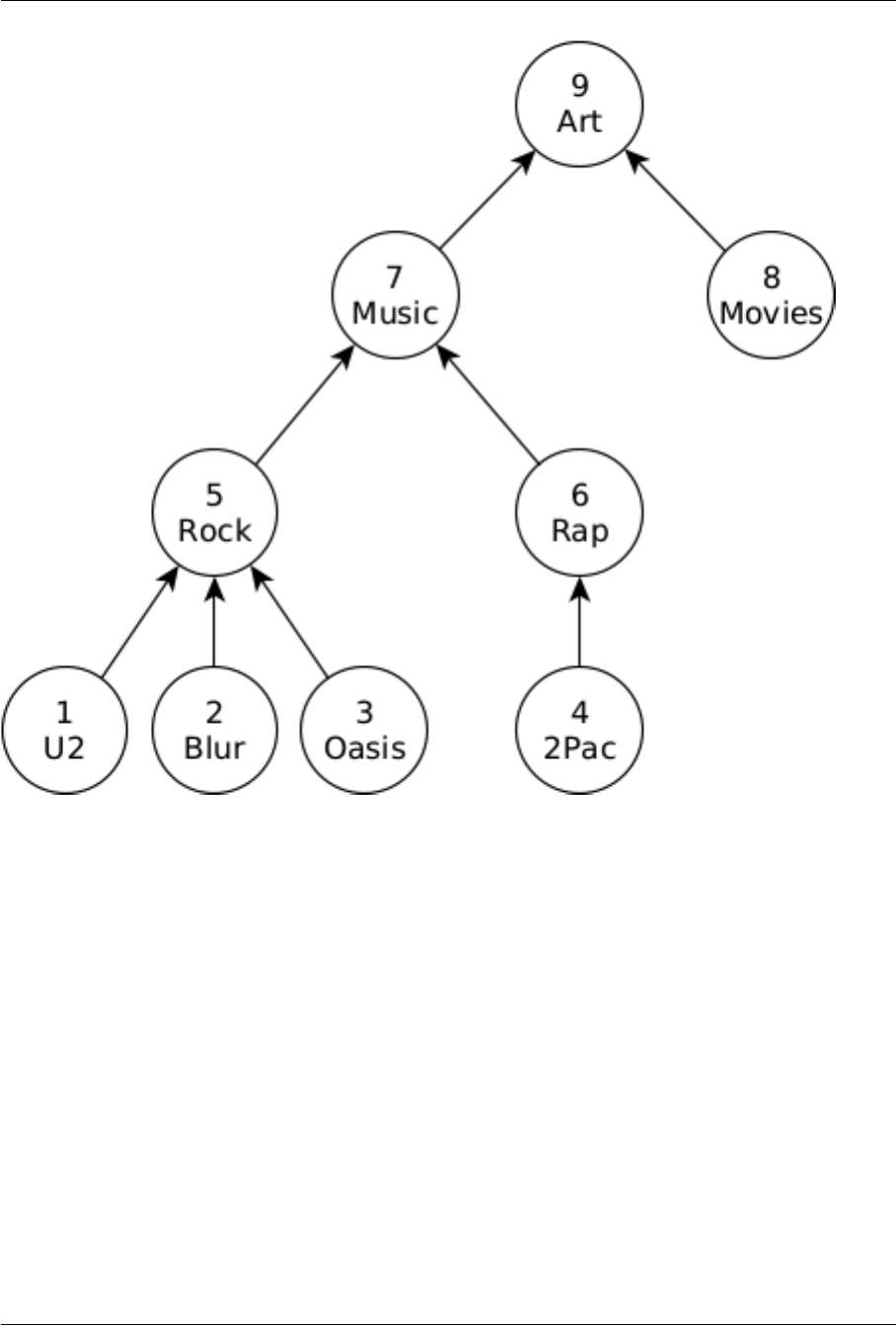
DuckDB Documentation
CREATE TABLE tag(id int, name varchar, subclassof int);
INSERT INTO tag VALUES
(1, 'U2', 5),
(2, 'Blur', 5),
(3, 'Oasis', 5),
(4, '2Pac', 6),
(5, 'Rock', 7),
(6, 'Rap', 7),
(7, 'Music', 9),
(8, 'Movies', 9),
(9, 'Art', NULL);
The following query returns the path from the node Oasis to the root of the tree (Art).
WITH RECURSIVE tag_hierarchy(id, source, path) AS (
SELECT id, name, [name] AS path
476

DuckDB Documentation
FROM tag
WHERE subclassof IS NULL
UNION ALL
SELECT tag.id, tag.name, list_prepend(tag.name, tag_hierarchy.path)
FROM tag, tag_hierarchy
WHERE tag.subclassof = tag_hierarchy.id
)
SELECT path
FROM tag_hierarchy
WHERE source = 'Oasis';
┌───────────────────────────┐
│ path │
├───────────────────────────┤
│ [Oasis, Rock, Music, Art] │
└───────────────────────────┘
Graph Traversal The WITH RECURSIVEclause can be used to express graph traversal on arbitrary
graphs. However, if the graph has cycles, the query must perform cycle detection to prevent infinite
loops. One way to achieve this is to store the path of a traversal in a list and, before extending the path
with a new edge, check whether its endpoint has been visited before (see the example later).
Take the following directed graph from the LDBC Graphalytics benchmark:
477
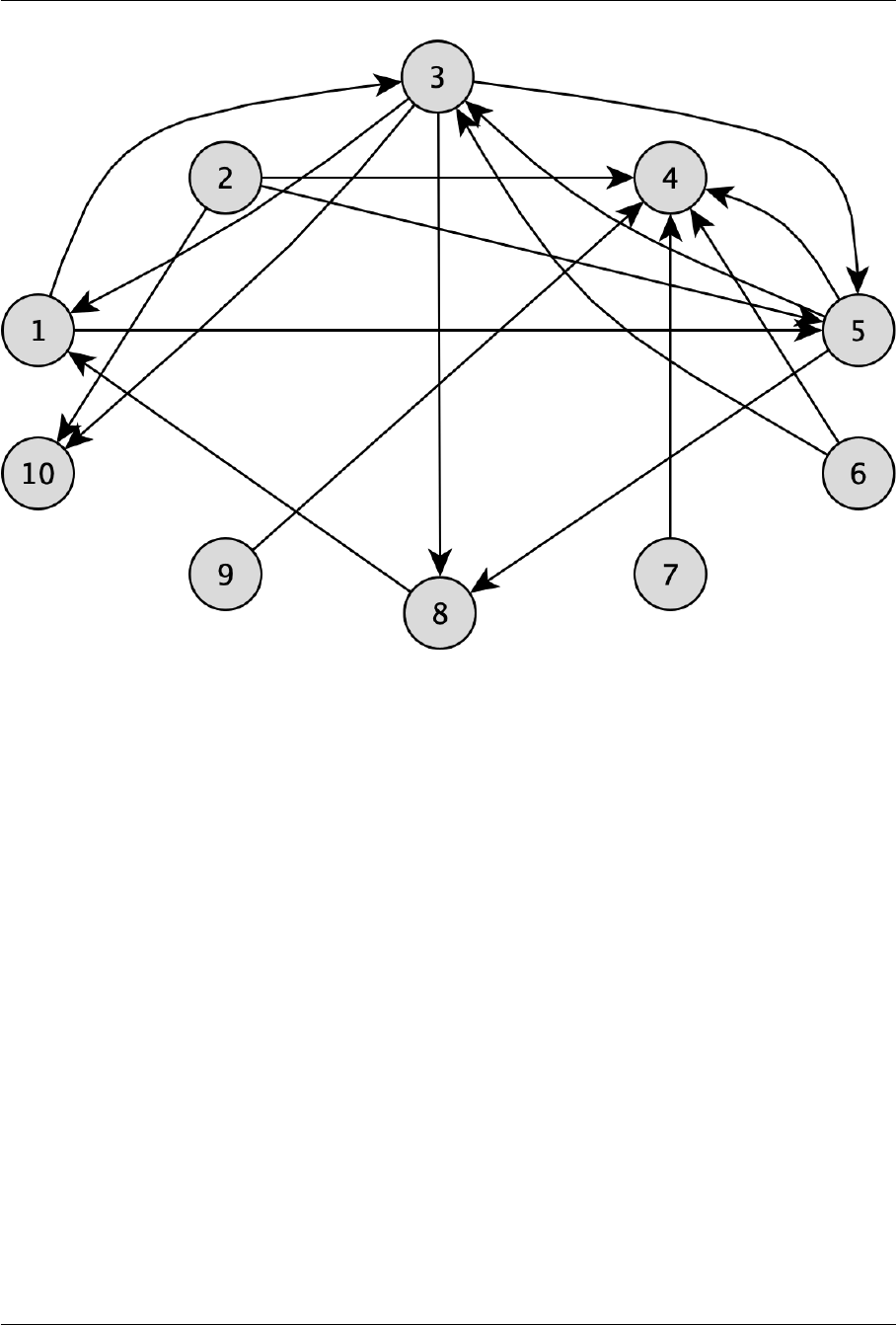
DuckDB Documentation
CREATE TABLE edge(node1id int, node2id int);
INSERT INTO edge VALUES (1, 3), (1, 5), (2, 4), (2, 5), (2, 10), (3, 1), (3,
5),
(3, 8), (3, 10), (5, 3), (5, 4), (5, 8), (6, 3), (6, 4), (7, 4), (8, 1),
(9, 4);
Note that the graph contains directed cycles, e.g., between nodes 1, 2, and 5.
Enumerate All Paths from a Node The following query returns all paths starting in node 1:
WITH RECURSIVE paths(startNode, endNode, path) AS (
SELECT -- define the path as the first edge of the traversal
node1id AS startNode,
node2id
AS endNode,
[node1id, node2id] AS path
FROM edge
WHERE startNode = 1
UNION ALL
SELECT -- concatenate new edge to the path
paths.startNode AS startNode,
node2id AS endNode,
478

DuckDB Documentation
array_append(path, node2id) AS path
FROM paths
JOIN edge ON paths.endNode = node1id
-- Prevent adding a repeated node to the path.
-- This ensures that no cycles occur.
WHERE node2id != ALL(paths.path)
)
SELECT startNode, endNode, path
FROM paths
ORDER BY length(path), path;
┌───────────┬─────────┬───────────────┐
│ startNode │ endNode │ path │
├───────────┼─────────┼───────────────┤
│ 1 │ 3 │ [1, 3] │
│ 1 │ 5 │ [1, 5] │
│ 1 │ 5 │ [1, 3, 5] │
│ 1 │ 8 │ [1, 3, 8] │
│ 1 │ 10 │ [1, 3, 10] │
│ 1 │ 3 │ [1, 5, 3] │
│ 1 │ 4 │ [1, 5, 4] │
│ 1 │ 8 │ [1, 5, 8] │
│ 1 │ 4 │ [1, 3, 5, 4] │
│ 1 │ 8 │ [1, 3, 5, 8] │
│ 1 │ 8 │ [1, 5, 3, 8] │
│ 1 │ 10 │ [1, 5, 3, 10] │
└───────────┴─────────┴───────────────┘
Note that the result of this query is not restricted to shortest paths, e.g., for node 5, the results include
paths [1, 5] and [1, 3, 5].
Enumerate Unweighted Shortest Paths from a Node In most cases, enumerating all paths is not
practical or feasible. Instead, only the (unweighted) shortest paths are of interest. To find these, the
second half of the WITH RECURSIVEquery should be adjusted such that it only includes a node if it
has not yet been visited. This is implemented by using a subquery that checks if any of the previous
paths includes the node:
WITH RECURSIVE paths(startNode, endNode, path) AS (
SELECT -- define the path as the first edge of the traversal
node1id AS startNode,
node2id AS endNode,
[node1id, node2id] AS path
FROM edge
479

DuckDB Documentation
WHERE startNode = 1
UNION ALL
SELECT -- concatenate new edge to the path
paths.startNode AS startNode,
node2id AS endNode,
array_append(path, node2id) AS path
FROM paths
JOIN edge ON paths.endNode = node1id
-- Prevent adding a node that was visited previously by any path.
-- This ensures that (1) no cycles occur and (2) only nodes that
-- were not visited by previous (shorter) paths are added to a path.
WHERE NOT EXISTS (SELECT 1
FROM paths previous_paths
WHERE list_contains(previous_paths.path, node2id))
)
SELECT startNode, endNode, path
FROM paths
ORDER BY length(path), path;
┌───────────┬─────────┬────────────┐
│ startNode │ endNode │ path │
├───────────┼─────────┼────────────┤
│ 1 │ 3 │ [1, 3] │
│ 1 │ 5 │ [1, 5] │
│ 1 │ 8 │ [1, 3, 8] │
│ 1 │ 10 │ [1, 3, 10] │
│ 1 │ 4 │ [1, 5, 4] │
│ 1 │ 8 │ [1, 5, 8] │
└───────────┴─────────┴────────────┘
Enumerate Unweighted Shortest Paths between Two Nodes WITH RECURSIVE can also be
used to find all (unweighted) shortest pathsbetweentwo nodes. To ensure that the recursive query
is stopped as soon as we reach the end node, we use a window function which checks whether the
end node is among the newly added nodes.
The following query returns all unweighted shortest paths between nodes 1 (start node) and 8 (end
node):
WITH RECURSIVE paths(startNode, endNode, path, endReached) AS (
SELECT -- define the path as the first edge of the traversal
node1id AS startNode,
node2id AS endNode,
[node1id, node2id] AS path,
480

DuckDB Documentation
(node2id = 8) AS endReached
FROM edge
WHERE startNode = 1
UNION ALL
SELECT -- concatenate new edge to the path
paths.startNode AS startNode,
node2id AS endNode,
array_append(path, node2id) AS path,
max(CASE WHEN node2id = 8 THEN 1 ELSE 0 END)
OVER (ROWS BETWEEN UNBOUNDED PRECEDING
AND UNBOUNDED FOLLOWING) AS endReached
FROM paths
JOIN edge ON paths.endNode = node1id
WHERE NOT EXISTS (SELECT 1
FROM paths previous_paths
WHERE list_contains(previous_paths.path, node2id))
AND paths.endReached = 0
)
SELECT startNode, endNode, path
FROM paths
WHERE endNode = 8
ORDER BY length(path), path;
┌───────────┬─────────┬───────────┐
│ startNode │ endNode │ path │
├───────────┼─────────┼───────────┤
│ 1 │ 8 │ [1, 3, 8] │
│ 1 │ 8 │ [1, 5, 8] │
└───────────┴─────────┴───────────┘
Common Table Expressions
WINDOW Clause
The WINDOW clause allows you to specify named windows that can be used within window functions.
These are useful when you have multiple window functions, as they allow you to avoid repeating the
same window clause.
481

DuckDB Documentation
Syntax
QUALIFY Clause
The QUALIFYclause is used to filter the results of WINDOW functions. This filtering of results is similar
to how a HAVING clause filters the results of aggregate functions applied based on the GROUP BY
clause.
The QUALIFY clause avoids the need for a subquery or WITH clause to perform this filtering (much
like HAVING avoids a subquery). An example using a WITH clause instead of QUALIFY is included
below the QUALIFY examples.
Note that this is filtering based on WINDOW functions, not necessarily based on the WINDOW clause.
The WINDOW clause is optional and can be used to simplify the creation of multiple WINDOW function
expressions.
The position of where to specify a QUALIFYclause is following the WINDOWclause in a SELECTstate‑
ment (WINDOW does not need to be specified), and before the ORDER BY.
Examples
Each of the following examples produce the same output, located below.
-- Filter based on a WINDOW function defined in the QUALIFY clause
SELECT
schema_name,
function_name,
-- In this example the function_rank column in the select clause is for
reference
row_number() OVER (PARTITION BY schema_name ORDER BY function_name) AS
function_rank
FROM duckdb_functions()
QUALIFY
row_number() OVER (PARTITION BY schema_name ORDER BY function_name) < 3;
-- Filter based on a WINDOW function defined in the SELECT clause
SELECT
schema_name,
function_name,
row_number() OVER (PARTITION BY schema_name ORDER BY function_name) AS
function_rank
FROM duckdb_functions()
QUALIFY
482

DuckDB Documentation
function_rank < 3;
-- Filter based on a WINDOW function defined in the QUALIFY clause, but
using the WINDOW clause
SELECT
schema_name,
function_name,
-- In this example the function_rank column in the select clause is for
reference
row_number() OVER my_window AS function_rank
FROM duckdb_functions()
WINDOW
my_window AS (PARTITION BY schema_name ORDER BY function_name)
QUALIFY
row_number() OVER my_window < 3;
-- Filter based on a WINDOW function defined in the SELECT clause, but using
the WINDOW clause
SELECT
schema_name,
function_name,
row_number() OVER my_window AS function_rank
FROM duckdb_functions()
WINDOW
my_window AS (PARTITION BY schema_name ORDER BY function_name)
QUALIFY
function_rank < 3;
-- Equivalent query based on a WITH clause (without QUALIFY clause)
WITH ranked_functions AS (
SELECT
schema_name,
function_name,
row_number() OVER (PARTITION BY schema_name ORDER BY function_name)
AS function_rank
FROM duckdb_functions()
)
SELECT
*
FROM ranked_functions
WHERE
function_rank < 3;
483

DuckDB Documentation
schema_name function_name function_rank
main !__postfix 1
main !~~ 2
pg_catalog col_description 1
pg_catalog format_pg_type 2
Syntax
VALUES Clause
The VALUES clause is used to specify a fixed number of rows. The VALUES clause can be used as a
stand‑alone statement, as part of the FROM clause, or as input to an INSERT INTO statement.
Examples
-- generate two rows and directly return them
VALUES ('Amsterdam', 1), ('London', 2);
-- generate two rows as part of a FROM clause, and rename the columns
SELECT * FROM (VALUES ('Amsterdam', 1), ('London', 2)) Cities(Name, Id);
-- generate two rows and insert them into a table
INSERT INTO Cities VALUES ('Amsterdam', 1), ('London', 2);
-- create a table directly from a VALUES clause
CREATE TABLE Cities AS SELECT * FROM (VALUES ('Amsterdam', 1), ('London',
2)) Cities(Name, Id);
Syntax
FILTER Clause
The FILTER clause may optionally follow an aggregate function in a SELECT statement. This will
filter the rows of data that are fed into the aggregate function in the same way that a WHERE clause
filters rows, but localized to the specific aggregate function. FILTERs are not currently able to be
used when the aggregate function is in a windowing context.
There are multiple types of situations where this is useful, including when evaluating multiple aggre‑
gates with dierent filters, and when creating a pivoted view of a dataset. FILTERprovides a cleaner
484

DuckDB Documentation
syntax for pivoting data when compared with the more traditional CASE WHEN approach discussed
below.
Some aggregate functions also do not filter out null values, so using a FILTERclause will return valid
results when at times the CASE WHEN approach will not. This occurs with the functions FIRST and
LAST, which are desirable in a non‑aggregating pivot operation where the goal is to simply re‑orient
the data into columns rather than re‑aggregate it. FILTER also improves null handling when using
the LIST and ARRAY_AGG functions, as the CASE WHEN approach will include null values in the list
result, while the FILTER clause will remove them.
Examples
-- Compare total row count to:
-- The number of rows where i <= 5
-- The number of rows where i is odd
SELECT
count(*) AS total_rows,
count(*) FILTER (WHERE i <= 5) AS lte_five,
count(*) FILTER (WHERE i % 2 = 1) AS odds
FROM generate_series(1, 10) tbl(i);
total_rows lte_five odds
10 5 5
-- Different aggregate functions may be used, and multiple WHERE expressions
are also permitted
-- The sum of i for rows where i <= 5
-- The median of i where i is odd
SELECT
sum(i) FILTER (WHERE i <= 5) AS lte_five_sum,
median(i) FILTER (WHERE i % 2 = 1) AS odds_median,
median(i) FILTER (WHERE i % 2 = 1 AND i <= 5) AS odds_lte_five_median
FROM generate_series(1, 10) tbl(i);
lte_five_sum odds_median odds_lte_five_median
15 5.0 3.0
485

DuckDB Documentation
The FILTER clause can also be used to pivot data from rows into columns. This is a static pivot, as
columns must be defined prior to runtime in SQL. However, this kind of statement can be dynamically
generated in a host programming language to leverage DuckDB's SQL engine for rapid, larger than
memory pivoting.
--First generate an example dataset
CREATE TEMP TABLE stacked_data AS
SELECT
i,
CASE WHEN i <= rows * 0.25 THEN 2022
WHEN i <= rows * 0.5 THEN 2023
WHEN i <= rows * 0.75 THEN 2024
WHEN i <= rows * 0.875 THEN 2025
ELSE NULL
END AS year
FROM (
SELECT
i,
count(*) OVER () AS rows
FROM generate_series(1, 100000000) tbl(i)
) tbl;
--"Pivot" the data out by year (move each year out to a separate column)
SELECT
count(i) FILTER (WHERE year = 2022) AS "2022",
count(i) FILTER (WHERE year = 2023) AS "2023",
count(i) FILTER (WHERE year = 2024) AS "2024",
count(i) FILTER (WHERE year = 2025) AS "2025",
count(i) FILTER (WHERE year IS NULL) AS "NULLs"
FROM stacked_data;
--This syntax produces the same results as the FILTER clauses above
SELECT
count(CASE WHEN year = 2022 THEN i END) AS "2022",
count(CASE WHEN year = 2023 THEN i END) AS "2023",
count(CASE WHEN year = 2024 THEN i END) AS "2024",
count(CASE WHEN year = 2025 THEN i END) AS "2025",
count(CASE WHEN year IS NULL THEN i END) AS "NULLs"
FROM stacked_data;
486

DuckDB Documentation
2022 2023 2024 2025 NULLs
25000000 25000000 25000000 12500000 12500000
However, the CASE WHENapproach will not work as expected when using an aggregate function that
does not ignore NULL values. The FIRST function falls into this category, so FILTER is preferred in
this case.
--"Pivot" the data out by year (move each year out to a separate column)
SELECT
first(i) FILTER (WHERE year = 2022) AS "2022",
first(i) FILTER (WHERE year = 2023) AS "2023",
first(i) FILTER (WHERE year = 2024) AS "2024",
first(i) FILTER (WHERE year = 2025) AS "2025",
first(i) FILTER (WHERE year IS NULL) AS "NULLs"
FROM stacked_data;
2022 2023 2024 2025 NULLs
1474561 25804801 50749441 76431361 87500001
--This will produce NULL values whenever the first evaluation of the CASE
WHEN clause returns a NULL
SELECT
first(CASE WHEN year = 2022 THEN i END) AS "2022",
first(CASE WHEN year = 2023 THEN i END) AS "2023",
first(CASE WHEN year = 2024 THEN i END) AS "2024",
first(CASE WHEN year = 2025 THEN i END) AS "2025",
first(CASE WHEN year IS NULL THEN i END) AS "NULLs"
FROM stacked_data;
2022 2023 2024 2025 NULLs
1228801 NULL NULL NULL NULL
487

DuckDB Documentation
Aggregate Function Syntax (Including Filter Clause)
Set Operations
Set operations allow queries to be combined according to set operation semantics. Set operations
refer to the UNION [ALL], INTERSECT and EXCEPT clauses.
Traditional set operations unify queries by column position, and require the to‑be‑combined queries
to have the same number of input columns. If the columns are not of the same type, casts may be
added. The result will use the column names from the first query.
DuckDB also supports UNION BY NAME, which joins columns by name instead of by position. UNION
BY NAMEdoes not require the inputs to have the same number of columns. NULLvalueswill be added
in case of missing columns.
Examples
-- the values [0..10) and [0..5)
SELECT * FROM range(10) t1 UNION ALL SELECT * FROM range(5) t2;
-- the values [0..10) (` UNION` eliminates duplicates)
SELECT * FROM range(10) t1 UNION SELECT * FROM range(5) t2;
-- the values [0..5] (all values that are both in t1 and t2)
SELECT * FROM range(10) t1 INTERSECT SELECT * FROM range(6) t2;
-- the values [5..10)
SELECT * FROM range(10) t1 EXCEPT SELECT * FROM range(5) t2;
-- two rows, (24, NULL) and (NULL, Amsterdam)
SELECT 24 AS id UNION ALL BY NAME SELECT 'Amsterdam' AS City;
Syntax
Example Table
CREATE TABLE capitals(city VARCHAR, country VARCHAR);
INSERT INTO capitals VALUES ('Amsterdam', 'NL'), ('Berlin', 'Germany');
CREATE TABLE weather(city VARCHAR, degrees INTEGER, date DATE);
INSERT INTO weather VALUES ('Amsterdam', 10, '2022-10-14'), ('Seattle', 8,
'2022-10-12');
488

DuckDB Documentation
UNION (ALL)
The UNION clause can be used to combine rows from multiple queries. The queries are required to
have the same number of columns and the same column types.
The UNION clause performs duplicate elimination by default ‑ only unique rows will be included in
the result.
UNION ALL returns all rows of both queries without duplicate elimination.
SELECT city FROM capitals UNION SELECT city FROM weather;
-- Amsterdam, Berlin, Seattle
SELECT city FROM capitals UNION ALL SELECT city FROM weather;
-- Amsterdam, Amsterdam, Berlin, Seattle
INTERSECT
The INTERSECT clause can be used to select all rows that occur in the result of both queries. Note
that INTERSECT performs duplicate elimination, so only unique rows are returned.
SELECT city FROM capitals INTERSECT SELECT city FROM weather;
-- Amsterdam
EXCEPT
The EXCEPT clause can be used to select all rows that only occur in the le query. Note that EXCEPT
performs duplicate elimination, so only unique rows are returned.
SELECT city FROM capitals EXCEPT SELECT city FROM weather;
-- Berlin
UNION (ALL) BY NAME
The UNION (ALL) BY NAME clause can be used to combine rows from dierent tables by name,
instead of by position. UNION BY NAME does not require both queries to have the same number
of columns. Any columns that are only found in one of the queries are filled with NULL values for the
other query.
SELECT * FROM capitals UNION BY NAME SELECT * FROM weather;
489

DuckDB Documentation
┌───────────┬─────────┬─────────┬────────────┐
│ city │ country │ degrees │ date │
│ varchar │ varchar │ int32 │ date │
├───────────┼─────────┼─────────┼────────────┤
│ Amsterdam │ NULL │ 10 │ 2022-10-14 │
│ Seattle │ NULL │ 8 │ 2022-10-12 │
│ Amsterdam │ NL │ NULL │ NULL │
│ Berlin │ Germany │ NULL │ NULL │
└───────────┴─────────┴─────────┴────────────┘
UNION BY NAME performs duplicate elimination, whereas UNION ALL BY NAME does not.
Data Types
Data Types
General‑Purpose Data Types
The tablebelow shows all the built‑in general‑purpose data types. The alternativeslisted in the aliases
column can be used to refer to these types as well, however, note that the aliases are not part of the
SQL standard and hence might not be accepted by other database engines.
Name Aliases Description
BIGINT INT8, LONG signed eight‑byte integer
BIT BITSTRING string of 1's and 0's
BOOLEAN BOOL, LOGICAL logical boolean (true/false)
BLOB BYTEA, BINARY,
VARBINARY
variable‑length binary data
DATE calendar date (year, month day)
DOUBLE FLOAT8, NUMERIC,
DECIMAL
double precision floating‑point number (8
bytes)
DECIMAL(prec,
scale)
fixed‑precision number with the given
width (precision) and scale
HUGEINT signed sixteen‑byte integer
INTEGER INT4, INT, SIGNED signed four‑byte integer
490

DuckDB Documentation
Name Aliases Description
INTERVAL date / time delta
REAL FLOAT4, FLOAT single precision floating‑point number (4
bytes)
SMALLINT INT2, SHORT signed two‑byte integer
TIME time of day (no time zone)
TIMESTAMP DATETIME combination of time and date
TIMESTAMP WITH
TIME ZONE
TIMESTAMPTZ combination of time and date that uses the
current time zone
TINYINT INT1 signed one‑byte integer
UBIGINT unsigned eight‑byte integer
UINTEGER unsigned four‑byte integer
USMALLINT unsigned two‑byte integer
UTINYINT unsigned one‑byte integer
UUID UUID data type
VARCHAR CHAR, BPCHAR, TEXT,
STRING
variable‑length character string
Nested / Composite Types
DuckDB supports four nested data types: LIST, STRUCT, MAP and UNION. Each supports dierent
use cases and has a dierent structure.
Name Description
Rules when used in a
column
Build from
values
Define in
DDL/CREATE
LIST An ordered sequence
of data values of the
same type.
Each row must have
the same data type
within each LIST, but
can have any number
of elements.
[1, 2, 3] INT[ ]
491

DuckDB Documentation
Name Description
Rules when used in a
column
Build from
values
Define in
DDL/CREATE
STRUCT A dictionary of
multiple named
values, where each
key is a string, but the
value can be a
dierent type for each
key.
Each row must have
the same keys.
{'i': 42,
'j': 'a'}
STRUCT(i INT, j
VARCHAR)
MAP A dictionary of
multiple named
values, each key
having the same type
and each value having
the same type. Keys
and values can be any
type and can be
dierent types from
one another.
Rows may have
dierent keys.
map([1, 2],
['a', 'b'])
MAP(INT,
VARCHAR)
UNION A union of multiple
alternative data types,
storing one of them in
each value at a time. A
union also contains a
discriminator ”tag”
value to inspect and
access the currently
set member type.
Rows may be set to
dierent member
types of the union.
union_
value(num := 2)
UNION(num INT,
text VARCHAR)
Nesting
LISTs, STRUCTs, MAPs and UNIONs can be arbitrarily nested to any depth, so long as the type rules
are observed.
-- Struct with lists
SELECT {'birds': ['duck', 'goose', 'heron'], 'aliens': NULL, 'amphibians':
['frog', 'toad']};
492

DuckDB Documentation
-- Struct with list of maps
SELECT {'test': [map([1, 5], [42.1, 45]), map([1, 5], [42.1, 45])]};
-- A list of unions
SELECT [union_value(num := 2), union_value(str := 'ABC')::UNION(str VARCHAR,
num INTEGER)];
Bitstring Type
Name Aliases Description
BIT BITSTRING variable‑length strings of 1's and 0's
Bitstrings are strings of 1's and 0's. The bit type data is of variable length. A bitstring value requires 1
byte for each group of 8 bits, plus a fixed amount to store some metadata.
By default bitstrings will not be padded with zeroes. Bitstrings can be very large, having the same size
restrictions as BLOBs.
-- create a bitstring
SELECT '101010'::BIT
-- create a bitstring with predefined length
-- the resulting bitstring will be left-padded with zeroes. This returns
000000101011
SELECT bitstring('0101011', 12);
Functions
See Bitstring Functions.
Blob Type
Name Aliases Description
BLOB BYTEA, BINARY, VARBINARY variable‑length binary data
The blob (Binary Large OBject) type represents an arbitrary binary object stored in the database sys‑
tem. The blob type can contain any type of binary data with no restrictions. What the actual bytes
represent is opaque to the database system.
493

DuckDB Documentation
-- create a blob value with a single byte (170)
SELECT '\xAA'::BLOB;
-- create a blob value with three bytes (170, 171, 172)
SELECT '\xAA\xAB\xAC'::BLOB;
-- create a blob value with two bytes (65, 66)
SELECT 'AB'::BLOB;
Blobs are typically used to store non‑textual objects that the database does not provide explicit sup‑
port for, such as images. While blobs can hold objects up to 4GB in size, typically it is not recom‑
mended to store very large objects within the database system. In many situations it is better to store
the large file on the file system, and store the path to the file in the database system in a
VARCHAR
field.
Functions
See Blob Functions.
Boolean Type
Name Aliases Description
BOOLEAN BOOL logical boolean (true/false)
The BOOLEAN type represents a statement of truth (”true” or ”false”). In SQL, the boolean field can
also have a third state ”unknown” which is represented by the SQL NULL value.
-- select the three possible values of a boolean column
SELECT true, false, NULL::BOOLEAN;
Boolean values can be explicitly created using the literals true and false. However, they are most
oen created as a result of comparisons or conjunctions. For example, the comparison i > 10
results in a boolean value. Boolean values can be used in the WHERE and HAVING clauses of a SQL
statement to filter out tuples from the result. In this case, tuples for which the predicate evaluates
to true will pass the filter, and tuples for which the predicate evaluates to false or NULL will be
filtered out. Consider the following example:
-- create a table with the value (5), (15) and (NULL)
CREATE TABLE integers(i INTEGER);
INSERT INTO integers VALUES (5), (15), (NULL);
494

DuckDB Documentation
-- select all entries where i > 10
SELECT * FROM integers WHERE i > 10;
-- in this case (5) and (NULL) are filtered out:
-- 5 > 10 = false
-- NULL > 10 = NULL
-- The result is (15)
Conjunctions
The AND/OR conjunctions can be used to combine boolean values.
Below is the truth table for the AND conjunction (i.e., x AND y).
X X AND true X AND false X AND NULL
true true false NULL
false false false false
NULL NULL false NULL
Below is the truth table for the OR conjunction (i.e., x OR y).
X X OR true X OR false X OR NULL
true true true true
false true false NULL
NULL true NULL NULL
Expressions
See Logical Operators and Comparison Operators.
Date Types
495

DuckDB Documentation
Name Aliases Description
DATE calendar date (year, month day)
A date specifies a combination of year, month and day. DuckDB follows the SQL standard's lead by
counting dates exclusively in the Gregorian calendar, even for years before that calendar was in use.
Dates can be created using the DATE keyword, where the data must be formatted according to the
ISO 8601 format (YYYY-MM-DD).
-- 20 September, 1992
SELECT DATE '1992-09-20';
Special Values
There are also three special date values that can be used on input:
Input String Description
epoch 1970‑01‑01 (Unix system day zero)
infinity later than all other dates
‑infinity earlier than all other dates
The values infinity and -infinity are specially represented inside the system and will be dis‑
played unchanged; but epoch is simply a notational shorthand that will be converted to the date
value when read.
SELECT '-infinity'::DATE, 'epoch'::DATE, 'infinity'::DATE;
Negative Epoch Positive
‑infinity 1970‑01‑01 infinity
Functions
See Date Functions.
496

DuckDB Documentation
Enum Types
Name Description
ENUM Dictionary Encoding representing all possible string values of a
column.
Enums
The ENUM type represents a dictionary data structure with all possible unique values of a column. For
example, a column storing the days of the week can be an Enum holding all possible days. Enums
are particularly interesting for string columns with low cardinality (i.e., fewer distinct values). This is
because the column only stores a numerical reference to the string in the Enum dictionary, resulting
in immense savings in disk storage and faster query performance.
Enum Definition Enum types are created from either a hardcoded set of values or from a select
statement that returns a single column of varchars. The set of values in the select statement will be
deduplicated, but if the enum is created from a hardcoded set there may not be any duplicates.
-- Create enum using hardcoded values
CREATE TYPE ${enum_name} AS ENUM ([${value_1}, ${value_2},...]);
-- Create enum using a select statement that returns a single column of
varchars
CREATE TYPE ${enum_name} AS ENUM (${SELECT expression});
For example:
-- Creates new user defined type 'mood' as an Enum
CREATE TYPE mood AS ENUM ('sad', 'ok', 'happy');
-- This will fail since the mood type already exists
CREATE TYPE mood AS ENUM ('sad', 'ok', 'happy', 'anxious');
-- This will fail since Enums cannot hold null values
CREATE TYPE breed AS ENUM ('maltese', NULL);
-- This will fail since Enum values must be unique
CREATE TYPE breed AS ENUM ('maltese', 'maltese');
497

DuckDB Documentation
-- Create an enum from a select statement
-- First create an example table of values
CREATE TABLE my_inputs AS
SELECT 'duck' AS my_varchar UNION ALL
SELECT 'duck' AS my_varchar UNION ALL
SELECT 'goose' AS my_varchar;
-- Create an enum using the unique string values in the my_varchar column
CREATE TYPE birds AS ENUM (SELECT my_varchar FROM my_inputs);
-- Show the available values in the birds enum using the enum_range function
SELECT enum_range(NULL::birds) AS my_enum_range;
my_enum_range
[duck, goose]
Enum Usage Aer an enum has been created, it can be used anywhere a standard built‑in type is
used. For example, we can create a table with a column that references the enum.
-- Creates a table person, with attributes name (string type) and current_
mood (mood type)
CREATE TABLE person (
name text,
current_mood mood
);
-- Inserts tuples in the person table
INSERT INTO person VALUES ('Pedro', 'happy'), ('Mark', NULL), ('Pagliacci',
'sad'), ('Mr. Mackey', 'ok');
-- This will fail since the mood type does not have a 'quackity-quack' value.
INSERT INTO person VALUES ('Hannes', 'quackity-quack');
-- The string 'sad' is cast to the type Mood, returning a numerical
reference value.
-- This makes the comparison a numerical comparison instead of a string
comparison.
SELECT * FROM person WHERE current_mood = 'sad';
----
Pagliacci
498

DuckDB Documentation
-- If you are importing data from a file, you can create an Enum for a
VARCHAR column before importing
-- The subquery select automatically selects only distinct values
CREATE TYPE mood AS ENUM (SELECT mood FROM 'path/to/file.csv');
-- Then you can create a table with the ENUM type and import using any data
import statement
CREATE TABLE person(name text, current_mood mood);
COPY person FROM 'path/to/file.csv' (AUTO_DETECT true);
Enum vs. Strings DuckDB Enums are automatically cast to VARCHAR types whenever necessary.
This characteristic allows for ENUM columns to be used in any VARCHAR function. In addition, it also
allows for comparisons between dierent ENUM columns, or an ENUM and a VARCHAR column.
For example:
-- regexp_matches is a function that takes a VARCHAR, hence current_mood is
cast to VARCHAR
SELECT regexp_matches(current_mood, '.*a.*') FROM person;
----
true
true
false
CREATE TYPE new_mood AS ENUM ('happy', 'anxious');
CREATE TABLE person_2(
name text,
current_mood mood,
future_mood new_mood
past_mood VARCHAR
);
-- Since current_mood and future_mood are constructed on different ENUMs
-- DuckDB will cast both ENUMs to strings and perform a string comparison.
SELECT * FROM person_2 where current_mood = future_mood;
-- Since current_mood is an ENUM
-- DuckDB will cast the current_mood ENUM to VARCHAR and perform a string
comparison
499

DuckDB Documentation
SELECT * FROM person_2 where current_mood = past_mood;
Enum Removal Enum types are stored in the catalog, and a catalog dependency is added to each
table that uses them. It is possible to drop an Enum from the catalog using the following command:
DROP TYPE ${enum_name};
Currently, it is possible to drop Enums that are used in tables without aecting the tables.
Note. This feature is subject to change in future releases.
For example:
-- This will fail since person has a catalog dependency to the mood type
DROP TYPE mood;
DROP TABLE person;
DROP TABLE person_2;
-- This successfully removes the mood type.
-- Another option would be to DROP TYPE mood CASCADE (Drops the type and its
dependents)
DROP TYPE mood;
Interval Type
Intervals represent a period of time. This period can be measured in a specific unit or combination of
units, for example years, days, or seconds. Intervals are generally used to modify timestamps or dates
by either adding or subtracting them.
Name Description
INTERVAL Period of time
An INTERVAL can be constructed by providing an amount together with a unit. Intervals can be
added or subtracted from DATE or TIMESTAMP values.
-- 1 year
SELECT INTERVAL 1 YEAR;
-- add 1 year to a specific date
SELECT DATE '2000-01-01' + INTERVAL 1 YEAR;
500

DuckDB Documentation
-- subtract 1 year from a specific date
SELECT DATE '2000-01-01' - INTERVAL 1 YEAR;
-- construct an interval from a column, instead of a constant
SELECT INTERVAL (i) YEAR FROM range(1, 5) t(i);
-- construct an interval with mixed units
SELECT INTERVAL '1 month 1 day';
-- WARNING: If a decimal value is specified, it will be automatically
rounded to an integer
-- To use more precise values, simply use a more granular date part
-- (In this example use 18 MONTHS instead of 1.5 YEARS)
-- The statement below is equivalent to to_years(CAST(1.5 AS INTEGER))
-- 2 years
SELECT INTERVAL '1.5' YEARS; --WARNING! This returns 2 years!
Details
The interval class represents a period of time using three distinct components: the month, day and
microsecond. These three components are required because there is no direct translation between
them. For example, a month does not correspond to a fixed amount of days. That depends on which
month is referenced. February has fewer days than March.
The division into components makes the interval class suitable for adding or subtracting specific time
units to a date. For example, we can generate a table with the first day of every month using the
following SQL query:
SELECT DATE '2000-01-01' + INTERVAL (i) MONTH FROM range(12) t(i);
Dierence between Dates
If we subtract two timestamps from one another, we obtain an interval describing the dierence be‑
tween the timestamps with the days and microseconds components. For example:
SELECT TIMESTAMP '2000-02-01 12:00:00' - TIMESTAMP '2000-01-01 11:00:00' AS
diff;
┌──────────────────┐
│ diff │
│ interval │
├──────────────────┤
│ 31 days 01:00:00 │
└──────────────────┘
501

DuckDB Documentation
The datediff function can be used to obtain the dierence between two dates for a specific unit.
SELECT datediff('month', TIMESTAMP '2000-01-01 11:00:00', TIMESTAMP
'2000-02-01 12:00:00') AS diff;
┌───────┐
│ diff │
│ int64 │
├───────┤
│ 1 │
└───────┘
Functions
See the Date Part Functions page for a list of available date parts for use with an INTERVAL.
See the Interval Operators page for functions that operate on intervals.
List
List Data Type
A LIST column can have values with dierent lengths, but they must all have the same underlying
type. LISTs are typically used to store arrays of numbers, but can contain any uniform data type,
including other LISTs and STRUCTs.
LISTs are similar to PostgreSQL's ARRAY type. DuckDB uses the LIST terminology, but some array
functions are provided for PostgreSQL compatibility.
See the data types overview for a comparison between nested data types.
Lists can be created using the LIST_VALUE(expr, ...) function or the equivalent bracket nota‑
tion [expr, ...]. The expressions can be constants or arbitrary expressions.
Creating Lists
-- List of integers
SELECT [1, 2, 3];
-- List of strings with a NULL value
SELECT ['duck', 'goose', NULL, 'heron'];
-- List of lists with NULL values
SELECT [['duck', 'goose', 'heron'], NULL, ['frog', 'toad'], []];
-- Create a list with the list_value function
502

DuckDB Documentation
SELECT list_value(1, 2, 3);
-- Create a table with an integer list column and a varchar list column
CREATE TABLE list_table (int_list INT[], varchar_list VARCHAR[]);
Retrieving from Lists Retrieving one or more values from a list can be accomplished using brackets
and slicing notation, or through list functions like list_extract. Multiple equivalent functions
are provided as aliases for compatibility with systems that refer to lists as arrays. For example, the
function array_slice.
-- Note that we wrap the list creation in parenthesis so that it happens
first.
-- This is only needed in our basic examples here, not when working with a
list column
-- For example, this can't be parsed: SELECT ['a', 'b', 'c'][1]
example result
SELECT (['a', 'b', 'c'])[3] 'c'
SELECT (['a', 'b', 'c'])[-1] 'c'
SELECT (['a', 'b', 'c'])[2 + 1] 'c'
SELECT list_extract(['a', 'b', 'c'], 3) 'c'
SELECT (['a', 'b', 'c'])[1:2]
['a', 'b']
SELECT (['a', 'b', 'c'])[:2] ['a', 'b']
SELECT (['a', 'b', 'c'])[-2:] ['b', 'c']
SELECT list_slice(['a', 'b', 'c'], 2, 3) ['b', 'c']
Ordering
The ordering is defined positionally. NULL values compare greater than all other values and are con‑
sidered equal to each other.
Null Comparisons
At the top level, NULL nested values obey standard SQL NULL comparison rules: comparing a NULL
nested value to a non‑NULL nested value produces a NULL result. Comparing nested value members
503

DuckDB Documentation
, however, uses the internal nested value rules for NULLs, and a NULL nested value member will com‑
pare above a non‑NULL nested value member.
Functions
See Nested Functions.
Map
Map Data Type
MAPs are similar to STRUCTs in that they are an ordered list of ”entries” where a key maps to a value.
However, MAPs do notneed to have the same keys present for each row, and thus are suitable for other
use cases. MAPs are useful when the schema is unknown beforehand or when the schema varies per
row; their flexibility is a key dierentiator.
MAPs must have a single type for all keys, and a single type for all values. Keys and values can be any
type, and the type of the keys does not need to match the type of the values (Ex: a MAP of VARCHAR
to INT is valid). MAPs may not have duplicate keys. MAPs return an empty list if a key is not found
rather than throwing an error as structs do.
In contrast, STRUCTs must have string keys, but each key may have a value of a dierent type. See
the data types overview for a comparison between nested data types.
To construct a MAP, use the bracket syntax preceded by the MAP keyword.
Creating Maps
-- A map with varchar keys and integer values. This returns {key1=1, key2=5}
SELECT map { 'key1': 1, 'key2': 5 };
-- Alternatively use the map_from_entries function. This returns {key1=1,
key2=5}
SELECT map_from_entries([(key1, 1), (key2, 5)]);
-- A map with integer keys and numeric values. This returns {1=42.001,
5=-32.100}
SELECT map { 1: 42.001, 5: -32.1 };
-- Keys and/or values can also be nested types.
-- This returns {[a, b]=[1.1, 2.2], [c, d]=[3.3, 4.4]}
SELECT map { ['a', 'b']: [1.1, 2.2], ['c', 'd']: [3.3, 4.4] };
-- Create a table with a map column that has integer keys and double values
CREATE TABLE map_table (map_col MAP(INT, DOUBLE));
504

DuckDB Documentation
Retrieving from Maps MAPs use bracket notation for retrieving values. Selecting from a MAP re‑
turns a LIST rather than an individual value, with an empty LIST meaning that the key was not
found.
-- Use bracket notation to retrieve a list containing the value at a key's
location. This returns [5]
-- Note that the expression in bracket notation must match the type of the
map's key
SELECT map { 'key1': 5, 'key2': 43 }['key1'];
-- To retrieve the underlying value, use list selection syntax to grab the
first element.
-- This returns 5
SELECT map { 'key1': 5, 'key2': 43 }['key1'][1];
-- If the element is not in the map, an empty list will be returned. Returns
[]
-- Note that the expression in bracket notation must match the type of the
map's key else an error is returned
SELECT map { 'key1': 5, 'key2': 43 }['key3'];
-- The element_at function can also be used to retrieve a map value. This
returns [5]
SELECT element_at(map { 'key1': 5, 'key2': 43 }, 'key1');
Comparison Operators
Nested types can be compared using all the comparison operators. These comparisons can be used
in logical expressions for both
WHERE
and
HAVING
clauses, as well as for creating Boolean values.
The ordering is defined positionally in the same way that words can be ordered in a dictionary. NULL
values compare greater than all other values and are considered equal to each other.
At the top level, NULL nested values obey standard SQL NULL comparison rules: comparing a NULL
nested value to a non‑NULL nested value produces a NULL result. Comparing nested value members
, however, uses the internal nested value rules for NULLs, and a NULL nested value member will com‑
pare above a non‑NULL nested value member.
Functions
See Nested Functions.
505

DuckDB Documentation
NULL Values
NULL values are special values that are used to represent missing data in SQL. Columns of any type
can contain NULLvalues. Logically, a NULLvalue can be seen as ”the value of this field is unknown”.
-- insert a null value into a table
CREATE TABLE integers(i INTEGER);
INSERT INTO integers VALUES (NULL);
NULL values have special semantics in many parts of the query as well as in many functions:
Note. Any comparison with a NULL value returns NULL, including NULL=NULL.
You can use IS NOT DISTINCT FROM to perform an equality comparison where NULL values
compare equal to each other. Use IS (NOT) NULL to check if a value is NULL.
SELECT NULL=NULL;
-- returns NULL
SELECT NULL IS NOT DISTINCT FROM NULL;
-- returns true
SELECT NULL IS NULL;
-- returns true
NULL and Functions
A function that has input argument as NULL usually returns NULL.
SELECT COS(NULL);
-- NULL
COALESCE is an exception to this. COALESCE takes any number of arguments, and returns for each
row the first argument that is not NULL. If all arguments are NULL, COALESCE also returns NULL.
SELECT COALESCE(NULL, NULL, 1);
-- 1
SELECT COALESCE(10, 20);
-- 10
SELECT COALESCE(NULL, NULL);
-- NULL
IFNULL is a two‑argument version of COALESCE
SELECT IFNULL(NULL, 'default_string');
-- default_string
SELECT IFNULL(1, 'default_string');
-- 1
506

DuckDB Documentation
NULL and Conjunctions
NULL values have special semantics in AND/OR conjunctions. For the ternary logic truth tables, see
the Boolean Type documentation.
NULL and Aggregate Functions
NULL values are ignored in most aggregate functions.
Aggregate functions that do not ignore NULL values include: FIRST, LAST, LIST, and ARRAY_AGG.
To exclude NULL values from those aggregate functions, the FILTER clause can be used.
CREATE TABLE integers(i INTEGER);
INSERT INTO integers VALUES (1), (10), (NULL);
SELECT MIN(i) FROM integers;
-- 1
SELECT MAX(i) FROM integers;
-- 10
Numeric Types
Integer Types
The types TINYINT, SMALLINT, INTEGER, BIGINT and HUGEINT store whole numbers, that is,
numbers without fractional components, of various ranges. Attempts to store values outside of the
allowed range will result in an error. The types UTINYINT, USMALLINT, UINTEGER, UBIGINTstore
whole unsigned numbers. Attempts to store negative numbers or values outside of the allowed range
will result in an error
Name Aliases Min Max
TINYINT INT1 ‑128 127
SMALLINT INT2, SHORT ‑32768 32767
INTEGER INT4, INT,
SIGNED
‑2147483648 2147483647
BIGINT INT8, LONG ‑9223372036854775808 9223372036854775807
507

DuckDB Documentation
Name Aliases Min Max
HUGEINT ‑
170141183460469231731687303715884105728
UTINYINT ‑ 0 255
USMALLINT ‑ 0 65535
UINTEGER ‑ 0 4294967295
UBIGINT ‑ 0 18446744073709551615
The type integer is the common choice, as it oers the best balance between range, storage size, and
performance. The SMALLINT type is generally only used if disk space is at a premium. The BIGINT
and HUGEINT types are designed to be used when the range of the integer type is insuicient.
Fixed‑Point Decimals
The data type DECIMAL(WIDTH, SCALE) represents an exact fixed‑point decimal value. When
creating a value of type DECIMAL, the WIDTH and SCALE can be specified to define which size of
decimal values can be held in the field. The WIDTH field determines how many digits can be held,
and the scale determines the amount of digits aer the decimal point. For example, the type DEC-
IMAL(3, 2) can fit the value 1.23, but cannot fit the value 12.3 or the value 1.234. The default
WIDTH and SCALE is DECIMAL(18, 3), if none are specified.
Internally, decimals are represented as integers depending on their specified width.
Width Internal Size (Bytes)
1‑4 INT16 2
5‑9 INT32 4
10‑18 INT64 8
19‑38 INT128 16
Performance can be impacted by using too large decimals when not required. In particular decimal
values with a width above 19 are very slow, as arithmetic involving the INT128 type is much more
expensive than operations involving the INT32or INT64types. It is therefore recommended to stick
with a width of 18 or below, unless there is a good reason for why this is insuicient.
508

DuckDB Documentation
Floating‑Point Types
The data types REALand DOUBLEprecision are inexact, variable‑precision numeric types. In practice,
these types are usually implementations of IEEE Standard 754 for Binary Floating‑Point Arithmetic
(single and double precision, respectively), to the extent that the underlying processor, operating sys‑
tem, and compiler support it.
Name Aliases Description
REAL FLOAT4, FLOAT single precision floating‑point number (4 bytes)
DOUBLE FLOAT8 double precision floating‑point number (8 bytes)
Inexact means that some values cannot be converted exactly to the internal format and are stored
as approximations, so that storing and retrieving a value might show slight discrepancies. Managing
these errors and how they propagate through calculations is the subject of an entire branch of math‑
ematics and computer science and will not be discussed here, except for the following points:
• If you require exact storage and calculations (such as for monetary amounts), use the numeric
type instead.
• If you want to do complicated calculations with these types for anything important, especially
if you rely on certain behavior in boundary cases (infinity, underflow), you should evaluate the
implementation carefully.
• Comparing two floating‑point values for equality might not always work as expected.
On most platforms, the REAL type has a range of at least 1E‑37 to 1E+37 with a precision of at least 6
decimal digits. The DOUBLE type typically has a range of around 1E‑307 to 1E+308 with a precision of
at least 15 digits. Values that are too large or too small will cause an error. Rounding might take place
if the precision of an input number is too high. Numbers too close to zero that are not representable
as distinct from zero will cause an underflow error.
In addition to ordinary numeric values, the floating‑point types have several special values:
• Infinity
• -Infinity
• NaN
These represent the IEEE 754 special values ”infinity”, ”negative infinity”, and ”not‑a‑number”, respec‑
tively. (On a machine whose floating‑point arithmetic does not follow IEEE 754, these values will prob‑
ably not work as expected.) When writing these values as constants in an SQL command, you must
put quotes around them, for example: UPDATE table SET x = '-Infinity'. On input, these
strings are recognized in a case‑insensitive manner.
509

DuckDB Documentation
Functions
See Numeric Functions and Operators.
Struct
Struct Data Type
Conceptually, a STRUCT column contains an ordered list of columns called ”entries”. The entries are
referenced by name using strings. This document refers to those entry names as keys. Each row in
the STRUCTcolumn must have the same keys. The names of the struct entries are part of the schema.
Each row in a STRUCT column must have the same layout. The names of the struct entries are case‑
insensitive.
STRUCTs are typically used to nest multiple columns into a single column, and the nested column
can be of any type, including other STRUCTs and LISTs.
STRUCTs are similar to PostgreSQL's ROW type. The key dierence is that DuckDB STRUCTs require
the same keys in each row of a STRUCTcolumn. This allows DuckDB to provide significantly improved
performance by fully utilizing its vectorized execution engine, and also enforces type consistency for
improved correctness. DuckDB includes a row function as a special way to produce a struct, but does
not have a ROW data type. See an example below and the nested functions docs for details.
See the data types overview for a comparison between nested data types.
Structs can be created using the STRUCT_PACK(name := expr, ...) function or the equivalent
array notation {'name': expr, ...} notation. The expressions can be constants or arbitrary
expressions.
Creating Structs
-- Struct of integers
SELECT {'x': 1, 'y': 2, 'z': 3};
-- Struct of strings with a NULL value
SELECT {'yes': 'duck', 'maybe': 'goose', 'huh': NULL, 'no': 'heron'};
-- Struct with a different type for each key
SELECT {'key1': 'string', 'key2': 1, 'key3': 12.345};
-- Struct using the struct_pack function.
-- Note the lack of single quotes around the keys and the use of the :=
operator
SELECT struct_pack(key1 := 'value1', key2 := 42);
-- Struct of structs with NULL values
510

DuckDB Documentation
SELECT {'birds':
{'yes': 'duck', 'maybe': 'goose', 'huh': NULL, 'no': 'heron'},
'aliens':
NULL,
'amphibians':
{'yes':'frog', 'maybe': 'salamander', 'huh': 'dragon',
'no':'toad'}
};
-- Create a struct from columns and/or expressions using the row function.
-- This returns {'x': 1, 'v2': 2, 'y': a}
SELECT row(x, x + 1, y) FROM (SELECT 1 AS x, 'a' AS y);
-- If using multiple expressions when creating a struct, the row function is
optional
-- This also returns {'x': 1, 'v2': 2, 'y': a}
SELECT (x, x + 1, y) FROM (SELECT 1 AS x, 'a' AS y);
Adding Field(s)/Value(s) to Structs
-- Add to a Struct of integers
SELECT struct_insert({'a': 1, 'b': 2, 'c': 3}, d := 4);
Retrieving from Structs Retrieving a value from a struct can be accomplished using dot notation,
bracket notation, or through struct functions like struct_extract.
-- Use dot notation to retrieve the value at a key's location. This returns 1
-- The subquery generates a struct column "a", which we then query with a.x
SELECT a.x FROM (SELECT {'x': 1, 'y': 2, 'z': 3} AS a);
-- If key contains a space, simply wrap it in double quotes. This returns 1
-- Note: Use double quotes not single quotes
-- This is because this action is most similar to selecting a column from
within the struct
SELECT a."x space" FROM (SELECT {'x space': 1, 'y': 2, 'z': 3} AS a);
-- Bracket notation may also be used. This returns 1
-- Note: Use single quotes since the goal is to specify a certain string
key.
-- Only constant expressions may be used inside the brackets (no columns)
SELECT a['x space'] FROM (SELECT {'x space': 1, 'y': 2, 'z': 3} AS a);
-- The struct_extract function is also equivalent. This returns 1
SELECT struct_extract({'x space': 1, 'y': 2, 'z': 3}, 'x space');
Struct.* Rather than retrieving a single key from a struct, star notation (*) can be used to retrieve
all keys from a struct as separate columns. This is particularly useful when a prior operation creates a
511

DuckDB Documentation
struct of unknown shape, or if a query must handle any potential struct keys.
-- All keys within a struct can be returned as separate columns using *
SELECT a.* FROM (SELECT {'x':1, 'y':2, 'z':3} AS a);
x y z
1 2 3
Dot Notation Order of Operations Referring to structs with dot notation can be ambiguous with
referring to schemas and tables. In general, DuckDB looks for columns first, then for struct keys within
columns. DuckDB resolves references in these orders, using the first match to occur:
No Dots
SELECT part1 FROM tbl
1. part1 is a column
One Dot
SELECT part1.part2 FROM tbl
1. part1 is a table, part2 is a column
2. part1 is a column, part2 is a property of that column
Two (or More) Dots
SELECT part1.part2.part3 FROM tbl
1. part1 is a schema, part2 is a table, part3 is a column
2. part1 is a table, part2 is a column, part3 is a property of that column
3. part1 is a column, part2 is a property of that column, part3 is a property of that column
Any extra parts (e.g., .part4.part5 etc) are always treated as properties
Creating Structs with the Row Function The row function can be used to automatically convert
multiple columns to a single struct column.
512

DuckDB Documentation
Note. This behavior was introduced in DuckDB v0.9.0
When casting structs, the names of fields have to match.
SELECT {'a': 42} AS a, a::STRUCT(b INTEGER);
Will result in:
Mismatch Type Error: Type STRUCT(a INTEGER) does not match with STRUCT(b
INTEGER). Cannot cast STRUCTs with different names
Because row does not require explicit aliases, it creates an ”unnamed struct” which can be cast to
any name. row can be used to populate a table with a struct column without needing to repeat the
field names for every added row. This makes it not a good candidate to use directly in the result of a
query, struct_pack would be more suited for that.
Example Data Table Named t1
my_column another_column
1 a
2 b
Row Function Example
SELECT
row(my_column, another_column) AS my_struct_column,
(my_column, another_column) AS identical_struct_column
FROM t1;
Example Output
my_struct_column identical_struct_column
{'my_column': 1, 'another_column': a} {'my_column': 1, 'another_column': a}
{'my_column': 2, 'another_column': b} {'my_column': 2, 'another_column': b}
The row function (or simplified parenthesis syntax) may also be used with arbitrary expressions as
input rather than column names. In the case of an expression, a key will be automatically generated
513

DuckDB Documentation
in the format of 'vN' where N is a number that refers to its parameter location in the row function (Ex:
v1, v2, etc.). This can be combined with column names as an input in the same call to the rowfunction.
This example uses the same input table as above.
Row Function Example with a Column Name, a Constant, and an Expression as Input
SELECT
row(my_column, 42, my_column + 1) AS my_struct_column,
(my_column, 42, my_column + 1) AS identical_struct_column
FROM t1;
Example Output
my_struct_column identical_struct_column
{'my_column': 1, 'v2': 42, 'v3': 2} {'my_column': 1, 'v2': 42, 'v3': 2}
{'my_column': 2, 'v2': 42, 'v3': 3} {'my_column': 2, 'v2': 42, 'v3': 3}
Comparison Operators
Nested types can be compared using all the comparison operators. These comparisons can be used in
logical expressions for both WHERE and HAVING clauses, as well as for creating BOOLEAN values.
The ordering is defined positionally in the same way that words can be ordered in a dictionary. NULL
values compare greater than all other values and are considered equal to each other.
At the top level,
NULL
nested values obey standard SQL
NULL
comparison rules: comparing a
NULL
nested value to a non‑NULL nested value produces a NULL result. Comparing nested value members
, however, uses the internal nested value rules for NULLs, and a NULL nested value member will com‑
pare above a non‑NULL nested value member.
Functions
See Nested Functions.
Text Types
In DuckDB, strings can be stored in the VARCHAR field.
514

DuckDB Documentation
Name Aliases Description
VARCHAR CHAR, BPCHAR, TEXT,
STRING
variable‑length character string
VARCHAR(n) variable‑length character string
with maximum length n
It is possible to supply a number along with the type by initializing a type as VARCHAR(n), where
n is a positive integer. Note that specifying this length is not required and has no eect on the
system. Specifying this length will not improve performance or reduce storage space of the
strings in the database. This variant is supported for compatibility reasons with other systems that
do require a length to be specified for strings.
If you wish to restrict the number of characters in a VARCHAR column for data integrity reasons the
CHECK constraint should be used, for example:
CREATE TABLE strings(
val VARCHAR CHECK(LENGTH(val) <= 10) -- val has a maximum length of 10
characters
);
The VARCHAR field allows storage of Unicode characters. Internally, the data is encoded as UTF‑8.
Formatting Strings
Strings in DuckDB are surrounded by single quote (apostrophe) characters ('):
SELECT 'Hello world' AS msg;
┌─────────────┐
│ msg │
│ varchar │
├─────────────┤
│ Hello world │
└─────────────┘
To include a single quote character in a string, use '':
SELECT 'Hello ''world''' AS msg;
┌───────────────┐
│ msg │
515

DuckDB Documentation
│ varchar │
├───────────────┤
│ Hello 'world' │
└───────────────┘
To include special characters such as newline, use the chr character function:
SELECT 'Hello' || chr(10) || 'world' AS msg;
┌──────────────┐
│ msg │
│ varchar │
├──────────────┤
│ Hello\nworld │
└──────────────┘
Double Quote Characters
Double quote characters (") are used to denote table and column names. Surrounding their names
allows the use of keywords, e.g.:
CREATE TABLE "table"("order" BIGINT);
While DuckDB occasionally accepts both single quote and double quotes for strings (e.g., both FROM
"filename.csv" and FROM 'filename.csv' work), their use is not recommended.
Functions
See Character Functions and Pattern Matching.
Time Types
The TIME and TIMETZ types specify the hour, minute, second, microsecond of a day.
Name Aliases Description
TIME TIME WITHOUT TIME ZONE time of day (ignores time zone)
TIMETZ TIME WITH TIME ZONE time of day (uses time zone)
Instances can be created using the type names as a keyword, where the data must be formatted ac‑
cording to the ISO 8601 format (hh:mm:ss[.zzzzzz][+-TT[:tt]]).
516

DuckDB Documentation
SELECT TIME '1992-09-20 11:30:00.123456'; -- 11:30:00.123456
SELECT TIMETZ '1992-09-20 11:30:00.123456'; -- 11:30:00.123456+00
SELECT TIMETZ '1992-09-20 11:30:00.123456-02:00'; -- 13:30:00.123456+00
SELECT TIMETZ '1992-09-20 11:30:00.123456+05:30'; -- 06:00:00.123456+00
Note. The TIME type should only be used in rare cases, where the date part of the timestamp
can be disregarded. Most applications should use the TIMESTAMP types to represent their
timestamps.
Timestamp Types
Timestamps represent points in absolute time, usually called instants. DuckDB represents instants as
the number of microseconds (μs) since 1970-01-01 00:00:00+00.
Timestamp types
Name Aliases Description
TIMESTAMP_NS TIMESTAMP, DATETIME timestamp with nanosecond
precision (ignores time zone)
TIMESTAMP_MS timestamp with millisecond
precision (ignores time zone)
TIMESTAMP_S timestamp with second
precision (ignores time zone)
TIMESTAMPTZ TIMESTAMP WITH TIME
ZONE
timestamp (uses time zone)
A timestamp specifies a combination of DATE (year, month, day) and a TIME (hour, minute, sec‑
ond, microsecond). Timestamps can be created using the TIMESTAMP keyword, where the data
must be formatted according to the ISO 8601 format (YYYY-MM-DD hh:mm:ss[.zzzzzz][+-
TT[:tt]]).
SELECT TIMESTAMP_NS '1992-09-20 11:30:00.123456'; -- 1992-09-20
11:30:00.123456
SELECT TIMESTAMP '1992-09-20 11:30:00.123456'; -- 1992-09-20
11:30:00.123456
517

DuckDB Documentation
SELECT DATETIME '1992-09-20 11:30:00.123456'; -- 1992-09-20
11:30:00.123456
SELECT TIMESTAMP_MS '1992-09-20 11:30:00.123456'; -- 1992-09-20 11:30:00.123
SELECT TIMESTAMP_S '1992-09-20 11:30:00.123456'; -- 1992-09-20 11:30:00
SELECT TIMESTAMPTZ '1992-09-20 11:30:00.123456'; -- 1992-09-20
11:30:00.123456+00
SELECT TIMESTAMP WITH TIME ZONE '1992-09-20 11:30:00.123456';
-- 1992-09-20 11:30:00.123456+00
Special Values
There are also three special date values that can be used on input:
Input String Valid Types Description
epoch TIMESTAMP, TIMESTAMPTZ 1970‑01‑01 00:00:00+00 (Unix system time
zero)
infinity TIMESTAMP, TIMESTAMPTZ later than all other time stamps
‑infinity TIMESTAMP, TIMESTAMPTZ earlier than all other time stamps
The values infinity and -infinity are specially represented inside the system and will be dis‑
played unchanged; but epoch is simply a notational shorthand that will be converted to the time
stamp value when read.
SELECT '-infinity'::TIMESTAMP, 'epoch'::TIMESTAMP, 'infinity'::TIMESTAMP;
Negative Epoch Positive
‑infinity 1970‑01‑01 00:00:00 infinity
Functions
See Timestamp Functions.
Time Zones
The TIMESTAMPTZ type can be binned into calendar and clock bins using a suitable extension. The
built‑in ICU extension implements all the binning and arithmetic functions using the International
518

DuckDB Documentation
Components for Unicode time zone and calendar functions.
To set the time zone to use, first load the ICU extension. The ICU extension comes pre‑bundled with
several DuckDB clients (including Python, R, JDBC, and ODBC), so this step can be skipped in those
cases. In other cases you might first need to install and load the ICU extension.
INSTALL icu;
LOAD icu;
Next, use the SET TimeZone command:
SET TimeZone='America/Los_Angeles';
Time binning operations for TIMESTAMPTZ will then be implemented using the given time zone.
A list of available time zones can be pulled from the pg_timezone_names() table function:
SELECT
name,
abbrev,
utc_offset
FROM pg_timezone_names()
ORDER BY
name;
You can also find a reference table of available time zones here.
Calendars
The ICU extension also supports non‑Gregorian calendars using the SET Calendarcommand. Note
that the INSTALL and LOAD steps are only required if the DuckDB client does not bundle the ICU
extension.
INSTALL ICU;
LOAD icu;
SET Calendar='japanese';
Time binning operations for TIMESTAMPTZ will then be implemented using the given calendar. In
this example, the era part will now report the Japanese imperial era number.
A list of available calendars can be pulled from the icu_calendar_names() table function:
SELECT name FROM icu_calendar_names() ORDER BY 1;
519

DuckDB Documentation
Settings
The current value of the TimeZone and Calendar settings are determined by ICU when it starts up.
They can be looked from in the duckdb_settings() table function:
SELECT * FROM duckdb_settings() WHERE name = 'TimeZone';
-- America/Los_Angeles
SELECT * FROM duckdb_settings() WHERE name = 'Calendar';
-- gregorian
Time Zones
Time Zone Reference List
An up‑to‑date version of this list can be pulled from the pg_timezone_names() table function:
SELECT
name,
abbrev,
utc_offset
FROM pg_timezone_names()
ORDER BY
name;
name
abbrev
utc_oset
ACT ACT 09:30:00
AET AET 10:00:00
AGT AGT ‑03:00:00
ART ART 02:00:00
AST AST ‑09:00:00
Africa/Abidjan Iceland 00:00:00
Africa/Accra Iceland 00:00:00
Africa/Addis_Ababa EAT 03:00:00
Africa/Algiers Africa/Algiers 01:00:00
Africa/Asmara EAT 03:00:00
Africa/Asmera EAT 03:00:00
520

DuckDB Documentation
name abbrev utc_oset
Africa/Bamako Iceland 00:00:00
Africa/Bangui Africa/Bangui 01:00:00
Africa/Banjul Iceland 00:00:00
Africa/Bissau Africa/Bissau 00:00:00
Africa/Blantyre CAT 02:00:00
Africa/Brazzaville Africa/Brazzaville 01:00:00
Africa/Bujumbura CAT 02:00:00
Africa/Cairo ART 02:00:00
Africa/Casablanca Africa/Casablanca 00:00:00
Africa/Ceuta Africa/Ceuta 01:00:00
Africa/Conakry Iceland 00:00:00
Africa/Dakar Iceland 00:00:00
Africa/Dar_es_Salaam EAT 03:00:00
Africa/Djibouti EAT 03:00:00
Africa/Douala Africa/Douala 01:00:00
Africa/El_Aaiun Africa/El_Aaiun 00:00:00
Africa/Freetown Iceland 00:00:00
Africa/Gaborone CAT 02:00:00
Africa/Harare CAT 02:00:00
Africa/Johannesburg Africa/Johannesburg 02:00:00
Africa/Juba Africa/Juba 02:00:00
Africa/Kampala EAT 03:00:00
Africa/Khartoum Africa/Khartoum 02:00:00
Africa/Kigali CAT 02:00:00
Africa/Kinshasa Africa/Kinshasa 01:00:00
Africa/Lagos Africa/Lagos 01:00:00
Africa/Libreville Africa/Libreville 01:00:00
521

DuckDB Documentation
name abbrev utc_oset
Africa/Lome Iceland 00:00:00
Africa/Luanda Africa/Luanda 01:00:00
Africa/Lubumbashi CAT 02:00:00
Africa/Lusaka CAT 02:00:00
Africa/Malabo Africa/Malabo 01:00:00
Africa/Maputo CAT 02:00:00
Africa/Maseru Africa/Maseru 02:00:00
Africa/Mbabane Africa/Mbabane 02:00:00
Africa/Mogadishu EAT 03:00:00
Africa/Monrovia Africa/Monrovia 00:00:00
Africa/Nairobi EAT 03:00:00
Africa/Ndjamena Africa/Ndjamena 01:00:00
Africa/Niamey Africa/Niamey 01:00:00
Africa/Nouakchott Iceland 00:00:00
Africa/Ouagadougou Iceland 00:00:00
Africa/Porto‑Novo Africa/Porto‑Novo 01:00:00
Africa/Sao_Tome Africa/Sao_Tome 00:00:00
Africa/Timbuktu Iceland 00:00:00
Africa/Tripoli Libya 02:00:00
Africa/Tunis Africa/Tunis 01:00:00
Africa/Windhoek Africa/Windhoek 02:00:00
America/Adak America/Adak ‑10:00:00
America/Anchorage AST ‑09:00:00
America/Anguilla PRT ‑04:00:00
America/Antigua PRT ‑04:00:00
America/Araguaina America/Araguaina ‑03:00:00
America/Argentina/Buenos_Aires AGT ‑03:00:00
522

DuckDB Documentation
name abbrev utc_oset
America/Argentina/Catamarca America/Argentina/Catamarca ‑03:00:00
America/Argentina/ComodRivadavia America/Argentina/ComodRivadavia ‑03:00:00
America/Argentina/Cordoba America/Argentina/Cordoba ‑03:00:00
America/Argentina/Jujuy America/Argentina/Jujuy ‑03:00:00
America/Argentina/La_Rioja America/Argentina/La_Rioja ‑03:00:00
America/Argentina/Mendoza America/Argentina/Mendoza ‑03:00:00
America/Argentina/Rio_Gallegos America/Argentina/Rio_Gallegos ‑03:00:00
America/Argentina/Salta America/Argentina/Salta ‑03:00:00
America/Argentina/San_Juan America/Argentina/San_Juan ‑03:00:00
America/Argentina/San_Luis America/Argentina/San_Luis ‑03:00:00
America/Argentina/Tucuman America/Argentina/Tucuman ‑03:00:00
America/Argentina/Ushuaia America/Argentina/Ushuaia ‑03:00:00
America/Aruba PRT ‑04:00:00
America/Asuncion America/Asuncion ‑04:00:00
America/Atikokan America/Atikokan ‑05:00:00
America/Atka America/Atka ‑10:00:00
America/Bahia America/Bahia ‑03:00:00
America/Bahia_Banderas America/Bahia_Banderas ‑06:00:00
America/Barbados America/Barbados ‑04:00:00
America/Belem America/Belem ‑03:00:00
America/Belize America/Belize ‑06:00:00
America/Blanc‑Sablon PRT ‑04:00:00
America/Boa_Vista America/Boa_Vista ‑04:00:00
America/Bogota America/Bogota ‑05:00:00
America/Boise America/Boise ‑07:00:00
America/Buenos_Aires AGT ‑03:00:00
America/Cambridge_Bay America/Cambridge_Bay ‑07:00:00
523

DuckDB Documentation
name abbrev utc_oset
America/Campo_Grande America/Campo_Grande ‑04:00:00
America/Cancun America/Cancun ‑05:00:00
America/Caracas America/Caracas ‑04:00:00
America/Catamarca America/Catamarca ‑03:00:00
America/Cayenne America/Cayenne ‑03:00:00
America/Cayman America/Cayman ‑05:00:00
America/Chicago CST ‑06:00:00
America/Chihuahua America/Chihuahua ‑06:00:00
America/Coral_Harbour America/Coral_Harbour ‑05:00:00
America/Cordoba America/Cordoba ‑03:00:00
America/Costa_Rica America/Costa_Rica ‑06:00:00
America/Creston PNT ‑07:00:00
America/Cuiaba America/Cuiaba ‑04:00:00
America/Curacao PRT ‑04:00:00
America/Danmarkshavn America/Danmarkshavn 00:00:00
America/Dawson America/Dawson ‑07:00:00
America/Dawson_Creek America/Dawson_Creek ‑07:00:00
America/Denver Navajo ‑07:00:00
America/Detroit America/Detroit ‑05:00:00
America/Dominica PRT ‑04:00:00
America/Edmonton America/Edmonton ‑07:00:00
America/Eirunepe America/Eirunepe ‑05:00:00
America/El_Salvador America/El_Salvador ‑06:00:00
America/Ensenada America/Ensenada ‑08:00:00
America/Fort_Nelson America/Fort_Nelson ‑07:00:00
America/Fort_Wayne IET ‑05:00:00
America/Fortaleza America/Fortaleza ‑03:00:00
524

DuckDB Documentation
name abbrev utc_oset
America/Glace_Bay America/Glace_Bay ‑04:00:00
America/Godthab America/Godthab ‑02:00:00
America/Goose_Bay America/Goose_Bay ‑04:00:00
America/Grand_Turk America/Grand_Turk ‑05:00:00
America/Grenada PRT ‑04:00:00
America/Guadeloupe PRT ‑04:00:00
America/Guatemala America/Guatemala ‑06:00:00
America/Guayaquil America/Guayaquil ‑05:00:00
America/Guyana America/Guyana ‑04:00:00
America/Halifax America/Halifax ‑04:00:00
America/Havana Cuba ‑05:00:00
America/Hermosillo America/Hermosillo ‑07:00:00
America/Indiana/Indianapolis IET ‑05:00:00
America/Indiana/Knox America/Indiana/Knox ‑06:00:00
America/Indiana/Marengo America/Indiana/Marengo ‑05:00:00
America/Indiana/Petersburg America/Indiana/Petersburg ‑05:00:00
America/Indiana/Tell_City America/Indiana/Tell_City ‑06:00:00
America/Indiana/Vevay America/Indiana/Vevay ‑05:00:00
America/Indiana/Vincennes America/Indiana/Vincennes ‑05:00:00
America/Indiana/Winamac America/Indiana/Winamac ‑05:00:00
America/Indianapolis IET ‑05:00:00
America/Inuvik America/Inuvik ‑07:00:00
America/Iqaluit America/Iqaluit ‑05:00:00
America/Jamaica Jamaica ‑05:00:00
America/Jujuy America/Jujuy ‑03:00:00
America/Juneau America/Juneau ‑09:00:00
America/Kentucky/Louisville America/Kentucky/Louisville ‑05:00:00
525

DuckDB Documentation
name abbrev utc_oset
America/Kentucky/Monticello America/Kentucky/Monticello ‑05:00:00
America/Knox_IN America/Knox_IN ‑06:00:00
America/Kralendijk PRT ‑04:00:00
America/La_Paz America/La_Paz ‑04:00:00
America/Lima America/Lima ‑05:00:00
America/Los_Angeles PST ‑08:00:00
America/Louisville America/Louisville ‑05:00:00
America/Lower_Princes PRT ‑04:00:00
America/Maceio America/Maceio ‑03:00:00
America/Managua America/Managua ‑06:00:00
America/Manaus America/Manaus ‑04:00:00
America/Marigot PRT ‑04:00:00
America/Martinique America/Martinique ‑04:00:00
America/Matamoros America/Matamoros ‑06:00:00
America/Mazatlan America/Mazatlan ‑07:00:00
America/Mendoza America/Mendoza ‑03:00:00
America/Menominee America/Menominee ‑06:00:00
America/Merida America/Merida ‑06:00:00
America/Metlakatla America/Metlakatla ‑09:00:00
America/Mexico_City America/Mexico_City ‑06:00:00
America/Miquelon America/Miquelon ‑03:00:00
America/Moncton America/Moncton ‑04:00:00
America/Monterrey America/Monterrey ‑06:00:00
America/Montevideo America/Montevideo ‑03:00:00
America/Montreal America/Montreal ‑05:00:00
America/Montserrat PRT ‑04:00:00
America/Nassau America/Nassau ‑05:00:00
526

DuckDB Documentation
name abbrev utc_oset
America/New_York America/New_York ‑05:00:00
America/Nipigon America/Nipigon ‑05:00:00
America/Nome America/Nome ‑09:00:00
America/Noronha America/Noronha ‑02:00:00
America/North_Dakota/Beulah America/North_Dakota/Beulah ‑06:00:00
America/North_Dakota/Center America/North_Dakota/Center ‑06:00:00
America/North_Dakota/New_Salem America/North_Dakota/New_Salem ‑06:00:00
America/Nuuk America/Nuuk ‑02:00:00
America/Ojinaga America/Ojinaga ‑06:00:00
America/Panama America/Panama ‑05:00:00
America/Pangnirtung America/Pangnirtung ‑05:00:00
America/Paramaribo America/Paramaribo ‑03:00:00
America/Phoenix PNT ‑07:00:00
America/Port‑au‑Prince America/Port‑au‑Prince ‑05:00:00
America/Port_of_Spain PRT ‑04:00:00
America/Porto_Acre America/Porto_Acre ‑05:00:00
America/Porto_Velho America/Porto_Velho ‑04:00:00
America/Puerto_Rico PRT ‑04:00:00
America/Punta_Arenas America/Punta_Arenas ‑03:00:00
America/Rainy_River America/Rainy_River ‑06:00:00
America/Rankin_Inlet America/Rankin_Inlet ‑06:00:00
America/Recife America/Recife ‑03:00:00
America/Regina America/Regina ‑06:00:00
America/Resolute America/Resolute ‑06:00:00
America/Rio_Branco America/Rio_Branco ‑05:00:00
America/Rosario America/Rosario ‑03:00:00
America/Santa_Isabel America/Santa_Isabel ‑08:00:00
527

DuckDB Documentation
name abbrev utc_oset
America/Santarem America/Santarem ‑03:00:00
America/Santiago America/Santiago ‑04:00:00
America/Santo_Domingo America/Santo_Domingo ‑04:00:00
America/Sao_Paulo BET ‑03:00:00
America/Scoresbysund America/Scoresbysund ‑01:00:00
America/Shiprock Navajo ‑07:00:00
America/Sitka America/Sitka ‑09:00:00
America/St_Barthelemy PRT ‑04:00:00
America/St_Johns CNT ‑03:30:00
America/St_Kitts PRT ‑04:00:00
America/St_Lucia PRT ‑04:00:00
America/St_Thomas PRT ‑04:00:00
America/St_Vincent PRT ‑04:00:00
America/Swi_Current America/Swi_Current ‑06:00:00
America/Tegucigalpa America/Tegucigalpa ‑06:00:00
America/Thule America/Thule ‑04:00:00
America/Thunder_Bay America/Thunder_Bay ‑05:00:00
America/Tijuana America/Tijuana ‑08:00:00
America/Toronto America/Toronto ‑05:00:00
America/Tortola PRT ‑04:00:00
America/Vancouver America/Vancouver ‑08:00:00
America/Virgin PRT ‑04:00:00
America/Whitehorse America/Whitehorse ‑07:00:00
America/Winnipeg America/Winnipeg ‑06:00:00
America/Yakutat America/Yakutat ‑09:00:00
America/Yellowknife America/Yellowknife ‑07:00:00
Antarctica/Casey Antarctica/Casey 11:00:00
528

DuckDB Documentation
name abbrev utc_oset
Antarctica/Davis Antarctica/Davis 07:00:00
Antarctica/DumontDUrville Antarctica/DumontDUrville 10:00:00
Antarctica/Macquarie Antarctica/Macquarie 10:00:00
Antarctica/Mawson Antarctica/Mawson 05:00:00
Antarctica/McMurdo NZ 12:00:00
Antarctica/Palmer Antarctica/Palmer ‑03:00:00
Antarctica/Rothera Antarctica/Rothera ‑03:00:00
Antarctica/South_Pole NZ 12:00:00
Antarctica/Syowa Antarctica/Syowa 03:00:00
Antarctica/Troll Antarctica/Troll 00:00:00
Antarctica/Vostok Antarctica/Vostok 06:00:00
Arctic/Longyearbyen Arctic/Longyearbyen 01:00:00
Asia/Aden Asia/Aden 03:00:00
Asia/Almaty Asia/Almaty 06:00:00
Asia/Amman Asia/Amman 03:00:00
Asia/Anadyr Asia/Anadyr 12:00:00
Asia/Aqtau Asia/Aqtau 05:00:00
Asia/Aqtobe Asia/Aqtobe 05:00:00
Asia/Ashgabat Asia/Ashgabat 05:00:00
Asia/Ashkhabad Asia/Ashkhabad 05:00:00
Asia/Atyrau Asia/Atyrau 05:00:00
Asia/Baghdad Asia/Baghdad 03:00:00
Asia/Bahrain Asia/Bahrain 03:00:00
Asia/Baku Asia/Baku 04:00:00
Asia/Bangkok Asia/Bangkok 07:00:00
Asia/Barnaul Asia/Barnaul 07:00:00
Asia/Beirut Asia/Beirut 02:00:00
529

DuckDB Documentation
name abbrev utc_oset
Asia/Bishkek Asia/Bishkek 06:00:00
Asia/Brunei Asia/Brunei 08:00:00
Asia/Calcutta IST 05:30:00
Asia/Chita Asia/Chita 09:00:00
Asia/Choibalsan Asia/Choibalsan 08:00:00
Asia/Chongqing CTT 08:00:00
Asia/Chungking CTT 08:00:00
Asia/Colombo Asia/Colombo 05:30:00
Asia/Dacca BST 06:00:00
Asia/Damascus Asia/Damascus 03:00:00
Asia/Dhaka BST 06:00:00
Asia/Dili Asia/Dili 09:00:00
Asia/Dubai Asia/Dubai 04:00:00
Asia/Dushanbe Asia/Dushanbe 05:00:00
Asia/Famagusta Asia/Famagusta 02:00:00
Asia/Gaza Asia/Gaza 02:00:00
Asia/Harbin CTT 08:00:00
Asia/Hebron Asia/Hebron 02:00:00
Asia/Ho_Chi_Minh VST 07:00:00
Asia/Hong_Kong Hongkong 08:00:00
Asia/Hovd Asia/Hovd 07:00:00
Asia/Irkutsk Asia/Irkutsk 08:00:00
Asia/Istanbul Turkey 03:00:00
Asia/Jakarta Asia/Jakarta 07:00:00
Asia/Jayapura Asia/Jayapura 09:00:00
Asia/Jerusalem Israel 02:00:00
Asia/Kabul Asia/Kabul 04:30:00
530

DuckDB Documentation
name abbrev utc_oset
Asia/Kamchatka Asia/Kamchatka 12:00:00
Asia/Karachi PLT 05:00:00
Asia/Kashgar Asia/Kashgar 06:00:00
Asia/Kathmandu Asia/Kathmandu 05:45:00
Asia/Katmandu Asia/Katmandu 05:45:00
Asia/Khandyga Asia/Khandyga 09:00:00
Asia/Kolkata IST 05:30:00
Asia/Krasnoyarsk Asia/Krasnoyarsk 07:00:00
Asia/Kuala_Lumpur Singapore 08:00:00
Asia/Kuching Asia/Kuching 08:00:00
Asia/Kuwait Asia/Kuwait 03:00:00
Asia/Macao Asia/Macao 08:00:00
Asia/Macau Asia/Macau 08:00:00
Asia/Magadan Asia/Magadan 11:00:00
Asia/Makassar Asia/Makassar 08:00:00
Asia/Manila Asia/Manila 08:00:00
Asia/Muscat Asia/Muscat 04:00:00
Asia/Nicosia Asia/Nicosia 02:00:00
Asia/Novokuznetsk Asia/Novokuznetsk 07:00:00
Asia/Novosibirsk Asia/Novosibirsk 07:00:00
Asia/Omsk Asia/Omsk 06:00:00
Asia/Oral Asia/Oral 05:00:00
Asia/Phnom_Penh Asia/Phnom_Penh 07:00:00
Asia/Pontianak Asia/Pontianak 07:00:00
Asia/Pyongyang Asia/Pyongyang 09:00:00
Asia/Qatar Asia/Qatar 03:00:00
Asia/Qostanay Asia/Qostanay 06:00:00
531

DuckDB Documentation
name abbrev utc_oset
Asia/Qyzylorda Asia/Qyzylorda 05:00:00
Asia/Rangoon Asia/Rangoon 06:30:00
Asia/Riyadh Asia/Riyadh 03:00:00
Asia/Saigon VST 07:00:00
Asia/Sakhalin Asia/Sakhalin 11:00:00
Asia/Samarkand Asia/Samarkand 05:00:00
Asia/Seoul ROK 09:00:00
Asia/Shanghai CTT 08:00:00
Asia/Singapore Singapore 08:00:00
Asia/Srednekolymsk Asia/Srednekolymsk 11:00:00
Asia/Taipei ROC 08:00:00
Asia/Tashkent Asia/Tashkent 05:00:00
Asia/Tbilisi Asia/Tbilisi 04:00:00
Asia/Tehran Iran 03:30:00
Asia/Tel_Aviv Israel 02:00:00
Asia/Thimbu Asia/Thimbu 06:00:00
Asia/Thimphu Asia/Thimphu 06:00:00
Asia/Tokyo JST 09:00:00
Asia/Tomsk Asia/Tomsk 07:00:00
Asia/Ujung_Pandang Asia/Ujung_Pandang 08:00:00
Asia/Ulaanbaatar Asia/Ulaanbaatar 08:00:00
Asia/Ulan_Bator Asia/Ulan_Bator 08:00:00
Asia/Urumqi Asia/Urumqi 06:00:00
Asia/Ust‑Nera Asia/Ust‑Nera 10:00:00
Asia/Vientiane Asia/Vientiane 07:00:00
Asia/Vladivostok Asia/Vladivostok 10:00:00
Asia/Yakutsk Asia/Yakutsk 09:00:00
532

DuckDB Documentation
name abbrev utc_oset
Asia/Yangon Asia/Yangon 06:30:00
Asia/Yekaterinburg Asia/Yekaterinburg 05:00:00
Asia/Yerevan NET 04:00:00
Atlantic/Azores Atlantic/Azores ‑01:00:00
Atlantic/Bermuda Atlantic/Bermuda ‑04:00:00
Atlantic/Canary Atlantic/Canary 00:00:00
Atlantic/Cape_Verde Atlantic/Cape_Verde ‑01:00:00
Atlantic/Faeroe Atlantic/Faeroe 00:00:00
Atlantic/Faroe Atlantic/Faroe 00:00:00
Atlantic/Jan_Mayen Atlantic/Jan_Mayen 01:00:00
Atlantic/Madeira Atlantic/Madeira 00:00:00
Atlantic/Reykjavik Iceland 00:00:00
Atlantic/South_Georgia Atlantic/South_Georgia ‑02:00:00
Atlantic/St_Helena Iceland 00:00:00
Atlantic/Stanley Atlantic/Stanley ‑03:00:00
Australia/ACT AET 10:00:00
Australia/Adelaide Australia/Adelaide 09:30:00
Australia/Brisbane Australia/Brisbane 10:00:00
Australia/Broken_Hill Australia/Broken_Hill 09:30:00
Australia/Canberra AET 10:00:00
Australia/Currie Australia/Currie 10:00:00
Australia/Darwin ACT 09:30:00
Australia/Eucla Australia/Eucla 08:45:00
Australia/Hobart Australia/Hobart 10:00:00
Australia/LHI Australia/LHI 10:30:00
Australia/Lindeman Australia/Lindeman 10:00:00
Australia/Lord_Howe Australia/Lord_Howe 10:30:00
533

DuckDB Documentation
name abbrev utc_oset
Australia/Melbourne Australia/Melbourne 10:00:00
Australia/NSW AET 10:00:00
Australia/North ACT 09:30:00
Australia/Perth Australia/Perth 08:00:00
Australia/Queensland Australia/Queensland 10:00:00
Australia/South Australia/South 09:30:00
Australia/Sydney AET 10:00:00
Australia/Tasmania Australia/Tasmania 10:00:00
Australia/Victoria Australia/Victoria 10:00:00
Australia/West Australia/West 08:00:00
Australia/Yancowinna Australia/Yancowinna 09:30:00
BET BET ‑03:00:00
BST BST 06:00:00
Brazil/Acre Brazil/Acre ‑05:00:00
Brazil/DeNoronha Brazil/DeNoronha ‑02:00:00
Brazil/East BET ‑03:00:00
Brazil/West Brazil/West ‑04:00:00
CAT CAT 02:00:00
CET CET 01:00:00
CNT CNT ‑03:30:00
CST CST ‑06:00:00
CST6CDT CST6CDT ‑06:00:00
CTT CTT 08:00:00
Canada/Atlantic Canada/Atlantic ‑04:00:00
Canada/Central Canada/Central ‑06:00:00
Canada/East‑Saskatchewan Canada/East‑Saskatchewan ‑06:00:00
Canada/Eastern Canada/Eastern ‑05:00:00
534

DuckDB Documentation
name abbrev utc_oset
Canada/Mountain Canada/Mountain ‑07:00:00
Canada/Newfoundland CNT ‑03:30:00
Canada/Pacific Canada/Pacific ‑08:00:00
Canada/Saskatchewan Canada/Saskatchewan ‑06:00:00
Canada/Yukon Canada/Yukon ‑07:00:00
Chile/Continental Chile/Continental ‑04:00:00
Chile/EasterIsland Chile/EasterIsland ‑06:00:00
Cuba Cuba ‑05:00:00
EAT EAT 03:00:00
ECT ECT 01:00:00
EET EET 02:00:00
EST EST ‑05:00:00
EST5EDT EST5EDT ‑05:00:00
Egypt ART 02:00:00
Eire Eire 00:00:00
Etc/GMT GMT 00:00:00
Etc/GMT+0 GMT 00:00:00
Etc/GMT+1 Etc/GMT+1 ‑01:00:00
Etc/GMT+10 Etc/GMT+10 ‑10:00:00
Etc/GMT+11 Etc/GMT+11 ‑11:00:00
Etc/GMT+12 Etc/GMT+12 ‑12:00:00
Etc/GMT+2 Etc/GMT+2 ‑02:00:00
Etc/GMT+3 Etc/GMT+3 ‑03:00:00
Etc/GMT+4 Etc/GMT+4 ‑04:00:00
Etc/GMT+5 Etc/GMT+5 ‑05:00:00
Etc/GMT+6 Etc/GMT+6 ‑06:00:00
Etc/GMT+7 Etc/GMT+7 ‑07:00:00
535

DuckDB Documentation
name abbrev utc_oset
Etc/GMT+8 Etc/GMT+8 ‑08:00:00
Etc/GMT+9 Etc/GMT+9 ‑09:00:00
Etc/GMT‑0 GMT 00:00:00
Etc/GMT‑1 Etc/GMT‑1 01:00:00
Etc/GMT‑10 Etc/GMT‑10 10:00:00
Etc/GMT‑11 Etc/GMT‑11 11:00:00
Etc/GMT‑12 Etc/GMT‑12 12:00:00
Etc/GMT‑13 Etc/GMT‑13 13:00:00
Etc/GMT‑14 Etc/GMT‑14 14:00:00
Etc/GMT‑2 Etc/GMT‑2 02:00:00
Etc/GMT‑3 Etc/GMT‑3 03:00:00
Etc/GMT‑4 Etc/GMT‑4 04:00:00
Etc/GMT‑5 Etc/GMT‑5 05:00:00
Etc/GMT‑6 Etc/GMT‑6 06:00:00
Etc/GMT‑7 Etc/GMT‑7 07:00:00
Etc/GMT‑8 Etc/GMT‑8 08:00:00
Etc/GMT‑9 Etc/GMT‑9 09:00:00
Etc/GMT0 GMT 00:00:00
Etc/Greenwich GMT 00:00:00
Etc/UCT UCT 00:00:00
Etc/UTC UCT 00:00:00
Etc/Universal UCT 00:00:00
Etc/Zulu UCT 00:00:00
Europe/Amsterdam Europe/Amsterdam 01:00:00
Europe/Andorra Europe/Andorra 01:00:00
Europe/Astrakhan Europe/Astrakhan 04:00:00
Europe/Athens Europe/Athens 02:00:00
536

DuckDB Documentation
name abbrev utc_oset
Europe/Belfast GB 00:00:00
Europe/Belgrade Europe/Belgrade 01:00:00
Europe/Berlin Europe/Berlin 01:00:00
Europe/Bratislava Europe/Bratislava 01:00:00
Europe/Brussels Europe/Brussels 01:00:00
Europe/Bucharest Europe/Bucharest 02:00:00
Europe/Budapest Europe/Budapest 01:00:00
Europe/Busingen Europe/Busingen 01:00:00
Europe/Chisinau Europe/Chisinau 02:00:00
Europe/Copenhagen Europe/Copenhagen 01:00:00
Europe/Dublin Eire 00:00:00
Europe/Gibraltar Europe/Gibraltar 01:00:00
Europe/Guernsey GB 00:00:00
Europe/Helsinki Europe/Helsinki 02:00:00
Europe/Isle_of_Man GB 00:00:00
Europe/Istanbul Turkey 03:00:00
Europe/Jersey GB 00:00:00
Europe/Kaliningrad Europe/Kaliningrad 02:00:00
Europe/Kiev Europe/Kiev 02:00:00
Europe/Kirov Europe/Kirov 03:00:00
Europe/Kyiv Europe/Kyiv 02:00:00
Europe/Lisbon Portugal 00:00:00
Europe/Ljubljana Europe/Ljubljana 01:00:00
Europe/London GB 00:00:00
Europe/Luxembourg Europe/Luxembourg 01:00:00
Europe/Madrid Europe/Madrid 01:00:00
Europe/Malta Europe/Malta 01:00:00
537

DuckDB Documentation
name abbrev utc_oset
Europe/Mariehamn Europe/Mariehamn 02:00:00
Europe/Minsk Europe/Minsk 03:00:00
Europe/Monaco ECT 01:00:00
Europe/Moscow W‑SU 03:00:00
Europe/Nicosia Europe/Nicosia 02:00:00
Europe/Oslo Europe/Oslo 01:00:00
Europe/Paris ECT 01:00:00
Europe/Podgorica Europe/Podgorica 01:00:00
Europe/Prague Europe/Prague 01:00:00
Europe/Riga Europe/Riga 02:00:00
Europe/Rome Europe/Rome 01:00:00
Europe/Samara Europe/Samara 04:00:00
Europe/San_Marino Europe/San_Marino 01:00:00
Europe/Sarajevo Europe/Sarajevo 01:00:00
Europe/Saratov Europe/Saratov 04:00:00
Europe/Simferopol Europe/Simferopol 03:00:00
Europe/Skopje Europe/Skopje 01:00:00
Europe/Sofia Europe/Sofia 02:00:00
Europe/Stockholm Europe/Stockholm 01:00:00
Europe/Tallinn Europe/Tallinn 02:00:00
Europe/Tirane Europe/Tirane 01:00:00
Europe/Tiraspol Europe/Tiraspol 02:00:00
Europe/Ulyanovsk Europe/Ulyanovsk 04:00:00
Europe/Uzhgorod Europe/Uzhgorod 02:00:00
Europe/Vaduz Europe/Vaduz 01:00:00
Europe/Vatican Europe/Vatican 01:00:00
Europe/Vienna Europe/Vienna 01:00:00
538

DuckDB Documentation
name abbrev utc_oset
Europe/Vilnius Europe/Vilnius 02:00:00
Europe/Volgograd Europe/Volgograd 03:00:00
Europe/Warsaw Poland 01:00:00
Europe/Zagreb Europe/Zagreb 01:00:00
Europe/Zaporozhye Europe/Zaporozhye 02:00:00
Europe/Zurich Europe/Zurich 01:00:00
Factory Factory 00:00:00
GB GB 00:00:00
GB‑Eire GB 00:00:00
GMT GMT 00:00:00
GMT+0 GMT 00:00:00
GMT‑0 GMT 00:00:00
GMT0 GMT 00:00:00
Greenwich GMT 00:00:00
HST HST ‑10:00:00
Hongkong Hongkong 08:00:00
IET IET ‑05:00:00
IST IST 05:30:00
Iceland Iceland 00:00:00
Indian/Antananarivo EAT 03:00:00
Indian/Chagos Indian/Chagos 06:00:00
Indian/Christmas Indian/Christmas 07:00:00
Indian/Cocos Indian/Cocos 06:30:00
Indian/Comoro EAT 03:00:00
Indian/Kerguelen Indian/Kerguelen 05:00:00
Indian/Mahe Indian/Mahe 04:00:00
Indian/Maldives Indian/Maldives 05:00:00
539

DuckDB Documentation
name abbrev utc_oset
Indian/Mauritius Indian/Mauritius 04:00:00
Indian/Mayotte EAT 03:00:00
Indian/Reunion Indian/Reunion 04:00:00
Iran Iran 03:30:00
Israel Israel 02:00:00
JST JST 09:00:00
Jamaica Jamaica ‑05:00:00
Japan JST 09:00:00
Kwajalein Kwajalein 12:00:00
Libya Libya 02:00:00
MET MET 01:00:00
MIT MIT 13:00:00
MST MST ‑07:00:00
MST7MDT MST7MDT ‑07:00:00
Mexico/BajaNorte Mexico/BajaNorte ‑08:00:00
Mexico/BajaSur Mexico/BajaSur ‑07:00:00
Mexico/General Mexico/General ‑06:00:00
NET NET 04:00:00
NST NZ 12:00:00
NZ NZ 12:00:00
NZ‑CHAT NZ‑CHAT 12:45:00
Navajo Navajo ‑07:00:00
PLT PLT 05:00:00
PNT PNT ‑07:00:00
PRC CTT 08:00:00
PRT PRT ‑04:00:00
PST PST ‑08:00:00
540

DuckDB Documentation
name abbrev utc_oset
PST8PDT PST8PDT ‑08:00:00
Pacific/Apia MIT 13:00:00
Pacific/Auckland NZ 12:00:00
Pacific/Bougainville Pacific/Bougainville 11:00:00
Pacific/Chatham NZ‑CHAT 12:45:00
Pacific/Chuuk Pacific/Chuuk 10:00:00
Pacific/Easter Pacific/Easter ‑06:00:00
Pacific/Efate Pacific/Efate 11:00:00
Pacific/Enderbury Pacific/Enderbury 13:00:00
Pacific/Fakaofo Pacific/Fakaofo 13:00:00
Pacific/Fiji Pacific/Fiji 12:00:00
Pacific/Funafuti Pacific/Funafuti 12:00:00
Pacific/Galapagos Pacific/Galapagos ‑06:00:00
Pacific/Gambier Pacific/Gambier ‑09:00:00
Pacific/Guadalcanal SST 11:00:00
Pacific/Guam Pacific/Guam 10:00:00
Pacific/Honolulu Pacific/Honolulu ‑10:00:00
Pacific/Johnston Pacific/Johnston ‑10:00:00
Pacific/Kanton Pacific/Kanton 13:00:00
Pacific/Kiritimati Pacific/Kiritimati 14:00:00
Pacific/Kosrae Pacific/Kosrae 11:00:00
Pacific/Kwajalein Kwajalein 12:00:00
Pacific/Majuro Pacific/Majuro 12:00:00
Pacific/Marquesas Pacific/Marquesas ‑09:30:00
Pacific/Midway Pacific/Midway ‑11:00:00
Pacific/Nauru Pacific/Nauru 12:00:00
Pacific/Niue Pacific/Niue ‑11:00:00
541

DuckDB Documentation
name abbrev utc_oset
Pacific/Norfolk Pacific/Norfolk 11:00:00
Pacific/Noumea Pacific/Noumea 11:00:00
Pacific/Pago_Pago Pacific/Pago_Pago ‑11:00:00
Pacific/Palau Pacific/Palau 09:00:00
Pacific/Pitcairn Pacific/Pitcairn ‑08:00:00
Pacific/Pohnpei SST 11:00:00
Pacific/Ponape SST 11:00:00
Pacific/Port_Moresby Pacific/Port_Moresby 10:00:00
Pacific/Rarotonga Pacific/Rarotonga ‑10:00:00
Pacific/Saipan Pacific/Saipan 10:00:00
Pacific/Samoa Pacific/Samoa ‑11:00:00
Pacific/Tahiti Pacific/Tahiti ‑10:00:00
Pacific/Tarawa Pacific/Tarawa 12:00:00
Pacific/Tongatapu Pacific/Tongatapu 13:00:00
Pacific/Truk Pacific/Truk 10:00:00
Pacific/Wake Pacific/Wake 12:00:00
Pacific/Wallis Pacific/Wallis 12:00:00
Pacific/Yap Pacific/Yap 10:00:00
Poland Poland 01:00:00
Portugal Portugal 00:00:00
ROC ROC 08:00:00
ROK ROK 09:00:00
SST SST 11:00:00
Singapore Singapore 08:00:00
SystemV/AST4 SystemV/AST4 ‑04:00:00
SystemV/AST4ADT SystemV/AST4ADT ‑04:00:00
SystemV/CST6 SystemV/CST6 ‑06:00:00
542

DuckDB Documentation
name abbrev utc_oset
SystemV/CST6CDT SystemV/CST6CDT ‑06:00:00
SystemV/EST5 SystemV/EST5 ‑05:00:00
SystemV/EST5EDT SystemV/EST5EDT ‑05:00:00
SystemV/HST10 SystemV/HST10 ‑10:00:00
SystemV/MST7 SystemV/MST7 ‑07:00:00
SystemV/MST7MDT SystemV/MST7MDT ‑07:00:00
SystemV/PST8 SystemV/PST8 ‑08:00:00
SystemV/PST8PDT SystemV/PST8PDT ‑08:00:00
SystemV/YST9 SystemV/YST9 ‑09:00:00
SystemV/YST9YDT SystemV/YST9YDT ‑09:00:00
Turkey Turkey 03:00:00
UCT UCT 00:00:00
US/Alaska AST ‑09:00:00
US/Aleutian US/Aleutian ‑10:00:00
US/Arizona PNT ‑07:00:00
US/Central CST ‑06:00:00
US/East‑Indiana IET ‑05:00:00
US/Eastern US/Eastern ‑05:00:00
US/Hawaii US/Hawaii ‑10:00:00
US/Indiana‑Starke US/Indiana‑Starke ‑06:00:00
US/Michigan US/Michigan ‑05:00:00
US/Mountain Navajo ‑07:00:00
US/Pacific PST ‑08:00:00
US/Pacific‑New PST ‑08:00:00
US/Samoa US/Samoa ‑11:00:00
UTC UCT 00:00:00
Universal UCT 00:00:00
543

DuckDB Documentation
name abbrev utc_oset
VST VST 07:00:00
W‑SU W‑SU 03:00:00
WET WET 00:00:00
Zulu UCT 00:00:00
Union
Union Data Type
A UNION type (not to be confused with the SQL UNION operator) is a nested type capable of holding
one of multiple ”alternative” values, much like the union in C. The main dierence being that these
UNIONtypes are tagged unions and thus always carry a discriminator ”tag” which signals which alter‑
native it is currently holding, even if the inner value itself is null. UNION types are thus more similar
to C++17's std::variant, Rust's Enum or the ”sum type” present in most functional languages.
UNION types must always have at least one member, and while they can contain multiple members
of the same type, the tag names must be unique. UNION types can have at most 256 members.
Under the hood, UNION types are implemented on top of STRUCT types, and simply keep the ”tag”
as the first entry.
UNION values can be created with the UNION_VALUE(tag := expr) function or by casting from
a member type.
Example
-- Create a table with a union column
CREATE TABLE tbl1(u UNION(num INT, str VARCHAR));
-- Any type can be implicitly cast to a union containing the type.
-- Any union can also be implicitly cast to another union if
-- the source union members are a subset of the targets.
-- Note: only if the cast is unambiguous!
-- More details in the 'Union casts' section below.
INSERT INTO tbl1 values (1) , ('two') , (union_value(str := 'three'));
-- Union use the member types varchar cast functions when casting to varchar.
SELECT u FROM tbl1;
-- returns:
544

DuckDB Documentation
-- 1
-- two
-- three
-- Select all the 'str' members
SELECT union_extract(u, 'str') FROM tbl1;
-- Alternatively, you can use 'dot syntax' like with structs
SELECT u.str FROM tbl1;
-- returns:
-- NULL
-- two
-- three
-- Select the currently active tag from the union as an enum.
SELECT union_tag(u) FROM tbl1;
-- returns:
-- num
-- str
-- str
Union Casts
Compared to other nested types, UNIONs allow a set of implicit casts to facilitate unintrusive and
natural usage when working with their members as ”subtypes”. However, these casts have been de‑
signed with two principles in mind, to avoid ambiguity and to avoid casts that could lead to loss of
information. This prevents UNIONs from being completely ”transparent”, while still allowing UNION
types to have a ”supertype” relationship with their members.
Thus UNION types can't be implicitly cast to any of their member types in general, since the informa‑
tion in the other members not matching the target type would be ”lost”. If you want to coerce a UNION
into one of its members, you should use the union_extract function explicitly instead.
The only exception to this is when casting a UNION to VARCHAR, in which case the members will all
use their corresponding VARCHAR casts. Since everything can be cast to VARCHAR, this is ”safe” in a
sense.
Casting to Unions A type can always be implicitly cast to a UNION if it can be implicitly cast to one
of the UNION member types.
• If there are multiple candidates, the built in implicit casting priority rules determine the target
type. For example, a FLOAT -> UNION(i INT, v VARCHAR) cast will always cast the
FLOAT to the INT member before VARCHAR.
545
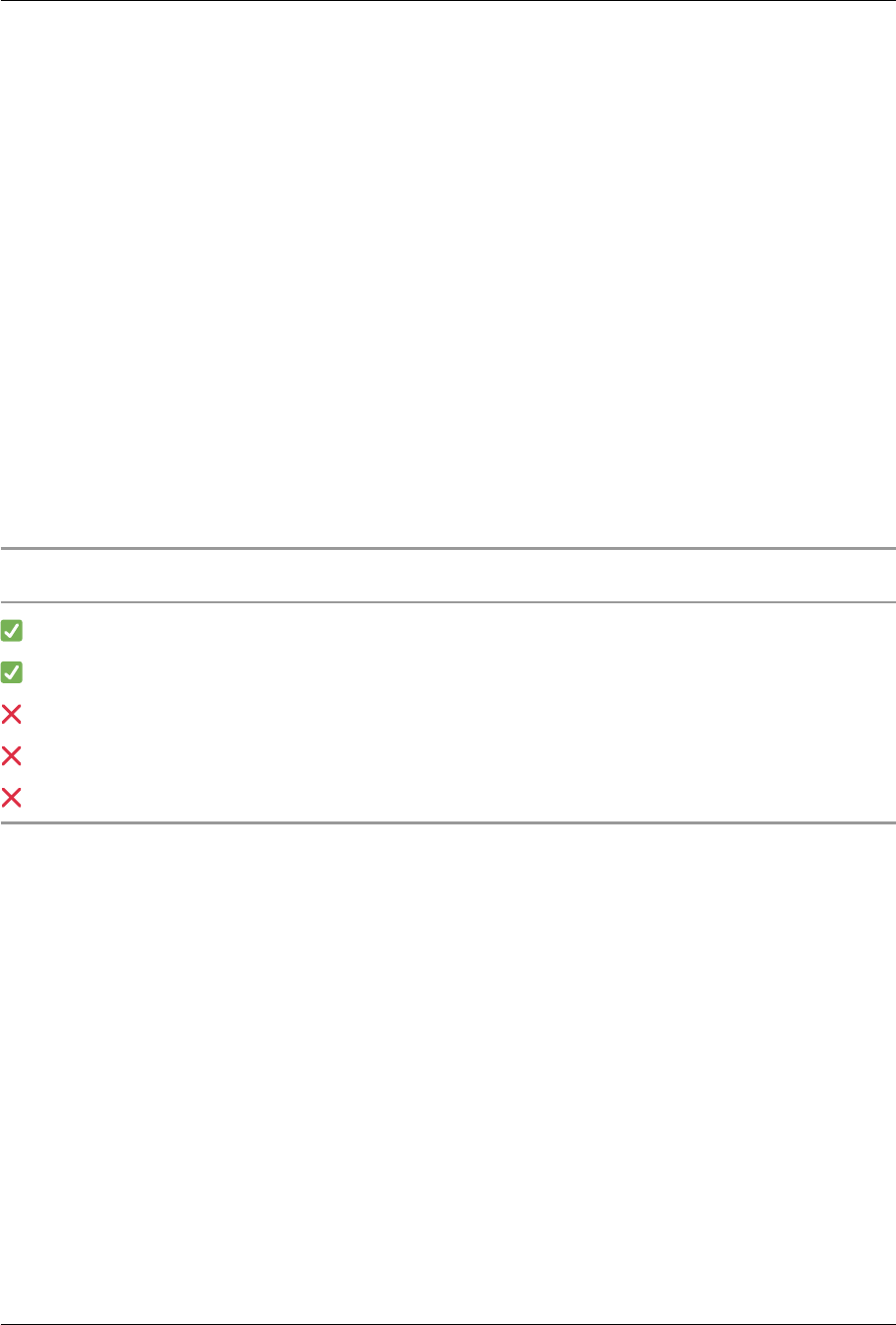
DuckDB Documentation
• If the cast still is ambiguous, i.e., there are multiple candidates with the same implicit casting
priority, an error is raised. This usually happens when the UNION contains multiple members
of the same type, e.g., a FLOAT -> UNION(i INT, num INT) is always ambiguous.
So how do we disambiguate if we want to create a UNIONwith multiple members of the same type? By
using the union_value function, which takes a keyword argument specifying the tag. For example,
union_value(num := 2::INT) will create a UNION with a single member of type INT with the
tag num. This can then be used to disambiguate in an explicit (or implicit, read on below!) UNION to
UNION cast, like CAST(union_value(b := 2) AS UNION(a INT, b INT)).
Casting between Unions UNION types can be cast between each other if the source type is a ”sub‑
set” of the target type. In other words, all the tags in the source UNION must be present in the target
UNION, and all the types of the matching tags must be implicitly castable between source and target.
In essence, this means that
UNION
types are covariant with respect to their members.
Ok Source Target Comments
UNION(a A, b B) UNION(a A, b B, c C)
UNION(a A, b B) UNION(a A, b C) if B can be implicitly cast to C
UNION(a A, b B, c C) UNION(a A, b B)
UNION(a A, b B) UNION(a A, b C) if B can't be implicitly cast to C
UNION(A, B, D) UNION(A, B, C)
Comparison and Sorting
Since UNION types are implemented on top of STRUCT types internally, they can be used with all
the comparison operators as well as in both WHERE and HAVING clauses with the same semantics as
STRUCTs. The ”tag” is always stored as the first struct entry, which ensures that the UNION types are
compared and ordered by ”tag” first.
Functions
See Nested Functions.
546

DuckDB Documentation
Expressions
Expressions
An expression is a combination of values, operatorsand functions. Expressionsare highly composable,
and range from very simple to arbitrarily complex. They can be found in many dierent parts of SQL
statements. In this section, we provide the dierent types of operators and functions that can be used
within expressions.
Case Statement
The CASEstatement performs a switch based on a condition. The basic form is identical to the ternary
condition used in many programming languages (CASE WHEN cond THEN a ELSE b END is
equivalent to cond ? a : b). With a single condition this can be expressed with IF(cond, a,
b).
CREATE OR REPLACE TABLE INTEGERS AS SELECT UNNEST([1, 2, 3]) AS i;
SELECT i, CASE WHEN i>2 THEN 1 ELSE 0 END AS test FROM integers;
-- 1, 2, 3
-- 0, 0, 1
-- this is equivalent to:
SELECT i, IF(i > 2, 1, 0) AS test FROM integers;
-- 1, 2, 3
-- 0, 0, 1
The WHEN cond THEN expr part of the CASE statement can be chained, whenever any of the
conditions returns true for a single tuple, the corresponding expression is evaluated and returned.
CREATE OR REPLACE TABLE INTEGERS AS SELECT UNNEST([1, 2, 3]) AS i;
SELECT i, CASE WHEN i=1 THEN 10 WHEN i=2 THEN 20 ELSE 0 END AS test FROM
integers;
-- 1, 2, 3
-- 10, 20, 0
The ELSE part of the CASE statement is optional. If no else statement is provided and none of the
conditions match, the CASE statement will return NULL.
CREATE OR REPLACE TABLE INTEGERS AS SELECT UNNEST([1, 2, 3]) AS i;
SELECT i, CASE WHEN i=1 THEN 10 END AS test FROM integers;
-- 1, 2, 3
-- 10, NULL, NULL
547

DuckDB Documentation
Aer the CASE but before the WHEN an individual expression can also be provided. When this is done,
the CASE statement is essentially transformed into a switch statement.
CREATE OR REPLACE TABLE INTEGERS AS SELECT UNNEST([1, 2, 3]) AS i;
SELECT i, CASE i WHEN 1 THEN 10 WHEN 2 THEN 20 WHEN 3 THEN 30 END AS test
FROM integers;
-- 1, 2, 3
-- 10, 20, 30
-- this is equivalent to:
SELECT i, CASE WHEN i=1 THEN 10 WHEN i=2 THEN 20 WHEN i=3 THEN 30 END AS
test FROM integers;
Casting
Casting refers to the process of changing the type of a row from one type to another. The standard SQL
syntax for this is CAST(expr AS typename). DuckDB also supports the easier to type shorthand
expr::typename, which is also present in PostgreSQL.
SELECT CAST(i AS VARCHAR) FROM generate_series(1, 3) tbl(i);
-- "1", "2", "3"
SELECT i::DOUBLE FROM generate_series(1, 3) tbl(i);
-- 1.0, 2.0, 3.0
SELECT CAST('hello' AS INTEGER);
-- Conversion Error: Could not convert string 'hello' to INT32
SELECT TRY_CAST('hello' AS INTEGER);
-- NULL
The exact behavior of the cast depends on the source and destination types. For example, when cast‑
ing from VARCHAR to any other type, the string will be attempted to be converted.
Not all casts are possible. For example, it is not possible to convert an INTEGER to a DATE. Casts may
also throw errors when the cast could not be successfully performed. For example, trying to cast the
string 'hello' to an INTEGER will result in an error being thrown.
TRY_CAST can be used when the preferred behavior is not to throw an error, but instead to return a
NULL value. TRY_CAST will never throw an error, and will instead return NULL if a cast is not possi‑
ble.
548

DuckDB Documentation
Implicit Casting
In many situations, the system will add casts by itself. This is called implicit casting. This happens for
example when a function is called with an argument that does not match the type of the function, but
can be casted to the desired type.
Consider the function SIN(DOUBLE). This function takes as input argument a column of type DOU-
BLE, however, it can be called with an integer as well: SIN(1). The integer is converted into a double
before being passed to the SIN function.
Generally, implicit casts only cast upwards. That is to say, we can implicitly cast an INTEGER to a
BIGINT, but not the other way around.
Collations
Collations provide rules for how text should be sorted or compared in the execution engine. Colla‑
tions are useful for localization, as the rules for how text should be ordered are dierent for dierent
languages or for dierent countries. These orderings are oen incompatible with one another. For
example, in English the letter ”y” comes between ”x” and ”z”. However, in Lithuanian the letter ”y”
comes between the ”i” and ”j”. For that reason, dierent collations are supported. The user must
choose which collation they want to use when performing sorting and comparison operations.
By default, the BINARY collation is used. That means that strings are ordered and compared based
only on their binary contents. This makes sense for standard ASCII characters (i.e., the letters A‑Z and
numbers 0‑9), but generally does not make much sense for special unicode characters. It is, however,
by far the fastest method of performing ordering and comparisons. Hence it is recommended to stick
with the BINARY collation unless required otherwise.
Using Collations
In the stand‑alone installation of DuckDB three collations are included: NOCASE, NOACCENT and
NFC. The NOCASE collation compares characters as equal regardless of their casing. The NOACCENT
collation compares characters as equal regardless of their accents. The NFC collation performs NFC‑
normalized comparisons, see here for more information.
SELECT 'hello'='hElLO';
-- false
SELECT 'hello' COLLATE NOCASE='hElLO';
-- true
SELECT 'hello' = 'hëllo';
549

DuckDB Documentation
-- false
SELECT 'hello' COLLATE NOACCENT = 'hëllo';
-- true
Collations can be combined by chaining them using the dot operator. Note, however, that not all
collations can be combined together. In general, the NOCASE collation can be combined with any
other collator, but most other collations cannot be combined.
SELECT 'hello' COLLATE NOCASE='hElLÖ';
-- false
SELECT 'hello' COLLATE NOACCENT='hElLÖ';
-- false
SELECT 'hello' COLLATE NOCASE.NOACCENT='hElLÖ';
-- true
Default Collations
The collations we have seen so far have all been specified per expression. It is also possible to specify
a default collator, either on the global database level or on a base table column. The PRAGMA de-
fault_collation can be used to specify the global default collator. This is the collator that will
be used if no other one is specified.
PRAGMA default_collation=NOCASE;
SELECT 'hello'='HeLlo';
-- true
Collations can also be specified per‑column when creating a table. When that column is then used in
a comparison, the per‑column collation is used to perform that comparison.
CREATE TABLE names(name VARCHAR COLLATE NOACCENT);
INSERT INTO names VALUES ('hännes');
SELECT name FROM names WHERE name='hannes';
-- hännes
Be careful here, however, as dierent collations cannot be combined. This can be problematic when
you want to compare columns that have a dierent collation specified.
SELECT name FROM names WHERE name='hannes' COLLATE NOCASE;
-- ERROR: Cannot combine types with different collation!
CREATE TABLE other_names(name VARCHAR COLLATE NOCASE);
INSERT INTO other_names VALUES ('HÄNNES');
550

DuckDB Documentation
SELECT * FROM names, other_names WHERE names.name=other_names.name;
-- ERROR: Cannot combine types with different collation!
-- need to manually overwrite the collation!
SELECT * FROM names, other_names WHERE names.name COLLATE
NOACCENT.NOCASE=other_names.name COLLATE NOACCENT.NOCASE;
-- hännes|HÄNNES
ICU Collations
The collations we have seen so far are not region‑dependent, and do not follow any specific regional
rules. If you wish to follow the rules of a specific region or language, you will need to use one of the
ICU collations. For that, you need to load the ICU extension.
If you are using the C++ API, you may find the extension in the extension/icufolder of the DuckDB
project. Using the C++ API, the extension can be loaded as follows:
DuckDB db;
db.LoadExtension<ICUExtension>();
Loading this extension will add a number of language and region specific collations to your database.
These can be queried using PRAGMA collations command, or by querying the pragma_
collations function.
PRAGMA collations;
SELECT * FROM pragma_collations();
-- [af, am, ar, as, az, be, bg, bn, bo, bs, bs, ca, ceb, chr, cs, cy, da,
de, de_AT, dsb, dz, ee, el, en, en_US, en_US, eo, es, et, fa, fa_AF, fi,
fil, fo, fr, fr_CA, ga, gl, gu, ha, haw, he, he_IL, hi, hr, hsb, hu, hy,
id, id_ID, ig, is, it, ja, ka, kk, kl, km, kn, ko, kok, ku, ky, lb, lkt,
ln, lo, lt, lv, mk, ml, mn, mr, ms, mt, my, nb, nb_NO, ne, nl, nn, om,
or, pa, pa, pa_IN, pl, ps, pt, ro, ru, se, si, sk, sl, smn, sq, sr, sr,
sr_BA, sr_ME, sr_RS, sr, sr_BA, sr_RS, sv, sw, ta, te, th, tk, to, tr,
ug, uk, ur, uz, vi, wae, wo, xh, yi, yo, zh, zh, zh_CN, zh_SG, zh, zh_
HK, zh_MO, zh_TW, zu]
These collations can then be used as the other collations would be used before. They can also be
combined with the NOCASE collation. For example, to use the German collation rules you could use
the following code snippet:
CREATE TABLE strings(s VARCHAR COLLATE DE);
551

DuckDB Documentation
INSERT INTO strings VALUES ('Gabel'), ('Göbel'), ('Goethe'), ('Goldmann'),
('Göthe'), ('Götz');
SELECT * FROM strings ORDER BY s;
-- "Gabel", "Göbel", "Goethe", "Goldmann", "Göthe", "Götz"
Comparisons
Comparison Operators
The table below shows the standard comparison operators. Whenever either of the input arguments
is NULL, the output of the comparison is NULL.
Operator Description Example Result
< less than 2 < 3 true
> greater than 2 > 3 false
<= less than or equal to 2 <= 3 true
>= greater than or equal to 4 >= NULL NULL
= equal NULL = NULL NULL
<> or != not equal 2 <> 2 false
The table below shows the standard distinction operators. These operators treat NULL values as
equal.
Operator Description Example Result
IS DISTINCT FROM not equal, including NULL 2 IS DISTINCT FROM
NULL
true
IS NOT DISTINCT
FROM
equal, including NULL NULL IS NOT
DISTINCT FROM NULL
true
BETWEEN and IS (NOT) NULL
Besides the standard comparison operators there are also the BETWEEN and IS (NOT) NULL op‑
erators. These behave much like operators, but have special syntax mandated by the SQL standard.
552

DuckDB Documentation
They are shown in the table below.
Note that BETWEEN and NOT BETWEEN are only equivalent to the examples below in the cases where
both a, x and y are of the same type, as BETWEEN will cast all of its inputs to the same type.
Predicate Description
a BETWEEN x AND y equivalent to a >= x AND a <= y
a NOT BETWEEN x AND y equivalent to a < x OR a > y
expression IS NULL true if expression is NULL, false otherwise
expression ISNULL alias for IS NULL (non‑standard)
expression IS NOT NULL false if expression is NULL, true otherwise
expression NOTNULL alias for IS NOT NULL (non‑standard)
IN Operator
The IN operator checks containment of the le expression inside the set of expressions on the right
hand side (RHS). The IN operator returns true if the expression is present in the RHS, false if the ex‑
pression is not in the RHS and the RHS has no NULL values, or NULLif the expression is not in the RHS
and the RHS has NULL values.
SELECT 'Math' IN ('CS', 'Math');
-- true
SELECT 'English' IN ('CS', 'Math');
-- false
SELECT 'Math' IN ('CS', 'Math', NULL);
-- true
SELECT 'English' IN ('CS', 'Math', NULL);
-- NULL
NOT IN can be used to check if an element is not present in the set. X NOT IN Y is equivalent to
NOT(X IN Y).
The IN operator can also be used with a subquery that returns a single column. See the subqueries
page for more information.
553

DuckDB Documentation
Logical Operators
The following logical operators are available: AND, OR and NOT. SQL uses a three‑valuad logic system
with
true
,
false
and
NULL
. Note that logical operators involving
NULL
do not always evaluate to
NULL. For example, NULL AND false will evaluate to false, and NULL OR true will evaluate
to true. Below are the complete truth tables:
a b a AND b a OR b
true true true true
true false false true
true NULL NULL true
false false false false
false NULL false NULL
NULL NULL NULL NULL
a NOT a
true false
false true
NULL NULL
The operators AND and ORare commutative, that is, you can switch the le and right operand without
aecting the result.
Star Expression
Examples
-- select all columns present in the FROM clause
SELECT * FROM table_name;
-- select all columns from the table called "table_name"
SELECT table_name.* FROM table_name JOIN other_table_name USING (id);
-- select all columns except the city column from the addresses table
SELECT * EXCLUDE (city) FROM addresses;
554

DuckDB Documentation
-- select all columns from the addresses table, but replace city with
LOWER(city)
SELECT * REPLACE (LOWER(city) AS city) FROM addresses;
-- select all columns matching the given expression
SELECT COLUMNS(c -> c LIKE '%num%') FROM addresses;
-- select all columns matching the given regex from the table
SELECT COLUMNS('number\d+') FROM addresses;
Syntax
Star Expression
The * expression can be used in a SELECT statement to select all columns that are projected in the
FROM clause.
SELECT * FROM tbl;
The * expression can be modified using the EXCLUDE and REPLACE.
EXCLUDE Clause EXCLUDE allows us to exclude specific columns from the * expression.
SELECT * EXCLUDE (col) FROM tbl;
Replace Clause REPLACE allows us to replace specific columns with dierent expressions.
SELECT * REPLACE (col / 1000 AS col) FROM tbl;
COLUMNS
The COLUMNS expression can be used to execute the same expression on multiple columns. Like the
* expression, it can only be used in the SELECT clause.
CREATE TABLE numbers(id int, number int);
INSERT INTO numbers VALUES (1, 10), (2, 20), (3, NULL);
SELECT MIN(COLUMNS(*)), COUNT(COLUMNS(*)) FROM numbers;
min(numbers.id) min(numbers.number) count(numbers.id) count(numbers.number)
1 10 3 2
555

DuckDB Documentation
The * expression in the COLUMNS statement can also contain EXCLUDE or REPLACE, similar to reg‑
ular star expressions.
SELECT MIN(COLUMNS(* REPLACE (number + id AS number))), COUNT(COLUMNS(*
EXCLUDE (number))) FROM numbers;
min(numbers.id) min(number := (number + id)) count(numbers.id)
1 11 3
COLUMNS expressions can also be combined, as long as the COLUMNS contains the same (star) ex‑
pression:
SELECT COLUMNS(*) + COLUMNS(*) FROM numbers;
(numbers.id + numbers.id) (numbers.number + numbers.number)
2 20
4 40
6 NULL
COLUMNS Regular Expression
COLUMNS supports passing a regex in as a string constant:
SELECT COLUMNS('(id|numbers?)') FROM numbers;
id number
1 10
2 20
3 NULL
COLUMNS Lambda Function
COLUMNS also supports passing in a lambda function. The lambda function will be evaluated for
all columns present in the FROM clause, and only columns that match the lambda function will be
returned. This allows the execution of arbitrary expressions in order to select columns.
556

DuckDB Documentation
SELECT COLUMNS(c -> c LIKE '%num%') FROM numbers;
number
10
20
NULL
Struct.*
The * expression can also be used to retrieve all keys from a struct as separate columns. This is par‑
ticularly useful when a prior operation creates a struct of unknown shape, or if a query must handle
any potential struct keys. See the struct and nested function pages for more details on working with
structs.
-- All keys within a struct can be returned as separate columns using *
SELECT a.* FROM (SELECT {'x':1, 'y':2, 'z':3} AS a);
x y z
1 2 3
Subqueries
Scalar Subquery
Scalar subqueries are subqueries that return a single value. They can be used anywhere where a reg‑
ular expression can be used. If a scalar subquery returns more than a single value, the first value
returned will be used.
Consider the following table:
Grades
557

DuckDB Documentation
grade course
7 Math
9 Math
8 CS
CREATE TABLE grades(grade INTEGER, course VARCHAR);
INSERT INTO grades VALUES (7, 'Math'), (9, 'Math'), (8, 'CS');
We can run the following query to obtain the minimum grade:
SELECT MIN(grade) FROM grades;
-- {7}
By using a scalar subquery in the WHERE clause, we can figure out for which course this grade was
obtained:
SELECT course FROM grades WHERE grade = (SELECT MIN(grade) FROM grades);
-- {Math}
Exists
The EXISTS operator tests for the existence of any row inside the subquery. It returns either true
when the subquery returns one or more records, and false otherwise. The EXISTS operator is gener‑
ally the most useful as a correlated subquery to express semijoin operations. However, it can be used
as an uncorrelated subquery as well.
For example, we can use it to figure out if there are any grades present for a given course:
SELECT EXISTS (SELECT * FROM grades WHERE course='Math');
-- true
SELECT EXISTS (SELECT * FROM grades WHERE course='History');
-- false
Not exists The NOT EXISTS operator tests for the absence of any row inside the subquery. It
returnseither true when the subquery returnsan emptyresult, and false otherwise. The NOT EXISTS
operator is generally the most useful as a correlated subquery to express antijoin operations. For
example, to find Person nodes without an interest:
558

DuckDB Documentation
CREATE TABLE Person(id BIGINT, name VARCHAR);
CREATE TABLE interest(PersonId BIGINT, topic VARCHAR);
INSERT INTO Person VALUES (1, 'Jane'), (2, 'Joe');
INSERT INTO interest VALUES (2, 'Music');
SELECT *
FROM Person
WHERE NOT EXISTS (SELECT * FROM interest WHERE interest.PersonId =
Person.id);
┌───────┬─────────┐
│ id │ name │
│ int64 │ varchar │
├───────┼─────────┤
│ 1 │ Jane │
└───────┴─────────┘
Note. DuckDB automatically detects when a NOT EXISTS query expresses an antijoin oper‑
ation. There is no need to manually rewrite such queries to use LEFT OUTER JOIN ...
WHERE ... IS NULL.
In Operator
The IN operator checks containment of the le expression inside the result defined by the subquery
or the set of expressions on the right hand side (RHS). The INoperator returns true if the expression is
present in the RHS, false if the expression is not in the RHS and the RHS has no NULL values, or NULL
if the expression is not in the RHS and the RHS has NULL values.
We can use the IN operator in a similar manner as we used the EXISTS operator:
SELECT 'Math' IN (SELECT course FROM grades);
-- true
Correlated Subqueries
All the subqueries presented here so far have been uncorrelated subqueries, where the subqueries
themselves are entirely self‑contained and can be run without the parent query. There exists a second
type of subqueries called correlated subqueries. For correlated subqueries, the subquery uses values
from the parent subquery.
559

DuckDB Documentation
Conceptually, the subqueries are run once for every single row in the parent query. Perhaps a simple
way of envisioning this is that the correlated subquery is a function that is applied to every row in the
source data set.
For example, suppose that we want to find the minimum grade for every course. We could do that as
follows:
SELECT *
FROM grades grades_parent
WHERE grade=
(SELECT MIN(grade)
FROM grades
WHERE grades.course=grades_parent.course);
-- {7, Math}, {8, CS}
The subquery uses a column from the parent query (grades_parent.course). Conceptually, we
can see the subquery as a function where the correlated column is a parameter to that function:
SELECT MIN(grade) FROM grades WHERE course=?;
Now when we execute this function for each of the rows, we can see that for Math this will return 7,
and for CS it will return 8. We then compare it against the grade for that actual row. As a result, the
row (Math, 9) will be filtered out, as 9 <> 7.
Returning Each Row of the Subquery as a Struct
Using the name of a subquery in the SELECT clause (without referring to a specific column) turns
each row of the subquery into a struct whose fields correspond to the columns of the subquery. For
example:
SELECT t FROM (SELECT unnest(generate_series(41, 43)) AS x, 'hello' AS y) t;
┌─────────────────────────────┐
│ t │
│ struct(x bigint, y varchar) │
├─────────────────────────────┤
│ {'x': 41, 'y': hello} │
│ {'x': 42, 'y': hello} │
│ {'x': 43, 'y': hello} │
└─────────────────────────────┘
560

DuckDB Documentation
Functions
Functions
Function Syntax
Query Functions duckdb_functions table function shows the list of functions currently built
into the system.
SELECT DISTINCT ON(function_name) function_name, function_type, return_type,
parameters, parameter_types, description
FROM duckdb_functions()
WHERE function_type = 'scalar' AND function_name LIKE 'b%'
ORDER BY function_name;
┌───────────────┬───────────────┬─────────────┬──────────────────────┬──────────────────────┬──────────────────────────────────────────┐
│ function_name │ function_type │ return_type │ parameters │
parameter_types │ description │
│ varchar │ varchar │ varchar │ varchar[] │
varchar[] │ varchar │
├───────────────┼───────────────┼─────────────┼──────────────────────┼──────────────────────┼──────────────────────────────────────────┤
│ bar │ scalar │ VARCHAR │ [x, min, max, width] │
[DOUBLE, DOUBLE, D… │ Draws a band whose width is proportion… │
│ base64 │ scalar │ VARCHAR │ [blob] │ [BLOB]
│ Converts a blob to a base64 encoded st… │
│ bin │ scalar │ VARCHAR │ [value] │
[VARCHAR] │ Converts the value to binary represent… │
│ bit_count │ scalar │ TINYINT │ [x] │
[TINYINT] │ Returns the number of bits that are set │
│ bit_length │ scalar │ BIGINT │ [col0] │
[VARCHAR] │ │
│ bit_position │ scalar │ INTEGER │ [substring, bitstr… │ [BIT,
BIT] │ Returns first starting index of the sp… │
│ bitstring │ scalar │ BIT │ [bitstring, length] │
[VARCHAR, INTEGER] │ Pads the bitstring until the specified… │
└───────────────┴───────────────┴─────────────┴──────────────────────┴──────────────────────┴──────────────────────────────────────────┘
Currently the description and parameter names of functions are still missing.
Bitstring Functions
This section describes functions and operators for examining and manipulating bit values. Bitstrings
must be of equal length when performing the bitwise operands AND, OR and XOR. When bit shiing,
561

DuckDB Documentation
the original length of the string is preserved.
Bitstring Operators
The table below shows the available mathematical operators for BIT type.
Operator Description Example Result
& bitwise AND '10101'::BIT & '10001'::BIT 10001
| bitwise OR '1011'::BIT | '0001'::BIT 1011
xor bitwise XOR xor('101'::BIT, '001'::BIT) 100
~ bitwise NOT ~('101'::BIT) 010
<< bitwise shi le '1001011'::BIT << 3 1011000
>> bitwise shi right '1001011'::BIT >> 3 0001001
Bitstring Functions
The table below shows the available scalar functions for BIT type.
Function Description Example Result
bit_count(
bitstring)
Returns the number of set bits
in the bitstring.
bit_
count('1101011'::BIT)
5
bit_length(
bitstring)
Returns the number of bits in
the bitstring.
bit_
length('1101011'::BIT)
7
bit_
position(
substring,
bitstring)
Returns first starting index of
the specified substring within
bits, or zero if it's not present.
The first (lemost) bit is
indexed 1
bit_
position('010'::BIT,
'1110101'::BIT)
4
bitstring(
bitstring,
length)
Returns a bitstring of
determined length.
bitstring('1010'::BIT,
7)
0001010
562

DuckDB Documentation
Function Description Example Result
get_bit(
bitstring,
index)
Extracts the nth bit from
bitstring; the first (lemost) bit
is indexed 0.
get_
bit('0110010'::BIT,
2)
1
length(
bitstring)
Alias for bit_length. length('1101011'::BIT) 7
octet_
length(
bitstring)
Returns the number of bytes
in the bitstring.
octet_
length('1101011'::BIT)
1
set_bit(
bitstring,
index, new_
value)
Sets the nth bit in bitstring to
newvalue; the first (lemost)
bit is indexed 0. Returns a new
bitstring.
set_
bit('0110010'::BIT,
2, 0)
0100010
Bitstring Aggregate Functions
These aggregate functions are available for BIT type.
Function Description Example
bit_and(arg) Returns the bitwise AND operation
performed on all bitstrings in a given
expression.
bit_and(A)
bit_or(arg) Returns the bitwise OR operation
performed on all bitstrings in a given
expression.
bit_or(A)
bit_xor(arg) Returns the bitwise XOR operation
performed on all bitstrings in a given
expression.
bit_xor(A)
bitstring_agg(arg) Returns a bitstring with bits set for each
distinct value.
bitstring_agg(A)
bitstring_agg(arg,
min, max)
Returns a bitstring with bits set for each
distinct value.
bitstring_agg(A,
1, 42)
563

DuckDB Documentation
Bitstring Aggregation The BITSTRING_AGG function takes any integer type as input and returns
a bitstring with bits set for each distinct value. The le‑most bit represents the smallest value in the
column and the right‑most bit the maximum value. If possible, the min and max are retrieved from
the column statistics. Otherwise, it is also possible to provide the min and max values.
The combination of BIT_COUNT and BITSTRING_AGG could be used as an alternative to COUNT
DISTINCT, with possible performance improvements in cases of low cardinality and dense values.
Blob Functions
This section describes functions and operators for examining and manipulating blob values.
Function Description Example Result
blob || blob Blob concatenation '\xAA'::BLOB ||
'\xBB'::BLOB
\xAA\xBB
decode(
blob)
Convert blob to varchar.
Fails if blob is not valid
utf‑8.
decode('\xC3\xBC'::BLOB) ü
encode(
string)
Convert varchar to blob.
Converts utf‑8 characters
into literal encoding.
encode('my_string_with_
ü')
my_string_
with_\xC3\xBC
octet_
length(
blob)
Number of bytes in blob octet_
length('\xAA\xBB'::BLOB)
2
Date Format
The strftime and strptime functions can be used to convert between dates/timestamps and
strings. This is oen required when parsing CSV files, displaying output to the user or transferring in‑
formation between programs. Because there are many possible date representations, these functions
accept a format string that describes how the date or timestamp should be structured.
strime Examples
strftime(timestamp, format) converts timestamps or dates to strings according to the spec‑
ified pattern.
564

DuckDB Documentation
SELECT strftime(DATE '1992-03-02', '%d/%m/%Y');
-- 02/03/1992
SELECT strftime(TIMESTAMP '1992-03-02 20:32:45', '%A, %-d %B %Y - %I:%M:%S
%p');
-- Monday, 2 March 1992 - 08:32:45 PM
strptime Examples
strptime(string, format) converts strings to timestamps according to the specified pat‑
tern.
SELECT strptime('02/03/1992', '%d/%m/%Y');
-- 1992-03-02 00:00:00
SELECT strptime('Monday, 2 March 1992 - 08:32:45 PM', '%A, %-d %B %Y -
%I:%M:%S %p');
-- 1992-03-02 20:32:45
CSV Parsing
The date formats can also be specified during CSV parsing, either in the COPY statement or in the
read_csvfunction. This can be done by either specifying a DATEFORMATor a TIMESTAMPFORMAT
(or both). DATEFORMAT will be used for converting dates, and TIMESTAMPFORMAT will be used for
converting timestamps. Below are some examples for how to use this:
-- in COPY statement
COPY dates FROM 'test.csv' (DATEFORMAT '%d/%m/%Y', TIMESTAMPFORMAT '%A, %-d
%B %Y - %I:%M:%S %p');
-- in read_csv function
SELECT * FROM read_csv('test.csv', dateformat='%m/%d/%Y');
Format Specifiers
Below is a full list of all available format specifiers.
Specifier Description Example
%a Abbreviated weekday name. Sun, Mon, ...
%A Full weekday name. Sunday, Monday, ...
565

DuckDB Documentation
Specifier Description Example
%w Weekday as a decimal number. 0, 1, ..., 6
%d Day of the month as a zero‑padded decimal. 01, 02, ..., 31
%-d Day of the month as a decimal number. 1, 2, ..., 30
%b Abbreviated month name. Jan, Feb, ..., Dec
%B Full month name. January, February, ...
%m Month as a zero‑padded decimal number. 01, 02, ..., 12
%-m Month as a decimal number. 1, 2, ..., 12
%y Year without century as a zero‑padded decimal
number.
00, 01, ..., 99
%-y Year without century as a decimal number. 0, 1, ..., 99
%Y Year with century as a decimal number. 2013, 2019 etc.
%H Hour (24‑hour clock) as a zero‑padded decimal
number.
00, 01, ..., 23
%-H Hour (24‑hour clock) as a decimal number. 0, 1, ..., 23
%I Hour (12‑hour clock) as a zero‑padded decimal
number.
01, 02, ..., 12
%-I Hour (12‑hour clock) as a decimal number. 1, 2, ... 12
%p
Locale's AM or PM.
AM, PM
%M Minute as a zero‑padded decimal number. 00, 01, ..., 59
%-M Minute as a decimal number. 0, 1, ..., 59
%S Second as a zero‑padded decimal number. 00, 01, ..., 59
%-S Second as a decimal number. 0, 1, ..., 59
%g Millisecond as a decimal number, zero‑padded on
the le.
000 ‑ 999
%f Microsecond as a decimal number, zero‑padded on
the le.
000000 ‑ 999999
%n Nanosecond as a decimal number, zero‑padded on
the le.
000000000 ‑ 999999999
566

DuckDB Documentation
Specifier Description Example
%z Time oset from UTC in the form ±HH:MM, ±HHMM,
or ±HH.
‑0700
%Z Time zone name. Europe/Amsterdam
%j Day of the year as a zero‑padded decimal number. 001, 002, ..., 366
%-j Day of the year as a decimal number. 1, 2, ..., 366
%U Week number of the year (Sunday as the first day
of the week).
00, 01, ..., 53
%W Week number of the year (Monday as the first day
of the week).
00, 01, ..., 53
%c ISO date and time representation 1992‑03‑02 10:30:20
%x ISO date representation 1992‑03‑02
%X ISO time representation 10:30:20
%% A literal '%' character. %
Date Functions
This section describes functions and operators for examining and manipulating date values.
Date Operators
The table below shows the available mathematical operators for DATE types.
Operator Description Example Result
+ addition of days
(integers)
DATE '1992-03-22' + 5 1992‑03‑27
+ addition of an
INTERVAL
DATE '1992-03-22' +
INTERVAL 5 DAY
1992‑03‑27
567

DuckDB Documentation
Operator Description Example Result
+ addition of a variable
INTERVAL
SELECT DATE
'1992-03-22' +
INTERVAL 1 DAY *
d.days FROM (VALUES
(5), (11)) AS d(days)
1992‑03‑27 1992‑04‑02
- subtraction of DATEs DATE '1992-03-27' -
DATE '1992-03-22'
5
- subtraction of an
INTERVAL
DATE '1992-03-27' -
INTERVAL 5 DAY
1992‑03‑22
- subtraction of a
variable INTERVAL
SELECT DATE
'1992-03-27' -
INTERVAL 1 DAY *
d.days FROM (VALUES
(5), (11)) AS d(days)
1992‑03‑22 1992‑03‑16
Adding to or subtracting from infinite values produces the same infinite value.
Date Functions
The table below shows the available functions for DATE types. Dates can also be manipulated with
the timestamp functions through type promotion.
Function Description Example Result
current_date Current date (at start
of current transaction)
current_date 2022-10-08
date_diff( part,
startdate,
enddate)
The number of
partition boundaries
between the dates
date_diff('month',
DATE '1992-09-15',
DATE '1992-11-14')
2
datediff( part,
startdate,
enddate)
Alias of date_di. The
number of partition
boundaries between
the dates
datediff('month',
DATE '1992-09-15',
DATE '1992-11-14')
2
568

DuckDB Documentation
Function Description Example Result
date_part( part,
date)
Get the subfield
(equivalent to
extract)
date_part('year',
DATE '1992-09-20')
1992
datepart( part,
date)
Alias of date_part. Get
the subfield
(equivalent to
extract)
datepart('year', DATE
'1992-09-20')
1992
date_sub( part,
startdate,
enddate)
The number of
complete partitions
between the dates
date_sub('month',
DATE '1992-09-15',
DATE '1992-11-14')
1
datesub( part,
startdate,
enddate)
Alias of date_sub. The
number of complete
partitions between the
dates
datesub('month', DATE
'1992-09-15', DATE
'1992-11-14')
1
date_trunc(
part, date)
Truncate to specified
precision
date_trunc('month',
DATE '1992-03-07')
1992-03-01
datetrunc( part,
date)
Alias of date_trunc.
Truncate to specified
precision
datetrunc('month',
DATE '1992-03-07')
1992-03-01
dayname( date) The (English) name of
the weekday
dayname(DATE
'1992-09-20')
Sunday
isfinite( date) Returns true if the date
is finite, false
otherwise
isfinite(DATE
'1992-03-07')
true
isinf( date) Returns true if the date
is infinite, false
otherwise
isinf(DATE
'-infinity')
true
extract( part
fromdate)
Get subfield from a
date
extract('year' FROM
DATE '1992-09-20')
1992
greatest( date,
date)
The later of two dates greatest(DATE
'1992-09-20', DATE
'1992-03-07')
1992-09-20
569

DuckDB Documentation
Function Description Example Result
last_day( date) The last day of the
corresponding month
in the date
last_day(DATE
'1992-09-20')
1992-09-30
least( date,
date)
The earlier of two
dates
least(DATE
'1992-09-20', DATE
'1992-03-07')
1992-03-07
make_date(
bigint, bigint,
bigint)
The date for the given
parts
make_date(1992, 9,
20)
1992-09-20
monthname( date) The (English) name of
the month
monthname(DATE
'1992-09-20')
September
strftime(date,
format)
Converts a date to a
string according to the
format string
strftime(date
'1992-01-01', '%a,
%-d %B %Y')
Wed, 1
January
1992
time_bucket(
bucket_width,
date[,origin])
Truncate date by the
specified interval
bucket_width.
Buckets are aligned
relative to origin
date. origin defaults
to 2000‑01‑03 for
buckets that don't
include a month or
year interval, and to
2000‑01‑01 for month
and year buckets.
time_bucket(INTERVAL
'2 weeks', DATE
'1992-04-20', DATE
'1992-04-01')
1992-04-15
time_bucket(
bucket_width,
date[,offset])
Truncate date by the
specified interval
bucket_width.
Buckets are oset by
offset interval.
time_bucket(INTERVAL
'2 months', DATE
'1992-04-20',
INTERVAL '1 month')
1992-04-01
today() Current date (start of
current transaction)
today() 2022-10-08
570

DuckDB Documentation
There are also dedicated extraction functions to get the subfields. A few examples include extracting
the day from a date, or the day of the week from a date.
Functions applied to infinite dates will either return the same infinite dates (e.g, greatest) or NULL
(e.g., date_part) depending on what ”makes sense”. In general, if the function needs to examine
the parts of the infinite date, the result will be NULL.
Date Parts
The date_partand date_diffand date_trunc functions can be used to manipulate the fields
of temporal types. The fields are specified as strings that contain the part name of the field.
Part Specifiers
Below is a full list of all available date part specifiers. The examples are the corresponding parts of the
timestamp 2021-08-03 11:59:44.123456.
Usable as Date Part Specifiers and in Intervals
Specifier Description Synonyms Example
'century' Gregorian century 'cent', 'centuries',
'c'
21
'day' Gregorian day 'days', 'd',
'dayofmonth'
3
'decade' Gregorian decade 'dec', 'decades',
'decs'
202
'hour' Hours 'hr', 'hours', 'hrs', 'h' 11
'microseconds' Sub‑minute
microseconds
'microsecond', 'us',
'usec', 'usecs',
'usecond', 'useconds'
44123456
'millennium' Gregorian millennium 'mil', 'millenniums',
'millenia', 'mils',
'millenium'
3
571
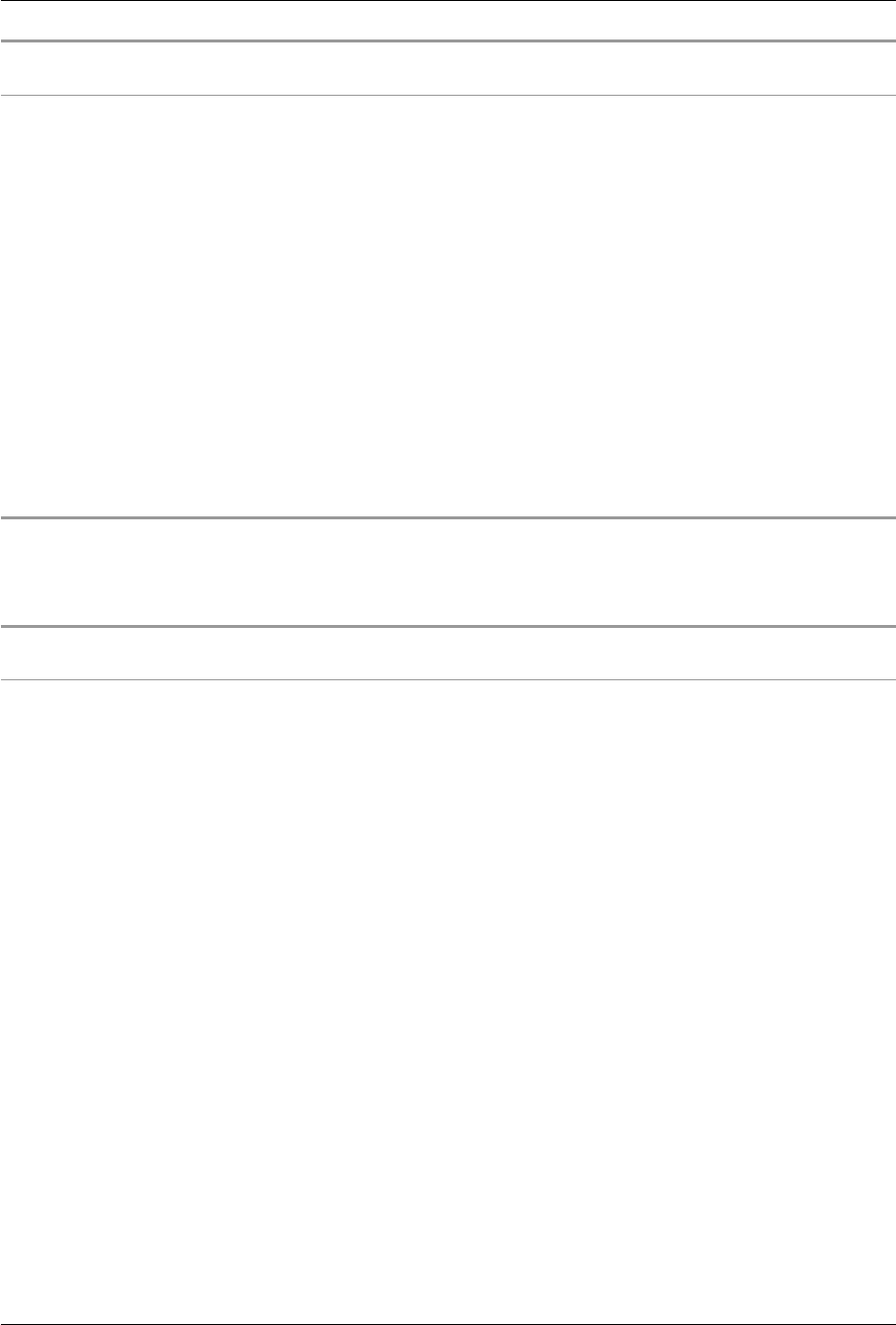
DuckDB Documentation
Specifier Description Synonyms Example
'milliseconds' Sub‑minute
milliseconds
'millisecond', 'ms',
'msec', 'msecs',
'msecond', 'mseconds'
44123
'minute' Minutes 'min', 'minutes',
'mins', 'm'
59
'month' Gregorian month 'mon', 'months', 'mons' 8
'quarter' Quarter of the year
(1‑4)
'quarters' 3
'second'
Seconds
'sec'
,
'seconds'
,
'secs', 's'
44
'year' Gregorian year 'yr', 'y', 'years', 'yrs' 2021
Usable in Date Part Specifiers Only
Specifier Description Synonyms Example
'dayofweek' Day of the week
(Sunday = 0, Saturday
= 6)
'weekday', 'dow' 2
'dayofyear' Day of the year
(1‑365/366)
'doy' 215
'epoch' Seconds since
1970‑01‑01
1627991984
'era' Gregorian era (CE/AD,
BCE/BC)
1
'isodow' ISO day of the week
(Monday = 1, Sunday =
7)
2
'isoyear' ISO Year number
(Starts on Monday of
week containing Jan
4th)
2021
572

DuckDB Documentation
Specifier Description Synonyms Example
'timezone' Time zone oset in
seconds
0
'timezone_hour' Time zone oset hour
portion
0
'timezone_
minute'
Time zone oset
minute portion
0
'week' Week number 'weeks', 'w' 31
'yearweek' ISO year and week
number in YYYYWW
format
202131
Note that the time zone parts are all zero unless a time zone plugin such as ICU has been installed to
support TIMESTAMP WITH TIME ZONE.
Part Functions There are dedicated extraction functions to get certain subfields:
Function Description Example Result
century( date) Century century(date
'1992-02-15')
20
day( date) Day day(date
'1992-02-15')
15
dayofmonth(
date)
Day (synonym) dayofmonth(date
'1992-02-15')
15
dayofweek( date) Numeric weekday
(Sunday = 0, Saturday
= 6)
dayofweek(date
'1992-02-15')
6
dayofyear( date) Day of the year (starts
from 1, i.e., January 1
= 1)
dayofyear(date
'1992-02-15')
46
decade( date) Decade (year / 10) decade(date
'1992-02-15')
199
573

DuckDB Documentation
Function Description Example Result
epoch( date) Seconds since
1970‑01‑01
epoch(date
'1992-02-15')
698112000
era( date) Calendar era era(date '0044-03-15
(BC)')
0
hour( date) Hours hour(timestamp
'2021-08-03
11:59:44.123456')
11
isodow( date) Numeric ISO weekday
(Monday = 1, Sunday =
7)
isodow(date
'1992-02-15')
6
isoyear( date) ISO Year number
(Starts on Monday of
week containing Jan
4th)
isoyear(date
'2022-01-01')
2021
microsecond(
date)
Sub‑minute
microseconds
microsecond(timestamp
'2021-08-03
11:59:44.123456')
44123456
millennium(
date)
Millennium millennium(date
'1992-02-15')
2
millisecond(
date)
Sub‑minute
milliseconds
millisecond(timestamp
'2021-08-03
11:59:44.123456')
44123
minute( date) Minutes minute(timestamp
'2021-08-03
11:59:44.123456')
59
month( date) Month month(date
'1992-02-15')
2
quarter( date) Quarter quarter(date
'1992-02-15')
1
second( date) Seconds second(timestamp
'2021-08-03
11:59:44.123456')
44
574

DuckDB Documentation
Function Description Example Result
timezone( date) Time Zone oset in
minutes
timezone(date
'1992-02-15')
0
timezone_hour(
date)
Time zone oset hour
portion
timezone_hour(date
'1992-02-15')
0
timezone_
minute( date)
Time zone oset
minutes portion
timezone_minute(date
'1992-02-15')
0
week( date) ISO Week week(date
'1992-02-15')
7
weekday( date) Numeric weekday
synonym (Sunday = 0,
Saturday = 6)
weekday(date
'1992-02-15')
6
weekofyear(
date)
ISO Week (synonym) weekofyear(date
'1992-02-15')
7
year( date) Year year(date
'1992-02-15')
1992
yearweek( date) BIGINT of combined
ISO Year number and
2‑digit version of ISO
Week number
yearweek(date
'1992-02-15')
199207
Enum Functions
This section describes functions and operators for examining and manipulating ENUM values. The
examples assume an enum type created as:
CREATE TYPE mood AS ENUM ('sad', 'ok', 'happy', 'anxious');
These functions can take NULL or a specific value of the type as argument(s). With the exception
of enum_range_boundary, the result depends only on the type of the argument and not on its
value.
575

DuckDB Documentation
Function Description Example Result
enum_code( enum_
value)
Returns the numeric
value backing the
given enum value
enum_
code('happy'::mood)
2
enum_first(
enum)
Returns the first value
of the input enum
type.
enum_
first(null::mood)
sad
enum_last( enum) Returns the last value
of the input enum
type.
enum_last(null::mood) anxious
enum_range(
enum)
Returns all values of
the input enum type as
an array.
enum_
range(null::mood)
[sad, ok,
happy,
anxious]
enum_range_
boundary( enum,
enum)
Returns the range
between the two given
enum values as an
array. The values must
be of the same enum
type. When the first
parameter is NULL,
the result starts with
the first value of the
enum type. When the
second parameter is
NULL, the result ends
with the last value of
the enum type.
enum_range_
boundary(NULL,
'happy'::mood)
[sad, ok,
happy]
Interval Functions
This section describes functions and operators for examining and manipulating INTERVAL values.
576

DuckDB Documentation
Interval Operators
The table below shows the available mathematical operators for INTERVAL types.
Operator Description Example Result
+ addition of an
INTERVAL
INTERVAL 1 HOUR +
INTERVAL 5 HOUR
INTERVAL 6 HOUR
+ addition to a DATE DATE '1992-03-22' +
INTERVAL 5 DAY
1992‑03‑27
+ addition to a
TIMESTAMP
TIMESTAMP '1992-03-22
01:02:03' + INTERVAL 5
DAY
1992‑03‑27 01:02:03
+ addition to a TIME TIME '01:02:03' +
INTERVAL 5 HOUR
06:02:03
- subtraction of an
INTERVAL
INTERVAL 5 HOUR -
INTERVAL 1 HOUR
INTERVAL 4 HOUR
- subtraction from a
DATE
DATE '1992-03-27' -
INTERVAL 5 DAY
1992‑03‑22
- subtraction from a
TIMESTAMP
TIMESTAMP '1992-03-27
01:02:03' - INTERVAL 5
DAY
1992‑03‑22 01:02:03
- subtraction from a
TIME
TIME '06:02:03' -
INTERVAL 5 HOUR
01:02:03
Interval Functions
The table below shows the available scalar functions for INTERVAL types.
Function Description Example Result
date_part(
part, interval)
Get subfield
(equivalent to
extract)
date_part('year',
INTERVAL '14
months')
1
577

DuckDB Documentation
Function Description Example Result
datepart( part,
interval)
Alias of date_part.
Get subfield
(equivalent to
extract)
datepart('year',
INTERVAL '14
months')
1
extract( part
from interval)
Get subfield from a
date
extract('month'
FROM INTERVAL '14
months')
2
to_days(
integer)
Construct a day
interval
to_days(5) INTERVAL 5 DAY
to_hours(
integer)
Construct a hour
interval
to_hours(5) INTERVAL 5 HOUR
to_
microseconds(
integer)
Construct a
microsecond interval
to_microseconds(5) INTERVAL 5
MICROSECOND
to_
milliseconds(
integer)
Construct a
millisecond interval
to_milliseconds(5) INTERVAL 5
MILLISECOND
to_minutes(
integer)
Construct a minute
interval
to_minutes(5) INTERVAL 5 MINUTE
to_months(
integer)
Construct a month
interval
to_months(5) INTERVAL 5 MONTH
to_seconds(
integer)
Construct a second
interval
to_seconds(5) INTERVAL 5 SECOND
to_years(
integer)
Construct a year
interval
to_years(5) INTERVAL 5 YEAR
Only the documented date parts are defined for intervals.
Nested Functions
This section describes functions and operators for examining and manipulating nested values. There
are three nested data types: lists, structs, and maps.
578

DuckDB Documentation
List Functions
In the descriptions, l is the three element list [4, 5, 6].
Function Aliases Description Example Result
list[index] Bracket notation
serves as an alias
for list_
extract.
l[3] 6
list[begin:end] Bracket notation
with colon is an
alias for list_
slice.
l[2:3] [5, 6]
list[begin:end:step] list_slice in
bracket notation
with an added
step feature.
l[:-:2] [4, 6]
array_pop_
back( list)
Returns the list
without the last
element.
array_pop_
back(l)
[4, 5]
array_pop_
front( list)
Returns the list
without the first
element.
array_pop_
front(l)
[5, 6]
flatten( list_
of_lists)
Concatenate a list
of lists into a single
list. This only
flattens one level
of the list (see
examples).
flatten([[1,
2], [3, 4]])
[1, 2,
3, 4]
len( list) array_length Return the length
of the list.
len([1, 2,
3])
3
579

DuckDB Documentation
Function Aliases Description Example Result
list_
aggregate(
list, name)
list_aggr,
aggregate,
array_
aggregate,
array_aggr
Executes the
aggregate function
name on the
elements of list.
See the List
Aggregates section
for more details.
list_
aggregate([1,
2, NULL],
'min')
1
list_any_
value( list)
Returns the first
non‑null value in
the list
list_any_
value([NULL,
-3])
-3
list_append(
list, element)
array_append,
array_push_
back
Appends element
to list.
list_
append([2,
3], 4)
[2, 3,
4]
list_concat(
list1, list2)
list_cat,
array_concat,
array_cat
Concatenates two
lists.
list_
concat([2,
3], [4, 5,
6])
[2, 3,
4, 5, 6]
list_
contains(
list, element)
list_has,
array_
contains,
array_has
Returns true if the
list contains the
element.
list_
contains([1,
2, NULL], 1)
true
list_cosine_
similarity(
list1, list2)
Compute the
cosine similarity
between two lists
list_cosine_
similarity([1,
2, 3], [1, 2,
5])
0.9759000729485332
list_
distance(
list1, list2)
list_
distance([1,
2, 3], [1, 2,
5])
2.0
580

DuckDB Documentation
Function Aliases Description Example Result
list_
distinct(
list)
array_
distinct
Removes all
duplicates and
NULLs from a list.
Does not preserve
the original order.
list_
distinct([1,
1, NULL, -3,
1, 5])
[1, 5,
-3]
list_dot_
product(
list1, list2)
list_inner_
product
list_dot_
product([1,
2, 3], [1, 2,
5])
20.0
list_extract(
list, index)
list_element,
array_extract
Extract the
indexth (1‑based)
value from the list.
list_
extract(l, 3)
6
list_filter(
list, lambda)
array_filter,
filter
Constructs a list
from those
elements of the
input list for which
the lambda
function returns
true. See the
Lambda Functions
section for more
details.
list_
filter(l, x
-> x > 4)
[5, 6]
list_has_all(
list,
sub-list)
array_has_all Returns true if all
elements of
sub‑list exist in list.
list_has_
all(l, [4,6])
true
list_has_any(
list1, list2)
array_has_any Returns true if any
elements exist is
both lists.
list_has_
any([1,2,3],
[2,3,4])
true
list_
intersect(
list1, list2)
array_
intersect
Returns a list of all
the elements that
exist in both l1 and
l2, without
duplicates.
list_
intersect([1,2,3],
[2,3,4])
[2, 3]
581

DuckDB Documentation
Function Aliases Description Example Result
list_
position(
list, element)
list_indexof,
array_
position,
array_indexof
Returns the index
of the element if
the list contains
the element.
list_
contains([1,
2, NULL], 2)
2
list_prepend(
element, list)
array_prepend,
array_push_
front
Prepends
element to list.
list_
prepend(3,
[4, 5, 6])
[3, 4,
5, 6]
list_resize(
list,
size[,value])
array_resize Resizes the list to
contain size
elements.
Initializes new
elements with
value or NULL if
value is not set.
list_
resize([1, 2,
3], 5, 0)
[1, 2,
3, 0, 0]
list_reverse_
sort( list)
array_
reverse_sort
Sorts the elements
of the list in reverse
order. See the
Sorting Lists
section for more
details about the
null sorting order.
list_reverse_
sort([3, 6,
1, 2])
[6, 3,
2, 1]
list_reverse(
list)
array_reverse Reverses the list. list_
reverse(l)
[6, 5,
4]
list_slice(
list, begin,
end, step)
array_slice list_slice with
added step
feature.
list_slice(l,
1, 3, 2)
[4, 6]
list_slice(
list, begin,
end)
array_slice Extract a sublist
using slice
conventions.
Negative values are
accepted. See
slicing.
list_slice(l,
2, 3)
[5, 6]
582

DuckDB Documentation
Function Aliases Description Example Result
list_sort(
list)
array_sort Sorts the elements
of the list. See the
Sorting Lists
section for more
details about the
sorting order and
the null sorting
order.
list_sort([3,
6, 1, 2])
[1, 2,
3, 6]
list_
transform(
list, lambda)
array_
transform,
apply, list_
apply, array_
apply
Returns a list that
is the result of
applying the
lambda function to
each element of
the input list. See
the Lambda
Functions section
for more details.
list_
transform(l,
x -> x + 1)
[5, 6,
7]
list_unique(
list)
array_unique Counts the unique
elements of a list.
list_
unique([1, 1,
NULL, -3, 1,
5])
3
list_value(
any, ...)
list_pack Create a LIST
containing the
argument values.
list_value(4,
5, 6)
[4, 5,
6]
unnest( list) Unnests a list by
one level. Note
that this is a special
function that alters
the cardinality of
the result. See the
UNNEST page for
more details.
unnest([1, 2,
3])
1, 2, 3
583

DuckDB Documentation
List Operators
The following operators are supported for lists:
Operator Description Example Result
&& Alias for list_
intersect
[1, 2, 3, 4, 5] && [2, 5,
5, 6]
[2, 5]
@> Alias for list_has_all,
where the list on the right
of the operator is the
sublist.
[1, 2, 3, 4] @> [3, 4, 3] true
<@ Alias for list_has_all,
where the list on the le
of the operator is the
sublist.
[1, 4] <@ [1, 2, 3, 4] true
|| Alias for list_concat [1, 2, 3] || [4, 5, 6] [1, 2, 3,
4, 5, 6]
<=> Alias for list_cosine_
similarity
[1, 2, 3] <=> [1, 2, 5] 0.9759000729485332
<-> Alias for list_
distance
[1, 2, 3] <-> [1, 2, 5] 2.0
List Comprehension
Python‑style list comprehension can be used to compute expressions over elements in a list. For ex‑
ample:
SELECT [lower(x) for x in strings] FROM (VALUES (['Hello', '', 'World']))
t(strings);
-- ['hello', '', 'world']
SELECT [upper(x) for x in strings if len(x)>0] FROM (VALUES (['Hello', '',
'World'])) t(strings);
-- [HELLO, WORLD]
Struct Functions
584

DuckDB Documentation
Function Description Example Result
struct.entry Dot notation serves as an
alias for struct_
extract.
({'i': 3, 's':
'string'}).s
string
struct[entry] Bracket notation serves as
an alias for struct_
extract.
({'i': 3, 's':
'string'})['s']
string
row( any, ...) Create a STRUCT
containing the argument
values. If the values are
column references, the
entry name will be the
column name; otherwise
it will be the string 'vN'
where N is the (1‑based)
position of the argument.
row(i, i % 4, i /
4)
{'i': 3,
'v2': 3,
'v3': 0}
struct_
extract(
struct,
'entry')
Extract the named entry
from the struct.
struct_
extract({'i': 3,
'v2': 3, 'v3': 0},
'i')
3
struct_pack(
name := any,
...)
Create a STRUCT
containing the argument
values. The entry name
will be the bound variable
name.
struct_pack(i :=
4, s := 'string')
{'i': 4, 's':
string}
struct_
insert(
struct, name
:= any, ...)
Add field(s)/value(s) to an
existing STRUCT with the
argument values. The
entry name(s) will be the
bound variable name(s).
struct_
insert({'a': 1}, b
:= 2)
{'a': 1, 'b':
2}
Map Functions
585

DuckDB Documentation
Function Description Example Result
map[entry] Alias for element_at map([100, 5], ['a',
'b'])[100]
[a]
element_at(
map, key)
Return a list containing the
value for a given key or an
empty list if the key is not
contained in the map. The
type of the key provided in
the second parameter must
match the type of the map's
keys else an error is
returned.
element_
at(map([100, 5],
[42, 43]), 100)
[42]
map_extract(
map, key)
Alias of element_at.
Return a list containing the
value for a given key or an
empty list if the key is not
contained in the map. The
type of the key provided in
the second parameter must
match the type of the map's
keys else an error is
returned.
map_
extract(map([100,
5], [42, 43]), 100)
[42]
cardinality(
map)
Return the size of the map
(or the number of entries in
the map).
cardinality(map([4,
2], ['a', 'b']))
2
map_from_
entries(
STRUCT(k,
v)[])
Returns a map created from
the entries of the array
map_from_
entries([{k: 5, v:
'val1'}, {k: 3, v:
'val2'}])
{5=val1,
3=val2}
map() Returns an empty map. map() {}
map_keys( map) Return a list of all keys in the
map.
map_keys(map([100,
5], [42, 43]))
[100, 5]
586

DuckDB Documentation
Function Description Example Result
map_values(
map)
Return a list of all values in
the map.
map_
values(map([100,
5], [42, 43]))
[42, 43]
map_entries(
map)
Return a list of struct(k, v)
for each key‑value pair in
the map.
map_
entries(map([100,
5], [42, 43]))
[{'key':
100,
'value':
42},
{'key':
5,
'value':
43}]
Union Functions
Function Description Example Result
union.tag Dot notation serves as an
alias for union_extract.
(union_value(k :=
'hello')).k
string
union_extract(
union, 'tag')
Extract the value with the
named tags from the union.
NULL if the tag is not
currently selected
union_extract(s,
'k')
hello
union_value(
tag := any)
Create a single member
UNION containing the
argument value. The tag of
the value will be the bound
variable name.
union_value(k :=
'hello')
'hello'::UNION(k
VARCHAR)
union_tag(
union)
Retrieve the currently
selected tag of the union as
an Enum.
union_tag(union_
value(k := 'foo'))
'k'
587

DuckDB Documentation
Range Functions
The functions range and generate_series create a list of values in the range between start
and stop. The start parameter is inclusive. For the range function, the stop parameter is exclu‑
sive, while for generate_series, it is inclusive.
Based on the number of arguments, the following variants exist:
• range( start, stop, step)
• range( start, stop)
• range( stop)
• generate_series( start, stop, step)
• generate_series( start, stop)
• generate_series( stop)
The default value of start is 0 and the default value of step is 1.
SELECT range(5);
-- [0, 1, 2, 3, 4]
SELECT range(2, 5);
-- [2, 3, 4]
SELECT range(2, 5, 3);
-- [2]
SELECT generate_series(5);
-- [0, 1, 2, 3, 4, 5]
SELECT generate_series(2, 5);
-- [2, 3, 4, 5]
SELECT generate_series(2, 5, 3);
-- [2, 5]
Date ranges are also supported:
SELECT * FROM range(date '1992-01-01', date '1992-03-01', interval '1'
month);
┌─────────────────────┐
│ range │
├─────────────────────┤
│ 1992-01-01 00:00:00 │
588

DuckDB Documentation
│ 1992-02-01 00:00:00 │
└─────────────────────┘
Slicing
The function list_slice can be used to extract a sublist from a list. The following variants exist:
• list_slice( list, begin, end)
• list_slice( list, begin, end)
• array_slice( list, begin, end, step)
• array_slice( list, begin, end, step)
• list[begin:end]
• list[begin:end:step]
list
• Is the list to be sliced
begin
• Is the index of the first element to be included in the slice
• When begin < 0 the index is counted from the end of the list
• When begin < 0 and -begin > length, begin is clamped to the beginning of the list
• When begin > length, the result is an empty list
• Bracket Notation: When begin is omitted, it defaults to the beginning of the list
end
• Is the index of the last element to be included in the slice
• When end < 0 the index is counted from the end of the list
• When end > length, end is clamped to length
• When end < begin, the result is an empty list
• Bracket Notation: When end is omitted, it defaults to the end of the list. When end is omitted
and a step is provided, end must be replaced with a -
step (optional)
• Is the step size between elements in the slice
• When step < 0 the slice is reversed, and begin and end are swapped
• Must be non‑zero
SELECT list_slice([1, 2, 3, 4, 5], 2, 4);
-- [2, 3, 4]
589

DuckDB Documentation
SELECT ([1, 2, 3, 4, 5])[2:4:2];
-- [2, 4]
SELECT([1, 2, 3, 4, 5])[4:2:-2];
-- [4, 2]
SELECT ([1, 2, 3, 4, 5])[:];
-- [1, 2, 3, 4, 5]
SELECT ([1, 2, 3, 4, 5])[:-:2];
-- [1, 3, 5]
SELECT ([1, 2, 3, 4, 5])[:-:-2];
-- [5, 3, 1]
List Aggregates
The function list_aggregateallows the execution of arbitrary existing aggregate functions on the
elements of a list. Its first argument is the list (column), its second argument is the aggregate function
name, e.g., min, histogram or sum.
list_aggregate accepts additional arguments aer the aggregate function name. These extra
arguments are passed directly to the aggregate function, which serves as the second argument of
list_aggregate.
SELECT list_aggregate([1, 2, -4, NULL], 'min');
-- -4
SELECT list_aggregate([2, 4, 8, 42], 'sum');
-- 56
SELECT list_aggregate([[1, 2], [NULL], [2, 10, 3]], 'last');
-- [2, 10, 3]
SELECT list_aggregate([2, 4, 8, 42], 'string_agg', '|');
-- 2|4|8|42
The following is a list of existing rewrites. Rewrites simplify the use of the list aggregate function by
only taking the list (column) as their argument. list_avg, list_var_samp, list_var_pop,
list_stddev_pop, list_stddev_samp, list_sem, list_approx_count_distinct,
list_bit_xor, list_bit_or, list_bit_and, list_bool_and, list_bool_or, list_
590

DuckDB Documentation
count, list_entropy, list_last, list_first, list_kurtosis, list_min, list_
max, list_product, list_skewness, list_sum, list_string_agg, list_mode, list_
median, list_mad and list_histogram.
SELECT list_min([1, 2, -4, NULL]);
-- -4
SELECT list_sum([2, 4, 8, 42]);
-- 56
SELECT list_last([[1, 2], [NULL], [2, 10, 3]]);
-- [2, 10, 3]
array_to_string Concatenates list/array elements using an optional delimiter.
SELECT array_to_string([1, 2, 3], '-') AS str;
-- 1-2-3
-- this is equivalent to the following SQL
SELECT list_aggr([1, 2, 3], 'string_agg', '-') AS str;
-- 1-2-3
Sorting Lists
The function list_sort sorts the elements of a list either in ascending or descending order. In
addition, it allows to provide whether NULL values should be moved to the beginning or to the end of
the list.
By default if no modifiers are provided, DuckDB sorts ASC NULLS FIRST, i.e., the values are sorted in
ascending order and NULL values are placed first. This is identical to the default sort order of SQLite.
The default sort order can be changed using these PRAGMA statements.
list_sort leaves it open to the user whether they want to use the default sort order or a custom
order. list_sort takes up to two additional optional parameters. The second parameter provides
the sort order and can be either ASC or DESC. The third parameter provides the NULL sort order and
can be either NULLS FIRST or NULLS LAST.
-- default sort order and default NULL sort order
SELECT list_sort([1, 3, NULL, 5, NULL, -5]);
----
[NULL, NULL, -5, 1, 3, 5]
591

DuckDB Documentation
-- only providing the sort order
SELECT list_sort([1, 3, NULL, 2], 'ASC');
----
[NULL, 1, 2, 3]
-- providing the sort order and the NULL sort order
SELECT list_sort([1, 3, NULL, 2], 'DESC', 'NULLS FIRST');
----
[NULL, 3, 2, 1]
list_reverse_sort has an optional second parameter providing the NULL sort order. It can be
either NULLS FIRST or NULLS LAST.
-- default NULL sort order
SELECT list_sort([1, 3, NULL, 5, NULL, -5]);
----
[NULL, NULL, -5, 1, 3, 5]
-- providing the NULL sort order
SELECT list_reverse_sort([1, 3, NULL, 2], 'NULLS LAST');
----
[3, 2, 1, NULL]
Lambda Functions
(parameter1, parameter2, ...) -> expression. If the lambda function has only one
parameter, then the brackets can be omitted. The parameters can have any names.
param -> param > 1
duck -> CONTAINS(CONCAT(duck, 'DB'), 'duck')
(x, y) -> x + y
Transform
list_transform(list, lambda)
Returns a list that is the result of applying the lambda function to each element of the input list. The
lambda function must have exactly one le‑hand side parameter. The return type of the lambda func‑
tion defines the type of the list elements.
-- incrementing each list element by one
SELECT list_transform([1, 2, NULL, 3], x -> x + 1);
----
592

DuckDB Documentation
[2, 3, NULL, 4]
-- transforming strings
SELECT list_transform(['duck', 'a', 'b'], duck -> CONCAT(duck, 'DB'));
----
[duckDB, aDB, bDB]
-- combining lambda functions with other functions
SELECT list_transform([5, NULL, 6], x -> COALESCE(x, 0) + 1);
----
[6, 1, 7]
Filter
list_filter(list, lambda)
Constructs a list from those elements of the input list for which the lambda function returns true. The
lambda function must have exactly one le‑hand side parameter and its return type must be of type
BOOLEAN.
-- filter out negative values
SELECT list_filter([5, -6, NULL, 7], x -> x > 0);
----
[5, 7]
-- divisible by 2 and 5
SELECT list_filter(list_filter([2, 4, 3, 1, 20, 10, 3, 30], x -> x % 2 ==
0), y -> y % 5 == 0);
----
[20, 10, 30]
-- in combination with range(...) to construct lists
SELECT list_filter([1, 2, 3, 4], x -> x > #1) FROM range(4);
----
[1, 2, 3, 4]
[2, 3, 4]
[3, 4]
[4]
[]
Lambda functions can be arbitrarily nested.
-- nested lambda functions to get all squares of even list elements
593

DuckDB Documentation
SELECT list_transform(list_filter([0, 1, 2, 3, 4, 5], x -> x % 2 = 0), y ->
y * y);
----
[0, 4, 16]
Flatten
The flatten function is a scalar function that converts a list of lists into a single list by concatenating
each sub‑list together. Note that this only flattens one level at a time, not all levels of sub‑lists.
-- Convert a list of lists into a single list
SELECT
flatten([
[1, 2],
[3, 4]
]);
----
[1, 2, 3, 4]
-- If the list has multiple levels of lists,
-- only the first level of sub-lists is concatenated into a single list
SELECT
flatten([
[
[1, 2],
[3, 4],
],
[
[5, 6],
[7, 8],
]
]);
----
[[1, 2], [3, 4], [5, 6], [7, 8]]
In general, the input to the flatten function should be a list of lists (not a single level list). However, the
behavior of the flatten function has specific behavior when handling empty lists and NULL values.
-- If the input list is empty, return an empty list
SELECT flatten([]);
----
[]
594

DuckDB Documentation
-- If the entire input to flatten is NULL, return NULL
SELECT flatten(NULL);
----
NULL
-- If a list whose only entry is NULL is flattened, return an empty list
SELECT flatten([NULL]);
----
[]
-- If the sub-list in a list of lists only contains NULL,
-- do not modify the sub-list
-- (Note the extra set of parentheses vs. the prior example)
SELECT flatten([[NULL]]);
----
[NULL]
-- Even if the only contents of each sub-list is NULL,
-- still concatenate them together
-- Note that no de-duplication occurs when flattening.
-- See list_distinct function for de-duplication.
SELECT flatten([[NULL],[NULL]]);
----
[NULL, NULL]
generate_subscripts
The generate_subscript( arr, dim) function generates indexes along the dimth dimension
of array arr.
SELECT generate_subscripts([4, 5, 6], 1) AS i;
┌───┐
│ i │
├───┤
│ 1 │
│ 2 │
│ 3 │
└───┘
595

DuckDB Documentation
Related Functions
There are also aggregate functions list and histogram that produces lists and lists of structs.
UNNEST is used to unnest a list by one level.
Numeric Functions
Numeric Operators
The table below shows the available mathematical operators for numeric types.
Operator Description Example Result
+ addition 2 + 3 5
- subtraction 2 - 3 ‑1
* multiplication 2 * 3 6
/ float division 5 / 2 2.5
// division 5 // 2 2
% modulo (remainder) 5 % 4 1
** exponent 3 ** 4 81
^ exponent (alias for **) 3 ^ 4 81
& bitwise AND 91 & 15 11
| bitwise OR 32 | 3 35
<< bitwise shi le 1 << 4 16
>> bitwise shi right 8 >> 2 2
~ bitwise negation ~15 ‑16
! factorial of x. Computes the product
of the current integer and all
integers below it
4! 24
There are two division operators: / and //. They are equivalent when at least one of the operands is
a FLOAT or a DOUBLE. When both operands are integers, / performs floating points division (5 / 2
= 2.5) while // performs integer division (5 // 2 = 2).
596

DuckDB Documentation
The modulo, bitwise, and negation and factorial operators work only on integral data types, whereas
the others are available for all numeric data types.
Numeric Functions
The table below shows the available mathematical functions.
Function Description Example Result
abs(x)
absolute value
abs(-17.4)
17.4
acos(x) computes the arccosine
of x
acos(0.5) 1.0471975511965976
asin(x) computes the arcsine of
x
asin(0.5) 0.5235987755982989
atan(x) computes the
arctangent of x
atan(0.5) 0.4636476090008061
atan2(y, x) computes the
arctangent (y, x)
atan2(0.5, 0.5) 0.7853981633974483
bit_count(x) returns the number of
bits that are set
bit_count(31) 5
cbrt(x) returns the cube root of
the number
cbrt(8) 2
ceil(x) rounds the number up ceil(17.4) 18
ceiling(x) rounds the number up.
Alias of ceil.
ceiling(17.4) 18
cos(x) computes the cosine of x cos(90) ‑
0.4480736161291701
cot(x) computes the cotangent
of x
cot(0.5) 1.830487721712452
degrees(x) converts radians to
degrees
degrees(pi()) 180
even(x) round to next even
number by rounding
away from zero.
even(2.9) 4
597

DuckDB Documentation
Function Description Example Result
exp(x) computes e ** x exp(0.693) 2
factorial(x) See ! operator.
Computes the product
of the current integer
and all integers below it
factorial(4) 24
floor(x) rounds the number
down
floor(17.4) 17
gamma(x) interpolation of (x‑1)
factorial (so decimal
inputs are allowed)
gamma(5.5) 52.34277778455352
gcd(x, y) computes the greatest
common divisor of x and
y
gcd(42, 57) 3
greatest_common_
divisor(x, y)
computes the greatest
common divisor of x and
y
greatest_common_
divisor(42, 57)
3
greatest(x1, x2,
...)
selects the largest value greatest(3, 2, 4,
4)
4
isfinite(x) Returns true if the
floating point value is
finite, false otherwise
isfinite(5.5) true
isinf(x) Returns true if the
floating point value is
infinite, false otherwise
isinf('Infinity'::float)true
isnan(x) Returns true if the
floating point value is
not a number, false
otherwise
isnan('NaN'::float)true
lcm(x, y) computes the least
common multiple of x
and y
lcm(42, 57) 798
598

DuckDB Documentation
Function Description Example Result
least_common_
multiple(x, y)
computes the least
common multiple of x
and y
least_common_
multiple(42, 57)
798
least(x1, x2,
...)
selects the smallest
value
least(3, 2, 4, 4) 2
lgamma(x) computes the log of the
gamma function.
lgamma(2) 0
ln(x) computes the natural
logarithm of x
ln(2) 0.693
log(x) computes the 10‑log of x log(100) 2
log2(x) computes the 2‑log of x log2(8) 3
log10(x) alias of log. computes
the 10‑log of x
log10(1000) 3
nextafter(x, y) return the next floating
point value aer x in the
direction of y
nextafter(1::float,
2::float)
1.0000001
pi() returns the value of pi pi() 3.141592653589793
pow(x, y) computes x to the
power of y
pow(2, 3) 8
power(x, y) Alias of pow. computes
x to the power of y
power(2, 3) 8
radians(x) converts degrees to
radians
radians(90) 1.5707963267948966
random() returns a random
number between 0 and
1
random() various
round(v numeric,
s int)
round to s decimal
places, values s < 0 are
allowed
round(42.4332, 2) 42.43
setseed(x) sets the seed to be used
for the random function
setseed(0.42)
599

DuckDB Documentation
Function Description Example Result
sin(x) computes the sin of x sin(90) 0.8939966636005579
sign(x) returns the sign of x as
‑1, 0 or 1
sign(-349) ‑1
signbit(x) returns whether the
signbit is set or not
signbit(-0.0) true
sqrt(x) returns the square root
of the number
sqrt(9) 3
xor(x) bitwise XOR xor(17, 5) 20
tan(x) computes the tangent of
x
tan(90) ‑
1.995200412208242
@ absolute value
(parentheses optional if
operating on a column)
@(-2) 2
Pattern Matching
There are four separate approaches to pattern matching provided by DuckDB: the traditional SQL
LIKE operator, the more recent SIMILAR TO operator (added in SQL:1999), a GLOB operator, and
POSIX‑style regular expressions.
LIKE
The LIKE expression returns true if the string matches the supplied pattern. (As expected, the NOT
LIKE expression returns false if LIKE returns true, and vice versa. An equivalent expression is
NOT (string LIKE pattern).)
If pattern does not contain percent signs or underscores, then the pattern only represents the string
itself; in that case LIKEacts like the equals operator. An underscore(_) in pattern stands for (matches)
any single character; a percent sign (%) matches any sequence of zero or more characters.
LIKE pattern matching always covers the entire string. Therefore, if it's desired to match a sequence
anywhere within a string, the pattern must start and end with a percent sign.
Some examples:
600

DuckDB Documentation
'abc' LIKE 'abc' -- true
'abc' LIKE 'a%' -- true
'abc' LIKE '_b_' -- true
'abc' LIKE 'c' -- false
'abc' LIKE 'c%' -- false
'abc' LIKE '%c' -- true
'abc' NOT LIKE '%c' -- false
The keyword ILIKE can be used instead of LIKE to make the match case‑insensitive according to
the active locale.
'abc' ILIKE '%C' -- true
'abc' NOT ILIKE '%C' -- false
To search within a string for a character that is a wildcard (% or _), the pattern must use an ESCAPE
clause and an escape character to indicate the wildcard should be treated as a literal character instead
of a wildcard. See an example below.
Additionally, the function like_escape has the same functionality as a LIKE expression with an
ESCAPE clause, but using function syntax. See the Text Functions Docs for details.
--Search for strings with 'a' then a literal percent sign then 'c'
'a%c' LIKE 'a$%c' ESCAPE '$' -- true
'azc' LIKE 'a$%c' ESCAPE '$' -- false
--Case insensitive ILIKE with ESCAPE
'A%c' ILIKE 'a$%c' ESCAPE '$'; --true
There are also alternative characters that can be used as keywords in place of LIKE expressions.
These enhance PostgreSQL compatibility.
LIKE‑style PostgreSQL‑style
LIKE ~~
NOT LIKE !~~
ILIKE ~~*
NOT ILIKE !~~*
SIMILAR TO
The SIMILAR TO operator returns true or false depending on whether its pattern matches the given
string. It is similar to LIKE, except that it interprets the pattern using a regular expression. Like LIKE,
601

DuckDB Documentation
the SIMILAR TO operator succeeds only if its pattern matches the entire string; this is unlike com‑
mon regular expression behavior where the pattern can match any part of the string.
A regular expression is a character sequence that is an abbreviated definition of a set of strings (a
regular set). A string is said to match a regular expression if it is a member of the regular set described
by the regular expression. As with LIKE, pattern characters match string characters exactly unless
they are special characters in the regular expression language — but regular expressions use dierent
special characters than LIKE does.
Some examples:
'abc' SIMILAR TO 'abc' -- true
'abc' SIMILAR TO 'a' -- false
'abc' SIMILAR TO '.*(b|d).*' -- true
'abc' SIMILAR TO '(b|c).*' -- false
'abc' NOT SIMILAR TO 'abc' -- false
There are also alternative characters that can be used as keywords in place of SIMILAR TO expres‑
sions. These follow POSIX syntax.
SIMILAR TO‑style POSIX‑style
SIMILAR TO ~
NOT SIMILAR TO !~
GLOB
The GLOB operator returns true or false if the string matches the GLOB pattern. The GLOB oper‑
ator is most commonly used when searching for filenames that follow a specific pattern (for example
a specific file extension). Use the question mark (?) wildcard to match any single character, and use
the asterisk (*) to match zero or more characters. In addition, use bracket syntax ([ ]) to match any
single character contained within the brackets, or within the character range specified by the brack‑
ets. An exclamation mark (!) may be used inside the first bracket to search for a character that is not
contained within the brackets. To learn more, visit the Glob Programming Wikipedia page.
Some examples:
'best.txt' GLOB '*.txt' -- true
'best.txt' GLOB '????.txt' -- true
'best.txt' GLOB '?.txt' -- false
'best.txt' GLOB '[abc]est.txt' -- true
'best.txt' GLOB '[a-z]est.txt' -- true
602

DuckDB Documentation
-- The bracket syntax is case sensitive
'Best.txt' GLOB '[a-z]est.txt' -- false
'Best.txt' GLOB '[a-zA-Z]est.txt' -- true
-- The ! applies to all characters within the brackets
'Best.txt' GLOB '[!a-zA-Z]est.txt' -- false
-- To negate a GLOB operator, negate the entire expression
-- (NOT GLOB is not valid syntax)
NOT 'best.txt' GLOB '*.txt' -- false
Three tildes (~~~) may also be used in place of the GLOB keyword.
GLOB‑style Symbolic‑style
GLOB ~~~
Glob Function to Find Filenames The glob pattern matching syntax can also be used to search for
filenames using the glob table function. It accepts one parameter: the path to search (which may
include glob patterns).
-- Search the current directory for all files
SELECT * FROM glob('*');
file
duckdb.exe
test.csv
test.json
test.parquet
test2.csv
test2.parquet
todos.json
Regular Expressions
603

DuckDB Documentation
Function Description Example Result
regexp_full_
match( string,
regex)
Returns true if the
entire string matches
the regex
regexp_full_
match('anabanana',
'(an)*')
false
regexp_matches(
string, pattern)
Returns true if string
contains the regexp
pattern, false
otherwise
regexp_
matches('anabanana',
'(an)*')
true
regexp_replace(
string, pattern,
replacement);
If string contains the
regexp pattern, replaces
the matching part with
replacement
select regexp_
replace('hello',
'[lo]', '-')
he-lo
regexp_split_to_
array( string,
regex)
Alias of string_
split_regex. Splits
the string along the
regex
regexp_split_to_
array('helloworld;
42', ';?')
['hello',
'world',
'42']
regexp_extract(
string,
pattern[,idx]);
If string contains the
regexp pattern, returns
the capturing group
specified by optional
parameter idx
regexp_
extract('hello_
world', '([a-z
]+)_?', 1)
hello
regexp_extract(
string, pattern,
name_list);
If string contains the
regexp pattern, returns
the capturing groups as
a struct with
corresponding names
from name_list
regexp_
extract('2023-04-
15',
'(\d+)-(\d+)-
(\d+)', ['y',
'm', 'd'])
{'y':'2023',
'm':'04',
'd':'15'}
regexp_extract_
all( string,
regex[,group= 0])
Split the string along the
regex and extract all
occurrences of group
regexp_extract_
all('hello_
world', '([a-z
]+)_?', 1)
[hello,
world]
The regexp_matchesfunction is similar to the SIMILAR TOoperator, however, it does not require
the entire string to match. Instead, regexp_matchesreturns true if the string merely contains the
604

DuckDB Documentation
pattern (unless the special tokens ^ and $ are used to anchor the regular expression to the start and
end of the string). Below are some examples:
regexp_matches('abc', 'abc') -- true
regexp_matches('abc', '^abc$') -- true
regexp_matches('abc', 'a') -- true
regexp_matches('abc', '^a$') -- false
regexp_matches('abc', '.*(b|d).*') -- true
regexp_matches('abc', '(b|c).*') -- true
regexp_matches('abc', '^(b|c).*') -- false
regexp_matches('abc', '(?i)A') -- true
The regexp_matches function also supports the following options.
Option Description
'c' case‑sensitive matching
'i' case‑insensitive matching
'l' match literals instead of regular expression tokens
'm', 'n', 'p' newline sensitive matching
's' non‑newline sensitive matching
'g' global replace, only available for regexp_replace
regexp_matches('abcd', 'ABC', 'c')-- false
regexp_matches('abcd', 'ABC', 'i') -- true
regexp_matches('ab^/$cd', '^/$', 'l') -- true
regexp_matches('hello\nworld', 'hello.world', 'p') -- false
regexp_matches('hello\nworld', 'hello.world', 's') -- true
The
regexp_matches
operator will be optimized to the
LIKE
operator when possible. To achieve
the best results, the 's' option should be passed. By default the RE2 library doesn't match '.' to
newline.
Original Optimized equivalent
regexp_matches('hello world',
'^hello', 's')
prefix('hello world', 'hello')
regexp_matches('hello world',
'world$', 's')
suffix('hello world', 'world')
605

DuckDB Documentation
Original Optimized equivalent
regexp_matches('hello world',
'hello.world', 's')
LIKE 'hello_world'
regexp_matches('hello world',
'he.*rld', 's')
LIKE '%he%rld'
The regexp_replace function can be used to replace the part of a string that matches the regexp
pattern with a replacement string. The notation \d (where d is a number indicating the group) can be
used to refer to groups captured in the regular expression in the replacement string. Below are some
examples:
regexp_replace('abc', '(b|c)', 'X') -- aXc
regexp_replace('abc', '(b|c)', '\1\1\1\1') -- abbbbc
regexp_replace('abc', '(.*)c', '\1e') -- abe
regexp_replace('abc', '(a)(b)', '\2\1') -- bac
The regexp_extract function is used to extract a part of a string that matches the regexp pattern.
A specific capturing group within the pattern can be extracted using the
idx
parameter. If
idx
is not
specified, it defaults to 0, extracting the first match with the whole pattern.
regexp_extract('abc', '.b.') -- abc
regexp_extract('abc', '.b.', 0) -- abc
regexp_extract('abc', '.b.', 1) -- (empty)
regexp_extract('abc', '([a-z])(b)', 1) -- a
regexp_extract('abc', '([a-z])(b)', 2) -- b
If ids is a LIST of strings, then regexp_extract will return the corresponding capture groups as
fields of a STRUCT:
regexp_extract('2023-04-15', '(\d+)-(\d+)-(\d+)', ['y', 'm', 'd']) --
{'y':'2023', 'm':'04', 'd':'15'}
regexp_extract('2023-04-15 07:59:56', '^(\d+)-(\d+)-(\d+)
(\d+):(\d+):(\d+)', ['y', 'm', 'd']) -- {'y':'2023', 'm':'04', 'd':'15'}
regexp_extract('duckdb_0_7_1', '^(\w+)_(\d+)_(\d+)', ['tool', 'major',
'minor', 'fix']) -- error
If the number of column names is less than the number of capture groups, then only the first groups
are returned. If the number of column names is greater, then an error is generated.
DuckDB uses RE2 as its regex engine. For more information see the RE2 docs
606

DuckDB Documentation
Text Functions
This section describes functions and operators for examining and manipulating string values. The
symbol denotes a space character.
Function Description Example Result Alias
string ^@
search_
string
Alias for
starts_with.
'abc' ^@ 'a' true
string ||
string
String
concatenation
'Duck' || 'DB' DuckDB
string[index] Alias for
array_
extract.
'DuckDB'[4] 'k'
string[begin:end]Alias for
array_slice.
Missing begin
or end
arguments are
interpreted as
the beginning or
end of the list
respectively.
'DuckDB'[:4] 'Duck'
array_
extract(
list, index)
Extract a single
character using
a (1‑based)
index.
array_
extract('DuckDB',
2)
'u' list_
element,
list_
extract
array_
slice( list,
begin, end)
Extract a string
using slice
conventions.
Negative values
are accepted.
array_
slice('DuckDB',
5, NULL)
'DB'
607

DuckDB Documentation
Function Description Example Result Alias
ascii(
string)
Returns an
integer that
represents the
Unicode code
point of the first
character of the
string
ascii('Ω') 937
bar( x, min,
max[,width])
Draw a band
whose width is
proportional to
(x ‑ min) and
equal to width
characters when
x = max. width
defaults to 80.
bar(5, 0, 20,
10)
██▌
bit_length(
string)
Number of bits
in a string.
bit_
length('abc')
24
chr( x) returns a
character which
is corresponding
the ASCII code
value or Unicode
code point
chr(65) A
concat(
string,
...)
Concatenate
many strings
together
concat('Hello',
' ', 'World')
Hello World
concat_ws(
separator,
string,
...)
Concatenate
strings together
separated by the
specified
separator
concat_ws(', ',
'Banana',
'Apple',
'Melon')
Banana,
Apple,
Melon
608

DuckDB Documentation
Function Description Example Result Alias
contains(
string,
search_
string)
Return true if
search_string is
found within
string
contains('abc',
'a')
true
ends_with(
string,
search_
string)
Return true if
string ends with
search_string
ends_
with('abc',
'c')
true suffix
format(
format,
parame-
ters...)
Formats a string
using the fmt
syntax
format('Benchmark
"{}" took {}
seconds',
'CSV', 42)
Benchmark
"CSV" took
42 seconds
from_
base64(
string)
Convert a
base64 encoded
string to a
character string.
from_
base64('QQ==')
'A'
hash( value) Returns an
integer with the
hash of the
value
hash(' ') 2595805878642663834
instr(
string,
search_
string)
Return location
of first
occurrence of
search_
string in
string,
counting from 1.
Returns 0 if no
match found.
instr('test
test', 'es')
2
left(
string,
count)
Extract the
le‑most count
characters
left('Hello ',
2)
He
609

DuckDB Documentation
Function Description Example Result Alias
left_
grapheme(
string,
count)
Extract the
le‑most
grapheme
clusters
left_
grapheme(' ♂ ♀',
1)
♂
length(
string)
Number of
characters in
string
length('Hello ') 6
length_
grapheme(
string)
Number of
grapheme
clusters in string
length_
grapheme(' ♂ ♀')
2
stringLIKEtargetReturns true if
the string
matches the like
specifier (see
Pattern
Matching)
'hello' LIKE
'%lo'
true
like_
escape(
string,
like_
specifier,
escape_
character)
Returns true if
the string
matches the
like_specifier
(see Pattern
Matching).
escape_
character is
used to search
for wildcard
characters in the
string.
like_
escape('a%c',
'a$%c', '$')
true
lower(
string)
Convert string to
lower case
lower('Hello') hello lcase
610

DuckDB Documentation
Function Description Example Result Alias
lpad(
string,
count,
character)
Pads the string
with the
character from
the le until it
has count
characters
lpad('hello',
10, '>')
>>>>>hello
ltrim(
string)
Removes any
spaces from the
le side of the
string
ltrim('test')test
ltrim(
string,
characters)
Removes any
occurrences of
any of the
characters from
the le side of
the string
ltrim('>>>>test<<',
'><')
test<<
md5( value) Returns the MD5
hash of the
value
md5('123') '202cb962ac59075b964b07152d234b70'
nfc_
normalize(
string)
Convert string to
Unicode NFC
normalized
string. Useful for
comparisons
and ordering if
text data is
mixed between
NFC normalized
and not.
nfc_
normalize('ardèch')
arde`ch
611

DuckDB Documentation
Function Description Example Result Alias
not_like_
escape(
string,
like_
specifier,
escape_
character)
Returns false if
the string
matches the
like_specifier
(see Pattern
Matching).
escape_
character is
used to search
for wildcard
characters in the
string.
like_
escape('a%c',
'a$%c', '$')
true
ord( string) Return ASCII
character code
of the lemost
character in a
string.
ord('ü') 252
position(
search_
stringinstring)
Return location
of first
occurrence of
search_
string in
string,
counting from 1.
Returns 0 if no
match found.
position('b' in
'abc')
2
printf(
format,
parame-
ters...)
Formats a string
using printf
syntax
printf('Benchmark
"%s" took %d
seconds',
'CSV', 42)
Benchmark
"CSV" took
42 seconds
612

DuckDB Documentation
Function Description Example Result Alias
regexp_
full_match(
string,
regex)
Returns true if
the entire string
matches the
regex (see
Pattern
Matching)
regexp_full_
match('anabanana',
'(an)*')
false
regexp_
matches(
string,
regex)
Returns true if a
part of string
matches the
regex (see
Pattern
Matching)
regexp_
matches('anabanana',
'(an)*')
true
regexp_
replace(
string,
regex, re-
placement,
modifiers)
Replaces the
first occurrence
of regex with the
replacement,
use 'g'
modifier to
replace all
occurrences
instead (see
Pattern
Matching)
select regexp_
replace('hello',
'[lo]', '-')
he-lo
regexp_
extract(
string,
regex[,group=
0])
Split the string
along the regex
and extract first
occurrence of
group
regexp_
extract('hello_
world', '([a-z
]+)_?', 1)
hello
regexp_
extract_
all( string,
regex[,group=
0])
Split the string
along the regex
and extract all
occurrences of
group
regexp_extract_
all('hello_
world', '([a-z
]+)_?', 1)
[hello,
world]
613

DuckDB Documentation
Function Description Example Result Alias
repeat(
string,
count)
Repeats the
string count
number of times
repeat('A', 5) AAAAA
replace(
string,
source,
target)
Replaces any
occurrences of
the source with
target in string
replace('hello',
'l', '-')
he--o
reverse(
string)
Reverses the
string
reverse('hello') olleh
right(
string,
count)
Extract the
right‑most count
characters
right('Hello ',
3)
lo
right_
grapheme(
string,
count)
Extract the
right‑most count
grapheme
clusters
right_
grapheme(' ♂ ♀',
1)
♀
rpad(
string,
count,
character)
Pads the string
with the
character from
the right until it
has count
characters
rpad('hello',
10, '<')
hello<<<<<
rtrim(
string)
Removes any
spaces from the
right side of the
string
rtrim('test')test
rtrim(
string,
characters)
Removes any
occurrences of
any of the
characters from
the right side of
the string
rtrim('>>>>test<<',
'><')
>>>>test
614

DuckDB Documentation
Function Description Example Result Alias
split_part(
string,
separator,
index)
Split the string
along the
separator and
return the data
at the (1‑based)
index of the list.
If the index is
outside the
bounds of the
list, return an
empty string (to
match
PostgreSQL's
behavior).
split_
part('a|b|c',
'|', 2)
b
starts_
with(
string,
search_
string)
Return true if
string begins
with search_
string
starts_
with('abc',
'a')
true
stringSIMILAR
TOregex
Returns true if
the string
matches the
regex; identical
to regexp_
full_match
(see Pattern
Matching)
'hello' SIMILAR
TO 'l+'
false
strlen(
string)
Number of bytes
in string
strlen(' ') 4
615

DuckDB Documentation
Function Description Example Result Alias
strpos(
string,
search_
string)
Alias of instr.
Return location
of first
occurrence of
search_string in
string, counting
from 1. Returns
0 if no match
found.
strpos('test
test', 'es')
2
strip_
accents(
string)
Strips accents
from string
strip_
accents('mühleisen')
muhleisen
string_
split(
string,
separator)
Splits the string
along the
separator
string_
split('helloworld',
'')
['hello',
'world']
str_split,
string_to_
array
string_
split_
regex(
string,
regex)
Splits the string
along the regex
string_split_
regex('helloworld;
42', ';?')
['hello',
'world',
'42']
regexp_
split_to_
array, str_
split_regex
substring(
string,
start,
length)
Extract substring
of length
characters
starting from
character start.
Note that a start
value of 1 refers
to the first
character of the
string.
substring('Hello',
2, 2)
el substr
616

DuckDB Documentation
Function Description Example Result Alias
substring_
grapheme(
string,
start,
length)
Extract substring
of length
grapheme
clusters starting
from character
start. Note that
a start value of 1
refers to the first
character of the
string.
substring_
grapheme(' ♂ ♀ ',
3, 2)
♀
to_base64(
blob)
Convert a blob
to a base64
encoded string.
to_
base64('A'::blob)
QQ== base64
trim(
string)
Removes any
spaces from
either side of the
string
trim('test')test
trim(
string,
characters)
Removes any
occurrences of
any of the
characters from
either side of the
string
trim('>>>>test<<',
'><')
test
unicode(
string)
Returns the
unicode code of
the first
character of the
string
unicode('ü') 252
upper(
string)
Convert string to
upper case
upper('Hello') HELLO ucase
617

DuckDB Documentation
Text Similarity Functions
These functions are used to measure the similarity of two strings using various metrics.
Function Description Example Result
editdist3(
string, string)
Alias of
levenshtein for
SQLite compatibility.
The minimum number
of single‑character
edits (insertions,
deletions or
substitutions) required
to change one string to
the other. Dierent
case is considered
dierent.
editdist3('duck',
'db')
3
hamming( string,
string)
The number of
positions with
dierent characters for
2 strings of equal
length. Dierent case
is considered dierent.
hamming('duck',
'luck')
1
jaccard( string,
string)
The Jaccard similarity
between two strings.
Dierent case is
considered dierent.
Returns a number
between 0 and 1.
jaccard('duck',
'luck')
0.6
jaro_
similarity(
string, string)
The Jaro similarity
between two strings.
Dierent case is
considered dierent.
Returns a number
between 0 and 1.
jaro_
similarity('duck',
'duckdb')
0.88
618

DuckDB Documentation
Function Description Example Result
jaro_winkler_
similarity(
string, string)
The Jaro‑Winkler
similarity between two
strings. Dierent case
is considered dierent.
Returns a number
between 0 and 1.
jaro_winkler_
similarity('duck',
'duckdb')
0.93
levenshtein(
string, string)
The minimum number
of single‑character
edits (insertions,
deletions or
substitutions) required
to change one string to
the other. Dierent
case is considered
dierent.
levenshtein('duck',
'db')
3
damerau_
levenshtein(
string, string)
Extension of
Levenshtein distance
to also include
transposition of
adjacent characters as
an allowed edit
operation. In other
words, the minimum
number of edit
operations (insertions,
deletions,
substitutions or
transpositions)
required to change
one string to another.
Dierent case is
considered dierent.
damerau_
levenshtein('duckdb',
'udckbd')
2
619

DuckDB Documentation
Function Description Example Result
mismatches(
string, string)
The number of
positions with
dierent characters for
2 strings of equal
length. Dierent case
is considered dierent.
mismatches('duck',
'luck')
1
Time Functions
This section describes functions and operators for examining and manipulating TIME values.
Time Operators
The table below shows the available mathematical operators for TIME types.
Operator Description Example Result
+ addition of an INTERVAL TIME '01:02:03' +
INTERVAL 5 HOUR
06:02:03
- subtraction of an
INTERVAL
TIME '06:02:03' -
INTERVAL 5 HOUR'
01:02:03
Time Functions
The table below shows the available scalar functions for TIME types.
Function
Description
Example
Result
current_
time
/
get_
current_time()
Current time (start of
current transaction)
620

DuckDB Documentation
Function Description Example Result
date_diff(
part,
starttime,
endtime)
The number of
partition boundaries
between the times
date_diff('hour',
TIME '01:02:03',
TIME '06:01:03')
5
datediff( part,
starttime,
endtime)
Alias of date_di.
The number of
partition boundaries
between the times
datediff('hour',
TIME '01:02:03',
TIME '06:01:03')
5
date_part(
part, time)
Get subfield
(equivalent to
extract)
date_part('minute',
TIME '14:21:13')
21
datepart( part,
time)
Alias of date_part.
Get subfield
(equivalent to
extract)
datepart('minute',
TIME '14:21:13')
21
date_sub( part,
starttime,
endtime)
The number of
complete partitions
between the times
date_sub('hour',
TIME '01:02:03',
TIME '06:01:03')
4
datesub( part,
starttime,
endtime)
Alias of date_sub.
The number of
complete partitions
between the times
datesub('hour',
TIME '01:02:03',
TIME '06:01:03')
4
extract( part
FROM time)
Get subfield from a
time
extract('hour' FROM
TIME '14:21:13')
14
make_time(
bigint, bigint,
double)
The time for the
given parts
make_time(13, 34,
27.123456)
13:34:27.123456
The only date parts that are defined for times are epoch, hours, minutes, seconds, millisec-
onds and microseconds.
621

DuckDB Documentation
Timestamp Functions
This section describes functions and operators for examining and manipulating TIMESTAMP
values.
Timestamp Operators
The table below shows the available mathematical operators for TIMESTAMP types.
Operator Description Example Result
+ addition of an
INTERVAL
TIMESTAMP '1992-03-22
01:02:03' + INTERVAL 5
DAY
1992-03-27
01:02:03
- subtraction of
TIMESTAMPs
TIMESTAMP '1992-03-27' -
TIMESTAMP '1992-03-22'
5 days
- subtraction of an
INTERVAL
TIMESTAMP '1992-03-27
01:02:03' - INTERVAL 5
DAY
1992-03-22
01:02:03
Adding to or subtracting from infinite values produces the same infinite value.
Timestamp Functions
The table below shows the available scalar functions for TIMESTAMP values.
Function Description Example Result
age( timestamp,
timestamp)
Subtract arguments,
resulting in the time
dierence between
the two timestamps
age(TIMESTAMP
'2001-04-10',
TIMESTAMP
'1992-09-20')
8 years 6
months 20 days
age( timestamp) Subtract from
current_date
age(TIMESTAMP
'1992-09-20')
29 years 1
month 27 days
12:39:00.844
622

DuckDB Documentation
Function Description Example Result
century(
timestamp)
Extracts the century
of a timestamp
century(TIMESTAMP
'1992-03-22')
20
date_diff(
part,
startdate,
enddate)
The number of
partition boundaries
between the
timestamps
date_diff('hour',
TIMESTAMP
'1992-09-30
23:59:59',
TIMESTAMP
'1992-10-01
01:58:00')
2
datediff( part,
startdate,
enddate)
Alias of date_di.
The number of
partition boundaries
between the
timestamps
datediff('hour',
TIMESTAMP
'1992-09-30
23:59:59',
TIMESTAMP
'1992-10-01
01:58:00')
2
date_part(
part,
timestamp)
Get subfield
(equivalent to
extract)
date_part('minute',
TIMESTAMP
'1992-09-20
20:38:40')
38
datepart( part,
timestamp)
Alias of date_part.
Get subfield
(equivalent to
extract)
datepart('minute',
TIMESTAMP
'1992-09-20
20:38:40')
38
date_
part([part,
...],timestamp)
Get the listed
subfields as a
struct. The list
must be constant.
date_part(['year',
'month', 'day'],
TIMESTAMP
'1992-09-20
20:38:40')
{year: 1992,
month: 9, day:
20}
datepart([part,
...],timestamp)
Alias of date_part.
Get the listed
subfields as a
struct. The list
must be constant.
datepart(['year',
'month', 'day'],
TIMESTAMP
'1992-09-20
20:38:40')
{year: 1992,
month: 9, day:
20}
623

DuckDB Documentation
Function Description Example Result
date_sub( part,
startdate,
enddate)
The number of
complete partitions
between the
timestamps
date_sub('hour',
TIMESTAMP
'1992-09-30
23:59:59',
TIMESTAMP
'1992-10-01
01:58:00')
1
datesub( part,
startdate,
enddate)
Alias of date_sub.
The number of
complete partitions
between the
timestamps
datesub('hour',
TIMESTAMP
'1992-09-30
23:59:59',
TIMESTAMP
'1992-10-01
01:58:00')
1
date_trunc(
part,
timestamp)
Truncate to specified
precision
date_trunc('hour',
TIMESTAMP
'1992-09-20
20:38:40')
1992-09-20
20:00:00
datetrunc(
part,
timestamp)
Alias of date_trunc.
Truncate to specified
precision
datetrunc('hour',
TIMESTAMP
'1992-09-20
20:38:40')
1992-09-20
20:00:00
dayname(
timestamp)
The (English) name
of the weekday
dayname(TIMESTAMP
'1992-03-22')
Sunday
epoch(
timestamp)
Converts a
timestamp to
seconds since the
epoch
epoch('2022-11-07
08:43:04'::TIMES-
TAMP);
1667810584
epoch_ms(
timestamp)
Converts a
timestamp to
milliseconds since
the epoch
epoch_
ms('2022-11-07
08:43:04.123456'::TIMES-
TAMP);
1667810584123
624

DuckDB Documentation
Function Description Example Result
epoch_ms( ms) Converts ms since
epoch to a
timestamp
epoch_
ms(701222400000)
1992-03-22
00:00:00
epoch_ms(
timestamp)
Return the total
number of
milliseconds since
the epoch
epoch_ms(timestamp
'2021-08-03
11:59:44.123456')
1627991984123
epoch_us(
timestamp)
Return the total
number of
microseconds since
the epoch
epoch_ms(timestamp
'2021-08-03
11:59:44.123456')
1627991984123456
epoch_ns(
timestamp)
Return the total
number of
nanoseconds since
the epoch
epoch_ns(timestamp
'2021-08-03
11:59:44.123456')
1627991984123456000
extract( field
from timestamp)
Get subfield from a
timestamp
extract('hour' FROM
TIMESTAMP
'1992-09-20
20:38:48')
20
greatest(
timestamp,
timestamp)
The later of two
timestamps
greatest(TIMESTAMP
'1992-09-20
20:38:48',
TIMESTAMP
'1992-03-22
01:02:03.1234')
1992-09-20
20:38:48
isfinite(
timestamp)
Returns true if the
timestamp is finite,
false otherwise
isfinite(TIMESTAMP
'1992-03-07')
true
isinf(
timestamp)
Returns true if the
timestamp is infinite,
false otherwise
isinf(TIMESTAMP
'-infinity')
true
625

DuckDB Documentation
Function Description Example Result
last_day(
timestamp)
The last day of the
month.
last_day(TIMESTAMP
'1992-03-22
01:02:03.1234')
1992-03-31
least(
timestamp,
timestamp)
The earlier of two
timestamps
least(TIMESTAMP
'1992-09-20
20:38:48',
TIMESTAMP
'1992-03-22
01:02:03.1234')
1992-03-22
01:02:03.1234
make_
timestamp(
bigint, bigint,
bigint, bigint,
bigint, double)
The timestamp for
the given parts
make_
timestamp(1992, 9,
20, 13, 34,
27.123456)
1992-09-20
13:34:27.123456
make_
timestamp(
microseconds)
The timestamp for
the given number of
μs since the epoch
make_
timestamp(1667810584123456)
2022-11-07
08:43:04.123456
monthname(
timestamp)
The (English) name
of the month.
monthname(TIMESTAMP
'1992-09-20')
September
strftime(
timestamp,
format)
Converts timestamp
to string according to
the format string
strftime(timestamp
'1992-01-01
20:38:40', '%a, %-d
%B %Y - %I:%M:%S
%p')
Wed, 1 January
1992 -
08:38:40 PM
strptime( text,
format)
Converts string to
timestamp according
to the format string.
Throws on failure.
strptime('Wed, 1
January 1992 -
08:38:40 PM', '%a,
%-d %B %Y -
%I:%M:%S %p')
1992-01-01
20:38:40
626

DuckDB Documentation
Function Description Example Result
strptime( text,
format-list)
Converts string to
timestamp applying
the format strings in
the list until one
succeeds. Throws on
failure.
strptime('4/15/2023
10:56:00',
['%d/%m/%Y
%H:%M:%S',
'%m/%d/%Y
%H:%M:%S'])
2023-04-15
10:56:00
time_bucket(
bucket_width,
times-
tamp[,origin])
Truncate
timestamp by the
specified interval
bucket_width.
Buckets are aligned
relative to origin
timestamp. origin
defaults to
2000‑01‑03 00:00:00
for buckets that
don't include a
month or year
interval, and to
2000‑01‑01 00:00:00
for month and year
buckets.
time_
bucket(INTERVAL '2
weeks', TIMESTAMP
'1992-04-20
15:26:00',
TIMESTAMP
'1992-04-01
00:00:00')
1992-04-15
00:00:00
time_bucket(
bucket_width,
times-
tamp[,offset])
Truncate
timestamp by the
specified interval
bucket_width.
Buckets are oset by
offset interval.
time_
bucket(INTERVAL '10
minutes', TIMESTAMP
'1992-04-20
15:26:00-07',
INTERVAL '5
minutes')
1992-04-20
15:25:00
to_timestamp(
double)
Converts seconds
since the epoch to a
timestamp with time
zone
to_
timestamp(1284352323.5)
2010-09-13
04:32:03.5+00
627

DuckDB Documentation
Function Description Example Result
try_strptime(
text, format)
Converts string to
timestamp according
to the format string.
Returns NULL on
failure.
try_strptime('Wed,
1 January 1992 -
08:38:40 PM', '%a,
%-d %B %Y -
%I:%M:%S %p')
1992-01-01
20:38:40
try_strptime(
text,
format-list)
Converts string to
timestamp applying
the format strings in
the list until one
succeeds. Returns
NULL on failure.
try_
strptime('4/15/2023
10:56:00',
['%d/%m/%Y
%H:%M:%S',
'%m/%d/%Y
%H:%M:%S'])
2023-04-15
10:56:00
There are also dedicated extraction functions to get the subfields.
Functions applied to infinite dates will either return the same infinite dates (e.g, greatest) or NULL
(e.g., date_part) depending on what ”makes sense”. In general, if the function needs to examine
the parts of the infinite date, the result will be NULL.
Timestamp Table Functions
The table below shows the available table functions for TIMESTAMP types.
Function Description Example
generate_series(
timestamp,
timestamp, interval)
Generate a table of
timestamps in the closed
range, stepping by the
interval
generate_series(TIMESTAMP
'2001-04-10', TIMESTAMP
'2001-04-11', INTERVAL 30
MINUTE)
range( timestamp,
timestamp, interval)
Generate a table of
timestamps in the half open
range, stepping by the
interval
range(TIMESTAMP
'2001-04-10', TIMESTAMP
'2001-04-11', INTERVAL 30
MINUTE)
Infinite values are not allowed as table function bounds.
628

DuckDB Documentation
Timestamp with Time Zone Functions
This section describes functions and operators for examining and manipulating TIMESTAMP WITH
TIME ZONE values.
Despite the name, these values do not store a time zone ‑ just an instant like TIMESTAMP. Instead,
they request that the instant be binned and formatted using the current time zone.
Time zone support is not built in but can be provided by an extension, such as the ICU extension that
ships with DuckDB.
In the examples below, the current time zone is presumed to be America/Los_Angeles using the Gre‑
gorian calendar.
Built‑in Timestamp With Time Zone Functions
The table below shows the available scalar functions for TIMESTAMP WITH TIME ZONE values.
Since these functions do not involve binning or display, they are always available.
Function Description Example Result
current_
timestamp
Current date and
time (start of current
transaction)
current_timestamp 2022-10-08
12:44:46.122-
07
get_current_
timestamp()
Current date and
time (start of current
transaction)
get_current_
timestamp()
2022-10-08
12:44:46.122-
07
greatest(
timestamptz,
timestamptz
)
The later of two
timestamps
greatest(TIMESTAMPTZ
'1992-09-20
20:38:48',
TIMESTAMPTZ
'1992-03-22
01:02:03.1234')
1992-09-20
20:38:48-07
isfinite(
timestamptz)
Returns true if the
timestamp with time
zone is finite, false
otherwise
isfinite(TIMESTAMPTZ
'1992-03-07')
true
629

DuckDB Documentation
Function Description Example Result
isinf(
timestamptz)
Returns true if the
timestamp with time
zone is infinite, false
otherwise
isinf(TIMESTAMPTZ
'-infinity')
true
least(
timestamptz,
timestamptz)
The earlier of two
timestamps
least(TIMESTAMPTZ
'1992-09-20
20:38:48',
TIMESTAMPTZ
'1992-03-22
01:02:03.1234')
1992-03-22
01:02:03.1234-
08
now() Current date and
time (start of current
transaction)
now() 2022-10-08
12:44:46.122-
07
transaction_
timestamp()
Current date and
time (start of current
transaction)
transaction_
timestamp()
2022-10-08
12:44:46.122-
07
Timestamp With Time Zone Strings
With no time zone extension loaded, TIMESTAMPTZ values will be cast to and from strings using
oset notation. This will let you specify an instant correctly without access to time zone information.
For portability, TIMESTAMPTZ values will always be displayed using GMT osets:
SELECT '2022-10-08 13:13:34-07'::TIMESTAMPTZ;
-- 2022-10-08 20:13:34+00
If a time zone extension such as ICU is loaded, then a time zone can be parsed from a string and cast
to a representation in the local time zone:
SELECT '2022-10-08 13:13:34 Europe/Amsterdam'::TIMESTAMPTZ::VARCHAR;
-- 2022-10-08 04:13:34-07 -- the offset will differ based on your local time
zone
630

DuckDB Documentation
ICU Timestamp With Time Zone Operators
The table below shows the available mathematical operators for TIMESTAMP WITH TIME ZONE
values provided by the ICU extension.
Operator Description Example Result
+ addition of an
INTERVAL
TIMESTAMPTZ '1992-03-22
01:02:03' + INTERVAL 5
DAY
1992-03-27
01:02:03
- subtraction of
TIMESTAMPTZs
TIMESTAMPTZ '1992-03-27'
- TIMESTAMPTZ
'1992-03-22'
5 days
- subtraction of an
INTERVAL
TIMESTAMPTZ '1992-03-27
01:02:03' - INTERVAL 5
DAY
1992-03-22
01:02:03
Adding to or subtracting from infinite values produces the same infinite value.
ICU Timestamp With Time Zone Functions
The table below shows the ICU provided scalar functions for TIMESTAMP WITH TIME ZONE val‑
ues.
Function Description Example Result
age(
timestamptz,
timestamptz)
Subtract arguments,
resulting in the time
dierence between the
two timestamps
age(TIMESTAMPTZ
'2001-04-10',
TIMESTAMPTZ
'1992-09-20')
8 years 6 months
20 days
age(
timestamptz)
Subtract from current_
date
age(TIMESTAMP
'1992-09-20')
29 years 1 month
27 days
12:39:00.844
631

DuckDB Documentation
Function Description Example Result
date_diff( part,
startdate,
enddate)
The number of
partition boundaries
between the
timestamps
date_
diff('hour',
TIMESTAMPTZ
'1992-09-30
23:59:59',
TIMESTAMPTZ
'1992-10-01
01:58:00')
2
datediff( part,
startdate,
enddate)
Alias of date_di. The
number of partition
boundaries between
the timestamps
datediff('hour',
TIMESTAMPTZ
'1992-09-30
23:59:59',
TIMESTAMPTZ
'1992-10-01
01:58:00')
2
date_part( part,
timestamptz)
Get subfield
(equivalent to extract)
date_
part('minute',
TIMESTAMPTZ
'1992-09-20
20:38:40')
38
datepart( part,
timestamptz)
Alias of date_part. Get
subfield (equivalent to
extract)
datepart('minute',
TIMESTAMPTZ
'1992-09-20
20:38:40')
38
date_
part([part,
...],timestamptz)
Get the listed subfields
as a struct. The list
must be constant.
date_
part(['year',
'month', 'day'],
TIMESTAMPTZ
'1992-09-20
20:38:40-07')
{year: 1992,
month: 9, day:
20}
632

DuckDB Documentation
Function Description Example Result
datepart([part,
...],timestamptz)
Alias of date_part. Get
the listed subfields as
a struct. The list
must be constant.
datepart(['year',
'month', 'day'],
TIMESTAMPTZ
'1992-09-20
20:38:40-07')
{year: 1992,
month: 9, day:
20}
date_sub( part,
startdate,
enddate)
The number of
complete partitions
between the
timestamps
date_
sub('hour',
TIMESTAMPTZ
'1992-09-30
23:59:59',
TIMESTAMPTZ
'1992-10-01
01:58:00')
1
datesub( part,
startdate,
enddate)
Alias of date_sub. The
number of complete
partitions between the
timestamps
datesub('hour',
TIMESTAMPTZ
'1992-09-30
23:59:59',
TIMESTAMPTZ
'1992-10-01
01:58:00')
1
date_trunc(
part,
timestamptz)
Truncate to specified
precision
date_
trunc('hour',
TIMESTAMPTZ
'1992-09-20
20:38:40')
1992-09-20
20:00:00
datetrunc( part,
timestamptz)
Alias of date_trunc.
Truncate to specified
precision
datetrunc('hour',
TIMESTAMPTZ
'1992-09-20
20:38:40')
1992-09-20
20:00:00
extract( field
from
timestamptz)
Get subfield from a
timestamp with time
zone
extract('hour'
FROM TIMESTAMPTZ
'1992-09-20
20:38:48')
20
633

DuckDB Documentation
Function Description Example Result
epoch_ms(
timestamptz)
Converts a
timestamptz to
milliseconds since the
epoch
epoch_
ms('2022-11-07
08:43:04.123456+00'::TIMES-
TAMPTZ);
1667810584123
epoch_us(
timestamptz)
Converts a
timestamptz to
microseconds since
the epoch
epoch_
us('2022-11-07
08:43:04.123456+00'::TIMES-
TAMPTZ);
1667810584123456
epoch_ns(
timestamptz)
Converts a
timestamptz to
nanoseconds since the
epoch
epoch_
ns('2022-11-07
08:43:04.123456+00'::TIMES-
TAMPTZ);
1667810584123456000
last_day(
timestamptz)
The last day of the
month.
last_
day(TIMESTAMPTZ
'1992-03-22
01:02:03.1234')
1992-03-31
make_
timestamptz(
bigint, bigint,
bigint, bigint,
bigint, double)
The timestamp with
time zone for the given
parts in the current
time zone
make_
timestamptz(1992,
9, 20, 13, 34,
27.123456)
1992-09-20
13:34:27.123456-
07
make_
timestamptz(
microseconds)
The timestamp with
time zone for the given
μs since the epoch
make_
timestamptz(1667810584123456)
2022-11-07
16:43:04.123456-
08
make_
timestamptz(
bigint, bigint,
bigint, bigint,
bigint, double,
string)
The timestamp with
time zone for the given
parts and time zone
make_
timestamptz(1992,
9, 20, 15, 34,
27.123456,
'CET')
1992-09-20
06:34:27.123456-
07
634

DuckDB Documentation
Function Description Example Result
strftime(
timestamptz,
format)
Converts timestamp
with time zone to
string according to the
format string
strftime(timestamptz
'1992-01-01
20:38:40', '%a,
%-d %B %Y -
%I:%M:%S %p')
Wed, 1 January
1992 - 08:38:40
PM
strptime( text,
format)
Converts string to
timestamp with time
zone according to the
format string if %Z is
specified.
strptime('Wed, 1
January 1992 -
08:38:40 PST',
'%a, %-d %B %Y -
%H:%M:%S %Z')
1992-01-01
08:38:40-08
time_bucket(
bucket_width,
times-
tamptz[,origin])
Truncate
timestamptz by the
specified interval
bucket_width.
Buckets are aligned
relative to origin
timestamptz. origin
defaults to 2000‑01‑03
00:00:00+00 for
buckets that don't
include a month or
year interval, and to
2000‑01‑01
00:00:00+00 for month
and year buckets.
time_
bucket(INTERVAL
'2 weeks',
TIMESTAMPTZ
'1992-04-20
15:26:00-07',
TIMESTAMPTZ
'1992-04-01
00:00:00-07')
1992-04-15
00:00:00-07
time_bucket(
bucket_width,
times-
tamptz[,offset])
Truncate
timestamptz by the
specified interval
bucket_width.
Buckets are oset by
offset interval.
time_
bucket(INTERVAL
'10 minutes',
TIMESTAMPTZ
'1992-04-20
15:26:00-07',
INTERVAL '5
minutes')
1992-04-20
15:25:00-07
635

DuckDB Documentation
Function Description Example Result
time_bucket(
bucket_width,
times-
tamptz[,timezone])
Truncate
timestamptz by the
specified interval
bucket_width.
Bucket starts and ends
are calculated using
timezone.
timezone is a
varchar and defaults to
UTC.
time_
bucket(INTERVAL
'2 days',
TIMESTAMPTZ
'1992-04-20
15:26:00-07',
'Eu-
rope/Berlin')
1992-04-19
15:00:00-07
There are also dedicated extraction functions to get the subfields.
ICU Timestamp Table Functions
The table below shows the available table functions for TIMESTAMP WITH TIME ZONE types.
Function Description Example
generate_series(
timestamptz,
timestamptz,
interval)
Generate a table of timestamps in
the closed range (including both
the starting timestamp and the
ending timestamp), stepping by
the interval
generate_
series(TIMESTAMPTZ
'2001-04-10',
TIMESTAMPTZ
'2001-04-11', INTERVAL
30 MINUTE)
range(
timestamptz,
timestamptz,
interval)
Generate a table of timestamps in
the half open range (including the
starting timestamp, but stopping
before the ending timestamp) ,
stepping by the interval
range(TIMESTAMPTZ
'2001-04-10',
TIMESTAMPTZ
'2001-04-11', INTERVAL
30 MINUTE)
Infinite values are not allowed as table function bounds.
636

DuckDB Documentation
ICU Timestamp Without Time Zone Functions
The table below shows the ICU provided scalar functions that operate on plain TIMESTAMP values.
These functions assume that the TIMESTAMP is a ”local timestamp”.
A local timestamp is eectively a way of encoding the part values from a time zone into a single value.
They should be used with caution because the produced values can contain gaps and ambiguities
thanks to daylight savings time. Oen the same functionality can be implemented more reliably using
the struct variant of the date_part function.
Function Description Example Result
current_
localtime()
Returns a TIME
whose GMT bin
values correspond to
local time in the
current time zone.
current_localtime() 08:47:56.497
current_
localtimestamp()
Returns a
TIMESTAMP whose
GMT bin values
correspond to local
date and time in the
current time zone.
current_
localtimestamp()
2022-12-17
08:47:56.497
localtime Synonym for the
current_
localtime()
function call.
localtime 2022-12-17
08:47:56.497
localtimestamp Synonym for the
current_
localtimestamp()
function call.
localtimestamp 2022-12-17
08:47:56.497
637

DuckDB Documentation
Function Description Example Result
timezone( text,
timestamp)
Use the date parts of
the timestamp in
GMT to construct a
timestamp in the
given time zone.
Eectively, the
argument is a ”local”
time.
timezone('America/Denver',
TIMESTAMP
'2001-02-16
20:38:40')
2001-02-16
19:38:40-08
timezone( text,
timestamptz)
Use the date parts of
the timestamp in the
given time zone to
construct a
timestamp.
Eectively, the result
is a ”local” time.
timezone('America/Denver',
TIMESTAMPTZ
'2001-02-16
20:38:40-05')
2001-02-16
18:38:40
At Time Zone The AT TIME ZONE syntax is syntactic sugar for the (two argument) timezone
function listed above:
timestamp '2001-02-16 20:38:40' AT TIME ZONE 'America/Denver';
-- 2001-02-16 19:38:40-08
timestamp with time zone '2001-02-16 20:38:40-05' AT TIME ZONE
'America/Denver';
-- 2001-02-16 18:38:40
Infinities
Functions applied to infinite dates will either return the same infinite dates (e.g, greatest) or NULL
(e.g., date_part) depending on what ”makes sense”. In general, if the function needs to examine
the parts of the infinite temporal value, the result will be NULL.
Calendars
The ICU extension also supports non‑Gregorian calendars. If such a calendar is current, then the dis‑
play and binning operations will use that calendar.
638

DuckDB Documentation
Utility Functions
Utility Functions
The functions below are diicult to categorize into specific function types and are broadly useful.
Function Description Example Result
alias( column) Return the name of
the column
alias(column1) 'column1'
checkpoint(
database)
Synchronize WAL
with file for
(optional) database
without interrupting
transactions.
checkpoint(my_db) success boolean
coalesce( expr,
...)
Return the first
expression that
evaluates to a
non‑NULL value.
Accepts 1 or more
parameters. Each
expression can be a
column, literal value,
function result, or
many others.
coalesce(NULL,
NULL, 'default_
string')
'default_
string'
error( message) Throws the given
error message
error('access_
mode')
ifnull( expr,
other)
A two‑argument
version of coalesce
ifnull(NULL,
'default_string')
'default_
string'
nullif( a, b) Return null if a = b,
else return a.
Equivalent to CASE
WHEN a=b THEN
NULL ELSE a
END.
nullif(1+1, 2) NULL
639

DuckDB Documentation
Function Description Example Result
current_
schema()
Return the name of
the currently active
schema. Default is
main.
current_schema() 'main'
current_
schemas(
boolean)
Return list of
schemas. Pass a
parameter of true
to include implicit
schemas.
current_
schemas(true)
['temp',
'main', 'pg_
catalog']
current_
setting(
'setting_
name')
Return the current
value of the
configuration setting
current_
setting('access_
mode')
'automatic'
currval(
'sequence_
name')
Return the current
value of the
sequence. Note that
nextval must be
called at least once
prior to calling
currval.
currval('my_
sequence_name')
1
force_
checkpoint(
database)
Synchronize WAL
with file for
(optional) database
interrupting
transactions.
force_
checkpoint(my_db)
success boolean
gen_random_
uuid()
Alias of uuid.
Return a random
uuid similar to this:
eeccb8c5‑9943‑b2bb‑
bb5e‑222f4e14b687.
gen_random_uuid() various
hash( value) Returns an integer
with the hash of the
value
hash(' ') 2595805878642663834
640

DuckDB Documentation
Function Description Example Result
icu_sort_key(
string,
collator)
Surrogate key used
to sort special
characters according
to the specific locale.
Collator parameter is
optional. Valid only
when ICU extension
is installed.
icu_sort_key('ö',
'DE')
460145960106
md5( string) Return an md5
one‑way hash of the
string.
md5('123') '202cb962ac59075b964b07152d234b70'
nextval(
'sequence_
name')
Return the following
value of the
sequence.
nextval('my_
sequence_name')
2
pg_typeof(
expression)
Returns the lower
case name of the
data type of the
result of the
expression. For
PostgreSQL
compatibility.
pg_typeof('abc') 'varchar'
stats(
expression)
Returns a string with
statistics about the
expression.
Expression can be a
column, constant, or
SQL expression.
stats(5) '[Min: 5, Max:
5][Has Null:
false]'
txid_current() Returns the current
transaction's ID (a
BIGINT). It will
assign a new one if
the current
transaction does not
have one already.
txid_current() various
641

DuckDB Documentation
Function Description Example Result
typeof(
expression)
Returns the name of
the data type of the
result of the
expression.
typeof('abc') 'VARCHAR'
uuid() Return a random
uuid similar to this:
eeccb8c5‑9943‑b2bb‑
bb5e‑222f4e14b687.
uuid() various
version() Return the currently
active version of
DuckDB in this
format: v0.3.2
version() various
Utility Table Functions
A table function is used in place of a table in a FROM clause.
Function Description Example
glob( search_path) Return filenames found at the location
indicated by the search_path in a single
column named file. The search_path
may contain glob pattern matching
syntax.
glob('*')
Aggregate Functions
Examples
-- produce a single row containing the sum of the "amount" column
SELECT SUM(amount) FROM sales;
-- produce one row per unique region, containing the sum of "amount" for
each group
SELECT region, SUM(amount) FROM sales GROUP BY region;
642

DuckDB Documentation
-- return only the regions that have a sum of "amount" higher than 100
SELECT region FROM sales GROUP BY region HAVING SUM(amount) > 100;
-- return the number of unique values in the "region" column
SELECT COUNT(DISTINCT region) FROM sales;
-- return two values, the total sum of "amount" and the sum of "amount"
minus columns where the region is "north"
SELECT SUM(amount), SUM(amount) FILTER (region != 'north') FROM sales;
-- returns a list of all regions in order of the "amount" column
SELECT LIST(region ORDER BY amount DESC) FROM sales;
Syntax
Aggregates are functions that combine multiple rows into a single value. Aggregates are dierent from
scalar functions and window functions because they change the cardinality of the result. As such,
aggregates can only be used in the SELECT and HAVING clauses of a SQL query.
When the DISTINCT clause is provided, only distinct values are considered in the computation of
the aggregate. This is typically used in combination with the COUNT aggregate to get the number of
distinct elements; but it can be used together with any aggregate function in the system.
When the ORDER BY clause is provided, the values being aggregated are sorted before applying the
function. Usually this is not important, but there are some order‑sensitive aggregates that can have
indeterminate results (e.g., first, last, list and string_agg). These can be made determin‑
istic by ordering the arguments. For order‑insensitive aggregates, this clause is parsed and applied,
which is ineicient, but still produces the same result.
General Aggregate Functions
The table below shows the available general aggregate functions.
Function Description Example Alias(es)
any_value(arg) Returns the first non‑null
value from arg.
any_value(A) ‑
arg_max(arg,
val)
Finds the row with the
maximum val. Calculates
the arg expression at that
row.
arg_max(A, B) argMax(A, B),
max_by(A, b)
643

DuckDB Documentation
Function Description Example Alias(es)
arg_min(arg,
val)
Finds the row with the
minimum val. Calculates
the arg expression at that
row.
arg_min(A, B) argMin(A, B),
min_by(A, B)
avg(arg) Calculates the average
value for all tuples in arg.
avg(A) ‑
bit_and(arg) Returns the bitwise AND of
all bits in a given expression
.
bit_and(A) ‑
bit_or(arg) Returns the bitwise OR of all
bits in a given expression.
bit_or(A) ‑
bit_xor(arg) Returns the bitwise XOR of
all bits in a given expression.
bit_xor(A) ‑
bitstring_
agg(arg)
Returns a bitstring with bits
set for each distinct value.
bitstring_
agg(A)
‑
bool_and(arg) Returns true if every input
value is true, otherwise
false.
bool_and(A) ‑
bool_or(arg) Returns true if any input
value is true, otherwise
false.
bool_or(A) ‑
count(arg) Calculates the number of
tuples in arg.
count(A) ‑
favg(arg) Calculates the average
using a more accurate
floating point summation
(Kahan Sum).
favg(A) ‑
first(arg) Returns the first value of a
column.
first(A) arbitrary(A)
fsum(arg) Calculates the sum using a
more accurate floating point
summation (Kahan Sum).
fsum(A) sumKahan,
kahan_sum
644

DuckDB Documentation
Function Description Example Alias(es)
geomean(arg) Calculates the geometric
mean for all tuples in arg.
geomean(A) geometric_
mean(A)
histogram(arg) Returns a LIST of
STRUCTs with the fields
bucket and count.
histogram(A) ‑
last(arg) Returns the last value of a
column.
last(A) ‑
list(arg) Returns a LIST containing
all the values of a column.
list(A) array_agg
max(arg)
Returns the maximum value
present in arg.
max(A)
‑
min(arg) Returns the minimum value
present in arg.
min(A) ‑
product(arg) Calculates the product of all
tuples in arg
product(A) ‑
string_
agg(arg, sep)
Concatenates the column
string values with a
separator
string_agg(S,
',')
group_concat
sum(arg) Calculates the sum value for
all tuples in arg.
sum(A) ‑
Approximate Aggregates
The table below shows the available approximate aggregate functions.
Function Description Example
approx_count_
distinct(x)
Gives the approximate count of
distinct elements using
HyperLogLog.
approx_count_
distinct(A)
approx_quantile(x,
pos)
Gives the approximate quantile
using T‑Digest.
approx_quantile(A,
0.5)
645

DuckDB Documentation
Function Description Example
reservoir_quantile(x,
quantile, sample_
size=8192)
Gives the approximate quantile
using reservoir sampling, the
sample size is optional and
uses 8192 as a default size.
reservoir_quantile(A,
0.5, 1024)
Statistical Aggregates
The table below shows the available statistical aggregate functions.
Function Description Formula Alias
corr(y, x) Returns the correlation
coeicient for non‑null pairs in
a group.
COVAR_POP(y, x)
/ (STDDEV_POP(x)
* STDDEV_POP(y))
‑
covar_pop(y, x) Returns the population
covariance of input values.
(SUM(x*y) -
SUM(x) * SUM(y)
/ COUNT(*)) /
COUNT(*)
‑
covar_samp(y, x) Returns the sample covariance
for non‑null pairs in a group.
(SUM(x*y) -
SUM(x) * SUM(y)
/ COUNT(*)) /
(COUNT(*) - 1)
‑
entropy(x) Returns the log‑2 entropy of
count input‑values.
‑ ‑
kurtosis(x) Returns the excess kurtosis
(Fisher's definition) of all input
values, with a bias correction
according to the sample size.
‑ ‑
mad(x) Returns the median absolute
deviation for the values within
x. NULL values are ignored.
Temporal types return a
positive INTERVAL.
MEDIAN(ABS(x-
MEDIAN(x)))
‑
646

DuckDB Documentation
Function Description Formula Alias
median(x) Returns the middle value of
the set. NULL values are
ignored. For even value
counts, quantitative values are
averaged and ordinal values
return the lower value.
QUANTILE_
CONT(x, 0.5)
‑
mode(x) Returns the most frequent
value for the values within x.
NULL values are ignored.
‑ ‑
quantile_
cont(x, pos)
Returns the interpolated
quantile number between 0
and 1 . If pos is a LIST of
FLOATs, then the result is a
LIST of the corresponding
interpolated quantiles.
‑ ‑
quantile_
disc(x, pos)
Returns the exact quantile
number between 0 and 1 . If
pos is a LIST of FLOATs,
then the result is a LIST of
the corresponding exact
quantiles.
‑ quantile
regr_avgx(y, x) Returns the average of the
independent variable for
non‑null pairs in a group,
where x is the independent
variable and y is the
dependent variable.
‑ ‑
regr_avgy(y, x) Returns the average of the
dependent variable for
non‑null pairs in a group,
where x is the independent
variable and y is the
dependent variable.
‑ ‑
647

DuckDB Documentation
Function Description Formula Alias
regr_count(y, x) Returns the number of
non‑null number pairs in a
group.
(SUM(x*y) -
SUM(x) * SUM(y)
/ COUNT(*)) /
COUNT(*)
‑
regr_
intercept(y, x)
Returns the intercept of the
univariate linear regression
line for non‑null pairs in a
group.
AVG(y)-REGR_
SLOPE(y,
x)*AVG(x)
‑
regr_r2(y, x) Returns the coeicient of
determination for non‑null
pairs in a group.
‑ ‑
regr_slope(y, x) Returns the slope of the linear
regression line for non‑null
pairs in a group.
COVAR_POP(x, y)
/ VAR_POP(x)
‑
regr_sxx(y, x) ‑ REGR_COUNT(y, x)
* VAR_POP(x)
‑
regr_sxy(y, x) Returns the population
covariance of input values.
REGR_COUNT(y, x)
* COVAR_POP(y,
x)
‑
regr_syy(y, x) ‑ REGR_COUNT(y, x)
* VAR_POP(y) f
‑
skewness(x) Returns the skewness of all
input values.
‑ ‑
stddev_pop(x) Returns the population
standard deviation.
sqrt(var_
pop(x))
‑
stddev_samp(x) Returns the sample standard
deviation.
sqrt(var_
samp(x))
stddev(x)
var_pop(x) Returns the population
variance.
‑ ‑
648

DuckDB Documentation
Function Description Formula Alias
var_samp(x) Returns the sample variance
of all input values.
(SUM(x^2) -
SUM(x)^2 /
COUNT(x)) /
(COUNT(x) - 1)
variance(arg,
val)
Ordered Set Aggregate Functions
The table below shows the available ”ordered set” aggregate functions. These functions are specified
using the WITHIN GROUP(ORDER BY sort_expression) syntax, and they are converted to
an equivalent aggregate function that takes the ordering expression as the first argument.
Function Equivalent
mode() WITHIN GROUP (ORDER BY
sort_expression)
mode(sort_expression)
percentile_cont(fraction) WITHIN
GROUP (ORDER BY sort_expression)
quantile_cont(sort_expression,
fraction)
percentile_cont(fractions) WITHIN
GROUP (ORDER BY sort_expression)
quantile_cont(sort_expression,
fractions)
percentile_disc(fraction) WITHIN
GROUP (ORDER BY sort_expression)
quantile_disc(sort_expression,
fraction)
percentile_disc(fractions) WITHIN
GROUP (ORDER BY sort_expression)
quantile_disc(sort_expression,
fractions)
Configuration
DuckDB has a number of configuration options that can be used to change the behavior of the system.
The configuration options can be set using either the SET statement or the PRAGMA statement. They
can also be reset to their original values using the RESET statement.
Examples
649

DuckDB Documentation
-- set the memory limit of the system to 10GB
SET memory_limit='10GB';
-- configure the system to use 1 thread
SET threads TO 1;
-- enable printing of a progress bar during long-running queries
SET enable_progress_bar=true;
-- set the default null order to NULLS LAST
PRAGMA default_null_order='nulls_last';
-- show a list of all available settings
SELECT * FROM duckdb_settings();
-- return the current value of a specific setting
-- this example returns 'automatic'
SELECT current_setting('access_mode');
-- reset the memory limit of the system back to the default
RESET memory_limit;
Configuration Reference
Below is a list of all available settings.
Name
Description
Input
type Default value
Calendar The current calendar VARCHARSystem (locale)
calendar
TimeZone The current time zone VARCHARSystem (locale)
timezone
access_mode Access mode of the database (AUTOMATIC, READ_
ONLY or READ_WRITE)
VARCHARautomatic
allocator_
flush_
threshold
Peak allocation threshold at which to flush the allocator
aer completing a task.
VARCHAR134.2MB
allow_
unsigned_
extensions
Allow to load extensions with invalid or missing
signatures
BOOLEANfalse
650

DuckDB Documentation
Name Description
Input
type Default value
arrow_
large_
buffer_size
If arrow buers for strings, blobs, uuids and bits should
be exported using large buers
BOOLEANfalse
autoinstall_
extension_
repository
Overrides the custom endpoint for extension
installation on autoloading
VARCHAR
autoinstall_
known_
extensions
Whether known extensions are allowed to be
automatically installed when a query depends on them
BOOLEANtrue
autoload_
known_
extensions
Whether known extensions are allowed to be
automatically loaded when a query depends on them
BOOLEANtrue
binary_as_
string
In Parquet files, interpret binary data as a string. BOOLEAN
checkpoint_
threshold,
wal_
autocheckpoint
The WAL size threshold at which to automatically
trigger a checkpoint (e.g., 1GB)
VARCHAR16.7MB
custom_
extension_
repository
Overrides the custom endpoint for remote extension
installation
VARCHAR
custom_
user_agent
Metadata from DuckDB callers VARCHAR
default_
collation
The collation setting used when none is specified VARCHAR
default_
null_order
,
null_order
Null ordering used when none is specified (
NULLS_
FIRST or NULLS_LAST)
VARCHARNULLS_LAST
default_
order
The order type used when none is specified (ASC or
DESC)
VARCHARASC
disabled_
filesystems
Disable specific file systems preventing access (e.g.,
LocalFileSystem)
VARCHAR
651

DuckDB Documentation
Name Description
Input
type Default value
duckdb_api
DuckDB API surface
VARCHARduckdb/v0.9.2-
dev385(linux_
amd64_
gcc4)
enable_
external_
access
Allow the database to access external state (through
e.g., loading/installing modules, COPY TO/FROM, CSV
readers, pandas replacement scans, etc)
BOOLEANtrue
enable_
fsst_
vectors
Allow scans on FSST compressed segments to emit
compressed vectors to utilize late decompression
BOOLEANfalse
enable_
http_
metadata_
cache
Whether or not the global http metadata is used to
cache HTTP metadata
BOOLEANfalse
enable_
object_
cache
Whether or not object cache is used to cache e.g.,
Parquet metadata
BOOLEANfalse
enable_
profiling
Enables profiling, and sets the output format (JSON,
QUERY_TREE, QUERY_TREE_OPTIMIZER)
VARCHARNULL
enable_
progress_
bar_print
Controls the printing of the progress bar, when 'enable_
progress_bar' is true
BOOLEANtrue
enable_
progress_
bar
Enables the progress bar, printing progress to the
terminal for long queries
BOOLEANfalse
explain_
output
Output of EXPLAIN statements (ALL, OPTIMIZED_ONLY,
PHYSICAL_ONLY)
VARCHARphysical_
only
extension_
directory
Set the directory to store extensions in VARCHAR
external_
threads
The number of external threads that work on DuckDB
tasks.
BIGINT0
652

DuckDB Documentation
Name Description
Input
type Default value
file_
search_path
A comma separated list of directories to search for input
files
VARCHAR
force_
download
Forces upfront download of file BOOLEAN0
home_
directory
Sets the home directory used by the system VARCHAR
http_
retries
HTTP retries on I/O error (default 3) UBIGINT3
http_retry_
backoff
Backo factor for exponentially increasing retry wait
time (default 4)
FLOAT4
http_retry_
wait_ms
Time between retries (default 100ms) UBIGINT100
http_
timeout
HTTP timeout read/write/connection/retry (default
30000ms)
UBIGINT30000
immediate_
transaction_
mode
Whether transactions should be started lazily when
needed, or immediately when BEGIN TRANSACTION is
called
BOOLEANfalse
integer_
division
Whether or not the / operator defaults to integer
division, or to floating point division
BOOLEAN0
lock_
configuration
Whether or not the configuration can be altered BOOLEANfalse
log_query_
path
Specifies the path to which queries should be logged
(default: empty string, queries are not logged)
VARCHARNULL
max_
expression_
depth
The maximum expression depth limit in the parser.
WARNING: increasing this setting and using very deep
expressions might lead to stack overflow errors.
UBIGINT1000
max_memory,
memory_
limit
The maximum memory of the system (e.g., 1GB) VARCHAR80% of RAM
653

DuckDB Documentation
Name Description
Input
type Default value
ordered_
aggregate_
threshold
The number of rows to accumulate before sorting, used
for tuning
UBIGINT262144
password The password to use. Ignored for legacy compatibility. VARCHARNULL
perfect_ht_
threshold
Threshold in bytes for when to use a perfect hash table
(default: 12)
BIGINT12
pivot_
filter_
threshold
The threshold to switch from using filtered aggregates
to LIST with a dedicated pivot operator
BIGINT10
pivot_limit The maximum number of pivot columns in a pivot
statement (default: 100000)
BIGINT100000
prefer_
range_joins
Force use of range joins with mixed predicates BOOLEANfalse
preserve_
identifier_
case
Whether or not to preserve the identifier case, instead
of always lowercasing all non‑quoted identifiers
BOOLEANtrue
preserve_
insertion_
order
Whether or not to preserve insertion order. If set to false
the system is allowed to re‑order any results that do not
contain ORDER BY clauses.
BOOLEANtrue
profile_
output,
profiling_
output
The file to which profile output should be saved, or
empty to print to the terminal
VARCHAR
profiler_
history_
size
Sets the profiler history size
BIGINTNULL
profiling_
mode
The profiling mode (STANDARD or DETAILED) VARCHARNULL
progress_
bar_time
Sets the time (in milliseconds) how long a query needs
to take before we start printing a progress bar
BIGINT2000
654

DuckDB Documentation
Name Description
Input
type Default value
s3_access_
key_id
S3 Access Key ID
VARCHAR
s3_endpoint S3 Endpoint (default 's3.amazonaws.com') VARCHARs3.amazonaws.com
s3_region S3 Region VARCHAR
s3_secret_
access_key
S3 Access Key VARCHAR
s3_session_
token
S3 Session Token VARCHAR
s3_
uploader_
max_
filesize
S3 Uploader max filesize (between 50GB and 5TB,
default 800GB)
VARCHAR800GB
s3_
uploader_
max_parts_
per_file
S3 Uploader max parts per file (between 1 and 10000,
default 10000)
UBIGINT10000
s3_
uploader_
thread_
limit
S3 Uploader global thread limit (default 50) UBIGINT50
s3_url_
compatibility_
mode
Disable Globs and Query Parameters on S3 urls BOOLEAN0
s3_url_
style
S3 url style ('vhost' (default) or 'path') VARCHARvhost
s3_use_ssl S3 use SSL (default true) BOOLEAN1
schema Sets the default search schema. Equivalent to setting
search_path to a single value.
VARCHARmain
search_path Sets the default catalog search path as a
comma‑separated list of values
VARCHAR
655

DuckDB Documentation
Name Description
Input
type Default value
temp_
directory
Set the directory to which to write temp files
VARCHAR
threads,
worker_
threads
The number of total threads used by the system. BIGINT# Cores
username,
user
The username to use. Ignored for legacy compatibility. VARCHARNULL
Constraints
In SQL, constraints can be specified for tables. Constraints enforce certain properties over data that
is inserted into a table. Constraints can be specified along with the schema of the table as part of
the CREATE TABLE statement. In certain cases, constraints can also be added to a table using the
ALTER TABLE statement, but this is not currently supported for all constraints.
Syntax
Check
Check constraints allow you to specify an arbitrary boolean expression. Any columns that do not sat‑
isfy this expression violate the constraint. For example, we could enforce that the name column does
not contain spaces using the following CHECK constraint.
CREATE TABLE students(name VARCHAR CHECK(NOT CONTAINS(name, ' ')));
INSERT INTO students VALUES ('this name contains spaces');
-- Constraint Error: CHECK constraint failed: students
Not Null
A not‑null constraint specifies that the column cannot contain any NULL values. By default, all
columns in tables are nullable. Adding NOT NULL to a column definition enforces that a column
cannot contain NULL values.
656

DuckDB Documentation
CREATE TABLE students(name VARCHAR NOT NULL);
INSERT INTO students VALUES (NULL);
-- Constraint Error: NOT NULL constraint failed: students.name
Primary Key/Unique
Primary key or unique constraints define a column, or set of columns, that are a unique identifier for
a row in the table. The constraint enforces that the specified columns are unique within a table, i.e.,
that at most one row contains the given values for the set of columns.
CREATE TABLE students(id INTEGER PRIMARY KEY, name VARCHAR);
INSERT INTO students VALUES (1, 'Student 1');
INSERT INTO students VALUES (1, 'Student 2');
-- Constraint Error: Duplicate key "id: 1" violates primary key constraint
In order to enforce this property eiciently, an ART index is automatically created for every primary
key or unique constraint that is defined in the table.
Primary key constraints and unique constraints are identical except for two points:
• A table can only have one primary key constraint defined, but many unique constraints
• A primary key constraint also enforces the keys to not be NULL.
Note. Indexes have certain limitations that might result in constraints being evaluated too ea‑
gerly, see the indexes section for more details
Foreign Key
Foreign keys define a column, or set of columns, that refer to a primary key or unique constraint from
another table. The constraint enforces that the key exists in the other table.
CREATE TABLE students(id INTEGER PRIMARY KEY, name VARCHAR);
CREATE TABLE exams(exam_id INTEGER REFERENCES students(id), grade INTEGER);
INSERT INTO students VALUES (1, 'Student 1');
INSERT INTO exams VALUES (1, 10);
INSERT INTO exams VALUES (2, 10);
-- Constraint Error: Violates foreign key constraint because key "id: 2"
does not exist in the referenced table
In order to enforce this property eiciently, an ART index is automatically created for every foreign key
constraint that is defined in the table.
657

DuckDB Documentation
Note. Indexes have certain limitations that might result in constraints being evaluated too ea‑
gerly, see the indexes section for more details
Indexes
Index Types
DuckDB currently uses two index types:
• A min‑max index (also known as zonemap and block range index) is automatically created for
columns of all general‑purpose data types.
• An Adaptive Radix Tree (ART) is mainly used to ensure primary key constraints and to speed up
point and very highly selective (i.e., < 0.1%) queries. Such an index is automatically created
for columns with a UNIQUE or PRIMARY KEY constraint and can be defined using CREATE
INDEX.
Joins on columns with an ART index can make use of the index join algorithm. Index joins are disabled
by default, forcing them is possible by issuing the following PRAGMA:
PRAGMA force_index_join;
Note. ART indexes must currently be able to fit in‑memory. Avoid creating ART indexes if the
index does not fit in memory.
Persistence
Both min‑max indexes and ART indexes are persisted on disk.
Create Index
CREATE INDEX constructs an index on the specified column(s) of the specified table. Compound
indexes on multiple columns/expressions are supported.
Note. Unidimensional indexes are supported, while multidimensional indexes are not yet sup‑
ported.
Parameters
658

DuckDB Documentation
Name Description
UNIQUE Causes the system to check for duplicate values in the table when the
index is created (if data already exist) and each time data is added.
Attempts to insert or update data that would result in duplicate entries
will generate an error.
name The name of the index to be created.
table The name of the table to be indexed.
column The name of the column to be indexed.
expression An expression based on one or more columns of the table. The
expression usually must be written with surrounding parentheses, as
shown in the syntax. However, the parentheses can be omitted if the
expression has the form of a function call.
Examples
-- Create a unique index 'films_id_idx' on the column id of table films.
CREATE UNIQUE INDEX films_id_idx ON films (id);
-- Create index 's_idx' that allows for duplicate values on column revenue
of table films.
CREATE INDEX s_idx ON films (revenue);
-- Create compound index 'gy_idx' on genre and year columns.
CREATE INDEX gy_idx ON films (genre, year);
-- Create index 'i_index' on the expression of the sum of columns j and k
from table integers.
CREATE INDEX i_index ON integers ((j+k));
Drop Index
DROP INDEX drops an existing index from the database system.
Parameters
Name Description
IF EXISTS Do not throw an error if the index does not exist.
659

DuckDB Documentation
Name Description
name The name of an index to remove.
Examples
-- Remove the index title_idx.
DROP INDEX title_idx;
Index Limitations
ART indexes create a secondary copy of the data in a second location ‑ this complicates processing,
particularly when combined with transactions. Certain limitations apply when it comes to modifying
data that is also stored in secondary indexes.
Updates Become Deletes and Inserts When an update statement is executed on a column that is
present in an index ‑ the statementis transformed into a delete of the original row followed by an insert.
This has certain performance implications, particularly for wide tables, as entire rows are rewritten
instead of only the aected columns.
Over‑Eager Unique Constraint Checking Due to the presence of transactions, data can only be re‑
moved from the index aer (1) the transaction that performed the delete is committed, and (2) no
further transactions exist that refer to the old entry still present in the index. As a result of this ‑ trans‑
actions that perform deletions followed by insertions may trigger unexpected unique constraint viola‑
tions, as the deleted tuple has not actually been removed from the index yet. For example:
CREATE TABLE students(id INTEGER PRIMARY KEY, name VARCHAR);
INSERT INTO students VALUES (1, 'Student 1');
BEGIN;
DELETE FROM students WHERE id=1;
INSERT INTO students VALUES (1, 'Student 2');
-- Constraint Error: Duplicate key "id: 1" violates primary key constraint
This, combined with the fact that updates are turned into deletions and insertions within the same
transaction, means that updating rows in the presence of unique or primary key constraints can oen
lead to unexpected unique constraint violations.
CREATE TABLE students(id INTEGER PRIMARY KEY, name VARCHAR);
INSERT INTO students VALUES (1, 'Student 1');
660

DuckDB Documentation
UPDATE students SET name='Student 2', id=1 WHERE id=1;
-- Constraint Error: Duplicate key "id: 1" violates primary key constraint
Currently this is an expected limitation of the system ‑ although we aim to resolve this in the future.
Information Schema
The views in the information_schema are SQL‑standard views that describe the catalog entries
of the database. These views can be filtered to obtain information about a specific column or table.
Database, Catalog and Schema
The top level catalog view is information_schema.schemata. It lists the catalogs and the
schemas present in the database and has the following layout:
Column Description Type Example
catalog_name Name of the database that the
schema is contained in.
VARCHAR NULL
schema_name Name of the schema. VARCHAR 'main'
schema_owner Name of the owner of the
schema. Not yet implemented.
VARCHAR NULL
default_
character_set_
catalog
Applies to a feature not available
in DuckDB.
VARCHAR NULL
default_
character_set_
schema
Applies to a feature not available
in DuckDB.
VARCHAR NULL
default_
character_set_
name
Applies to a feature not available
in DuckDB.
VARCHAR NULL
sql_path The file system location of the
database. Currently
unimplemented.
VARCHAR NULL
661

DuckDB Documentation
Tables and Views
The view that describes the catalog information for tables and views is information_
schema.tables. It lists the tables present in the database and has the following layout:
Column Description Type Example
table_catalog The catalog the table or view
belongs to.
VARCHAR NULL
table_schema The schema the table or view
belongs to.
VARCHAR 'main'
table_name The name of the table or view. VARCHAR 'widgets'
table_type The type of table. One of: BASE
TABLE, LOCAL TEMPORARY,
VIEW.
VARCHAR 'BASE
TABLE'
self_referencing_
column_name
Applies to a feature not available
in DuckDB.
VARCHAR NULL
reference_
generation
Applies to a feature not available
in DuckDB.
VARCHAR NULL
user_defined_
type_catalog
If the table is a typed table, the
name of the database that
contains the underlying data
type (always the current
database), else null. Currently
unimplemented.
VARCHAR NULL
user_defined_
type_schema
If the table is a typed table, the
name of the schema that
contains the underlying data
type, else null. Currently
unimplemented.
VARCHAR NULL
user_defined_
type_name
If the table is a typed table, the
name of the underlying data type,
else null. Currently
unimplemented.
VARCHAR NULL
662

DuckDB Documentation
Column Description Type Example
is_insertable_
into
YES if the table is insertable into,
NO if not (Base tables are always
insertable into, views not
necessarily.)
VARCHAR 'YES'
is_typed YES if the table is a typed table,
NO if not.
VARCHAR 'NO'
commit_action Not yet implemented. VARCHAR 'NO'
Columns
The view that describes the catalog information for columns is information_schema.columns.
It lists the column present in the database and has the following layout:
Column Description Type Example
table_catalog Name of the database containing
the table.
VARCHAR NULL
table_schema Name of the schema containing
the table.
VARCHAR 'main'
table_name Name of the table. VARCHAR 'widgets'
column_name Name of the column. VARCHAR 'price'
ordinal_position Ordinal position of the column
within the table (count starts at
1).
INTEGER 5
column_default Default expression of the column. VARCHAR 1.99
is_nullable YES if the column is possibly
nullable, NO if it is known not
nullable.
VARCHAR 'YES'
data_type Data type of the column. VARCHAR 'DECIMAL(18,
2)'
663

DuckDB Documentation
Column Description Type Example
character_
maximum_length
If data_type identifies a
character or bit string type, the
declared maximum length; null
for all other data types or if no
maximum length was declared.
INTEGER 255
character_octet_
length
If data_type identifies a character
type, the maximum possible
length in octets (bytes) of a
datum; null for all other data
types. The maximum octet
length depends on the declared
character maximum length (see
above) and the character
encoding.
INTEGER 1073741824
numeric_precision If data_type identifies a numeric
type, this column contains the
(declared or implicit) precision of
the type for this column. The
precision indicates the number of
significant digits. For all other
data types, this column is null.
INTEGER 18
numeric_scale If data_type identifies a numeric
type, this column contains the
(declared or implicit) scale of the
type for this column. The
precision indicates the number of
significant digits. For all other
data types, this column is null.
INTEGER 2
664

DuckDB Documentation
Column Description Type Example
datetime_
precision
If data_type identifies a date,
time, timestamp, or interval type,
this column contains the
(declared or implicit) fractional
seconds precision of the type for
this column, that is, the number
of decimal digits maintained
following the decimal point in
the seconds value. No fractional
seconds are currently supported
in DuckDB. For all other data
types, this column is null.
INTEGER 0
Catalog Functions
Several functions are also provided to see details about the schemas that are configured in the
database.
Function Description Example Result
current_
schema()
Return the name of the
currently active schema.
Default is main.
current_
schema()
'main'
current_
schemas(boolean)
Return list of schemas. Pass
a parameter of true to
include implicit schemas.
current_
schemas(true)
['temp',
'main', 'pg_
catalog']
DuckDB_% Metadata Functions
DuckDB oers a collectionof table functions that providemetadata about the current database. These
functions reside in the main schema and their names are prefixed with duckdb_.
The resultset returned by a duckdb_ table function may be used just like an ordinary table or view.
For example, you can use a duckdb_ function call in the FROM clause of a SELECT statement, and
665

DuckDB Documentation
you may refer to the columns of its returned resultset elsewhere in the statement, for example in the
WHERE clause.
Table functions are still functions, and you should write parenthesis aer the function name to call it
to obtain its returned resultset:
SELECT * FROM duckdb_settings();
Alternatively, you may execute table functions also using the CALL‑syntax:
CALL duckdb_settings();
In this case too, the parentheses are mandatory.
Note. For some of the duckdb_% functions, there is also an identically named view available,
which also resides in the main schema. Typically, these views do a SELECT on the duckdb_
table function with the same name, while filtering out those objects that are marked as internal.
We mention it here, because if you accidentally omit the parentheses in your duckdb_ table
function call, you might still get a result, but from the identically named view.
Example:
-- duckdb_views table function: returns all views, including those marked
internal
SELECT * FROM duckdb_views();
-- duckdb_views view: returns views that are not marked as internal
SELECT * FROM duckdb_views;
duckdb_columns
The duckdb_columns() function provides metadata about the columns available in the DuckDB
instance.
Column Description Type
database_name The name of the database that contains the
column object.
VARCHAR
database_oid Internal identifier of the database that contains
the column object.
BIGINT
schema_name The SQL name of the schema that contains the
table object that defines this column.
VARCHAR
666

DuckDB Documentation
Column Description Type
schema_oid Internal identifier of the schema object that
contains the table of the column.
BIGINT
table_name The SQL name of the table that defines the
column.
VARCHAR
table_oid Internal identifier (name) of the table object
that defines the column.
BIGINT
column_name The SQL name of the column. VARCHAR
column_index The unique position of the column within its
table.
INTEGER
internal true if this column built‑in, false if it is
user‑defined.
BOOLEAN
column_default The default value of the column (expressed in
SQL)
VARCHAR
is_nullable true if the column can hold NULL values;
false if the column cannot hold NULL‑values.
BOOLEAN
data_type The name of the column datatype. VARCHAR
data_type_id The internal identifier of the column data type BIGINT
character_
maximum_length
Always NULL. DuckDB text types do not enforce
a value length restriction based on a length
type parameter.
INTEGER
numeric_
precision
The number of units (in the base indicated by
numeric_precision_radix) used for
storing column values. For integral and
approximate numeric types, this is the number
of bits. For decimal types, this is the number of
digits positions.
INTEGER
667

DuckDB Documentation
Column Description Type
numeric_
precision_radix
The number‑base of the units in the
numeric_precision column. For integral
and approximate numeric types, this is 2,
indicating the precision is expressed as a
number of bits. For the decimal type this is
10, indicating the precision is expressed as a
number of decimal positions.
INTEGER
numeric_scale Applicable to decimal type. Indicates the
maximum number of fractional digits (i.e., the
number of digits that may appear aer the
decimal separator).
INTEGER
The information_schema.columns system view provides a more standardized way to obtain
metadata about database columns, but the duckdb_columnsfunction also returns metadataabout
DuckDB internal objects. (In fact, information_schema.columnsis implemented as a query on
top of duckdb_columns())
duckdb_constraints
The duckdb_constraints() function provides metadata about the constraints available in the
DuckDB instance.
Column Description Type
database_name The name of the database that contains the
constraint.
VARCHAR
database_oid Internal identifier of the database that contains
the constraint.
BIGINT
schema_name The SQL name of the schema that contains the
table on which the constraint is defined.
VARCHAR
schema_oid Internal identifier of the schema object that
contains the table on which the constraint is
defined.
BIGINT
668

DuckDB Documentation
Column Description Type
table_name The SQL name of the table on which the
constraint is defined.
VARCHAR
table_oid Internal identifier (name) of the table object on
which the constraint is defined.
BIGINT
constraint_index Indicates the position of the constraint as it
appears in its table definition.
BIGINT
constraint_type Indicates the type of constraint. Applicable
values are CHECK, FOREIGN KEY, PRIMARY
KEY, NOT NULL, UNIQUE.
VARCHAR
constraint_text The definition of the constraint expressed as a
SQL‑phrase. (Not necessarily a complete or
syntactically valid DDL‑statement.)
VARCHAR
expression If constraint is a check constraint, the definition
of the condition being checked, otherwise
NULL.
VARCHAR
constraint_
column_indexes
An array of table column indexes referring to
the columns that appear in the constraint
definition
BIGINT[]
constraint_
column_names
An array of table column names appearing in
the constraint definition
VARCHAR[]
duckdb_databases
The duckdb_databases()function lists the databases that are accessible from within the current
DuckDB process. Apart from the database associated at startup, the list also includes databases that
were attached later on to the duckdb process
Column Description Type
database_name The name of the database, or the alias if the
database was attached using an ALIAS‑clause.
VARCHAR
database_oid The internal identifier of the database. VARCHAR
669

DuckDB Documentation
Column Description Type
path The file path associated with the database. VARCHAR
internal true indicates a system or built‑in database.
False indicates a user‑defined database.
BOOLEAN
type The type indicates the type of RDBMS
implemented by the attached database. For
DuckDB databases, that value is duckdb.
duckdb_dependencies
The duckdb_dependencies() function provides metadata about the dependencies available in
the DuckDB instance.
Column Description Type
classid Always 0 BIGINT
objid The internal id of the object. BIGINT
objsubid Always 0 INTEGER
refclassid Always 0 BIGINT
refobjid The internal id of the dependent object. BIGINT
refobjsubid Always 0 INTEGER
deptype The type of dependency. Either regular (n) or
automatic (a).
VARCHAR
duckdb_extensions
The duckdb_extensions() function provides metadata about the extensions available in the
DuckDB instance.
Column Description Type
extension_name The name of the extension. VARCHAR
670

DuckDB Documentation
Column Description Type
loaded true if the extension is loaded, false if it's not
loaded.
BOOLEAN
installed true if the extension is installed, false if it's not
installed.
BOOLEAN
install_path (BUILT-IN) if the extension is built‑in, otherwise,
the filesystem path where binary that implements the
extension resides.
VARCHAR
description Human readable text that describes the extension's
functionality.
VARCHAR
aliases
List of alternative names for this extension.
VARCHAR[]
duckdb_functions
The duckdb_functions() function provides metadata about the functions available in the
DuckDB instance.
Column Description Type
database_name The name of the database that contains this
function.
VARCHAR
schema_name The SQL name of the schema where the
function resides.
VARCHAR
function_name The SQL name of the function. VARCHAR
function_type The function kind. Value is one of:
table,scalar,aggregate,pragma,macro
VARCHAR
description Description of this function (always NULL) VARCHAR
return_type The logical data type name of the returned
value. Applicable for scalar and aggregate
functions.
VARCHAR
parameters If the function has parameters, the list of
parameter names.
VARCHAR[]
671

DuckDB Documentation
Column Description Type
parameter_types If the function has parameters, a list of logical
data type names corresponding to the
parameter list.
VARCHAR[]
varargs The name of the data type in case the function
has a variable number of arguments, or NULL if
the function does not have a variable number
of arguments.
VARCHAR
macro_definition If this is a macro, the SQL expression that
defines it.
VARCHAR
has_side_effects false if this is a pure function. true if this
function changes the database state (like
sequence functions nextval() and
curval()).
BOOLEAN
function_oid The internal identifier for this function BIGINT
duckdb_indexes
The duckdb_indexes() function provides metadata about secondary indexes available in the
DuckDB instance.
Column Description Type
database_name The name of the database that contains this
index.
VARCHAR
database_oid Internal identifier of the database containing
the index.
BIGINT
schema_name The SQL name of the schema that contains the
table with the secondary index.
VARCHAR
schema_oid Internal identifier of the schema object. BIGINT
index_name The SQL name of this secondary index VARCHAR
index_oid The object identifier of this index. BIGINT
table_name The name of the table with the index VARCHAR
672

DuckDB Documentation
Column Description Type
table_oid Internal identifier (name) of the table object. BIGINT
is_unique true if the index was created with the
UNIQUE modifier, false if it was not.
BOOLEAN
is_primary Always false BOOLEAN
expressions Always NULL VARCHAR
sql The definition of the index, expressed as a
CREATE INDEX SQL statement.
VARCHAR
Note that duckdb_indexes only provides metadata about secondary indexes ‑ i.e., those indexes
created by explicit CREATE INDEXstatements. Primary keys are maintained using indexes, but their
details are included in the duckdb_constraints() function.
duckdb_keywords
The duckdb_keywords() function provides metadata about DuckDB's keywords and reserved
words.
Column Description Type
keyword_name The keyword. VARCHAR
keyword_category Indicates the category of the keyword. Values
are column_name, reserved, type_
function and unreserved.
VARCHAR
duckdb_schemas
The duckdb_schemas() function provides metadata about the schemas available in the DuckDB
instance.
Column Description Type
oid Internal identifier of the schema object. BIGINT
673

DuckDB Documentation
Column Description Type
database_name The name of the database that contains this
schema.
VARCHAR
database_oid Internal identifier of the database containing
the schema.
BIGINT
schema_name The SQL name of the schema. VARCHAR
internal true if this is an internal (built‑in) schema,
false if this is a user‑defined schema.
BOOLEAN
sql Always NULL VARCHAR
The information_schema.schemata system view provides a more standardized way to obtain
metadata about database schemas.
duckdb_sequences
The duckdb_sequences() function provides metadata about the sequences available in the
DuckDB instance.
Column Description Type
database_name The name of the database that contains this
sequence
VARCHAR
database_oid Internal identifier of the database containing
the sequence.
BIGINT
schema_name The SQL name of the schema that contains the
sequence object.
VARCHAR
schema_oid Internal identifier of the schema object that
contains the sequence object.
BIGINT
sequence_name The SQL name that identifies the sequence
within the schema.
VARCHAR
sequence_oid The internal identifier of this sequence object. BIGINT
674

DuckDB Documentation
Column Description Type
temporary Whether this sequence is temporary.
Temporary sequences are transient and only
visible within the current connection.
BOOLEAN
start_value The initial value of the sequence. This value
will be returned when nextval() is called for
the very first time on this sequence.
BIGINT
min_value The minimum value of the sequence. BIGINT
max_value The maximum value of the sequence. BIGINT
increment_by
The value that is added to the current value of
the sequence to draw the next value from the
sequence.
BIGINT
cycle Whether the sequence should start over when
drawing the next value would result in a value
outside the range.
BOOLEAN
last_value null if no value was ever drawn from the
sequence using nextval(...). 1 if a value
was drawn.
BIGINT
sql The definition of this object, expressed as SQL
DDL‑statement.
VARCHAR
Attributes like temporary, start_value etc. correspond to the various options available in the
CREATE SEQUENCEstatement and are documented there in full. Note that the attributes will always
be filled out in the duckdb_sequences resultset, even if they were not explicitly specified in the
CREATE SEQUENCE statement.
Note.
1. The column name last_value suggests that it contains the last value that was drawn
from the sequence, but that is not the case. It's either null if a value was never drawn
from the sequence, or 1 (when there was a value drawn, ever, from the sequence).
2. If the sequence cycles, then the sequence will start over from the boundary of its range, not
necessarily from the value specified as start value.
675

DuckDB Documentation
duckdb_settings
The duckdb_settings() function provides metadata about the settings available in the DuckDB
instance.
Column Description Type
name Name of the setting. VARCHAR
value Current value of the setting. VARCHAR
description A description of the setting. VARCHAR
input_type The logical datatype of the setting's value. VARCHAR
The various settings are described in the configuration page.
duckdb_tables
The duckdb_tables() function provides metadata about the base tables available in the DuckDB
instance.
Column Description Type
database_name The name of the database that contains this
table
VARCHAR
database_oid Internal identifier of the database containing
the table.
BIGINT
schema_name The SQL name of the schema that contains the
base table.
VARCHAR
schema_oid Internal identifier of the schema object that
contains the base table.
BIGINT
table_name The SQL name of the base table. VARCHAR
table_oid Internal identifier of the base table object. BIGINT
internal false if this is a user‑defined table. BOOLEAN
temporary Whether this is a temporary table. Temporary
tables are not persisted and only visible within
the current connection.
BOOLEAN
676

DuckDB Documentation
Column Description Type
has_primary_key true if this table object defines a PRIMARY
KEY.
BOOLEAN
estimated_size The estimated number of rows in the table. BIGINT
column_count The number of columns defined by this object BIGINT
index_count The number of indexes associated with this
table. This number includes all secondary
indexes, as well as internal indexes generated
to maintain PRIMARY KEY and/or UNIQUE
constraints.
BIGINT
check_
constraint_count
The number of check constraints active on
columns within the table.
BIGINT
sql The definition of this object, expressed as SQL
CREATE TABLE‑statement.
VARCHAR
The information_schema.tables system view provides a more standardized way to obtain
metadata about database tables that also includes views. But the resultset returned by duckdb_
tables contains a few columns that are not included in information_schema.tables.
duckdb_types
The duckdb_types() function provides metadata about the data types available in the DuckDB
instance.
Column Description Type
database_name The name of the database that contains this
schema.
VARCHAR
database_oid Internal identifier of the database that contains
the data type.
BIGINT
schema_name The SQL name of the schema containing the
type definition. Always main.
VARCHAR
schema_oid Internal identifier of the schema object. BIGINT
677

DuckDB Documentation
Column Description Type
type_name The name or alias of this data type. VARCHAR
type_oid The internal identifier of the data type object. If
NULL, then this is an alias of the type (as
identified by the value in the logical_type
column).
BIGINT
type_size The number of bytes required to represent a
value of this type in memory.
BIGINT
logical_type The 'canonical' name of this data type. The
same logical_type may be referenced by
several types having dierent type_names.
VARCHAR
type_category The category to which this type belongs. Data
types within the same category generally
expose similar behavior when values of this
type are used in expression. For example, the
NUMERIC type_category includes integers,
decimals, and floating point numbers.
VARCHAR
internal Whether this is an internal (built‑in) or a user
object.
BOOLEAN
duckdb_views
The duckdb_views() function provides metadata about the views available in the DuckDB
instance.
Column Description Type
database_name The name of the database that contains this
view
VARCHAR
database_oid Internal identifier of the database that contains
this view.
BIGINT
schema_name The SQL name of the schema where the view
resides.
VARCHAR
678

DuckDB Documentation
Column Description Type
schema_oid Internal identifier of the schema object that
contains the view.
BIGINT
view_name The SQL name of the view object. VARCHAR
view_oid The internal identifier of this view object. BIGINT
internal true if this is an internal (built‑in) view,
false if this is a user‑defined view.
BOOLEAN
temporary true if this is a temporary view. Temporary
views are not persistent and are only visible
within the current connection.
BOOLEAN
column_count The number of columns defined by this view
object.
BIGINT
sql The definition of this object, expressed as SQL
DDL‑statement.
VARCHAR
The information_schema.tables system view provides a more standardized way to obtain
metadata about database views that also includes base tables. But the resultset returned by
duckdb_views contains also definitions of internal view objects as well as a few columns that are
not included in information_schema.tables.
duckdb_temporary_files
The duckdb_temporary_files() function provides metadata about the temporary files
DuckDB has written to disk, to oload data from memory. This function mostly exists for debugging
and testing purposes.
Column Description Type
path The name of the temporary file VARCHAR
size The size in bytes of the temporary file INT64
679

DuckDB Documentation
Pragmas
The PRAGMAstatementis an SQL extensionadoptedby DuckDB from SQLite. PRAGMAstatements can
be issued in a similar manner to regular SQL statements. PRAGMA commands may alter the internal
state of the database engine, and can influence the subsequent execution or behavior of the engine.
List of Supported PRAGMA statements
Below is a list of supported PRAGMA statements.
database_list, show_tables, show_tables_expanded, table_info, show, functions
-- List all databases, usually one
PRAGMA database_list;
-- List all tables
PRAGMA show_tables;
-- List all tables, with extra information, similar to DESCRIBE
PRAGMA show_tables_expanded;
-- Get info for a specific table
PRAGMA table_info('table_name');
CALL pragma_table_info('table_name');
-- Also show table structure, but slightly different format (for
compatibility)
PRAGMA show('table_name');
-- List all functions
PRAGMA functions;
table_info returns information about the columns of the table with name table_name. The exact
format of the table returned is given below:
cid INTEGER, -- cid of the column
name VARCHAR, -- name of the column
type VARCHAR, -- type of the column
notnull BOOLEAN, -- if the column is marked as NOT NULL
dflt_value VARCHAR, -- default value of the column, or NULL if not specified
pk BOOLEAN -- part of the primary key or not
memory_limit, threads
-- set the memory limit
PRAGMA memory_limit='1GB';
680

DuckDB Documentation
-- set the amount of threads for parallel query execution
PRAGMA threads=4;
database_size
-- get the file and memory size of each database
PRAGMA database_size;
CALL pragma_database_size();
database_sizereturns information about the file and memory size of each database. The column
types of the returned results are given below:
database_name VARCHAR, -- database name
database_size VARCHAR, -- total block count times the block size
block_size BIGINT, -- database block size
total_blocks BIGINT, -- total blocks in the database
used_blocks BIGINT, -- used blocks in the database
free_blocks BIGINT, -- free blocks in the database
wal_size VARCHAR, -- write ahead log size
memory_usage VARCHAR, -- memory used by the database buffer manager
memory_limit VARCHAR -- maximum memory allowed for the database
collations, default_collation
-- list all available collations
PRAGMA collations;
-- set the default collation to one of the available ones
PRAGMA default_collation='nocase';
default_null_order, default_order
-- set the ordering for NULLs to be either NULLS FIRST or NULLS LAST
PRAGMA default_null_order='NULLS LAST';
-- set the default result set ordering direction to ASCENDING or DESCENDING
PRAGMA default_order='DESCENDING';
version
-- show DuckDB version
PRAGMA version;
CALL pragma_version();
681

DuckDB Documentation
platform platformreturns an identifier for the platform the current DuckDB executable has been
compiled for. This matches the platform_name as described on the extension loading explainer.
-- show platform of current DuckDB executable
PRAGMA platform;
CALL pragma_platform();
enable_progress_bar, disable_progress_bar, enable_profiling, disable_profiling, profiling_
output
-- Show progress bar when running queries
PRAGMA enable_progress_bar;
-- Don't show a progress bar for running queries
PRAGMA disable_progress_bar;
-- Enable profiling
PRAGMA enable_profiling;
-- Enable profiling in a specified format
PRAGMA enable_profiling=[json, query_tree, query_tree_optimizer]
-- Disable profiling
PRAGMA disable_profiling;
-- Specify a file to save the profiling output to
PRAGMA profiling_output='/path/to/file.json';
PRAGMA profile_output='/path/to/file.json';
Enable the gathering and printing of profiling information aer the execution of a query. Optionally,
the format of the resulting profiling information can be specified as either json, query_tree, or query_
tree_optimizer. The default format is query_tree, which prints the physical operator tree together with
the timings and cardinalities of each operator in the tree to the screen.
Below is an example output of the profiling information for the simple query SELECT 42:
┌─────────────────────────────────────┐
│┌───────────────────────────────────┐│
││ Query Profiling Information ││
│└───────────────────────────────────┘│
└─────────────────────────────────────┘
SELECT 42;
┌─────────────────────────────────────┐
│┌───────────────────────────────────┐│
││ Total Time: 0.0001s ││
│└───────────────────────────────────┘│
└─────────────────────────────────────┘
┌───────────────────────────┐
│ PROJECTION │
682

DuckDB Documentation
│ ─ ─ ─ ─ ─ ─ ─ ─ ─ ─ ─ │
│ 42 │
│ ─ ─ ─ ─ ─ ─ ─ ─ ─ ─ ─ │
│ 1 │
│ (0.00s) │
└─────────────┬─────────────┘
┌─────────────┴─────────────┐
│ DUMMY_SCAN │
│ ─ ─ ─ ─ ─ ─ ─ ─ ─ ─ ─ │
│ 1 │
│ (0.00s) │
└───────────────────────────┘
The printing of profiling information can be disabled again using disable_profiling.
By default, profiling information is printed to the console. However, if you prefer to write the profiling
information to a file the PRAGMA profiling_output can be used to write to a specified file. Note
that the file contents will be overwritten for every new query that is issued, hence the file will
only contain the profiling information of the last query that is run.
disable_optimizer, enable_optimizer
-- disables the query optimizer
PRAGMA disable_optimizer;
-- enables the query optimizer
PRAGMA enable_optimizer;
log_query_path, explain_output, enable_verification, disable_verification, verify_parallelism,
disable_verify_parallelism
-- Set a path for query logging
PRAGMA log_query_path='/tmp/duckdb_log/';
-- Disable query logging again
PRAGMA log_query_path='';
-- either show 'all' or only 'optimized' plans in the EXPLAIN output
PRAGMA explain_output='optimized';
-- Enable query verification (for development)
PRAGMA enable_verification;
-- Disable query verification (for development)
PRAGMA disable_verification;
-- Enable force parallel query processing (for development)
PRAGMA verify_parallelism;
-- Disable force parallel query processing (for development)
683

DuckDB Documentation
PRAGMA disable_verify_parallelism;
-- Force index joins where applicable
PRAGMA force_index_join;
These are PRAGMAs mostly used for development and internal testing.
create_s_index, drop_s_index Only available when the FTS extension is built, documented
here.
verify_external, disable_verify_external
-- Enable verification of external operators
PRAGMA verify_external;
-- Disable verification of external operators
PRAGMA disable_verify_external;
verify_serializer, disable_verify_serializer
-- Enable verification of round-trip capabilities for supported Logical
Plans
PRAGMA verify_serializer;
-- Disable verification of round-trip capabilities
PRAGMA disable_verify_serializer;
enable_object_cache, disable_object_cache
-- Enable caching of objects for e.g., Parquet metadata
PRAGMA enable_object_cache;
-- Disable caching of objects
PRAGMA disable_object_cache;
force_checkpoint
-- When CHECKPOINT is called when no changes are made, force a CHECKPOINT
regardless.
PRAGMA force_checkpoint;
enable_print_progress_bar, disable_print_progress_bar
-- Enable printing of the progress bar, if it's enabled
PRAGMA enable_print_progress_bar;
684

DuckDB Documentation
-- Disable printing of the progress bar
PRAGMA disable_print_progress_bar;
enable_checkpoint_on_shutdown, disable_checkpoint_on_shutdown
-- Run a CHECKPOINT on successful shutdown and delete the WAL, to leave only
a single database file behind
PRAGMA enable_checkpoint_on_shutdown;
-- Don't run a CHECKPOINT on shutdown
PRAGMA disable_checkpoint_on_shutdown;
temp directory for spilling data to disk ‑‑ defaults to .tmp
PRAGMA temp_directory='/path/to/temp.tmp'
storage_info
PRAGMA storage_info('table_name');
CALL pragma_storage_info('table_name');
This call returns the following information for the given table:
name type description
row_group_id BIGINT
column_name VARCHAR
column_id BIGINT
column_path VARCHAR
segment_id BIGINT
segment_type VARCHAR
start BIGINT The start row id of this chunk
count BIGINT The amount of entries in this storage chunk
compression VARCHAR Compression type used for this column ‑ see blog post
stats VARCHAR
has_updates BOOLEAN
persistent BOOLEAN false if temporary table
block_id BIGINT empty unless persistent
685

DuckDB Documentation
name type description
block_offset BIGINT empty unless persistent
See Storage for more information.
Rules for Case Sensitivity
Keywords and Function Names
SQL keywords and function names are case‑insensitive in DuckDB.
Examples The following two queries are equivalent:
select COS(Pi()) as CosineOfPi;
SELECT cos(pi()) AS CosineOfPi;
┌────────────┐
│ CosineOfPi │
│ double │
├────────────┤
│ -1.0 │
└────────────┘
Identifiers
Following the convention of the SQL standard, identifiers in DuckDB are case‑insensitive. However,
each character's case (uppercase/lowercase) is maintained as entered by the user.
Examples The case entered by the user is preserved even if a query uses dierent cases when refer‑
ring to the identifier:
CREATE TABLE CosPi AS SELECT cos(pi()) AS CosineOfPi;
SELECT cosineofpi FROM CosPi;
┌────────────┐
│ CosineOfPi │
│ double │
├────────────┤
686

DuckDB Documentation
│ -1.0 │
└────────────┘
In case of a conflict, when the same identifier is spelt with dierent cases, one will be selected ran‑
domly. For example:
CREATE TABLE t1(idfield int, x int);
CREATE TABLE t2(IdField int, y int);
SELECT * FROM t1 NATURAL JOIN t2;
┌─────────┬───────┬───────┐
│ idfield │ x │ y │
│ int32 │ int32 │ int32 │
├─────────────────────────┤
│ 0 rows │
└─────────────────────────┘
Samples
Samples are used to randomly select a subset of a dataset.
Examples
-- select a sample of 5 rows from "tbl" using reservoir sampling
SELECT * FROM tbl USING SAMPLE 5;
-- select a sample of 10% of the table using system sampling (cluster
sampling)
SELECT * FROM tbl USING SAMPLE 10%;
-- select a sample of 10% of the table using bernoulli sampling
SELECT * FROM tbl USING SAMPLE 10 PERCENT (bernoulli);
-- select a sample of 50 rows of the table using reservoir sampling with a
fixed seed (100)
SELECT * FROM tbl USING SAMPLE reservoir(50 ROWS) REPEATABLE (100);
-- select a sample of 20% of the table using system sampling with a fixed
seed (377)
SELECT * FROM tbl USING SAMPLE 10% (system, 377);
-- select a sample of 10% of "tbl" BEFORE the join with tbl2
SELECT * FROM tbl TABLESAMPLE RESERVOIR(20%), tbl2 WHERE tbl.i=tbl2.i;
-- select a sample of 10% of "tbl" AFTER the join with tbl2
SELECT * FROM tbl, tbl2 WHERE tbl.i=tbl2.i USING SAMPLE RESERVOIR(20%);
687

DuckDB Documentation
Syntax Samples allow you to randomly extract a subset of a dataset. Samples are useful for explor‑
ing a dataset faster, as oen you might not be interested in the exact answers to queries, but only in
rough indications of what the data looks like and what is in the data. Samples allow you to get ap‑
proximate answers to queries faster, as they reduce the amount of data that needs to pass through
the query engine.
DuckDB supports three dierent types of sampling methods: reservoir, bernoulli and sys-
tem. By default, DuckDB uses reservoir sampling when an exact number of rows is sampled, and
system sampling when a percentage is specified. The sampling methods are described in detail be‑
low.
Samples require a sample size, which is an indication of how many elements will be sampled from the
total population. Samples can either be given as a percentage (10%) or as a fixed number of rows (10
rows). All three sampling methods support sampling over a percentage, but only reservoir sampling
supports sampling a fixed number of rows.
Samples are probablistic, that is to say, samples can be dierent between runs unless the seed
is specifically specified. Specifying the seed only guarantees that the sample is the same if multi‑
threading is not enabled (i.e., PRAGMA threads=1). In the case of multiple threads running over a
sample, samples are not necessarily consistent even with a fixed seed.
reservoir Reservoir sampling is a stream sampling technique that selects a random sample by keep‑
ing a reservoir of size equal to the sample size, and randomly replacing elements as more elements
come in. Reservoir sampling allows us to specify exactly how many elements we want in the resulting
sample (by selecting the size of the reservoir). As a result, reservoir sampling always outputs the same
amount of elements, unlike system and bernoulli sampling.
Reservoir sampling is only recommended for small sample sizes, and is not recommended for use with
percentages. That is because reservoir sampling needs to materialize the entire sample and randomly
replace tuples within the materialized sample. The larger the sample size, the higher the performance
hit incurred by this process.
Reservoir sampling also incurs an additional performance penalty when multi‑processing is used,
since the reservoir is to be shared amongst the dierent threads to ensure unbiased sampling. This is
not a big problem when the reservoir is very small, but becomes costly when the sample is large.
Note. Avoid using Reservoir Sample with large sample sizes if possible. Reservoir sampling
requires the entire sample to be materialized in memory.
bernoulli Bernoulli sampling can only be used when a sampling percentage is specified. It is rather
straightforward: every tuple in the underlying table is included with a chance equal to the specified
688

DuckDB Documentation
percentage. As a result, bernoulli sampling can return a dierent number of tuples even if the same
percentage is specified. The amount of rows will generally be more or less equal to the specified per‑
centage of the table, but there will be some variance.
Because bernoulli sampling is completely independent (there is no shared state), there is no penalty
for using bernoulli sampling together with multiple threads.
system System sampling is a variant of bernoulli sampling with one crucial dierence: every vector
is included with a chance equal to the sampling percentage. This is a form of cluster sampling. System
sampling is more eicient than bernoulli sampling, as no per‑tuple selections have to be performed.
There is almost no extra overhead for using system sampling, whereas bernoulli sampling can add
additional cost as it has to perform random number generation for every single tuple.
System sampling is not suitable for smaller data sets as the granularity of the sampling is on the order
of ~1000 tuples. That means that if system sampling is used for small data sets (e.g., 100 rows) either
all the data will be filtered out, or all the data will be included.
Table Samples
The TABLESAMPLE and USING SAMPLE clauses are identical in terms of syntax and eect, with
one important dierence: tablesamples sample directly from the table for which they are specified,
whereas the sample clause samples aer the entire from clause has been resolved. This is relevant
when there are joins present in the query plan.
The TABLESAMPLE clause is essentially equivalent to creating a subquery with the USING SAMPLE
clause, i.e., the following two queries are identical:
-- sample 20% of tbl BEFORE the join
SELECT * FROM tbl TABLESAMPLE RESERVOIR(20%), tbl2 WHERE tbl.i=tbl2.i;
-- sample 20% of tbl BEFORE the join
SELECT * FROM (SELECT * FROM tbl USING SAMPLE RESERVOIR(20%)) tbl, tbl2
WHERE tbl.i=tbl2.i;
-- sample 20% AFTER the join (i.e., sample 20% of the join result)
SELECT * FROM tbl, tbl2 WHERE tbl.i=tbl2.i USING SAMPLE RESERVOIR(20%);
689

DuckDB Documentation
Window Functions
Examples
-- generate a "row_number" column containing incremental identifiers for
each row
SELECT row_number() OVER () FROM sales;
-- generate a "row_number" column, by order of time
SELECT row_number() OVER (ORDER BY time) FROM sales;
-- generate a "row_number" column, by order of time partitioned by region
SELECT row_number() OVER (PARTITION BY region ORDER BY time) FROM sales;
-- compute the difference between the current amount, and the previous
amount, by order of time
SELECT amount - lag(amount) OVER (ORDER BY time) FROM sales;
-- compute the percentage of the total amount of sales per region for each
row
SELECT amount / SUM(amount) OVER (PARTITION BY region) FROM sales;
Syntax
Window functions can only be used in the SELECT clause. To share OVER specifications between
functions, use the statement's WINDOW clause and use the OVER window-name syntax.
General‑Purpose Window Functions
The table below shows the available general window functions.
Function Return Type Description Example
row_number() bigint The number of the current
row within the partition,
counting from 1.
row_number()
rank() bigint The rank of the current row
with gaps; same as row_
number of its first peer.
rank()
dense_rank() bigint The rank of the current row
without gaps; this function
counts peer groups.
dense_rank()
690

DuckDB Documentation
Function Return Type Description Example
rank_dense() bigint Alias for dense_rank. rank_dense()
percent_rank() double The relative rank of the
current row: (rank() -
1) / (total
partition rows - 1).
percent_rank()
cume_dist() double The cumulative distribution:
(number of partition rows
preceding or peer with
current row) / total partition
rows.
cume_dist()
ntile(num_buckets
integer)
bigint An integer ranging from 1 to
the argument value,
dividing the partition as
equally as possible.
ntile(4)
lag(expr any [,
offset integer [,
default any ]])
same type as
expr
Returns expr evaluated at
the row that is offset
rows before the current row
within the partition; if there
is no such row, instead
return default (which
must be of the same type as
expr). Both offset and
default are evaluated
with respect to the current
row. If omitted, offset
defaults to 1 and default to
null.
lag(column, 3,
0)
691

DuckDB Documentation
Function Return Type Description Example
lead(expr any [,
offset integer [,
default any ]])
same type as
expr
Returns expr evaluated at
the row that is offset
rows aer the current row
within the partition; if there
is no such row, instead
return default (which
must be of the same type as
expr). Both offset and
default are evaluated
with respect to the current
row. If omitted, offset
defaults to 1 and default to
null.
lead(column,
3, 0)
first_value(expr
any)
same type as
expr
Returns expr evaluated at
the row that is the first row
of the window frame.
first_
value(column)
last_value(expr
any)
same type as
expr
Returns expr evaluated at
the row that is the last row
of the window frame.
last_
value(column)
nth_value(expr any,
nth integer)
same type as
expr
Returns expr evaluated at
the nth row of the window
frame (counting from 1);
null if no such row.
nth_
value(column,
2)
first(expr any) same type as
expr
Alias for first_value. first(column)
last(expr any) same type as
expr
Alias for last_value. last(column)
Aggregate Window Functions
All aggregate functions can be used in a windowing context.
692

DuckDB Documentation
Ignoring NULLs
The following functions support the IGNORE NULLS specification:
Function Description Example
lag(expr any [,
offset integer [,
default any ]])
Skips NULL
values when
counting.
lag(column, 3
IGNORE NULLS)
lead(expr any [,
offset integer [,
default any ]])
Skips NULL
values when
counting.
lead(column, 3
IGNORE NULLS)
first_value(expr
any)
Skips leading
NULLs
first_value(column
IGNORE NULLS)
last_value(expr
any)
Skips trailing
NULLs
last_value(column
IGNORE NULLS)
nth_value(expr any,
nth integer)
Skips NULL
values when
counting.
nth_value(column, 2
IGNORE NULLS)
Note that there is no comma separating the arguments from the IGNORE NULLS specification.
The inverse of IGNORE NULLS is RESPECT NULLS, which is the default for all functions.
Evaluation
Windowing works by breakinga relation up into independent partitions, ordering those partitions, and
then computing a new column for each row as a function of the nearby values. Some window func‑
tions depend only on the partition boundary and the ordering, but a few (including all the aggregates)
also use a frame. Frames are specified as a number of rows on either side (preceding or following) of
the current row. The distance can either be specified as a number of rows or a range of values using
the partition's ordering value and a distance.
The full syntax is shown in the diagram at the top of the page, and this diagram visually illustrates
computation environment:
Partition and Ordering Partitioning breaks the relation up into independent, unrelated pieces. Par‑
titioning is optional, and if none is specified then the entire relation is treated as a single partition.
693

DuckDB Documentation
Window functions cannot access values outside of the partition containing the row they are being
evaluated at.
Ordering is also optional, but without it the results are not well‑defined. Each partition is ordered
using the same ordering clause.
Here is a table of power generation data. Aer partitioning by plant and ordering by date, it will have
this layout:
Plant Date MWh
Boston 2019‑01‑02 564337
Boston 2019‑01‑03 507405
Boston 2019‑01‑04 528523
Boston 2019‑01‑05 469538
Boston 2019‑01‑06 474163
Boston 2019‑01‑07 507213
Boston 2019‑01‑08 613040
Boston 2019‑01‑09 582588
Boston 2019‑01‑10 499506
Boston 2019‑01‑11 482014
Boston 2019‑01‑12 486134
Boston 2019‑01‑13 531518
Worcester 2019‑01‑02 118860
Worcester 2019‑01‑03 101977
Worcester 2019‑01‑04 106054
Worcester 2019‑01‑05 92182
Worcester 2019‑01‑06 94492
Worcester 2019‑01‑07 99932
Worcester 2019‑01‑08 118854
Worcester 2019‑01‑09 113506
Worcester 2019‑01‑10 96644
Worcester 2019‑01‑11 93806
694

DuckDB Documentation
Plant Date MWh
Worcester 2019‑01‑12 98963
Worcester 2019‑01‑13 107170
In what follows, we shall use this table (or small sections of it) to illustrate various pieces of window
function evaluation.
The simplest window function is ROW_NUMBER(). This function just computes the 1‑based row num‑
ber within the partition using the query:
SELECT "Plant", "Date", row_number() OVER (PARTITION BY "Plant" ORDER BY
"Date") AS "Row"
FROM "History"
ORDER BY 1, 2;
The result will be
Plant Date Row
Boston 2019‑01‑02 1
Boston 2019‑01‑03 2
Boston 2019‑01‑04 3
... ... ...
Worcester 2019‑01‑02 1
Worcester 2019‑01‑03 2
Worcester 2019‑01‑04 3
... ... ...
Note that even though the function is computed with an ORDER BY clause, the result does not have
to be sorted, so the SELECT also needs to be explicitly sorted if that is desired.
Framing Framing specifies a set of rows relative to each row where the function is evaluated. The
distance from the current row is given as an expression either PRECEDING or FOLLOWING the cur‑
rent row. This distance can either be specified as an integral number of ROWS or as a RANGE delta
expression from the value of the ordering expression. For a RANGE specification, there must be only
695

DuckDB Documentation
one ordering expression, and it has to support addition and subtraction (i.e., numbers or INTER-
VALs). The default values for frames are from UNBOUNDED PRECEDING to CURRENT ROW. It is
invalid for a frame to start aer it ends.
ROW Framing Here is a simple ROW frame query, using an aggregate function:
SELECT points,
SUM(points) OVER (
ROWS BETWEEN 1 PRECEDING
AND 1 FOLLOWING) we
FROM results;
This query computes the SUM of each point and the points on either side of it:
Notice that at the edge of the partition, there are only two values added together. This is because
frames are cropped to the edge of the partition.
RANGE Framing Returning to the power data, suppose the data is noisy. We might want to compute
a 7 day moving average for each plant to smooth out the noise. To do this, we can use this window
query:
SELECT "Plant", "Date",
AVG("MWh") OVER (
PARTITION BY "Plant"
ORDER BY "Date" ASC
RANGE BETWEEN INTERVAL 3 DAYS PRECEDING
AND INTERVAL 3 DAYS FOLLOWING)
AS "MWh 7-day Moving Average"
FROM "Generation History"
ORDER BY 1, 2;
This query partitions the data by Plant (to keep the dierent power plants' data separate), orders
each plant's partition by Date (to put the energy measurements next to each other), and uses a
RANGE frame of three days on either side of each day for the AVG (to handle any missing days). This
is the result:
Plant Date MWh 7‑dayMoving Average
Boston 2019‑01‑02 517450.75
Boston 2019‑01‑03
508793.20
Boston 2019‑01‑04 508529.83
696

DuckDB Documentation
Plant Date MWh 7‑dayMoving Average
... ... ...
Boston 2019‑01‑13 499793.00
Worcester 2019‑01‑02 104768.25
Worcester 2019‑01‑03 102713.00
Worcester 2019‑01‑04 102249.50
... ... ...
WINDOW
Clauses
Multiple dierent
OVER
clauses can be specified in the same
SELECT
, and each
will be computed separately. Oen, however, we want to use the same layout for multiple window
functions. The WINDOW clause can be used to define a named window that can be shared between
multiple window functions:
SELECT "Plant", "Date",
MIN("MWh") OVER seven AS "MWh 7-day Moving Minimum",
AVG("MWh") OVER seven AS "MWh 7-day Moving Average",
MAX("MWh") OVER seven AS "MWh 7-day Moving Maximum"
FROM "Generation History"
WINDOW seven AS (
PARTITION BY "Plant"
ORDER BY "Date" ASC
RANGE BETWEEN INTERVAL 3 DAYS PRECEDING
AND INTERVAL 3 DAYS FOLLOWING)
ORDER BY 1, 2;
The three window functions will also share the data layout, which will improve performance.
Multiple windows can be defined in the same WINDOW clause by comma‑separating them:
SELECT "Plant", "Date",
MIN("MWh") OVER seven AS "MWh 7-day Moving Minimum",
AVG("MWh") OVER seven AS "MWh 7-day Moving Average",
MAX("MWh") OVER seven AS "MWh 7-day Moving Maximum",
MIN("MWh") OVER three AS "MWh 3-day Moving Minimum",
AVG("MWh") OVER three AS "MWh 3-day Moving Average",
MAX("MWh") OVER three AS "MWh 3-day Moving Maximum"
FROM "Generation History"
WINDOW
seven AS (
697

DuckDB Documentation
PARTITION BY "Plant"
ORDER BY "Date" ASC
RANGE BETWEEN INTERVAL 3 DAYS PRECEDING
AND INTERVAL 3 DAYS FOLLOWING),
three AS (
PARTITION BY "Plant"
ORDER BY "Date" ASC
RANGE BETWEEN INTERVAL 1 DAYS PRECEDING
AND INTERVAL 1 DAYS FOLLOWING)
ORDER BY 1, 2;
The queries above do not use a number of clauses commonly found in select statements, like WHERE,
GROUP BY, etc. For more complex queries you can find where WINDOW clauses fall in the canonical
order of a select statement here.
Box and Whisker Queries All aggregates can be used as windowing functions, including the com‑
plex statistical functions. These function implementations have been optimised for windowing, and
we can use the window syntax to write queries that generate the data for moving box‑and‑whisker
plots:
SELECT "Plant", "Date",
MIN("MWh") OVER seven AS "MWh 7-day Moving Minimum",
QUANTILE_CONT("MWh", [0.25, 0.5, 0.75]) OVER seven
AS "MWh 7-day Moving IQR",
MAX("MWh") OVER seven AS "MWh 7-day Moving Maximum",
FROM "Generation History"
WINDOW seven AS (
PARTITION BY "Plant"
ORDER BY "Date" ASC
RANGE BETWEEN INTERVAL 3 DAYS PRECEDING
AND INTERVAL 3 DAYS FOLLOWING)
ORDER BY 1, 2;
698

Extensions
Extensions
Overview
DuckDB has a flexible extension mechanism that allows for dynamically loading extension. These may
extend DuckDB's functionality by providing support for additional file formats, introducing new types,
and domain‑specific functionality.
Note. Extensions are loadable on all clients (e.g., Python and R). Extensions distributed via the
oicial repository are built and tested on MacOS (AMD64 and ARM64), Windows (AMD64) and
Linux (AMD64 and ARM64).
We maintain a list of oicial extensions.
Using Extensions
Listing Extensions To get a list of extensions, run:
FROM duckdb_extensions();
┌────────────────┬─────────┬───────────┬──────────────┬────────────────────────────────────────────┬───────────┐
│ extension_name │ loaded │ installed │ install_path │
description │ aliases │
│ varchar │ boolean │ boolean │ varchar │
varchar │ varchar[] │
├────────────────┼─────────┼───────────┼──────────────┼────────────────────────────────────────────┼───────────┤
│ autocomplete │ true │ true │ (BUILT-IN) │ Add supports for
autocomplete in the shell │ []
│
| ... | ... | ... | ... | ...
| |
└────────────────┴─────────┴───────────┴──────────────┴────────────────────────────────────────────┴───────────┘
Extension Types DuckDB has three types of extensions.
699

DuckDB Documentation
Built‑In Extensions Built‑in extensions are loaded at startup and are immediately available for
use.
SELECT * FROM 'test.json';
This will use the json extension to read the JSON file.
Note. To make the DuckDB distribution lightweight, it only contains a few fundamental built‑in
extensions (e.g., autocomplete, json, parquet), which are loaded automatically.
Autoloadable Extensions Autoloadable extensions are loaded on first use.
SELECT * FROM 'https://raw.githubusercontent.com/duckdb/duckdb-
web/main/data/weather.csv';
To access files via the HTTPS protocol, DuckDB will automatically load the httpfs extension.
Similarly, other autoloadable extensions (aws, fts) will be loaded on‑demand. If an exten‑
sion is not already available locally, it will be installed from the oicial extension repository
(extensions.duckdb.org).
Explicitly Loadable Extensions Some extensions make several changes to the running DuckDB
instance, hence, autoloading them may not be possible. These extensions have to be installed and
loaded using the following SQL statements:
INSTALL spatial;
LOAD spatial;
CREATE TABLE tbl(geom GEOMETRY);
Extension Handling through the Python API If you are using the Python API client, you can install
and load them with the install_extension(name: str) and load_extension(name:
str) methods.
Note. Autoloadable extensions can also be installed explicitly.
Ensuring the Integrity of Extensions Extensions are signed with a cryptographic key, which also
simplifies distribution (this is why they are served over HTTP and not HTTPS). By default, DuckDB uses
its built‑in public keys to verify the integrity of extension before loading them. All extensions provided
by the DuckDB core team are signed.
If you wish to load your own extensions or extensions from third‑parties you will need to enable the
allow_unsigned_extensions flag. To load unsigned extensions using the CLI client, pass the
-unsigned flag to it on startup.
700

DuckDB Documentation
Installation Location and Sharing Extensions between Clients
Extensions are by default installed under the user's home directory, to ~/.duckdb/extensions/{DuckDB
version}/{Platform name}. For example, the extensions for DuckDB version 0.9.0 on macOS
ARM64 (Apple Silicon) are installed to ~/.duckdb/extensions/v0.9.0/osx_arm64.
The shared installation location allows extensions to be shared between the client APIs of the same
DuckDB version. For example, if an extension is installed with version 0.9.0 of the CLI client, it is avail‑
able from the Python, R, etc. client libraries provided that they have access to the user's home direc‑
tory and use DuckDB version 0.9.0.
To specify a dierent extension directory, use the extension_directory configuration option:
SET extension_directory=/path/to/your/extension/directory
Note. For development builds, the directory of the extensions corresponds to the Git hash of
the build, e.g., ~/.duckdb/extensions/fc2e4b26a6/linux_amd64_gcc4.
Developing Extensions
The same API that the oicial extensions use is available for developing extensions. This allows users
to extend the functionaly of DuckDB such to suit their domain the best. A template for creating exten‑
sions is available in the extension-template repository.
Working with Extensions
For more details, see the Working with Extensions page.
Oicial Extensions
Extension name Description Aliases
arrow GitHub A zero‑copy data integration between Apache
Arrow and DuckDB
autocomplete Adds support for autocomplete in the shell
aws GitHub Provides features that depend on the AWS SDK
701

DuckDB Documentation
Extension name Description Aliases
azure GitHub Adds a filesystem abstraction for Azure blob
storage to DuckDB
excel Adds support for Excel‑like format strings
s Adds support for Full‑Text Search Indexes
httpfs Adds support for reading and writing files over
a HTTP(S) connection
http, https, s3
iceberg GitHub Adds support for Apache Iceberg
icu Adds support for time zones and collations
using the ICU library
inet Adds support for IP‑related data types and
functions
jemalloc Overwrites system allocator with jemalloc
json Adds support for JSON operations
mysql_scanner GitHub Adds support for reading from and writing to a
MySQL database
parquet Adds support for reading and writing Parquet
files
postgres_scanner GitHub Adds support for reading from a Postgres
database
postgres
spatial GitHub Geospatial extension that adds support for
working with spatial data and functions
sqlite_scanner GitHub Adds support for reading SQLite database files sqlite, sqlite3
substrait GitHub Adds support for the Substrait integration
tpcds Adds TPC‑DS data generation and query
support
tpch Adds TPC‑H data generation and query support
702

DuckDB Documentation
Working with Extensions
Downloading Extensions Directly from S3
Downloading an extension directly could be helpful when building a lambda or container that uses
DuckDB. DuckDB extensions are stored in public S3 buckets, but the directory structure of those buck‑
ets is not searchable. As a result, a direct URL to the file must be used. To directly download an exten‑
sion file, use the following format:
http://extensions.duckdb.org/v{release_version_number}/{platform_
name}/{extension_name}.duckdb_extension.gz
For example:
http://extensions.duckdb.org/v{{ site.currentduckdbversion }}/windows_
amd64/json.duckdb_extension.gz
The list of supported platforms may increase over time, but the current list of platforms includes:
• linux_amd64_gcc4
• linux_amd64
• linux_arm64
• osx_amd64
• osx_arm64
• wasm_eh DuckDB‑Wasm's extensions
• wasm_mvp DuckDB‑Wasm's extensions
• windows_amd64
• windows_amd64_rtools
See above for a list of extension names and how to pull the latest list of extensions.
Loading an Extension from Local Storage
Extensions are stored in gzip format, so they must be unzipped prior to use. There are many methods
to decompress gzip. Here is a Python example:
import gzip
import shutil
with gzip.open('httpfs.duckdb_extension.gz','rb') as f_in:
with open('httpfs.duckdb_extension', 'wb') as f_out:
shutil.copyfileobj(f_in, f_out)
703

DuckDB Documentation
Aer unzipping, the install and load commands can be used with the path to the .duckdb_
extension file. For example, if the file was unzipped into the same directory as where DuckDB is
being executed:
INSTALL 'httpfs.duckdb_extension';
LOAD 'httpfs.duckdb_extension';
Arrow Extension
The arrow extension implements provides features for using Apache Arrow, a cross‑language devel‑
opment platform for in‑memory analytics.
Installing and Loading
The arrow extension will be transparently autoloaded on first use from the oicial extension reposi‑
tory. If you would like to install and load it manually, run:
INSTALL arrow;
LOAD arrow;
Functions
Function Type Description
to_arrow_
ipc
Table in‑out‑function Serializes a table into a stream of blobs containing
Arrow IPC buers
scan_
arrow_ipc
Table function Scan a list of pointers pointing to Arrow IPC buers
AutoComplete Extension
This extension adds supports for autocomplete in the CLI client.
704

DuckDB Documentation
Function Description
sql_auto_complete( query_
string)
Attempts autocompletion on the given query_
string.
Example
SELECT * FROM sql_auto_complete('SEL');
Returns:
suggestion suggestion_start
SELECT 0
DELETE 0
INSERT 0
CALL 0
LOAD 0
CALL 0
ALTER 0
BEGIN 0
EXPORT 0
CREATE 0
PREPARE 0
EXECUTE 0
EXPLAIN 0
ROLLBACK 0
DESCRIBE 0
SUMMARIZE 0
CHECKPOINT 0
DEALLOCATE 0
UPDATE 0
705

DuckDB Documentation
suggestion suggestion_start
DROP 0
AWS Extension
The aws extension provides features that depend on the AWS SDK.
Note. This extension is currently in an experimental state. Feel free to try it out, but be aware
some things may not work as expected.
Features
function type description
load_aws_
credentials
PRAGMA function Automatically loads the AWS credentials through
the AWS Default Credentials Provider Chain
Usage
Load AWS Credentials To load the AWS credentials, run:
CALL load_aws_credentials();
┌─────────────────────────┬──────────────────────────┬──────────────────────┬───────────────┐
│ loaded_access_key_id │ loaded_secret_access_key │ loaded_session_token
│ loaded_region │
│ varchar │ varchar │ varchar │
varchar │
├─────────────────────────┼──────────────────────────┼──────────────────────┼───────────────┤
│ AKIAIOSFODNN7EXAMPLE │ <redacted> │ │
eu-west-1 │
└─────────────────────────┴──────────────────────────┴──────────────────────┴───────────────┘
The function takes a string parameter to specify a specific profile:
CALL load_aws_credentials('minio-testing-2');
706

DuckDB Documentation
┌──────────────────────┬──────────────────────────┬──────────────────────┬───────────────┐
│ loaded_access_key_id │ loaded_secret_access_key │ loaded_session_token │
loaded_region │
│ varchar │ varchar │ varchar │
varchar │
├──────────────────────┼──────────────────────────┼──────────────────────┼───────────────┤
│ minio_duckdb_user_2 │ <redacted> │ │
eu-west-2 │
└──────────────────────┴──────────────────────────┴──────────────────────┴───────────────┘
There are several parameters to tweak the behavior of the call:
CALL load_aws_credentials('minio-testing-2', set_region=false, redact_
secret=false);
┌──────────────────────┬──────────────────────────────┬──────────────────────┬───────────────┐
│ loaded_access_key_id │ loaded_secret_access_key │ loaded_session_token
│ loaded_region │
│ varchar │ varchar │ varchar │
varchar │
├──────────────────────┼──────────────────────────────┼──────────────────────┼───────────────┤
│ minio_duckdb_user_2 │ minio_duckdb_user_password_2 │
│ │
└──────────────────────┴──────────────────────────────┴──────────────────────┴───────────────┘
Related Extensions
awsdepends on httpfsextension capablities, and both will be autoloadedon the first call to load_
aws_credentials. Ifautoinstallor autoloadare disabled, you can always explicitly install and load
httpfs and aws like:
INSTALL aws;
LOAD aws;
INSTALL httpfs;
LOAD httpfs;
See also the S3 API capabilities of the httpfs extension.
GitHub Repository
GitHub
707

DuckDB Documentation
Azure Extension
The azure extension is a loadable extension that adds a filesystem abstraction for the Azure Blob
storage to DuckDB.
Note. This extension is currently in an experimental state. Feel free to try it out, but be aware
some things may not work as expected.
Installing and Loading
To install and load the azure extension, run:
INSTALL azure;
LOAD azure;
Usage
Authentication is done by setting the connection string:
SET azure_storage_connection_string = '<your_connection_string>';
Aer setting the connection string, the Azure Blob Storage can be queried:
SELECT count(*) FROM 'azure://<my_container>/<my_file>.<parquet_or_csv>';
Blobs are also supported:
SELECT * FROM 'azure://<my_container>/*.csv';
GitHub Repository
GitHub
Excel Extension
This extension, contrary to its name, does not provide support for reading Excel files. It instead pro‑
vides a function that wraps the number formatting functionality of the i18npool library, which formats
numbers per Excel's formatting rules.
Excel files can be handled through the spatial extension: see the Excel Import and Excel Export
pages for instructions.
708

DuckDB Documentation
Functions
Function Description Example Result
text( number,
format_string)
Format the given number per
the rules given in the
format_string
text(1234567.897,
'h AM/PM')
9 PM
excel_text(
number, format_
string)
Alias for text. text(1234567.897,
'h:mm AM/PM')
9:31 PM
Full Text Search Extension
Full Text Search is an extension to DuckDB that allows for search through strings, similar to SQLite's
FTS5 extension.
API
The extension adds two PRAGMA statements to DuckDB: one to create, and one to drop an index. Ad‑
ditionally, a scalar macro stem is added, which is used internally by the extension.
PRAGMA create_s_index
create_fts_index(input_table, input_id, *input_values, stemmer='porter',
stopwords='english',
ignore='(\\.|[^a-z])+', strip_accents=1, lower=1,
overwrite=0)
PRAGMA that creates a FTS index for the specified table.
Name Type Description
input_table VARCHAR Qualified name of specified table, e.g., 'table_name' or
'main.table_name'
input_id VARCHAR Column name of document identifier, e.g., 'document_
identifier'
709

DuckDB Documentation
Name Type Description
input_
values…
VARCHAR Column names of the text fields to be indexed (vararg), e.g.,
'text_field_1', 'text_field_2', ..., 'text_
field_N', or '\*' for all columns in input_table of type
VARCHAR
stemmer VARCHAR The type of stemmer to be used. One of 'arabic',
'basque', 'catalan', 'danish', 'dutch',
'english', 'finnish', 'french', 'german',
'greek', 'hindi', 'hungarian', 'indonesian',
'irish', 'italian', 'lithuanian', 'nepali',
'norwegian', 'porter', 'portuguese',
'romanian', 'russian', 'serbian', 'spanish',
'swedish', 'tamil', 'turkish', or 'none' if no
stemming is to be used. Defaults to 'porter'
stopwords VARCHAR Qualified name of table containing a single VARCHAR column
containing the desired stopwords, or 'none' if no
stopwords are to be used. Defaults to 'english' for a
pre‑defined list of 571 English stopwords
ignore VARCHAR Regular expression of patterns to be ignored. Defaults to
'(\\.|[^a-z])+', ignoring all escaped and
non‑alphabetic lowercase characters
strip_
accents
BOOLEAN Whether to remove accents (e.g., convert á to a). Defaults to
1
lower BOOLEAN Whether to convert all text to lowercase. Defaults to 1
overwrite BOOLEAN Whether to overwrite an existing index on a table. Defaults to
0
This PRAGMA builds the index under a newly created schema. The schema will be named aer the
input table: if an index is created on table 'main.table_name', then the schema will be named
'fts_main_table_name'.
PRAGMA drop_s_index
drop_fts_index(input_table)
710

DuckDB Documentation
Drops a FTS index for the specified table.
Name Type Description
input_table VARCHAR Qualified name of input table, e.g., 'table_name' or
'main.table_name'
match_bm25
match_bm25(input_id, query_string, fields := NULL, k := 1.2, b:= 0.75,
conjunctive := 0)
When an index is built, this retrieval macro is created that can be used to search the index.
Name Type Description
input_id VARCHAR Column name of document identifier, e.g., 'document_
identifier'
query_string VARCHAR The string to search the index for
fields VARCHAR Comma‑separarated list of fields to search in, e.g., 'text_
field_2, text_field_N'. Defaults to NULL to search
all indexed fields
k DOUBLE Parameter k1 in the Okapi BM25 retrieval model. Defaults to
1.2
b DOUBLE Parameter b in the Okapi BM25 retrieval model. Defaults to
0.75
conjunctive BOOLEAN Whether to make the query conjunctive i.e., all terms in the
query string must be present in order for a document to be
retrieved
stem
stem(input_string, stemmer)
Reduces words to their base. Used internally by the extension.
711

DuckDB Documentation
Name Type Description
input_string VARCHAR The column or constant to be stemmed
stemmer VARCHAR The type of stemmer to be used. One of 'arabic',
'basque', 'catalan', 'danish', 'dutch',
'english', 'finnish', 'french', 'german',
'greek', 'hindi', 'hungarian', 'indonesian',
'irish', 'italian', 'lithuanian', 'nepali',
'norwegian', 'porter', 'portuguese',
'romanian', 'russian', 'serbian', 'spanish',
'swedish', 'tamil', 'turkish', or 'none' if no
stemming is to be used.
Example Usage
-- create a table and fill it with text data
CREATE TABLE documents(document_identifier VARCHAR, text_content VARCHAR,
author VARCHAR, doc_version INTEGER);
INSERT INTO documents
VALUES ('doc1', 'The mallard is a dabbling duck that breeds throughout the
temperate.', 'Hannes Mühleisen', 3),
('doc2', 'The cat is a domestic species of small carnivorous
mammal.', 'Laurens Kuiper', 2);
-- build the index (make both the 'text_content' and 'author' columns
searchable)
PRAGMA create_fts_index('documents', 'document_identifier', 'text_content',
'author');
-- search the 'author' field index for documents that are written by Hannes
- this retrieves 'doc1'
SELECT text_content, score
FROM (SELECT *, fts_main_documents.match_bm25(document_identifier,
'Muhleisen', fields := 'author') AS score
FROM documents) sq
WHERE score IS NOT NULL
AND doc_version > 2
ORDER BY score DESC;
-- search for documents about 'small cats' - this retrieves 'doc2'
SELECT text_content, score
FROM (SELECT *, fts_main_documents.match_bm25(document_identifier, 'small
cats') AS score
712

DuckDB Documentation
FROM documents) sq
WHERE score IS NOT NULL
ORDER BY score DESC;
Note. The FTS index will not update automatically when input table changes. A workaround
of this limitation can be recreating the index to refresh.
httpfs Extension
The httpfs extension is an autoloadable extension implementing a file system that allows reading
remote/writing remote files. For plain HTTP(S), only file reading is supported. For object storage using
the S3 API, the httpfs extension supports reading/writing/globbing files.
The
httpfs
extension will be, by default, autoloaded on first use of any functionality exposed by
this extension. If you prefer to explicitly install and load this extension, you can always run INSTALL
httpfs on first use and issue LOAD httpfs at the start of every session.
Running Queries over HTTP(S)
With the httpfs extension, it is possible to directly query files over the HTTP(S) protocol. This works
for all files supported by DuckDB or its various extensions, and provides read‑only access.
SELECT * FROM 'https://domain.tld/file.extension';
For CSV files, files will be downloaded entirely in most cases, due to the row‑based nature of the for‑
mat. For Parquet files, DuckDB can use a combination of the Parquet metadata and HTTP range re‑
quests to only download the parts of the file that are actually required by the query. For example, the
following query will only read the Parquet metadata and the data for the column_a column:
SELECT column_a FROM 'https://domain.tld/file.parquet';
In some cases even, no actual data needs to be read at all as they only require reading the metadata:
SELECT COUNT(*) FROM 'https://domain.tld/file.parquet';
Scanning multiple files over HTTP(S) is also supported:
SELECT * FROM read_parquet(['https://domain.tld/file1.parquet',
'https://domain.tld/file2.parquet']);
-- parquet_scan is an alias of read_parquet, so they are equivalent
SELECT * FROM parquet_scan(['https://domain.tld/file1.parquet',
'https://domain.tld/file2.parquet']);
713

DuckDB Documentation
Running Queries over S3
The httpfs extension supports reading/writing/globbing files on object storage servers using the
S3 API. S3 oers a standard API to read and write to remote files (while regular http servers, predating
S3, do not oer a common write API). DuckDB conforms to the S3 API, that is now common among
industry storage providers.
Requirements The httpfs filesystem is tested with AWS S3, Minio, Google Cloud, and lakeFS.
Other services that implement the S3 API should also work, but not all features may be supported.
Below is a list of which parts of the S3 API are required for each httpfs feature.
Feature Required S3 API features
Public file reads HTTP Range requests
Private file reads Secret key or session token authentication
File glob ListObjectV2
File writes Multipart upload
Configuration To be able to read or write from S3, the correct region should be set:
SET s3_region='us-east-1';
Optionally, the endpoint can be configured in case a non‑AWS object storage server is used:
SET s3_endpoint='<domain>.<tld>:<port>';
If the endpoint is not SSL‑enabled then run:
SET s3_use_ssl=false;
Switching between path‑style and vhost‑style URLs is possible using:
SET s3_url_style='path';
However, note that this may also require updating the endpoint. For example for AWS S3 it is required
to change the endpoint to s3.<region>.amazonaws.com.
Aer configuring the correct endpoint and region, public files can be read. To also read private files,
authentication credentials can be added:
SET s3_access_key_id='<AWS access key id>';
SET s3_secret_access_key='<AWS secret access key>';
714

DuckDB Documentation
Alternatively, session tokens are also supported and can be used instead:
SET s3_session_token='<AWS session token>';
The aws extension allows for loading AWS credentials.
Per‑Request Configuration Aside from the global S3 configuration described above, specific con‑
figuration values can be used on a per‑request basis. This allows for use of multiple sets of credentials,
regions, etc. These are used by including them on the S3 URL as query parameters. All the individual
configuration values listed above can be set as query parameters. For instance:
SELECT *
FROM 's3://bucket/file.parquet?s3_access_key_id=accessKey&s3_secret_access_
key=secretKey';
Multiple configurations per query are also allowed:
SELECT *
FROM 's3://bucket/file.parquet?s3_region=region&s3_session_token=session_
token' T1
INNER JOIN 's3://bucket/file.csv?s3_access_key_id=accessKey&s3_secret_
access_key=secretKey' T2;
Reading Reading files from S3 is now as simple as:
SELECT * FROM 's3://bucket/file.extension';
Multiple files are also possible, for example:
SELECT * FROM read_parquet(['s3://bucket/file1.parquet',
's3://bucket/file2.parquet']);
Glob File globbing is implemented using the ListObjectV2 API call and allows to use filesystem‑like
glob patterns to match multiple files, for example:
SELECT * FROM read_parquet('s3://bucket/*.parquet');
This query matches all files in the root of the bucket with the parquet extension.
Several features for matching are supported, such as * to match any number of any character, ? for
any single character or [0-9] for a single character in a range of characters:
SELECT COUNT(*) FROM read_
parquet('s3://bucket/folder*/100?/t[0-9].parquet');
715

DuckDB Documentation
A useful feature when using globs is the filename option which adds a column with the file that a
row originated from:
SELECT * FROM read_parquet('s3://bucket/*.parquet', FILENAME = 1);
could for example result in:
column_a column_b filename
1 examplevalue1 s3://bucket/file1.parquet
2 examplevalue1 s3://bucket/file2.parquet
Hive Partitioning DuckDB also oers support for the Hive partitioning scheme. In the Hive parti‑
tioning scheme, data is partitioned in separate files. The columns by which the data is partitioned,
are not actually in the files, but are encoded in the file path. So for example let us consider three
parquet files Hive paritioned by year:
s3://bucket/year=2012/file.parquet
s3://bucket/year=2013/file.parquet
s3://bucket/year=2014/file.parquet
If scanning these files with the HIVE_PARTITIONING option enabled:
SELECT * FROM read_parquet('s3://bucket/*/file.parquet', HIVE_PARTITIONING =
1);
could result in:
column_a column_b year
1 examplevalue1 2012
2 examplevalue2 2013
3 examplevalue3 2014
Note that the year column does not actually exist in the parquet files, it is parsed from the filenames.
Within DuckDB however, these columns behave just like regular columns. For example, filters can be
applied on Hive partition columns:
SELECT * FROM read_parquet('s3://bucket/*/file.parquet', HIVE_PARTITIONING =
1) where year=2013;
716

DuckDB Documentation
Writing Writing to S3 uses the multipart upload API. This allows DuckDB to robustly upload files at
high speed. Writing to S3 works for both CSV and Parquet:
COPY table_name TO 's3://bucket/file.extension';
Partitioned copy to S3 also works:
COPY table TO 's3://my-bucket/partitioned' (FORMAT PARQUET, PARTITION_BY
(part_col_a, part_col_b));
An automatic check is performed for existing files/directories, which is currently quite conservative
(and on S3 will add a bit of latency). To disable this check and force writing, an ALLOW_OVERWRITE
flag is added:
COPY table TO 's3://my-bucket/partitioned' (FORMAT PARQUET, PARTITION_BY
(part_col_a, part_col_b), ALLOW_OVERWRITE true);
The naming scheme of the written files looks like this:
s3://my-bucket/partitioned/part_col_a=<val>/part_col_b=<val>/data_<thread_
number>.parquet
Configuration Some additional configuration options exist for the S3 upload, though the default
values should suice for most use cases.
setting description
s3_uploader_max_parts_per_file used for part size calculation, see AWS docs
s3_uploader_max_filesize used for part size calculation, see AWS docs
s3_uploader_thread_limit maximum number of uploader threads
Additionally, most of the configuration options can be set via environment variables:
DuckDB setting Environment variable Note
s3_region AWS_REGION Takes priority over AWS_DEFAULT_
REGION
s3_region AWS_DEFAULT_REGION
s3_access_key_id AWS_ACCESS_KEY_ID
717

DuckDB Documentation
DuckDB setting Environment variable Note
s3_secret_access_
key
AWS_SECRET_ACCESS_
KEY
s3_session_token AWS_SESSION_TOKEN
s3_endpoint DUCKDB_S3_ENDPOINT
s3_use_ssl DUCKDB_S3_USE_SSL
Iceberg Extension
The iceberg extension is a loadable extension that implements support for the Apache Iceberg for‑
mat.
Installing and Loading
To install and load the iceberg extension, run:
INSTALL iceberg;
LOAD iceberg;
Usage
To test the examples, download the iceberg_data.zip file and unzip it.
Querying Individual Tables
SELECT count(*) FROM iceberg_scan('data/iceberg/lineitem_iceberg', ALLOW_
MOVED_PATHS=true);
51793
Note. The ALLOW_MOVED_PATHS option ensures that some path resolution is performed,
which allows scanning Iceberg tables that are moved.
718

DuckDB Documentation
Access Iceberg Metadata
SELECT * FROM iceberg_metadata('data/iceberg/lineitem_iceberg', ALLOW_MOVED_
PATHS=true);
│ manifest_path │ manifest_sequence_
number │ manifest_content │ status │ content │
file_path │ file_format │ record_
count │
│ varchar │ int64
│ varchar │ varchar │ varchar │
varchar │ varchar │ int64 │
├────────────────────────────────────────────────────────┼──────────────────────────┼──────────────────┼─────────┼──────────┼────────────────────────────────────────────────────────────────────────────────────┼─────────────┼──────────────┤
│ lineitem_iceberg/metadata/10eaca8a-1e1c-421e-ad6d-b2… │
2 │ DATA │ ADDED │ EXISTING │ lineitem_iceberg/data/00041-
414-f3c73457-bbd6-4b92-9c15-17b241171b16-00001.parquet │ PARQUET │
51793 │
│ lineitem_iceberg/metadata/10eaca8a-1e1c-421e-ad6d-b2… │
2 │ DATA │ DELETED │ EXISTING │ lineitem_iceberg/data/00000-
411-0792dcfe-4e25-4ca3-8ada-175286069a47-00001.parquet │ PARQUET │
60175 │
Visualizing Snapshots
SELECT * FROM iceberg_snapshots('data/iceberg/lineitem_iceberg');
│ sequence_number │ snapshot_id │ timestamp_ms │
manifest_list │
│ uint64 │ uint64 │ timestamp │
varchar │
├─────────────────┼─────────────────────┼─────────────────────────┼────────────────────────────────────────────────────────────────────────────────────────────────┤
│ 1 │ 3776207205136740581 │ 2023-02-15 15:07:54.504 │ lineitem_
iceberg/metadata/snap-3776207205136740581-1-cf3d0be5-cf70-453d-ad8f-
48fdc412e608.avro
│
│ 2 │ 7635660646343998149 │ 2023-02-15 15:08:14.73 │ lineitem_
iceberg/metadata/snap-7635660646343998149-1-10eaca8a-1e1c-421e-ad6d-
b232e5ee23d3.avro
│
GitHub Repository
GitHub
719

DuckDB Documentation
ICU Extension
The icuextension contains an easy‑to‑use version of the collation/timezone part of the ICU library.
Installing and Loading
To install and load the icu extension, run:
INSTALL icu;
LOAD icu;
Features
The icu extension introduces the following features:
• region‑dependent collations
• time zones, used for timestamp data types and timestamp functions
inet Extension
The inet extension defines the INET data type for storing IPv4 network addresses. It supports the
CIDR notation for subnet masks (e.g., 198.51.100.0/22).
Installing and Loading
To install and load the inet extension, run:
INSTALL inet;
LOAD inet;
Examples
SELECT '127.0.0.1'::INET AS addr;
┌───────────┐
│ addr │
│ inet │
├───────────┤
│ 127.0.0.1 │
└───────────┘
720

DuckDB Documentation
CREATE TABLE tbl(id INTEGER, ip INET);
INSERT INTO tbl VALUES (1, '192.168.0.0/16'), (2, '127.0.0.1'), (2,
'8.8.8.8');
┌───────┬────────────────┐
│ id │ ip │
│ int32 │ inet │
├───────┼────────────────┤
│ 1 │ 192.168.0.0/16 │
│ 2 │ 127.0.0.1 │
│ 2 │ 8.8.8.8 │
└───────┴────────────────┘
jemalloc Extension
The jemalloc extension replaces the system's memory allocator with jemalloc. Unlike other
DuckDB extensions, the jemalloc extension is statically linked and cannot be installed or loaded
during runtime.
Availability
The Linux and macOS versions of DuckDB ship with the jemallocextension by default. On Windows,
this extension is not available.
JSON Extension
The json extension is a loadable extension that implements SQL functions that are useful for reading
values from existing JSON, and creating new JSON data.
Example uses
-- read a JSON file from disk, auto-infer options
SELECT * FROM 'todos.json';
-- read_json with custom options
SELECT *
FROM read_json('todos.json',
format='array',
columns={userId: 'UBIGINT',
721

DuckDB Documentation
id: 'UBIGINT',
title: 'VARCHAR',
completed: 'BOOLEAN'});
-- write the result of a query to a JSON file
COPY (SELECT * FROM todos) TO 'todos.json';
See more examples on the JSON data page.
JSON Type
The JSON extension makes use of the JSONlogical type. The JSONlogical type is interpreted as JSON,
i.e., parsed, in JSON functions rather than interpreted as VARCHAR, i.e., a regular string. All JSON
creation functions return values of this type.
We also allow any of our types to be casted to JSON, and JSON to be casted back to any of our types,
for example:
-- Cast JSON to our STRUCT type
SELECT '{"duck":42}'::JSON::STRUCT(duck INTEGER);
-- {'duck': 42}
-- And back:
SELECT {duck: 42}::JSON;
-- {"duck":42}
This works for our nested types as shown in the example, but also for non‑nested types:
SELECT '2023-05-12'::DATE::JSON;
-- "2023-05-12"
The only exception to this behavior is the cast from VARCHAR to JSON, which does not alter the data,
but instead parses and validates the contents of the VARCHAR as JSON.
JSON Table Functions
The following two table functions are used to read JSON:
722

DuckDB Documentation
Function Description
read_json_objects( filename) Read a JSON object from filename, where
filename can also be a list of files or a glob
pattern
read_ndjson_objects( filename) Alias for read_json_objects with parameter
format set to 'newline_delimited'
read_json_objects_auto( filename) Alias for read_json_objects with
parameter format set to 'auto'
These functions have the following parameters:
Name Description Type Default
maximum_
object_size
The maximum size of a JSON object (in
bytes)
UINTEGER 16777216
format Can be one of ['auto',
'unstructured', 'newline_
delimited', 'array']
VARCHAR 'array'
ignore_errors Whether to ignore parse errors (only
possible when format is 'newline_
delimited')
BOOL false
compression The compression type for the file. By
default this will be detected automatically
from the file extension (e.g., t.json.gz
will use gzip, t.json will use none).
Options are 'none', 'gzip', 'zstd',
and 'auto'.
VARCHAR 'auto'
filename Whether or not an extra filename
column should be included in the result.
BOOL false
hive_
partitioning
Whether or not to interpret the path as a
hive partitioned path.
BOOL false
The format parameter specifies how to read the JSON from a file. With 'unstructured', the
top‑level JSON is read, e.g.:
723

DuckDB Documentation
{
"duck": 42
}
{
"goose": [1, 2, 3]
}
Will result in two objects being read.
With 'newline_delimited', NDJSON is read, where each JSON is separated by a newline (\n),
e.g.:
{"duck": 42}
{"goose": [1, 2, 3]}
Will also result in two objects being read.
With 'array', each array element is read, e.g.:
[
{
"duck": 42
},
{
"goose": [1, 2, 3]
}
]
Again, will result in two objects being read.
Example usage:
SELECT * FROM read_json_objects('my_file1.json');
-- {"duck":42,"goose":[1,2,3]}
SELECT * FROM read_json_objects(['my_file1.json', 'my_file2.json']);
-- {"duck":42,"goose":[1,2,3]}
-- {"duck":43,"goose":[4,5,6],"swan":3.3}
SELECT * FROM read_ndjson_objects('*.json.gz');
-- {"duck":42,"goose":[1,2,3]}
-- {"duck":43,"goose":[4,5,6],"swan":3.3}
DuckDB also supports reading JSON as a table, using the following functions:
724

DuckDB Documentation
Function Description
read_json( filename) Read JSON from filename, where filename can also be
a list of files, or a glob pattern
read_ndjson( filename) Alias for read_json with parameter format set to
'newline_delimited'
read_json_auto( filename) Alias for read_json with all auto‑detection enabled
read_ndjson_auto(
filename)
Alias for read_json_auto with parameter format set to
'newline_delimited'
Besides the maximum_object_size, format, ignore_errors and compression, these
functions have additional parameters:
Name Description Type Default
columns A struct that specifies the key names and
value types contained within the JSON file
(e.g., {key1: 'INTEGER', key2:
'VARCHAR'}). If auto_detect is enabled
these will be inferred
STRUCT (empty)
records Can be one of ['auto', 'true',
'false']
VARCHAR 'records'
auto_detect Whether to auto‑detect detect the names of
the keys and data types of the values
automatically
BOOL false
sample_size Option to define number of sample objects for
automatic JSON type detection. Set to ‑1 to
scan the entire input file
UBIGINT 20480
maximum_depth Maximum nesting depth to which the
automatic schema detection detects types.
Set to ‑1 to fully detect nested JSON types
BIGINT -1
dateformat Specifies the date format to use when parsing
dates. See Date Format
VARCHAR 'iso'
725

DuckDB Documentation
Name Description Type Default
timestampformat Specifies the date format to use when parsing
timestamps. See Date Format
VARCHAR 'iso'
union_by_name Whether the schema's of multiple JSON files
should be unified.
BOOL false
Example usage:
SELECT * FROM read_json('my_file1.json', columns={duck: 'INTEGER'});
duck
42
DuckDB can convert JSON arrays directly to its internal LISTtype, and missing keys become NULL.
SELECT *
FROM read_json(['my_file1.json', 'my_file2.json'],
columns={duck: 'INTEGER', goose: 'INTEGER[]', swan: 'DOUBLE'});
duck goose swan
42 [1, 2, 3] NULL
43 [4, 5, 6] 3.3
DuckDB can automatically detect the types like so:
SELECT goose, duck FROM read_json_auto('*.json.gz');
SELECT goose, duck FROM '*.json.gz'; -- equivalent
goose duck
[1, 2, 3] 42
[4, 5, 6] 43
DuckDB can read (and auto‑detect) a variety of formats, specified with the formatparameter. Query‑
ing a JSON file that contains an 'array', e.g.:
726

DuckDB Documentation
[
{
"duck": 42,
"goose": 4.2
},
{
"duck": 43,
"goose": 4.3
}
]
Can be queried exactly the same as a JSON file that contains 'unstructured' JSON, e.g.:
{
"duck": 42,
"goose": 4.2
}
{
"duck": 43,
"goose": 4.3
}
Both can be read as the table:
duck goose
42 4.2
43 4.3
If your JSON file does not contain 'records', i.e., any other type of JSON than objects, DuckDB can still
read it. This is specified with the records parameter. The records parameter specifies whether
the JSON contains records that should be unpacked into individual columns, i.e., reading the follow‑
ing file with records:
{"duck": 42, "goose": [1, 2, 3]}
{"duck": 43, "goose": [4, 5, 6]}
Results in two columns:
duck goose
42 [1,2,3]
727

DuckDB Documentation
duck goose
42 [4,5,6]
You can read the same file with records set to 'false', to get a single column, which is a STRUCT
containing the data:
json
{'duck': 42, 'goose': [1,2,3]}
{'duck': 43, 'goose': [4,5,6]}
For additional examples reading more complex data, please see the Shredding Deeply Nested JSON,
One Vector at a Time blog post.
JSON Import/Export
When the JSON extension is installed, FORMAT JSON is supported for COPY FROM, COPY TO, EX-
PORT DATABASE and IMPORT DATABASE. See Copy and Import/Export.
By default, COPY expects newline‑delimited JSON. If you prefer copying data to/from a JSON array,
you can specify ARRAY true, i.e.,
COPY (SELECT * FROM range(5)) TO 'my.json' (ARRAY true);
Will create the following file:
[
{"range":0},
{"range":1},
{"range":2},
{"range":3},
{"range":4}
]
This can be read like so:
CREATE TABLE test (range BIGINT);
COPY test FROM 'my.json' (ARRAY true);
The format can be detected automatically the format like so:
COPY test FROM 'my.json' (AUTO_DETECT true);
728

DuckDB Documentation
JSON Scalar Functions
The following scalar JSON functions can be used to gain information about the stored JSON values.
With the exception of json_valid( json), all JSON functions produce an error when invalid JSON
is supplied.
We support two kinds of notations to describe locations within JSON: JSON Pointer and JSONPath.
Function Description
json( json) Parse and minify json
json_valid( json) Return whether json is valid JSON
json_array_length(
json[,path])
Return the number of elements in the JSON array
json, or 0 if it is not a JSON array. If path is
specified, return the number of elements in the JSON
array at the given path. If path is a LIST, the result
will be LIST of array lengths
json_type( json[,path]) Return the type of the supplied json, which is one of
OBJECT, ARRAY, BIGINT, UBIGINT, VARCHAR,
BOOLEAN, NULL. If path is specified, return the type
of the element at the given path. If path is a LIST,
the result will be LIST of types
json_keys( json[,path]) Returns the keys of json as a LIST of VARCHAR, if
json is a JSON object. If path is specified, return the
keys of the JSON object at the given path. If path is
a LIST, the result will be LIST of LIST of VARCHAR
json_structure( json) Return the structure of json. Defaults to JSON the
structure is inconsistent (e.g., incompatible types in
an array)
json_contains( json_haystack,
json_needle)
Returns true if json_needle is contained in
json_haystack. Both parameters are of JSON
type, but json_needle can also be a numeric value
or a string, however the string must be wrapped in
double quotes
The JSONPointer syntax separates each field with a /. For example, to extract the first element of the
array with key "duck", you can do:
729

DuckDB Documentation
SELECT json_extract('{"duck": [1, 2, 3]}', '/duck/0');
-- 1
The JSONPath syntax separates fields with a ., and accesses array elements with [i], and always
starts with $. Using the same example, we can do:
SELECT json_extract('{"duck": [1, 2, 3]}', '$.duck[0]');
-- 1
JSONPath is more expressive, and can also access from the back of lists:
SELECT json_extract('{"duck": [1, 2, 3]}', '$.duck[#-1]');
-- 3
JSONPath also allows escaping syntax tokens, using double quotes:
SELECT json_extract('{"duck.goose": [1, 2, 3]}', '$."duck.goose"[1]');
-- 2
Other examples:
CREATE TABLE example (j JSON);
INSERT INTO example VALUES
(' { "family": "anatidae", "species": [ "duck", "goose", "swan", null ]
}');
SELECT json(j) FROM example;
-- {"family":"anatidae","species":["duck","goose","swan",null]}
SELECT json_valid(j) FROM example;
-- true
SELECT json_valid('{');
-- false
SELECT json_array_length('["duck", "goose", "swan", null]');
-- 4
SELECT json_array_length(j, 'species') FROM example;
-- 4
SELECT json_array_length(j, '/species') FROM example;
-- 4
SELECT json_array_length(j, '$.species') FROM example;
-- 4
SELECT json_array_length(j, ['$.species']) FROM example;
-- [4]
SELECT json_type(j) FROM example;
-- OBJECT
SELECT json_keys FROM example;
-- [family, species]
730

DuckDB Documentation
SELECT json_structure(j) FROM example;
-- {"family":"VARCHAR","species":["VARCHAR"]}
SELECT json_structure('["duck",{"family":"anatidae"}]');
-- ["JSON"]
SELECT json_contains('{"key":"value"}', '"value"');
-- true
SELECT json_contains('{"key":1}', 1);
-- true
SELECT json_contains('{"top_key":{"key":"value"}}', '{"key":"value"}');
-- true
JSON Extraction Functions
There are two extraction functions, which have their respective operators. The operators can only be
used if the string is stored as the JSON logical type. These functions supports the same two location
notations as the previous functions.
Function Alias Operator
json_extract( json,path) json_extract_path ->
json_extract_string(
json,path)
json_extract_path_text ->>
Examples:
CREATE TABLE example (j JSON);
INSERT INTO example VALUES
(' { "family": "anatidae", "species": [ "duck", "goose", "swan", null ]
}');
SELECT json_extract(j, '$.family') FROM example;
-- "anatidae"
SELECT j->'$.family' FROM example;
-- "anatidae"
SELECT j->'$.species[0]' FROM example;
-- "duck"
SELECT j->'$.species'->0 FROM example;
-- "duck"
SELECT j->'species'->>[0,1] FROM example;
-- ["duck", "goose"]
SELECT json_extract_string(j, '$.family') FROM example;
731

DuckDB Documentation
-- anatidae
SELECT j->>'$.family' FROM example;
-- anatidae
SELECT j->>'$.species[0]' FROM example;
-- duck
SELECT j->'species'->>0 FROM example;
-- duck
SELECT j->'species'->>[0,1] FROM example;
-- [duck, goose]
If multiple values need to be extracted from the same JSON, it is more eicient to extract a list of
paths:
-- The following will cause the JSON to be parsed twice,
-- resulting in a slower query that uses more memory
SELECT json_extract(j, 'family') AS family,
json_extract(j, 'species') AS species
FROM example;
-- The following is faster and more memory efficient
WITH extracted AS (
SELECT json_extract(j, ['family', 'species']) extracted_list
FROM example
)
SELECT extracted_list[1] AS family,
extracted_list[2] AS species
FROM extracted;
JSON Creation Functions
The following functions are used to create JSON.
Function Description
to_json( any) Create JSON from a value of any type. Our LIST is
converted to a JSON array, and our STRUCT and MAP are
converted to a JSON object
json_quote( any) Alias for to_json
array_to_json( list) Alias for to_json that only accepts LIST
row_to_json( list) Alias for to_json that only accepts STRUCT
json_array([any, ...]) Create a JSON array from any number of values
732

DuckDB Documentation
Function Description
json_object([key,value,
...])
Create a JSON object from any number of key, value pairs
json_merge_patch(
json,json)
Merge two json documents together
Examples:
SELECT to_json('duck');
-- "duck"
SELECT to_json([1, 2, 3]);
-- [1,2,3]
SELECT to_json({duck : 42});
-- {"duck":42}
SELECT to_json(map(['duck'],[42]));
-- {"duck":42}
SELECT json_array(42, 'duck', NULL);
-- [42,"duck",null]
SELECT json_object('duck', 42);
-- {"duck":42}
SELECT json_merge_patch('{"duck": 42}', '{"goose": 123}');
-- {"goose":123,"duck":42}
JSON Aggregate Functions
There are three JSON aggregate functions.
Function Description
json_group_array( any) Return a JSON array with all values of any in the
aggregation
json_group_object( key, value) Return a JSON object with all key, value pairs in the
aggregation
json_group_structure( json) Return the combined json_structure of all json
in the aggregation
Examples:
733

DuckDB Documentation
CREATE TABLE example (k VARCHAR, v INTEGER);
INSERT INTO example VALUES ('duck', 42), ('goose', 7);
SELECT json_group_array(v) FROM example;
-- [42, 7]
SELECT json_group_object(k, v) FROM example;
-- {"duck":42,"goose":7}
DROP TABLE example;
CREATE TABLE example (j JSON);
INSERT INTO example VALUES
('{"family": "anatidae", "species": ["duck", "goose"], "coolness":
42.42}'),
('{"family": "canidae", "species": ["labrador", "bulldog"], "hair":
true}');
SELECT json_group_structure(j) FROM example;
-- {"fam-
ily":"VARCHAR","species":["VARCHAR"],"coolness":"DOUBLE","hair":"BOOLEAN"}
Transforming JSON
In many cases, it is ineicient to extract values from JSON one‑by‑one. Instead, we can ”extract” all
values at once, transforming JSON to the nested types LIST and STRUCT.
Function Description
json_transform( json, structure) Transform json according to the specified
structure
from_json( json, structure) Alias for json_transform
json_transform_strict( json,
structure)
Same as json_transform, but throws an
error when type casting fails
from_json_strict( json, structure) Alias for json_transform_strict
The structure argument is JSON of the same form as returned by json_structure. The
structure argument can be modified to transform the JSON into the desired structure and types.
It is possible to extract fewer key/value pairs than are present in the JSON, and it is also possible to
extract more: missing keys become NULL.
Examples:
CREATE TABLE example (j JSON);
INSERT INTO example VALUES
734

DuckDB Documentation
('{"family": "anatidae", "species": ["duck", "goose"], "coolness":
42.42}'),
('{"family": "canidae", "species": ["labrador", "bulldog"], "hair":
true}');
SELECT json_transform(j, '{"family": "VARCHAR", "coolness": "DOUBLE"}') FROM
example;
-- {'family': anatidae, 'coolness': 42.420000}
-- {'family': canidae, 'coolness': NULL}
SELECT json_transform(j, '{"family": "TINYINT", "coolness": "DECIMAL(4,
2)"}') FROM example;
-- {'family': NULL, 'coolness': 42.42}
-- {'family': NULL, 'coolness': NULL}
SELECT json_transform_strict(j, '{"family": "TINYINT", "coolness":
"DOUBLE"}') FROM example;
-- Invalid Input Error: Failed to cast value: "anatidae"
De/Serializing SQL to JSON and Vice Versa
The JSON extension also provides functions to serialize and deserialize SELECT statements between
SQL and JSON, as well as executing JSON serialized statements.
Function Type Description
json_serialize_sql(
varchar, skip_empty
:=boolean, skip_null
:=boolean, format
:=boolean)
Scalar Serialize a set of ; separated select statments to
an equivalent list of json serialized statements
json_deserialize_sql(
json)
Scalar Deserialize one or many json serialized
statements back to an equivalent sql string
json_execute_serialized_
sql( varchar)
Table Execute json serialized statements and return
the resulting rows. Only one statement at a time
is supported for now.
PRAGMA json_execute_
serialized_sql( varchar)
Pragma Pragma version of the json_execute_
serialized_sql function.
The json_serialize_sql(varchar) function takes three optional parameters, skip_empty,
skip_null, and format that can be used to control the output of the serialized statements.
735

DuckDB Documentation
If you run the json_execute_serialize_sql(varchar) table function inside of a trans‑
action the serialized statements will not be able to see any transaction local changes. This is
because the statements are executed in a separate query context. You can use the PRAGMA json_
execute_serialize_sql(varchar) pragma version to execute the statements in the same
query context as the pragma, although with the limitation that the serialized json must be provided
as a constant string. I.E. you cannot do PRAGMA json_execute_serialize_sql(json_
serialize_sql(...)).
Note that these functions do not preserve syntactic sugar such as FROM * SELECT ..., so a state‑
ment round‑tripped through json_deserialize_sql(json_serialize_sql(...)) may
not be identical to the original statement, but should always be semantically equivalent and produce
the same output.
Examples:
-- Simple example
SELECT json_serialize_sql('SELECT 2');
-- '{"error":false,"statements":[{"node":{"type":"SELECT_
NODE","modifiers":[],"cte_map":{"map":[]},"select_
list":[{"class":"CONSTANT","type":"VALUE_
CONSTANT","alias":"","value":{"type":{"id":"INTEGER","type_
info":null},"is_null":false,"value":2}}],"from_
table":{"type":"EMPTY","alias":"","sample":null},"where_
clause":null,"group_expressions":[],"group_sets":[],"aggregate_
handling":"STANDARD_
HANDLING","having":null,"sample":null,"qualify":null}}]}'
-- Example with multiple statements and skip options
SELECT json_serialize_sql('SELECT 1 + 2; SELECT a + b FROM tbl1', skip_empty
:= true, skip_null := true);
736

DuckDB Documentation
-- '{"error":false,"statements":[{"node":{"type":"SELECT_NODE","select_
list":[{"class":"FUNCTION","type":"FUNCTION","function_
name":"+","children":[{"class":"CONSTANT","type":"VALUE_
CONSTANT","value":{"type":{"id":"INTEGER"},"is_
null":false,"value":1}},{"class":"CONSTANT","type":"VALUE_
CONSTANT","value":{"type":{"id":"INTEGER"},"is_
null":false,"value":2}}],"order_bys":{"type":"ORDER_
MODIFIER"},"distinct":false,"is_operator":true,"export_
state":false}],"from_table":{"type":"EMPTY"},"aggregate_
handling":"STANDARD_HANDLING"}},{"node":{"type":"SELECT_NODE","select_
list":[{"class":"FUNCTION","type":"FUNCTION","function_
name":"+","children":[{"class":"COLUMN_REF","type":"COLUMN_
REF","column_names":["a"]},{"class":"COLUMN_REF","type":"COLUMN_
REF","column_names":["b"]}],"order_bys":{"type":"ORDER_
MODIFIER"},"distinct":false,"is_operator":true,"export_
state":false}],"from_table":{"type":"BASE_TABLE","table_
name":"tbl1"},"aggregate_handling":"STANDARD_HANDLING"}}]}'
-- Example with a syntax error
SELECT json_serialize_sql('TOTALLY NOT VALID SQL');
-- '{"error":true,"error_type":"parser","error_message":"syntax error at or
near \"TOTALLY\"\nLINE 1: TOTALLY NOT VALID SQL\n ^"}'
-- Example with deserialize
SELECT json_deserialize_sql(json_serialize_sql('SELECT 1 + 2'));
-- 'SELECT (1 + 2)'
-- Example with deserialize and syntax sugar
SELECT json_deserialize_sql(json_serialize_sql('FROM x SELECT 1 + 2'));
-- 'SELECT (1 + 2) FROM x'
-- Example with execute
SELECT * FROM json_execute_serialized_sql(json_serialize_sql('SELECT 1 +
2'));
-- 3
-- Example with error
SELECT * FROM json_execute_serialized_sql(json_serialize_sql('TOTALLY NOT
VALID SQL'));
-- Error: Parser Error: Error parsing json: parser: syntax error at or near
"TOTALLY"
737

DuckDB Documentation
MySQL Scanner Extension
The mysql_scanner extension allows DuckDB to directly read and write data from/to a running
MySQL instance. The data can be queried directly from the underlying MySQL database. Data can be
loaded from MySQL tables into DuckDB tables, or vice versa.
Note. The MySQL Scanner extension is currently in preview and not yet available as a binary
package.
Reading Data from MySQL
To make a MySQL database accessible to DuckDB use the ATTACH command:
ATTACH 'host=localhost user=root port=0 database=mysqlscanner' AS
mysqlscanner (TYPE mysql_scanner)
USE mysqlscanner;
The connection stringdeterminesthe parameters for how to connectto MySQL as a set of key=value
pairs. Any options not provided are replaced by their default values, as per the table below.
Setting Default
host localhost
user current user
password
database NULL
port 0
socket NULL
The tables in the file can be read as if they were normal DuckDB tables, but the underlying data is read
directly from MySQL at query time.
SHOW TABLES;
┌───────────────────────────────────────┐
│ name │
│ varchar │
├───────────────────────────────────────┤
│ signed_integers │
└───────────────────────────────────────┘
738

DuckDB Documentation
SELECT * FROM signed_integers;
┌──────┬────────┬──────────┬─────────────┬──────────────────────┐
│ t │ s │ m │ i │ b │
│ int8 │ int16 │ int32 │ int32 │ int64 │
├──────┼────────┼──────────┼─────────────┼──────────────────────┤
│ -128 │ -32768 │ -8388608 │ -2147483648 │ -9223372036854775808 │
│ 127 │ 32767 │ 8388607 │ 2147483647 │ 9223372036854775807 │
│ NULL │ NULL │ NULL │ NULL │ NULL │
└──────┴────────┴──────────┴─────────────┴──────────────────────┘
It might be desirable to create a copy of the MySQL databases in DuckDB to prevent the system from
re‑reading the tables from MySQL continuously, particularly for large tables.
Data can be copied over from MySQL to DuckDB using standard SQL, for example:
CREATE TABLE duckdb_table AS FROM mysqlscanner.mysql_table;
Writing Data to MySQL
In addition to reading data from MySQL, create tables, ingest data into MySQL and make other modi‑
fications to a MySQL database using standard SQL queries.
This allows you to use DuckDB to, for example, export data that is stored in a MySQL database to
Parquet, or read data from a Parquet file into MySQL.
Below is a brief example of how to create a new table in MySQL and load data into it.
ATTACH 'host=localhost user=root port=0 database=mysqlscanner' AS mysql_db
(TYPE mysql_scanner);
CREATE TABLE mysql_db.tbl(id INTEGER, name VARCHAR);
INSERT INTO mysql_db.tbl VALUES (42, 'DuckDB');
Many operations on MySQL tables are supported. All these operations directly modify the MySQL
database, and the result of subsequent operations can then be read using MySQL. Note that if modi‑
fications are not desired, ATTACH can be run with the READ_ONLY property which prevents making
modifications to the underlying database. For example:
ATTACH 'host=localhost user=root port=0 database=mysqlscanner' AS mysql_db
(TYPE mysql_scanner, READ_ONLY);
Below is a list of supported operations.
CREATE TABLE
CREATE TABLE mysql_db.tbl(id INTEGER, name VARCHAR);
739

DuckDB Documentation
INSERT INTO
INSERT INTO mysql_db.tbl VALUES (42, 'DuckDB');
SELECT
SELECT * FROM mysql_db.tbl;
┌───────┬─────────┐
│ id │ name │
│ int64 │ varchar │
├───────┼─────────┤
│ 42 │ DuckDB │
└───────┴─────────┘
COPY
COPY mysql_db.tbl TO 'data.parquet';
COPY mysql_db.tbl FROM 'data.parquet';
UPDATE
UPDATE mysql_db.tbl SET name='Woohoo' WHERE id=42;
DELETE
DELETE FROM mysql_db.tbl WHERE id=42;
ALTER TABLE
ALTER TABLE mysql_db.tbl ADD COLUMN k INTEGER;
DROP TABLE
DROP TABLE mysql_db.tbl;
CREATE VIEW
CREATE VIEW mysql_db.v1 AS SELECT 42;
740

DuckDB Documentation
CREATE SCHEMA/DROP SCHEMA
CREATE SCHEMA mysql_db.s1;
CREATE TABLE mysql_db.s1.integers(i int);
INSERT INTO mysql_db.s1.integers VALUES (42);
SELECT * FROM mysql_db.s1.integers;
┌───────┐
│ i │
│ int32 │
├───────┤
│ 42 │
└───────┘
DROP SCHEMA mysql_db.s1;
Transactions
CREATE TABLE mysql_db.tmp(i INTEGER);
BEGIN;
INSERT INTO mysql_db.tmp VALUES (42);
SELECT * FROM mysql_db.tmp;
┌───────┐
│ i │
│ int64 │
├───────┤
│ 42 │
└───────┘
```sql
ROLLBACK;
SELECT * FROM mysql_db.tmp;
┌────────┐
│ i │
│ int64 │
├────────┤
│ 0 rows │
└────────┘
Note. Note that DDL statements are not transactional in MySQL.
Building & Loading the Extension
The extension currently cannot be installed from a binary package. To build it, type:
741

DuckDB Documentation
make
To run, run the bundled duckdb shell:
./build/release/duckdb -unsigned
Then, load the MySQL extension like so:
LOAD 'build/release/extension/mysql_scanner/mysql_scanner.duckdb_
extension';
PostgreSQL Scanner Extension
The postgres extension allows DuckDB to directly read data from a running PostgreSQL instance.
The data can be queried directly from the underlying PostgreSQL tables, or read into DuckDB tables.
See the oicial announcement for implementation details and background.
Usage
To make a PostgreSQL database accessible to DuckDB, use the postgres_attach command:
-- load all data from "public" schema of the postgres instance running on
localhost into the schema "main"
CALL postgres_attach('');
-- attach the database with the given schema, loading tables from the source
schema "public" into the target schema "abc"
CALL postgres_attach('dbname=postgres user=postgres host=127.0.0.1', source_
schema='public', sink_schema='abc');
postgres_attach takes a single required string parameter, which is the libpq connection string.
For example you can pass 'dbname=postgresscanner' to select a dierent database name. In
the simplest case, the parameter is just ''. There are three additional named parameters:
• source_schema
the name of a non‑standard schema name in PostgreSQL to get tables from.
Default: public.
• sink_schema the schema name in DuckDB to create views. Default: main.
• overwritewhether we should overwrite existing views in the target schema. Default: false.
• filter_pushdown whether filter predicates that DuckDB derives from the query should be
forwarded to PostgreSQL. Default: false.
The tables in the database are registered as views in DuckDB, you can list them as follows:
PRAGMA show_tables;
742

DuckDB Documentation
Then you can query those views normally using SQL.
Querying Individual Tables
If you prefertonotattachall tables,but justquery a single table, that is possible using the postgres_
scan function, e.g.:
SELECT * FROM postgres_scan('', 'public', 'mytable');
The postgres_scan function takes three string parameters, the libpq connection string (see
above), a PostgreSQL schema name and a table name. The schema oen used in PostgreSQL is
public.
To use filter_pushdown use the postgres_scan_pushdown function.
Loading the Extension
PostgreSQL extension will be, by default, autoloaded on first use. If you prefer to do so explicitly, it
can always be done using the following commands:
INSTALL postgres;
LOAD postgres;
GitHub Repository
GitHub
Spatial Extension
The spatial extension provides support for geospatial data processing in DuckDB. For an overview
of the extension, see our blog post.
Installing and Loading
To install and load the spatial extension, run:
INSTALL spatial;
LOAD spatial;
743

DuckDB Documentation
GEOMETRY type
The core of the spatial extension is the GEOMETRY type. If you're unfamiliar with geospatial data and
GIS tooling, this type probably works very dierent from what you'd expect.
In short, while the GEOMETRY type is a binary representation of ”geometry” data made up out of sets
of vertices (pairs of X and Y double precision floats), it actually stores one of several geometry sub‑
types. These are POINT, LINESTRING, POLYGON, as well as their ”collection” equivalents, MULTI-
POINT, MULTILINESTRINGand MULTIPOLYGON. Lastly there is GEOMETRYCOLLECTION, which
can contain any of the other subtypes, as well as other GEOMETRYCOLLECTIONs recursively.
This may seem strange at first, since DuckDB already have types like LIST, STRUCTand UNIONwhich
could be used in a similar way, but the design and behaviour of the GEOMETRY type is actually based
on the Simple Features geometry model, which is a standard used by many other databases and GIS
soware.
That said, the spatial extension also includes a couple of experimental non‑standard explicit geometry
types, such as POINT_2D, LINESTRING_2D, POLYGON_2D and BOX_2D that are based on Duck‑
DBs native nested types, such as structs and lists. In theory it should be possible to optimize a lot of
operations for these types much better than for the GEOMETRY type (which is just a binary blob), but
only a couple functions are implemented so far.
All of these are implicitly castable to GEOMETRY but with a conversion cost, so the GEOMETRY type
is still the recommended type to use for now if you are planning to work with a lot of dierent spatial
functions.
GEOMETRY is not currently capable of storing additional geometry types, Z/M coordinates, or SRID
information. These features may be added in the future.
Spatial Scalar Functions
The spatial extension implements a large number of scalar functions and overloads. Most of these
are implemented using the GEOS library, but we'd like to implement more of them natively in this
extension to better utilize DuckDB's vectorized execution and memory management. The following
symbols are used to indicate which implementation is used:
‑ GEOS ‑ functions that are implemented using the GEOS library
‑ DuckDB ‑ functions that are implemented natively in this extension that are capable of operating
directly on the DuckDB types
‑ CAST(GEOMETRY) ‑ functions that are supported by implicitly casting to GEOMETRY and then
using the GEOMETRY implementation
744

DuckDB Documentation
The currently implemented spatial functions can roughly be categorized into the following groups:
Geometry Conversion Convert between geometries and other formats.
Scalar functions GEOMETRY
POINT_
2D
LINESTRING_
2D
POLYGON_
2D BOX_2D
VARCHAR ST_
AsText(GEOMETRY)
(as
POLYGON)
WKB_BLOB ST_
AsWKB(GEOMETRY)
VARCHAR ST_
AsHEXWKB(GEOMETRY)
VARCHAR ST_
AsGeoJSON(GEOMETRY)
(as
POLYGON)
GEOMETRY ST_
GeomFromText(VARCHAR)
(as
POLYGON)
GEOMETRY ST_
GeomFromWKB(BLOB)
(as
POLYGON)
GEOMETRY ST_
GeomFromHEXWKB(VARCHAR)
GEOMETRY ST_
GeomFromGeoJSON(VARCHAR)
Geometry Construction Construct new geometries from other geometries or other data.
Scalar functions GEOMETRY
POINT_
2D
LINESTRING_
2D
POLYGON_
2D BOX_2D
GEOMETRY ST_
Point(DOUBLE,
DOUBLE)
GEOMETRY ST_
ConvexHull(GEOMETRY)
(as
POLYGON)
745
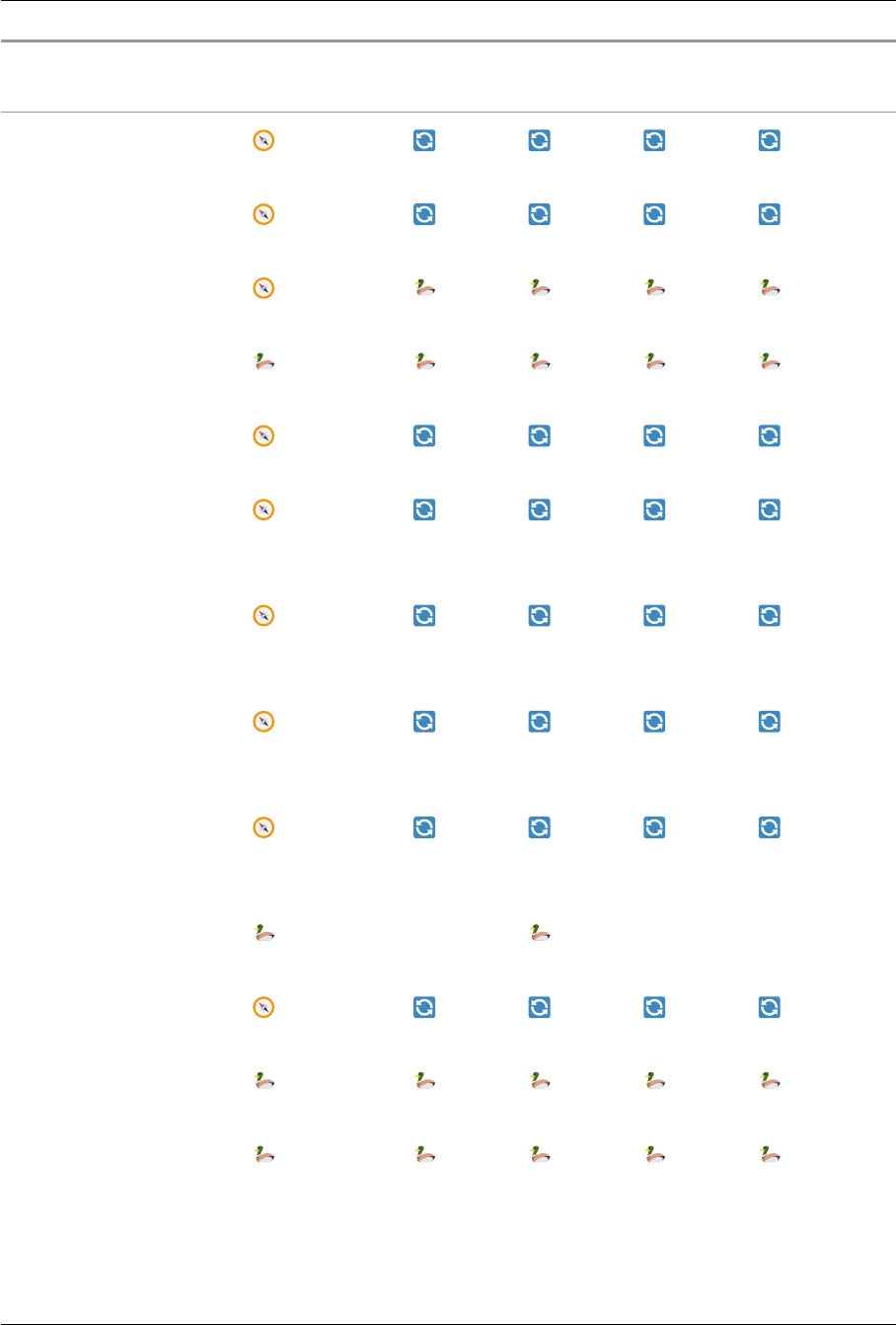
DuckDB Documentation
Scalar functions GEOMETRY
POINT_
2D
LINESTRING_
2D
POLYGON_
2D BOX_2D
GEOMETRY ST_
Boundary(GEOMETRY)
(as
POLYGON)
GEOMETRY ST_
Buffer(GEOMETRY)
(as
POLYGON)
GEOMETRY ST_
Centroid(GEOMETRY)
GEOMETRY ST_
Collect(GEOMETRY[])
GEOMETRY ST_
Normalize(GEOMETRY)
(as
POLYGON)
GEOMETRY ST_
SimplifyPreserveTopology(GEOMETRY,
DOUBLE)
(as
POLYGON)
GEOMETRY ST_
Simplify(GEOMETRY,
DOUBLE)
(as
POLYGON
)
GEOMETRY ST_
Union(GEOMETRY,
GEOMETRY)
(as
POLYGON)
GEOMETRY ST_
Intersection(GEOMETRY,
GEOMETRY)
(as
POLYGON)
GEOMETRY ST_
MakeLine(GEOMETRY[])
GEOMETRY ST_
Envelope(GEOMETRY)
(as
POLYGON)
GEOMETRY ST_
FlipCoordinates(GEOMETRY)
GEOMETRY ST_
Transform(GEOMETRY,
VARCHAR, VARCHAR)
746
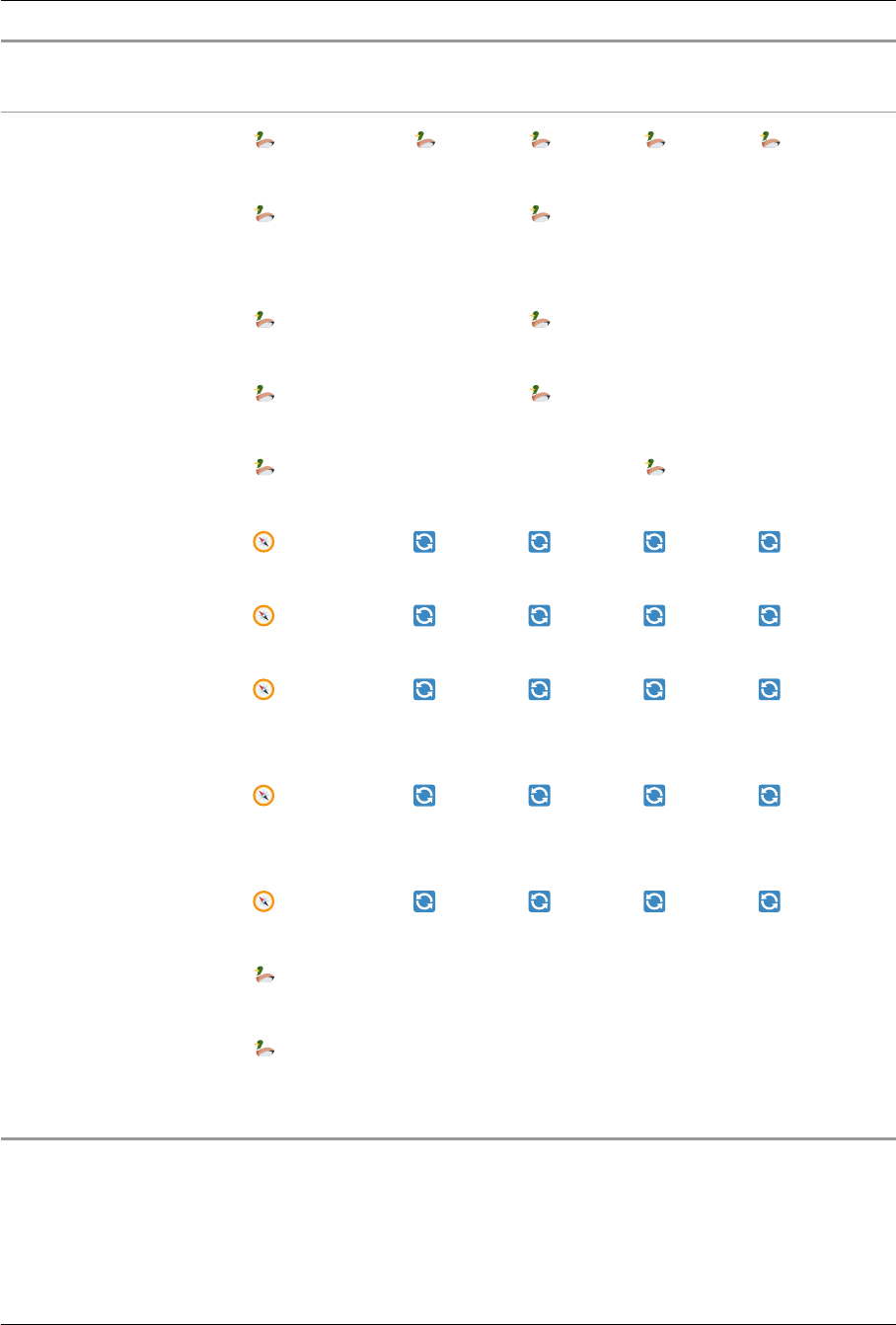
DuckDB Documentation
Scalar functions GEOMETRY
POINT_
2D
LINESTRING_
2D
POLYGON_
2D BOX_2D
BOX_2D ST_
Extent(GEOMETRY)
GEOMETRY ST_
PointN(GEOMETRY,
INTEGER)
GEOMETRY ST_
StartPoint(GEOMETRY)
GEOMETRY ST_
EndPoint(GEOMETRY)
GEOMETRY ST_
ExteriorRing(GEOMETRY)
GEOMETRY ST_
Reverse(GEOMETRY)
GEOMETRY ST_
RemoveRepeatedPoints(GEOMETRY)
(as
POLYGON
)
GEOMETRY ST_
RemoveRepeatedPoints(GEOMETRY,
DOUBLE)
(as
POLYGON )
GEOMETRY ST_
ReducePrecision(GEOMETRY,
DOUBLE)
(as
POLYGON )
GEOMETRY ST_
PointOnSurface(GEOMETRY)
(as
POLYGON)
GEOMETRY ST_
CollectionExtract(GEOMETRY)
GEOMETRY ST_
CollectionExtract(GEOMETRY,
INTEGER)
Spatial Properties Calculate and access spatial properties of geometries.
747
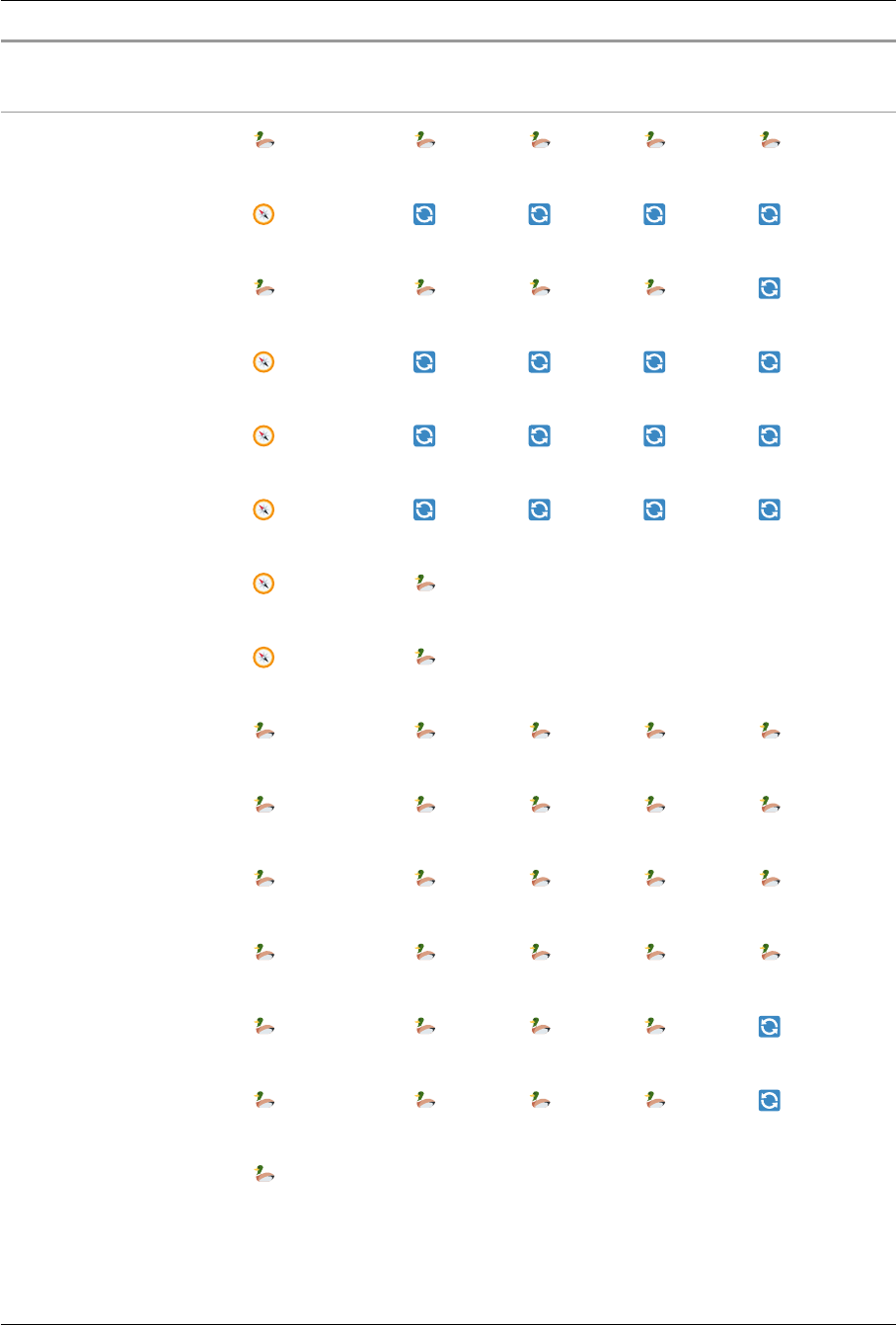
DuckDB Documentation
Scalar functions GEOMETRY
POINT_
2D
LINESTRING_
2D
POLYGON_
2D BOX_2D
DOUBLE ST_
Area(GEOMETRY)
BOOLEAN ST_
IsClosed(GEOMETRY)
(as
POLYGON)
BOOLEAN ST_
IsEmpty(GEOMETRY)
(as
POLYGON)
BOOLEAN ST_
IsRing(GEOMETRY)
(as
POLYGON)
BOOLEAN ST_
IsSimple(GEOMETRY)
(as
POLYGON)
BOOLEAN ST_
IsValid(GEOMETRY)
(as
POLYGON)
DOUBLE ST_
X(GEOMETRY)
DOUBLE ST_
Y(GEOMETRY)
DOUBLE ST_
XMax(GEOMETRY)
DOUBLE ST_
YMax(GEOMETRY)
DOUBLE ST_
XMin(GEOMETRY)
DOUBLE ST_
YMin(GEOMETRY)
GeometryType ST_
GeometryType(GEOMETRY)
(as
POLYGON)
DOUBLE ST_
Length(GEOMETRY)
(as
POLYGON)
INTEGER ST_
NGeometries(GEOMETRY)
748
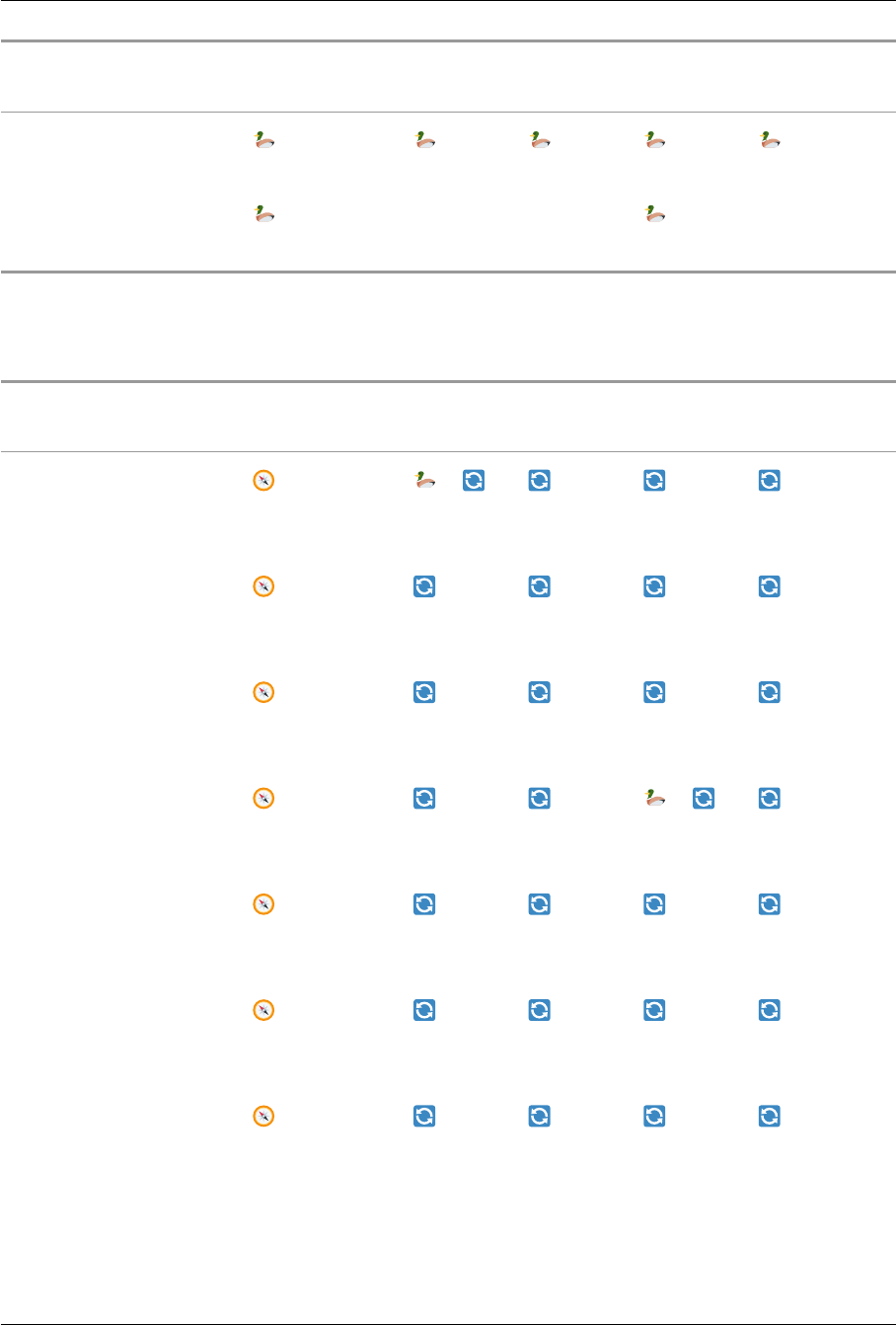
DuckDB Documentation
Scalar functions GEOMETRY
POINT_
2D
LINESTRING_
2D
POLYGON_
2D BOX_2D
INTEGER ST_
NPoints(GEOMETRY)
INTEGER ST_
NInteriorRings(GEOMETRY)
Spatial Relationships Compute relationships and spatial predicates between geometries.
Scalar functions GEOMETRY
POINT_
2D
LINESTRING_
2D
POLYGON_
2D BOX_2D
BOOLEAN ST_
Within(GEOMETRY,
GEOMETRY)
or (as
POLYGON)
BOOLEAN ST_
Touches(GEOMETRY,
GEOMETRY)
(as
POLYGON)
BOOLEAN ST_
Overlaps(GEOMETRY,
GEOMETRY)
(as
POLYGON)
BOOLEAN ST_
Contains(GEOMETRY,
GEOMETRY)
or (as
POLYGON)
BOOLEAN ST_
CoveredBy(GEOMETRY,
GEOMETRY)
(as
POLYGON)
BOOLEAN ST_
Covers(GEOMETRY,
GEOMETRY)
(as
POLYGON)
BOOLEAN ST_
Crosses(GEOMETRY,
GEOMETRY)
(as
POLYGON)
749

DuckDB Documentation
Scalar functions GEOMETRY
POINT_
2D
LINESTRING_
2D
POLYGON_
2D BOX_2D
BOOLEAN ST_
Difference(GEOMETRY,
GEOMETRY)
(as
POLYGON)
BOOLEAN ST_
Disjoint(GEOMETRY,
GEOMETRY)
(as
POLYGON)
BOOLEAN ST_
Intersects(GEOMETRY,
GEOMETRY)
BOOLEAN ST_
Equals(GEOMETRY,
GEOMETRY)
(as
POLYGON)
DOUBLE ST_
Distance(GEOMETRY,
GEOMETRY)
or or (as
POLYGON)
BOOLEAN ST_
DWithin(GEOMETRY,
GEOMETRY, DOUBLE)
(as
POLYGON)
BOOLEAN ST_
Intersects_
Extent(GEOMETRY,
GEOMETRY)
Spatial Aggregate Functions
Aggregate functions Implemented with
GEOMETRY ST_Envelope_Agg(GEOMETRY)
GEOMETRY ST_Union_Agg(GEOMETRY)
GEOMETRY ST_Intersection_Agg(GEOMETRY)
750

DuckDB Documentation
Spatial Table Functions
ST_Read() ‑ Read spatial data from files The spatial extension provides a ST_Read table func‑
tion based on the GDAL translator library to read spatial data from a variety of geospatial vector file
formats as if they were DuckDB tables. For example to create a new table from a GeoJSON file, you
can use the following query:
CREATE TABLE <table> AS SELECT * FROM ST_
Read('some/file/path/filename.json');
ST_Read can take a number of optional arguments, the full signature is:
ST_Read(VARCHAR, sequential_layer_scan : BOOLEAN, spatial_filter : WKB_BLOB,
open_options : VARCHAR[], layer : VARCHAR, allowed_drivers : VARCHAR[],
sibling_files : VARCHAR[], spatial_filter_box : BOX_2D, keep_wkb :
BOOLEAN)
• sequential_layer_scan (default: false): If set to true, the table function will scan
through all layers sequentially and return the first layer that matches the given layer name.
This is required for some drivers to work properly, e.g., the OSM driver.
• spatial_filter (default: NULL): If set to a WKB blob, the table function will only return
rows that intersect with the given WKB geometry. Some drivers may support eicient spatial
filtering natively, in which case it will be pushed down. Otherwise the filtering is done by GDAL
which may be much slower.
• open_options (default: []): A list of key‑value pairs that are passed to the GDAL driver to
control the opening of the file. E.g., the GeoJSON driver supports a FLATTEN_NESTED_
ATTRIBUTES=YES option to flatten nested attributes.
• layer (default: NULL): The name of the layer to read from the file. If NULL, the first layer is
returned. Can also be a layer index (starting at 0).
• allowed_drivers (default: []): A list of GDAL driver names that are allowed to be used to
open the file. If empty, all drivers are allowed.
• sibling_files (default: []): A list of sibling files that are required to open the file. E.g., the
ESRI Shapefile driver requires a .shx file to be present. Although most of the time these
can be discovered automatically.
• spatial_filter_box(default: NULL): If set to a BOX_2D, the table function will only return
rows that intersect with the given bounding box. Similar to spatial_filter.
• keep_wkb (default: false): If set, the table function will return geometries in a wkb_
geometry column with the type WKB_BLOB (which can be cast to BLOB) instead of GEOME-
TRY. This is useful if you want to use DuckDB with more exotic geometry subtypes that DuckDB
spatial doesnt support representing in the GEOMETRY type yet.
Note that GDAL is single‑threaded, so this table function will not be able to make full use of parallelism.
751

DuckDB Documentation
We're planning to implement support for the most common vector formats natively in this extension
with additional table functions in the future.
We currently support over 50 dierent formats. You can generate the following table of supported
GDAL drivers yourself by executing SELECT * FROM ST_Drivers().
short_name long_name
can_
create
can_
copy
can_
open help_url
ESRI Shapefile ESRI Shapefile true false true https://gdal.org/drivers
/vector/shapefile.html
MapInfo File MapInfo File true false true https://gdal.org/drivers
/vector/mitab.html
UK .NTF UK .NTF false false true https://gdal.org/drivers
/vector/ntf.html
LVBAG Kadaster LV BAG Extract
2.0
false false true https://gdal.org/drivers
/vector/lvbag.html
S57 IHO S‑57 (ENC) true false true https://gdal.org/drivers
/vector/s57.html
DGN Microstation DGN true false true https://gdal.org/drivers
/vector/dgn.html
OGR_VRT VRT ‑ Virtual
Datasource
false false true https://gdal.org/drivers
/vector/vrt.html
Memory Memory true false true
CSV Comma Separated
Value (.csv)
true false true https://gdal.org/drivers
/vector/csv.html
GML Geography Markup
Language (GML)
true false true https://gdal.org/drivers
/vector/gml.html
GPX GPX true false true https://gdal.org/drivers
/vector/gpx.html
KML Keyhole Markup
Language (KML)
true false true https://gdal.org/drivers
/vector/kml.html
GeoJSON GeoJSON true false true https://gdal.org/drivers
/vector/geojson.html
752

DuckDB Documentation
short_name long_name
can_
create
can_
copy
can_
open help_url
GeoJSONSeq GeoJSON Sequence true false true https:
//gdal.org/drivers/vec
tor/geojsonseq.html
ESRIJSON ESRIJSON false false true https://gdal.org/drivers
/vector/esrijson.html
TopoJSON TopoJSON false false true https://gdal.org/drivers
/vector/topojson.html
OGR_GMT GMT ASCII Vectors
(.gmt)
true false true https://gdal.org/drivers
/vector/gmt.html
GPKG GeoPackage true true true https://gdal.org/drivers
/vector/gpkg.html
SQLite SQLite / Spatialite true false true https://gdal.org/drivers
/vector/sqlite.html
WAsP WAsP .map format true false true https://gdal.org/drivers
/vector/wasp.html
OpenFileGDB ESRI FileGDB true false true https:
//gdal.org/drivers/vec
tor/openfilegdb.html
DXF AutoCAD DXF true false true https://gdal.org/drivers
/vector/dxf.html
CAD AutoCAD Driver false false true https://gdal.org/drivers
/vector/cad.html
FlatGeobuf FlatGeobuf true false true https:
//gdal.org/drivers/vec
tor/flatgeobuf.html
Geoconcept Geoconcept true false true
GeoRSS GeoRSS true false true https://gdal.org/drivers
/vector/georss.html
VFK Czech Cadastral
Exchange Data Format
false false true https://gdal.org/drivers
/vector/vfk.html
753

DuckDB Documentation
short_name long_name
can_
create
can_
copy
can_
open help_url
PGDUMP PostgreSQL SQL dump true false false https://gdal.org/drivers
/vector/pgdump.html
OSM OpenStreetMap XML
and PBF
false false true https://gdal.org/drivers
/vector/osm.html
GPSBabel GPSBabel true false true https://gdal.org/drivers
/vector/gpsbabel.html
WFS OGC WFS (Web Feature
Service)
false false true https://gdal.org/drivers
/vector/wfs.html
OAPIF OGC API ‑ Features false false true https://gdal.org/drivers
/vector/oapif.html
EDIGEO French EDIGEO
exchange format
false false true https://gdal.org/drivers
/vector/edigeo.html
SVG Scalable Vector
Graphics
false false true https://gdal.org/drivers
/vector/svg.html
ODS Open Document/
LibreOice /
OpenOice
Spreadsheet
true false true https://gdal.org/drivers
/vector/ods.html
XLSX MS Oice Open XML
spreadsheet
true false true https://gdal.org/drivers
/vector/xlsx.html
Elasticsearch Elastic Search true false true https:
//gdal.org/drivers/vec
tor/elasticsearch.html
Carto Carto true false true https://gdal.org/drivers
/vector/carto.html
AmigoCloud AmigoCloud true false true https:
//gdal.org/drivers/vec
tor/amigocloud.html
SXF Storage and eXchange
Format
false false true https://gdal.org/drivers
/vector/sxf.html
754

DuckDB Documentation
short_name long_name
can_
create
can_
copy
can_
open help_url
Selafin Selafin true false true https://gdal.org/drivers
/vector/selafin.html
JML OpenJUMP JML true false true https://gdal.org/drivers
/vector/jml.html
PLSCENES Planet Labs Scenes API false false true https://gdal.org/drivers
/vector/plscenes.html
CSW OGC CSW (Catalog
Service for the Web)
false false true https://gdal.org/drivers
/vector/csw.html
VDV VDV‑451/VDV‑
452/INTREST Data
Format
true false true https://gdal.org/drivers
/vector/vdv.html
MVT Mapbox Vector Tiles true false true https://gdal.org/drivers
/vector/mvt.html
NGW NextGIS Web true true true https://gdal.org/drivers
/vector/ngw.html
MapML MapML true false true https://gdal.org/drivers
/vector/mapml.html
TIGER U.S. Census TIGER/Line false false true https://gdal.org/drivers
/vector/tiger.html
AVCBin Arc/Info Binary
Coverage
false false true https://gdal.org/drivers
/vector/avcbin.html
AVCE00 Arc/Info E00 (ASCII)
Coverage
false false true https://gdal.org/drivers
/vector/avce00.html
Note that far from all of these drivers have been tested properly, and some may require additional
options to be passed to work as expected. If you run into any issues please first consult the GDAL
docs.
ST_ReadOsm() ‑ Read compressed OSM data The spatial extension also provides an experimental
ST_ReadOsm() table function to read compressed OSM data directly from a .osm.pbf file.
This will use multithreading and zero‑copy protobuf parsing which makes it a lot faster than using
755

DuckDB Documentation
the st_read() OSM driver, but it only outputs the raw OSM data (Nodes, Ways, Relations), without
constructing any geometries. For node entities you can trivially construct POINT geometries, but it is
also possible to construct LINESTRING AND POLYGON by manually joining refs and nodes together
in SQL.
Example usage:
SELECT *
FROM st_readosm('tmp/data/germany.osm.pbf')
WHERE tags['highway'] != []
LIMIT 5;
┌──────────────────────┬────────┬──────────────────────┬─────────┬────────────────────┬────────────┬───────────┬────────────────────────┐
│ kind │ id │ tags │ refs │ lat
│ lon │ ref_roles │ ref_types │
│ enum('node', 'way'… │ int64 │ map(varchar, varch… │ int64[] │
double │ double │ varchar[] │ enum('node', 'way', … │
├──────────────────────┼────────┼──────────────────────┼─────────┼────────────────────┼────────────┼───────────┼────────────────────────┤
│ node │ 122351 │ {bicycle=yes, butt… │ │
53.5492951 │ 9.977553 │ │ │
│ node │ 122397 │ {crossing=no, high… │ │
53.520990100000006 │ 10.0156924 │ │ │
│ node │ 122493 │ {TMC:cid_58:tabcd_… │ │
53.129614600000004 │ 8.1970173 │ │ │
│ node │ 123566 │ {highway=traffic_s… │ │
54.617268200000005 │ 8.9718171 │ │ │
│ node │ 125801 │ {TMC:cid_58:tabcd_… │ │
53.070685000000005 │ 8.7819939 │ │ │
└──────────────────────┴────────┴──────────────────────┴─────────┴────────────────────┴────────────┴───────────┴────────────────────────┘
Spatial replacement scans
The spatial extension also provides ”replacement scans” for common geospatial file formats, allowing
you to query files of these formats as if they were tables.
SELECT * FROM './path/to/some/shapefile/dataset.shp';
In practice this is just syntax‑sugar for calling ST_Read, so there is no dierence in performance. If
you want to pass additional options, you should use the ST_Read table function directly.
The following formats are currently recognized by their file extension:
• ESRI ShapeFile, .shp
• GeoPackage, .gpkg
756

DuckDB Documentation
• FlatGeoBuf, .fgb
Similarly there is a .osm.pbf replacement scan for ST_ReadOsm.
Spatial Copy Functions
Much like the ST_Read table function the spatial extension provides a GDAL based COPY function
to export duckdb tables to dierent geospatial vector formats. For example to export a table to a
GeoJSON file, with generated bounding boxes, you can use the following query:
COPY <table> TO 'some/file/path/filename.geojson'
WITH (FORMAT GDAL, DRIVER 'GeoJSON', LAYER_CREATION_OPTIONS 'WRITE_
BBOX=YES');
Available options:
• FORMAT: is the only required option and must be set to GDAL to use the GDAL based copy func‑
tion.
• DRIVER: is the GDAL driver to use for the export. See the table above for a list of available
drivers.
• LAYER_CREATION_OPTIONS: list of options to pass to the GDAL driver. See the GDAL docs
for the driver you are using for a list of available options.
• SRS: Set a spatial reference system as metadata to use for the export. This can be a WKT
string, an EPSG code or a proj‑string, basically anything you would normally be able to pass to
GDAL/OGR. This will not perform any reprojection of the input geometry though, it just sets the
metadata if the target driver supports it.
GitHub Repository
GitHub
SQLite Scanner Extension
The sqlite extension allows DuckDB to directly read data from a SQLite database file. The data can
be queried directly from the underlying SQLite tables, or read into DuckDB tables.
757

DuckDB Documentation
Usage
To make a SQLite file accessible to DuckDB, use the ATTACH statement, which supports read & write,
or the older sqlite_attach function
For example with the bundled sakila.db file:
ATTACH 'sakila.db' (TYPE sqlite);
-- or
CALL sqlite_attach('sakila.db');
The tables in the file are registered as views in DuckDB, you can list them as follows:
PRAGMA show_tables;
┌────────────────────────┐
│
name
│
├────────────────────────┤
│ actor │
│ address │
│ category │
│ city │
│ country │
│ customer │
│ customer_list │
│ film │
│ film_actor │
│ film_category │
│ film_list │
│ film_text │
│ inventory │
│ language │
│ payment │
│ rental │
│ sales_by_film_category │
│ sales_by_store │
│ staff │
│ staff_list │
│ store │
└────────────────────────┘
Then you can query those views normally using SQL, e.g., using the example queries from sakila‑
examples.sql
SELECT
cat.name category_name,
758

DuckDB Documentation
sum(ifnull(pay.amount, 0)) revenue
FROM category cat
LEFT JOIN film_category flm_cat
ON cat.category_id = flm_cat.category_id
LEFT JOIN film fil
ON flm_cat.film_id = fil.film_id
LEFT JOIN inventory inv
ON fil.film_id = inv.film_id
LEFT JOIN rental ren
ON inv.inventory_id = ren.inventory_id
LEFT JOIN payment pay
ON ren.rental_id = pay.rental_id
GROUP BY cat.name
ORDER BY revenue DESC
LIMIT 5;
Querying Individual Tables
Instead of attaching, you can also query individual tables using the sqlite_scan function.
SELECT * FROM sqlite_scan('sakila.db', 'film');
Data Types
SQLite is a weakly typed database system. As such, when storing data in a SQLite table, types are not
enforced. The following is valid SQL in SQLite:
CREATE TABLE numbers(i INTEGER);
INSERT INTO numbers VALUES ('hello');
DuckDB is a strongly typed database system, as such, it requires all columns to have defined types
and the system rigorously checks data for correctness.
When querying SQLite, DuckDB must deduce a specific column type mapping. DuckDB follows
SQLite's type ainity rules with a few extensions.
1. If the declared type contains the string ”INT” then it is translated into the type BIGINT
2. If the declared type of the column contains any of the strings ”CHAR”, ”CLOB”, or ”TEXT” then it
is translated into VARCHAR.
3. If the declared type for a column contains the string ”BLOB” or if no type is specified then it is
translated into BLOB.
759

DuckDB Documentation
4. If the declared type for a column contains any of the strings ”REAL”, ”FLOA”, ”DOUB”, ”DEC” or
”NUM” then it is translated into DOUBLE.
5. If the declared type is ”DATE”, then it is translated into DATE.
6. If the declared type contains the string ”TIME”, then it is translated into TIMESTAMP.
7. If none of the above apply, then it is translated into VARCHAR.
As DuckDB enforces the corresponding columns to contain only correctly typed values, we cannot
load the string ”hello” into a column of type BIGINT. As such, an error is thrown when reading from
the ”numbers” table above:
Error: Mismatch Type Error: Invalid type in column "i": column was declared
as integer, found "hello" of type "text" instead.
This error can be avoided by setting the sqlite_all_varchar option:
SET GLOBAL sqlite_all_varchar=true;
When set, this option overrides the type conversion rules described above, and instead always con‑
verts the SQLite columns into a VARCHARcolumn. Note that this setting must be set before sqlite_
attach is called.
Running More Than Once
If you want to run the sqlite_scan procedure more than once in the same DuckDB session, you'll
need to pass in the overwrite flag, as shown below:
CALL sqlite_attach('sakila.db', overwrite=true);
Loading the Extension
The SQLite Scanner extension is by default installed and loaded on first use. If you prefer to do so
explicitly, run the following commands:
INSTALL sqlite;
LOAD sqlite;
GitHub Repository
GitHub
760

DuckDB Documentation
Substrait Extension
The main goal of the substrait extension is to support both production and consumption of Sub‑
strait query plans in DuckDB.
This extension is mainly exposed via 3 dierent APIs ‑ the SQL API, the Python API, and the R API. Here
we depict how to consume and produce Substrait query plans in each API.
Note. The Substrait integration is currently experimental. Support is currently only available
on request. If you have not asked for permission to ask for support, contact us prior to opening
an issue. If you open an issue without doing so, we will close it without further review.
Installing and Loading
The Substrait extension is an autoloadable extensions, meaning that it will be loaded at runtime when‑
ever one of the substrait functions is called. To explicitly install and load the released version of the
Substrait extension, you can also use the following SQL commands.
INSTALL substrait;
LOAD substrait;
SQL
In the SQL API, users can generate Substrait plans (into a BLOB or a JSON) and consume Substrait
plans.
BLOB Generation To generate a Substrait BLOB the get_substrait(sql) function must be
called with a valid SQL select query.
CREATE TABLE crossfit (exercise text, difficulty_level int);
INSERT INTO crossfit VALUES ('Push Ups', 3), ('Pull Ups', 5) , ('Push Jerk',
7), ('Bar Muscle Up', 10);
.mode line
CALL get_substrait('SELECT count(exercise) AS exercise FROM crossfit WHERE
difficulty_level <= 5');
761

DuckDB Documentation
Plan BLOB =
\x12\x09\x1A\x07\x10\x01\x1A\x03lte\x12\x11\x1A\x0F\x10\x02\x1A\x0Bis_
not_
null\x12\x09\x1A\x07\x10\x03\x1A\x03and\x12\x0B\x1A\x09\x10\x04\x1A\x05count\x1A\xC8\x01\x12\xC5\x01\x0A\xB8\x01:\xB5\x01\x12\xA8\x01\x22\xA5\x01\x12\x94\x01\x0A\x91\x01\x12/\x0A\x08exercise\x0A\x10difficulty_
level\x12\x11\x0A\x07\xB2\x01\x04\x08\x0D\x18\x01\x0A\x04*\x02\x10\x01\x18\x02\x1AJ\x1AH\x08\x03\x1A\x04\x0A\x02\x10\x01\x22\x22\x1A
\x1A\x1E\x08\x01\x1A\x04*\x02\x10\x01\x22\x0C\x1A\x0A\x12\x08\x0A\x04\x12\x02\x08\x01\x22\x00\x22\x06\x1A\x04\x0A\x02(\x05\x22\x1A\x1A\x18\x1A\x16\x08\x02\x1A\x04*\x02\x10\x01\x22\x0C\x1A\x0A\x12\x08\x0A\x04\x12\x02\x08\x01\x22\x00\x22\x06\x0A\x02\x0A\x00\x10\x01:\x0A\x0A\x08crossfit\x1A\x00\x22\x0A\x0A\x08\x08\x04*\x04:\x02\x10\x01\x1A\x08\x12\x06\x0A\x02\x12\x00\x22\x00\x12\x08exercise2\x0A\x10\x18*\x06DuckDB
JSON Generation To generate a JSON representing the Substrait plan the get_substrait_
json(sql) function must be called with a valid SQL select query.
CALL get_substrait_json('SELECT count(exercise) AS exercise FROM crossfit
WHERE difficulty_level <= 5');
Json = {"exten-
sions":[{"extensionFunction":{"functionAnchor":1,"name":"lte"}},{"extensionFunction":{"functionAnchor":2,"name":"is_
not_
null"}},{"extensionFunction":{"functionAnchor":3,"name":"and"}},{"extensionFunction":{"functionAnchor":4,"name":"count"}}],"relations":[{"root":{"input":{"project":{"input":{"aggregate":{"input":{"read":{"baseSchema":{"names":["exercise","difficulty_
level"],"struct":{"types":[{"varchar":{"length":13,"nullability":"NULLABILITY_
NULLABLE"}},{"i32":{"nullability":"NULLABILITY_
NULLABLE"}}],"nullability":"NULLABILITY_
REQUIRED"}},"filter":{"scalarFunction":{"functionReference":3,"outputType":{"bool":{"nullability":"NULLABILITY_
NULLABLE"}},"arguments":[{"value":{"scalarFunction":{"functionReference":1,"outputType":{"i32":{"nullability":"NULLABILITY_
NULLABLE"}},"arguments":[{"value":{"selection":{"directReference":{"structField":{"field":1}},"rootReference":{}}}},{"value":{"literal":{"i32":5}}}]}}},{"value":{"scalarFunction":{"functionReference":2,"outputType":{"i32":{"nullability":"NULLABILITY_
NULLABLE"}},"arguments":[{"value":{"selection":{"directReference":{"structField":{"field":1}},"rootReference":{}}}}]}}}]}},"projection":{"select":{"structItems":[{}]},"maintainSingularStruct":true},"namedTable":{"names":["crossfit"]}}},"groupings":[{}],"measures":[{"measure":{"functionReference":4,"outputType":{"i64":{"nullability":"NULLABILITY_
NULLABLE"}}}}]}},"expressions":[{"selection":{"directReference":{"structField":{}},"rootReference":{}}}]}},"names":["exercise"]}}],"version":{"minorNumber":24,"producer":"DuckDB"}}
BLOB Consumption To consume a Substrait BLOB the from_substrait(blob) function must
be called with a valid Substrait BLOB plan.
CALL from_
substrait('\x12\x09\x1A\x07\x10\x01\x1A\x03lte\x12\x11\x1A\x0F\x10\x02\x1A\x0Bis_
not_
null\x12\x09\x1A\x07\x10\x03\x1A\x03and\x12\x0B\x1A\x09\x10\x04\x1A\x05count\x1A\xC8\x01\x12\xC5\x01\x0A\xB8\x01:\xB5\x01\x12\xA8\x01\x22\xA5\x01\x12\x94\x01\x0A\x91\x01\x12/\x0A\x08exercise\x0A\x10difficulty_
level\x12\x11\x0A\x07\xB2\x01\x04\x08\x0D\x18\x01\x0A\x04*\x02\x10\x01\x18\x02\x1AJ\x1AH\x08\x03\x1A\x04\x0A\x02\x10\x01\x22\x22\x1A
\x1A\x1E\x08\x01\x1A\x04*\x02\x10\x01\x22\x0C\x1A\x0A\x12\x08\x0A\x04\x12\x02\x08\x01\x22\x00\x22\x06\x1A\x04\x0A\x02(\x05\x22\x1A\x1A\x18\x1A\x16\x08\x02\x1A\x04*\x02\x10\x01\x22\x0C\x1A\x0A\x12\x08\x0A\x04\x12\x02\x08\x01\x22\x00\x22\x06\x0A\x02\x0A\x00\x10\x01:\x0A\x0A\x08crossfit\x1A\x00\x22\x0A\x0A\x08\x08\x04*\x04:\x02\x10\x01\x1A\x08\x12\x06\x0A\x02\x12\x00\x22\x00\x12\x08exercise2\x0A\x10\x18*\x06DuckDB'::BLOB);
exercise = 2
Python
Substrait extension is autoloadable, but if you prefer to do so explicitly, you can use the relevant
Python syntax within a connection:
762

DuckDB Documentation
import duckdb
con = duckdb.connect()
con.install_extension("substrait")
con.load_extension("substrait")
BLOB Generation To generate a Substrait BLOB the get_substrait(sql) function must be
called, from a connection, with a valid SQL select query.
con.execute(query='CREATE TABLE crossfit (exercise text, difficulty_level
int)')
con.execute(query="INSERT INTO crossfit VALUES ('Push Ups', 3), ('Pull Ups',
5) , ('Push Jerk', 7), ('Bar Muscle Up', 10)")
proto_bytes = con.get_substrait(query="SELECT count(exercise) AS exercise
FROM crossfit WHERE difficulty_level <= 5").fetchone()[0]
Json Generation To generate a JSON representing the Substrait plan the get_substrait_
json(sql) function, from a connection, must be called with a valid SQL select query.
json = con.get_substrait_json("SELECT count(exercise) AS exercise FROM
crossfit WHERE difficulty_level <= 5").fetchone()[0]
BLOB Consumption To consume a Substrait BLOB the from_substrait(blob) function must
be called, from the connection, with a valid Substrait BLOB plan.
query_result = con.from_substrait(proto=proto_bytes)
R
By default the extension will be autoloaded on first use. To explicitly install and load this extension in
R, use the following commands:
library("duckdb")
con <- dbConnect(duckdb::duckdb())
dbExecute(con, "INSTALL substrait")
dbExecute(con, "LOAD substrait")
BLOB Generation To generate a Substrait BLOB the duckdb_get_substrait(con, sql)
function must be called, with a connection and a valid SQL select query.
763

DuckDB Documentation
dbExecute(con, "CREATE TABLE crossfit (exercise text, difficulty_level
int)")
dbExecute(con, "INSERT INTO crossfit VALUES ('Push Ups', 3), ('Pull Ups', 5)
, ('Push Jerk', 7), ('Bar Muscle Up', 10)")
proto_bytes <- duckdb::duckdb_get_substrait(con, "SELECT * FROM crossfit
LIMIT 5")
JSON Generation To generate a JSON representing the Substrait plan duckdb_get_
substrait_json(con, sql) function, with a connection and a valid SQL select query.
json <- duckdb::duckdb_get_substrait_json(con, "SELECT count(exercise) AS
exercise FROM crossfit WHERE difficulty_level <= 5")
BLOB Consumption To consume a Substrait BLOB the duckdb_prepare_substrait(con,
blob) function must be called, with a connection and a valid Substrait BLOB plan.
result <- duckdb::duckdb_prepare_substrait(con, proto_bytes)
df <- dbFetch(result)
GitHub Repository
GitHub
TPC‑DS Extension
The tpcds extension implements the data generator and queries for the TPC‑DS benchmark.
Installing and Loading
The tpcds extension will be transparently autoloaded on first use from the oicial extension reposi‑
tory. If you would like to install and load it manually, run:
INSTALL tpcds;
LOAD tpcds;
764

DuckDB Documentation
Usage
To generate data for scale factor 1, use:
CALL dsdgen(sf=1);
To run a query, e.g., query 8, use:
PRAGMA tpcds(8);
┌──────────────┬────────────────────┐
│ s_store_name │ sum(ss_net_profit) │
│ varchar │ decimal(38,2) │
├──────────────┼────────────────────┤
│ able │ -10354620.18 │
│ ation │ -10576395.52 │
│ bar │ -10625236.01 │
│ ese │ -10076698.16 │
│ ought │ -10994052.78 │
└──────────────┴────────────────────┘
TPC‑H Extension
The tpch extension implements the data generator and queries for the TPC‑H benchmark.
Installing and Loading
The tpch extension is shipped by default in some DuckDB builds, otheriwse it will be transparently
autoloaded on first use. If you would like to install and load it manually, run:
INSTALL tpch;
LOAD tpch;
Usage
To generate data for scale factor 1, use:
CALL dbgen(sf=1);
To run a query, e.g., query 4, use:
PRAGMA tpch(4);
765

DuckDB Documentation
┌─────────────────┬─────────────┐
│ o_orderpriority │ order_count │
│ varchar │ int64 │
├─────────────────┼─────────────┤
│ 1-URGENT │ 21188 │
│ 2-HIGH │ 20952 │
│ 3-MEDIUM │ 20820 │
│ 4-NOT SPECIFIED │ 21112 │
│ 5-LOW │ 20974 │
└─────────────────┴─────────────┘
766
DuckDB Documentation
Guides
767
Data Import & Export
CSV Import
To read data from a CSV file, use the read_csv_auto function in the FROM clause of a query.
SELECT * FROM read_csv_auto('input.csv');
To create a new table using the result from a query, use CREATE TABLE AS from a SELECT state‑
ment.
CREATE TABLE new_tbl AS SELECT * FROM read_csv_auto('input.csv');
We can use DuckDB's optional FROM‑first syntax to omit SELECT *:
CREATE TABLE new_tbl AS FROM read_csv_auto('input.csv');
To load data into an existing table from a query, use INSERT INTO from a SELECT statement.
INSERT INTO tbl SELECT * FROM read_csv_auto('input.csv');
Alternatively, the COPYstatement can also be used to load data from a CSV file into an existing table.
COPY tbl FROM 'input.csv';
For additional options, see the CSV Import reference and the COPY statement documentation.
CSV Export
To export the data from a table to a CSV file, use the COPY statement.
COPY tbl TO 'output.csv' (HEADER, DELIMITER ',');
The result of queries can also be directly exported to a CSV file.
COPY (SELECT * FROM tbl) TO 'output.csv' (HEADER, DELIMITER ',');
For additional options, see the COPY statement documentation.
769

DuckDB Documentation
Parquet Import
To read data from a Parquet file, use the read_parquet function in the FROM clause of a query.
SELECT * FROM read_parquet('input.parquet');
To create a new table using the result from a query, use CREATE TABLE AS from a SELECT state‑
ment.
CREATE TABLE new_tbl AS SELECT * FROM read_parquet('input.parquet');
To load data into an existing table from a query, use INSERT INTO from a SELECT statement.
INSERT INTO tbl SELECT * FROM read_parquet('input.parquet');
Alternatively, the COPY statement can also be used to load data from a Parquet file into an existing
table.
COPY tbl FROM 'input.parquet' (FORMAT PARQUET);
For additional options, see the Parquet Loading reference.
Parquet Export
To export the data from a table to a Parquet file, use the COPY statement.
COPY tbl TO 'output.parquet' (FORMAT PARQUET);
The result of queries can also be directly exported to a Parquet file.
COPY (SELECT * FROM tbl) TO 'output.parquet' (FORMAT PARQUET);
The flags for setting compression, row group size, etc. are listed in the Reading and Writing Parquet
files page.
Parquet Import
To run a query directly on a Parquet file, use the read_parquet function in the FROM clause of a
query.
SELECT * FROM read_parquet('input.parquet');
The Parquet file will be processed in parallel. Filters will be automatically pushed down into the Par‑
quet scan, and only the relevant columns will be read automatically.
For more information see the blog post ”Querying Parquet with Precision using DuckDB”.
770

DuckDB Documentation
HTTP Parquet Import
To load a Parquet file over HTTP(S), the httpfs extension is required. This can be installed use the
INSTALL SQL command. This only needs to be run once.
INSTALL httpfs;
To load the httpfs extension for usage, use the LOAD SQL command:
LOAD httpfs;
Aer the httpfs extension is set up, Parquet files can be read over http(s) using the following
command:
SELECT * FROM read_parquet('https://<domain>/path/to/file.parquet');
S3, GCS, or R2 Parquet Import
To load a Parquet file from S3, the httpfs extension is required. This can be installed use the IN-
STALL SQL command. This only needs to be run once.
INSTALL httpfs;
To load the httpfs extension for usage, use the LOAD SQL command:
LOAD httpfs;
Aer loading the httpfs extension, set up the credentials and S3 region to read data. Firstly, the
region where the data resides needs to be configured:
SET s3_region='us-east-1';
With the only the region set, public S3 data can be queried. To query private S3 data, you need to
either use an access key and secret:
SET s3_access_key_id='<AWS access key id>';
SET s3_secret_access_key='<AWS secret access key>';
or a session token:
SET s3_session_token='<AWS session token>';
Aer the httpfsextension is set up and the S3 configuration is set correctly, Parquet files can be read
from S3 using the following command:
SELECT * FROM read_parquet('s3://<bucket>/<file>');
771

DuckDB Documentation
For Google Cloud Storage (GCS), the Interoperability API enables you to have access to it like an S3
connection. You need to create HMAC keys and declare them:
SET s3_endpoint='storage.googleapis.com';
SET s3_access_key_id='key_id';
SET s3_secret_access_key='access_key';
Please note you will need to use the s3:// URL to read your data.
SELECT * FROM read_parquet('s3://<gcs_bucket>/<file>');
For Cloudflare R2, the S3 Compatibility API allows you to use DuckDB's S3 support to read and write
from R2 buckets. You will need to generate an S3 auth token and update the s3_endpoint used:
SET s3_region="auto"
SET s3_endpoint='<your-account-id>.r2.cloudflarestorage.com';
SET s3_access_key_id='key_id';
SET s3_secret_access_key='access_key';
Note that you will need to use the s3:// URL to read your data from R2:
SELECT * FROM read_parquet('s3://<r2_bucket_name>/<file>');
S3 Parquet Export
To write a Parquet file to S3, the httpfsextension is required. This can be installed use the INSTALL
SQL command. This only needs to be run once.
INSTALL httpfs;
To load the httpfs extension for usage, use the LOAD SQL command:
LOAD httpfs;
Aer loading the
httpfs
extension, set up the credentials and S3 region to write data. You may either
use an access key and secret, or a token.
SET s3_region='us-east-1';
SET s3_access_key_id='<AWS access key id>';
SET s3_secret_access_key='<AWS secret access key>';
The alternative is to use a token:
SET s3_region='us-east-1';
SET s3_session_token='<AWS session token>';
772

DuckDB Documentation
Aer the httpfs extension is set up and the S3 credentials are correctly configured, Parquet files can
be written to S3 using the following command:
COPY <table_name> TO 's3://bucket/file.parquet';
Similarly, Google Cloud Storage (GCS) is supported through the Interoperability API. You need to cre‑
ate HMAC keys and declare them:
SET s3_endpoint='storage.googleapis.com';
SET s3_access_key_id='key_id';
SET s3_secret_access_key='access_key';
Please note you will need to use the s3:// URL to write your files.
COPY <table_name> TO 's3://gcs_bucket/file.parquet';
JSON Import
To read data from a JSON file, use the read_json_auto function in the FROM clause of a query.
SELECT * FROM read_json_auto('input.json');
To create a new table using the result from a query, use CREATE TABLE AS from a SELECT state‑
ment.
CREATE TABLE new_tbl AS SELECT * FROM read_json_auto('input.json');
To load data into an existing table from a query, use INSERT INTO from a SELECT statement.
INSERT INTO tbl SELECT * FROM read_json_auto('input.json');
Alternatively, the COPY statement can also be used to load data from a JSON file into an existing ta‑
ble.
COPY tbl FROM 'input.json';
For additional options, see the JSON Loading reference and the COPY statement documentation.
JSON Export
To export the data from a table to a JSON file, use the COPY statement.
COPY tbl TO 'output.json';
773

DuckDB Documentation
The result of queries can also be directly exported to a JSON file.
COPY (SELECT * FROM tbl) TO 'output.json';
For additional options, see the COPY statement documentation.
Excel Import
To read data from an Excel file, install and load the spatial extension, then use the st_read function
in the FROM clause of a query. Use the layer parameter to specify the Excel worksheet name.
INSTALL spatial; -- Only needed once per DuckDB connection
LOAD spatial; -- Only needed once per DuckDB connection
SELECT * FROM st_read('test_excel.xlsx', layer='Sheet1');
To create a new table using the result from a query, use CREATE TABLE AS from a SELECT state‑
ment.
INSTALL spatial; -- Only needed once per DuckDB connection
LOAD spatial; -- Only needed once per DuckDB connection
CREATE TABLE new_tbl AS
SELECT * FROM st_read('test_excel.xlsx', layer='Sheet1');
To load data into an existing table from a query, use INSERT INTO from a SELECT statement.
INSTALL spatial; -- Only needed once per DuckDB connection
LOAD spatial; -- Only needed once per DuckDB connection
INSERT INTO tbl
SELECT * FROM st_read('test_excel.xlsx', layer='Sheet1');
Several configuration options are also available for the underlying GDAL library that is doing the xlsx
parsing. Set those options in an environment variable prior to executing the DuckDB SQL statement.
The options include:
• OGR_XLSX_HEADERS = FORCE / DISABLE / AUTO
– Either FORCE the first row to be interpreted as headers, DISABLE to treat the first row as
a row of data, or AUTO to detect automatically.
• OGR_XLSX_FIELD_TYPES = STRING / AUTO
– Either AUTO detect the data types in the file, or force all data types to be STRING.
774

DuckDB Documentation
For additional details, see the spatial extension page, the GDAL XLSX driver page, and the GDAL con‑
figuration options page.
Excel Export
To export the data from a table to an Excel file, install and load the spatial extension, then use the
COPY statement. The file will contain one worksheet with the same name as the file, but without the
.xlsx extension.
INSTALL spatial; -- Only needed once per DuckDB connection
LOAD spatial; -- Only needed once per DuckDB connection
COPY tbl TO 'output.xlsx' WITH (FORMAT GDAL, DRIVER 'xlsx');
The result of queries can also be directly exported to an Excel file.
INSTALL spatial; -- Only needed once per DuckDB connection
LOAD spatial; -- Only needed once per DuckDB connection
COPY (SELECT * FROM tbl) TO 'output.xlsx' WITH (FORMAT GDAL, DRIVER 'xlsx');
Note: Dates and timestamps are not supported by the xlsx writer driver. Cast columns of those types
to VARCHAR prior to creating the xlsx file.
Note: The output file must not already exist.
For additional details, see the spatial extension page and the GDAL XLSX driver page.
SQLite Import
To run a query directly on a SQLite file, the sqlite extension is required. This can be installed use
the INSTALL SQL command. This only needs to be run once.
INSTALL sqlite;
To load the sqlite extension for usage, use the LOAD SQL command:
LOAD sqlite;
Aer the SQLite extension is installed, tables can be queried from SQLite using the sqlite_scan
function:
775

DuckDB Documentation
-- scan the table "tbl_name" from the SQLite file "test.db"
SELECT * FROM sqlite_scan('test.db', 'tbl_name');
Alternatively, the entire file can be attached using the sqlite_attach command. This creates
views over all of the tables in the file that allow you to query the tables using regular SQL syntax.
-- attach the SQLite file "test.db"
CALL sqlite_attach('test.db');
-- the table "tbl_name" can now be queried as if it is a regular table
SELECT * FROM tbl_name;
For more information see the SQLite scanner documentation.
PostgreSQL Import
To run a query directly on a running PostgreSQL database, the postgres extension is required. This
can be installed use the INSTALL SQL command. This only needs to be run once.
INSTALL postgres;
To load the postgres extension for usage, use the LOAD SQL command:
LOAD postgres;
Aer the postgres extension is installed, tables can be queried from PostgreSQL using the post-
gres_scan function:
-- scan the table "mytable" from the schema "public" using the empty
(default) connection string
SELECT * FROM postgres_scan('', 'public', 'mytable');
The first parameter to the postgres_scan function is the postgres connection string.
Alternatively, the entire file can be attached using the postgres_attach command. This creates
views over all of the tables in the PostgreSQL database that allow you to query the tables using regular
SQL syntax.
-- attach the Postgres database using the given connection string
CALL postgres_attach('');
-- the table "tbl_name" can now be queried as if it is a regular table
SELECT * FROM tbl_name;
For more information see the PostgreSQL scanner documentation.
776

Meta Queries
List Tables
The SHOW TABLEScommand can be used to obtain a list of all tables within the selected schema.
CREATE TABLE tbl(i INTEGER);
SHOW TABLES;
name
tbl
DESCRIBE, SHOWor SHOW ALL TABLES can be used to obtain a list of all tables within all attached
databases and schemas.
CREATE TABLE tbl(i INTEGER);
CREATE SCHEMA s1;
CREATE TABLE s1.tbl(v VARCHAR);
SHOW ALL TABLES;
database schema table_name column_names column_types temporary
memory main tbl [i] [INTEGER] false
memory s1 tbl [v] [VARCHAR] false
To view the schema of an individual table, use the DESCRIBE command.
CREATE TABLE tbl(i INTEGER PRIMARY KEY, j VARCHAR);
DESCRIBE tbl;
777

DuckDB Documentation
column_name column_type null key default extra
i INTEGER NO PRI NULL NULL
j VARCHAR YES NULL NULL NULL
The SQL‑standard information_schema views are also defined.
DuckDB also defines sqlite_master, and many PostgreSQL system catalog tables for compatibil‑
ity with SQLite and PostgreSQL respectively.
Describe
In order to view the schema of the result of a query, prepend DESCRIBE to a query.
DESCRIBE SELECT * FROM tbl;
In order to view the schema of a table, use DESCRIBE followed by the table name.
DESCRIBE tbl;
Below is an example of DESCRIBE on the lineitem table of TPC‑H.
┌─────────────────┬───────────────┬──────┬──────┬─────────┬───────┐
│ column_name │ column_type │ null │ key │ default │ extra │
├─────────────────┼───────────────┼──────┼──────┼─────────┼───────┤
│ l_orderkey │ INTEGER │ NO │ NULL │ NULL │ NULL │
│ l_partkey │ INTEGER │ NO │ NULL │ NULL │ NULL │
│ l_suppkey │ INTEGER │ NO │ NULL │ NULL │ NULL │
│ l_linenumber │ INTEGER │ NO │ NULL │ NULL │ NULL │
│ l_quantity │ INTEGER │ NO │ NULL │ NULL │ NULL │
│ l_extendedprice │ DECIMAL(15,2) │ NO │ NULL │ NULL │ NULL │
│ l_discount │ DECIMAL(15,2) │ NO │ NULL │ NULL │ NULL │
│ l_tax │ DECIMAL(15,2) │ NO │ NULL │ NULL │ NULL │
│ l_returnflag │ VARCHAR │ NO │ NULL │ NULL │ NULL │
│ l_linestatus │ VARCHAR │ NO │ NULL │ NULL │ NULL │
│ l_shipdate │ DATE │ NO │ NULL │ NULL │ NULL │
│ l_commitdate │ DATE │ NO │ NULL │ NULL │ NULL │
│ l_receiptdate │ DATE │ NO │ NULL │ NULL │ NULL │
│ l_shipinstruct │ VARCHAR │ NO │ NULL │ NULL │ NULL │
│ l_shipmode │ VARCHAR │ NO │ NULL │ NULL │ NULL │
│ l_comment │ VARCHAR │ NO │ NULL │ NULL │ NULL │
└─────────────────┴───────────────┴──────┴──────┴─────────┴───────┘
778

DuckDB Documentation
Summarize
The SUMMARIZE command can be used to easily compute a number of aggregates over a table or a
query. The SUMMARIZE command launches a query that computes a number of aggregates over all
columns, including min, max, avg, std and approx_unique.
In order to summarize the contents of a table, use SUMMARIZE followed by the table name.
SUMMARIZE tbl;
In order to summarize a query, prepend SUMMARIZE to a query.
SUMMARIZE SELECT * FROM tbl;
Below is an example of SUMMARIZE on the lineitem table of TPC‑H SF1.
┌─────────────────┬───────────────┬─────────────┬─────────────────────────────────────────────┬───────────────┬─────────────────────┬──────────────────────┬─────────┬─────────┬─────────┬─────────┬─────────────────┐
│ column_name │ column_type │ min │ max
│ approx_unique │ avg │ std │ q25 │
q50 │ q75 │ count │ null_percentage │
├─────────────────┼───────────────┼─────────────┼─────────────────────────────────────────────┼───────────────┼─────────────────────┼──────────────────────┼─────────┼─────────┼─────────┼─────────┼─────────────────┤
│ l_orderkey │ INTEGER │ 1 │ 6000000
│ 1486805 │ 3000279.604204982 │ 1732187.8734803426 │ 1497471 │
3022276 │ 4523225 │ 6001215 │ 0.0% │
│ l_partkey │ INTEGER │ 1 │ 200000
│ 196125 │ 100017.98932999402 │ 57735.69082650517 │ 50056 │
99973 │ 150007 │ 6001215 │ 0.0% │
│ l_suppkey │ INTEGER │ 1 │ 10000
│ 10010 │ 5000.602606138924 │ 2886.9619987306205 │ 2499 │
5001 │ 7498 │ 6001215 │ 0.0% │
│ l_linenumber │ INTEGER │ 1 │ 7
│ 7 │ 3.0005757167506912 │ 1.7324314036519335 │ 1 │
3 │ 4 │ 6001215 │ 0.0% │
│ l_quantity │ INTEGER │ 1 │ 50
│ 50 │ 25.507967136654827 │ 14.426262537016953 │ 12 │
25 │ 37 │ 6001215 │ 0.0% │
│ l_extendedprice │ DECIMAL(15,2) │ 901.00 │ 104949.50
│ 939196 │ 38255.138484656854 │ 23300.438710962204 │ 18747 │
36719 │ 55141 │ 6001215 │ 0.0% │
│ l_discount │ DECIMAL(15,2) │ 0.00 │ 0.10
│ 11 │ 0.04999943011540163 │ 0.031619855108125976 │ 0 │
0 │ 0 │ 6001215 │ 0.0% │
│ l_tax │ DECIMAL(15,2) │ 0.00 │ 0.08
│ 9 │ 0.04001350893110812 │ 0.02581655179884275 │ 0 │
0 │ 0 │ 6001215 │ 0.0% │
779

DuckDB Documentation
│ l_returnflag │ VARCHAR │ A │ R
│ 3
│ NULL
│ NULL
│ NULL │
NULL │ NULL │ 6001215 │ 0.0% │
│ l_linestatus │ VARCHAR │ F │ O
│ 2 │ NULL │ NULL │ NULL │
NULL │ NULL │ 6001215 │ 0.0% │
│ l_shipdate │ DATE │ 1992-01-02 │ 1998-12-01
│ 2554 │ NULL │ NULL │ NULL │
NULL │ NULL │ 6001215 │ 0.0% │
│ l_commitdate │ DATE │ 1992-01-31 │ 1998-10-31
│ 2491 │ NULL │ NULL │ NULL │
NULL │ NULL │ 6001215 │ 0.0% │
│ l_receiptdate │ DATE │ 1992-01-04 │ 1998-12-31
│ 2585 │ NULL │ NULL │ NULL │
NULL │ NULL │ 6001215 │ 0.0% │
│ l_shipinstruct │ VARCHAR │ COLLECT COD │ TAKE BACK RETURN
│ 4 │ NULL │ NULL │ NULL │
NULL │ NULL │ 6001215 │ 0.0% │
│ l_shipmode │ VARCHAR │ AIR │ TRUCK
│ 7 │ NULL │ NULL │ NULL │
NULL │ NULL │ 6001215 │ 0.0% │
│ l_comment │ VARCHAR │ Tiresias │ zzle? slyly final platelets
sleep quickly. │ 4587836 │ NULL │ NULL
│ NULL │ NULL │ NULL │ 6001215 │ 0.0% │
└─────────────────┴───────────────┴─────────────┴─────────────────────────────────────────────┴───────────────┴─────────────────────┴──────────────────────┴─────────┴─────────┴─────────┴─────────┴─────────────────┘
Explain
In order to view the query plan of a query, prepend EXPLAIN to a query.
EXPLAIN SELECT * FROM tbl;
By default only the final physical plan is shown. In order to see the unoptimized and optimized logical
plans, change the explain_output setting:
SET explain_output='all';
Below is an example of running EXPLAIN on Q1 of the TPC‑H benchmark.
┌───────────────────────────┐
│ ORDER_BY │
│ ─ ─ ─ ─ ─ ─ ─ ─ ─ ─ ─ │
│ lineitem.l_returnflag ASC │
780

DuckDB Documentation
│ lineitem.l_linestatus ASC │
└─────────────┬─────────────┘
┌─────────────┴─────────────┐
│ HASH_GROUP_BY │
│ ─ ─ ─ ─ ─ ─ ─ ─ ─ ─ ─ │
│ #0 │
│ #1 │
│ sum(#2) │
│ sum(#3) │
│ sum(#4) │
│ sum(#5) │
│ avg(#6) │
│ avg(#7) │
│ avg(#8) │
│ count_star() │
└─────────────┬─────────────┘
┌─────────────┴─────────────┐
│ PROJECTION │
│ ─ ─ ─ ─ ─ ─ ─ ─ ─ ─ ─ │
│ l_returnflag │
│ l_linestatus │
│ l_quantity │
│ l_extendedprice │
│ #4 │
│ (#4 * (1.00 + l_tax)) │
│ l_quantity │
│ l_extendedprice │
│ l_discount │
└─────────────┬─────────────┘
┌─────────────┴─────────────┐
│ PROJECTION │
│ ─ ─ ─ ─ ─ ─ ─ ─ ─ ─ ─ │
│ l_returnflag │
│ l_linestatus │
│ l_quantity │
│ l_extendedprice │
│ (l_extendedprice * (1.00 -│
│ l_discount)) │
│ l_tax │
│ l_discount │
└─────────────┬─────────────┘
┌─────────────┴─────────────┐
│ SEQ_SCAN │
781

DuckDB Documentation
│ ─ ─ ─ ─ ─ ─ ─ ─ ─ ─ ─ │
│ lineitem │
│ ─ ─ ─ ─ ─ ─ ─ ─ ─ ─ ─ │
│ l_shipdate │
│ l_returnflag │
│ l_linestatus │
│ l_quantity │
│ l_extendedprice │
│ l_discount │
│ l_tax │
│ ─ ─ ─ ─ ─ ─ ─ ─ ─ ─ ─ │
│ Filters: l_shipdate<=1998 │
│-09-02 AND l_shipdate ... │
│ NULL │
└───────────────────────────┘
Profile Queries
In order to profile a query, prepend EXPLAIN ANALYZE to a query.
EXPLAIN ANALYZE SELECT * FROM tbl;
The query plan will be pretty‑printed to the screen using timings for every operator.
Note that the cumulative wall‑clock time that is spent on every operator is shown. When multiple
threads are processing the query in parallel, the total processing time of the query may be lower than
the sum of all the times spent on the individual operators.
Below is an example of running EXPLAIN ANALYZE on Q1 of the TPC‑H benchmark.
┌─────────────────────────────────────┐
│┌───────────────────────────────────┐│
││ Total Time: 0.0496s ││
│└───────────────────────────────────┘│
└─────────────────────────────────────┘
┌───────────────────────────┐
│ EXPLAIN_ANALYZE │
│ ─ ─ ─ ─ ─ ─ ─ ─ ─ ─ ─ │
│ 0 │
│ (0.00s) │
└─────────────┬─────────────┘
┌─────────────┴─────────────┐
│ ORDER_BY │
782

DuckDB Documentation
│ ─ ─ ─ ─ ─ ─ ─ ─ ─ ─ ─ │
│ lineitem.l_returnflag ASC │
│ lineitem.l_linestatus ASC │
│ ─ ─ ─ ─ ─ ─ ─ ─ ─ ─ ─ │
│ 4 │
│ (0.00s) │
└─────────────┬─────────────┘
┌─────────────┴─────────────┐
│ HASH_GROUP_BY │
│ ─ ─ ─ ─ ─ ─ ─ ─ ─ ─ ─ │
│ #0 │
│ #1 │
│ sum(#2) │
│ sum(#3) │
│ sum(#4) │
│ sum(#5) │
│ avg(#6) │
│ avg(#7) │
│ avg(#8) │
│ count_star() │
│ ─ ─ ─ ─ ─ ─ ─ ─ ─ ─ ─ │
│ 4 │
│ (0.28s) │
└─────────────┬─────────────┘
┌─────────────┴─────────────┐
│ PROJECTION │
│ ─ ─ ─ ─ ─ ─ ─ ─ ─ ─ ─ │
│ l_returnflag │
│ l_linestatus │
│ l_quantity │
│ l_extendedprice │
│ #4 │
│ (#4 * (1.00 + l_tax)) │
│ l_quantity │
│ l_extendedprice │
│ l_discount │
│ ─ ─ ─ ─ ─ ─ ─ ─ ─ ─ ─ │
│ 5916591 │
│ (0.02s) │
└─────────────┬─────────────┘
┌─────────────┴─────────────┐
│ PROJECTION │
│ ─ ─ ─ ─ ─ ─ ─ ─ ─ ─ ─ │
783

DuckDB Documentation
│ l_returnflag │
│ l_linestatus │
│ l_quantity │
│ l_extendedprice │
│ (l_extendedprice * (1.00 -│
│ l_discount)) │
│ l_tax │
│ l_discount │
│ ─ ─ ─ ─ ─ ─ ─ ─ ─ ─ ─ │
│ 5916591 │
│ (0.02s) │
└─────────────┬─────────────┘
┌─────────────┴─────────────┐
│ SEQ_SCAN │
│ ─ ─ ─ ─ ─ ─ ─ ─ ─ ─ ─ │
│ lineitem │
│ ─ ─ ─ ─ ─ ─ ─ ─ ─ ─ ─ │
│ l_shipdate │
│ l_returnflag │
│ l_linestatus │
│ l_quantity │
│ l_extendedprice │
│ l_discount │
│ l_tax │
│ ─ ─ ─ ─ ─ ─ ─ ─ ─ ─ ─ │
│ Filters: l_shipdate<=1998 │
│-09-02 AND l_shipdate ... │
│ NULL │
│ ─ ─ ─ ─ ─ ─ ─ ─ ─ ─ ─ │
│ 5916591 │
│ (0.08s) │
└───────────────────────────┘
784

ODBC
ODBC 101: A Duck Themed Guide to ODBC
• What is ODBC?
• General Concepts
• Setting up an Application
• Sample Application
What is ODBC?
ODBC which stands for Open Database Connectivity, is a standard that allows dierent programs to
talk to dierent databases including, of course, DuckDB . This makes it easier to build programs
that work with many dierent databases, which saves time as developers don't have to write cus‑
tom code to connect to each database. Instead, they can use the standardized ODBC interface, which
reduces development time and costs, and programs are easier to maintain. However, ODBC can be
slower than other methods of connecting to a database, such as using a native driver, as it adds an
extra layer of abstraction between the application and the database. Furthermore, because DuckDB
is column‑based and ODBC is row‑based, there can be some ineiciencies when using ODBC with
DuckDB.
Note. There are links throughout this page to the oicial Microso ODBC documentation,
which is a great resource for learning more about ODBC.
General Concepts
• Handles
• Connecting
• Error Handling and Diagnostics
• Buers and Binding
785

DuckDB Documentation
Handles A handle is a pointer to a specific ODBC object which is used to interact with the database.
There are several dierent types of handles, each with a dierent purpose, these are the environment
handle, the connection handle, the statement handle, and the descriptor handle. Handles are allo‑
cated using the SQLAllocHandle which takes as input the type of handle to allocate, and a pointer
to the handle, the driver then creates a new handle of the specified type which it returns to the appli‑
cation.
Handle Types
Handle Type Description Use Case
Additional
Information
Environment SQL_
HANDLE_
ENV
Manages the
environment settings
for ODBC operations,
and provides a
global context in
which to access data.
Initializing ODBC,
managing driver
behavior, resource
allocation
Must be allocated
once per application
upon starting, and
freed at the end.
Connection SQL_
HANDLE_
DBC
Represents a
connection to a data
source. Used to
establish, manage,
and terminate
connections. Defines
both the driver and
the data source to
use within the driver.
Establishing a
connection to a
database, managing
the connection state
Multiple connection
handles can be
created as needed,
allowing
simultaneous
connections to
multiple data
sources. Note:
Allocating a
connection handle
does not establish a
connection, but must
be allocated first,
and then used once
the connection has
been established.
786

DuckDB Documentation
Handle Type Description Use Case
Additional
Information
Statement SQL_
HANDLE_
STMT
Handles the
execution of SQL
statements, as well
as the returned
result sets.
Executing SQL
queries, fetching
result sets, managing
statement options.
To facilitate the
execution of
concurrent queries,
multiple handles can
be allocated per
connection.
Descriptor SQL_
HANDLE_
DESC
Describes the
attributes of a data
structure or
parameter, and
allows the
application to
specify the structure
of data to be
bound/retrieved.
Describing table
structures, result
sets, binding
columns to
application buers
Used in situations
where data
structures need to be
explicitly defined, for
example during
parameter binding or
result set fetching.
They are
automatically
allocated when a
statement is
allocated, but can
also be allocated
explicitly.
Connecting The first step is to connect to the data source so that the application can perform
database operations. First the application must allocate an environment handle, and then a con‑
nection handle. The connection handle is then used to connect to the data source. There are two
functions which can be used to connect to a data source, SQLDriverConnect and SQLConnect.
The former is used to connect to a data source using a connection string, while the latter is used to
connect to a data source using a DSN.
Connection String A connection string is a string which contains the information needed to connect
to a data source. It is formatted as a semicolon separated list of key‑value pairs, however DuckDB
currently only utilizes the DSN and ignores the rest of the parameters.
787

DuckDB Documentation
DSN A DSN (Data Source Name) is a string that identifies a database. It can be a file path, URL, or a
database name. For example: C:\Users\me\duckdb.db and DuckDB are both valid DSNs. More
information on DSNs can be found here.
Error Handling and Diagnostics All functions in ODBC return a code which represents the success
or failure of the function. This allows for easy error handling, as the application can simply check the
return code of each function call to determine if it was successful. When unsuccessful, the application
can then use the SQLGetDiagRec function to retrieve the error information. The following table
defines the return codes:
Return Code Description
SQL_SUCCESS The function completed successfully.
SQL_SUCCESS_WITH_INFO The function completed successfully, but additional information
is available, including a warning
SQL_ERROR The function failed.
SQL_INVALID_HANDLE The handle provided was invalid, indicating a programming error,
i.e., when a handle is not allocated before it is used, or is the
wrong type
SQL_NO_DATA The function completed successfully, but no more data is available
SQL_NEED_DATA More data is needed, such as when a parameter data is sent at
execution time, or additional connection information is required.
SQL_STILL_EXECUTING A function that was asynchronously executed is still executing.
Buers and Binding A buer is a block of memory used to store data. Buers are used to store data
retrieved from the database, or to send data to the database. Buers are allocated by the application,
and then bound to a column in a result set, or a parameter in a query, using the SQLBindCol and
SQLBindParameter functions. When the application fetches a row from the result set, or executes
a query, the data is stored in the buer. When the application sends a query to the database, the data
in the buer is sent to the database.
Setting up an Application
The following is a step‑by‑step guide to setting up an application that uses ODBC to connect to a
database, execute a query, and fetch the results in C++.
788

DuckDB Documentation
Note. To install the driver as well as anything else you will need follow these instructions.
1. Include the SQL Header Files
2. Define the ODBC Handles and Connect to the Database
3. Adding a Query
4. Fetching Results
5. Go Wild
6. Free the Handles and Disconnecting
1. Include the SQL Header Files The first step is to include the SQL header files:
#include <sql.h>
#include <sqlext.h>
These files contain the definitions of the ODBC functions, as well as the data types used by ODBC. In
order to be able to use these header files you have to have the unixodbc package installed:
brew install unixodbc
# or
sudo apt-get install unixodbc-dev
# or
sudo yum install unixODBC-devel
Remember to include the header file location in your CFLAGS.
For MAKEFILE:
CFLAGS=-I/usr/local/include
# or
CFLAGS=-/opt/homebrew/Cellar/unixodbc/2.3.11/include
For CMAKE:
include_directories(/usr/local/include)
# or
include_directories(/opt/homebrew/Cellar/unixodbc/2.3.11/include)
You also have to link the library in your CMAKE or MAKEFILE: For CMAKE:
target_link_libraries(ODBC_application /path/to/duckdb_odbc/libduckdb_
odbc.dylib)
For MAKEFILE:
LDLIBS=-L/path/to/duckdb_odbc/libduckdb_odbc.dylib
789

DuckDB Documentation
2. Definethe ODBC Handles and Connect to the Database Then set up the ODBC handles, allocate
them, and connect to the database. First the environment handle is allocated, then the environment
is set to ODBC version 3, then the connection handle is allocated, and finally the connection is made
to the database. The following code snippet shows how to do this:
SQLHANDLE env;
SQLHANDLE dbc;
SQLAllocHandle(SQL_HANDLE_ENV, SQL_NULL_HANDLE, &env);
SQLSetEnvAttr(env, SQL_ATTR_ODBC_VERSION, (void*)SQL_OV_ODBC3, 0);
SQLAllocHandle(SQL_HANDLE_DBC, env, &dbc);
std::string dsn = "DSN=duckdbmemory";
SQLConnect(dbc, (SQLCHAR*)dsn.c_str(), SQL_NTS, NULL, 0, NULL, 0);
std::cout << "Connected!" << std::endl;
3. Adding a Query Now that the application is set up, we can add a query to it. First, we need to
allocate a statement handle:
SQLHANDLE stmt;
SQLAllocHandle(SQL_HANDLE_STMT, dbc, &stmt);
Then we can execute a query:
SQLExecDirect(stmt, (SQLCHAR*)"SELECT * FROM integers", SQL_NTS);
4. Fetching Results Now that we have executed a query, we can fetch the results. First, we need to
bind the columns in the result set to buers:
SQLLEN int_val;
SQLLEN null_val;
SQLBindCol(stmt, 1, SQL_C_SLONG, &int_val, 0, &null_val);
Then we can fetch the results:
SQLFetch(stmt);
5. Go Wild Now that we have the results, we can do whatever we want with them. For example, we
can print them:
790

DuckDB Documentation
std::cout << "Value: " << int_val << std::endl;
or do any other processing we want. As well as executing more queries and doing any thing else we
want to do with the database such as inserting, updating, or deleting data.
6. Free the Handles and Disconnecting Finally, we need to free the handles and disconnect from
the database. First, we need to free the statement handle:
SQLFreeHandle(SQL_HANDLE_STMT, stmt);
Then we need to disconnect from the database:
SQLDisconnect(dbc);
And finally, we need to free the connection handle and the environment handle:
SQLFreeHandle(SQL_HANDLE_DBC, dbc);
SQLFreeHandle(SQL_HANDLE_ENV, env);
Freeing the connection and environment handles can only be done aer the connection to the
database has been closed. Trying to free them before disconnecting from the database will result in
an error.
Sample Application
The following is a sample application that includes a cpp file that connects to the database, executes
a query, fetches the results, and prints them. It also disconnects from the database and frees the han‑
dles, and includes a function to check the return value of ODBC functions. It also includes a CMake-
Lists.txt file that can be used to build the application.
Sample .cpp file
#include <iostream>
#include <sql.h>
#include <sqlext.h>
void check_ret(SQLRETURN ret, std::string msg) {
if (ret != SQL_SUCCESS && ret != SQL_SUCCESS_WITH_INFO) {
std::cout << ret << ": " << msg << " failed" << std::endl;
exit(1);
}
if (ret == SQL_SUCCESS_WITH_INFO) {
791

DuckDB Documentation
std::cout << ret << ": " << msg << " succeeded with info" <<
std::endl;
}
}
int main() {
SQLHANDLE env;
SQLHANDLE dbc;
SQLRETURN ret;
ret = SQLAllocHandle(SQL_HANDLE_ENV, SQL_NULL_HANDLE, &env);
check_ret(ret, "SQLAllocHandle(env)");
ret = SQLSetEnvAttr(env, SQL_ATTR_ODBC_VERSION, (void*)SQL_OV_ODBC3, 0);
check_ret(ret, "SQLSetEnvAttr");
ret = SQLAllocHandle(SQL_HANDLE_DBC, env, &dbc);
check_ret(ret, "SQLAllocHandle(dbc)");
std::string dsn = "DSN=duckdbmemory";
ret = SQLConnect(dbc, (SQLCHAR*)dsn.c_str(), SQL_NTS, NULL, 0, NULL, 0);
check_ret(ret, "SQLConnect");
std::cout << "Connected!" << std::endl;
SQLHANDLE stmt;
ret = SQLAllocHandle(SQL_HANDLE_STMT, dbc, &stmt);
check_ret(ret, "SQLAllocHandle(stmt)");
ret = SQLExecDirect(stmt, (SQLCHAR*)"SELECT * FROM integers", SQL_NTS);
check_ret(ret, "SQLExecDirect(SELECT * FROM integers)");
SQLLEN int_val;
SQLLEN null_val;
ret = SQLBindCol(stmt, 1, SQL_C_SLONG, &int_val, 0, &null_val);
check_ret(ret, "SQLBindCol");
ret = SQLFetch(stmt);
check_ret(ret, "SQLFetch");
std::cout << "Value: " << int_val << std::endl;
ret = SQLFreeHandle(SQL_HANDLE_STMT, stmt);
792

DuckDB Documentation
check_ret(ret, "SQLFreeHandle(stmt)");
ret = SQLDisconnect(dbc);
check_ret(ret, "SQLDisconnect");
ret = SQLFreeHandle(SQL_HANDLE_DBC, dbc);
check_ret(ret, "SQLFreeHandle(dbc)");
ret = SQLFreeHandle(SQL_HANDLE_ENV, env);
check_ret(ret, "SQLFreeHandle(env)");
}
Sample CMakelists.txt file
cmake_minimum_required(VERSION 3.25)
project(ODBC_Tester_App)
set(CMAKE_CXX_STANDARD 17)
include_directories(/opt/homebrew/Cellar/unixodbc/2.3.11/include)
add_executable(ODBC_Tester_App main.cpp)
target_link_libraries(ODBC_Tester_App /duckdb_odbc/libduckdb_odbc.dylib)
793
Python
Install the Python Client
The latest release of the Python client can be installed using pip.
pip install duckdb
The pre‑release Python client can be installed using --pre.
pip install duckdb --upgrade --pre
The latest Python client can be installed from source from the tools/pythonpkg directory in the
DuckDB GitHub repository.
BUILD_PYTHON=1 GEN=ninja make
cd tools/pythonpkg
python setup.py install
Execute SQL
SQL queries can be executed using the duckdb.sql command.
import duckdb
duckdb.sql("SELECT 42").show()
By default this will create a relation object. The result can be converted to various formats using the
result conversion functions. For example, the fetchall method can be used to convert the result
to Python objects.
results = duckdb.sql("SELECT 42").fetchall()
print(results)
# [(42,)]
Several other result objects exist. For example, you can use df to convert the result to a Pandas
DataFrame.
795

DuckDB Documentation
results = duckdb.sql("SELECT 42").df()
print(results)
# 42
# 0 42
By default, a global in‑memory connection will be used. Any data stored in files will be lost aer shut‑
ting down the program. A connection to a persistent database can be created using the connect
function.
Aer connecting, SQL queries can be executed using the sql command.
con = duckdb.connect('file.db')
con.sql('CREATE TABLE integers(i INTEGER)')
con.sql('INSERT INTO integers VALUES (42)')
con.sql('SELECT * FROM integers').show()
Jupyter Notebooks
DuckDB's Python client can be used directly in Jupyter notebooks with no additional configuration
if desired. However, additional libraries can be used to simplify SQL query development. This guide
will describe how to utilize those additional libraries. See other guides in the Python section for how
to use DuckDB and Python together.
In this example, we use the JupySQL package.
This example workflow is also available as a Google Colab notebook.
Library Installation
Four additional libraries improve the DuckDB experience in Jupyter notebooks.
1. jupysql
• Convert a Jupyter code cell into a SQL cell
2. Pandas
• Clean table visualizations and compatibility with other analysis
3. matplotlib
• Plotting with Python
4. duckdb‑engine (DuckDB SQLAlchemy driver)
796

DuckDB Documentation
• Used by SQLAlchemy to connect to DuckDB (optional)
# Run these pip install commands from the command line if Jupyter Notebook
is not yet installed.
# Otherwise, see Google Collab link above for an in-notebook example
pip install duckdb
# Install Jupyter Notebook (Note: you can also install JupyterLab: pip
install jupyterlab)
pip install notebook
# Install supporting libraries
pip install jupysql
pip install pandas
pip install matplotlib
pip install duckdb-engine
Library Import and Configuration
Open a Jupyter Notebook and import the relevant libraries.
Connecting to DuckDB Natively To connect to DuckDB, run:
import duckdb
import pandas as pd
%load_ext sql
conn = duckdb.connect()
%sql conn --alias duckdb
Connecting to DuckDB via SQLAlchemy Using duckdb_engine Alternatively, you can connect
to DuckDB via SQLAlchemy using duckdb_engine. See the performance and feature dierences.
import duckdb
import pandas as pd
# No need to import duckdb_engine
# jupysql will auto-detect the driver needed based on the connection string!
# Import jupysql Jupyter extension to create SQL cells
%load_ext sql
797

DuckDB Documentation
Set configurations on jupysql to directly output data to Pandas and to simplify the output that is
printed to the notebook.
%config SqlMagic.autopandas = True
%config SqlMagic.feedback = False
%config SqlMagic.displaycon = False
Connect jupysql to DuckDB using a SQLAlchemy‑style connection string. Either connect to a new in‑
memory DuckDB, the default connection or a file backed db.
%sql duckdb:///:default:
# %sql duckdb:///:memory:
# %sql duckdb:///path/to/file.db
Note. The %sql command and duckdb.sql share the same default connection if you pro‑
vide duckdb:///:default: as the SQLAlchemy connection string.
Querying DuckDB
Single line SQL queries can be run using %sql at the start of a line. Query results will be displayed as
a Pandas DF.
%sql SELECT 'Off and flying!' AS a_duckdb_column
An entire Jupyter cell can be used as a SQL cell by placing %%sql at the start of the cell. Query results
will be displayed as a Pandas DF.
%%sql
SELECT
schema_name,
function_name
FROM duckdb_functions()
ORDER BY ALL DESC
LIMIT 5
To store the query results in a Python variable, use << as an assignment operator. This can be used
with both the %sql and %%sql Jupyter magics.
%sql res << SELECT 'Off and flying!' AS a_duckdb_column
If the %config SqlMagic.autopandas = Trueoption is set, the variableis a Pandas dataframe,
otherwise, it is a ResultSet that can be converted to Pandas with the DataFrame() function.
798

DuckDB Documentation
Querying Pandas Dataframes
DuckDB is able to find and query any dataframe stored as a variable in the Jupyter notebook.
input_df = pd.DataFrame.from_dict({"i":[1, 2, 3],
"j":["one", "two", "three"]})
The dataframe being queried can be specified just like any other table in the FROM clause.
%sql output_df << SELECT sum(i) AS total_i FROM input_df
Visualizing DuckDB Data
The most common way to plot datasets in Python is to load them using Pandas and then use mat‑
plotlib or seaborn for plotting. This approach requires loading all data into memory which is highly
ineicient. The plotting module in JupySQL runs computations in the SQL engine. This delegates
memory management to the engine and ensures that intermediate computations do not keep eating
up memory, eiciently plotting massive datasets.
Install and Load DuckDB httpfs extension DuckDB's httpfs extension allows parquet and CSV files
tobe queried remotely over http. These examples query a parquetfile thatcontains historicaltaxidata
from NYC. Using the parquet format allows DuckDB to only pull the rows and columns into memory
that are needed rather than downloading the entire file. DuckDB can be used to process local parquet
files as well, which may be desirable if querying the entire parquet file, or running multiple queries
that require large subsets of the file.
%%sql
INSTALL httpfs;
LOAD httpfs;
Boxplot& Histogram To create a boxplot, call %sqlplot boxplot, passing the name of the table
and the column to plot. In this case, the name of the table is the URL of the remotely stored parquet
file.
%sqlplot boxplot --table
https://d37ci6vzurychx.cloudfront.net/trip-data/yellow_tripdata_
2021-01.parquet --column trip_distance
799

DuckDB Documentation
Now, create a query that filters by the 90th percentile. Note the use of the --save, and --no-
execute functions. This tells JupySQL to store the query, but skips execution. It will be referenced
in the next plotting call.
%%sql --save short-trips --no-execute
SELECT *
FROM "https://d37ci6vzurychx.cloudfront.net/trip-data/yellow_tripdata_
2021-01.parquet"
WHERE trip_distance < 6.3
To create a histogram, call %sqlplot histogram and pass the name of the table, the column to
plot, and the number of bins. This uses --with short-trips so JupySQL uses the query defined
previously and therefore only plots a subset of the data.
%sqlplot histogram --table short-trips --column trip_distance --bins 10
--with short-trips
800
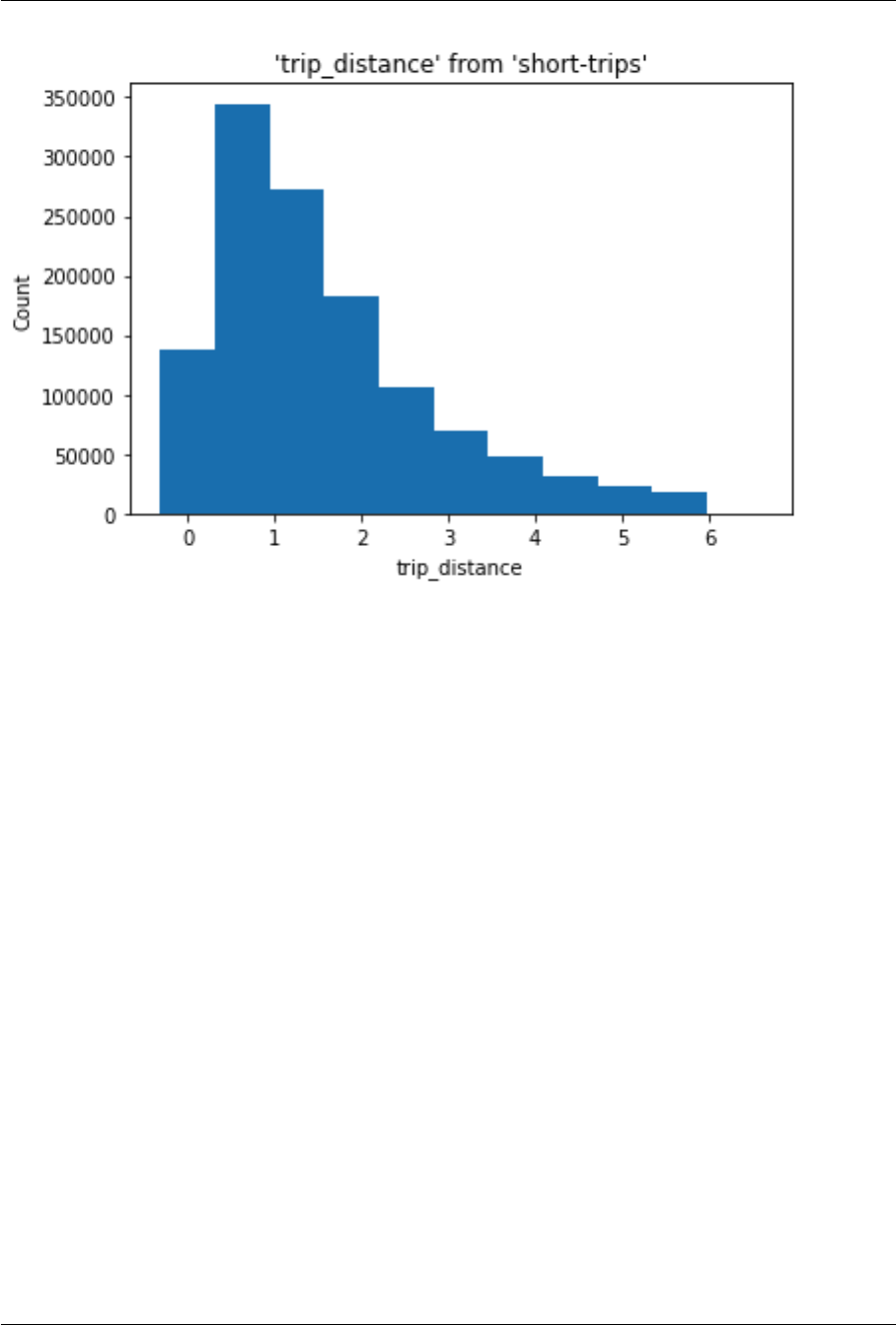
DuckDB Documentation
Summary
You now have the ability to alternate between SQL and Pandas in a simple and highly performant way!
You can plot massive datasets directly through the engine (avoiding both the download of the entire
file and loading all of it into Pandas in memory). Dataframes can be read as tables in SQL, and SQL
results can be output into Dataframes. Happy analyzing!
SQL on Pandas
Pandas DataFrames stored in local variables can be queried as if they are regular tables within
DuckDB.
import duckdb
import pandas
# Create a Pandas dataframe
my_df = pandas.DataFrame.from_dict({'a': [42]})
# query the Pandas DataFrame "my_df"
801

DuckDB Documentation
# Note: duckdb.sql connects to the default in-memory database connection
results = duckdb.sql("SELECT * FROM my_df").df()
Import from Pandas
CREATE TABLE AS and INSERT INTO can be used to create a table from any query. We can
then create tables or insert into existing tables by referring to referring to the Pandas DataFrame in
the query.
import duckdb
import pandas
# Create a Pandas dataframe
my_df = pandas.DataFrame.from_dict({'a': [42]})
# create the table "my_table" from the DataFrame "my_df"
# Note: duckdb.sql connects to the default in-memory database connection
duckdb.sql("CREATE TABLE my_table AS SELECT * FROM my_df")
# insert into the table "my_table" from the DataFrame "my_df"
duckdb.sql("INSERT INTO my_table SELECT * FROM my_df")
Export to Pandas
The result of a query can be converted to a Pandas DataFrame using the df() function.
import duckdb
# read the result of an arbitrary SQL query to a Pandas DataFrame
results = duckdb.sql("SELECT 42").df()
SQL on Apache Arrow
DuckDB can query multiple dierent types of Apache Arrow objects.
Apache Arrow Tables
Arrow Tables stored in local variables can be queried as if they are regular tables within DuckDB.
802

DuckDB Documentation
import duckdb
import pyarrow as pa
# connect to an in-memory database
con = duckdb.connect()
my_arrow_table = pa.Table.from_pydict({'i': [1, 2, 3, 4],
'j': ["one", "two", "three", "four"]})
# query the Apache Arrow Table "my_arrow_table" and return as an Arrow Table
results = con.execute("SELECT * FROM my_arrow_table WHERE i = 2").arrow()
Apache Arrow Datasets
Arrow Datasets stored as variables can also be queried as if they were regular tables. Datasets are
useful to point towards directories of Parquet files to analyze large datasets. DuckDB will push column
selections and row filters down into the dataset scan operation so that only the necessary data is
pulled into memory.
import duckdb
import pyarrow as pa
import tempfile
import pathlib
import pyarrow.parquet as pq
import pyarrow.dataset as ds
# connect to an in-memory database
con = duckdb.connect()
my_arrow_table = pa.Table.from_pydict({'i': [1, 2, 3, 4],
'j': ["one", "two", "three", "four"]})
# create example parquet files and save in a folder
base_path = pathlib.Path(tempfile.gettempdir())
(base_path / "parquet_folder").mkdir(exist_ok=True)
pq.write_to_dataset(my_arrow_table, str(base_path / "parquet_folder"))
# link to parquet files using an Arrow Dataset
my_arrow_dataset = ds.dataset(str(base_path / 'parquet_folder/'))
# query the Apache Arrow Dataset "my_arrow_dataset" and return as an Arrow
Table
803

DuckDB Documentation
results = con.execute("SELECT * FROM my_arrow_dataset WHERE i = 2").arrow()
Apache Arrow Scanners
Arrow Scanners stored as variables can also be queried as if they were regular tables. Scanners read
over a dataset and select specific columns or apply row‑wise filtering. This is similar to how DuckDB
pushes column selections and filters down into an Arrow Dataset, but using Arrow compute opera‑
tions instead. Arrow can use asynchronous IO to quickly access files.
import duckdb
import pyarrow as pa
import tempfile
import pathlib
import pyarrow.parquet as pq
import pyarrow.dataset as ds
import pyarrow.compute as pc
# connect to an in-memory database
con = duckdb.connect()
my_arrow_table = pa.Table.from_pydict({'i': [1, 2, 3, 4],
'j': ["one", "two", "three", "four"]})
# create example parquet files and save in a folder
base_path = pathlib.Path(tempfile.gettempdir())
(base_path / "parquet_folder").mkdir(exist_ok=True)
pq.write_to_dataset(my_arrow_table, str(base_path / "parquet_folder"))
# link to parquet files using an Arrow Dataset
my_arrow_dataset = ds.dataset(str(base_path / 'parquet_folder/'))
# define the filter to be applied while scanning
# equivalent to "WHERE i = 2"
scanner_filter = (pc.field("i") == pc.scalar(2))
arrow_scanner = ds.Scanner.from_dataset(my_arrow_dataset, filter=scanner_
filter)
# query the Apache Arrow scanner "arrow_scanner" and return as an Arrow Table
results = con.execute("SELECT * FROM arrow_scanner").arrow()
804

DuckDB Documentation
Apache Arrow RecordBatchReaders
Arrow RecordBatchReaders are a reader for Arrow's streaming binary format and can also be queried
directly as if they were tables. This streaming format is useful when sending Arrow data for tasks like
interprocess communication or communicating between language runtimes.
import duckdb
import pyarrow as pa
# connect to an in-memory database
con = duckdb.connect()
my_recordbatch = pa.RecordBatch.from_pydict({'i': [1, 2, 3, 4],
'j': ["one", "two", "three",
"four"]})
my_recordbatchreader = pa.ipc.RecordBatchReader.from_batches(my_
recordbatch.schema, [my_recordbatch])
# query the Apache Arrow RecordBatchReader "my_recordbatchreader" and return
as an Arrow Table
results = con.execute("SELECT * FROM my_recordbatchreader WHERE i =
2").arrow()
Import from Apache Arrow
CREATE TABLE AS and INSERT INTO can be used to create a table from any query. We can
then create tables or insert into existing tables by referring to referring to the Apache Arrow object in
the query. This example imports from an Arrow Table, but DuckDB can query dierent Apache Arrow
formats as seen in the SQL on Arrow guide.
import duckdb
import pyarrow as pa
# connect to an in-memory database
my_arrow = pa.Table.from_pydict({'a': [42]})
# create the table "my_table" from the DataFrame "my_arrow"
duckdb.sql("CREATE TABLE my_table AS SELECT * FROM my_arrow")
# insert into the table "my_table" from the DataFrame "my_arrow"
duckdb.sql("INSERT INTO my_table SELECT * FROM my_arrow")
805

DuckDB Documentation
Export to Apache Arrow
All results of a query can be exported to an Apache Arrow Table using the arrow function. Alterna‑
tively, results can be returned as a RecordBatchReader using the fetch_record_batch function
and results can be read one batch at a time. In addition, relations built using DuckDB's Relational API
can also be exported.
Export to an Arrow Table
import duckdb
import pyarrow as pa
my_arrow_table = pa.Table.from_pydict({'i': [1, 2, 3, 4],
'j': ["one", "two", "three", "four"]})
# query the Apache Arrow Table "my_arrow_table" and return as an Arrow Table
results = duckdb.sql("SELECT * FROM my_arrow_table").arrow()
Export as a RecordBatchReader
import duckdb
import pyarrow as pa
my_arrow_table = pa.Table.from_pydict({'i': [1, 2, 3, 4],
'j': ["one", "two", "three", "four"]})
# query the Apache Arrow Table "my_arrow_table" and return as an Arrow
RecordBatchReader
chunk_size = 1_000_000
results = duckdb.sql("SELECT * FROM my_arrow_table").fetch_record_
batch(chunk_size)
# Loop through the results. A StopIteration exception is thrown when the
RecordBatchReader is empty
while True:
try:
# Process a single chunk here (just printing as an example)
print(results.read_next_batch().to_pandas())
except StopIteration:
print('Already fetched all batches')
break
806

DuckDB Documentation
Export from Relational API
Arrow objects can also be exported from the Relational API. A relation can be converted to an Arrow
table using the arrow or to_arrow_table functions, or a record batch using record_batch.
A result can be exported to an Arrow table with arrow or the alias fetch_arrow_table, or to a
RecordBatchReader using fetch_arrow_reader.
import duckdb
# connect to an in-memory database
con = duckdb.connect()
con.execute('CREATE TABLE integers (i integer)')
con.execute('INSERT INTO integers VALUES (0), (1), (2), (3), (4), (5), (6),
(7), (8), (9), (NULL)')
# Create a relation from the table and export the entire relation as Arrow
rel = con.table("integers")
relation_as_arrow = rel.arrow() # or .to_arrow_table()
# Or, calculate a result using that relation and export that result to Arrow
res = rel.aggregate("sum(i)").execute()
result_as_arrow = res.arrow() # or fetch_arrow_table()
Relational API and Pandas
DuckDB oers a relational API that can be used to chain together query operations. These are
lazily evaluated so that DuckDB can optimize their execution. These operators can act on Pandas
DataFrames, DuckDB tables or views (which can point to any underlying storage format that DuckDB
can read, such as CSV or parquet files, etc.). Here we show a simple example of reading from a Pandas
DataFrame and returning a DataFrame.
import duckdb
import pandas
# connect to an in-memory database
con = duckdb.connect()
input_df = pandas.DataFrame.from_dict({'i': [1, 2, 3, 4],
'j': ["one", "two", "three", "four"]})
807

DuckDB Documentation
# create a DuckDB relation from a dataframe
rel = con.from_df(input_df)
# chain together relational operators (this is a lazy operation, so the
operations are not yet executed)
# equivalent to: SELECT i, j, i*2 AS two_i FROM input_df ORDER BY i DESC
LIMIT 2
transformed_rel = rel.filter('i >= 2').project('i, j, i*2 as two_
i').order('i desc').limit(2)
# trigger execution by requesting .df() of the relation
# .df() could have been added to the end of the chain above - it was
separated for clarity
output_df = transformed_rel.df()
Relational operators can also be used to group rows, aggregate, find distinct combinations of values,
join, union, and more. They are also able to directly insert results into a DuckDB table or write to a
CSV.
Please see these additional examples and the available relational methods on the DuckDBPyRelation
class.
Multiple Python Threads
This page demonstrates how to simultaneously insert into and read from a DuckDB database across
multiple Python threads. This couldbe useful in scenarios where new datais flowing in and an analysis
should be periodically re‑run. Note that this is all within a single Python process (see the FAQ for
details on DuckDB concurrency). Feel free to follow along in this Google Colab notebook.
Setup
First, import duckdb and several modules from the Python standardlibrary. Note: if using Pandas, add
import pandasat the top of the script as well (as it must be imported prior to the multi‑threading).
Then connect to a file‑backed DuckDB database and create an example table to store inserted data.
This table will track the name of the thread that completed the insert and automatically insert the
timestamp when that insert occurred using the DEFAULT expression.
import duckdb
from threading import Thread, current_thread
import random
808

DuckDB Documentation
duckdb_con = duckdb.connect('my_peristent_db.duckdb')
# duckdb_con = duckdb.connect() # Pass in no parameters for an in memory
database
duckdb_con.execute("""
CREATE OR REPLACE TABLE my_inserts (
thread_name varchar,
insert_time timestamp DEFAULT current_timestamp
)
""")
Reader and Writer Functions
Next, define functions to be executed by the writer and reader threads. Each thread must use the
.cursor() method to create a thread‑local connection to the same DuckDB file based on the origi‑
nal connection. This approach also works with in‑memory DuckDB databases.
def write_from_thread(duckdb_con):
# Create a DuckDB connection specifically for this thread
local_con = duckdb_con.cursor()
# Insert a row with the name of the thread. insert_time is
auto-generated.
thread_name = str(current_thread().name)
result = local_con.execute("""
INSERT INTO my_inserts (thread_name)
VALUES (?)
""", (thread_name,)).fetchall()
def read_from_thread(duckdb_con):
# Create a DuckDB connection specifically for this thread
local_con = duckdb_con.cursor()
# Query the current row count
thread_name = str(current_thread().name)
results
= local_con.execute("""
SELECT
? AS thread_name,
count(*) AS row_counter,
current_timestamp
FROM my_inserts
""", (thread_name,)).fetchall()
print(results)
809

DuckDB Documentation
Create Threads
We define how many writers and readers to use, and define a list to track all of the Threads that will
be created. Then, create first writer and then reader Threads. Next, shule them so that they will be
kicked o in a random order to simulate simultaneous writers and readers. Note that the Threads
have not yet been executed, only defined.
write_thread_count = 50
read_thread_count = 5
threads = []
# Create multiple writer and reader threads (in the same process)
# Pass in the same connection as an argument
for i in range(write_thread_count):
threads.append(Thread(target=write_from_thread,
args=(duckdb_con,),
name='write_thread_'+str(i)))
for j in range(read_thread_count):
threads.append(Thread(target=read_from_thread,
args=(duckdb_con,),
name
='read_thread_'+str(j)))
# Shuffle the threads to simulate a mix of readers and writers
random.seed(6) # Set the seed to ensure consistent results when testing
random.shuffle(threads)
Run Threads and Show Results
Now, kick o all threads to run in parallel, then wait for all of them to finish before printing out the
results. Note that the timestamps of readers and writers are interspersed as expected due to the ran‑
domization.
# Kick off all threads in parallel
for thread in threads:
thread.start()
# Ensure all threads complete before printing final results
for thread in threads:
thread.join()
print(duckdb_con.execute("""
810

DuckDB Documentation
SELECT
*
FROM my_inserts
ORDER BY
insert_time
""").df())
DuckDB with Ibis
Ibis is a Python dataframe library that supports 15+ backends, with DuckDB as the default. Ibis with
DuckDB provides a Pythonic interface for SQL with great performance.
Installation
You can pip install Ibis with the DuckDB backend:
pip install 'ibis-framework[duckdb]'
or use conda:
conda install ibis-framework
or use mamba:
mamba install ibis-framework
Create a Database File
Ibis can work with several file types, but at its core, it connects to existing databases and interacts
with the data there. You can get started with your own DuckDB databases or create a new one with
example data.
import ibis
con = ibis.connect("duckdb://penguins.ddb")
con.create_table(
"penguins", ibis.examples.penguins.fetch().to_pyarrow(), overwrite=True
)
# Output:
DatabaseTable: penguins
species string
811

DuckDB Documentation
island string
bill_length_mm float64
bill_depth_mm float64
flipper_length_mm int64
body_mass_g int64
sex string
year int64
You can now see the example dataset copied over to the database:
# reconnect to the persisted database (dropping temp tables)
con = ibis.connect("duckdb://penguins.ddb")
con.list_tables()
# Output:
['penguins']
There's one table, called penguins. We can ask Ibis to give us an object that we can interact with.
penguins = con.table("penguins")
penguins
# Output:
DatabaseTable: penguins
species string
island string
bill_length_mm float64
bill_depth_mm float64
flipper_length_mm int64
body_mass_g int64
sex string
year int64
Ibis is lazily evaluated, so instead of seeing the data, we see the schema of the table. To peek at
the data, we can call head and then to_pandas to get the first few rows of the table as a pandas
DataFrame.
penguins.head().to_pandas()
species island bill_length_mm bill_depth_mm flipper_length_mm
body_mass_g sex year
0 Adelie Torgersen 39.1 18.7 181.0
3750.0 male 2007
1 Adelie Torgersen 39.5 17.4 186.0
3800.0 female 2007
812

DuckDB Documentation
2 Adelie Torgersen 40.3 18.0 195.0
3250.0 female 2007
3 Adelie Torgersen NaN NaN NaN
NaN None 2007
4 Adelie Torgersen 36.7 19.3 193.0
3450.0 female 2007
to_pandas takes the existing lazy table expression and evaluates it. If we leave it o, you'll see the
Ibis representation of the table expression that to_pandas will evaluate (when you're ready!).
penguins.head()
# Output:
r0 := DatabaseTable: penguins
species string
island string
bill_length_mm float64
bill_depth_mm float64
flipper_length_mm int64
body_mass_g int64
sex string
year int64
Limit[r0, n=5]
Ibis returns results as a pandas DataFrame using to_pandas, but isn't using pandas to perform any
of the computation. The query is executed by DuckDB. Only when to_pandas is called does Ibis
then pull back the results and convert them into a DataFrame.
Interactive Mode
For the rest of this intro, we'll turn on interactive mode, which partially executesqueries to give users a
preview of the results. There is a small dierence in the way the output is formatted, but otherwise this
is the same as calling to_pandas on the table expression with a limit of 10 result rows returned.
ibis.options.interactive = True
penguins.head()
┏━━━━━━━━━┳━━━━━━━━━━━┳━━━━━━━━━━━━━━━━┳━━━━━━━━━━━━━━━┳━━━━━━━━━━━━━━━━━━━┳━━━━━━━━━━━━━┳━━━━━━━━┳━━━━━━━┓
┃ species ┃ island ┃ bill_length_mm ┃ bill_depth_mm ┃ flipper_length_mm ┃
body_mass_g ┃ sex ┃ year ┃
┡━━━━━━━━━╇━━━━━━━━━━━╇━━━━━━━━━━━━━━━━╇━━━━━━━━━━━━━━━╇━━━━━━━━━━━━━━━━━━━╇━━━━━━━━━━━━━╇━━━━━━━━╇━━━━━━━┩
│ string │ string │ float64 │ float64 │ int64 │
int64 │ string │ int64 │
813

DuckDB Documentation
├─────────┼───────────┼────────────────┼───────────────┼───────────────────┼─────────────┼────────┼───────┤
│ Adelie │ Torgersen │ 39.1 │ 18.7 │ 181 │
3750 │ male │ 2007 │
│ Adelie │ Torgersen │ 39.5 │ 17.4 │ 186 │
3800 │ female │ 2007 │
│ Adelie │ Torgersen │ 40.3 │ 18.0 │ 195 │
3250 │ female │ 2007 │
│ Adelie │ Torgersen │ nan │ nan │ NULL │
NULL │ NULL │ 2007 │
│ Adelie │ Torgersen │ 36.7 │ 19.3 │ 193 │
3450 │ female │ 2007 │
└─────────┴───────────┴────────────────┴───────────────┴───────────────────┴─────────────┴────────┴───────┘
Common Operations
Ibis has a collection of useful table methods to manipulate and query the data in a table.
filter filter allows you to select rows based on a condition or set of conditions.
We can filter so we only have penguins of the species Adelie:
penguins.filter(penguins.species == "Gentoo")
┏━━━━━━━━━┳━━━━━━━━┳━━━━━━━━━━━━━━━━┳━━━━━━━━━━━━━━━┳━━━━━━━━━━━━━━━━━━━┳━━━━━━━━━━━━━┳━━━━━━━━┳━━━━━━━┓
┃ species ┃ island ┃ bill_length_mm ┃ bill_depth_mm ┃ flipper_length_mm ┃
body_mass_g ┃ sex ┃ year ┃
┡━━━━━━━━━╇━━━━━━━━╇━━━━━━━━━━━━━━━━╇━━━━━━━━━━━━━━━╇━━━━━━━━━━━━━━━━━━━╇━━━━━━━━━━━━━╇━━━━━━━━╇━━━━━━━┩
│ string │ string │ float64 │ float64 │ int64 │
int64 │ string │ int64 │
├─────────┼────────┼────────────────┼───────────────┼───────────────────┼─────────────┼────────┼───────┤
│ Gentoo │ Biscoe │ 46.1 │ 13.2 │ 211 │
4500 │ female │ 2007 │
│ Gentoo │ Biscoe │ 50.0 │ 16.3 │ 230 │
5700 │ male │ 2007 │
│ Gentoo │ Biscoe │ 48.7 │ 14.1 │ 210 │
4450 │ female │ 2007 │
│ Gentoo │ Biscoe │ 50.0 │ 15.2 │ 218 │
5700 │ male │ 2007 │
│ Gentoo │ Biscoe │ 47.6 │ 14.5 │ 215 │
5400 │ male │ 2007 │
│ Gentoo │ Biscoe │ 46.5 │ 13.5 │ 210 │
4550 │ female │ 2007 │
814

DuckDB Documentation
│ Gentoo │ Biscoe │ 45.4 │ 14.6 │ 211 │
4800 │ female │ 2007 │
│ Gentoo │ Biscoe │ 46.7 │ 15.3 │ 219 │
5200 │ male │ 2007 │
│ Gentoo │ Biscoe │ 43.3 │ 13.4 │ 209 │
4400 │ female │ 2007 │
│ Gentoo │ Biscoe │ 46.8 │ 15.4 │ 215 │
5150 │ male │ 2007 │
│ … │ … │ … │ … │ … │
… │ … │ … │
└─────────┴────────┴────────────────┴───────────────┴───────────────────┴─────────────┴────────┴───────┘
Or filter for Adelie penguins that reside on the island of Torgersen:
penguins.filter((penguins.species == "Gentoo") & (penguins.body_mass_g >
6000))
┏━━━━━━━━━┳━━━━━━━━┳━━━━━━━━━━━━━━━━┳━━━━━━━━━━━━━━━┳━━━━━━━━━━━━━━━━━━━┳━━━━━━━━━━━━━┳━━━━━━━━┳━━━━━━━┓
┃ species ┃ island ┃ bill_length_mm ┃ bill_depth_mm ┃ flipper_length_mm ┃
body_mass_g ┃ sex ┃ year ┃
┡━━━━━━━━━╇━━━━━━━━╇━━━━━━━━━━━━━━━━╇━━━━━━━━━━━━━━━╇━━━━━━━━━━━━━━━━━━━╇━━━━━━━━━━━━━╇━━━━━━━━╇━━━━━━━┩
│ string │ string │ float64 │ float64 │ int64 │
int64 │ string │ int64 │
├─────────┼────────┼────────────────┼───────────────┼───────────────────┼─────────────┼────────┼───────┤
│ Gentoo │ Biscoe │ 49.2 │ 15.2 │ 221 │
6300 │ male │ 2007 │
│ Gentoo │ Biscoe │ 59.6 │ 17.0 │ 230 │
6050 │ male │ 2007 │
└─────────┴────────┴────────────────┴───────────────┴───────────────────┴─────────────┴────────┴───────┘
You can use any boolean comparison in a filter (although if you try to do something like use < on a
string, Ibis will yell at you).
select Your data analysis might not require all the columns present in a given table. select lets
you pick out only those columns that you want to work with.
To select a column you can use the name of the column as a string:
penguins.select("species", "island", "year").limit(3)
┏━━━━━━━━━┳━━━━━━━━━━━┳━━━━━━━┓
┃ species ┃ island ┃ year ┃
┡━━━━━━━━━╇━━━━━━━━━━━╇━━━━━━━┩
│ string │ string │ int64 │
815

DuckDB Documentation
├─────────┼───────────┼───────┤
│ Adelie │ Torgersen │ 2007 │
│ Adelie │ Torgersen │ 2007 │
│ Adelie │ Torgersen │ 2007 │
│ … │ … │ … │
└─────────┴───────────┴───────┘
Or you can use column objects directly (this can be convenient when paired with tab‑completion):
penguins.select(penguins.species, penguins.island, penguins.year).limit(3)
┏━━━━━━━━━┳━━━━━━━━━━━┳━━━━━━━┓
┃ species ┃ island ┃ year ┃
┡━━━━━━━━━╇━━━━━━━━━━━╇━━━━━━━┩
│ string │ string │ int64 │
├─────────┼───────────┼───────┤
│ Adelie │ Torgersen │ 2007 │
│ Adelie │ Torgersen │ 2007 │
│ Adelie │ Torgersen │ 2007 │
│ … │ … │ … │
└─────────┴───────────┴───────┘
Or you can mix‑and‑match:
penguins.select("species", "island", penguins.year).limit(3)
┏━━━━━━━━━┳━━━━━━━━━━━┳━━━━━━━┓
┃ species ┃ island ┃ year ┃
┡━━━━━━━━━╇━━━━━━━━━━━╇━━━━━━━┩
│ string │ string │ int64 │
├─────────┼───────────┼───────┤
│ Adelie │ Torgersen │ 2007 │
│ Adelie │ Torgersen │ 2007 │
│ Adelie │ Torgersen │ 2007 │
│ … │ … │ … │
└─────────┴───────────┴───────┘
mutate mutate lets you add new columns to your table, derived from the values of existing
columns.
penguins.mutate(bill_length_cm=penguins.bill_length_mm / 10)
┏━━━━━━━━━┳━━━━━━━━━━━┳━━━━━━━━━━━━━━━━┳━━━━━━━━━━━━━━━┳━━━━━━━━━━━━━━━━━━━┳━━━━━━━━━━━━━┳━━━━━━━━┳━━━━━━━┳━━━━━━━━━━━━━━━━┓
┃ species ┃ island ┃ bill_length_mm ┃ bill_depth_mm ┃ flipper_length_mm ┃
body_mass_g ┃ sex ┃ year ┃ bill_length_cm ┃
816

DuckDB Documentation
┡━━━━━━━━━╇━━━━━━━━━━━╇━━━━━━━━━━━━━━━━╇━━━━━━━━━━━━━━━╇━━━━━━━━━━━━━━━━━━━╇━━━━━━━━━━━━━╇━━━━━━━━╇━━━━━━━╇━━━━━━━━━━━━━━━━┩
│ string │ string │ float64 │ float64 │ int64 │
int64 │ string │ int64 │ float64 │
├─────────┼───────────┼────────────────┼───────────────┼───────────────────┼─────────────┼────────┼───────┼────────────────┤
│ Adelie │ Torgersen │ 39.1 │ 18.7 │ 181 │
3750 │ male │ 2007 │ 3.91 │
│ Adelie │ Torgersen │ 39.5 │ 17.4 │ 186 │
3800 │ female │ 2007 │ 3.95 │
│ Adelie │ Torgersen │ 40.3 │ 18.0 │ 195 │
3250 │ female │ 2007 │ 4.03 │
│ Adelie │ Torgersen │ nan │ nan │ NULL │
NULL │ NULL │ 2007 │ nan │
│ Adelie │ Torgersen │ 36.7 │ 19.3 │ 193 │
3450 │ female │ 2007 │ 3.67 │
│ Adelie │ Torgersen │ 39.3 │ 20.6 │ 190 │
3650 │ male │ 2007 │ 3.93 │
│ Adelie │ Torgersen │ 38.9 │ 17.8 │ 181 │
3625 │ female │ 2007 │ 3.89 │
│ Adelie │ Torgersen │ 39.2 │ 19.6 │ 195 │
4675 │ male │ 2007 │ 3.92 │
│ Adelie │ Torgersen │ 34.1 │ 18.1 │ 193 │
3475 │ NULL │ 2007 │ 3.41 │
│ Adelie │ Torgersen │ 42.0 │ 20.2 │ 190 │
4250 │ NULL │ 2007 │ 4.20 │
│ … │ … │ … │ … │ … │
… │ … │ … │ … │
└─────────┴───────────┴────────────────┴───────────────┴───────────────────┴─────────────┴────────┴───────┴────────────────┘
Notice that the table is a little too wide to display all the columns now (depending on your screen‑
size). bill_lengthis now present in millimeters and centimeters. Use a select to trim down the
number of columns we're looking at.
penguins.mutate(bill_length_cm=penguins.bill_length_mm / 10).select(
"species",
"island",
"bill_depth_mm",
"flipper_length_mm",
"body_mass_g",
"sex",
"year",
"bill_length_cm",
)
┏━━━━━━━━━┳━━━━━━━━━━━┳━━━━━━━━━━━━━━━┳━━━━━━━━━━━━━━━━━━━┳━━━━━━━━━━━━━┳━━━━━━━━┳━━━━━━━┳━━━━━━━━━━━━━━━━┓
817

DuckDB Documentation
┃ species ┃ island ┃ bill_depth_mm ┃ flipper_length_mm ┃ body_mass_g ┃
sex ┃ year ┃ bill_length_cm ┃
┡━━━━━━━━━╇━━━━━━━━━━━╇━━━━━━━━━━━━━━━╇━━━━━━━━━━━━━━━━━━━╇━━━━━━━━━━━━━╇━━━━━━━━╇━━━━━━━╇━━━━━━━━━━━━━━━━┩
│ string │ string │ float64 │ int64 │ int64 │
string │ int64 │ float64 │
├─────────┼───────────┼───────────────┼───────────────────┼─────────────┼────────┼───────┼────────────────┤
│ Adelie │ Torgersen │ 18.7 │ 181 │ 3750 │ male
│ 2007 │ 3.91 │
│ Adelie │ Torgersen │ 17.4 │ 186 │ 3800 │
female │ 2007 │ 3.95 │
│ Adelie │ Torgersen │ 18.0 │ 195 │ 3250 │
female │ 2007 │ 4.03 │
│ Adelie │ Torgersen │ nan │ NULL │ NULL │ NULL
│ 2007 │ nan │
│ Adelie │ Torgersen │ 19.3 │ 193 │ 3450 │
female │ 2007 │ 3.67 │
│ Adelie │ Torgersen │ 20.6 │ 190 │ 3650 │ male
│ 2007 │ 3.93 │
│ Adelie │ Torgersen │ 17.8 │ 181 │ 3625 │
female │ 2007 │ 3.89 │
│ Adelie │ Torgersen │ 19.6 │ 195 │ 4675 │ male
│ 2007 │ 3.92 │
│ Adelie │ Torgersen │ 18.1 │ 193 │ 3475 │ NULL
│ 2007 │ 3.41 │
│ Adelie │ Torgersen │ 20.2 │ 190 │ 4250 │ NULL
│ 2007 │ 4.20 │
│ … │ … │ … │ … │ … │ …
│ … │ … │
└─────────┴───────────┴───────────────┴───────────────────┴─────────────┴────────┴───────┴────────────────┘
selectors Typing out all of the column names except one is a little annoying. Instead of doing that
again, we can use a selector to quickly select or deselect groups of columns.
import ibis.selectors as s
penguins.mutate(bill_length_cm=penguins.bill_length_mm / 10).select(
~s.matches("bill_length_mm")
# match every column except `bill_length_mm`
)
┏━━━━━━━━━┳━━━━━━━━━━━┳━━━━━━━━━━━━━━━┳━━━━━━━━━━━━━━━━━━━┳━━━━━━━━━━━━━┳━━━━━━━━┳━━━━━━━┳━━━━━━━━━━━━━━━━┓
┃ species ┃ island ┃ bill_depth_mm ┃ flipper_length_mm ┃ body_mass_g ┃
sex ┃ year ┃ bill_length_cm ┃
818

DuckDB Documentation
┡━━━━━━━━━╇━━━━━━━━━━━╇━━━━━━━━━━━━━━━╇━━━━━━━━━━━━━━━━━━━╇━━━━━━━━━━━━━╇━━━━━━━━╇━━━━━━━╇━━━━━━━━━━━━━━━━┩
│ string │ string │ float64 │ int64 │ int64 │
string │ int64 │ float64 │
├─────────┼───────────┼───────────────┼───────────────────┼─────────────┼────────┼───────┼────────────────┤
│ Adelie │ Torgersen │ 18.7 │ 181 │ 3750 │ male
│ 2007 │ 3.91 │
│ Adelie │ Torgersen │ 17.4 │ 186 │ 3800 │
female │ 2007 │ 3.95 │
│ Adelie │ Torgersen │ 18.0 │ 195 │ 3250 │
female │ 2007 │ 4.03 │
│ Adelie │ Torgersen │ nan │ NULL │ NULL │ NULL
│ 2007 │ nan │
│ Adelie │ Torgersen │ 19.3 │ 193 │ 3450 │
female │ 2007 │ 3.67 │
│ Adelie │ Torgersen │ 20.6 │ 190 │ 3650 │ male
│ 2007 │ 3.93 │
│ Adelie │ Torgersen │ 17.8 │ 181 │ 3625 │
female │ 2007 │ 3.89 │
│ Adelie │ Torgersen │ 19.6 │ 195 │ 4675 │ male
│ 2007 │ 3.92 │
│ Adelie │ Torgersen │ 18.1 │ 193 │ 3475 │ NULL
│ 2007 │ 3.41 │
│ Adelie │ Torgersen │ 20.2 │ 190 │ 4250 │ NULL
│ 2007 │ 4.20 │
│ … │ … │ … │ … │ … │ …
│ … │ … │
└─────────┴───────────┴───────────────┴───────────────────┴─────────────┴────────┴───────┴────────────────┘
You can also use a selector alongside a column name.
penguins.select("island", s.numeric())
┏━━━━━━━━━━━┳━━━━━━━━━━━━━━━━┳━━━━━━━━━━━━━━━┳━━━━━━━━━━━━━━━━━━━┳━━━━━━━━━━━━━┳━━━━━━━┓
┃ island ┃ bill_length_mm ┃ bill_depth_mm ┃ flipper_length_mm ┃ body_
mass_g ┃ year ┃
┡━━━━━━━━━━━╇━━━━━━━━━━━━━━━━╇━━━━━━━━━━━━━━━╇━━━━━━━━━━━━━━━━━━━╇━━━━━━━━━━━━━╇━━━━━━━┩
│ string │ float64 │ float64 │ int64 │ int64
│ int64 │
├───────────┼────────────────┼───────────────┼───────────────────┼─────────────┼───────┤
│ Torgersen │ 39.1 │ 18.7 │ 181 │ 3750
│ 2007 │
│ Torgersen │ 39.5 │ 17.4 │ 186 │ 3800
│ 2007 │
819

DuckDB Documentation
│ Torgersen │ 40.3 │ 18.0 │ 195 │ 3250
│ 2007 │
│ Torgersen │ nan │ nan │ NULL │ NULL
│ 2007 │
│ Torgersen │ 36.7 │ 19.3 │ 193 │ 3450
│ 2007 │
│ Torgersen │ 39.3 │ 20.6 │ 190 │ 3650
│ 2007 │
│ Torgersen │ 38.9 │ 17.8 │ 181 │ 3625
│ 2007 │
│ Torgersen │ 39.2 │ 19.6 │ 195 │ 4675
│ 2007 │
│ Torgersen │ 34.1 │ 18.1 │ 193 │ 3475
│ 2007 │
│ Torgersen │ 42.0 │ 20.2 │ 190 │ 4250
│ 2007 │
│ … │ … │ … │ … │ …
│ … │
└───────────┴────────────────┴───────────────┴───────────────────┴─────────────┴───────┘
You can read more about selectors in the docs!
order_by order_by arranges the values of one or more columns in ascending or descending or‑
der.
By default, ibis sorts in ascending order:
penguins.order_by(penguins.flipper_length_mm).select(
"species", "island", "flipper_length_mm"
)
┏━━━━━━━━━━━┳━━━━━━━━━━━┳━━━━━━━━━━━━━━━━━━━┓
┃ species ┃ island ┃ flipper_length_mm ┃
┡━━━━━━━━━━━╇━━━━━━━━━━━╇━━━━━━━━━━━━━━━━━━━┩
│ string │ string │ int64 │
├───────────┼───────────┼───────────────────┤
│ Adelie │ Biscoe │ 172 │
│ Adelie │ Biscoe │ 174 │
│ Adelie │ Torgersen │ 176 │
│ Adelie │ Dream │ 178 │
│ Adelie │ Dream │ 178 │
│ Adelie │ Dream │ 178 │
│ Chinstrap │ Dream │ 178 │
│ Adelie │ Dream │ 179 │
820

DuckDB Documentation
│ Adelie │ Torgersen │ 180 │
│ Adelie │ Biscoe │ 180 │
│ … │ … │ … │
└───────────┴───────────┴───────────────────┘
You can sort in descending order using the desc method of a column:
penguins.order_by(penguins.flipper_length_mm.desc()).select(
"species", "island", "flipper_length_mm"
)
┏━━━━━━━━━┳━━━━━━━━┳━━━━━━━━━━━━━━━━━━━┓
┃ species ┃ island ┃ flipper_length_mm ┃
┡━━━━━━━━━╇━━━━━━━━╇━━━━━━━━━━━━━━━━━━━┩
│ string │ string │ int64 │
├─────────┼────────┼───────────────────┤
│ Gentoo │ Biscoe │ 231 │
│ Gentoo │ Biscoe │ 230 │
│ Gentoo │ Biscoe │ 230 │
│ Gentoo │ Biscoe │ 230 │
│ Gentoo │ Biscoe │ 230 │
│ Gentoo │ Biscoe │ 230 │
│ Gentoo │ Biscoe │ 230 │
│ Gentoo │ Biscoe │ 230 │
│ Gentoo │ Biscoe │ 229 │
│ Gentoo │ Biscoe │ 229 │
│ … │ … │ … │
└─────────┴────────┴───────────────────┘
Or you can use ibis.desc
penguins.order_by(ibis.desc("flipper_length_mm")).select(
"species", "island", "flipper_length_mm"
)
┏━━━━━━━━━┳━━━━━━━━┳━━━━━━━━━━━━━━━━━━━┓
┃ species ┃ island ┃ flipper_length_mm ┃
┡━━━━━━━━━╇━━━━━━━━╇━━━━━━━━━━━━━━━━━━━┩
│ string │ string │ int64 │
├─────────┼────────┼───────────────────┤
│ Gentoo │ Biscoe │ 231 │
│ Gentoo │ Biscoe │ 230 │
│ Gentoo │ Biscoe │ 230 │
│ Gentoo │ Biscoe │ 230 │
│ Gentoo │ Biscoe │ 230 │
821

DuckDB Documentation
│ Gentoo │ Biscoe │ 230 │
│ Gentoo │ Biscoe │ 230 │
│ Gentoo │ Biscoe │ 230 │
│ Gentoo │ Biscoe │ 229 │
│ Gentoo │ Biscoe │ 229 │
│ … │ … │ … │
└─────────┴────────┴───────────────────┘
aggregate Ibis has several aggregate functions available to help summarize data.
mean, max, min, count, sum (the list goes on).
To aggregate an entire column, call the corresponding method on that column.
penguins.flipper_length_mm.mean()
# Output:
200.91520467836258
You can compute multiple aggregates at once using the aggregate method:
penguins.aggregate([penguins.flipper_length_mm.mean(), penguins.bill_depth_
mm.max()])
┏━━━━━━━━━━━━━━━━━━━━━━━━━┳━━━━━━━━━━━━━━━━━━━━┓
┃ Mean(flipper_length_mm) ┃ Max(bill_depth_mm) ┃
┡━━━━━━━━━━━━━━━━━━━━━━━━━╇━━━━━━━━━━━━━━━━━━━━┩
│ float64 │ float64 │
├─────────────────────────┼────────────────────┤
│ 200.915205 │ 21.5 │
└─────────────────────────┴────────────────────┘
But aggregate really shines when it's paired with group_by.
group_by group_by creates groupings of rows that have the same value for one or more
columns.
But it doesn't do much on its own ‑‑ you can pair it with aggregate to get a result.
penguins.group_by("species").aggregate()
┏━━━━━━━━━━━┓
┃ species ┃
┡━━━━━━━━━━━┩
│ string │
822

DuckDB Documentation
├───────────┤
│ Adelie │
│ Gentoo │
│ Chinstrap │
└───────────┘
We grouped by the species column and handed it an ”empty” aggregate command. The result of
that is a column of the unique values in the species column.
If we add a second column to the group_by, we'll get each unique pairing of the values in those
columns.
penguins.group_by(["species", "island"]).aggregate()
┏━━━━━━━━━━━┳━━━━━━━━━━━┓
┃ species ┃ island ┃
┡━━━━━━━━━━━╇━━━━━━━━━━━┩
│ string │ string │
├───────────┼───────────┤
│ Adelie │ Torgersen │
│ Adelie │ Biscoe │
│ Adelie │ Dream │
│ Gentoo │ Biscoe │
│ Chinstrap │ Dream │
└───────────┴───────────┘
Now, if we add an aggregation function to that, we start to really open things up.
penguins.group_by(["species", "island"]).aggregate(penguins.bill_length_
mm.mean())
┏━━━━━━━━━━━┳━━━━━━━━━━━┳━━━━━━━━━━━━━━━━━━━━━━┓
┃ species ┃ island ┃ Mean(bill_length_mm) ┃
┡━━━━━━━━━━━╇━━━━━━━━━━━╇━━━━━━━━━━━━━━━━━━━━━━┩
│ string │ string │ float64 │
├───────────┼───────────┼──────────────────────┤
│ Adelie │ Torgersen │ 38.950980 │
│ Adelie │ Biscoe │ 38.975000 │
│ Adelie │ Dream │ 38.501786 │
│ Gentoo │ Biscoe │ 47.504878 │
│ Chinstrap │ Dream │ 48.833824 │
└───────────┴───────────┴──────────────────────┘
By adding that mean to the aggregate, we now have a concise way to calculate aggregates over
each of the distinct groups in the group_by. And we can calculate as many aggregates as we need.
823

DuckDB Documentation
penguins.group_by(["species", "island"]).aggregate(
[penguins.bill_length_mm.mean(), penguins.flipper_length_mm.max()]
)
┏━━━━━━━━━━━┳━━━━━━━━━━━┳━━━━━━━━━━━━━━━━━━━━━━┳━━━━━━━━━━━━━━━━━━━━━━━━┓
┃ species ┃ island ┃ Mean(bill_length_mm) ┃ Max(flipper_length_mm) ┃
┡━━━━━━━━━━━╇━━━━━━━━━━━╇━━━━━━━━━━━━━━━━━━━━━━╇━━━━━━━━━━━━━━━━━━━━━━━━┩
│ string │ string │ float64 │ int64 │
├───────────┼───────────┼──────────────────────┼────────────────────────┤
│ Adelie │ Torgersen │ 38.950980 │ 210 │
│ Adelie │ Biscoe │ 38.975000 │ 203 │
│ Adelie │ Dream │ 38.501786 │ 208 │
│ Gentoo │ Biscoe │ 47.504878 │ 231 │
│ Chinstrap │ Dream │ 48.833824 │ 212 │
└───────────┴───────────┴──────────────────────┴────────────────────────┘
If we need more specific groups, we can add to the group_by.
penguins.group_by(["species", "island", "sex"]).aggregate(
[penguins.bill_length_mm.mean(), penguins.flipper_length_mm.max()]
)
┏━━━━━━━━━┳━━━━━━━━━━━┳━━━━━━━━┳━━━━━━━━━━━━━━━━━━━━━━┳━━━━━━━━━━━━━━━━━━━━━━━━┓
┃ species ┃ island ┃ sex ┃ Mean(bill_length_mm) ┃ Max(flipper_length_
mm) ┃
┡━━━━━━━━━╇━━━━━━━━━━━╇━━━━━━━━╇━━━━━━━━━━━━━━━━━━━━━━╇━━━━━━━━━━━━━━━━━━━━━━━━┩
│ string │ string │ string │ float64 │ int64 │
├─────────┼───────────┼────────┼──────────────────────┼────────────────────────┤
│ Adelie │ Torgersen │ male │ 40.586957 │ 210 │
│ Adelie │ Torgersen │ female │ 37.554167 │ 196 │
│ Adelie │ Torgersen │ NULL │ 37.925000 │ 193 │
│ Adelie │ Biscoe │ female │ 37.359091 │ 199 │
│ Adelie │ Biscoe │ male │
40.590909 │
203 │
│ Adelie │ Dream │ female │ 36.911111 │ 202 │
│ Adelie │ Dream │ male │ 40.071429 │ 208 │
│ Adelie │ Dream │ NULL │ 37.500000 │ 179 │
│ Gentoo │ Biscoe │ female │ 45.563793 │ 222 │
│ Gentoo │ Biscoe │ male │ 49.473770 │ 231 │
│ … │ … │ … │ … │ … │
└─────────┴───────────┴────────┴──────────────────────┴────────────────────────┘
824

DuckDB Documentation
Chaining It All Together
We've already chained some Ibis calls together. We used mutate to create a new column and then
select to only view a subset of the new table. We were just chaining group_by with aggre-
gate.
There's nothing stopping us from putting all of these concepts together to ask questions of the data.
How about:
• What was the largest female penguin (by body mass) on each island in the year 2008?
penguins.filter((penguins.sex == "female") & (penguins.year == 2008)).group_
by(
["island"]
).aggregate(penguins.body_mass_g.max())
┏━━━━━━━━━━━┳━━━━━━━━━━━━━━━━━━┓
┃ island ┃ Max(body_mass_g) ┃
┡━━━━━━━━━━━╇━━━━━━━━━━━━━━━━━━┩
│ string │ int64 │
├───────────┼──────────────────┤
│ Biscoe │
5200 │
│ Torgersen │ 3800 │
│ Dream │ 3900 │
└───────────┴──────────────────┘
• What about the largest male penguin (by body mass) on each island for each year of data collec‑
tion?
penguins.filter(penguins.sex == "male").group_by(["island",
"year"]).aggregate(
penguins.body_mass_g.max().name("max_body_mass")
).order_by(["year", "max_body_mass"])
┏━━━━━━━━━━━┳━━━━━━━┳━━━━━━━━━━━━━━━┓
┃ island ┃ year ┃ max_body_mass ┃
┡━━━━━━━━━━━╇━━━━━━━╇━━━━━━━━━━━━━━━┩
│ string │ int64 │ int64 │
├───────────┼───────┼───────────────┤
│ Dream │ 2007 │ 4650 │
│ Torgersen │ 2007 │ 4675 │
│ Biscoe │ 2007 │ 6300 │
│ Torgersen │ 2008 │ 4700 │
│ Dream │ 2008 │ 4800 │
825

DuckDB Documentation
│ Biscoe │ 2008 │ 6000 │
│ Torgersen │ 2009 │ 4300 │
│ Dream │ 2009 │ 4475 │
│ Biscoe │ 2009 │ 6000 │
└───────────┴───────┴───────────────┘
Learn More
That's all for this quick‑start guide. If you want to learn more, check out the Ibis documentation.
DuckDB with Polars
Polars is a DataFrames library built in Rust with bindings for Python and Node.js. It uses Apache Ar‑
row's columnar format as its memory model. DuckDB can read Polars DataFrames and convert query
results to Polars DataFrames. It does this internally using the eicient Apache Arrow integration. Note
that the pyarrow library must be installed for the integration to work.
Installation
pip install duckdb
pip install -U 'polars[pyarrow]'
Polars to DuckDB
DuckDB can natively query Polars DataFrames by referring to the name of Polars DataFrames as they
exist in the current scope.
import duckdb
import polars as pl
df = pl.DataFrame(
{
"A": [1, 2, 3, 4, 5],
"fruits": ["banana", "banana", "apple", "apple", "banana"],
"B": [5, 4, 3, 2, 1],
"cars": ["beetle", "audi", "beetle", "beetle", "beetle"],
}
)
duckdb.sql('SELECT * FROM df').show()
826

DuckDB Documentation
DuckDB to Polars
DuckDB can output results as Polars DataFrames using the .pl() result‑conversion method.
df = duckdb.sql("""
SELECT 1 AS id, 'banana' AS fruit
UNION ALL
SELECT 2, 'apple'
UNION ALL
SELECT 3, 'mango'""").pl()
print(df)
To learn more about Polars, feel free to explore their Python API Reference!
DuckDB with Vaex
Vaex is a high performance DataFrame library in Python. Vaex is a hybrid DataFrame, as it supports
both Numpy's and Apache Arrow's data structures. Vaex DataFrames can export data as Apache Arrow
Table, which can be directly used by DuckDB. Since DuckDB can output results as an Apache Arrow
Table which can be easily turned into a Vaex DataFrame, one can easily alternate between DuckDB
and Vaex.
The following example shows how one can use both DuckDB and Vaex DataFrame for a simple ex‑
ploratory work.
Installation
pip install duckdb
pip install vaex
Vaex DataFrame to DuckDB
A Vaex DataFrame can be exported as an Arrow Table via the to_arrow_table() method. This
operation does not take extra memory if the data being exported is already in memory or memory‑
mapped. The exported Arrow Table can be queried directly via DuckDB.
Let's use the well known Titanic dataset that also ships with Vaex, to do some operations like filling
missing values and creating new columns. Then we will export the DataFrame to an Arrow Table:
827

DuckDB Documentation
import duckdb
import vaex
df = vaex.datasets.titanic()
df['age'] = df.age.fillna(df.age.mean())
df['fare'] = df.age.fillna(df.fare.mean())
df['family_size'] = (df.sibsp + df.parch + 1)
df['fare_per_family_member'] = df.fare / df.family_size
df['name_title'] = df['name'].str.replace('.* ([A-Z][a-z]+)\..*', "\\1",
regex=True)
arrow_table = df.to_arrow_table()
Now we can directly query the Arrow Table using DuckDB, the output of which can be another
Arrow Table, which can be used for subsequent DuckDB queries, or it can be converted to a Vaex
DataFrame:
query_result_arrow_table = duckdb.query('''
SELECT
pclass,
MEAN(age) AS age,
MEAN(family_size) AS family_size,
MEAN(fare_per_family_member) AS fare_per_family_member,
COUNT(DISTINCT(name_title)) AS distinct_titles,
LIST(DISTINCT(name_title))
FROM arrow_table
GROUP BY pclass
ORDER BY pclass
''').arrow()
DuckDB to Vaex DataFrame
The output of a DuckDB query can be an Arrow Table, which can be easily converted to a Vaex
DataFrame via the vaex.from_arrow_table() method. One can also pass data around via
Pandas DataFrames, but Arrow is faster.
We can use the query result from above and convert it to a vaex DataFrame:
df_from_duckdb = vaex.from_arrow_table(query_result_arrow_table)
One can then continue to use Vaex, and also export the data or part of it to an Arrow Table to be used
with DuckDB as needed.
828

DuckDB Documentation
To learn more about Vaex, feel free to explore their Documentation.
DuckDB with DataFusion
DataFusion is a DataFrame and SQL library built in Rust with bindings for Python. It uses Apache Ar‑
row's columnar format as its memory model. DataFusion can output results as Apache Arrow, and
DuckDB can read those results directly. DuckDB can also rapidly output results to Apache Arrow,
which can be easily converted to a DataFusion DataFrame. Due to the interoperability of Apache Ar‑
row, workflows can alternate between DuckDB and DataFusion with ease!
This example workflow is also available as a Google Colab notebook.
Installation
pip install --quiet duckdb datafusion pyarrow
DataFusion to DuckDB
To convert from DataFusion to DuckDB, first save DataFusion results into Arrow batches using the
collect function, and then create an Arrow table using PyArrow's Table.from_batches func‑
tion. Then include that Arrow Table in the FROM clause of a DuckDB query.
As a note, Pandasis not requiredas a first stepprior to using DataFusion, but was helpful for generating
example data to reuse in the second example below.
Import the libraries, create an example Pandas DataFrame, then convert to DataFusion.
import duckdb
import pyarrow as pa
import pandas as pd
import datafusion as df
from datafusion import functions as f
pandas_df
= pd.DataFrame(
{
"A": [1, 2, 3, 4, 5],
"fruits": ["banana", "banana", "apple", "apple", "banana"],
"B": [5, 4, 3, 2, 1],
"cars": ["beetle", "audi", "beetle", "beetle", "beetle"],
}
)
829

DuckDB Documentation
arrow_table = table = pa.Table.from_pandas(pandas_df)
arrow_batches = table.to_batches()
ctx = SessionContext()
datafusion_df = ctx.create_dataframe([arrow_batches])
datafusion_df
Calculate a new DataFusion DataFrame and output it to a variable as an Apache Arrow table.
arrow_batches = (
datafusion_df
.aggregate(
[df.col("fruits")],
[f.sum(df.col("A")).alias("sum_A_by_fruits")]
)
.sort(df.col("fruits").sort(ascending=True))
.collect()
)
datafusion_to_arrow = (
pa.Table.from_batches(arrow_batches)
)
datafusion_to_arrow
Then query the Apache Arrow table using DuckDB, and output the results as another Apache Arrow
table for use in a subsequent DuckDB or DataFusion operation.
output = duckdb.query("""
SELECT
fruits,
first(sum_A_by_fruits) AS sum_A
FROM datafusion_to_arrow
GROUP BY ALL
ORDER BY ALL
""").arrow()
DuckDB to DataFusion
DuckDB can output results as Apache Arrow tables, which can be imported into DataFusion with the
DataFusion DataFrame constructor. The same approach could be used with Pandas DataFrames, but
Arrow is a faster way to pass data between DuckDB and DataFusion.
This example reuses the original Pandas DataFrame created above as a starting point. As a note, Pan‑
das is not required as a first step, but was only used to generate example data.
830

DuckDB Documentation
Aer the import statements and example DataFrame creation above, query the Pandas DataFrame
using DuckDB and output the results as an Arrow table.
duckdb_to_arrow = duckdb.query("""
SELECT
fruits,
cars,
'fruits' AS literal_string_fruits,
SUM(B) FILTER (cars = 'beetle') OVER () AS B,
SUM(A) FILTER (B > 2) OVER (PARTITION BY cars) AS sum_A_by_cars,
SUM(A) OVER (PARTITION BY fruits) AS sum_A_by_fruits
FROM df
ORDER BY
fruits,
df.B
""").arrow()
Load the Apache Arrow table into DataFusion using the DataFusion DataFrame constructor.
datafusion_df_2 = ctx.create_dataframe([duckdb_to_arrow.to_batches()])
datafusion_df_2
Complete a calculation using DataFusion, then output the results as another Apache Arrow table for
use in a subsequent DuckDB or DataFusion operation.
output_2 = (
datafusion_df_2
.aggregate(
[df.col("fruits")],
[f.sum(df.col('sum_A_by_fruits'))]
)
).collect()
output_2
To learn more about DataFusion, feel free to explore their GitHub repository!
Filesystems
DuckDB support for fsspec filesystems allows querying data in filesystems that DuckDB's httpfs
extension does not support. fsspec has a large number of inbuilt filesystems, and there are also
many external implementations. This capability is only available in DuckDB's Python client because
fsspec is a Python library, while the httpfs extension is available in many DuckDB clients.
831

DuckDB Documentation
Example
The following is an example of using fsspec to query a file in Google Cloud Storage (instead of using
their s3 inter‑compatibility api).
Firstly, you must install duckdb and fsspec, and a filesystem interface of your choice
$ pip install duckdb fsspec gcsfs
then you can register whichever filesystem you'd like to query
import duckdb
from fsspec import filesystem
# this line will throw an exception if the appropriate filesystem interface
is not installed
duckdb.register_filesystem(filesystem('gcs'))
duckdb.sql("SELECT * FROM read_csv_auto('gcs:///bucket/file.csv')")
Note. These filesystems are not implemented in C++, hence, their performance may not be
comparable to the ones provided by the httpfs extension. It is also worth noting that as they
are third party libraries, they may contain bugs that are beyond our control.
832
SQL Features
DuckDB ASOF Join
Problem: we have a time‑based price table; traditional joins against this table get NULL results if there
is a time which does not exactly match.
Solution: ASOF JOIN picks a good value for ”in the gap” values.
First, we create a price table and sales table.
CREATE TABLE prices AS (
SELECT '2001-01-01 00:16:00'::TIMESTAMP + INTERVAL (v) MINUTE AS ticker_
time,
v AS unit_price
FROM range(0, 5) vals(v)
);
CREATE TABLE sales(item TEXT, sale_time TIMESTAMP, quantity INT);
INSERT INTO sales VALUES('a', '2001-01-01 00:18:00', 10);
INSERT INTO sales VALUES('b', '2001-01-01 00:18:30', 20);
INSERT INTO sales VALUES('c', '2001-01-01 00:19:00', 30);
We can see that we have a unit_price defined for each hour, but not for half hours.
SELECT * FROM prices;
┌─────────────────────┬────────────┐
│ ticker_time │ unit_price │
│
timestamp
│ int64 │
├─────────────────────┼────────────┤
│ 2001-01-01 00:16:00 │ 0 │
│ 2001-01-01 00:17:00 │ 1 │
│ 2001-01-01 00:18:00 │ 2 │ No unit_price for 18:30!
│ 2001-01-01 00:19:00 │ 3 │
│ 2001-01-01 00:20:00 │ 4 │
└─────────────────────┴────────────┘
833

DuckDB Documentation
SELECT * FROM sales;
┌─────────┬─────────────────────┬──────────┐
│ item │ sale_time │ quantity │
│ varchar │ timestamp │ int32 │
├─────────┼─────────────────────┼──────────┤
│ a │ 2001-01-01 00:18:00 │ 10 │
│ b │ 2001-01-01 00:18:30 │ 20 │ A sale time of 18:30!
│ c │ 2001-01-01 00:19:00 │ 30 │
└─────────┴─────────────────────┴──────────┘
With a normal LEFT JOIN, there is a problem for the 18:30 sale. Since there is not a sale_time of
18:30, a join against that time will be NULL.
-- no price value for 18:30, so item b's unit_price and total are NULL!
SELECT s.*, p.unit_price, s.quantity * p.unit_price AS total
FROM sales s
LEFT JOIN prices p
ON s.sale_time = p.ticker_time;
┌─────────┬─────────────────────┬──────────┬────────────┬───────┐
│ item │ sale_time │ quantity │ unit_price │ total │
│ varchar │ timestamp │ int32 │ int64 │ int64 │
├─────────┼─────────────────────┼──────────┼────────────┼───────┤
│ a │ 2001-01-01 00:18:00 │ 10 │ 2 │ 20 │
│ c │ 2001-01-01 00:19:00 │ 30 │ 3 │ 90 │
│ b │ 2001-01-01 00:18:30 │ 20 │ NULL │ NULL │ NULL result!
└─────────┴─────────────────────┴──────────┴────────────┴───────┘
The ASOF JOIN picks a good price for the 18:30 sale. the ON s.sale_time >= pp.ticker_
time will cause the nearest lower value (in this case, for 18:00) to be used.
-- using ASOF, 18:30 "rounds down" to use the 18:00 unit_price
SELECT s.*, p.unit_price, s.quantity * p.unit_price AS total_cost
FROM sales s ASOF
LEFT JOIN prices p
ON s.sale_time >= p.ticker_time;
┌─────────┬─────────────────────┬──────────┬────────────┬────────────┐
│ item │ sale_time │ quantity │ unit_price │ total_cost │
│ varchar │ timestamp │ int32 │ int64 │ int64 │
├─────────┼─────────────────────┼──────────┼────────────┼────────────┤
│ a │ 2001-01-01 00:18:00 │ 10 │ 2 │ 20 │
834

DuckDB Documentation
│ b │ 2001-01-01 00:18:30 │ 20 │ 2 │ 40 │ Good
result!
│ c │ 2001-01-01 00:19:00 │ 30 │ 3 │ 90 │
└─────────┴─────────────────────┴──────────┴────────────┴────────────┘
DuckDB Full Text Search
A full text index allows for a query to quickly search for all occurrences of individual words within
longer text strings. Here's an example of building a full text index of Shakespeare's plays.
CREATE TABLE corpus AS
SELECT * FROM read_parquet(
'https://github.com/marhar/duckdb_
tools/raw/main/full-text-shakespeare/shakespeare.parquet');
DESCRIBE corpus;
┌─────────────┬─────────────┬─────────┐
│ column_name │ column_type │ null │
├─────────────┼─────────────┼─────────┤
│ line_id │ VARCHAR │ YES │
│ play_name │ VARCHAR │ YES │
│ line_number │ VARCHAR │ YES │
│ speaker │ VARCHAR │ YES │
│ text_entry │ VARCHAR │ YES │
└─────────────┴─────────────┴─────────┘
The text of each line is in text_entry, and a unique key for each line is in line_id.
First, we create the index, specifying the table name, the unique id column, and the column(s) to index.
We will just index the single column text_entry, which contains the text of the lines in the play.
INSTALL fts;
LOAD fts;
PRAGMA create_fts_index('corpus', 'line_id', 'text_entry');
The table is now ready to query using the Okapi BM25 ranking function. Rows with no match return a
null score.
What does Shakespeare say about butter?
SELECT fts_main_corpus.match_bm25(line_id, 'butter') AS score,
line_id, play_name, speaker, text_entry
FROM corpus
835

DuckDB Documentation
WHERE score IS NOT NULL
ORDER BY score;
┌───────────────────┬─────────────┬──────────────────────┬──────────────┬──────────────────────────────────────────────┐
│ score │ line_id │ play_name │ speaker │
text_entry │
│ double │ varchar │ varchar │ varchar │
varchar │
├───────────────────┼─────────────┼──────────────────────┼──────────────┼──────────────────────────────────────────────┤
│ 2.683490686835495 │ H4/2.4.115 │ Henry IV │ PRINCE HENRY │
Didst thou never see Titan kiss a dish of … │
│ 3.781282331450016 │ H4/1.2.21 │ Henry IV │ FALSTAFF │
prologue to an egg and butter. │
│ 3.781282331450016 │ H4/2.1.55 │ Henry IV │ Chamberlain │
They are up already, and call for eggs and… │
│ 3.781282331450016 │ H4/4.2.21 │ Henry IV │ FALSTAFF │
toasts-and-butter, with hearts in their be… │
│ 3.781282331450016 │ H4/4.2.62 │ Henry IV │ PRINCE HENRY │
already made thee butter. But tell me, Jac… │
│ 3.781282331450016 │ AWW/4.1.40 │ Alls well that end… │ PAROLLES │
butter-womans mouth and buy myself another… │
│ 3.781282331450016 │ AWW/5.2.9 │ Alls well that end… │ Clown │
henceforth eat no fish of fortunes butteri… │
│ 3.781282331450016 │ AYLI/3.2.93 │ As you like it │ TOUCHSTONE │
right butter-womens rank to market. │
│ 3.781282331450016 │ KL/2.4.132 │ King Lear │ Fool │
kindness to his horse, buttered his hay. │
│ 3.781282331450016 │ MWW/2.2.260 │ Merry Wives of Win… │ FALSTAFF │
Hang him, mechanical salt-butter rogue! I … │
│ 3.781282331450016 │ MWW/2.2.284 │ Merry Wives of Win… │ FORD │
rather trust a Fleming with my butter, Par… │
│ 3.781282331450016 │ MWW/3.5.7 │ Merry Wives of Win… │ FALSTAFF │
Ill have my brains taen out and buttered, … │
│ 3.781282331450016 │ MWW/3.5.102 │ Merry Wives of Win… │ FALSTAFF │ to
heat as butter; a man of continual diss… │
│ 6.399093176300027 │ H4/2.4.494 │ Henry IV │ Carrier │ As
fat as butter. │
├───────────────────┴─────────────┴──────────────────────┴──────────────┴──────────────────────────────────────────────┤
│ 14 rows
5 columns │
└──────────────────────────────────────────────────────────────────────────────────────────────────────────────────────┘
Unlike standard indexes, full text indexes don't auto‑update as the underlying data is changed, so you
836

DuckDB Documentation
need to PRAGMA drop_fts_index(my_fts_index) and recreate it when appropriate.
Note on Generating the Corpus Table
Details are here
• The Columns are: line_id, play_name, line_number, speaker, text_entry.
• We need a unique key for each row in order for full text searching to work.
• The line_id ”KL/2.4.132” means King Lear, Act 2, Scene 4, Line 132.
837
SQL Editors
DBeaver SQL IDE
DBeaver is a powerful and popular desktop sql editor and integrated development environment (IDE).
It has both an open source and enterprise version. It is useful for visually inspecting the available
tables in DuckDB and for quickly building complex queries. DuckDB's JDBC connector allows DBeaver
to query DuckDB files, and by extension, any other files that DuckDB can access (like parquet files).
1. Install DBeaver using the download links and instructions found at their download page.
2. Open DBeaver and create a new connection. Either click on the ”New Database Connection”
button or go to Database > New Database Connection in the menu bar.
3. Search for DuckDB, select it, and click Next.
4. Enter the path or browse to the DuckDB database file you wish to query. To use an in‑memory
DuckDB (useful primarily if just interested in querying parquet files, or for testing) enter
:memory: as the path.
5. Click ”Test Connection”. This will then prompt you to install the DuckDB JDBC driver. If you are
not prompted, see alternative driver installation instructions below.
6. Click ”Download” to download DuckDB's JDBC driver from Maven. Once download is complete,
click ”OK”, then click ”Finish”.
• Note: If you are in a corporate environment or behind a firewall, before clicking download, click
the ”Download Configuration” link to configure your proxy settings.
1. You should now see a database connection to your DuckDB database in the le hand ”Database
Navigator” pane. Expand it to see the tables and views in your database. Right click on that
839

DuckDB Documentation
connection and create a new SQL script.
2. Write some SQL and click the ”Execute” button.
3. Now you're ready to fly with DuckDB and DBeaver!
Alternative Driver Installation
1. If not prompted to install the DuckDB driver when testing your connection, return to the
”Connect to a database” dialog and click ”Edit Driver Settings”.
2. (Alternate) You may also access the driver settings menu by returning to the main DBeaver
window and clicking Database > Driver Manager in the menu bar. Then select DuckDB, then
click Edit.
3. Go to the ”Libraries” tab, then click on the DuckDB driver and click ”Download/Update”. If you
do not see the DuckDB driver, first click on ”Reset to Defaults”.
4. Click ”Download” to download DuckDB's JDBC driver from Maven. Once download is complete,
click ”OK”, then return to the main DBeaver window and continue with step 7 above.
• Note: If you are in a corporate environment or behind a firewall, before clicking download, click
the ”Download Configuration” link to configure your proxy settings.
840
Data Viewers
Tableau ‑ A Data Visualisation Tool
Tableau is a popular commercial data visualisation tool. In addition to a large number of built in con‑
nectors, it also provides generic database connectivity via ODBC and JDBC connectors.
Tableau has two main versions: Desktop and Online (Server).
• For Desktop, connecting to a DuckDB database is similar to working in an embedded environ‑
ment like Python.
• For Online, since DuckDB is in‑process, the data needs to be either on the server itself or in a
remote data bucket that is accessible from the server.
Database Creation
When using a DuckDB database file the data sets do not actually need to be imported into DuckDB
tables; it suices to create views of the data. For example, this will create a view of the h2oaiparquet
test file in the current DuckDB code base:
CREATE VIEW h2oai AS (
FROM read_
parquet('/Users/username/duckdb/data/parquet-testing/h2oai/h2oai_
group_small.parquet')
);
Note that you should use full path names to local files so that they can be found from inside Tableau.
Also note that you will need to use a version of the driver that is compatible (i.e., from the same release)
as the database format used by the DuckDB tool (e.g., Python module, command line) that was used
to create the file.
Installing the JDBC Driver
Tableau provides documentation on how to install a JDBC driver for Tableau to use. For now, we
recommend using the latest bleeding edge JDBC driver (0.8.2) as a number of fixes have been made
841

DuckDB Documentation
for time compatibility. Note that Tableau (both Desktop and Server versions) need to be restarted any
time you add or modify drivers.
Driver Links The link here is for a recent version of the JDBC driver that is compatible with Tableau.
If you wish to connect to a database file, you will need to make sure the file was created with a file‑
compatible version of DuckDB. Also, check that there is only one version of the driver installed as there
are multiple filenames in use.
Download the snapshot jar
• MacOS: Copy it to ~/Library/Tableau/Drivers/
• Windows: Copy it to C:\Program Files\Tableau\Drivers
• Linux: Copy it to /opt/tableau/tableau_driver/jdbc.
Using the PostgreSQL Dialect
If you just want to do something simple, you can try connecting directly to the JDBC driver and using
Tableau‑provided PostgreSQL dialect.
1. Create a DuckDB file containing your views and/or data.
2. Launch Tableau
3. Under Connect > To a Server > More… click on “Other Databases (JDBC)” This will bring up the
connection dialogue box. For the URL, enterjdbc:duckdb:/User/username/path/to/database.db.
For the Dialect, choose PostgreSQL. The rest of the fields can be ignored:
842
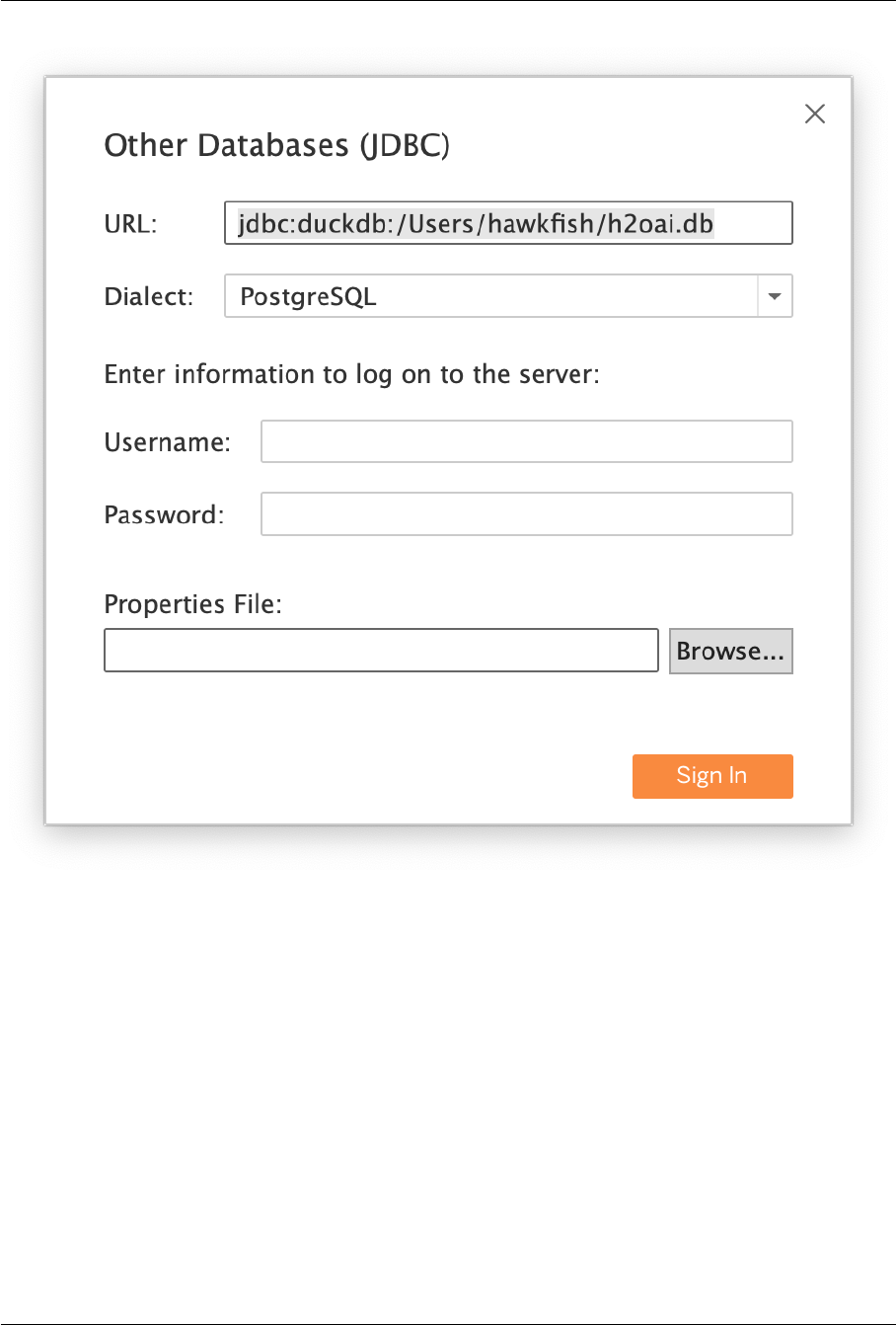
DuckDB Documentation
However, functionality will be missing such as MEDIAN and PERCENTILE aggregate functions. To make
the data source connection more compatible with the PostgreSQL dialect, please use the DuckDB taco
connector as described below.
Installing the Tableau DuckDB Connector
While it is possible to use the Tableau‑provided PostgreSQL dialect to communicate with the DuckDB
JDBC driver, we strongly recommend using the DuckDB ”taco” connector. This connector has been
fully tested against the Tableau dialect generator and is more compatible than the provided Post‑
greSQL dialect.
The documentation on how to install and use the connector is in its repository, but essentially you will
843

DuckDB Documentation
need the duckdb_jdbc.taco file. The current version of the Taco is not signed, so you will need
to launch Tableau with signature validation disabled. (Despite what the Tableau documentation says,
the real security risk is in the JDBC driver code, not the small amount of JavaScript in the Taco.)
Server (Online) On Linux, copy the Taco file to /opt/tableau/connectors. On Windows,
copy the Taco file to C:\Program Files\Tableau\Connectors. Then issue these commands
to disable signature validation:
$ tsm configuration set -k native_api.disable_verify_connector_plugin_
signature -v true
$ tsm pending-changes apply
The last command will restart the server with the new settings.
MacOS Desktop Copy the Taco file to the /Users/[MacOS User]/Documents/My Tableau
Repository/Connectors folder. Then launch Tableau Desktop from the Terminal with the com‑
mand line argument to disable signature validation:
$ /Applications/Tableau\ Desktop\
<year>.<quarter>.app/Contents/MacOS/Tableau
-DDisableVerifyConnectorPluginSignature=true
You can also package this up with AppleScript by using the following script:
do shell script "\"/Applications/Tableau Desktop
2023.2.app/Contents/MacOS/Tableau\"
-DDisableVerifyConnectorPluginSignature=true"
quit
Create this file with the Script Editor (located in /Applications/Utilities) and save it as a
packaged application:
844
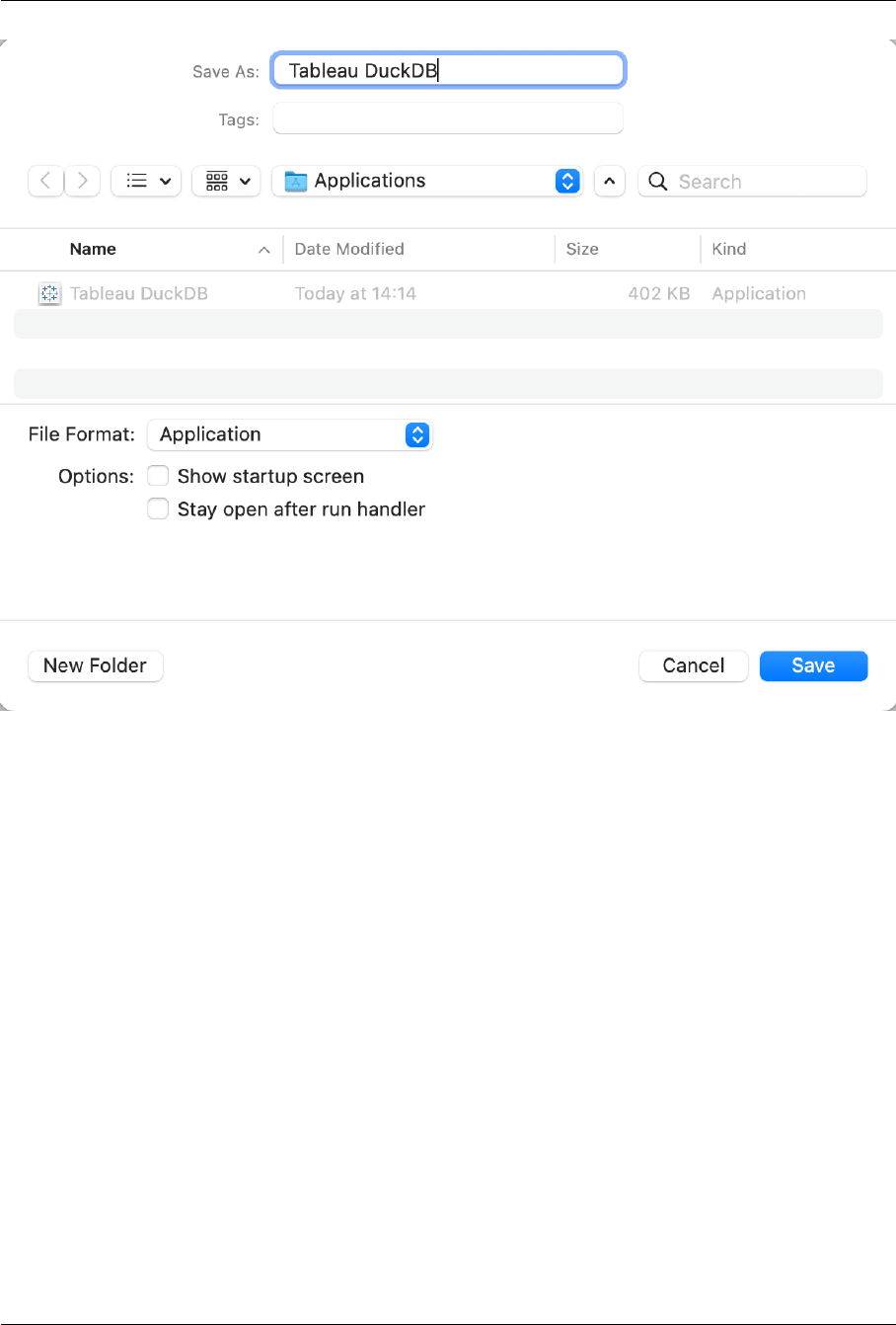
DuckDB Documentation
You can then double‑click it to launch Tableau. You will need to change the application name in the
script when you get upgrades.
Windows Desktop Copy the Taco file to the C:\Users\[Windows User]\Documents\My
Tableau Repository\Connectors directory. Then launch Tableau Desktop from a shell with
the -DDisableVerifyConnectorPluginSignature=true argument to disable signature
validation.
Output
Once loaded, you can run queries against your data! Here is the result of the first h2oai benchmark
query from the parquet test file:
845
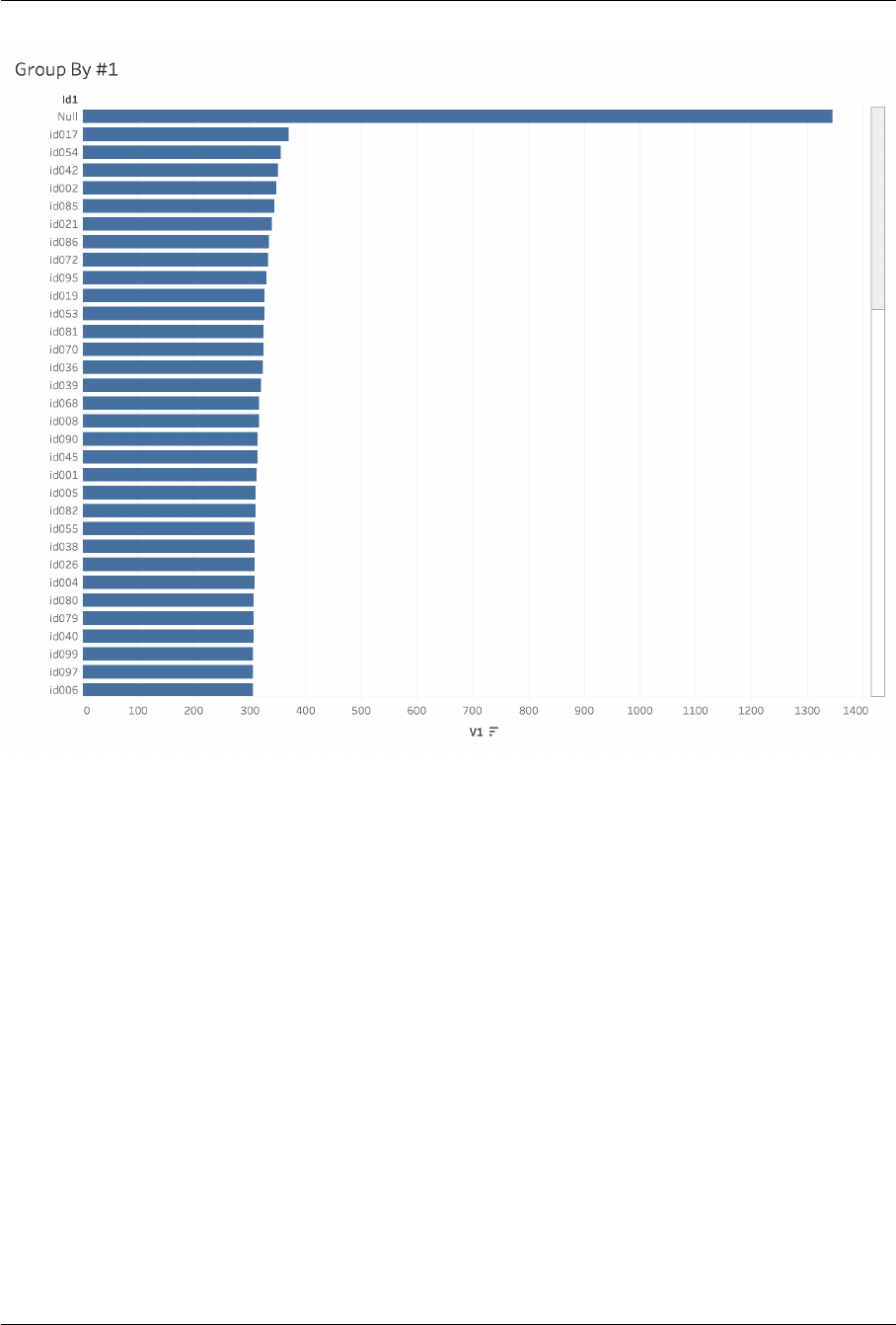
DuckDB Documentation
CLI Charting ‑ Using DuckDB with CLI Tools
DuckDB can be used with CLI graphing tools to quickly pipe input to stdout to graph your data in one
line.
YouPlotis a Ruby‑based CLI tool for drawing visually pleasing plots on the terminal. It can accept input
from other programs by piping data from stdin. It takes tab‑separated (or delimiter of your choice)
data and can easily generate various types of plots including bar, line, histogram and scatter.
With DuckDB, you can write to the console (stdout) by using the TO '/dev/stdout' command.
And you can also write comma‑separated values by using WITH (FORMAT 'csv', HEADER).
846

DuckDB Documentation
Installing YouPlot
Installation instructions for YouPlot can be found on the main YouPlot repository. If you're on a Mac,
you can use:
brew install youplot
Run uplot --help to ensure you've installed it successfully!
Piping DuckDB Queries to stdout
By combining the COPY...TO function with a CSV output file, data can be read from any format
supported by DuckDB and piped to YouPlot. There are three important steps to doing this.
1. As an example, this is how to read all data from input.json:
duckdb -s "SELECT * FROM read_json_auto('input.json')"
2. To prepare the data for YouPlot, write a simple aggregate:
duckdb -s "SELECT date, SUM(purchases) AS total_purchases FROM read_
json_auto('input.json') GROUP BY 1 ORDER BY 2 DESC LIMIT 10"
3. Finally, wrapthe SELECTin the COPY...TOfunction with an output location of /dev/stdout.
The syntax looks like this:
COPY (<YOUR_SELECT_QUERY>) TO '/dev/stdout' WITH (FORMAT 'csv', HEADER)
The full DuckDB command below outputs the query in CSV format with a header:
duckdb -s "COPY (SELECT date, SUM(purchases) AS total_purchases FROM
read_json_auto('input.json') GROUP BY 1 ORDER BY 2 DESC LIMIT 10)
TO '/dev/stdout' WITH (FORMAT 'csv', HEADER)"
Connecting DuckDB to YouPlot
Finally, the data can now be piped to YouPlot! Let's assume we have an input.json file with dates
and number of purchases made by somebody on that date. Using the query above, we'll pipe the data
to the uplot command to draw a plot of the Top 10 Purchase Dates
duckdb -s "COPY (SELECT date, SUM(purchases) AS total_purchases FROM read_
json_auto('input.json') GROUP BY 1 ORDER BY 2 DESC LIMIT 10) TO
'/dev/stdout' WITH (FORMAT 'csv', HEADER)" | uplot bar -d, -H -t "Top 10
Purchase Dates"
847

DuckDB Documentation
This tells uplotto draw a barplot, use a comma‑seperateddelimiter(-d,), thatthe data has a header
(-H), and give the plot a title (-t).
Bonus Round! stdin + stdout
Maybe you're piping some data through jq. Maybe you're downloading a JSON file from some‑
where. You can also tell DuckDB to read the data from another process by changing the filename to
/dev/stdin.
Let's combine this with a quick curl from GitHub to see what a certain user has been up to lately.
curl -sL "https://api.github.com/users/dacort/events?per_page=100" \
| duckdb -s "COPY (SELECT type, count(*) AS event_count FROM read_json_
auto('/dev/stdin') GROUP BY 1 ORDER BY 2 DESC LIMIT 10) TO
'/dev/stdout' WITH (FORMAT 'csv', HEADER)" \
| uplot bar -d, -H -t "GitHub Events for @dacort"
848
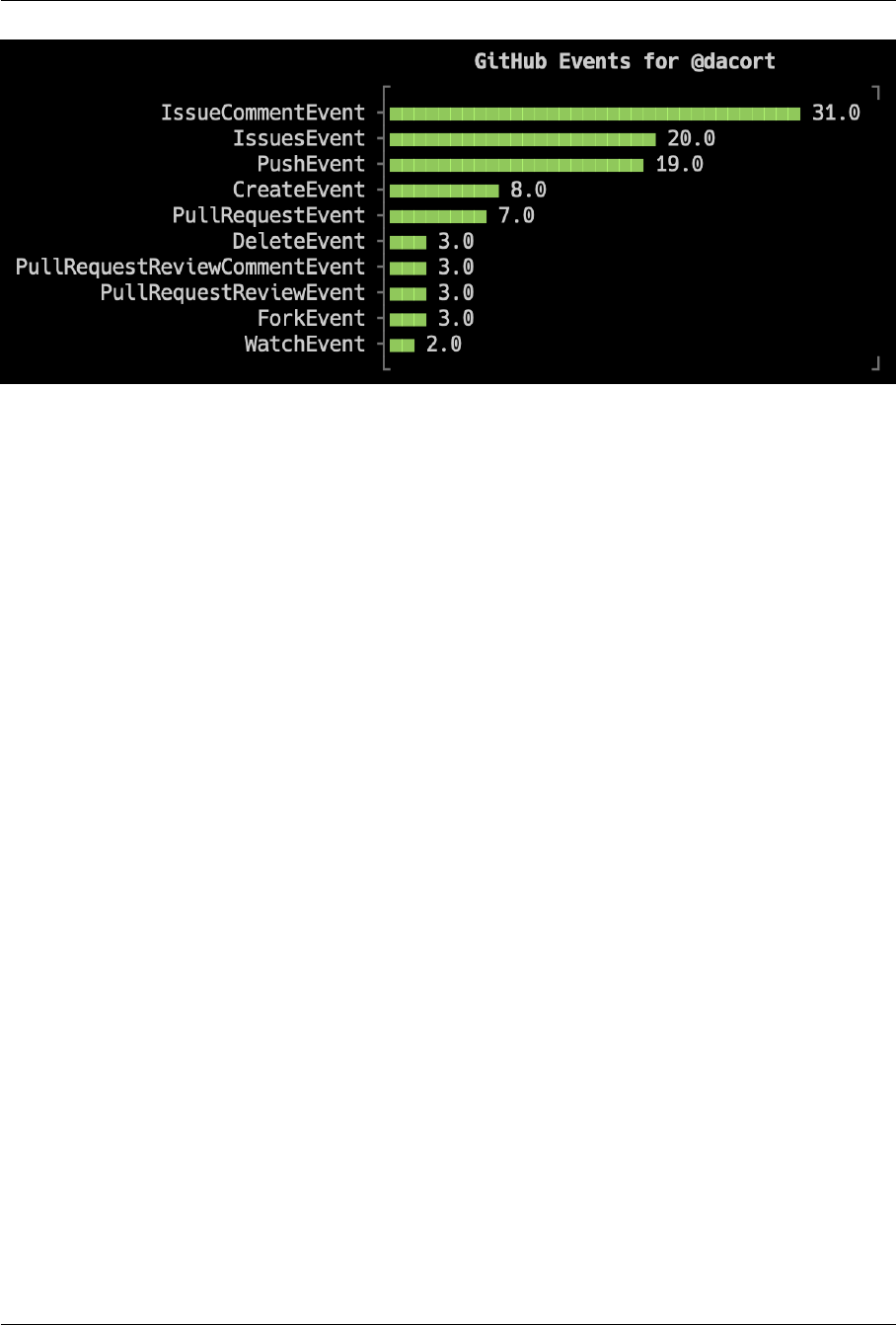
DuckDB Documentation
849
DuckDB Documentation
Under the Hood
851
Internals
Overview of DuckDB Internals
On this page is a brief description of the internals of the DuckDB engine.
Parser
The parser converts a query string into the following tokens:
• SQLStatement
• QueryNode
• TableRef
• ParsedExpression
The parser is not aware of the catalog or any other aspect of the database. It will not throw errors if
tables do not exist, and will not resolve any types of columns yet. It only transforms a query string
into a set of tokens as specified.
ParsedExpression The ParsedExpression represents an expression within a SQL statement. This
can be e.g. a reference to a column, an addition operator or a constant value. The type of the ParsedEx‑
pression indicates what it represents, e.g. a comparison is represented as a ComparisonExpres-
sion.
ParsedExpressions do not have types, except for nodes with explicit types such as CAST statements.
The types for expressions are resolved in the Binder, not in the Parser.
TableRef The TableRef represents any table source. This can be a reference to a base table, but it
can also be a join, a table‑producing function or a subquery.
QueryNode The QueryNode represents either (1) a SELECT statement, or (2) a set operation (i.e.
UNION, INTERSECT or DIFFERENCE).
853

DuckDB Documentation
SQL Statement The SQLStatementrepresentsa complete SQL statement. The type of the SQL State‑
ment representswhat kind of statementit is (e.g. StatementType::SELECTrepresentsa SELECT
statement). A single SQL string can be transformed into multiple SQL statements in case the original
query string contains multiple queries.
Binder
The binder converts all nodes into their bound equivalents. In the binder phase:
• The tables and columns are resolved using the catalog
• Types are resolved
• Aggregate/window functions are extracted
The following conversions happen:
• SQLStatement ‑> BoundStatement
• QueryNode ‑> BoundQueryNode
• TableRef ‑> BoundTableRef
• ParsedExpression ‑> Expression
Logical Planner
The logical planner creates LogicalOperator nodes from the bound statements. In this phase,
the actual logical query tree is created.
Optimizer
Aer the logical planner has created the logical query tree, the optimizers are run over that query tree
to create an optimized query plan. The following query optimizers are run:
• Expression Rewriter: Simplifies expressions, performs constant folding
• Filter Pushdown: Pushes filters down into the query plan and duplicates filters over equiva‑
lency sets. Also prunes subtrees that are guaranteed to be empty (because of filters that stati‑
cally evaluate to false).
• Join Order Optimizer: Reorders joins using dynamic programming. Specifically, the DPcpp
algorithm from the paper Dynamic Programming Strikes Back is used.
• Common Sub Expressions: Extracts common subexpressions from projection and filter nodes
to prevent unnecessary duplicate execution.
• In Clause Rewriter: Rewrites large static IN clauses to a MARK join or INNER join.
854

DuckDB Documentation
Column Binding Resolver
The column binding resolver converts logical BoundColumnRefExpresion nodes that refer to a
column of a specific table into BoundReferenceExpression nodes that refer to a specific index
into the DataChunks that are passed around in the execution engine.
Physical Plan Generator
The physical plan generator converts the resulting logical operator tree into a PhysicalOperator
tree.
Execution
In the execution phase, the physical operators are executed to produce the query result. The execu‑
tion model is a vectorized volcano model, where DataChunks are pulled from the root node of the
physical operator tree. Each PhysicalOperator itself defines how it grants its result. A PhysicalTa-
bleScan node will pull the chunk from the base tables on disk, whereas a PhysicalHashJoin
will perform a hash join between the output obtained from its child nodes.
Storage
The DuckDB internal storage format is currently in flux, and is expected to change with each release
until we reach v1.0.0.
How to Move Between Storage Formats
When you update DuckDB and open a database file, you might encounter an error message about
incompatible storage formats, pointing to this page. To move your database(s) to newer format you
only need the older and the newer DuckDB executable.
Open your database file with the older DuckDB and run the SQL statement "EXPORT DATABASE
'tmp'". This allows you to save the whole state of the current database in use inside folder tmp.
The content of the tmp folder will be overridden, so choose an empty/non yet existing location. Then,
start the newer DuckDB and execute "IMPORT DATABASE 'tmp'" (pointing to the previously
populated folder) to load the database, which can be then saved to the file you pointed DuckDB to.
A bash two‑liner (to be adapted with the file names and executable locations) is:
855

DuckDB Documentation
$ /older/version/duckdb mydata.db -c "EXPORT DATABASE 'tmp'"
$ /newer/duckdb mydata.new.db -c "IMPORT DATABASE 'tmp'"
Aer this mydata.dbwill be untouched with the old format, mydata.new.dbwill containthe same
data but in a format accessible from more recent DuckDB, and folder tmp will old the same data in an
universal format as dierent files.
Check EXPORT documentation for more details on the syntax.
Storage Header
DuckDB files start with a uint64_twhich contains a checksum for the main header, followed by four
magic bytes (DUCK), followed by the storage version number in a uint64_t.
$ hexdump -n 20 -C mydata.db
00000000 01 d0 e2 63 9c 13 39 3e 44 55 43 4b 2b 00 00 00 |...c..9>DUCK+...|
00000010 00 00 00 00 |....|
00000014
A simple example of reading the storage version using Python is below.
import struct
pattern = struct.Struct('<8x4sQ')
with open('test/sql/storage_version/storage_version.db', 'rb') as fh:
print(pattern.unpack(fh.read(pattern.size)))
Storage Version Table
For changes in each given release, check out the change log on GitHub. To see the commits that
changed each storage version, see the commit log.
Storage version DuckDB version(s)
64 v0.9.0, v0.9.1
51 v0.8.0, v0.8.1
43 v0.7.0, v0.7.1
39 v0.6.0, v0.6.1
38 v0.5.0, v0.5.1
856

DuckDB Documentation
Storage version DuckDB version(s)
33 v0.3.3, v0.3.4, v0.4.0
31 v0.3.2
27 v0.3.1
25 v0.3.0
21 v0.2.9
18 v0.2.8
17 v0.2.7
15 v0.2.6
13 v0.2.5
11 v0.2.4
6 v0.2.3
4 v0.2.2
1 v0.2.1 and prior
Disk Usage
The disk usage of DuckDB's format depends on a number of factors, including the data type and the
data distribution, the compression methods used, etc. As a rough approximation, loading 100 GB of
uncompressed CSV files into a DuckDB database file will require 25 GB of disk space, while loading 100
GB of Parquet files will require 120 GB of disk space.
Execution Format
Vector is the container format used to store in‑memory data during execution.
DataChunk is a collection of Vectors, used for instance to represent a column list in a PhysicalPro‑
jection operator.
857

DuckDB Documentation
Data Flow
DuckDB uses a vectorized query execution model.
All operators in DuckDB are optimized to work on Vectors of a fixed size.
This fixed size is commonly referred to in the code as STANDARD_VECTOR_SIZE.
The default STANDARD_VECTOR_SIZE is 2048 tuples.
Vector Format
Vectors logically represent arrays that contain data of a single type. DuckDB supports dierent vector
formats, which allow the system to store the same logical data with a dierent physical representation.
This allows for a more compressed representation, and potentially allows for compressed execution
throughout the system. Below the list of supported vector formats is shown.
Flat Vectors Flat vectors are physically stored as a contiguous array, this is the standard uncom‑
pressed vector format. For flat vectors the logical and physical representations are identical.
Constant Vectors Constant vectors are physically stored as a single constant value.
Constant vectors are useful when data elements are repeated ‑ for example, when representing the
result of a constant expression in a function call, the constant vector allows us to only store the value
once.
select lst || 'duckdb' from range(1000) tbl(lst);
Since duckdb is a string literal, the value of the literal is the same for every row. In a flat vector, we
would have to duplicate the literal 'duckdb' once for every row. The constant vector allows us to only
store the literal once.
Constant vectors are also emitted by the storage when decompressing from constant compression.
Dictionary Vectors Dictionary vectors are physically stored as a child vector, and a selection vector
that contains indices into the child vector.
Dictionary vectors are emitted by the storage when decompressing from dictionary
Just like constant vectors, dictionary vectors are also emitted by the storage.
When deserializing a dictionary compressed column segment, we store this in a dictionary vector so
we can keep the data compressed during query execution.
858

DuckDB Documentation
Sequence Vectors Sequence vectors are physically stored as an oset and an increment value.
Sequence vectors are useful for eiciently storing incremental sequences. They are generally emitted
for row identifiers.
Unified Vector Format These properties of the dierent vector formats are great for optimization
purposes, for example you can imagine the scenario where all the parameters to a function are con‑
stant, we can just compute the result once and emit a constant vector.
But writing specialized code for every combination of vector types for every function is unfeasible due
to the combinatorial explosion of possibilities.
Instead of doing this, whenever you want to generically use a vector regardless of the type, the Uni‑
fiedVectorFormat can be used.
This format essentially acts as a generic view over the contents of the Vector. Every type of Vector can
convert to this format.
Complex Types
String Vectors To eiciently store strings, we make use of our string_t class.
struct string_t {
union {
struct {
uint32_t length;
char prefix[4];
char *ptr;
} pointer;
struct {
uint32_t length;
char inlined[12];
} inlined;
} value;
};
Short strings (<= 12 bytes) are inlined into the structure, while larger strings are stored with a
pointer to the data in the auxiliary string buer. The length is used throughout the functions to avoid
having to call strlen and having to continuously check for null‑pointers. The prefix is used for com‑
parisons as an early out (when the prefix does not match, we know the strings are not equal and don't
need to chase any pointers).
859

DuckDB Documentation
List Vectors List vectors are stored as a series of list entries together with a child Vector. The child
vector contains the values that are present in the list, and the list entries specify how each individual
list is constructed.
struct list_entry_t {
idx_t offset;
idx_t length;
};
The oset refers to the start row in the child Vector, the length keeps track of the size of the list of this
row.
List vectors can be stored recursively. For nested list vectors, the child of a list vector is again a list
vector.
For example, consider this mock representation of a Vector of type BIGINT[][]:
{
"type": "list",
"data": "list_entry_t",
"child": {
"type": "list",
"data": "list_entry_t",
"child": {
"type": "bigint",
"data": "int64_t"
}
}
}
Struct Vectors Struct vectors store a list of child vectors. The number and types of the child vectors
is defined by the schema of the struct.
Map Vectors Internally map vectors are stored as a LIST[STRUCT(key KEY_TYPE, value
VALUE_TYPE)].
Union Vectors Internally UNIONutilizes the same structure as a STRUCT. The first ”child” is always
occupied by the Tag Vectorof the UNION, which records for each row which of the UNION's types apply
to that row.
860

Developer Guides
Building DuckDB from Source
Note. DuckDB binaries are available for stable and nightly builds on the installation page. You
should only build DuckDB under specific circumstances, such as when running on a specific ar‑
chitecture or building an unmerged pull request.
Prerequisites DuckDB needs a C++11‑compiler and CMake. Additionally, we recommend using the
Ninja build system.
Linux Packages Install the required packages with the package manager of your distribution.
Fedora, CentOS, and Red Hat:
sudo yum install -y git g++ cmake ninja-build
Ubuntu and Debian:
sudo apt-get update
sudo apt-get install -y git g++ cmake ninja-build
Alpine Linux:
apk add g++ git make cmake ninja
macOS Install Xcode and Homebrew. Then, install the required packages with:
brew install cmake ninja
Windows Consult the Windows CI workflow for a list of packages used to build DuckDB on Win‑
dows.
861

DuckDB Documentation
Building DuckDB To build DuckDB we use a Makefile which in turn calls into CMake. We also advise
using Ninja as the generator for CMake.
GEN=ninja make
It is not advised to directly call CMake, as the Makefile sets certain variables that are crucial to properly
building the package.
Build Type DuckDB can be built in many dierent settings, most of these correspond directly to
CMake but not all of them.
release
This build has been stripped of all the assertions and debug symbols and code, optimized for perfor‑
mance.
debug
This build runs with all the debug information, including symbols, assertions and DEBUG blocks.
The special debug defines are not automatically set for this build however.
relassert
This build does not trigger the #ifdef DEBUG code blocks, but still has debug symbols that make
it possible to step through the execution with line number information and D_ASSERT lines are still
checked in this build.
reldebug
This build is similar to relassert in many ways, only assertions are also stripped in this build.
benchmark
This build is a shorthand for release with BUILD_BENCHMARK=1 set.
tidy-check
This creates a build and then runs clang tidy to check for issues or style violations through static anal‑
ysis.
The CI will also run this check, causing it to fail if this check fails.
format-fix | format-changes | format-main
This doesn't actually create a build, but uses the following format checkers to check for style issues:
• clang‑format to fix format issues in the code.
• cmake‑format to fix format issues in the CMakeLists.txt files.
862

DuckDB Documentation
The CI will also run this check, causing it to fail if this check fails.
Package Flags For every package that is maintained by core DuckDB, there exists a flag in the Make‑
file to enable building the package.
These can be enabled by either setting them in the current env, through set up files like bashrc or
zshrc, or by setting them before the call to make, for example:
BUILD_PYTHON=1 make debug
BUILD_PYTHON
When this flag is set, the Python package is built.
BUILD_SHELL
When this flag is set, the CLI is built, this is usually enabled by default.
BUILD_BENCHMARK
When this flag is set, our in‑house Benchmark testing suite is built.
More information about this can be found here.
BUILD_JDBC
When this flag is set, the Java package is built.
BUILD_ODBC
When this flag is set, the ODBC package is built.
BUILD_R
When this flag is set, the R package is built.
BUILD_NODE
When this flag is set, the Node package is built.
Extension Flags For every in‑tree extension that is maintained by core DuckDB there exists a flag to
enable building and statically linking the extension into the build.
BUILD_AUTOCOMPLETE
When this flag is set, the AutoComplete extension is built.
BUILD_ICU
When this flag is set, the ICU extension is built.
BUILD_TPCH
863

DuckDB Documentation
When this flag is set, the TPCH extension is built, this enables TPCH‑H data generation and query
support using dbgen.
BUILD_TPCDS
When this flag is set, the TPCDS extension is built, this enables TPC‑DS data generation and query
support using dsdgen.
BUILD_TPCE
When this flag is set, the TPCE extension is built, unlike TPC‑H and TPC‑DS this does not enable data
generation and query support, but does enable tests for TPC‑E through our test suite.
BUILD_FTS
When this flag is set, the Full Text Search extension is built.
BUILD_VISUALIZER
When this flag is set, the Visualizer extension is built.
BUILD_HTTPFS
When this flag is set, the HTTP File System extension is built.
BUILD_JSON
When this flag is set, the JSON extension is built.
BUILD_INET
When this flag is set, the INET extension is built.
BUILD_SQLSMITH
When this flag is set, the SQLSmith extension is built.
Debug Flags CRASH_ON_ASSERT
D_ASSERT(condition) is used all throughout the code, these will throw an InternalException in
debug builds.
With this flag enabled, when the assertion triggers it will instead directly cause a crash.
DISABLE_STRING_INLINE
In our execution format string_t has the feature to ”inline” strings that are under a certain length
(12 bytes), this means they don't require a separate allocation.
When this flag is set, we disable this and don't inline small strings.
DISABLE_MEMORY_SAFETY
864

DuckDB Documentation
Our data structures that are used extensively throughout the non‑performance‑critical code have ex‑
tra checks to ensure memory safety, these checks include:
• Making sure nullptr is never dereferenced.
• Making sure index out of bounds accesses don't trigger a crash.
With this flag enabled we remove these checks, this is mostly done to check that the performance hit
of these checks is negligible.
DESTROY_UNPINNED_BLOCKS
When previously pinned blocks in the BuerManager are unpinned, with this flag enabled we destroy
them instantly to make sure that there aren't situations where this memory is still being used, despite
not being pinned.
DEBUG_STACKTRACE
When a crash or assertion hit occurs in a test, print a stack trace.
This is useful when debugging a crash that is hard to pinpoint with a debugger attached.
Miscellaneous Flags DISABLE_UNITY
To improve compilation time, we use Unity Build to combine translation units.
This can however hide include bugs, this flag disables using the unity build so these errors can be
detected.
DISABLE_SANITIZER
In some situations, running an executable that has been built with sanitizers enabled is not support /
can cause problems. Julia is an example of this.
With this flag enabled, the sanitizers are disabled for the build.
Troubleshooting
Building the R Package on Linux aarch64 Building the R package on Linux running on an ARM64
architecture (AArch64) may result in the following error message:
/usr/bin/ld: /usr/include/c++/10/bits/basic_string.tcc:206: warning: too
many GOT entries for -fpic, please recompile with -fPIC
To work around this, create or edit the ~/.R/Makevars file:
ALL_CXXFLAGS = $(PKG_CXXFLAGS) -fPIC $(SHLIB_CXXFLAGS) $(CXXFLAGS)
865

DuckDB Documentation
Building the httpfs Extensionand Python Package on macOS Problem: Thebuild fails on macOS
when both the httpfs extension and the Python package are included:
GEN=ninja BUILD_PYTHON=1 BUILD_HTTPFS=1 make
ld: library not found for -lcrypto
clang: error: linker command failed with exit code 1 (use -v to see
invocation)
error: command '/usr/bin/clang++' failed with exit code 1
ninja: build stopped: subcommand failed.
make: *** [release] Error 1
Solution: In general, we recommended using the nightly builds, available under GitHub main (Bleed‑
ing Edge) on the installation page. If you would like to build DuckDB from source, avoid using the
BUILD_PYTHON=1 flag unless you are actively developing the Python library. Instead, first build
the httpfs extension, then build and install the Python package separately using the setup.py
script:
GEN=ninja BUILD_HTTPFS=1 make
python tools/pythonpkg/setup.py install --user
Profiling
Profiling is important to help understand why certain queries exhibit specific performance character‑
istics. DuckDB contains several built‑in features to enable query profiling that will be explained on
this page.
For the examples on this page we will use the following example data set:
CREATE TABLE students(sid INTEGER PRIMARY KEY, name VARCHAR);
CREATE TABLE exams(cid INTEGER, sid INTEGER, grade INTEGER, PRIMARY KEY(cid,
sid));
INSERT INTO students VALUES (1, 'Mark'), (2, 'Hannes'), (3, 'Pedro');
INSERT INTO exams VALUES (1, 1, 8), (1, 2, 8), (1, 3, 7), (2, 1, 9), (2, 2,
10);
Explain Statement The first step to profiling a database engine is figuring out what execution plan
the engine is using. The EXPLAIN statement allows you to peek into the query plan and see what is
going on under the hood.
The EXPLAIN statement displays the physical plan, i.e., the query plan that will get executed.
866

DuckDB Documentation
To demonstrate, see the below example:
CREATE TABLE students(name VARCHAR, sid INT);
CREATE TABLE exams(eid INT, subject VARCHAR, sid INT);
INSERT INTO students VALUES ('Mark', 1), ('Joe', 2), ('Matthew', 3);
INSERT INTO exams VALUES (10, 'Physics', 1), (20, 'Chemistry', 2), (30,
'Literature', 3);
EXPLAIN SELECT name FROM students JOIN exams USING (sid) WHERE name LIKE
'Ma%';
┌─────────────────────────────┐
│┌───────────────────────────┐│
││ Physical Plan ││
│└───────────────────────────┘│
└─────────────────────────────┘
┌───────────────────────────┐
│ PROJECTION │
│ ─ ─ ─ ─ ─ ─ ─ ─ ─ ─ ─ │
│ name │
└─────────────┬─────────────┘
┌─────────────┴─────────────┐
│ HASH_JOIN │
│ ─ ─ ─ ─ ─ ─ ─ ─ ─ ─ ─ │
│ INNER │
│ sid = sid ├──────────────┐
│ ─ ─ ─ ─ ─ ─ ─ ─ ─ ─ ─ │ │
│ EC: 1 │ │
└─────────────┬─────────────┘ │
┌─────────────┴─────────────┐┌─────────────┴─────────────┐
│ SEQ_SCAN ││ FILTER │
│ ─ ─ ─ ─ ─ ─ ─ ─ ─ ─ ─ ││ ─ ─ ─ ─ ─ ─ ─ ─ ─ ─ ─ │
│ exams ││ prefix(name, 'Ma') │
│ ─ ─ ─ ─ ─ ─ ─ ─ ─ ─ ─ ││ ─ ─ ─ ─ ─ ─ ─ ─ ─ ─ ─ │
│ sid ││ EC: 1 │
│ ─ ─ ─ ─ ─ ─ ─ ─ ─ ─ ─ ││ │
│ EC: 3 ││ │
└───────────────────────────┘└─────────────┬─────────────┘
┌─────────────┴─────────────┐
│ SEQ_SCAN │
│ ─ ─ ─ ─ ─ ─ ─ ─ ─ ─ ─ │
│ students │
│ ─ ─ ─ ─ ─ ─ ─ ─ ─ ─ ─ │
│ sid │
│ name │
867

DuckDB Documentation
│ ─ ─ ─ ─ ─ ─ ─ ─ ─ ─ ─ │
│ Filters: name>=Ma AND name│
│ <Mb AND name IS NOT NULL │
│ ─ ─ ─ ─ ─ ─ ─ ─ ─ ─ ─ │
│ EC: 1 │
└───────────────────────────┘
Note that the query is not actually executed – therefore, we can only see the estimated cardinality (EC)
for each operator, which is calculated by using the statistics of the base tables and applying heuristics
for each operator.
Run‑Time Profiling The query plan helps understand the performance characteristics of the sys‑
tem. However, oen it is also necessary to look at the performance numbers of individual operators
and the cardinalities that pass through them. For this, you can create a query‑profile graph.
To create the query graphs it is first necessary to gather the necessary data by running the query. In
order to do that, we must first enable the run‑time profiling. This can be done by prefixing the query
with EXPLAIN ANALYZE:
EXPLAIN ANALYZE SELECT name FROM students JOIN exams USING (sid) WHERE name
LIKE 'Ma%';
┌─────────────────────────────────────┐
│┌───────────────────────────────────┐│
││ Total Time: 0.0008s ││
│└───────────────────────────────────┘│
└─────────────────────────────────────┘
┌───────────────────────────┐
│ EXPLAIN_ANALYZE │
│ ─ ─ ─ ─ ─ ─ ─ ─ ─ ─ ─ │
│ 0 │
│ (0.00s) │
└─────────────┬─────────────┘
┌─────────────┴─────────────┐
│ PROJECTION │
│ ─ ─ ─ ─ ─ ─ ─ ─ ─ ─ ─ │
│ name │
│ ─ ─ ─ ─ ─ ─ ─ ─ ─ ─ ─ │
│ 2 │
│ (0.00s) │
└─────────────┬─────────────┘
┌─────────────┴─────────────┐
│ HASH_JOIN │
868

DuckDB Documentation
│ ─ ─ ─ ─ ─ ─ ─ ─ ─ ─ ─ │
│ INNER │
│ sid = sid │
│ ─ ─ ─ ─ ─ ─ ─ ─ ─ ─ ─ ├──────────────┐
│ EC: 1 │ │
│ ─ ─ ─ ─ ─ ─ ─ ─ ─ ─ ─ │ │
│ 2 │ │
│ (0.00s) │ │
└─────────────┬─────────────┘ │
┌─────────────┴─────────────┐┌─────────────┴─────────────┐
│ SEQ_SCAN ││ FILTER │
│ ─ ─ ─ ─ ─ ─ ─ ─ ─ ─ ─ ││ ─ ─ ─ ─ ─ ─ ─ ─ ─ ─ ─ │
│ exams ││ prefix(name, 'Ma') │
│ ─ ─ ─ ─ ─ ─ ─ ─ ─ ─ ─ ││ ─ ─ ─ ─ ─ ─ ─ ─ ─ ─ ─ │
│ sid ││ EC: 1 │
│ ─ ─ ─ ─ ─ ─ ─ ─ ─ ─ ─ ││ ─ ─ ─ ─ ─ ─ ─ ─ ─ ─ ─ │
│ EC: 3 ││ 2 │
│ ─ ─ ─ ─ ─ ─ ─ ─ ─ ─ ─ ││ (0.00s) │
│ 3 ││ │
│ (0.00s) ││ │
└───────────────────────────┘└─────────────┬─────────────┘
┌─────────────┴─────────────┐
│ SEQ_SCAN │
│ ─ ─ ─ ─ ─ ─ ─ ─ ─ ─ ─ │
│ students │
│ ─ ─ ─ ─ ─ ─ ─ ─ ─ ─ ─ │
│ sid │
│ name │
│ ─ ─ ─ ─ ─ ─ ─ ─ ─ ─ ─ │
│ Filters: name>=Ma AND name│
│ <Mb AND name IS NOT NULL │
│ ─ ─ ─ ─ ─ ─ ─ ─ ─ ─ ─ │
│ EC: 1 │
│ ─ ─ ─ ─ ─ ─ ─ ─ ─ ─ ─ │
│ 2 │
│ (0.00s) │
└───────────────────────────┘
The output of EXPLAIN ANALYZE contains the estimated cardinality (EC), the actual cardinality,
and the execution time for each operator.
It is also possible to save the query plan to a file, e.g., in JSON format:
-- All queries performed will be profiled, with output in json format.
869

DuckDB Documentation
-- By default the result is still printed to stdout.
PRAGMA enable_profiling='json';
-- Instead of writing to stdout, write the profiling output to a specific
file on disk.
-- This has no effect for `EXPLAIN ANALYZE` queries, which will *always* be
-- returned as query results.
PRAGMA profile_output='/path/to/file.json';
Note. This file is overwritten with each query that is issued. If you want to store the profile
output for later it should be copied to a dierent file.
Now let us run the query that we inspected before:
SELECT name FROM students JOIN exams USING (sid) WHERE name LIKE 'Ma%';
Aer the query is completed, the JSON file containing the profiling output has been written to the spec‑
ified file. We can then render the query graph using the Python script, provided we have the duckdb
python module installed. This script will generate a HTML file and open it in your web browser.
python scripts/generate_querygraph.py /path/to/file.json
Testing
Testing is vital to make sure that DuckDB works properly and keeps working properly. For that reason,
we put a large emphasis on thorough and frequent testing. We run a batch of small tests on every
commit using GitHub Actions, and run a more exhaustive batch of tests on pull requests and commits
in the master branch.
It is crucial that any new features that get added have correct tests that not only test the ”happy path”,
but also test edge cases and incorrect usage of the feature. In this section, we describe how DuckDB
tests are structured and how to make new tests for DuckDB.
The tests can be run by running the unittest program located in the test folder. For the
default compilations this is located in either build/release/test/unittest (release) or
build/debug/test/unittest (debug).
Writing Tests When testing DuckDB, we aim to route all the tests through SQL. We try to avoid test‑
ing components individually because that makes those components more diicult to change later on.
As such, almost all of our tests can (and should) be expressed in pure SQL. There are certain excep‑
tions to this, which we will discuss in the section ”Catch Tests”. However, in most cases you should
write your tests in plain SQL.
870

DuckDB Documentation
SQL tests should be written using the SQLLogicTest framework.
C++ tests can be written using the Catch framework.
Client Connector Tests DuckDB also has tests for various client connectors. These are generally
written in the relevant client language, and can be found in tools/*/tests. They also double as
documentation of what should be doable from a given client.
SQLLogicTest
When testing DuckDB, we aim to route all the tests through SQL. We try to avoid testing components
individually because that makes those components more diicult to change later on. As such, almost
all of our tests can (and should) be expressed in pure SQL. There are certain exceptions to this, which
we will discuss in the section ”Catch Tests”. However, in most cases you should write your tests in
plain SQL.
For testing plain SQL we use an extended version of the SQL logic test suite, adopted from SQLite. Ev‑
ery test is a single self‑contained file located in the test/sql directory. To run tests located outside
of the default testdirectory, specify --test-dir <root_directory>and make sure provided
test file paths are relative to that root directory.
The test describes a series of SQL statements, together with either the expected result, a statement
ok indicator, or a statement error indicator. An example of a test file is shown below:
# name: test/sql/projection/test_simple_projection.test
# group [projection]
# enable query verification
statement ok
PRAGMA enable_verification
# create table
statement ok
CREATE TABLE a (i integer, j integer);
# insertion: 1 affected row
statement ok
INSERT INTO a VALUES (42, 84);
query II
SELECT * FROM a;
871

DuckDB Documentation
----
42 84
In this example, three statements are executed. The first statements are expected to succeed (pre‑
fixed by statement ok). The third statement is expected to return a single row with two columns
(indicated by query II). The values of the row are expected to be 42 and 84 (separated by a tab
character). For more information on query result verification, see the result verification section.
The top of every file should contain a comment describing the name and group of the test. The name
of the test is always the relative file path of the file. The group is the folder that the file is in. The
name and group of the test are relevant because they can be used to execute only that test in the
unittest group. For example, if we wanted to execute only the above test, we would run the command
unittest test/sql/projection/test_simple_projection.test. If we wanted to
run all tests in a specific directory, we would run the command unittest "[projection]".
Any tests that are placed in the test directory are automatically added to the test suite. Note that
the extension of the test is significant. SQLLogicTests should either use the .test extension, or the
.test_slow extension. The .test_slow extension indicates that the test takes a while to run,
and will only be run when all tests are explicitly run using unittest *. Tests with the extension
.test will be included in the fast set of tests.
Query Verification
Many simple tests start by enabling query verification. This can be done through the following
PRAGMA statement:
statement ok
PRAGMA enable_verification
Query verification performs extra validation to ensure that the underlying code runs correctly. The
most important part of that is that it verifies that optimizers do not cause bugs in the query. It does
this by running both an unoptimized and optimized version of the query, and verifying that the results
of these queries are identical.
Query verification is very useful because it not only discovers bugs in optimizers, but also finds bugs
in e.g. join implementations. This is because the unoptimized version will typically run using cross
products instead. Because of this, query verification can be very slow to do when working with larger
data sets. It is therefore recommended to turn on query verification for all unit tests, except those
involving larger data sets (more than 10‑100~ rows).
872

DuckDB Documentation
Editors & Syntax Highlighting
The SQLLogicTests are not exactly an industry standard, but several other systems have adopted them
as well. Parsing sqllogictests is intentionally simple. All statements have to be separated by empty
lines. For that reason, writing a syntax highlighter is not extremely diicult.
A syntax highlighter exists for Visual Studio Code. We have also made a fork that supports the
DuckDB dialect of the sqllogictests. You can use the fork by installing the original, then copying the
syntaxes/sqllogictest.tmLanguage.json into the installed extension (on MacOS this is
located in ~/.vscode/extensions/benesch.sqllogictest-0.1.1).
A syntax highlighter is also available for CLion. It can be installed directly on the IDE by searching
SQLTest on the marketplace. A GitHub repository is also available, with extensions and bug reports
being welcome.
Temporary Files For some tests (e.g., CSV/Parquet file format tests) it is necessary to create tempo‑
rary files. Any temporary files should be created in the temporary testing directory. This directory can
be used by placing the string __TEST_DIR__ in a query. This string will be replaced by the path of
the temporary testing directory.
statement ok
COPY csv_data TO '__TEST_DIR__/output_file.csv.gz' (COMPRESSION GZIP);
Require & Extensions To avoid bloating the core system, certain functionality of DuckDB is avail‑
able only as an extension. Tests can be build for those extensions by adding a require field in the
test. If the extension is not loaded, any statements that occurs aer the require field will be skipped.
Examples of this are require parquet or require icu.
Another usage is to limit a test to a specific vector size. For example, adding require vector_
size 512 to a test will prevent the test from being run unless the vector size greater than or equal
to 512. This is useful because certain functionality is not supported for low vector sizes, but we run
tests using a vector size of 2 in our CI.
SQLLogicTest ‑ Debugging
The purpose of the tests is to figure out when things break. Inevitably changes made to the system
will cause one of the tests to fail, and when that happens the test needs to be debugged.
First, it is always recommended to run in debug mode. This can be done by compiling the system
using the command make debug. Second, it is recommended to only run the test that breaks.
873

DuckDB Documentation
This can be done by passing the filename of the breaking test to the test suite as a command line
parameter (e.g., build/debug/test/unittest test/sql/projection/test_simple_
projection.test). For more options on running a subset of the tests see the Triggering which
tests to run section.
Aer that, a debugger can be attached to the program and the test can be debugged. In the sqllog‑
ictests it is normally diicult to break on a specific query, however, we have expanded the test suite
so that a function called query_break is called with the line number line as parameter for every
query that is run. This allows you to put a conditional breakpoint on a specific query. For example, if
we want to break on line number 43 of the test file we can create the following break point:
gdb: break query_break if line==43
lldb: break s -n query_break -c line==43
You can also skip certain queries from executing by placing mode skip in the file, followed by an
optional mode unskip. Any queries between the two statements will not be executed.
Triggering Which Tests to Run
When running the unittest program, by default all the fast tests are run. A specific test can be run by
adding the name of the test as an argument. For the SQLLogicTests, this is the relative path to the test
file.
# run only a single test
build/debug/test/unittest test/sql/projection/test_simple_projection.test
All tests in a given directory can be executed by providing the directory as a parameter with square
brackets.
# run all tests in the "projection" directory
build/debug/test/unittest "[projection]"
All tests, including the slow tests, can be run by running the tests with an asterisk.
# run all tests, including the slow tests
build/debug/test/unittest "*"
We can run a subset of the tests using the --start-offset and --end-offset parameters:
# run tests the tests 200..250
build/debug/test/unittest --start-offset=200 --end-offset=250
These are also available in percentages:
874

DuckDB Documentation
# run tests 10% - 20%
build/debug/test/unittest --start-offset-percentage=10
--end-offset-percentage=20
The set of tests to run can also be loaded from a file containing one test name per line, and loaded
using the -f command.
$ cat test.list
test/sql/join/full_outer/test_full_outer_join_issue_4252.test
test/sql/join/full_outer/full_outer_join_cache.test
test/sql/join/full_outer/test_full_outer_join.test
# run only the tests labeled in the file
$ build/debug/test/unittest -f test.list
SQLLogicTest ‑ Result Verification
The standard way of verifying results of queries is using the query statement, followed by the letter
I times the number of columns that are expected in the result. Aer the query, four dashes (----)
are expected followed by the result values separated by tabs. For example,
query II
SELECT 42, 84 UNION ALL SELECT 10, 20;
----
42 84
10 20
For legacy reasons the letters R and T are also accepted to denote columns.
NULL Values and Empty Strings
Empty lines have special significance for the SQLLogic test runner: they signify an end of the current
statement or query. For that reason, empty strings and NULL values have special syntax that must be
used in result verification. NULL values should use the string NULL, and empty strings should use the
string (empty), e.g.:
query II
SELECT NULL, ''
----
NULL
(empty)
875

DuckDB Documentation
Error Verification
In order to signify that an error is expected, the statement error indicator can be used. The
statement error also takes an optional expected result ‑ which is interpreted as the expected
error message. Similar to query, the expected error should be placed aer the four dashes (----)
following the query. The test passes if the error message contains the text under statement error
‑ the entire error message does not need to be provided. It is recommended that you only use a subset
of the error message, so that the test does not break unnecessarily if the formatting of error messages
is changed.
statement error
SELECT * FROM non_existent_table;
----
Table with name non_existent_table does not exist!
Regex
In certain cases result values might be very large or complex, and we might only be interested in
whether or not the result contains a snippet of text. In that case, we can use the <REGEX>: modifier
followed by a certain regex. If the result value matches the regex the test is passed. This is primarily
used for query plan analysis.
query II
EXPLAIN SELECT tbl.a FROM "data/parquet-testing/arrow/alltypes_
plain.parquet" tbl(a) WHERE a=1 OR a=2
----
physical_plan <REGEX>:.*PARQUET_SCAN.*Filters: a=1 OR a=2.*
If we instead want the result not to contain a snippet of text, we can use the <!REGEX>: modifier.
File
As results can grow quite large, and we might want to re‑use results over multiple files, it is also possi‑
ble to read expected results from files using the <FILE> command. The expected result is read from
the given file. As convention the file path should be provided as relative to the root of the GitHub
repository.
query I
PRAGMA tpch(1)
----
<FILE>:extension/tpch/dbgen/answers/sf1/q01.csv
876

DuckDB Documentation
Row‑Wise vs. Value‑Wise Result Ordering
The result values of a query can be either supplied in row‑wise order, with the individual values sep‑
arated by tabs, or in value‑wise order. In value wise order the individual values of the query must
appear in row, column order each on an individual line. Consider the following example in both row‑
wise and value‑wise order:
# row-wise
query II
SELECT 42, 84 UNION ALL SELECT 10, 20;
----
42 84
10 20
# value-wise
query II
SELECT 42, 84 UNION ALL SELECT 10, 20;
----
42
84
10
20
Hashes and Outputting Values
Besides direct result verification, the sqllogic test suite also has the option of using MD5 hashes for
value comparisons. A test using hashes for result verification looks like this:
query I
SELECT g, STRING_AGG(x,',') FROM strings GROUP BY g
----
200 values hashing to b8126ea73f21372cdb3f2dc483106a12
This approach is useful for reducing the size of tests when results have many output rows. However,
it should be used sparingly, as hash values make the tests more diicult to debug if they do break.
Aer it is ensured that the system outputs the correct result, hashes of the queries in a test file can be
computed by adding mode output_hash to the test file. For example:
mode output_hash
query II
SELECT 42, 84 UNION ALL SELECT 10, 20;
877

DuckDB Documentation
----
42 84
10 20
The expected output hashes for every query in the test file will then be printed to the terminal, as
follows:
================================================================================
SQL Query
SELECT 42, 84 UNION ALL SELECT 10, 20;
================================================================================
4 values hashing to 498c69da8f30c24da3bd5b322a2fd455
================================================================================
In a similar manner, mode output_result can be used in order to force the program to print the
result to the terminal for every query run in the test file.
Result Sorting
Queries can have an optional field that indicates that the result should be sorted in a specific manner.
This field goes in the same location as the connection label. Because of that, connection labels and
result sorting cannot be mixed.
The possible values of this field are nosort, rowsort and valuesort. An example of how this
might be used is given below:
query I rowsort
SELECT 'world' UNION ALL SELECT 'hello'
----
hello
world
In general, we prefer not to use this field and rely on ORDER BY in the query to generate deterministic
query answers. However, existing sqllogictests use this field extensively, hence it is important to know
of its existence.
Query Labels
Another feature that can be used for result verification are query labels. These can be used to
verify that dierent queries provide the same result. This is useful for comparing queries that are
logically equivalent, but formulated dierently. Query labels are provided aer the connection label
or sorting specifier.
878

DuckDB Documentation
Queries that have a query label do not need to have a result provided. Instead, the results of each of
the queries with the same label are compared to each other. For example, the following script verifies
that the queries SELECT 42+1 and SELECT 44-1 provide the same result:
query I nosort r43
SELECT 42+1;
----
query I nosort r43
SELECT 44-1;
----
SQLLogicTest ‑ Persistent Testing
By default, all tests are run in in‑memory mode (unless --force-storage is enabled). In certain
cases, we want to force the usage of a persistent database. We can initiate a persistent database using
the load command, and trigger a reload of the database using the restart command.
# load the DB from disk
load __TEST_DIR__/storage_scan.db
statement ok
CREATE TABLE test (a INTEGER);
statement ok
INSERT INTO test VALUES (11), (12), (13), (14), (15), (NULL)
# ...
restart
query I
SELECT * FROM test ORDER BY a
----
NULL
11
12
13
14
15
Note that by default the tests run with SET wal_autocheckpoint='0KB' ‑ meaning a check‑
point is triggered aer every statement. WAL tests typically run with the following settings to disable
879

DuckDB Documentation
this behavior:
statement ok
PRAGMA disable_checkpoint_on_shutdown
statement ok
PRAGMA wal_autocheckpoint='1TB';
SQLLogicTest ‑ Loops
Loops can be used in sqllogictests when it is required to execute the same query many times but with
slight modifications in constant values. For example, suppose we want to fire o 100 queries that
check for the presence of the values 0..100 in a table:
# create the table integers with the values 0..100
statement ok
CREATE TABLE integers AS SELECT * FROM range(0, 100, 1) t1(i);
# verify individually that all 100 values are there
loop i 0 100
# execute the query, replacing the value
query I
SELECT COUNT(*) FROM integers WHERE i=${i};
----
1
# end the loop (note that multiple statements can be part of a loop)
endloop
Similarly, foreach can be used to iterate over a set of values.
foreach partcode millennium century decade year quarter month day hour
minute second millisecond microsecond epoch
query III
SELECT i, DATE_PART('${partcode}', i) AS p, DATE_PART(['${partcode}'], i) AS
st
FROM intervals
WHERE p <> st['${partcode}'];
----
endloop
880

DuckDB Documentation
foreach also has a number of preset combinations that should be used when required. In this man‑
ner, when new combinations are added to the preset, old tests will automatically pick up these new
combinations.
Preset Expansion
<compression>``
|none
uncompressed rle
bitpacking dictionary
fsst chimp patas|
|| `tinyint
smallint
integer bigint
hugeint`
| | `<unsigned>
utinyint usmallint uinteger ubigint
<integral>``
| | ||
`<integral>
float double`
| | `<alltypes>
<numeric> bool interval varchar json
Note. Use large loops sparingly. Executing hundreds of thousands of SQL statements will slow
down tests unnecessarily. Do not use loops for inserting data.
Data Generation without Loops
Loops should be used sparingly. While it might be tempting to use loops for inserting data using insert
statements, this will considerably slow down the test cases. Instead, it is better to generate data using
the built‑in range and repeat functions.
-- create the table integers with the values [0, 1, .., 98, 99]
CREATE TABLE integers AS SELECT * FROM range(0, 100, 1) t1(i);
-- create the table strings with 100X the value "hello"
CREATE TABLE strings AS SELECT 'hello' AS s FROM range(0, 100, 1);
Using these two functions, together with clever use of cross products and other expressions, many
dierent types of datasets can be eiciently generated. The RANDOM() function can also be used to
881

DuckDB Documentation
generate random data.
An alternative option is to read data from an existing CSV or Parquet file. There are several large
CSV files that can be loaded from the directory test/sql/copy/csv/data/real using a COPY
INTO statement or the read_csv_auto function.
The TPC‑H and TPC‑DS extensions can also be used to generate synthetic data, using e.g. CALL db-
gen(sf=1) or CALL dsdgen(sf=1).
SQLLogicTest ‑ Multiple Connections
For tests whose purpose is to verify that the transactional management or versioning of data works
correctly, it is generally necessary to use multiple connections. For example, if we want to verify that
the creation of tables is correctly transactional, we might want to start a transaction and create a table
in con1, then fire a query in con2 that checks that the table is not accessible yet until committed.
We can use multiple connections in the sqllogictests using connection labels. The connection
label can be optionally appended to any statementor query. All queries with the same connection
label will be executed in the same connection. A test that would verify the above property would look
as follows:
statement ok con1
BEGIN TRANSACTION
statement ok con1
CREATE TABLE integers(i INTEGER);
statement error con2
SELECT * FROM integers;
Concurrent Connections
Using connection modifiers on the statement and queries will result in testing of multiple connections,
but all the queries will still be run sequentially on a single thread. If we want to run code from multiple
connections concurrently over multiple threads, we can use the concurrentloop construct. The
queries in concurrentloop will be run concurrently on separate threads at the same time.
concurrentloop i 0 10
statement ok
CREATE TEMP TABLE t2 AS (SELECT 1);
882

DuckDB Documentation
statement ok
INSERT INTO t2 VALUES (42);
statement ok
DELETE FROM t2
endloop
One caveat with concurrentloop is that results are oen unpredictable ‑ as multiple clients
can hammer the database at the same time we might end up with (expected) transaction conflicts.
statement maybe can be used to deal with these situations. statement maybe essentially
accepts both a success, and a failure with a specific error message.
concurrentloop i 1 10
statement maybe
CREATE OR REPLACE TABLE t2 AS (SELECT
-54124033386577348004002656426531535114 FROM t2 LIMIT 70%);
----
write-write conflict
endloop
Catch C/C++ Tests
While we prefer the sqllogic tests for testing most functionality, for certain tests only SQL is not sui‑
cient. This typically happens when you want to test the C++ API. When using pure SQL is really not an
option it might be necessary to make a C++ test using Catch.
Catch tests reside in the test directory as well. Here is an example of a catch test that tests the storage
of the system:
#include "catch.hpp"
#include "test_helpers.hpp"
TEST_CASE("Test simple storage", "[storage]") {
auto config = GetTestConfig();
unique_ptr<QueryResult> result;
auto storage_database = TestCreatePath("storage_test");
// make sure the database does not exist
DeleteDatabase(storage_database);
{
883

DuckDB Documentation
// create a database and insert values
DuckDB db(storage_database, config.get());
Connection con(db);
REQUIRE_NO_FAIL(con.Query("CREATE TABLE test (a INTEGER, b
INTEGER);"));
REQUIRE_NO_FAIL(con.Query("INSERT INTO test VALUES (11, 22), (13,
22), (12, 21), (NULL, NULL)"));
REQUIRE_NO_FAIL(con.Query("CREATE TABLE test2 (a INTEGER);"));
REQUIRE_NO_FAIL(con.Query("INSERT INTO test2 VALUES (13), (12),
(11)"));
}
// reload the database from disk a few times
for (idx_t i = 0; i < 2; i++) {
DuckDB db(storage_database, config.get());
Connection con(db);
result = con.Query("SELECT * FROM test ORDER BY a");
REQUIRE(CHECK_COLUMN(result, 0, {Value(), 11, 12, 13}));
REQUIRE(CHECK_COLUMN(result, 1, {Value(), 22, 21, 22}));
result = con.Query("SELECT * FROM test2 ORDER BY a");
REQUIRE(CHECK_COLUMN(result, 0, {11, 12, 13}));
}
DeleteDatabase(storage_database);
}
The test uses the TEST_CASE wrapper to create each test. The database is created and queried using
the C++ API. Results are checked using either REQUIRE_FAIL/REQUIRE_NO_FAIL (correspond‑
ing to statement ok and statement error) or REQUIRE(CHECK_COLUMN(...)) (corresponding to
query with a result check). Every test that is created in this way needs to be added to the correspond‑
ing CMakeLists.txt.
884
DuckDB Documentation
Acknowledgments
885

